
Stellarium 23.4 User Guide
Georg Zotti, Alexander Wolf (editors)
2023

Copyright © 2014-2023 Georg Zotti.
Copyright © 2011-2023 Alexander Wolf.
Copyright © 2006-2013 Matthew Gates.
Copyright © 2013-2014 Barry Gerdes († 2014).
STELLARIUM.ORG
Permission is granted to copy, distribute and/or modify this document under the terms
of the GNU Free Documentation License, Version 1.3 or any later version published by
the Free Software Foundation; with no Invariant Sections, no Front-Cover Texts, and no
Back-Cover Texts. A copy of the license is included in the appendix G entitled “GNU Free
Documentation License”.
All trademarks, third party brands, product names, trade names, corporate names and company
names mentioned may be trademarks of their respective owners or registered trademarks of other
companies and are used for purposes of explanation and to the readers’ benefit, without implying a
violation of copyright law.
Version 23.4-1, December 23, 2023

Contents
I
Basic Use
1 Introduction . . . . . . . . . . . . . . . . . . . . . . . . . . . . . . . . . . . . . . . . . . . . . . . . 3
1.1 Historical notes 3
1.2 Version Numbers 5
1.3 Acknowledgements 6
1.4 Scientific use 6
1.5 About this User Guide 6
2 Getting Started . . . . . . . . . . . . . . . . . . . . . . . . . . . . . . . . . . . . . . . . . . . . . 7
2.1 System Requirements 7
2.1.1 Minimum . . . . . . . . . . . . . . . . . . . . . . . . . . . . . . . . . . . . . . . . . . . . . . . . . . . . . . 7
2.1.2 Recommended . . . . . . . . . . . . . . . . . . . . . . . . . . . . . . . . . . . . . . . . . . . . . . . . 7
2.2 Downloading 8
2.3 Installation 8
2.3.1 Windows . . . . . . . . . . . . . . . . . . . . . . . . . . . . . . . . . . . . . . . . . . . . . . . . . . . . . . 8
2.3.2 macOS . . . . . . . . . . . . . . . . . . . . . . . . . . . . . . . . . . . . . . . . . . . . . . . . . . . . . . . 8
2.3.3 Linux . . . . . . . . . . . . . . . . . . . . . . . . . . . . . . . . . . . . . . . . . . . . . . . . . . . . . . . . . . 8
2.4 Running Stellarium 9
2.4.1 Windows . . . . . . . . . . . . . . . . . . . . . . . . . . . . . . . . . . . . . . . . . . . . . . . . . . . . . . 9
2.4.2 macOS . . . . . . . . . . . . . . . . . . . . . . . . . . . . . . . . . . . . . . . . . . . . . . . . . . . . . . 10
2.4.3 Linux . . . . . . . . . . . . . . . . . . . . . . . . . . . . . . . . . . . . . . . . . . . . . . . . . . . . . . . . . 10
2.5 Troubleshooting 10

3 A First Tour . . . . . . . . . . . . . . . . . . . . . . . . . . . . . . . . . . . . . . . . . . . . . . . . . 11
3.1 Time Travel 12
3.2 Moving Around the Sky 13
3.3 The Main Tool Bar 14
3.4 Taking Screenshots 17
3.5 Observing Lists (Bookmarks) 17
3.6 Custom Markers 18
3.7 Copy Information 18
4 The User Interface . . . . . . . . . . . . . . . . . . . . . . . . . . . . . . . . . . . . . . . . 19
4.1 Setting the Date and Time 19
4.2 Setting Your Location 20
4.2.1 Time Zones . . . . . . . . . . . . . . . . . . . . . . . . . . . . . . . . . . . . . . . . . . . . . . . . . . . 21
4.2.2 Geographical Regions . . . . . . . . . . . . . . . . . . . . . . . . . . . . . . . . . . . . . . . . . 21
4.2.3 Observers . . . . . . . . . . . . . . . . . . . . . . . . . . . . . . . . . . . . . . . . . . . . . . . . . . . . 22
4.3 The Configuration Window 22
4.3.1 The Main Tab . . . . . . . . . . . . . . . . . . . . . . . . . . . . . . . . . . . . . . . . . . . . . . . . . 22
4.3.2 The Information Tab . . . . . . . . . . . . . . . . . . . . . . . . . . . . . . . . . . . . . . . . . . . . 22
4.3.3 The Extras Tab . . . . . . . . . . . . . . . . . . . . . . . . . . . . . . . . . . . . . . . . . . . . . . . . . 23
4.3.4 The Time Tab . . . . . . . . . . . . . . . . . . . . . . . . . . . . . . . . . . . . . . . . . . . . . . . . . . 24
4.3.5 The Tools Tab . . . . . . . . . . . . . . . . . . . . . . . . . . . . . . . . . . . . . . . . . . . . . . . . . . 25
4.3.6 The Scripts Tab . . . . . . . . . . . . . . . . . . . . . . . . . . . . . . . . . . . . . . . . . . . . . . . . 27
4.3.7 The Plugins Tab . . . . . . . . . . . . . . . . . . . . . . . . . . . . . . . . . . . . . . . . . . . . . . . . 27
4.4 The View Settings Window 29
4.4.1 The Sky Tab . . . . . . . . . . . . . . . . . . . . . . . . . . . . . . . . . . . . . . . . . . . . . . . . . . . 29
4.4.2 The Solar System Objects (SSO) Tab . . . . . . . . . . . . . . . . . . . . . . . . . . . . . . 31
4.4.3 The Deep-Sky Objects (DSO) Tab . . . . . . . . . . . . . . . . . . . . . . . . . . . . . . . . 32
4.4.4 The Markings Tab . . . . . . . . . . . . . . . . . . . . . . . . . . . . . . . . . . . . . . . . . . . . . . 32
4.4.5 The Landscape Tab . . . . . . . . . . . . . . . . . . . . . . . . . . . . . . . . . . . . . . . . . . . . 34
4.4.6 The Starlore Tab . . . . . . . . . . . . . . . . . . . . . . . . . . . . . . . . . . . . . . . . . . . . . . . 34
4.4.7 The Surveys Tab . . . . . . . . . . . . . . . . . . . . . . . . . . . . . . . . . . . . . . . . . . . . . . . 36
4.5 The Search Window 37
4.5.1 The Object tab . . . . . . . . . . . . . . . . . . . . . . . . . . . . . . . . . . . . . . . . . . . . . . . . 37
4.5.2 The SIMBAD tab . . . . . . . . . . . . . . . . . . . . . . . . . . . . . . . . . . . . . . . . . . . . . . . 40
4.5.3 The Position tab . . . . . . . . . . . . . . . . . . . . . . . . . . . . . . . . . . . . . . . . . . . . . . . 40
4.5.4 The Lists tab . . . . . . . . . . . . . . . . . . . . . . . . . . . . . . . . . . . . . . . . . . . . . . . . . . . 40
4.5.5 The Options tab . . . . . . . . . . . . . . . . . . . . . . . . . . . . . . . . . . . . . . . . . . . . . . . 40
4.6 The Astronomical Calculations Window 41
4.6.1 The Positions Tab . . . . . . . . . . . . . . . . . . . . . . . . . . . . . . . . . . . . . . . . . . . . . . . 41
4.6.2 The Ephemeris Tab . . . . . . . . . . . . . . . . . . . . . . . . . . . . . . . . . . . . . . . . . . . . . 41
4.6.3 The “Risings, Transits, and Settings” (RTS) Tab . . . . . . . . . . . . . . . . . . . . . . . 44
4.6.4 The Phenomena Tab . . . . . . . . . . . . . . . . . . . . . . . . . . . . . . . . . . . . . . . . . . . 44
4.6.5 The Graphs Tab . . . . . . . . . . . . . . . . . . . . . . . . . . . . . . . . . . . . . . . . . . . . . . . 44
4.6.6 The “What’s Up Tonight” (WUT) Tab . . . . . . . . . . . . . . . . . . . . . . . . . . . . . . . 48

4.6.7 The “Planetary Calculator” (PC) Tab . . . . . . . . . . . . . . . . . . . . . . . . . . . . . 50
4.6.8 The Eclipses Tab . . . . . . . . . . . . . . . . . . . . . . . . . . . . . . . . . . . . . . . . . . . . . . . 50
4.7 The Help Window 55
4.7.1 The Help Tab . . . . . . . . . . . . . . . . . . . . . . . . . . . . . . . . . . . . . . . . . . . . . . . . . . 55
4.7.2 The About Tab . . . . . . . . . . . . . . . . . . . . . . . . . . . . . . . . . . . . . . . . . . . . . . . . 55
4.7.3 The Log Tab . . . . . . . . . . . . . . . . . . . . . . . . . . . . . . . . . . . . . . . . . . . . . . . . . . . 55
4.7.4 The Config Tab . . . . . . . . . . . . . . . . . . . . . . . . . . . . . . . . . . . . . . . . . . . . . . . . 55
4.8 Editing Keyboard Shortcuts 57
4.8.1 Example . . . . . . . . . . . . . . . . . . . . . . . . . . . . . . . . . . . . . . . . . . . . . . . . . . . . . 57
II
Advanced Use
5 Files and Directories . . . . . . . . . . . . . . . . . . . . . . . . . . . . . . . . . . . . . . 61
5.1 Directories 61
5.1.1 Windows . . . . . . . . . . . . . . . . . . . . . . . . . . . . . . . . . . . . . . . . . . . . . . . . . . . . . 61
5.1.2 macOS . . . . . . . . . . . . . . . . . . . . . . . . . . . . . . . . . . . . . . . . . . . . . . . . . . . . . . 62
5.1.3 Linux . . . . . . . . . . . . . . . . . . . . . . . . . . . . . . . . . . . . . . . . . . . . . . . . . . . . . . . . . 62
5.1.4 Customized Location . . . . . . . . . . . . . . . . . . . . . . . . . . . . . . . . . . . . . . . . . . 62
5.2 Directory Structure 62
5.3 The Logfile 63
5.4 The Main Configuration File 63
5.5 Getting Extra Data 64
5.5.1 More Stars . . . . . . . . . . . . . . . . . . . . . . . . . . . . . . . . . . . . . . . . . . . . . . . . . . . . 64
5.5.2 More Deep-Sky Objects . . . . . . . . . . . . . . . . . . . . . . . . . . . . . . . . . . . . . . . . 64
5.5.3 Alternative Planet Ephemerides: DE430, DE431, DE440, DE441 . . . . . . . . 64
5.5.4 GPS Position . . . . . . . . . . . . . . . . . . . . . . . . . . . . . . . . . . . . . . . . . . . . . . . . . . 65
5.5.5 Modernized MESA3D libraries (Software OpenGL on Windows) . . . . . . . 67
6 Command Line Options . . . . . . . . . . . . . . . . . . . . . . . . . . . . . . . . . . 69
6.1 Examples 71
6.2 Special Options 71
6.2.1 Spout . . . . . . . . . . . . . . . . . . . . . . . . . . . . . . . . . . . . . . . . . . . . . . . . . . . . . . . . 71
6.2.2 Environment Variables . . . . . . . . . . . . . . . . . . . . . . . . . . . . . . . . . . . . . . . . . . 72
6.2.3 Customized GUI Colors . . . . . . . . . . . . . . . . . . . . . . . . . . . . . . . . . . . . . . . . . 72
7 Landscapes . . . . . . . . . . . . . . . . . . . . . . . . . . . . . . . . . . . . . . . . . . . . . . . 75
7.1 Stellarium Landscapes 75
7.1.1 Location information . . . . . . . . . . . . . . . . . . . . . . . . . . . . . . . . . . . . . . . . . . . 76
7.1.2 Polygonal landscape . . . . . . . . . . . . . . . . . . . . . . . . . . . . . . . . . . . . . . . . . . 77
7.1.3 Spherical landscape . . . . . . . . . . . . . . . . . . . . . . . . . . . . . . . . . . . . . . . . . . . 78
7.1.4 High resolution (“Old Style”) landscape . . . . . . . . . . . . . . . . . . . . . . . . . . . 80
7.1.5 Fisheye landscape . . . . . . . . . . . . . . . . . . . . . . . . . . . . . . . . . . . . . . . . . . . . . 83
7.1.6 Description . . . . . . . . . . . . . . . . . . . . . . . . . . . . . . . . . . . . . . . . . . . . . . . . . . . 85

7.1.7 Gazetteer . . . . . . . . . . . . . . . . . . . . . . . . . . . . . . . . . . . . . . . . . . . . . . . . . . . . 85
7.1.8 Packing and Publishing . . . . . . . . . . . . . . . . . . . . . . . . . . . . . . . . . . . . . . . . . 86
7.2 Creating Panorama Photographs for Stellarium 86
7.2.1 Panorama Photography . . . . . . . . . . . . . . . . . . . . . . . . . . . . . . . . . . . . . . . . 86
7.2.2 Hugin Panorama Software . . . . . . . . . . . . . . . . . . . . . . . . . . . . . . . . . . . . . . 88
7.2.3 Regular creation of panoramas . . . . . . . . . . . . . . . . . . . . . . . . . . . . . . . . . 88
7.3 Panorama Postprocessing 91
7.3.1 The GIMP . . . . . . . . . . . . . . . . . . . . . . . . . . . . . . . . . . . . . . . . . . . . . . . . . . . . . 92
7.3.2 ImageMagick . . . . . . . . . . . . . . . . . . . . . . . . . . . . . . . . . . . . . . . . . . . . . . . . . 92
7.3.3 Final Calibration . . . . . . . . . . . . . . . . . . . . . . . . . . . . . . . . . . . . . . . . . . . . . . . 94
7.3.4 Artificial Panoramas . . . . . . . . . . . . . . . . . . . . . . . . . . . . . . . . . . . . . . . . . . . . 96
7.3.5 Nightscape Layer . . . . . . . . . . . . . . . . . . . . . . . . . . . . . . . . . . . . . . . . . . . . . . 97
7.4 Troubleshooting 97
7.5 Other recommended software 98
7.5.1 IrfanView . . . . . . . . . . . . . . . . . . . . . . . . . . . . . . . . . . . . . . . . . . . . . . . . . . . . . 98
7.5.2 FSPViewer . . . . . . . . . . . . . . . . . . . . . . . . . . . . . . . . . . . . . . . . . . . . . . . . . . . . 98
7.5.3 Clink and GNUWin32 . . . . . . . . . . . . . . . . . . . . . . . . . . . . . . . . . . . . . . . . . . . 98
7.5.4 WSL – Windows Subsystem for Linux . . . . . . . . . . . . . . . . . . . . . . . . . . . . . . . 98
8 Deep-Sky Objects . . . . . . . . . . . . . . . . . . . . . . . . . . . . . . . . . . . . . . . . 99
8.1 Stellarium DSO Catalog 99
8.1.1 Modifying catalog.dat . . . . . . . . . . . . . . . . . . . . . . . . . . . . . . . . . . . . . . . . 101
8.1.2 Modifying names.dat . . . . . . . . . . . . . . . . . . . . . . . . . . . . . . . . . . . . . . . . . 103
8.1.3 Modifying textures.json . . . . . . . . . . . . . . . . . . . . . . . . . . . . . . . . . . . . . . . . 103
8.1.4 Modifying outlines.dat . . . . . . . . . . . . . . . . . . . . . . . . . . . . . . . . . . . . . . . . . 104
8.2 Adding Extra Nebula Images 105
8.2.1 Image requirements for inclusion in Stellarium . . . . . . . . . . . . . . . . . . . . . 106
8.2.2 Processing requirements . . . . . . . . . . . . . . . . . . . . . . . . . . . . . . . . . . . . . . . 107
8.2.3 Manual processing . . . . . . . . . . . . . . . . . . . . . . . . . . . . . . . . . . . . . . . . . . . 108
8.2.4 Automated processing . . . . . . . . . . . . . . . . . . . . . . . . . . . . . . . . . . . . . . . . 110
8.2.5 Troubleshooting . . . . . . . . . . . . . . . . . . . . . . . . . . . . . . . . . . . . . . . . . . . . . . 111
9 Adding Sky Cultures . . . . . . . . . . . . . . . . . . . . . . . . . . . . . . . . . . . . . 113
9.1 Basic Information 114
9.1.1 Boundaries . . . . . . . . . . . . . . . . . . . . . . . . . . . . . . . . . . . . . . . . . . . . . . . . . . 114
9.1.2 Classification . . . . . . . . . . . . . . . . . . . . . . . . . . . . . . . . . . . . . . . . . . . . . . . . . 114
9.1.3 License . . . . . . . . . . . . . . . . . . . . . . . . . . . . . . . . . . . . . . . . . . . . . . . . . . . . . . 114
9.1.4 Region . . . . . . . . . . . . . . . . . . . . . . . . . . . . . . . . . . . . . . . . . . . . . . . . . . . . . . 116
9.2 Sky culture Description Files 117
9.3 Proper Names 117
9.3.1 Constellation Names . . . . . . . . . . . . . . . . . . . . . . . . . . . . . . . . . . . . . . . . . . 117
9.3.2 Star Names . . . . . . . . . . . . . . . . . . . . . . . . . . . . . . . . . . . . . . . . . . . . . . . . . . 121
9.3.3 Planet Names . . . . . . . . . . . . . . . . . . . . . . . . . . . . . . . . . . . . . . . . . . . . . . . . 121
9.3.4 Deep-Sky Objects Names . . . . . . . . . . . . . . . . . . . . . . . . . . . . . . . . . . . . . . 121

9.4 Stick Figures 122
9.5 Constellation Boundaries 122
9.6 Constellation Artwork 122
9.7 Seasonal Rules 123
9.8 References 123
9.9 Asterisms and help rays 123
9.10 Publish Your Work 124
10 Surveys . . . . . . . . . . . . . . . . . . . . . . . . . . . . . . . . . . . . . . . . . . . . . . . . . . . 125
10.1 Introduction 125
10.2 Hipslist file and default surveys 125
10.3 Solar system HiPS survey 126
10.4 Digitized Sky Survey 2 (TOAST Survey) 126
10.4.1 Local Installation . . . . . . . . . . . . . . . . . . . . . . . . . . . . . . . . . . . . . . . . . . . . . 126
11 Stellarium’s Skylight Models . . . . . . . . . . . . . . . . . . . . . . . . . . . . 129
11.1 Introduction 129
11.2 The Skylight Models 129
11.2.1 Legacy Mode: The Preetham Skylight Model . . . . . . . . . . . . . . . . . . . . . 129
11.2.2 Advanced Mode: The ShowMySky Skylight Model . . . . . . . . . . . . . . . . . 130
11.3 Light Pollution 131
11.4 Tone Mapping 132
III
Extending Stellarium
12 Plugins: An Introduction . . . . . . . . . . . . . . . . . . . . . . . . . . . . . . . . . 135
12.1 Enabling plugins 135
12.2 Data for plugins 135
13 Interface Extensions . . . . . . . . . . . . . . . . . . . . . . . . . . . . . . . . . . . . . 137
13.1 Angle Measure Plugin 137
13.2 Equation of Time Plugin 139
13.2.1 Section
EquationOfTime
in config.ini file . . . . . . . . . . . . . . . . . . . . . . . . 139
13.3 Pointer Coordinates Plugin 140
13.3.1 Section
PointerCoordinates
in config.ini file . . . . . . . . . . . . . . . . . . . . . 140
13.4 Text User Interface Plugin 141
13.4.1 Using the Text User Interface . . . . . . . . . . . . . . . . . . . . . . . . . . . . . . . . . . . . 141
13.4.2 TUI Commands . . . . . . . . . . . . . . . . . . . . . . . . . . . . . . . . . . . . . . . . . . . . . . . 141
13.4.3 Section
tui
in config.ini file . . . . . . . . . . . . . . . . . . . . . . . . . . . . . . . . . . . . 143

13.5 Remote Control Plugin 144
13.5.1 Using the plugin . . . . . . . . . . . . . . . . . . . . . . . . . . . . . . . . . . . . . . . . . . . . . . 144
13.5.2 Remote Control Web Interface . . . . . . . . . . . . . . . . . . . . . . . . . . . . . . . . . 145
13.5.3 Remote Control Commandline API . . . . . . . . . . . . . . . . . . . . . . . . . . . . . . 145
13.5.4 Developer information . . . . . . . . . . . . . . . . . . . . . . . . . . . . . . . . . . . . . . . . 146
13.5.5 Acknowledgements . . . . . . . . . . . . . . . . . . . . . . . . . . . . . . . . . . . . . . . . . . 146
13.6 Remote Sync Plugin 147
13.6.1 Developer notes . . . . . . . . . . . . . . . . . . . . . . . . . . . . . . . . . . . . . . . . . . . . . . 149
13.6.2 Finetuning . . . . . . . . . . . . . . . . . . . . . . . . . . . . . . . . . . . . . . . . . . . . . . . . . . . 149
13.7 OnlineQueries Plugin 150
13.7.1 Section
OnlineQueries
in config.ini file . . . . . . . . . . . . . . . . . . . . . . . . . . 150
13.8 Solar System Editor Plugin 151
13.9 Calendars Plugin 154
13.9.1 Introduction . . . . . . . . . . . . . . . . . . . . . . . . . . . . . . . . . . . . . . . . . . . . . . . . . 154
13.9.2 The Calendars . . . . . . . . . . . . . . . . . . . . . . . . . . . . . . . . . . . . . . . . . . . . . . . 154
13.9.3 Scripting . . . . . . . . . . . . . . . . . . . . . . . . . . . . . . . . . . . . . . . . . . . . . . . . . . . . 159
13.9.4 Configuration Options . . . . . . . . . . . . . . . . . . . . . . . . . . . . . . . . . . . . . . . . . 159
13.9.5 Further development . . . . . . . . . . . . . . . . . . . . . . . . . . . . . . . . . . . . . . . . . . 159
13.9.6 Acknowledgments . . . . . . . . . . . . . . . . . . . . . . . . . . . . . . . . . . . . . . . . . . . . 160
14 Object Catalog Plugins . . . . . . . . . . . . . . . . . . . . . . . . . . . . . . . . . 161
14.1 Bright Novae Plugin 161
14.1.1 Section
Novae
in config.ini file . . . . . . . . . . . . . . . . . . . . . . . . . . . . . . . . 161
14.1.2 Format of bright novae catalog . . . . . . . . . . . . . . . . . . . . . . . . . . . . . . . . 162
14.1.3 Light curves . . . . . . . . . . . . . . . . . . . . . . . . . . . . . . . . . . . . . . . . . . . . . . . . . . 162
14.2 Historical Supernovae Plugin 163
14.2.1 List of supernovae in default catalog . . . . . . . . . . . . . . . . . . . . . . . . . . . . 163
14.2.2 Light curves . . . . . . . . . . . . . . . . . . . . . . . . . . . . . . . . . . . . . . . . . . . . . . . . . . 165
14.2.3 Section
Supernovae
in config.ini file . . . . . . . . . . . . . . . . . . . . . . . . . . . 165
14.2.4 Format of historical supernovae catalog . . . . . . . . . . . . . . . . . . . . . . . . . 166
14.3 Exoplanets Plugin 167
14.3.1 Potential habitable exoplanets . . . . . . . . . . . . . . . . . . . . . . . . . . . . . . . . . 167
14.3.2 Proper names . . . . . . . . . . . . . . . . . . . . . . . . . . . . . . . . . . . . . . . . . . . . . . . . 168
14.3.3 Section
Exoplanets
in config.ini file . . . . . . . . . . . . . . . . . . . . . . . . . . . . . 179
14.3.4 Format of exoplanets catalog . . . . . . . . . . . . . . . . . . . . . . . . . . . . . . . . . . 180
14.4 Pulsars Plugin 182
14.4.1 Section
Pulsars
in config.ini file . . . . . . . . . . . . . . . . . . . . . . . . . . . . . . . . 182
14.4.2 Format of pulsars catalog . . . . . . . . . . . . . . . . . . . . . . . . . . . . . . . . . . . . . . 183
14.5 Quasars Plugin 184
14.5.1 Section
Quasars
in config.ini file . . . . . . . . . . . . . . . . . . . . . . . . . . . . . . . 184
14.5.2 Format of quasars catalog . . . . . . . . . . . . . . . . . . . . . . . . . . . . . . . . . . . . . 185

14.6 Meteor Showers Plugin 186
14.6.1 Terms . . . . . . . . . . . . . . . . . . . . . . . . . . . . . . . . . . . . . . . . . . . . . . . . . . . . . . . 186
14.6.2 Section
MeteorShowers
in config.ini file . . . . . . . . . . . . . . . . . . . . . . . . . 187
14.6.3 Format of Meteor Showers catalog . . . . . . . . . . . . . . . . . . . . . . . . . . . . . 187
14.6.4 Notes . . . . . . . . . . . . . . . . . . . . . . . . . . . . . . . . . . . . . . . . . . . . . . . . . . . . . . . 189
14.6.5 Further Information . . . . . . . . . . . . . . . . . . . . . . . . . . . . . . . . . . . . . . . . . . . 189
14.7 Navigational Stars Plugin 190
14.7.1 Section
NavigationalStars
in config.ini file . . . . . . . . . . . . . . . . . . . . . . . 192
14.8 Satellites Plugin 193
14.8.1 Satellite Properties . . . . . . . . . . . . . . . . . . . . . . . . . . . . . . . . . . . . . . . . . . . . 193
14.8.2 Satellite Catalog . . . . . . . . . . . . . . . . . . . . . . . . . . . . . . . . . . . . . . . . . . . . . 196
14.8.3 Configuration . . . . . . . . . . . . . . . . . . . . . . . . . . . . . . . . . . . . . . . . . . . . . . . . 197
14.8.4 Sources for TLE data . . . . . . . . . . . . . . . . . . . . . . . . . . . . . . . . . . . . . . . . . . . 197
14.9 Missing Stars Plugin 199
14.10 ArchaeoLines Plugin 200
14.10.1 Introduction . . . . . . . . . . . . . . . . . . . . . . . . . . . . . . . . . . . . . . . . . . . . . . . . . 200
14.10.2 Characteristic Declinations . . . . . . . . . . . . . . . . . . . . . . . . . . . . . . . . . . . . 200
14.10.3 Geographical Targets . . . . . . . . . . . . . . . . . . . . . . . . . . . . . . . . . . . . . . . . . 202
14.10.4 Custom Lines . . . . . . . . . . . . . . . . . . . . . . . . . . . . . . . . . . . . . . . . . . . . . . . . . 202
14.10.5 Configuration Options . . . . . . . . . . . . . . . . . . . . . . . . . . . . . . . . . . . . . . . . . 202
14.10.6 Acknowledgements . . . . . . . . . . . . . . . . . . . . . . . . . . . . . . . . . . . . . . . . . . 203
15 Scenery3d – 3D Landscapes . . . . . . . . . . . . . . . . . . . . . . . . . . . 205
15.1 Introduction 205
15.2 Usage 205
15.3 Hardware Requirements & Performance 206
15.3.1 Performance notes . . . . . . . . . . . . . . . . . . . . . . . . . . . . . . . . . . . . . . . . . . . 207
15.4 Model Configuration 207
15.4.1 Exporting OBJ from Sketchup . . . . . . . . . . . . . . . . . . . . . . . . . . . . . . . . . . . 207
15.4.2 Notes on OBJ file format limitations . . . . . . . . . . . . . . . . . . . . . . . . . . . . . . 208
15.4.3 Configuring OBJ for Scenery3d . . . . . . . . . . . . . . . . . . . . . . . . . . . . . . . . . 210
15.4.4 Concatenating OBJ files . . . . . . . . . . . . . . . . . . . . . . . . . . . . . . . . . . . . . . . 213
15.4.5 Beyond 3D: Temporally evolving Models . . . . . . . . . . . . . . . . . . . . . . . . . 213
15.4.6 Working with non-georeferenced OBJ files . . . . . . . . . . . . . . . . . . . . . . . 214
15.4.7 Rotating OBJs with recognized survey points . . . . . . . . . . . . . . . . . . . . . 215
15.5 Predefined views 215
15.6 Example 215
15.7 Limitations 216
16 Stellarium at the Telescope . . . . . . . . . . . . . . . . . . . . . . . . . . . . . 219
16.1 Oculars Plugin 219
16.1.1 Using the Ocular plugin . . . . . . . . . . . . . . . . . . . . . . . . . . . . . . . . . . . . . . . . 220
16.1.2 Configuration . . . . . . . . . . . . . . . . . . . . . . . . . . . . . . . . . . . . . . . . . . . . . . . . 224
16.1.3 Scaling the eyepiece view . . . . . . . . . . . . . . . . . . . . . . . . . . . . . . . . . . . . . 230

16.2 TelescopeControl Plugin 232
16.2.1 Abilities and limitations . . . . . . . . . . . . . . . . . . . . . . . . . . . . . . . . . . . . . . . . 232
16.2.2 Using this plug-in . . . . . . . . . . . . . . . . . . . . . . . . . . . . . . . . . . . . . . . . . . . . . . 232
16.2.3 Main window (’Telescopes’) . . . . . . . . . . . . . . . . . . . . . . . . . . . . . . . . . . . 233
16.2.4 Telescope configuration window . . . . . . . . . . . . . . . . . . . . . . . . . . . . . . . 233
16.2.5 Supported devices . . . . . . . . . . . . . . . . . . . . . . . . . . . . . . . . . . . . . . . . . . . 235
16.2.6 RTS2 . . . . . . . . . . . . . . . . . . . . . . . . . . . . . . . . . . . . . . . . . . . . . . . . . . . . . . . . 236
16.2.7 INDI . . . . . . . . . . . . . . . . . . . . . . . . . . . . . . . . . . . . . . . . . . . . . . . . . . . . . . . . . 237
16.2.8 ASCOM (Windows only) . . . . . . . . . . . . . . . . . . . . . . . . . . . . . . . . . . . . . . . 238
16.2.9 StellariumScope . . . . . . . . . . . . . . . . . . . . . . . . . . . . . . . . . . . . . . . . . . . . . . 239
16.2.10 Other telescope servers and Stellarium . . . . . . . . . . . . . . . . . . . . . . . . . . 239
16.3 Observability Plugin 240
17 Scripting . . . . . . . . . . . . . . . . . . . . . . . . . . . . . . . . . . . . . . . . . . . . . . . . . . 243
17.1 Introduction 243
17.2 The Script Console 244
17.2.1 The Tabs in the Console . . . . . . . . . . . . . . . . . . . . . . . . . . . . . . . . . . . . . . . 244
17.2.2 The Menu Bar . . . . . . . . . . . . . . . . . . . . . . . . . . . . . . . . . . . . . . . . . . . . . . . . 244
17.2.3 German Keyboards . . . . . . . . . . . . . . . . . . . . . . . . . . . . . . . . . . . . . . . . . . . 244
17.3 Includes 244
17.4 Minimal Scripts 245
17.5 Critical Scripting Differences introduced with version 1.0 245
17.5.1 Pause/Resume . . . . . . . . . . . . . . . . . . . . . . . . . . . . . . . . . . . . . . . . . . . . . . . 245
17.5.2 The Vec3f problem . . . . . . . . . . . . . . . . . . . . . . . . . . . . . . . . . . . . . . . . . . . 245
17.6 Example: Retrograde motion of Mars 247
17.6.1 Script header . . . . . . . . . . . . . . . . . . . . . . . . . . . . . . . . . . . . . . . . . . . . . . . . 247
17.6.2 A body of script . . . . . . . . . . . . . . . . . . . . . . . . . . . . . . . . . . . . . . . . . . . . . . 248
17.7 More Examples 250
IV
Practical Astronomy
18 Astronomical Concepts . . . . . . . . . . . . . . . . . . . . . . . . . . . . . . . . . 253
18.1 The Celestial Sphere 253
18.2 Coordinate Systems 254
18.2.1 Altitude/Azimuth Coordinates . . . . . . . . . . . . . . . . . . . . . . . . . . . . . . . . . . 254
18.2.2 Right Ascension/Declination Coordinates . . . . . . . . . . . . . . . . . . . . . . . . 255
18.2.3 Fixed Equatorial Coordinates . . . . . . . . . . . . . . . . . . . . . . . . . . . . . . . . . . . 257
18.2.4 Ecliptical Coordinates . . . . . . . . . . . . . . . . . . . . . . . . . . . . . . . . . . . . . . . . . 257
18.2.5 Galactic Coordinates . . . . . . . . . . . . . . . . . . . . . . . . . . . . . . . . . . . . . . . . . 258
18.2.6 Planet Coordinates . . . . . . . . . . . . . . . . . . . . . . . . . . . . . . . . . . . . . . . . . . . 259

18.3 Distance 259
18.4 Time 260
18.4.1 Sidereal Time . . . . . . . . . . . . . . . . . . . . . . . . . . . . . . . . . . . . . . . . . . . . . . . . 261
18.4.2 Julian Day Number . . . . . . . . . . . . . . . . . . . . . . . . . . . . . . . . . . . . . . . . . . . 261
18.4.3 Delta T . . . . . . . . . . . . . . . . . . . . . . . . . . . . . . . . . . . . . . . . . . . . . . . . . . . . . . 262
18.5 Angles 265
18.5.1 Notation . . . . . . . . . . . . . . . . . . . . . . . . . . . . . . . . . . . . . . . . . . . . . . . . . . . . 265
18.5.2 Handy Angles . . . . . . . . . . . . . . . . . . . . . . . . . . . . . . . . . . . . . . . . . . . . . . . . 266
18.6 The Magnitude Scale 266
18.7 Luminosity 267
18.8 Precession 267
18.9 Parallax 269
18.9.1 Geocentric and Topocentric Observations . . . . . . . . . . . . . . . . . . . . . . . 269
18.9.2 Stellar Parallax . . . . . . . . . . . . . . . . . . . . . . . . . . . . . . . . . . . . . . . . . . . . . . . 269
18.10 Aberration of Light 270
18.11 Proper Motion 271
19 Astronomical Phenomena . . . . . . . . . . . . . . . . . . . . . . . . . . . . . . 273
19.1 The Sun 273
19.1.1 Twilight . . . . . . . . . . . . . . . . . . . . . . . . . . . . . . . . . . . . . . . . . . . . . . . . . . . . . . 273
19.2 Stars 274
19.2.1 Multiple Star Systems . . . . . . . . . . . . . . . . . . . . . . . . . . . . . . . . . . . . . . . . . . 274
19.2.2 Constellations . . . . . . . . . . . . . . . . . . . . . . . . . . . . . . . . . . . . . . . . . . . . . . . . 274
19.2.3 Star Names . . . . . . . . . . . . . . . . . . . . . . . . . . . . . . . . . . . . . . . . . . . . . . . . . . 275
19.2.4 Spectral Type & Luminosity Class . . . . . . . . . . . . . . . . . . . . . . . . . . . . . . . . 278
19.2.5 Variable Stars . . . . . . . . . . . . . . . . . . . . . . . . . . . . . . . . . . . . . . . . . . . . . . . . 279
19.3 Our Moon 281
19.3.1 Phases of the Moon . . . . . . . . . . . . . . . . . . . . . . . . . . . . . . . . . . . . . . . . . . . 281
19.3.2 The Lunar Magnitude . . . . . . . . . . . . . . . . . . . . . . . . . . . . . . . . . . . . . . . . . 281
19.4 The Major Planets 282
19.4.1 Terrestrial Planets . . . . . . . . . . . . . . . . . . . . . . . . . . . . . . . . . . . . . . . . . . . . . 282
19.4.2 Jovian Planets . . . . . . . . . . . . . . . . . . . . . . . . . . . . . . . . . . . . . . . . . . . . . . . . 283
19.4.3 Apparent Magnitudes of the Planets . . . . . . . . . . . . . . . . . . . . . . . . . . . . 283
19.5 The Minor Bodies 283
19.5.1 Asteroids . . . . . . . . . . . . . . . . . . . . . . . . . . . . . . . . . . . . . . . . . . . . . . . . . . . . 284
19.5.2 Comets . . . . . . . . . . . . . . . . . . . . . . . . . . . . . . . . . . . . . . . . . . . . . . . . . . . . . 284
19.6 Meteoroids 284
19.7 Zodiacal Light and Gegenschein 285
19.8 The Milky Way 285
19.9 Nebulae 285
19.9.1 The Messier Objects . . . . . . . . . . . . . . . . . . . . . . . . . . . . . . . . . . . . . . . . . . . 286
19.9.2 The Caldwell catalogue . . . . . . . . . . . . . . . . . . . . . . . . . . . . . . . . . . . . . . . 286

19.10 Galaxies 286
19.11 Eclipses and Transits 287
19.11.1 Solar Eclipses . . . . . . . . . . . . . . . . . . . . . . . . . . . . . . . . . . . . . . . . . . . . . . . . . 287
19.11.2 Lunar Eclipses . . . . . . . . . . . . . . . . . . . . . . . . . . . . . . . . . . . . . . . . . . . . . . . . 287
19.11.3 Transits . . . . . . . . . . . . . . . . . . . . . . . . . . . . . . . . . . . . . . . . . . . . . . . . . . . . . . 288
19.11.4 Contact Times . . . . . . . . . . . . . . . . . . . . . . . . . . . . . . . . . . . . . . . . . . . . . . . 288
19.12 Observing Hints 288
19.13 Atmospheric effects 290
19.13.1 Atmospheric Extinction . . . . . . . . . . . . . . . . . . . . . . . . . . . . . . . . . . . . . . . . 290
19.13.2 Atmospheric Refraction . . . . . . . . . . . . . . . . . . . . . . . . . . . . . . . . . . . . . . . 290
19.13.3 Light Pollution . . . . . . . . . . . . . . . . . . . . . . . . . . . . . . . . . . . . . . . . . . . . . . . . 293
20 A Little Sky Guide . . . . . . . . . . . . . . . . . . . . . . . . . . . . . . . . . . . . . . . . 295
20.1 Dubhe and Merak, The Pointers 295
20.2 M31, Messier 31, The Andromeda Galaxy 295
20.3 The Garnet Star, µ Cephei 296
20.4 4 and 5 Lyrae, ε Lyrae 296
20.5 M13, Hercules Cluster 296
20.6 M45, The Pleiades, The Seven Sisters 296
20.7 C41, The Hyades 297
20.8 Algol, The Demon Star, β Persei 297
20.9 Sirius, α Canis Majoris 297
20.10 M44, The Beehive, Praesepe 297
20.11 27 Cephei, δ Cephei 297
20.12 Betelgeuse, α Orionis, 58 Orionis 298
20.13 M42, The Great Orion Nebula 298
20.14 La Superba, Y Canum Venaticorum, HIP 62223 298
20.15 52 and 53 Bootis, ν
1
and ν
2
Bootis 299
20.16 Almach, γ Andromedae 299
20.17 Algieba, γ Leonis, 41 Leonis 299
20.18 Castor, α Geminorum 299
20.19 PZ Cas, HIP 117078 300
20.20 VV Cephei, HIP 108317 300
20.21 AH Scorpii, HIP 84071 300
20.22 Albireo, β Cygni 300
20.23 31 and 32 Cygni, o
1
and o
2
Cygni 300
20.24 The Coathanger, Brocchi’s Cluster, Cr 399 301
20.25 Kemble’s Cascade 301
20.26 The Double Cluster, χ and h Persei, NGC 884 and NGC 869 301
20.27 Large Magellanic Cloud, PGC 17223 302
20.28 Tarantula Nebula, C 103, NGC 2070 302

20.29 Small Magellanic Cloud, NGC 292, PGC 3085 303
20.30 ω Centauri cluster, C 80, NGC 5139 303
20.31 47 Tucanae, C 106, NGC 104 303
20.32 The Coalsack Nebula, C 99 303
20.33 Mira, o Ceti, 68 Cet 304
20.34 α Persei Cluster, Cr 39, Mel 20 304
20.35 M7, The Ptolemy Cluster 305
20.36 M22, NGC 6656, The Great Sagittarius Cluster 305
20.37 M24, The Sagittarius Star Cloud 305
20.38 IC 4665, The Summer Beehive Cluster 305
20.39 The E Nebula, Barnard 142 and 143 305
21 Exercises . . . . . . . . . . . . . . . . . . . . . . . . . . . . . . . . . . . . . . . . . . . . . . . . . 307
21.1 Find M31 in Binoculars 307
21.1.1 Simulation . . . . . . . . . . . . . . . . . . . . . . . . . . . . . . . . . . . . . . . . . . . . . . . . . . . 307
21.1.2 For Real . . . . . . . . . . . . . . . . . . . . . . . . . . . . . . . . . . . . . . . . . . . . . . . . . . . . . 307
21.2 Handy Angles 307
21.3 Find a Lunar Eclipse 308
21.4 Find a Solar Eclipse 308
21.5 Find a retrograde motion of Mars 308
21.6 Analemma 308
21.7 Transit of Venus 309
21.8 Transit of Mercury 309
21.9 Triple shadows on Jupiter 309
21.10 Jupiter without satellites 309
21.11 Mutual occultations of planets 309
21.12 The proper motion of stars 310
V
Appendices
A Default Hotkeys . . . . . . . . . . . . . . . . . . . . . . . . . . . . . . . . . . . . . . . . . . 313
A.1 Mouse actions with combination of the keyboard keys 313
A.2 Display Options 314
A.3 Miscellaneous 315
A.4 Movement and Selection 315
A.5 Date and Time 316
A.6 Scripts 316
A.7 Windows 317
A.8 Plugins 317
A.8.1 Angle Measure . . . . . . . . . . . . . . . . . . . . . . . . . . . . . . . . . . . . . . . . . . . . . . . 317
A.8.2 ArchaeoLines . . . . . . . . . . . . . . . . . . . . . . . . . . . . . . . . . . . . . . . . . . . . . . . . 317

A.8.3 Calendars . . . . . . . . . . . . . . . . . . . . . . . . . . . . . . . . . . . . . . . . . . . . . . . . . . . 317
A.8.4 Equation of Time . . . . . . . . . . . . . . . . . . . . . . . . . . . . . . . . . . . . . . . . . . . . . 317
A.8.5 Exoplanets . . . . . . . . . . . . . . . . . . . . . . . . . . . . . . . . . . . . . . . . . . . . . . . . . . . 317
A.8.6 Meteor Showers . . . . . . . . . . . . . . . . . . . . . . . . . . . . . . . . . . . . . . . . . . . . . . 318
A.8.7 Oculars . . . . . . . . . . . . . . . . . . . . . . . . . . . . . . . . . . . . . . . . . . . . . . . . . . . . . 318
A.8.8 Pulsars . . . . . . . . . . . . . . . . . . . . . . . . . . . . . . . . . . . . . . . . . . . . . . . . . . . . . . 318
A.8.9 Quasars . . . . . . . . . . . . . . . . . . . . . . . . . . . . . . . . . . . . . . . . . . . . . . . . . . . . . 318
A.8.10 Satellites . . . . . . . . . . . . . . . . . . . . . . . . . . . . . . . . . . . . . . . . . . . . . . . . . . . . . 318
A.8.11 Scenery3d: 3D landscapes . . . . . . . . . . . . . . . . . . . . . . . . . . . . . . . . . . . . 318
A.8.12 Solar System Editor . . . . . . . . . . . . . . . . . . . . . . . . . . . . . . . . . . . . . . . . . . . . 318
A.8.13 Telescope Control . . . . . . . . . . . . . . . . . . . . . . . . . . . . . . . . . . . . . . . . . . . . 319
A.8.14 Text User Interface (TUI) . . . . . . . . . . . . . . . . . . . . . . . . . . . . . . . . . . . . . . . . 319
A.9 Special local keys 320
B The Bortle Scale of Light Pollution . . . . . . . . . . . . . . . . . . . . . . 321
B.1 Excellent dark sky site 321
B.2 Typical truly dark site 321
B.3 Rural sky 322
B.4 Rural/suburban transition 322
B.5 Suburban sky 323
B.6 Bright suburban sky 323
B.7 Suburban/urban transition 323
B.8 City sky 323
B.9 Inner-city sky 323
C Star Catalogues . . . . . . . . . . . . . . . . . . . . . . . . . . . . . . . . . . . . . . . . . 325
C.1 Stellarium’s Sky Model 325
C.1.1 Zones . . . . . . . . . . . . . . . . . . . . . . . . . . . . . . . . . . . . . . . . . . . . . . . . . . . . . . . 325
C.2 Star Catalogue File Format 325
C.2.1 General Description . . . . . . . . . . . . . . . . . . . . . . . . . . . . . . . . . . . . . . . . . . 325
C.2.2 File Sections . . . . . . . . . . . . . . . . . . . . . . . . . . . . . . . . . . . . . . . . . . . . . . . . . . 327
C.2.3 Record Types . . . . . . . . . . . . . . . . . . . . . . . . . . . . . . . . . . . . . . . . . . . . . . . . 327
C.3 Variable Stars 331
C.3.1 Variable Star Catalog File Format . . . . . . . . . . . . . . . . . . . . . . . . . . . . . . . 331
C.3.2 GCVS Variability Types . . . . . . . . . . . . . . . . . . . . . . . . . . . . . . . . . . . . . . . . 331
C.4 Double Stars 343
C.4.1 Double Star Catalog File Format . . . . . . . . . . . . . . . . . . . . . . . . . . . . . . . . 344
C.4.2 Designations . . . . . . . . . . . . . . . . . . . . . . . . . . . . . . . . . . . . . . . . . . . . . . . . . 344
C.5 Cross-Identification Data 356
C.5.1 Cross-Identification Catalog File Format . . . . . . . . . . . . . . . . . . . . . . . . . 356

D Configuration Files . . . . . . . . . . . . . . . . . . . . . . . . . . . . . . . . . . . . . . . 359
D.1 Program Configuration 359
D.1.1
astro
. . . . . . . . . . . . . . . . . . . . . . . . . . . . . . . . . . . . . . . . . . . . . . . . . . . . . . 359
D.1.2
astrocalc
. . . . . . . . . . . . . . . . . . . . . . . . . . . . . . . . . . . . . . . . . . . . . . . . . . 363
D.1.3
color
. . . . . . . . . . . . . . . . . . . . . . . . . . . . . . . . . . . . . . . . . . . . . . . . . . . . . . 364
D.1.4
custom_selected_info
. . . . . . . . . . . . . . . . . . . . . . . . . . . . . . . . . . . . . . . 367
D.1.5
custom_time_correction
. . . . . . . . . . . . . . . . . . . . . . . . . . . . . . . . . . . . . 368
D.1.6
devel
. . . . . . . . . . . . . . . . . . . . . . . . . . . . . . . . . . . . . . . . . . . . . . . . . . . . . . 368
D.1.7
dso_catalog_filters
. . . . . . . . . . . . . . . . . . . . . . . . . . . . . . . . . . . . . . . . . . 368
D.1.8
dso_type_filters
. . . . . . . . . . . . . . . . . . . . . . . . . . . . . . . . . . . . . . . . . . . . . 369
D.1.9
fov
. . . . . . . . . . . . . . . . . . . . . . . . . . . . . . . . . . . . . . . . . . . . . . . . . . . . . . . . 369
D.1.10
gui
. . . . . . . . . . . . . . . . . . . . . . . . . . . . . . . . . . . . . . . . . . . . . . . . . . . . . . . . 370
D.1.11
init_location
. . . . . . . . . . . . . . . . . . . . . . . . . . . . . . . . . . . . . . . . . . . . . . . . 372
D.1.12
landscape
. . . . . . . . . . . . . . . . . . . . . . . . . . . . . . . . . . . . . . . . . . . . . . . . . 372
D.1.13
localization
. . . . . . . . . . . . . . . . . . . . . . . . . . . . . . . . . . . . . . . . . . . . . . . . . 374
D.1.14
main
. . . . . . . . . . . . . . . . . . . . . . . . . . . . . . . . . . . . . . . . . . . . . . . . . . . . . . 374
D.1.15
navigation
. . . . . . . . . . . . . . . . . . . . . . . . . . . . . . . . . . . . . . . . . . . . . . . . . 375
D.1.16
plugins_load_at_startup
. . . . . . . . . . . . . . . . . . . . . . . . . . . . . . . . . . . . . . 376
D.1.17
projection
. . . . . . . . . . . . . . . . . . . . . . . . . . . . . . . . . . . . . . . . . . . . . . . . . . 376
D.1.18
proxy
. . . . . . . . . . . . . . . . . . . . . . . . . . . . . . . . . . . . . . . . . . . . . . . . . . . . . . 377
D.1.19
scripts
. . . . . . . . . . . . . . . . . . . . . . . . . . . . . . . . . . . . . . . . . . . . . . . . . . . . . 377
D.1.20
search
. . . . . . . . . . . . . . . . . . . . . . . . . . . . . . . . . . . . . . . . . . . . . . . . . . . . . 377
D.1.21
spheric_mirror
. . . . . . . . . . . . . . . . . . . . . . . . . . . . . . . . . . . . . . . . . . . . . . 377
D.1.22
stars
. . . . . . . . . . . . . . . . . . . . . . . . . . . . . . . . . . . . . . . . . . . . . . . . . . . . . . . 378
D.1.23
tui
. . . . . . . . . . . . . . . . . . . . . . . . . . . . . . . . . . . . . . . . . . . . . . . . . . . . . . . . 379
D.1.24
video
. . . . . . . . . . . . . . . . . . . . . . . . . . . . . . . . . . . . . . . . . . . . . . . . . . . . . . 379
D.1.25
viewing
. . . . . . . . . . . . . . . . . . . . . . . . . . . . . . . . . . . . . . . . . . . . . . . . . . . . 380
D.1.26
DialogPositions
. . . . . . . . . . . . . . . . . . . . . . . . . . . . . . . . . . . . . . . . . . . . . . 383
D.1.27
DialogSizes
. . . . . . . . . . . . . . . . . . . . . . . . . . . . . . . . . . . . . . . . . . . . . . . . . 383
D.1.28
hips
. . . . . . . . . . . . . . . . . . . . . . . . . . . . . . . . . . . . . . . . . . . . . . . . . . . . . . . 383
D.2 Solar System Configuration Files 384
D.2.1 File ssystem_major.ini . . . . . . . . . . . . . . . . . . . . . . . . . . . . . . . . . . . . . . . . . . 384
D.2.2 File ssystem_minor.ini . . . . . . . . . . . . . . . . . . . . . . . . . . . . . . . . . . . . . . . . . . 388
D.2.3 JPL Horizons . . . . . . . . . . . . . . . . . . . . . . . . . . . . . . . . . . . . . . . . . . . . . . . . . . 393
E Planetary nomenclature . . . . . . . . . . . . . . . . . . . . . . . . . . . . . . . . 395
E.1 Format of nomenclature data file 396
E.2 Planetary Coordinate Systems 396
E.3 How names are approved by the IAU 397
E.4 IAU rules and conventions 399
E.5 Naming conventions 400
E.6 Descriptor terms (feature types) 401
E.6.1 Chart of landform types . . . . . . . . . . . . . . . . . . . . . . . . . . . . . . . . . . . . . . . 402

F Accuracy . . . . . . . . . . . . . . . . . . . . . . . . . . . . . . . . . . . . . . . . . . . . . . . . 407
F.1 Date Range 407
F.2 Stellar Proper Motion 408
F.3 Planetary Positions 408
F.4 Minor Bodies 408
F.5 Precession and Nutation 409
F.6 Planet Axes 409
F.7 Eclipses 409
F.8 The Calendar 410
F.9 Comparison to Reference Data 410
G GNU Free Documentation License . . . . . . . . . . . . . . . . . . . . . 417
G.1 PREAMBLE 417
G.2 APPLICABILITY AND DEFINITIONS 417
G.3 VERBATIM COPYING 419
G.4 COPYING IN QUANTITY 419
G.5 MODIFICATIONS 420
G.6 COMBINING DOCUMENTS 421
G.7 COLLECTIONS OF DOCUMENTS 422
G.8 AGGREGATION WITH INDEPENDENT WORKS 422
G.9 TRANSLATION 422
G.10 TERMINATION 423
G.11 FUTURE REVISIONS OF THIS LICENSE 423
G.12 RELICENSING 423
H Acknowledgements . . . . . . . . . . . . . . . . . . . . . . . . . . . . . . . . . . . . . 425
H.1 Contributors to this User Guide 425
H.2 Developers 426
H.2.1 Developers . . . . . . . . . . . . . . . . . . . . . . . . . . . . . . . . . . . . . . . . . . . . . . . . . . 426
H.2.2 Former Developers . . . . . . . . . . . . . . . . . . . . . . . . . . . . . . . . . . . . . . . . . . . 426
H.2.3 Contributors . . . . . . . . . . . . . . . . . . . . . . . . . . . . . . . . . . . . . . . . . . . . . . . . . 426
H.3 How you can help 427
H.4 Technical Articles 427
H.5 Included Source Code 429
H.6 Data 429
H.7 Image Credits 431
H.7.1 Full credits for “earthmap” texture . . . . . . . . . . . . . . . . . . . . . . . . . . . . . . 434
H.7.2 License for the JPL planets images . . . . . . . . . . . . . . . . . . . . . . . . . . . . . . 435
H.7.3 DSS . . . . . . . . . . . . . . . . . . . . . . . . . . . . . . . . . . . . . . . . . . . . . . . . . . . . . . . . . 436


Foreword for Stellarium 1.0
Version 1.0?
More than twenty years have elapsed since Fabien Chéreau typed the first lines of code of a desktop
planetarium which should be based on modern algorithms from computer graphics to provide a
trustworthy simulation of the night sky, utilizing OpenGL technology which best runs on dedicated
graphics hardware. What evolved from these first attempts has turned into a beautiful program
which has been downloaded millions of times to run on desktop computers and notebooks all
around the planet, on various operating systems and in dozens of languages.
In the first phase of development until around 2012, Stellarium’s look and feel were shaped.
Since the time I first took notice of the program, around 2008, it had already featured many
functionalities for amateur astronomers or simply laypersons who wanted to know what to expect
when they leave their house. Some user reactions from this time praised its completeness in
observer-specific features, e.g. the Telescope Control and Oculars plugins, but also its ease of use.
Its Satellites plugin was capable of simulating even Iridium flares, which are however no longer
visible as the satellites have been de-orbited.
Already around 2010 the first team of developers started to discuss when the “zero” from the
version number should be dropped. This step is important in software development: a zero version
signals a program in development — having rough corners, may be unstable, may deliver wrong
results or may have other deficiencies. Around version 0.11, the user interface looked almost like
that of today, a good decade later. My stance in all those years was still to keep the “zero” until
Stellarium’s astronomical accuracy would allow its use for historical research without headaches
or warnings. Stellarium should be a system that at least works as good as other systems deemed
“reliable”. However, for a long time I always had to warn my peers from the historical domains that
in critical cases results should always be cross-checked with more accurate tools. Cross-checking
still is recommended, but it has become hard to find tools that were still better and not just based
on the same best professional computational models which we have been starting to use in recent
years. Appendix F provides some more details into this topic.
After the switch to the Qt5 programming foundation for the 0.13 release, most of the first
developer team, whose work still forms the core of the program, retreated, leaving maintenance

and further development mostly to the two of us, a computer scientist researching in the domain of
cultural astronomy, and another whose daytime job is high school physics teacher. This somewhat
influenced further development. For simulation of historical sky views, more accurate astronomical
models had to be implemented. I admit, finding my way through the code written by others was not
easy, and despite some institutional support we also cannot invest too much of our time into software
development. I was very happy to find a few good students, especially Florian Schaukowitsch, at
my former institute at TU Wien, who implemented such unique features as the 3D sceneries, the
RemoteControl and RemoteSync plugins. This allowed me to one time stand amidst huge sarsen
stone replica in front of a
100m
2
screen with a tablet to initiate the famous summer solstice sunrise
in a special show for children in our exhibition on Stonehenge. In regular operation, a script with
narration, a few artificial panoramas (“landscapes”) and photo insertions were used to tell the story
on the
25× 4m
screen. This was really impressive! My other work to improve the astronomical
features of Stellarium concentrated on replacing, figuratively speaking, “sprockets” by full-grown
“gears” described in the current scientific literature, until, finally, in mid-2021 we had a program
that fulfilled my demands. Time to drop the zero? Almost!
For more than a decade the Qt programming framework has been the technical foundation
of Stellarium which allows its deployment on multiple platforms. Especially the Qt5 framework,
which unified all graphics output utilizing the OpenGL graphics technology, allowed deployment on
Windows, Mac and Linux systems ranging from 2008 Windows XP PCs to the tiny Raspberry Pi 3
or 4 and similar SBC Linux platforms. Windows 7/10 PCs with insufficient graphics hardware could
utilize Google’s ANGLE library which translated OpenGL ES2.0 (a limited subset of OpenGL
which does everything Stellarium needs) to DirectX. Almost all desktop computer systems were
capable of running Stellarium!
The Qt project has released its next generation of the framework, Qt6, in late 2020. Stellarium
has to follow Qt’s development quite closely, and so we rapidly decided that “Stellarium 1.0” still
had to wait until we upgraded the software onto the new Qt6, so that it will be ready for further
development in the coming years.
However, also computer platforms evolve. OpenGL has fallen out of favour for Apple and
Microsoft who favour their own graphics libraries (Metal on macOS, DirectX on Windows), and
Vulkan has been introduced as modernized technical successor of OpenGL. Therefore, the ANGLE
library on Windows is no longer supported with Qt6, and future developments may move away
from OpenGL. For the time being, we continue to use it, though.
Over the past year, we put most effort into this upgrade. Finally, in late summer of 2022,
Stellarium is ready for Qt6. But: is your computer ready for it?
Qt6 has left some computers behind: it requires 64-bit processors. Windows 10 and macOS
11.0 “Big Sur” are seen as minimum versions of these operating systems. This poleaxes all those
of us who try to keep running e.g. observatory gear with somewhat older or outdated systems or
simply cannot afford the latest hardware. What can we do about this?
The last purely Qt5-based version was version 0.22.2 released at June solstice 2022. For several
years now, the number after the zero has indicated the year of release, and many users have already
dropped the zero mentally when discussing versions. The logical next number for the autumn 2022
release would have been 0.22.3.
In fact, we can still produce Qt5-based builds with the same functionality from the same source
code. But we wanted to base “1.0” on Qt6, right? Yes, and we still do, but not as we had hoped.
We cannot leave behind Qt5 so fast without alienating you, our users!
Instead, we resolved upon the following: We keep the internal series number 0 for Qt5-based
builds, and use series 1 for Qt6-based builds. This is the number which is part of the downloaded
installation package. But is version 1.22.3 “better” than 0.22.3? Not necessarily. It is the more
modern, sure, but it provides the same astronomical results. It requires more modern hardware

(64-bit and esp. full OpenGL driver support on Windows!), and has tiny differences in the scripting
capabilities (see chapter 17). However, in terms of features, both could be called “Version 22.3”.
Just like that? No, sorry. We really want to label this release, which signifies both “accurate” and
“future-proof”, as something special. Therefore we give this release the version number 1.0 to mark
“Stellarium is finished”.
Of course, software is never finished, as over 250 “issues” on Github still are unresolved, and
we still have ideas for more. The next release, probably due at December solstice 2022, will be
called version 1.1, but then we will go back to year-based numbers like 23.1, 23.2, etc. We will see
from our download counters how much demand will there be from you for future Qt5-based builds
and when it will be time to retire the 0 series.
What changed visibly in version 1.0?
Just as we prepared for this release, our contributor Ruslan Kabatsayev came forward and announced
that his development of a new skylight model has come to a point where it is ready for deployment.
I had followed this development for years with great interest as it really provides a stunning
simulation of twilight colors. So, apart from minor improvements elsewhere, the most notable
change you will be able to enjoy is this new skylight model. Unfortunately though, for technical
reasons, this mode is not available for Apple computers with their peculiar OpenGL implementation.
See chapter 11 for details.
Another notable recent development are contributions of Worachate Boonplod who concentrated
on eclipse and transit predictions in the AstroCalc module (see section 4.6.8). This also combines
superbly with the new eclipse sky simulation!
In the name of all prior and current developers we wish you much enjoyment with this and future
versions of the Stellarium desktop planetarium!
Georg Zotti
September 2022
It has been a long and difficult road to reach version 1.0.. .
I joined the team in 2010, first as translator, then with increasing program contributions, with
translatability for sky cultures the first main contribution appearing in version 0.10.6. I remember
my first meeting with other developers in IRC around middle of November 2010, where one item
of the agenda was.. . “Releasing version 1.0”. We were very, very optimistic in those days. In our
imagination after version 0.10.6 would be released Stellarium 0.11.0, maybe 0.11.1 and we would
be ready for version 1.0, because the list of features for version 1.0 in Matthew’s list was almost
complete.
Well, the next 12 years we’ve fixed thousands of bugs and added hundreds of missing and new
features to really reach the version 1.0. It included a painful time of migration from Qt4 to Qt5, the
time of rewriting many parts of the planetarium, the time of fixing the “minuscule issues”, which in
reality often turned into huge and bloated problems. . .
I’m happy and proud that we have overcome all these troubles and have reached version 1.0!
But this is not the finish, this is just the beginning of another long way.. . My congratulations to all
prior and current community members!
Alexander Wolf
September 2022


I
1 Introduction . . . . . . . . . . . . . . . . . . . . . . . . . . . . . . . . . 3
1.1 Historical notes
1.2 Version Numbers
1.3 Acknowledgements
1.4 Scientific use
1.5 About this User Guide
2 Getting Started . . . . . . . . . . . . . . . . . . . . . . . . . . . . . . 7
2.1 System Requirements
2.2 Downloading
2.3 Installation
2.4 Running Stellarium
2.5 Troubleshooting
3 A First Tour . . . . . . . . . . . . . . . . . . . . . . . . . . . . . . . . . . 11
3.1 Time Travel
3.2 Moving Around the Sky
3.3 The Main Tool Bar
3.4 Taking Screenshots
3.5 Observing Lists (Bookmarks)
3.6 Custom Markers
3.7 Copy Information
4 The User Interface . . . . . . . . . . . . . . . . . . . . . . . . . 19
4.1 Setting the Date and Time
4.2 Setting Your Location
4.3 The Configuration Window
4.4 The View Settings Window
4.5 The Search Window
4.6 The Astronomical Calculations Window
4.7 The Help Window
4.8 Editing Keyboard Shortcuts
Basic Use


1. Introduction
Stellarium is a software project that allows people to use their home computer as a virtual plan-
etarium. It calculates the positions of the Sun and Moon, planets and stars, and draws how the
sky would look to an observer depending on their location and the time. It can also draw the
constellations and simulate astronomical phenomena such as meteor showers or comets, and solar
or lunar eclipses.
Stellarium may be used as an educational tool for teaching about the night sky, as an ob-
servational aid for amateur astronomers wishing to plan a night’s observing or even drive their
telescopes to observing targets, or simply as a curiosity (it’s fun!). Because of the high quality
of the graphics that Stellarium produces, it is used in some real planetarium projector products
and museum projection setups. Some amateur astronomy groups use it to create sky maps for
describing regions of the sky in articles for newsletters and magazines, and the exchangeable sky
cultures feature invites its use in the field of Cultural Astronomy research and outreach.
Stellarium is under continuous development, and by the time you read this guide, a newer
version may have been released with even more features than those documented here. Check for
updates to Stellarium at the Stellarium website
1
.
If you have questions and/or comments about this guide, or about Stellarium itself, visit the
Stellarium site at GitHub
2
or our Google Groups forum
3
.
1.1 Historical notes
Fabien Chéreau started the project during the summer 2000, and throughout the years found
continuous support by a small team of enthusiastic developers.
Here is a list of past and present major contributors sorted roughly by date of arrival on the
project:
1
https://stellarium.org
2
https://github.com/Stellarium/stellarium
3
https://groups.google.com/forum/#!forum/stellarium

4 Chapter 1. Introduction
Fabien Chéreau original creator, maintainer, general development
Matthew Gates maintainer, original user guide, user support, general development
Johannes Gajdosik astronomical computations, large star catalogs support
Johan Meuris GUI design, website creation, drawings of our 88 Western constellations
Nigel Kerr Mac OSX port
Rob Spearman funding for planetarium support
Barry Gerdes
user support, tester, Windows support. Barry passed away in October 2014 at age
80. He was a major contributor on the forums, wiki pages and mailing list where his good
will and enthusiasm is strongly missed. RIP Barry.
Timothy Reaves ocular plugin
Bogdan Marinov GUI, telescope control, other plugins
Diego Marcos SVMT plugin
Guillaume Chéreau display, optimization, Qt upgrades, HiPS surveys
Alexander Wolf maintainer, DSO catalogs, AstroCalc module, user guide, general development
Georg Zotti
astronomical computations, Scenery 3D plugin, ArchaeoLines and Calendars plugins,
general development, user guide, user support
Marcos Cardinot MeteorShowers plugin
Florian Schaukowitsch
Scenery 3D plugin, Remote Control plugin, RemoteSync plugin, OBJ
rendering, Qt/OpenGL internals
Teresa Huertas Roldán Planetary nomenclature
Jocelyn Girod Observing Lists
Ruslan Kabatsayev ShowMySky Skylight model (based on Bruneton’s model)
Worachate Boonplod Eclipse computations
Unfortunately time is evolving, and most members of the original development team are no
longer able to devote most of their spare time to the project (some are still available for limited
work which requires specific knowledge about the project).
As of 2017, the project’s maintainer is Alexander Wolf, doing most maintenance and regular
releases. He has also introduced the AstroCalc module. Other new features are contributed mostly
by Georg Zotti and his team focusing on extensions of Stellarium’s applicability in the fields of
historical and cultural astronomy research (which means Stellarium is getting more accurate) and
outreach (making it usable for museum installations), but also on graphic items like comet tails,
light pollution artwork or the Zodiacal Light.
A detailed track of development can be found in the
ChangeLog
file in the installation folder. A
few important milestones for the project:
2000 first lines of code for the project
2001-06
first public mention (and user feedbacks!) of the software on the French newsgroup
fr.sci.astronomie.amateur
4
2003-01 Stellarium reviewed by Astronomy magazine
2003-07 funding for developing planetarium features (fisheye projection and other features)
2005-12 use accurate (and fast) planetary model
2006-05 Stellarium “Project Of the Month” on SourceForge
2006-08 large stars catalogs
2007-01 funding by ESO for development of professional astronomy extensions (VirGO)
2007-04 developers’ meeting near Munich, Germany
2007-05 switch to the Qt4 library as main GUI and general purpose library
2009-09 plugin system, enabling a lot of new development
4
ht tps://groups.google.com/d/topic/fr .sci.astronomie.ama teur/OT7K8yogRlI/di sc
ussion

1.2 Version Numbers 5
2010-07 Stellarium ported on Maemo mobile device
2010-11 artificial satellites plugin
2014-06 high quality satellites and Saturn rings shadows, normal mapping for moon craters
2014-07
v0.13.0: adapt to OpenGL evolutions in the Qt5 framework, now requires more modern
graphic hardware than earlier versions
2015-04 v0.13.3: Scenery 3D plugin
2015-10 v0.14.0: Accurate precession
2016-07 v0.15.0: Remote Control plugin
2016-12 v0.15.1: DE430&DE431, AstroCalc, DSS layer, and Stellarium acting as SpoutSender
2017-06
v0.16.0: Remote Sync plugin, polygonal OBJ models for minor bodies, RTS2 telescope
support
2017-09 v0.16.1: Standard and extended DSO catalog, new subcatalogues for DSO
2017-12 v0.17.0: Nomenclature labels for planets and moons, INDI telescope support
2018-03 v0.18.0: Multiple image surveys
2019-12 v0.19.3: ASCOM telescope support
2020-09 v0.20.3: Accurate seasons’ beginnings
2021-03 v0.21.0: Accurate planet rotation (Libration, central meridians, subsolar points, . .. )
2021-09 v0.21.2: Annual aberration, DE440&441. Accuracy goals reached.
2022-10 Stellarium 1.0: Switch to Qt6, ShowMySky skylight model, Eclipse details.
1.2 Version Numbers
Since its inception, Stellarium’s version number had started with 0 to indicate “work in progress”.
The numbers after that have followed a year.release convention with approximately seasonal
releases since 2018. (For example, 0.18.2 was the third release in 2018 which appeared around
autumn equinox, after 0.18.0 and 0.18.1.) If needed urgently, there can be additional releases which
however break the simple season count.
A software version number of 1.0 signifies a milestone of some sort, like completion of a
particular original feature set, usability, or stability. With the completion of the original accuracy
issues in 2021 we felt it was time to finally change version number to 1. However, a major technical
update in the underlying Qt framework also forced some technical changes upon us to ensure
Stellarium will remain working in the later 2020s, and therefore we decided to base the 1.* series
on the new version of Qt.
Qt6 does not support old hardware, particularly 32-bit systems will not be able to run 1.*
versions. Therefore, we are going to keep both series alive for those with older hardware. Thanks to
only minor differences in the underlying frameworks, both series should retain feature equivalence.
The only notable difference for now lied in the Scripting functionality (see chapter 17). Our
“internal” version numbers therefore indicated which version of Qt was used: series 0.* continued
to be based on Qt5, and series 1.* was based on Qt6.
In 2023 we’ve changed the numbering scheme again to avoid new misunderstandings. Our
“internal” version has a standard of 3 components
5
, where the first indicates the two last digits of the
year of release, the second is the release within that year (0 is used before first release, from January
to March) and the last one can be 0 for releases, or the day number of the current year for snapshots.
Our short (“public”) version has 2 components: year and number of the release. Example: the first
release in year 2023 has version 23.1.0 and short (public) version 23.1, the series has number 23.0.
In addition to the version number we are adding the name component
qtX
, where
X
is
5
or
6
respectively and marks the major version of Qt which is used as the base for the package.
5
On Windows it has 4 components, where the last one is always 0.

6 Chapter 1. Introduction
1.3 Acknowledgements
Stellarium has been kindly supported by ESA in their Summer of Code in Space initiatives,
which so far has resulted in better planetary rendering (2012), the Meteor Showers plugin (2013),
the web-based remote control and an alternative solution for planetary positions based on the
DE430/DE431 ephemeris (2015), the RemoteSync plugin and OBJ models (2016), and the planet
nomenclature labels (2017). Some of Georg’s work is supported by the Ludwig Boltzmann Institute
for Archaeological Prospection and Virtual Archaeology, Vienna, Austria.
1.4 Scientific use
Stellarium has gained wide popularity in the research areas of cultural astronomy. Please note
limitations of Stellarium mentioned in Appendix F. If you used Stellarium in scientific work, please
cite our overview paper (Zotti, S. Hoffmann, et al., 2021) or those mentioned in the respective
feature descriptions.
1.5 About this User Guide
This guide is based on the user guide written by Matthew Gates for version 0.10 around 2008.
The guide was then ported to the Stellarium wiki and continuously updated by Barry Gerdes
and Alexander Wolf up to version 0.12. Unfortunately, some new features were not properly
documented in the wiki, and generally, without Barry the wiki started to fall out of sync with the
actual program. In late 2015 we (Alexander and Georg) started porting the texts back to L
A
T
E
X and
updated and added information where necessary, or wrote new chapters for the features which were
introduced in the last years. We feel that a single book is the better format for offline reading. The
PDF version of this guide has a clickable table of contents and clickable hyperlinks.
These new editions of the Guide (since v0.15) do not contain notes about using earlier versions
than 0.13 or using very outdated hardware. Some references to previous versions may still be made
for completeness, but if you are using earlier versions of Stellarium for particular reasons, please
use the older guides.

2. Getting Started
2.1 System Requirements
Stellarium has been seen to run on most systems where Qt5 is available, from tiny ARM computers
like the Raspberry Pi 2/3/4 or Odroid C1 to big museum installations with multiple projectors and
planetaria with fish-eye projectors. The most important hardware requirement is a contemporary
graphics subsystem.
2.1.1 Minimum
• Linux/Unix; Windows 7 and later; macOS 10.15 and later
1
•
3D graphics capabilities which support OpenGL 3.0 (2008 GeForce 8xxx and later, ATI/AMD
Radeon HD-2xxx and later; Intel HD graphics (Core-i 2xxx and later)) or OpenGL ES 2.0
(e.g., ARM SBCs like Raspberry Pi 2/3/4). On Windows, some older cards may be supported
via ANGLE when they support DirectX9.
• Screen resolution 1024 × 768
2
• 512 MB RAM
• 250 MB free on disk
• Keyboard
2.1.2 Recommended
• Linux/Unix; Windows 10 and later; macOS 11.0 and later
1
Windows 10 and macOS 11.0 is minimal for Qt6-based Stellarium.
2
On Linux, an 800× 600 screen can still be used by scaling the desktop e.g. to 1200× 900:
xrandr -- output HDMI -1 -- scale 1.5 x1 .5
To reset after running Stellarium, run
xrandr -- output HDMI -1 -- scale 1 x1

8 Chapter 2. Getting Started
• 3D graphics card which supports OpenGL 3.3 or higher
• FullHD (1920 × 1080 or 1920 × 1200) or larger screen.
3
• 1 GB RAM or more
• 1.5 GB free on disk (About 3GB extra required for the optional DE430/DE431 files).
• Keyboard and mouse or equivalent device (e.g. touchpad)
•
A dark room for realistic rendering — details like the Milky Way, Zodiacal Light or star
twinkling can’t be seen in a bright room.
2.2 Downloading
Download the correct package for your operating system directly from the main page,
https://stellarium.org
. An archive of all available versions is available at our GitHub page —
https://github.com/Stellarium/stellarium/releases.
2.3 Installation
2.3.1 Windows
1. Double click on the installer file you downloaded:
• stellarium-23.4-win64.exe for 64-bit Windows 7 and later.
• stellarium-23.4-win32.exe for 32-bit Windows 7 and later.
2. Follow the on-screen instructions.
Unattended Install/Uninstall
The installation program allows for unattended installation (e.g., for lab setups) following official
documentation
4
.
You can uninstall the program like any other program from the Applications list in the system
control panel. The uninstaller asks if you want to remove (delete) all your Stellarium user data. Be
sure to answer NO when you plan to re-use landscapes, 3D sceneries and the like. For unattended
uninstallation in larger setups, also the uninstaller can be called with additional options, which will
keep the user data.
"C :\ Pro g r am Files [ ( x86 )]\ Stellarium \ unins0 0 0 . exe " / VERY S I L E N T / SUPP R E S S MS G B O X ES
2.3.2 macOS
1.
Locate the downloaded
Stellarium
file in Finder (Stellarium will be automatic unpack
from archive by operating system after downloading).
2. Drag Stellarium to the Applications folder.
2.3.3 Linux
Check if your distribution has a package for Stellarium already — if so you’re probably best off
using it. If not, you can download and build the source.
For Ubuntu Linux we provide a package repository with the latest stable releases. Open a
terminal and type:
sudo add - apt - repo sitory ppa : stellarium / stellarium - releases
sudo apt - get update
sudo apt - get install ste llarium
3
HiDPI screens may work, but show occasional platform-dependent issues.
4
https://documentation.help/Inno-Setup/topic_setupcmdline.htm

2.4 Running Stellarium 9
You can also download and run universal binary packages for linux systems: flat
5
or snap
6
.
Raspberry Pi 2/3/4
These tiny ARM-based computers are very popular for small and energy-efficient applications
like controlling push-to Dobsonians. Stellarium requires Mesa 17 or later, available in the current
Raspbian OS. To set up a Raspberry Pi 2 or 3 with Raspbian Buster for use with Stellarium, activate
the OpenGL driver in raspi-config. The latest Raspberry Pi 4 comes with this driver by default
and can even drive two HiDPI screens.
You must build Stellarium from sources. Please follow instructions from the wiki
7
.
For Ubuntu 16.04 LTS, follow instructions
8
.
Note that as of December 2019 the 3D planets do not work on Raspberry Pi 2/3, and DSS or
HiPS surveys seem to cause issues after a while.
2.4 Running Stellarium
2.4.1 Windows
The Stellarium installer creates a whole list of items in the Start Menu under the Programs/Stel-
larium section. The list evolves over time, not all entries listed here may be installed on your
system. Select one of these to run Stellarium:
Stellarium
OpenGL version. This is the most efficient for modern PCs and should be used
when you have installed appropriate OpenGL drivers. Note that some graphics cards are
“blacklisted” by Qt to immediately run via ANGLE (Direct3D), you cannot force OpenGL in
this case. This should not bother you.
Stellarium (ANGLE mode)
Uses Direct3D translation of the OpenGL rendering via ANGLE
library. Forces Direct3D version 9.
9
Stellarium (ANGLE WARP mode)
Uses DirectX3D 11 software rendering via ANGLE library.
This should work on any PC without dedicated graphics card.
10
Stellarium (MESA mode)
Uses software rendering via MESA library. This should work on any
PC without dedicated graphics card.
Stellarium (200%)
On some systems with 4k screens, Stellarium appears too small. This link
forces an upscaling.
If for some reason Stellarium’s dialogs and buttons appear too large, and you want to scale
them down, edit the link and change the scaling parameter.
On startup, a diagnostic check is performed to test whether the graphics hardware is capable of
running. If all is fine, you will see nothing of it. Else you may see an error panel informing you
that your computer is not capable of running Stellarium (“No OpenGL 2 found”), or a warning
that there is only OpenGL 2.1 support. The latter means you will be able to see some graphics,
but depending on the type of issue you will have some bad graphics. For example, on an Intel
GMA4500 there is only a minor issue in Night Mode, while on other systems we had reports of
missing planets or even crashes as soon as a planet comes into view. If you see this, try running in
Direct3D 9 or MESA mode, or upgrade your system. The warning, once ignored, will not show
again.
5
https://flathub.org/apps/details/org.stellarium.Stellarium
6
https://snapcraft.io/stellarium-daily
7
https://github.com/Stellarium/stellarium/wiki/Raspberry-Pi
8
https://ubuntu-mate.commu nity/t/tutorial-activate-opengl-driver-for-ubuntu-m
ate-16-04/7094
9
Stellarium series 0.* and Qt5-based builds only
10
Stellarium series 0.* and Qt5-based builds only

10 Chapter 2. Getting Started
When you have found a mode that works on your system, you can delete the other links.
2.4.2 macOS
Double click on the Stellarium application. Add it to your Dock for quick access.
2.4.3 Linux
If your distribution had a package you’ll probably already have an item in the GNOME or KDE
application menus. If not, just open a terminal and type stellarium.
2.5 Troubleshooting
Stellarium writes startup and other diagnostic messages into a logfile. Please see section 5.3 where
this file is located on your system. This file is essential in case when you feel you need to report a
problem with your system which has not been found before.
At startup also a few pop-up windows may appear with information about possible troubles or
warnings to make those messages more visible for users.
If you don’t succeed in running Stellarium, please see the online forum
11
. It includes FAQ
(Frequently Asked Questions, also Frequently Answered Questions) and a general question section
which may include further hints. Please make sure you have read and understood the FAQ before
asking the same questions again.
On some Intel UHD systems users may see the screen blanking when Stellarium is working —
the startup of the program with --single-buffer parameter can help here.
11
https://github.com/Stellarium/stellarium

3. A First Tour
Figure 3.1: Stellarium main view. (Combination of day and night views.)
When Stellarium first starts, we see a green meadow under a sky. Depending on the time of day, it
is either a day or night scene. If you are connected to the Internet, an automatic lookup will attempt
to detect your approximate position.
1
1
See section 4.2 if you want to switch this off.

12 Chapter 3. A First Tour
At the bottom left of the screen, you can see the status bar. This shows the current observer
location, vertical field of view (FOV), graphics performance in frames per second (FPS) and the
current simulation date and time. If you move the mouse over the status bar, it will move up to
reveal a tool bar which gives quick control over the program.
The rest of the view is devoted to rendering a realistic scene including a panoramic landscape
and the sky. If the simulation time and observer location are such that it is night time, you will see
stars, planets and the moon in the sky, all in the correct positions.
You can drag with the mouse on the sky to look around or use the cursor keys. You can zoom
with the mouse wheel or the
Page
or
Page
keys.
Much of Stellarium can be controlled very intuitively with the mouse. Many settings can
additionally be switched with shortcut keys (hotkeys). Advanced users will learn to use these
shortcut keys. Sometimes a key combination will be used. For example, you can quit Stellarium by
pressing
Ctrl
+
Q
on Windows and Linux, and
+
Q
on Mac OS X. For simplicity, we will
show only the Windows/Linux version. We will present the default hotkeys in this guide. However,
almost all hotkeys can be reconfigured to match your taste. Note that some listed shortkeys are only
available as key combinations on international keyboard layouts, e.g., keys which require pressing
AltGr
on a German keyboard. These must be reconfigured, please see 4.8 for details.
The way Stellarium is shown on the screen is primarily governed by the menus. These are
accessed by dragging the mouse to the left or bottom edge of the screen, where the menus will slide
out. In case you want to see the menu bars permanently, you can press the small buttons right in the
lower left corner to keep them visible.
3.1 Time Travel
When Stellarium starts up, it sets its clock to the same time and date as the system clock. However,
Stellarium’s clock is not fixed to the same time and date as the system clock, or indeed to the
same speed. We may tell Stellarium to change how fast time should pass, and even make time
go backwards! So the first thing we shall do is to travel into the future! Let’s take a look at the
time control buttons on the right hand ride of the tool-bar. If you hover the mouse cursor over the
buttons, a short description of the button’s purpose and keyboard shortcut will appear.
Button Shortcut key Description
J
Decrease the rate at which time passes
K
Make time pass as normal
L
Increase the rate at which time passes
8
Return to the current time & date
Table 3.1: Time Travel
OK, so lets go see the future! Click the mouse once on the increase time speed button .
Not a whole lot seems to happen. However, take a look at the clock in the status bar. You should
see the time going by faster than a normal clock! Click the button a second time. Now the time is
going by faster than before. If it’s night time, you might also notice that the stars have started to

3.2 Moving Around the Sky 13
move slightly across the sky. If it’s daytime you might be able to see the sun moving (but it’s less
apparent than the movement of the stars). Increase the rate at which time passes again by clicking
on the button a third time. Now time is really flying!
Let time move on at this fast speed for a little while. Notice how the stars move across the sky.
If you wait a little while, you’ll see the Sun rising and setting. It’s a bit like a time-lapse movie.
Stellarium not only allows for moving forward through time – you can go backwards too! Click
on the real time speed button . The stars and/or the Sun should stop scooting across the sky.
Now press the decrease time speed button once. Look at the clock. Time has stopped. Click
the decrease time speed button four or five more times. Now we’re falling back through time at
quite a rate (about one day every ten seconds!).
Time Dragging, Time Scrolling
Another way to quickly change time is time dragging. Press
Ctrl
, press the left mouse button, and
slide the mouse along the direction of daily motion to go forward, or to the other direction to go
backward.
Similarly, pressing
Ctrl
and scrolling the mouse wheel will advance time by minutes, pressing
Ctrl
+
and scrolling the mouse wheel will advance time by hours,
Ctrl
+
Alt
by days, and finally
Ctrl
+ +
Alt
by calendar years.
Enough time travel for now. Wait until it’s night time, and then click the real time speed button
. If all works as intended you will now be looking at the night sky.
3.2 Moving Around the Sky
Key Description
Cursor keys Pan the view left, right, up and down
Page
/
Page
,
Ctrl
+
/
Ctrl
+
Zoom in and out
Left mouse button Select an object in the sky
Right mouse button,
Ctrl
+
Clear selected object
Centre mouse button (wheel press) Centre selected object and start tracking
Mouse wheel Zoom in and out
Centre view on selected object
Forward-slash (
/
) Auto-zoom in to selected object
Backslash (
\
) Auto-zoom out to original field of view
+
N
Look towards North (keep altitude)
+
E
Look towards East (keep altitude)
+
S
Look towards South (keep altitude)
+
W
Look towards West (keep altitude)
+
Z
Look towards Zenith (south down)
Alt
+ +
N
Look towards North Celestial Pole
Alt
+ +
S
Look towards South Celestial Pole
Table 3.2: Moving Around the Sky

14 Chapter 3. A First Tour
Hotkey Field of view Hotkey Field of view
Ctrl
+
Alt
+
1
180
◦
Ctrl
+
Alt
+
6
10
◦
Ctrl
+
Alt
+
2
90
◦
Ctrl
+
Alt
+
7
5
◦
Ctrl
+
Alt
+
3
60
◦
Ctrl
+
Alt
+
8
2
◦
Ctrl
+
Alt
+
4
45
◦
Ctrl
+
Alt
+
9
1
◦
Ctrl
+
Alt
+
5
20
◦
Ctrl
+
Alt
+
0
0.5
◦
Table 3.3: Hotkeys to set fixed vertical fields of view
As well as travelling through time, Stellarium lets you look around the sky freely, and zoom in
and out. There are several ways to accomplish this, listed in table 3.2.
Let’s try it. Use the cursors to move around left, right, up and down. Zoom in a little using
the
Page
key, and back out again using the
Page
. Press the
\
key and see how Stellarium
returns to the original field of view (how “zoomed in” the view is), and direction of view.
If you prefer stepwise zooming to fixed values for field of view, table 3.3 lists the keys to reach
a certain field of view.
Most users prefer to move around using the mouse. If you left-click and drag somewhere on
the sky, you can pull the view around.
Another method of moving is to select some object in the sky (left-click on the object), and
press the
Space
key to centre the view on that object. Similarly, selecting an object and pressing
the forward-slash key
/
will centre on the object and zoom right in on it.
The forward-slash
/
and backslash
\
keys auto-zoom in and out to different zoom levels
depending on what is selected. If the object selected is a planet or moon in a sub-system with a lot of
moons (e.g. Jupiter), the initial zoom in will go to an intermediate level where the whole sub-system
should be visible. A second zoom will go to the full zoom level on the selected object. Similarly, if
you are fully zoomed in on a moon of Jupiter, the first auto-zoom out will go to the sub-system
zoom level. Subsequent auto-zoom out will fully zoom out and return the initial direction of view.
For objects that are not part of a sub-system, the initial auto-zoom in will zoom right in on the
selected object (the exact field of view depending on the size/type of the selected object), and the
initial auto-zoom out will return to the initial FOV and direction of view.
If you have a touch screen, you can even use one finger directly to drag the sky around and
select objects, and two fingers to zoom. The support for touch screens is incomplete though, and
more advanced use of the program requires the classical operation with keyboard and mouse.
3.3 The Main Tool Bar
Stellarium can do a whole lot more than just draw the stars. Figure 3.2 shows some of Stellarium’s
visual effects including constellation line and boundary drawing, constellation art, planet hints, and
atmospheric halo around the bright Moon. The controls in the main tool bar provide a mechanism
for turning on and off the visual effects.
When the mouse is moved to the bottom left of the screen, a second tool bar becomes visible.
All the buttons in this side tool bar open and close dialog boxes which contain controls for further
configuration of the program. The dialogs will be described in the next chapter.
Table 3.4 describes the operations of buttons on the main tool bar and the side tool bar, and
gives their default keyboard shortcuts.

3.3 The Main Tool Bar 15
Figure 3.2: Night scene with constellation artwork and moon.
Feature Button Hotkey Description
Constellations
C
Draw constellations as “stick fig-
ures”
Constellation Names
V
Draw name of the constellations
Constellation Art
R
Superimpose artistic representations
of the constellations
Constellation Boundaries
B
Draw boundaries of the constella-
tions
1
Equatorial Grid
E
Draw grid lines for the equatorial
coordinate system (RA/Dec)
Azimuth Grid
Z
Draw grid lines for the horizontal
coordinate system (Alt/Azi)
Galactic Grid
Draw grid lines for the galactic coor-
dinate system (Long/Lat)
1
Equatorial J2000 Grid
Draw grid lines for the equatorial
coordinate system at standard epoch
J2000.0 (RA/Dec)
1
Ecliptic Grid
Draw grid lines for the ecliptic coor-
dinate system of date (Long/Lat)
1

16 Chapter 3. A First Tour
Toggle Ground
G
Toggle drawing of the ground. Turn
this off to see objects that are below
the horizon.
Toggle Cardinal Points
Q
Toggle marking of the North, South,
East and West points on the horizon.
Toggle Compass Marks
+
Q
Toggle degree marks along the hori-
zon.
Toggle Atmosphere
A
Toggle atmospheric effects. Most
notably makes the stars visible in the
daytime.
Deep-Sky Objects
D
Toggle marking the positions of
Deep-Sky Objects.
Planet Hints
P
Toggle indicators to show the posi-
tion of planets.
Nebula images
I
Toggle “nebula images”.
1
Digitized Sky Survey
Toggle “Digitized Sky Survey”
(TOAST).
1
Hierarchical Progressive Surveys
Ctrl
+
Alt
+
D
Toggle “Hierarchical Progressive
Surveys”.
1
Coordinate System
Ctrl
+
M
Toggle between horizontal (Alt/Azi)
& equatorial (RA/Dec) coordinate
systems.
Center
Center the view on the selected ob-
ject
Night Mode
Ctrl
+
N
Toggle “night mode”, which applies
a red-only filter to the view to be
easier on the dark-adapted eye.
Full Screen Mode
F11
Toggle full screen mode.
Bookmarks
Alt
+
B
Toggle bookmarks window.
1
Flip view (horizontal)
Ctrl
+ +
H
Flip the image in the horizontal
plane.
1
Flip view (vertical)
Ctrl
+ +
V
Flip the image in the vertical plane.
1
Quit Stellarium
Ctrl
+
Q
Close Stellarium.
Help Window
F1
Show the help window, with key
bindings and other useful informa-
tion
Configuration Window
F2
Show the configuration window
Search Window
F3
or
Ctrl
+
F
Show the object search window

3.4 Taking Screenshots 17
View Window
F4
Show the view window
Time Window
F5
Show the time window
Location Window
F6
Show the observer location window
(map)
AstroCalc Window
F10
Show the astronomical calculations
window
Table 3.4: Stellarium’s standard menu buttons. Those marked
1
must be enabled first, see section 4.3.5.
3.4 Taking Screenshots
You can save what is on the screen to a file by pressing
Ctrl
+
S
. Screenshots are taken in
PNG format, and have filenames like
stellarium-000.png
,
stellarium-001.png
(the number
increments to prevent overwriting existing files).
The screenshots are stored to a directory depending on your operating system, see section 5.1
Files and Directories. See also section 4.3.5 for more screenshot options.
3.5 Observing Lists (Bookmarks)
You can store your favourite objects or views in observing lists. Press
Alt
+
B
or to call up
the dialog. A bookmarks file from previous versions will be imported and converted to the new
format. You can however create an arbitrary number of lists.
The list display shows all entries from the current list. A double click on an entry selects the
object. To add an object to the list, press
Edit list
. This changes the view. Highlight (select) your
object in the sky and press
Add object
. To remove an object from a list, select its entry in the list
and press
Remove object
.
Sometimes storing the object alone is not enough. Interesting views like planet conjunctions or
eclipses require at least a time entry, if not a particular location. Likewise, the displayed landscape
may be nice to restore. Additionally, the field of view may be relevant. To store these data and later
retrieve them, use the respective checkboxes.
You can also export the current list or all lists with the according button, or import such an
exported list on another system. To export the current list, keep the default
.sol
file type in the
filename dialog. To export all your lists, use the
.ol
file type in the filename dialog. Lists are
identified with an Universally Unique Identifier (UUID) which we call OLUD (Observing List
Unique Identifier). On importing a list, existing lists with the same OLUD may be replaced after
a warning. During editing, storing a list with an existing name is prevented. The list import may
however import a list with an existing name as long as the OLUD is different. To transfer all
your lists to another system, export them as
.ol
file, or copy, rename and import (or just copy, to
replace the existing) the full file
observingLists.json
from the
data/
subdirectory of your user
directory (see section 5.1).

18 Chapter 3. A First Tour
3.6 Custom Markers
You can set temporary markers anywhere in the screen. These may be useful for various purposes
but cannot be stored.
Actions Description
Shift
& left click Add custom marker
Shift
& right click Delete the one closest marker to mouse cursor
Alt
+
& right click Delete all custom markers
3.7 Copy Information
If you have selected an object and want to use the displayed information elsewhere, you may
want to copy it to the system clipboard with
Ctrl
+ +
C
. In case you want to use its numbers
elsewhere, please see Appendix F for known accuracy limitations.

4. The User Interface
This chapter describes the dialog windows which can be accessed from the left menu bar.
Most of Stellarium’s settings can be changed using the view window (press or
F4
) and
the configuration window ( or
F2
). Most settings have short labels. To learn more about some
settings, more information is available as tooltips, small text boxes which appear when you hover
the mouse cursor over a button.
1
You can drag the windows around, and the position will be used again when you restart
Stellarium. If this would mean the window is off-screen (because you start in windowed mode, or
with a different screen), the window will be moved so that at least a part is visible.
Some options are really rarely changed and therefore may only be configured by editing the
configuration file. See 5.4 The Main Configuration File for more details.
4.1 Setting the Date and Time
Figure 4.1: Date and Time dialog
In addition to the time rate control buttons on the main toolbar, you can use the date and time
window (open with the button or
F5
) to set the simulation time. The values for year, month,
1
Unfortunately, on Windows 7 and later, with some Nvidia and AMD GPUs in OpenGL mode, these
tooltips sometimes do not work.

20 Chapter 4. The User Interface
day, hour, minutes and seconds may be modified by typing new values, by clicking the up and down
arrows above and below the values, and by using the mouse wheel.
The other tab in this window allows you to see or set Julian Day and/or Modified Julian Day
numbers (see 18.4.2).
4.2 Setting Your Location
Figure 4.2: Location window
The positions of the stars in the sky is dependent on your location on Earth (or other planet) as well
as the time and date. For Stellarium to show accurately what is (or will be/was) in the sky, you
must tell it where you are. You only need to do this once – Stellarium can save your location so
you won’t need to set it again until you move.
After installation, Stellarium uses an online service which tries to find your approximate
location based on the IP address you are using. This seems very practical, but if you feel this causes
privacy issues, you may want to switch this feature off. You should also consider switching it off
on a computer which does not move, to save network bandwidth.
To set your location more accurately, or if the lookup service fails, press
F6
to open the
location window (Fig. 4.2). There are a few ways you can set your location:
1. Just click on the map.
2.
Search for a city where you live using the search edit box at the top right of the window, and
select the right city from the list.
3.
Click on the map to filter the list of cities in the vicinity of your click, then choose from the
shortlist.
4. Enter a new location using the longitude, latitude and other data.
5.
Click on
Get Location from GPS
if you have a GPS receiver. You activate a periodic
request for GPS fixes. After a few seconds, the button should change color and give a
textual feedback. Green indicates a good position, yellow indicates a 2D-fix only, which
means altitudes are not available. (Leave the GPS device running for a few minutes and/or
search a place with better sky view.) You could leave it running if you are operating a
fast-moving observatory platform, but rather switch it off when you see a good fix, so that

4.2 Setting Your Location 21
other programs can use the serial GPS connection. Red signals an error, and further positions
are not retrieved but the button is reset. You may press the button again to start over.
Sometimes you have to try several times or let it run for a while to get a green button
indicating a valid 3D fix including altitude. See section 5.5.4 for configuration details.
If you want to use the current location permanently, click on the “use as default” checkbox, disable
“Get location from Network”, and close the location window.
Two settings may influence the landscape when changing locations:
Auto select landscapes
When changing the planet, a fitting landscape panorama will be shown
when available. Also, when clicking on the earth map, a zero-altitude landscape is displayed
v 23.2
in the approximate color of that location (taken from the map).
Auto-enable atmosphere
When changing planet during location change, the atmosphere will be
switched as required.
4.2.1 Time Zones
Locations in Stellarium’s location database include their respective time zone. When you click on a
location in the list, the time should be shown in the respective time zone. If daylight time rules exist
and you have selected “Enable daylight saving time”, also this abomination of modern civilisation
is respected. Most users will require to have this setting active.
When you select “Use custom time zone”, you can select other time zones. Those that start
with UTC have no daylight time rules.
Time zones were introduced in the 19th century, originally for purposes of railway traffic
synchronization. The first such action was taken in 1847, and therefore Stellarium by default will
present Local Mean Solar Time (LMST) for dates before 1847, and ignore all configured time
zones unless you deliberately activate “Use custom time zone”. The history of time zones and their
rules is very complicated, though, and Stellarium should not be expected to find the exact date
when time zone use was introduced at a certain location or country. Just be sure to use LMST when
replaying historical observations before the 20th century.
For even earlier observations, you can also set Local True Solar Time (LTST), which is the
time given by sundials. Here, 12 o’clock is the time when the sun transits the meridian, strictly,
daily. The difference between LMST and LTST is called equation of time. See section 13.2 for
more information.
When you click on the map to set your location, Stellarium has currently no way to guess the
timezone of the coordinate pair. In this case, Local Mean Solar Time is presented, which only
depends on longitude and was the “normal” time before the development of time zones. Either
select a city from the list or manually select a time zone.
4.2.2 Geographical Regions
The world is split into political entities called “countries”. Humans have an unappealing tendency
of fighting over the question to which country some territories should be counted. Stellarium is an
astronomy program which labels coordinates of locations like cities with a name. Earlier editions
of Stellarium used countries as further superordinate entities to locations for identification purposes.
In consequence to much unnecessary and unfriendly discussion we decided to completely drop the
petty-minded assignment of political country names to locations in favour of geographical regions.
There is only one known habitable planet, one humankind, and one sky. Stellarium users should
overcome borders!
For the “region” classification of sky cultures we use the same regions (see 9.1.4), and we
follow the UN M49 geoscheme
2
with extensions for other planets.
2
https://unstats.un.org/unsd/methodology/m49/

22 Chapter 4. The User Interface
4.2.3 Observers
In the list of Planets you can find entries called Solar System Observer, Jupiter Observer and
similar for each major planet that has moons: Earth, Mars, Jupiter, Saturn, Uranus, and Neptune.
These are specialized locations. When switching to them, you will find yourself looking onto the
respective observed object (Sun, Jupiter, .. . ) from somewhat above the plane of the Solar system.
By pressing
Alt
+
/
Alt
+
you can rotate around a vertical axis through the observed object.
Likewise, by pressing
Alt
+
/
Alt
+
you can change the latitude of observation. Finally, with
Alt
+
Home
/
Alt
+
End
you can change the distance from the observed object.
4.3 The Configuration Window
The configuration window contains general program settings, and many other settings which do not
concern specific display options. Press the tool button or
F2
to open.
4.3.1 The Main Tab
Figure 4.3: Configuration Window: Main Tab
The Main tab in the configuration window (Fig. 4.3) provides controls for changing separately
the program and sky culture languages.
The next setting group allows to enable using DE430/DE431 and DE440/DE441 ephemeris
files. These files have to be installed separately. Most users do not require this. See section 5.5.3 if
you are interested.
The tab also provides the buttons for saving the current view direction as default for the next
startup, and for saving the program configuration. Most display settings have to be explicitly stored
to make a setting change permanent.
4.3.2 The Information Tab
The Information tab (Fig. 4.4) allows you to set the type and amount of information displayed about
a selected object.
• Ticking or unticking the relevant boxes will control this.

4.3 The Configuration Window 23
Figure 4.4: Configuration Window: Information Tab
•
The information displays in various colors depending on the type and level of the stored data
4.3.3 The Extras Tab
The Extras tab (Fig. 4.5) allows you to customize information displayed about a selected object,
download more star catalogs and also allows to hide or show additional buttons in the lower button
bar.
Customization of information displays
The information display can be tweaked a bit with the options found in the GUI section “Additional
information settings”.
Customization of button visibility on bottom toolbar
If your screen is too narrow to show all buttons or you simply don’t need them because you prefer
the keyboard shortcuts, you can choose your optimal setup. The selection of buttons is stored
immediately.
Constellation boundaries You can toggle display of constellation boundaries with this button.
Asterism lines You can toggle display of asterism lines with this button.
Asterism labels You can toggle display of asterism labels with this button.
Ecliptic grid You can toggle display of ecliptic coordinate grid with this button.
ICRS grid
You can toggle display of the International Coordinate Reference System (equatorial
J2000 coordinate grid) with this button.
galactic grid You can toggle display of galactic coordinate grid with this button.
Cardinal points You can toggle display of the “Cardinal points” button.
Compass marks You can toggle display of the “Compass marks” button.
Night mode You can toggle display of the nightmode button.
Centering button You can toggle display of the “Center on selected object” button.
Fullscreen button You can toggle display of the fullscreen button.
Quit button You can toggle display of the button to quit Stellarium.
Nebula background You can toggle display of DSO photographs with this button.

24 Chapter 4. The User Interface
Figure 4.5: Configuration Window: Extras Tab
Flip buttons
When enabled, two buttons will be added to the main tool bar which allow the main
view to be mirrored in the vertical and horizontal directions. This is useful when observing
through telecopes which may cause the image to be mirrored.
DSS survey You can toggle display of Digitized Sky Survey with this button (see section 10.4).
HiPS Surveys
You can toggle display of Hierarchical Progressive Surveys with this button (see
section 4.4.7).
Bookmarks You can enable display of Bookmarks (Observing Lists) dialog with this button.
Use buttons background Applies a gray background under the buttons on the bottom bar.
Download more star catalogs
Stellarium comes with enough stars for casual stargazing with the unaided eye or binoculars. If
you have a telescope and want to see more stars, here you can download more catalogs. (See
Appendix C)
4.3.4 The Time Tab
The Time tab (Fig. 4.6) allows to specify what simulation time should be used when the program
starts:
System date and time
Stellarium will start with the simulation time equal to the operating system
clock.
System date at
Stellarium will start with the same date as the operating system clock, but the
time will be fixed at the specified value. This is a useful setting for those people who use
Stellarium during the day to plan observing sessions for the upcoming evening.
Other some fixed time can be chosen which will be used every time Stellarium starts.
The middle field allows specify display formats for date and time on bottom toolbar:
JD Stellarium will display Julian Days (JD).
Date and time Stellarium will display date and time in selected format.
The lowest field allows selection of the correction model for the time correction
∆T
(see sec-
tion 18.4.3). Default is “Modified Espenak and Meeus (2006, 2014, 2023)”. Please use other values

4.3 The Configuration Window 25
Figure 4.6: Configuration Window: Time Tab
only if you know what you are doing.
4.3.5 The Tools Tab
The Tools tab (Fig. 4.7) contains planetarium options (like enabling/disabling of keyboard shortcuts
for panning and zooming the main view) and options for screenshots.
Spheric mirror distortion
This option pre-warps the main view such that it may be projected
onto a spherical mirror using a projector. The resulting image will be reflected up from the
spherical mirror in such a way that it may shine onto a small planetarium dome (or even just
the ceiling of your dining room), making a cheap planetarium projection system.
Disc viewport
This option masks the main view producing the effect of a telescope eyepiece. It is
also useful when projecting Stellarium’s output with a fish-eye lens planetarium projector.
Gravity labels
This option makes labels of objects in the main view align with the nearest horizon.
This means that labels projected onto a dome are always aligned properly.
Select single constellation
When active, clicking on a star that is member in the constellation
lines will make the constellation stand out. See section 4.4.6 for details.
Dithering options to allow select better simulation of sky on different hardware.
Auto zoom out returns to initial direction of view
When enabled, this option changes the behav-
ior of the zoom out key
\
so that it resets the initial direction of view in addition to the
field of view.
Enable keyboard navigation
Enable mouse navigation
Enable mouse zooming
Overwrite text color
— enabling this option will ignore the color settings for each celestial object
and enable one color for text on the info panel for all celestial objects. By default Stellarium
uses white color for this option, but you may re-define it through a color chooser.
Set keyboard focus to day input
— you may use this option to force setting the keyboard focus
on the day input field in the Date and Time dialog.

26 Chapter 4. The User Interface
Figure 4.7: Configuration Window: Tools Tab
Important note: the focus in the sky will be lost when you open the Date and Time dialog
after enabling this option.
Azimuth from South Some users may be used to counting azimuth from south.
Use decimal degrees You can toggle usage of decimal degree format for coordinates.
Topocentric coordinates
If you require planetocentric coordinates, you may switch this off. Usu-
ally it should be enabled. (See 18.9.1)
Include nutation
Compute the slight wobble of earth’s axis. This feature is active only about 500
years around J2000.0.
Include aberration
Add effect of annual aberration of light to the object’s position (see 18.10).
Note: This also influences the displayed position in the J2000 frame! For didactic purposes
you can exaggerate the effect by up to 5×.
Indication for mount mode
You can activate the short display of a message when switching type
of used mount.
Edit keyboard shortcuts. . . See section 4.8.
Mouse cursor timeout
You can decide whether, and when, the mouse cursor should disappear
from view when not moved.
Info text color at daylight
— this is a color chooser for defining the text color for the info panel
at daylight to increase the contrast of the text. By default Stellarium use black color.
Use kinetic scrolling
Text fields in dialogs can either be moved on sidebar handles (with this
switch disabled) or by dragging the text itself (enabled), as it is known from touch-enabled
devices like smartphones.
Framerate intent
The pace of screen updates (frames per second, FPS) depends on several factors: CPU speed,
graphics card speed, screen size, number of displayed objects and grids, etc. As is common for
interactive programs, the main program thread runs on a single core also on a multicore system.
For running Stellarium, a CPU with few but fast cores will appear faster in total than a multicore
system at slower CPU cycles. High-end systems may deliver needlessly high framerates, at
cost of energy consumption. The maximum FPS setting limits the frame rate when Stellarium

4.3 The Configuration Window 27
is interactively operated (zoomed, panned, settings switched, etc.) After a few seconds, when
Stellarium is not interactively operated, it falls back to a minimum FPS setting to conserve energy.
Of course, when the system cannot even reach this FPS, the factual FPS will be lower and the
system may be overloaded. Keep in mind that the minimum setting also applies to running scripts
(non-interactively).
Font size and font selection
You can change the font sizes for on-screen text and GUI dialogs separately. For some purposes like
presentations it may be helpful to enlarge screen font size while keeping GUI font regular, or vice
versa. It also depends on your screen size whether all the object info fits on screen. This may also
depend on the writing system and installed font. If you are using a non-Western character system
and the default font looks bad, you can select another system font. For this, edit
config.ini
(see
chapter 5.1): locate the
[gui]
section and set the key
flag_font_selection=true
. On next
start of Stellarium, you will find two elements for font selection: one allows you to pre-select a
writing system, the other will then allow selection of a font installed in your system that includes
the characters used in the selected writing system. When you have found the best font, store your
settings on the Main tab (see section 4.3.1) and you may edit
config.ini
again to disable the font
selection switches.
Screenshots
You can set the directory where screenshots will be stored, and also whether you want screenshots
sized like Stellarium’s window or some other, likely larger size. The maximum possible size
depends on your hardware.
4096× 4096
should be possible on most PCs, others may even create
16384× 16384 images. The vertical field of view will be the same as in the current view.
You can also set the file format. The exact selection depends on platform and version of the
underlying Qt framework. Notable formats are PNG (lossless), JPG (lossy), JPEG (higher quality
JPG), BMP (Windows Bitmap), WEBP, TIF (LZW compressed), TIFF (uncompressed), PBM,
PGM, PPM, XBM, XPM, and ICO (thumbnails).
Some printing workflows require particular DPI (dots per inch) settings stored in the screenshots.
You can configure DPI which will be stored in the image metadata. The intended print size in
mm
is shown in the tooltip of the dpi spinner.
4.3.6 The Scripts Tab
The Scripts tab (Fig. 4.8) allows the selection of pre-assembled scripts bundled with Stellarium that
can be run (See chapter 17 for an introduction to the scripting capabilities and language). This list
can be expanded with your own scripts as required. See section 5.2 where to store your own scripts.
When a script is selected it can be run by pressing the arrow button and stopped with the stop
button. With some scripts the stop button is inhibited until the script is finished.
Scripts that use sound or embedded videos will need a version of Stellarium configured at
compile time with multimedia support enabled. It must be pointed out here that sound or video
codecs available depends on the sound and video capabilities of you computer platform and may
not work.
4.3.7 The Plugins Tab
Plugins (see chapter 12 for an introduction) can be enabled here (Fig. 4.9) to be loaded the next
time you start Stellarium. When loaded, many plugins allow additional configuration which is
available by pressing the
configure
button on this tab.

28 Chapter 4. The User Interface
Figure 4.8: Configuration Window: Scripts Tab
Figure 4.9: Configuration Window: Plugins Tab

4.4 The View Settings Window 29
4.4 The View Settings Window
The View settings window controls many display features of Stellarium which are not available via
the main toolbar.
4.4.1 The Sky Tab
Figure 4.10: View Settings Window: Sky Tab
The Sky tab of the View window (Fig. 4.10) contains settings for changing the general appear-
ance of the main sky view and projections. Some highlights of sky field:
Dynamic eye adaptation
When enabled this feature reduces the brightness of faint objects when
a bright object is in the field of view. This simulates how the eye can be dazzled by a bright
object such as the moon, making it harder to see faint stars and galaxies.
Light pollution
In urban and suburban areas, the sky is brightened by terrestrial light pollution
reflected in the atmosphere. Stellarium simulates light pollution and lets the user configure
how bright the night sky is. There are several ways to set it up:
Automatic from locations database
option makes Stellarium find sky brightness from its
locations database and simulate light pollution without any further user input.
Manual
mode lets the user choose the amount of light pollution by moving a slider. To
make it easier to orient in the resulting amount of light pollution, a tooltip will show
the classification of the sky according to the Bortle Dark Sky Scale (See Appendix B
for more information), as well as the naked-eye limiting magnitude.
Manual from SQM
mode lets one enter the reading of a Sky Quality Meter. Stellarium can
accept it in several units: physical (
cd/m
2
,
mcd/m
2
,
µcd/m
2
) as well as astronomical,
mag/arcsec
2
. To enter a value, first choose the unit, and then type the number into the
spinbox.
Solar altitude for Twilight Finder
You can configure shortcut keys to go to the time when the
sun reaches this altitude below the mathematical horizon. See section 4.8.1.
Shooting stars
Stellarium has a simple meteor simulation option. This setting controls how many
shooting stars will be shown. Note that shooting stars are only visible when the time rate is
1, and might not be visible at some times of the day. Meteor showers can be simulated using
a dedicated plugin (see section 14.6).
Some highlights of the stars field:
Absolute scale
is the size of stars as rendered by Stellarium. If you increase this value, all stars
will appear larger than before.

30 Chapter 4. The User Interface
Relative scale
determines the difference in size of bright stars compared to faint stars. Values
higher than 1.00 will make the brightest stars appear much larger than they do in the sky.
This is useful for creating star charts, or when learning the basic constellations.
Twinkle
controls how much the stars twinkle when atmosphere is enabled (scintillation, see
section 19.13.2). Since v0.15.0, the twinkling is reduced in higher altitudes, where the star
light passes the atmosphere in a steeper angle and is less distorted.
Limit magnitude
Inhibits automatic addition of fainter stars when zooming in. This may be
helpful if you are interested in naked eye stars only.
Labels and markers
you can independently change the amount of labels displayed for stars. The
further to the right the sliders are set, the more labels you will see. Note that more labels
will also appear as you zoom in.
Use designations for screen labels
— when this option is enabled you will see in the sky (on-
screen labels) only scientific designations (catalog numbers) of the stars instead of their
common names. To customize the on-screen labels we added 3 additional options
3
— Dbl.
stars, Var. stars and HIP — which will show, in this sequence of preference, the first
available occurrence of the traditional designations of double stars, variable stars or HIP
numbers, respectively.
The Projections field
Selecting items in this list changes the projection method which Stellarium uses to draw the
sky (Snyder, 1987). Options are:
Perspective
Perspective projection maps the horizon and other great circles like equator, ecliptic,
hour lines, etc. into straight lines. The maximum field of view is 150
◦
. The mathematical
name for this projection method is gnomonic projection.
Stereographic
Stereographic projection has been known since antiquity and was originally known
as the planisphere projection. It preserves the angles at which curves cross each other but it
does not preserve area. Else it is similar to fish-eye projection mode. The maximum field of
view in this mode is 235
◦
.
Fish-Eye
Stellarium draws the sky using azimuthal equidistant projection. In fish-eye projection,
straight lines become curves when they appear a large angular distance from the center of
the field of view (like the distortions seen with very wide angle camera lenses). This is more
pronounced as the user zooms out. The maximum field of view in this mode is 180
◦
.
Orthographic
Orthographic projection is related to perspective projection, but the point of per-
spective is set to an infinite distance. The maximum field of view is 180
◦
.
Equal Area
The full name of this projection method is Lambert azimuthal equal-area projection.
It preserves the area but not the angle. The maximum field of view is 360
◦
.
Hammer-Aitoff
The Hammer projection is an equal-area map projection, described by ERNST
VON HAMMER (1858–1925) in 1892 and directly inspired by the Aitoff projection. The
maximum field of view in this mode is 360
◦
.
Sinusoidal
The sinusoidal projection is a pseudocylindrical equal-area map projection, sometimes
called the Sanson–Flamsteed or the Mercator equal-area projection. Meridians are mapped
to sine curves.
Mercator
Mercator projection is a cylindrical projection developed by GERARDUS MERCATOR
(1512–1594) which preserves the angles between objects, and the scale around an object is
the same in all directions. The poles are mapped to infinity. The maximum field of view in
this mode is 233
◦
.
Miller cylindrical
The Miller cylindrical projection is a modified Mercator projection, proposed
by OSBORN MAITLAND MILLER (1897–1979) in 1942. The poles are no longer mapped to
3
These options are only used if the star does not have Bayer/Flamsted designations.

4.4 The View Settings Window 31
infinity.
Cylinder
The full name of this simple projection mode is cylindrical equidistant projection or
Plate Carrée. The maximum field of view in this mode is 233
◦
.
Two more settings allow finetuning:
Vertical viewport offset
If you have a wide screen or like wide-angle views, you may feel that
too much of screen space lies below the horizon. This setting can shift the view up or down.
Custom FoV limit
Some projections allow very wide views, like 180
◦
which covers a complete
celestial hemisphere (e.g. the entire skydome) or even more. In some cases like if you are
running a planetarium, you may want to limit the vertical field of view so that you won’t
ever zoom out too far.
Atmosphere settings
An auxiliary dialog opens when you select and contains detail settings for the atmosphere.
Here you can choose visual model of atmosphere, set atmospheric pressure and temperature which
influence refraction (see section 19.13.2) and the opacity factor
k
v
for extinction, magnitude loss
per airmass (see section 19.13.1).
There are two visual models for the atmosphere available:
Preetham
This is the legacy model (see section 11.2.1), fallback for the cases when the other one
doesn’t work.
ShowMySky
This model is the more realistic visual model of the atmosphere colors (see sec-
tion 11.2.2). It relies on a precomputed dataset that can be chosen in the user interface after
the ShowMySky model is enabled.
4.4.2 The Solar System Objects (SSO) Tab
The Solar System Objects tab of the View window (Fig. 4.11) contains settings for changing the
general appearance of the view of Solar system objects. Some highlights:
Figure 4.11: View Settings Window: SSO Tab
Simulate light speed
will give more precise positions for planetary bodies which move rapidly
against background stars (e.g. the moons of Jupiter).
Scale will increase the apparent size of the selected class of objects:
Moon
will increase the apparent size of the Moon in the sky, which can be nice for wide
field of view shots.
Minor bodies
will increase the apparent size of minor bodies: planet satellites, all kinds of
asteroids, and comets. Forsome of these 3D models are available, which will be better
discernible if enlarged.

32 Chapter 4. The User Interface
Sun
will increase the apparent size of the Sun in the sky, which can be nice for didactic
purposes or demonstrations.
Planets will increase the apparent size of major planets.
Show orbits
adds a rendition of the orbit or trajectory of an SSO. For efficiency, orbits are not
displayed when the object is not inside the screen, unless you set the “permanently” option.
You can further fine-tune the selection and appearance (width and colors) of orbits with the
additional settings.
Show trails plots the apparent path of SSO among the stars as seen from the current planet.
Show planetary nomenclature
displays positions and names of surface features officially named
by the IAU (See Appendix E). When the sun is below the horizon at the location of the
feature, the label is attenuated. A few special markers show Centre, North and South poles,
east and west points along the equator, and the subsolar point (where the sun is at the zenith
as seen from that feature). Features like craters are best visible when they are illuminated
by a low sun. You can therefore limit the display to items along the terminator (the border
v 1.2
between light and dark on the surface). You can also mark craters and lunar maria (the dark
v 23.3
“seas”) with circles.
GRS details. . .
: The Great Red Spot (GRS) is slowly drifting along Jupiter’s System II coordinate
system. This button opens a new dialog in which you can adjust the longitude (Jupiter
system II) and annual drift rate of this feature at a particular epoch. To help you, another
button in this dialog opens a website with relevant data. The central meridian data given in
the object information on screen still shows System II longitude.
Labels and markers
you can independently change the amount of labels displayed for Solar
system objects. The further to the right the sliders are set, the more labels you will see. Note
that more labels will also appear as you zoom in.
Planet magnitude algorithm
several ways to compute planet magnitudes have been made avail-
able from the literature. Data by Müller (1893) provide visual magnitudes. The other models
provide instrumental (Johnson V) magnitudes.
Earth shadow enlargement after Danjon
Earth’s shadow is enlarged by the atmosphere. You
can select whether the 2% enlargement used by the Astronomical Almanac should be applied
(default), or the formulation of DANJON (see section 19.11.2).
4.4.3 The Deep-Sky Objects (DSO) Tab
Deep-sky objects or DSO are extended objects which are external to the solar system, and are not
point sources like stars. DSO include galaxies, planetary nebulae and star clusters. These objects
may or may not have images associated with them. Stellarium comes with a catalog of over 90,000
extended objects containing the combined data from many catalogs, with 500+ images.
The DSO tab (Fig. 4.12) allows you to specify which catalogs or which object types you are
interested in. This selection will also be respected in other parts of the program, most notably
Search (section 4.5) and AstroCalc/WUT (section 4.6.6) will not find objects from catalogs which
you have not selected here.
See chapter 8 for details about the catalog, and how to extend it with your own photographs.
4.4.4 The Markings Tab
The Markings tab of the View window (Fig. 4.13) controls plotting various grids and lines on the
celestial sphere. Colors for grids, lines and points can be adjusted by clicking on the corresponding
colored square. The central column governs lines like equator, ecliptic, meridian etc., where
each can optionally be fine-tuned to show partition marks and labels. Color settings are stored
immediately, all other flags need explicit saving of the settings (see section 4.3.1).

4.4 The View Settings Window 33
Figure 4.12: View Settings Window: DSO Tab
Figure 4.13: View Settings Window: Markings Tab
Figure 4.14: View Settings Window: Landscape Tab

34 Chapter 4. The User Interface
4.4.5 The Landscape Tab
The Landscape tab of the View window (Fig. 4.14) controls the landscape graphics (the horizon
which surrounds you). To change the landscape graphics, select a landscape from the list on the left
side of the window. A description of the landscape will be shown on the right.
Note that while a landscape can include information about where the landscape graphics were
taken (planet, longitude, latitude and altitude), this location does not have to be the same as the
location selected in the Location window, although you can set up Stellarium such that selection of
a new landscape will alter the location for you.
The controls at the bottom right of the window operate as follows:
Use this landscape as default
Selecting this option will save the landscape into the program
configuration file so that the current landscape will be the one used when Stellarium starts.
Show ground
This turns on and off landscape rendering (same as the button in the main tool
bar).
Show fog
This turns on and off rendering of a band of fog/haze along the horizon, when available
in this landscape.
Show illumination
to reflect the ugly developments of our civilisation, landscapes can be config-
ured with a layer of light pollution, e.g., streetlamps, bright windows, or the sky glow of a
nearby city. This layer, if present, will be mixed in when it is dark enough.
Show landscape labels
Landscapes can be configured with a gazetteer of interesting points, e.g.,
mountain peaks, which can be labeled with this option. Color and font size can also be
configured.
Position from landscape
When enabled, selecting a new landscape will automatically update the
observer location. Use this if the landscape is not just decoration, but a true representation of
a particular site you wish to visit in the simulation.
Minimal brightness
Moonless night on very dark locations may appear too dark on your screen.
You may want to configure some minimal brightness here.
from landscape, if given
Landscape authors may decide to provide such a minimal bright-
ness value in the landscape.ini file.
Draw only polygon
If a polygonal horizon line has been defined for the landscape, only draw this
with the given thickness.
Transparency Allow peeking below the horizon. Note that this may show graphical errors.v 23.3
Using the button
Add/remove landscapes. . .
, you can also install new landscapes from ZIP files
which you can download e.g. from the Stellarium website
4
or create yourself (see ch. 7 Landscapes),
or remove these custom landscapes.
Loading large landscapes may take several seconds. If you like to switch rapidly between
several landscapes and have enough memory, you can increase the default cache size to keep more
landscapes loaded previously available in memory. Note that a large landscape can take up 200MB
or more! See section D.1.12.
4.4.6 The Starlore Tab
If you want to explore humankind’s cultural history, you could also switch to the viewpoint of other
ancient or contemporary people. Constellations are defined as patterns in the sky serving to set
calendar marks and to navigate while travelling on Earth. Which patterns are seen depends on the
natural environment and the cultural habits of the people, i.e., the Inuit in the arctic area might have
seen an Elk where the Chinese have seen a huge spoon or dipper. There cannot be any astrological
influence from these patterns as they had been seen differently and, thus, are a product of human’s
imagination. So, pointing out these cultural differences might have an educational function, too.
4
https://stellarium.org/landscapes.html

4.4 The View Settings Window 35
Figure 4.15: World map showing Stellarium’s built-in set of sky cultures. To avoid
overcrowding, smaller European sky cultures which are mostly derivatives or relatives of
the “Modern” sky culture are not shown. (Image: S. M. Hoffmann)
Caution
Some of our native peoples’ constellations are contributed for noncommercial use only. Please
respect their heritage holders and check-out the CC licence version in the description before you
use sky cultures for broadcasting! See section 9.1.3 for details.
Figure 4.16: View Settings Window: Starlore Tab
The Starlore tab of the View window (Fig. 4.16) controls which culture’s constellations and
bright star names will be used in the main display. Some cultures have constellation art (e.g.,
Western and Inuit), and the rest do not. Configurable options include
Use this sky culture as default
Activate this option to load this sky culture when Stellarium starts.
Show labels
Activate display of constellation labels, like or
V
. You can further select
whether you want to display abbreviated, original or translated names.

36 Chapter 4. The User Interface
Show lines with thickness. . .
Activate display of stick figures, like or
C
, and you can
configure constellation line thickness here.
Show asterism lines. . .
Activate display of asterism stick figures (like the shortcut
Alt
+
A
), and
you can configure asterism line thickness here.
Show ray helpers. . .
Activate display of special navigational lines which connect stars often from
different constellations (like the shortcut
Alt
+
R
), and you can configure thickness of those
lines here.
Show boundaries
Activate display of constellation boundaries, like
B
. Currently, boundaries
have been defined only for “Modern” sky cultures.
Use native names for planets
If provided, show the planet names as used in this sky culture (also
shows modern planet name for reference).
Show art in brightness. . .
Activate display of constellation art (if available), like or
R
.
You can also select the brightness here.
Show asterism labels Activate display of asterism labels, like
Alt
+
V
.
Select single constellations
Some presenters may want to explain a particular storyline about the constellations of a sky culture,
which includes showing single constellations or showing a sequence of appearing constellations.
To achieve this, first activate the single constellation mode (see section 4.7). Then, click on a star
which is part of a constellation line set. Click another star which is part of another constellation to
show that one.
If you explain a sky culture where constellations also have borders defined, a click anywhere in
the constellation area is enough. For other sky cultures, clicking onto a star which is not member of
a constellation line will display all constellations.
Press
W
to remove all but the last selected constellation. If you had deleted selection (right
mouse click) before pressing
W
, all constellations are hidden. Press
W
again to also hide the
single displayed one, or click another star to select the next constellation. If you need to keep the
single constellation visible, select the currently selected star again to select it again. Press
Alt
+
W
to show all constellations.
With a little training, you will be able to give inspiring constellation tours.
4.4.7 The Surveys Tab
Figure 4.17: View Settings Window: Surveys Tab

4.5 The Search Window 37
The Surveys tab (Fig. 4.17) allows to toggle the visibility of online sky or solar system surveys
(see chapter 10 for description of the surveys format). Currently, only HiPS surveys are supported.
On the left side of the window we see the list of available surveys from the configured sources
(See section D.1.28 for how to change the default sources). On the right side a description of the
selected survey and its properties are displayed.
Surveys are grouped by types. The top combobox allows to filter the listed surveys according
to a given type (Deep Sky or Solar System).
You can toggle the visibility of a survey by checking the box on the left of the survey name
in the list. (Note that as of v0.18.0, only a single deep sky survey can be rendered at a time, so it
makes no sense to select more than one in the list!) Once a survey is visible you should be able to
see its loading status in the loading bar area of the sky view.
Deep sky surveys will be rendered aligned with the sky view, while solar system surveys
automatically map on the proper body.
4.5 The Search Window
4.5.1 The Object tab
The Object tab of the Search window provides a convenient way to locate objects in the sky. Simply
type in the name of an object to find, and press . Stellarium will point you at that object in the
sky.
As you type, Stellarium will make a list of objects which contains what you have typed so
far. The first of the list of matching objects will be highlighted. If you press the or key,
the selection will change to the next item in the list. Pressing the key will bring you to the
previous item. Hitting the key will center on the currently highlighted object and close the
Search window.
For example, suppose we want to locate Saturn’s moon Mimas (SI). Open the Search window
( ,
F3
, or
Ctrl
+
F
). Type the first letter of the name, m, to see a list of objects whose name
contains m:
Miranda (UV)
Psamathe (NX)
Umbriel (UII)
. . .
You may want at this point to have Stellarium rather propose object names which start with the
string you enter. Do that in the Options tab of this panel (see section 4.5.5). The search result
should update automatically when you nagivate back to the Object tab. Now the list is shorter and
contains only objects which start with m:
Mago
Maia
Mars
. . .
The first item in this list, Mago, is highlighted. Pressing now would go to Mago, but we want
Mimas (SI). We can either press or a few times to highlight Mimas (SI) and then hit ,
or we can continue to type the name until it is the first/only object in the list.
After you searched for an object, the next time the Search window opens, your most recently
searched object(s) will automatically appear in the search result of the Object tab. For instance,
continuing with our example, re-open the Search window’s Object tab. Mimas (SI) should already
be populated and highlighted:

38 Chapter 4. The User Interface
Figure 4.18: The Search Window: Object
Figure 4.19: The Search Window: Object (Recent Searches)
Figure 4.20: The Search Window: SIMBAD

4.5 The Search Window 39
Figure 4.21: The Search Window: Position
Figure 4.22: The Search Window: Lists
Figure 4.23: The Search Window: Options

40 Chapter 4. The User Interface
Mimas (SI)
The Object tab’s search result will now prioritize your most recent searches (which will be shown
in bold). To modify the search results, see section 4.5.5. From our earlier example, re-enter m into
the Object tab. Doing so will generate a slightly different list than before. In this case, Mimas (SI)
will appear first, as shown in Figure 4.19:
Mimas (SI)
Mago
Maia
Mars
. . .
4.5.2 The SIMBAD tab
The SIMBAD tab (Fig. 4.20) provides a convenient way to fetch and show a set of information for
selected object from the astronomical online database SIMBAD (Wenger et al., 2000). If some
object is only visible in a survey or DSS background (see section 10) and not in Stellarium’s
catalogs, you can also set a custom marker (see section 3.6), select it and query SIMBAD “tell me
what’s known about objects at this location”.
4.5.3 The Position tab
The Position tab (Fig. 4.21) provides a convenient way to enter a set of coordinates.
4.5.4 The Lists tab
The Lists tab (Fig. 4.22) allows selection of an object from predefined sets. The number of choices
is governed by the loaded DSO catalogs and plug-ins. Scroll down the first window to select the
type. Click on the name and Stellarium will center on that object.
4.5.5 The Options tab
The Options tab (Fig. 4.23) provides a few settings to fine-tune your search experience.
Use SIMBAD
When the name of an object to find is typed in the Object tab and you are connected
to the internet and “Use SIMBAD” is ticked, Stellarium will search the SIMBAD on-line
databases for its coordinates. You can then click the button or press . Stellarium
will point you at that object in the sky even if there is no object displayed on the screen. The
SIMBAD server being used can be selected from the scroll window.
Server: for server selection
Search Options group allows for changes in the search result behaviour.
Use autofill only from the beginning of words
when checked, will search for object names
that begins with the same letters as your input. Example provided in section 4.5.1.
Lock position when coordinates are used
Show FOV center marker when position is search
Recent Searches
group allows modification to your recent search data. Any changes here will
automatically update the search results displayed in the Object tab. Example provided in
section 4.5.1.
Max items to display amount of recent searches that can appear in the search result
button deletes your recent search history

4.6 The Astronomical Calculations Window 41
4.6 The Astronomical Calculations Window
This window provides advanced functionality, some of which is still under development. You can
call it by pressing
F10
or the button on the left menu bar. The Astronomical Calculations
window shows eight tabs with different functionality.
Most tabs allow exporting computed data to XLSX (Excel) files in addition to CSV files, and
graphs can be exported as PNG files.
4.6.1 The Positions Tab
This tab shows equatorial J2000.0 or horizontal positions, magnitudes and additional parameters
(e.g. surface brightness for deep-sky objects or angular separation for double stars) for various lists
of celestial objects above the horizon at the simulated time, filtered by magnitude. Double-clicking
on an entry brings the object into focus (Fig. 4.24). You may also export the list of positions into an
XLSX or CSV file.
Figure 4.24: Astronomical Calculations (AstroCalc): Celestial positions / Seen now
This tab is split into 2 subtabs: “Seen now” and “Major planets”. The “Major planets” subtab
(Fig. 4.25) shows a table with heliocentric ecliptic positions of the major planets and a graphical
representation of these positions (in polar coordinates). You may also export the list of positions
into an XLSX or CSV file.
4.6.2 The Ephemeris Tab
Select an object, start and end time, and compute an ephemeris (list of positions and magnitudes
evolving over time) for that object. The positions are marked in the sky with yellow disks (Fig. 4.26).
When you click on a date, an orange disk indicates this date and/or magnitude. Double-clicking
sets the respective date and brings the object to focus. Dates and/or magnitudes will show up near
position markers when Show dates and/or Show magnitudes checkboxes are active. To show a line
between markers please tick checkbox Show line. You may customize the format of displayed data
near markers and their frequency in the Extra options window (Fig. 4.27). You can also define the
color of markers and enable display markers for all naked-eye visible planets.
You can export the calculated ephemeris into an XLSX or CSV file.
Another interesting option in this tool: using horizontal coordinates for plotting traces of the
Solar system objects. In this mode, the circle marks are not linked to the sky, but to the horizontal

42 Chapter 4. The User Interface
Figure 4.25: Astronomical Calculations (AstroCalc): Celestial positions / Major Planets
Figure 4.26: Astronomical Calculations (AstroCalc): Plot trace of planet

4.6 The Astronomical Calculations Window 43
Figure 4.27: Astronomical Calculations (AstroCalc): Extra options for ephemeris
Figure 4.28: Astronomical Calculations (AstroCalc): Analemma on the Earth
Figure 4.29: Astronomical Calculations (AstroCalc): Analemma on Mars

44 Chapter 4. The User Interface
coordinate system. For example, you can get an analemma of the Sun for any location (Fig. 4.28
and 4.29), or observe the visibility of Mercury, Venus or a comet in the twilight sky.
You can draw an ephemeris of two objects at the same time and define custom time step for
the ephemeris (Fig. 4.30).
4.6.3 The “Risings, Transits, and Settings” (RTS) Tab
This tab allows you to compute meridian transits and rising and setting times of selected celestial
object (except unnamed stars and artificial satellites) for a specific date range. The tool is useful
for planning observations, and it suggests the best time and conditions for visual observations or
astrophotography (Fig. 4.31).
You may also export the list of transits into an XLSX or CSV file.
4.6.4 The Phenomena Tab
This tab allows you to compute phenomena like conjunctions, oppositions, occultations and eclipses
(in special cases) between planetary objects (Fig. 4.32). In addition, it provides computation of
greatest elongations for the inner planets and stationary points for all planets, and, for all Solar
system bodies except the moons, we also compute perihelia and aphelia.
You can export the calculated phenomena into an XLSX or CSV file.
Four columns in the table may be helpful for planning observation of phenomena:
solar elongation angular distance from the Sun
lunar elongation angular distance from the Moon
mag. 1 magnitude of first object
mag. 2 magnitude of second object
4.6.5 The Graphs Tab
This tab provides on several sub-tabs graphs which are helpful for monthly observation planning of
deep-sky objects and analysis of changes between objects or changes of their positions. Clicking in
the graph sets the time at that point, and setting the mouse onto a graph displays values at this point.
However, most graphs are intended for a rapid overview and are plotted using an interpolating
spline through sparse samples, so do not expect highest accuracy.
The “Altitude vs. Time” Subtab
On this subtab (the first subtab and default view in the Graphs tab) you can compute the geometrical
altitude of the currently selected object on the currently set date and draw it as a graph (Fig. 4.33).
Optional graphs for the Sun (with lines for civil, nautical and astronomical twilight) and the
Moon (dashed) are also available.
The “Azimuth vs. Time” Subtab
On this subtab you can compute the geometrical azimuth of the currently selected object on the
currently set date and draw it as a graph (Fig. 4.34).
The “Monthly Elevation” Subtab
This subtab can show a “Monthly Elevation” graph for the current year at the selected time. This
tool was introduced for planning yearly observations (Fig. 4.35).
The “Graphs” Subtab
This subtab can show two functions over time for the current month or for up to 30 years and draw
graphs for them in one screen (Fig. 4.36). You can select from
• Magnitude vs. Time

4.6 The Astronomical Calculations Window 45
Figure 4.30: Astronomical Calculations (AstroCalc): Two asteroids nearby to one place
Figure 4.31: Astronomical Calculations (AstroCalc): Risings, transits, and settings of
selected celestial object
Figure 4.32: Astronomical Calculations (AstroCalc): Phenomena

46 Chapter 4. The User Interface
Figure 4.33: Astronomical Calculations (AstroCalc): Graphs / Altitude vs. Time
Figure 4.34: Astronomical Calculations (AstroCalc): Graphs / Azimuth vs. Time

4.6 The Astronomical Calculations Window 47
Figure 4.35: Astronomical Calculations (AstroCalc): Graphs / Monthly Elevation
Figure 4.36: Astronomical Calculations (AstroCalc): Graphs

48 Chapter 4. The User Interface
• Phase vs. Time
• Distance vs. Time
• Elongation vs. Time
• Angular size vs. Time
• Phase angle vs. Time
• Heliocentric distance vs. Time
• Transit altitude vs. Time
• Right ascension vs. Time
• Declination vs. Time
This tool may be very helpful for educational and statistics purposes.
5
For example, the
magnitude curve for Jupiter’s moons shows occasional dips where the moon is in Jupiter’s shadow.
However, while for most graphs a sampling interval of 24 hours should be sufficient (i.e., 1 value per
day), for this graph you may want to reduce the sampling interval to 1 or 2 hours to avoid missing
those eclipses by undersampling. Of course, such high density takes much longer to compute, so
you should avoid plotting this curve for many years, or expect a long delay where the program may
seem unresponsive.
The “Lunar Elongation” Subtab
This subtab (Fig. 4.37) can show a “Lunar Elongation” graph — the angular distance between the
Moon and the selected object (for example some deep-sky object) for the nearest 30 days. This tool
was introduced for planning monthly observations.
4.6.6 The “What’s Up Tonight” (WUT) Tab
The “What’s Up Tonight” (WUT) tool
6
displays a list of objects that will be visible at night for the
current date and location.
The objects are organized into type categories. Select an object type in the box labeled Select
a Category, and all objects of that type which are above the horizon on the selected night will be
displayed in the box labeled Matching Objects. For example, in the screenshot, the Planets category
has been selected, and three planets which are up in the selected night are displayed (Jupiter, Mars
and Mercury).
By default, the WUT will display objects which are above the horizon between sunset and
midnight (i.e. in the evening). You can choose to show objects which are up between midnight and
dawn (in the morning), around midnight, or any time between dusk and dawn (any time tonight)
using the combobox near the top of the window. You can also choose to see only those objects
that are brighter than a certain magnitude by setting a minimum magnitude using the Show objects
brighter than magnitude spinbox. You may center an object from the right list in the sky map just
by selecting it.
Note that only DSO from catalogs which you have selected in the DSO panel (section 4.4.3)
will be found.
In version 0.18.3 this tool has been refactored: the tool for searching items from list of
Matching Objects was removed, the filter for magnitudes was moved to the right, and we added
a new filter here to limit the range of acceptable angular sizes of matched objects. In addition to
the names we added 5 new sortable columns: magnitude, rising time, transit time, setting time and
angular size of object.
5
The idea for this tool has been obtained from SkytechX: http://www.skytechx.eu/
6
This tool has been partially ported from the KStars planetarium: https://edu.kde.org/kstars/

4.6 The Astronomical Calculations Window 49
Figure 4.37: Astronomical Calculations (AstroCalc): Graphs / Lunar Elongation
Figure 4.38: Astronomical Calculations (AstroCalc): What’s Up Tonight (WUT)
Figure 4.39: Astronomical Calculations (AstroCalc): Planetary Calculator (PC), Data Tab

50 Chapter 4. The User Interface
4.6.7 The “Planetary Calculator” (PC) Tab
The “Planetary Calculator” (PC) tool has been added after user requests. It computes the relations
between two Solar system bodies for the current date and location — linear and angular distances,
orbital resonances and orbital velocities.
The Graphs tab (Fig. 4.40) shows the change in the linear and angular distances between
selected celestial bodies over a range of 600 days (centered on the current date) as graphs.
4.6.8 The Eclipses Tab
The Eclipses tool has four subtabs: “All Solar Eclipses”, “Local Solar Eclipses”, “Lunar Eclipses”
and “Planetary Transits”.
You can export the calculated eclipses and transits into an XLSX or CSV file.
Caution
Predicting eclipses and transits, and in particular local circumstances, over thousands of years in
the past and future is not reliable due to the principal unpredictability of
∆T
, caused by fluctuations
of Earth’s rotation. (See section 18.4.3 for details.)
The “All Solar Eclipses” Subtab
This subtab (Fig. 4.41) contains data for all solar eclipses on the Earth in the selected time range.
Double click on a line in the table will set location and time of greatest eclipse. Click on the table
row will show circumstances of selected eclipse in the lower table.
The quantity Gamma is the minimum distance of the lunar shadow cone axis to the center of
the Earth, in units of Earth’s equatorial radius. This distance is positive or negative, depending on
whether the axis of the shadow cone passes north or south of the Earth’s center.
Click the
Export KML. . .
button to create a KML file of the selected eclipse. KML is a file
format used to display geographic data in Earth browsers, such as Marble, Google Earth or
Google Maps. The file can be opened in applications that support KML version 2.2. A description
of the lines for solar eclipses is shown in Fig. 4.42. Different colors are used to draw path of
central eclipse. Red = total eclipse, blue = annular eclipse, and purple = hybrid eclipse. Limits of
penumbral or partial eclipse are green.
The “Local Solar Eclipses” Subtab
This subtab (Fig. 4.43) contains data for solar eclipses for the current location (on the Earth!) in
defined time range.
Double click on a line in the table will set the time of greatest eclipse.
The “Lunar Eclipses” Subtab
This subtab (Fig. 4.44) contains data for all lunar eclipses on the Earth in defined time range.
Double click on the table row will set time of greatest eclipse. Click on the table row will show
circumstances of selected eclipse in the lower table.
The quantity gamma is the minimum distance from the center of the Moon to the axis of Earth’s
umbral shadow cone, in units of Earth’s equatorial radius. This distance is positive or negative,
depending on whether the Moon passes north or south of the shadow cone axis.
The visibility conditions are based on the altitude of the Moon at greatest eclipse:
Invisible — the greatest eclipse is invisible at the current location (altitude is negative);
Not obs.
— not observable eclipse. Our rule of thumb is that a partial penumbral eclipse is
detectable with the unaided eye if penumbral magnitude > 0.7;
Bad — bad visibility conditions for current location (altitude range is 0—30
◦
);
Good
— good visibility conditions for current location (altitude range is 30—45
◦
; i.e., “photometric
altitude”);

4.6 The Astronomical Calculations Window 51
Perfect — perfect visibility conditions for current location (altitude range is 45—90
◦
).
The “Planetary Transits” Subtab
This subtab (Fig. 4.45) contains data for all transits of Mercury and Venus across the Sun as seen
from Earth (see 19.11.3) in the defined time range. If an event is not observable because the
Sun/planet is below the horizon, its time will be shown in brackets and greyed-out. Further columns
show the total duration of the event, and the observable duration at the current location, which takes
rising and setting times into account.
Double click on the table row will set time of mid-transit.

52 Chapter 4. The User Interface
Figure 4.40: Astronomical Calculations (AstroCalc): Planetary Calculator (PC), Graphs
Tab
Figure 4.41: Astronomical Calculations (AstroCalc): Eclipses / All Solar Eclipses

4.6 The Astronomical Calculations Window 53
Northern limit of penumbra (partial eclipse)
Total Solar Eclipse 2027 August 2
Southern limit of penumbra (partial eclipse)
Outline of umbra
plotted every 10 minutes
Point of greatest eclipse
Path of total eclipse
Southern limit
Northern limit
Center line
Eclipse begins at sunrise
Maximum eclipse at sunrise
Eclipse ends at sunrise
Eclipse begins at sunset
Maximum eclipse at sunset
Eclipse ends at sunset
Figure 4.42: Key to solar eclipse map
Figure 4.43: Astronomical Calculations (AstroCalc): Eclipses / Local Solar Eclipses

54 Chapter 4. The User Interface
Figure 4.44: Astronomical Calculations (AstroCalc): Eclipses / Lunar Eclipses
Figure 4.45: Astronomical Calculations (AstroCalc): Eclipses / Planetary Transits

4.7 The Help Window 55
4.7 The Help Window
4.7.1 The Help Tab
Figure 4.46: Help Window
The Help Tab lists all of Stellarium’s keystrokes. Note that some features are only available as
keystrokes, so it’s a good idea to have a browse of the information in this window.
4.7.2 The About Tab
The About Tab (Fig. 4.47) shows version and licensing information, and a list of people who helped
to produce the program. This tab also provides a tool to check for updates of Stellarium.
4.7.3 The Log Tab
The Log Tab (Fig. 4.48) shows messages like the loading confirmations carried out when Stellarium
runs. It is useful to locate the files that Stellarium writes to your computer. The same information is
written to the file log.txt that you will find in your user data directory (see 5.1).
4.7.4 The Config Tab
The Config Tab (Fig. 4.49) shows configuration data of the Stellarium. It is useful to locate the files
that Stellarium writes to your computer. The same information is written to the file
config.ini
that you will find in your user data directory (see 5.1).

56 Chapter 4. The User Interface
Figure 4.47: Help Window: About
Figure 4.48: Help Window: Logfile
Figure 4.49: Help Window: Config file

4.8 Editing Keyboard Shortcuts 57
4.8 Editing Keyboard Shortcuts
Figure 4.50: Keyboard Shortcuts
You can edit the shortcut keys here. Each available function can be configured with up to
two key combinations. You may want to reconfigure keys for example if you have a non-English
keyboard layout and some keys either do not work at all, or feel unintuitive for you, or if you are
familiar with other software and want to use the same hotkeys for similar functions. Simply select
the function and click with the mouse into the edit field, then press your key of choice. If the key
has been taken already, a message will tell you.
This tool is available through the Help Tab of the Help window (see section 4.7.1) and the
Tools Tab of the Configuration window (see section 4.3.5).
4.8.1 Example
If you want to follow the sky view each evening with the Sun at the same depth below the horizon,
so that the twilight is of equal darkness, you may want to assign some actions to intuitive shortcut
keys. In the Keyboard Shortcut editor (Fig. 4.50), find the Date and Time group and assign, e.g.,
the keys on your numeric keypad:
Previous evening twilight Ctrl+9
Previous morning twilight Ctrl+7
Next evening twilight Ctrl+3
Next morning twilight Ctrl+1
Today’s evening twilight Ctrl+6
Today’s morning twilight Ctrl+4


II
5 Files and Directories . . . . . . . . . . . . . . . . . . . . . . . 61
5.1 Directories
5.2 Directory Structure
5.3 The Logfile
5.4 The Main Configuration File
5.5 Getting Extra Data
6 Command Line Options . . . . . . . . . . . . . . . . . . 69
6.1 Examples
6.2 Special Options
7 Landscapes . . . . . . . . . . . . . . . . . . . . . . . . . . . . . . . 75
7.1 Stellarium Landscapes
7.2 Creating Panorama Photographs for Stellarium
7.3 Panorama Postprocessing
7.4 Troubleshooting
7.5 Other recommended software
8 Deep-Sky Objects . . . . . . . . . . . . . . . . . . . . . . . . 99
8.1 Stellarium DSO Catalog
8.2 Adding Extra Nebula Images
9 Adding Sky Cultures . . . . . . . . . . . . . . . . . . . . . 113
9.1 Basic Information
9.2 Sky culture Description Files
9.3 Proper Names
9.4 Stick Figures
9.5 Constellation Boundaries
9.6 Constellation Artwork
9.7 Seasonal Rules
9.8 References
9.9 Asterisms and help rays
9.10 Publish Your Work
10 Surveys . . . . . . . . . . . . . . . . . . . . . . . . . . . . . . . . . . . . 125
10.1 Introduction
10.2 Hipslist file and default surveys
10.3 Solar system HiPS survey
10.4 Digitized Sky Survey 2 (TOAST Survey)
11 Stellarium’s Skylight Models . . . . . . . . . . . . . 129
11.1 Introduction
11.2 The Skylight Models
11.3 Light Pollution
11.4 Tone Mapping
Advanced Use


5. Files and Directories
5.1 Directories
Stellarium has many data files containing such things as star catalogue data, nebula images, button
icons, font files and configuration files. When Stellarium looks for a file, it looks in two places.
First, it looks in the user directory
1
for the account which is running Stellarium. If the file is not
found there, Stellarium looks in the installation directory
2
. Thus it is possible for Stellarium to be
installed by an administrative user and yet have a writable configuration file for non-administrative
users. Another benefit of this method is on multi-user systems: Stellarium can be installed by
the administrator, and different users can maintain their own configuration and other files in their
personal user accounts.
In addition to the main search path, Stellarium saves some files in other locations, for example
screens shots and recorded scripts.
The locations of the user directory, installation directory, screenshot save directory and script
save directory vary according to the operating system and installation options used. The following
sections describe the locations for various operating systems.
5.1.1 Windows
installation directory
By default this is
C:\Program Files\Stellarium\
, although this can
be adjusted during the installation process.
user directory
This is the Stellarium sub-folder in the Application Data folder for the user account
which is used to run Stellarium. Depending on the version of Windows and its configuration,
this could be any of the following (each of these is tried, if it fails, the next in the list if tried).
% APPDATA %\ Stell arium \
% USERP ROFIL E %\ Stellarium \
% HOMEDRIVE %\% HOMEPATH %\ Stell arium \
% HOME %\ S tellarium \
1
also called user data directory
2
The installation directory was referred to as the config root directory in previous versions of this guide

62 Chapter 5. Files and Directories
Stellarium ’s installatio n directory
Thus, on a typical Windows Vista/7/10 system with user “Bob Dobbs”, the user directory
will be:
C :\ Users \ Bob Dobbs \ AppData \ Roaming \ Stellariu m \
The user data directory is unfortunately hidden by default. To make it accessible in the Win-
dows file explorer, open an Explorer window and select
Organize... Folder and search options
.
Make sure folders marked as hidden are now displayed. Also, deselect the checkbox to “hide
known file name endings”.
3
screenshot save directory
Screenshots will be saved to the
Pictures/Stellarium
directory,
although this can be changed in the GUI (see section 4.3.5) or with a command line option
(see section 6).
5.1.2 macOS
installation directory
This is found inside the application bundle,
Stellarium.app
. See The
Anatomy of macOS App Bundles
4
or Bundle Programming Guide
5
for more information.
user directory
This is the sub-directory
~/Library/Application Support/Stellarium
of
the user’s home directory.
screenshot save directory Screenshots are saved to the user’s Desktop.
5.1.3 Linux
installation directory
This is in the
share/stellarium
sub-directory of the installation prefix,
i.e., usually /usr/share/stellarium or /usr/local/share/stellarium/.
user directory
This is the
.stellarium
sub-directory of user’s home directory, i.e.,
~/.stellarium/
.
This is a hidden folder, so if you are using a graphical file browser, you may want to change
its settings to “display hidden folders”.
screenshot save directory Screenshots are saved to the user’s home directory.
5.1.4 Customized Location
Some users may prefer non-standard locations for their own data, for example when the Windows
C:
drive (which usually contains user data), or the Linux
/home
partition has become too small to
hold tens of high-resolution landscapes or detailed 3D sceneries. You can move the entire directory
elsewhere and use an environment variable STEL_USERDIR that contains the pathname.
5.2 Directory Structure
Within the installation directory and user directory defined in section 5.1, files are arranged in the
following sub-directories.
landscapes/
contains data files and textures used for Stellarium’s various landscapes. Each
landscape has its own sub-directory. The name of this sub-directory is called the landscape
ID, which is used to specify the default landscape in the main configuration file, or in script
commands.
3
This is a very confusing default setting and in fact a security risk: Consider you receive an email
with some file
funny.png.exe
attached. Your explorer displays this as
funny.png
. You double-click it,
expecting to open some image browser with a funny image. However, you start some unknown program
instead, and running this .exe executable program may turn out to be anything but funny!
4
https://www.maketecheasier.com/anatomy-macos-app-bundles/
5
ht tps://developer.apple.com/library/ archive/documentati on/CoreFoundation/C on
ceptual/CFBundles/Introduction/Introduction.html

5.3 The Logfile 63
skycultures/
contains constellations, common star names and constellation artwork for Stel-
larium’s many sky cultures. Each culture has its own sub-directory in the
skycultures
directory.
scripts/
contains your own scripts. These can be used to create complex demonstrations (see
ch. 17).
nebulae/
contains data and image files for nebula textures. In the future Stellarium may be able
to support multiple sets of nebula images and switch between them at runtime. This feature
is not implemented for version 23.4, although the directory structure is in place – each set of
nebula textures has its own sub-directory in the nebulae directory.
stars/
contains Stellarium’s star catalogues. In the future Stellarium may be able to support
multiple star catalogues and switch between them at runtime. This feature is not implemented
for version 23.4, although the directory structure is in place – each star catalogue has its own
sub-directory in the stars directory.
data/ contains miscellaneous data files including fonts, solar system data, city locations, etc.
textures/
contains miscellaneous texture files, such as the graphics for the toolbar buttons, planet
texture maps, etc.
ephem/
(optional) may contain data files for planetary ephemerides DE430, DE431, DE440 and
DE441 (see 5.5.3).
If any file exists in both the installation directory and user directory, the version in the user
directory will be used. Thus it is possible to override settings which are part of the main Stellarium
installation by copying the relevant file to the user area and modifying it there.
It is recommended to add new landscapes or sky cultures by creating the relevant files and
directories within the user directory, leaving the installation directory unchanged. In this manner
different users on a multi-user system can customise Stellarium without affecting the other users,
and updating Stellarium will not risk the loss of your own data.
5.3 The Logfile
Stellarium reports various events and confirmations to a logfile,
log.txt
, in the user directory.
This has the same content as you can see on the console on Linux when you start Stellarium on the
command line. Normally you don’t need to bother with its contents, however, if Stellarium behaves
unexpectedly, crashes, or shows other problems, a quick look into this file may help to identify the
problem. Also when you report a problem to the developers in the hope that they (we) can ’fix’
anything, this logfile is an essential ingredient to your report. The logfile can also be displayed
within the program: press
F1
to call the help panel, and select the Logfile tab.
5.4 The Main Configuration File
The main configuration file is read each time Stellarium starts, and settings such as the observer’s
location and display preferences are taken from it. Ideally this mechanism should be totally
transparent to the user – anything that is configurable should be configured “in” the program GUI.
However, at time of writing Stellarium isn’t quite complete in this respect, despite improvements in
each version. Some settings, esp. color values for some lines, grids, etc. can only be changed by
directly editing the configuration file.
6
This section describes some of the settings a user may wish
to modify in this way, and how to do it.
The name of the configuration file is
config.ini
7
. If the configuration file does not exist in
6
Color values can be edited interactively by the Text User Interface plugin (see 13.4).
7
It is possible to specify a different name for the main configuration file using the
--config-file
command line option. See section 6 Command Line Options for details.

64 Chapter 5. Files and Directories
the user directory when Stellarium is started (e.g., the first time the user starts the program), one
will be created with default values for all settings (refer to section 5 Files and Directories for the
location of the user directory on your operating system).
The configuration file is a regular text file, so all you need to edit it is a text editor like Notepad
on Windows, Text Edit on the Mac, or nano/vi/gedit/emacs/leafpad etc. on Linux.
A complete list of configuration file options and values may be found in appendix D.1.
5.5 Getting Extra Data
5.5.1 More Stars
Stellarium is packaged with over 600 thousand stars in the normal program download, but much
larger star catalogues may be downloaded in the Tools tab of the Configuration dialog ( or
F2
).
5.5.2 More Deep-Sky Objects
Stellarium is packaged with over 94 thousand deep-sky objects
8
in the normal program download
(the standard edition of Stellarium DSO catalog
9
, see section 8.1), but an extended edition of
DSO catalog with over one million objects (up to
20.0
m
for galaxies) may be downloaded from
Stellarium’s Github website
10
:
Version; Edition Filename MD5 hash Size
3.20; extended catalog-3.20.dat 8b25343a5983ef5841cbc0b60e96f4dc 28MB
The file can be placed in a folder named
nebulae/default
inside the user directory (see
section 5.2).
5.5.3 Alternative Planet Ephemerides: DE430, DE431, DE440, DE441
By default, Stellarium uses the VSOP87 planetary theory, an analytical solution which is able to
deliver planetary positions for any input date (P. Bretagnon and Francou, 1988). However, its use is
recommended only for the year range
−4000... + 8000
. Outside this range, it seems to be usable
for a few more millennia without too great errors, but with degrading accuracy. Likewise for the
moon, Stellarium by default uses ELP 2000-82B (Chapront-Touze, 1982; Chapront-Touzé and
Chapront, 1983; Chapront-Touzé and Chapront, 1988b).
Since v0.15.0 you can install extra data files which allow access to the numerical integration
runs DE430 and DE431 (Folkner et al., 2014), and meanwhile also DE440 and DE441 (Park
et al., 2021), from NASA’s Jet Propulsion Laboratory (JPL). The data files have to be downloaded
separately, and most users will likely not need them. DE430 and DE440 provide highly accurate
data for the years
+1550... + 2650
, while DE431 and DE441 covers years
−13000... + 17000
,
which allows e.g. archaeoastronomical research on Mesolithic landscapes. (But see Appendix F!)
Outside these year ranges, positional computation falls back to VSOP87.
Some current approximations may still lead to numerical data which differ slightly from best
possible ephemerides. Please at least compare with JPL Horizons
11
for dependable results.
To enable use of these data, download the files from JPL
12
:
8
Over 83 thousand deep-sky objects in version 0.16.0.
9
The first number in the version of Stellarium DSO catalog means version of catalog structure, and the
second number means version of data.
10
https://github.com/Stellarium/stellarium-data/releases/tag/dso-3.20
11
https://ssd.jpl.nasa.gov/horizons.cgi
12
https://ssd.jpl.nasa.gov/ ftp/eph/planets/Linux/
(Also download from this directory if
you are not running Linux!)

5.5 Getting Extra Data 65
Ephemeris Filename MD5 hash Size
DE430 linux_p1550p2650.430 707c4262533d52d59abaaaa5e69c5738 97.5 MB
DE431 lnxm13000p17000.431 fad0f432ae18c330f9e14915fbf8960a 2.59 GB
DE440 linux_p1550p2650.440 9dc8a9cefd32b0090002407847e718ba 97.5 MB
DE441 linux_m13000p17000.441 4e3b924463d17b68ec9c4a18240300cd 2.59 GB
The files can be placed in a folder named
ephem
inside either the installation directory or the
user directory (see 5.2). Alternatively, if you have them already stored elsewhere, you may add the
path to config.ini like:
[ astro ]
de430_path = C :/ Astrodata / JPL_DE43x / li nux _p1 550 p26 50 .430
de431_path = C :/ Astrodata / JPL_DE43x / ln xm13000p17000 .431
de440_path = C :/ Astrodata / JPL_DE44x / li nux _p1 550 p26 50 .440
de441_path = C :/ Astrodata / JPL_DE44x / li nux_m13000p17000 .441
For fast access avoid storing them on a network drive or USB pendrive!
You activate use of either ephemeris in the Configuration panel (
F2
). If you activate more
than one, preference will be given for DE440 over DE441 if the simulation time allows it. Only
if DE44x are not enabled, DE430 is given preference over DE431 if simulation time allows it.
Outside of the valid times, VSOP87 will always be used.
Acknowledgement
The optional use of DE430/431 has been supported by the ESA Summer of Code in Space 2015
initiative.
5.5.4 GPS Position
In the Location panel (see section 4.2) you can receive your location from a GPS device. The exact
way to receive GPS location depends on your operating system.
GPSD (Linux, Mac OS X only)
On Linux, Mac-OS X and other Unixoid platforms, Stellarium preferably should not connect
directly to a GPS USB device, serial device, bluetooth device, etc., but use a connection to the gpsd
daemon running on a computer in your network which provides GPS services concurrently for any
interested application. In most cases, this will be a gpsd running on your localhost, receiving data
from some GPS device plugged in via USB. Please follow instructions by the gpsd authors
13
to
properly configure this system daemon. A few hints:
•
On Ubuntu 16.04 and likely other systems, USB hotplug devices are handled by the udev
daemon which detects newly plugged-in devices and creates device files in the
/dev
di-
rectory. Unfortunately, most GPS devices use the Prolific 2303 chipset in their serial-to-
USB converter and are identified as such, without other unique information like serial
numbers. This chipset is also used in other Serial-to-USB converter cables, and to avoid
conflicts the according rule has been disabled by the release managers of Ubuntu. In
/lib/udev/60-gpsd.rules, find the commented line and re-activate it.
•
If you have such an USB GPS mouse and USB-to-serial converters for other purposes like
for your telescope control, you must solve the “udev crisis” in some other way to get gpsd
running. You may be able to find some property in your device to uniquely identify this
device and write an udev rule to create the symlink in
/dev/gps0
to which gpsd can then
connect.
13
https://gpsd.gitlab.io/gpsd/index.html

66 Chapter 5. Files and Directories
•
You can also connect to another computer which runs gpsd. This could be a little Raspberry
Pi computer which happens to be in your WiFi to allow localisation and time service. To
configure this, you must manually edit config.ini. Find the [gui] section and edit
[ gui ]
# These values are used on non - Windows systems
# supporting GPSD
gpsd_ hostname = localhost
gp sd_port = 2947
Also, gpsd must be started with the -G parameter to enable this.
•
Even your smartphone can be used as GPS data source
14
: Apps like BlueNMEA can provide
these data for gpsd, but you must make sure to configure hostname/IP Address and port
number correctly, for example
sudo gpsd -n -D8 -S 1001 tcp : //1 92.168. 1.1 01:4352
which means
-n to start without a device connection
-D8 maximum debug level. When it works, use what suits you
-S 1001 provide service on port 1001
tcp
Use this address:port combination to receive data from (IP of your smartphone, port
shown on BlueNMEA screen).
• In case you really don’t want to use the gpsd, you can use a directly connected device, see
below. This is however not recommended when you have gpsd available.
NMEA Device
This mode is primarily for Windows users, but also for Linux and Mac users who don’t want to use
gpsd.
Virtually all GPS receivers are able to emit the standardized NMEA-0183 messages which
encode time, position, speed, satellite information and other data. The standard originally required
connection settings of 4800 baud, 8 bit, no parity, one stop bit (8N1), however some devices come
with faster transfer.
Compatible devices today are connected on a “virtual COM port” via USB. Unfortunately the
COM number seems to depend on the USB plug where you attach the receiver. You can identify
the port name (COM3, COM4, . . .) in the Windows system configuration (Device Manager) or
with the software that came with your device.
15
If this is the only serial device, Stellarium should automatically connect to it regardless of
configuration entries. If you have a device with non-standard baudrate or several serial devices on
serial ports (e.g., your telescope?), you must find out which serial port is used by the GPS device
and manually edit config.ini. Find the [gui] section and edit
[ gui ]
# These values are used on Windows primarily .
gps_i nterface = COM3
gps_baudra te = 4800
14
Thanks to user Caysho for this hint.
15
On Linux, this may read /dev/ttyUSB0, /dev/gps0 or similar.

5.5 Getting Extra Data 67
From now on, always use the same USB plug configuration to connect GPS and telescope.
16
If GPS lookup fails, run Stellarium with the
–verbose
option and see the logfile for diagnostic
messages.
Bluetooth GPS
Most smartphones provide GPS and Bluetooth hardware. You can install a virtual COM port in your
Windows Bluetooth settings and use a smartphone app like Share GPS
17
to provide the NMEA
strings.
Windows location service
On Windows devices, you can get your location using the Windows location service. The result
depends on available hardware and other settings, e.g. real GPS sensor or network and WiFi
detection.
18
5.5.5 Modernized MESA3D libraries (Software OpenGL on Windows)
Stellarium uses hardware-accelerated OpenGL for rendering. On very old Windows systems
without dedicated graphics hardware, or in special circumstances like virtual machines, hardware
accelerated graphics may not be available, and the Mesa3D software implementation of OpenGL is
used. This can also be forced by the command-line option
--mesa-mode
. Rendering the graphics
without hardware acceleration is of course much slower than accelerated graphics, but it’s surely
better than nothing.
Qt’s default Mesa library (Mesa 11) provides support for OpenGL 3.0 only. This prevents users
of all versions from applying dithering in Mesa mode. Also the ShowMySky skylight model (see
section 11.2.2) is then not available.
We have replaced this by a version of Mesa 20 compiled by Federico Dossena
19
which appears
v 23.4
to be even a bit faster.
The Mesa3D project
20
meanwhile (2023) provides at least OpenGL 4.5. If you wish to use
more “up to date” precompiled binaries and have Administrator privileges on your Windows system,
you can replace this library using the following steps to install inofficial builds
21
. Note however
that after this upgrade, the program runs with considerably (
≈
35%?) lower framerate. You must
decide whether this is really beneficial in your situation. The libraries don’t provide any additional
graphics features that Stellarium makes use of.
•
Download the latest “release-msvc” package as you need from
https://github.com/pal
1000/mesa-dist-win/releases and unpack it somewhere.
•
Copy
(x86|x64)/libglapi.dll,libgallium_wgl.dll,opengl32.dll
to where the
executable stellarium.exe is.
• Delete the existing opengl32sw.dll
• Rename the just-copied opengl32.dll to opengl32sw.dll.
Now running Stellarium in Mesa mode (with link from program menu or command line) should
report to provide OpenGL 4.5.
16
Again, for Linux the port number is defined in order of hotplugging by udev. You should develop an
udev rule which adds a unique name and use this. In this case, you may also need to add your user to the
dialout group (or whichever group owns your serial port). Better yet, use gpsd (see above).
17
https://play.google.com/store/apps/details?id=com.jillybunch.shareGPS
18
https://support.microsoft.com/en-us/windows/windows-location-service-and-pri
vacy-3a8eee0a-5b0b-dc07-eede-2a5ca1c49088
19
https://fdossena.com/?p=mesa/index.frag
20
https://www.mesa3d.org/
21
https://github.com/pal1000/mesa-dist-win/


6. Command Line Options
Stellarium’s behaviour can be modified by providing parameters to the program when it is called
via the command line. See table for a full list:
Option Option Parameter Description
--help or -h [none]
Print a quick command line help message,
and exit.
--version or -v [none]
Print the program name and version informa-
tion, and exit.
--config-file or -c config file name
Specify the configuration file name. The de-
fault value is config.ini.
The parameter can be a full path (which will
be used verbatim) or a partial path.
Partial paths will be searched for inside the
regular search paths unless they start with a
“
.
”, which may be used to explicitly specify
a file in the current directory or similar.
For example, using the option
-c
my_config.ini
would resolve to the
file
<user directory>/my_config.ini
whereas
-c ./my_config.ini
can be used
to explicitly point to the file
my_config.ini
in the current working directory.

70 Chapter 6. Command Line Options
--log-file or -l log file name
Specify the log file name. The default value
is log.txt.
Any path is stripped from the file-
name. When a path is specified like
-l
/mypath/my_log.txt
, the file will be writ-
ten to <user directory>/my_log.txt
--restore-defaults [none]
Stellarium will start with the default configu-
ration. Note: The old configuration file will
be overwritten.
--user-dir path Specify the user data directory.
--screenshot-dir path
Specify the directory to which screenshots
will be saved.
--full-screen yes or no
Overrides the full screen setting in the config
file.
--home-planet planet Specify observer planet (English name).
--longitude longitude Specify latitude, e.g. +53d58’16.65"
--latitude latitude Specify longitude, e.g. -1d4’27.48"
--altitude altitude Specify observer altitude in meters.
--list-landscapes [none]
Print a list of available landscape IDs and
exit.
--landscape landscape ID
Start using landscape whose ID matches the
passed parameter (dir name of landscape).
--sky-date date The initial date in yyyymmdd format.
--sky-time time The initial time in hh:mm:ss format.
--startup-script script name
The name of a script to run after the program
has started. [startup.ssc]
--fov angle (degrees) The initial vertical field of view in degrees.
--scale-gui scale factor Scaling the GUI according to scale factor
--gui-css style name Use name.css to define GUI style
--projection-type ptype
The initial projection type (e.g.
perspective).
--spout or -S all or sky Act as Spout sender (See section 6.2.1).
12
--spout-name name
Use
name
as name of the Spout sender. De-
fault name: Stellarium.
1
--verbose
Even more diagnostic output in logfile (esp.
multimedia handling)
--dump-opengl-details or -d [none]
Dump information about OpenGL support to
logfile. Use this is you have graphics prob-
lems and want to send a bug report.
1
On Windows only
2
This function requires running in OpenGL mode.

6.1 Examples 71
--angle-mode or -a [none]
Use ANGLE as OpenGL ES2 rendering en-
gine (autodetect Direct3D version).
13
--angle-d3d9 or -9 [none]
Force use Direct3D 9 for ANGLE OpenGL
ES2 rendering engine.
13
--angle-d3d11 [none]
Force use Direct3D 11 for ANGLE OpenGL
ES2 rendering engine.
13
--angle-warp [none]
Force use the Direct3D 11 software raster-
izer for ANGLE OpenGL ES2 rendering en-
gine.
13
--mesa-mode or -m [none]
Use MESA as software OpenGL rendering
engine.
1
--single-buffer [none]
Use single-buffering. This reportedly avoids
screen blanking problems with some Intel
GPUs.
--opengl-compat or -C [none]
Request OpenGL 3.3 Compatibility Profile.
Might fix graphics problems in some driver
configurations.
If you want to avoid adding the same switch every time when you start Stellarium from the
command line, you can also set an environment variable STEL_OPTS with your default options.
6.1 Examples
•
To start Stellarium using the configuration file,
configuration_one.ini
situated in the
user directory (use either of these):
stellarium -- config - file = c onf igu rat ion _on e . ini
stellarium -c configuration_one . ini
• To list the available landscapes, and then start using the landscape with the ID “ocean”
stellarium -- list - lands capes
stellarium -- lands cape = ocean
Note that console output (like --list-landscapes) on Windows is not possible.
6.2 Special Options
6.2.1 Spout
Apart from stand-alone use, Stellarium can be used as multimedia source in larger installations,
in museums or science exhibitions. Spout
4
is a technology which enables use of Stellarium’s
output window as texture in DirectX applications on Windows. Simply start Stellarium with the
--spout=sky
command line option. (Currently Spout output is limited to the main window without
GUI panels, but this may change in future versions.) Your master application must obviously embed
a Spout receiver. The default name of the Spout sender is
Stellarium
. If you need more than
one instance of Stellarium acting as source, you can use option
--spout-name=StelSpout2
in
addition to create another Spout sender without a name conflict. In such cases, it may be useful to
also have separate user data directories and use option --user-dir.
3
Stellarium 0.* series only
4
https://spout.zeal.co/

72 Chapter 6. Command Line Options
This mode does not work in ANGLE mode and requires modern graphics hardware with
the
WGL_NV_DX_interop
driver extension running in OpenGL mode. Some Nvidia GPUs work
without this extension listed explicitly. On a notebook with Nvidia Optimus technology, make
sure to launch Stellarium and SpoutReceiver (or your target application) on the Nvidia hardware.
For permanent setting, use the Nvidia configuration dialog to configure Stellarium and the target
application explicitly to run always on the Nvidia card.
Note that Spout use disables any multisampling setting (see Appendix D.1.24).
6.2.2 Environment Variables
Some command-line options can be set permanently by storing them into environment variables.
How to set them depends on the respective operating system. Calling the respective options on the
command line still overrides an environment variable (apart from STEL_OPTS).
This may be especially helpful on Windows systems with older graphics cards which may not
fully be compatible with OpenGL. Here we recommend you either use the program links using
the ANGLE-related options, or you can set the environment variable once and forget about the
problems.
STEL_OPTS may contain a default commandline with options in the syntax of the table above.
STEL_USERDIR
may contain the path to a user data directory deviating from the default (see
section 5.1).
QT_OPENGL
5
May be one of
desktop
(native OpenGL for your GPU, recommended),
angle
6
or
software
. The last activates pure software rendering using the MESA OpenGL library.
Note that command line options take precedence over this environment variable.
QT_ANGLE_PLATFORM
7
May be one of
d3d9
(DirectX 9) or
d3d11
(DirectX 11), or
warp
for another software-only solution. Note that command line options take precedence over
this environment variable.
6.2.3 Customized GUI Colors
Some users have difficulties to read Stellarium’s rather dark user interface. Some screens may be
too dark, or environments too bright. Others find it is still too bright, and they would prefer a real
“dark mode”. To allow this, you can create and load your own alternative style files.
The appearance of the windows, buttons etc. is governed by a CSS (Cascaded Style Sheet)
file. It certainly requires some knowledge and guessing to edit your own, but there is enough help
available online. You can find the CSS files in Stellarium’s Github site
8
.
Copy them into your user directory and rename to e.g.
myOwnGreatStyle.css
. Edit numbers,
but do not change the item names! Then you can either launch Stellarium with the added command
line option like
stellarium -- gui - css myOwnGreatSt yle
or you could also use the scripting option (see chapter 17):
core.setGuiStyle(" MyOwnGreatStyle ");
To go back to Stellarium’s default, just use
core.setGuiStyle("default ");
5
Windows only
6
Stellarium 0.* series only
7
Windows and Stellarium 0.* series only
8
ht tps://github.com/Stellarium/stellarium/blob/stellarium-stable/data/gui/nor
malStyle.css
and
https://github.com/Stellarium/stellarium/blob/stellarium-stable/
data/gui/normalHtml.css

6.2 Special Options 73
If link colors in text panels are now difficult to read, copy
normalHtml.css
from Github to
MyOwnGreatStyleHtml.css and modify to your taste.
Note that, as Stellarium evolves, these files also may change from version to version. We
cannot give any guarantees that one customized file will work without adaptation on later or earlier
versions of Stellarium.


7. Landscapes
GEORG ZOTTI
Landscapes are one of the key features that make Stellarium popular. Originally just used for
decoration, since version 10.6 they can be configured accurately for research and demonstration
in “skyscape astronomy”, a term which describes the connection of landscape, the sky above, and
the observer (D. Brown, 2015). Configured properly, they can act as reliable proxies of the real
landscapes, so that you can take e.g. measurements of sunrise or stellar alignments (Zotti and
Neubauer, 2015), or prepare your next moonrise photograph, as though you were on-site.
In this chapter you can find relevant information required to accurately configure Stellarium
landscapes, using panoramas created from photographs taken on-site, optionally supported by
horizon measurements with a theodolite.
Creating an accurate panorama requires some experience with photography and image process-
ing. However, great open-source tools have been developed to help you on the job. If you already
know other tools, you should be able to easily transfer the presented concepts to those other tools.
While you are editing a landscape, you may want to reload it frequently. Turn off caching by
editing the config.ini:
[ landscape ]
cache _size_mb = 0
7.1 Stellarium Landscapes
As of version 0.15, the available landscape types are:
polygonal
A point list of measured azimuth/altitude pairs, used to define a sharp horizon polygon.
The area below the horizon line is colored in a single color (Section 7.1.2).
spherical
The simple form to configure a photo-based panorama: A single image is used as texture
map for the horizon (Section 7.1.3).

76 Chapter 7. Landscapes
old_style
The original photo panorama. This is the most difficult to configure, but allows highest
resolution by using several texture maps (Section 7.1.4).
fisheye
Another 1-texture approach, utilizing an image made with a fisheye lens. This land-
scape suffers from calibration uncertainties and can only be recommended for decoration
(Section 7.1.5).
A landscape consists of a
landscape.ini
plus the data files that are referenced from there,
like a coordinate list or the textures. Those reside in a subdirectory of the
landscape
folder inside
the Stellarium program directory, or, for own work, in a subdirectory of the
landscape
folder
inside your Stellarium user data directory (see section 5.1).
Let us assume we want to create a landscape for a place called Rosenburg. The location for the
files of our new custom landscape Rosenburg depends on the operating system (see 5.1). Create a
new subdirectory, and for maximum compatibility, use small letters and no spaces:
Windows C:/Users/YOU/AppData/Roaming/Stellarium/landscapes/rosenburg
Linux ~/.stellarium/landscapes/rosenburg
Mac $HOME/Library/Application Support/Stellarium/landscapes/rosenburg
7.1.1 Location information
This optional section in
landscape.ini
allows automatic loading of site coordinates if this option
is activated in the program GUI (see 4.4.5). For our purposes we should consider especially the
coordinates in the location section mandatory!
[ location ]
planet = Earth
country = Austria
name = KGA Rosenburg
latitude = +48 d38 ’3.3"
lo ngitude = +15 d38 ’ 2.8 "
altitude = 266
timezone = Europe / Vienna
light_pollu tio n = 1
atm osph eric _extinction _coe ffic ient = 0.2
display_fog = 0
atm osp heric_t emperat ure = 10.0
atmosp her ic_pressur e = 1013.0
Where:
planet Is the English name of the solar system body for the landscape.
latitude
Is the latitude of site of the landscape in degrees, minutes and seconds. Positive values
represent North of the equator, negative values South of the equator.
longitude
Is the longitude of site of the landscape. Positive values represent East of the Green-
wich Meridian on Earth (or equivalent on other bodies), Negative values represent Western
longitude.
altitude Is the altitude of the site of the landscape in meters.
country (optional) Name of the country the location is in.
state (optional) Name of the state the location is in.
timezone (optional) IANA Timezone code
name
(optional) Name of the location. This may contain spaces, but keep it short to have it fully
visible in the selection box.
Since v0.11.0, there are a few more optional parameters that can be loaded if the according switch
is active in the landscape selection panel. If they are missing, the parameters do not change to

7.1 Stellarium Landscapes 77
defaults.
light_pollution
(optional) Light pollution of the site, given on the Bortle Scale (1: none . . . 9:
metropolitan; see Appendix B). If negative or absent, no change will be made.
atmospheric_extinction_coefficient
(optional, no change if absent.) Extinction coefficient
(mag/airmass) for this site.
atmospheric_temperature
(optional, no change if absent.) Surface air temperature (Degrees
Celsius). Used for refraction. Set to -1000 to explicitly declare “no change”.
atmospheric_pressure
(optional, no change if absent.) Surface air pressure (mbar; would be
1013 for “normal” sea-level conditions). Used for refraction. Set to -2 to declare “no change”,
or -1 to compute from altitude.
display_fog
(optional, -1/0/1, default=-1) You may want to preconfigure setting 0 for a landscape
on the Moon. Set -1 to declare “no change”.
7.1.2 Polygonal landscape
This landscape type has been added to allow the use of measured horizons. Users of Cartes du
Ciel
1
will be happy to hear that the format of the list of measurements is mostly compatible.
This is the technically simplest of the landscapes, but may be used to describe accurately
measured horizon profiles. The file that encodes horizon altitudes can also be used in all other
landscape types. If present there, it will be used to define object visibility (instead of the opacity of
the landscape photo textures) and, if horizon_line_color is defined, will be plotted.
There are a few little caveats:
•
If you create a polygonal line with vertex azimuths 0, 90, 180, 270 (exactly), the horizon
may not show up at all. Add a tiny nonzero value to the global rotation, like
pol ygo nal_ang le_rota tez = 0.0000001
•
Sometimes, there may appear vertical lines from some corners towards the zenith or the
mathematical horizon, e.g. if there is a vertex including azimuth 0 or 180. If this irritates
you, just offset this azimuth minimally (e.g., 180.00001).
•
As technical requirement, the zenith is always assumed to remain free and uncovered. It is
not possible to define a “dome cutout” or similar restricted views out of a window. Such
effect can be achieved with a Spherical Landscape (see section 7.1.3).
The
landscape.ini
file for a polygonal type landscape looks like this (this example is based on
the Geneve landscape which was borrowed from Cartes du Ciel and comes with Stellarium):
[ landscape ]
name = Geneve
type = polygonal
author = Georg Zotti ; Horizon definition by Patrick Chevalley
description = Horizon line of Geneve .
Demonstrat es compatib ility with
horizon descriptions from Cartes du Ciel .
pol ygo nal_hor izo n_list = h orizon_Geneve . txt
pol ygo nal_ang le_rota tez = 0
ground_col or = .15 ,.45 ,.45
horizon_l ine _co lor = .75 ,.45 ,.45
Where:
name appears in the landscape tab of the configuration window.
1
SkyChart / Cartes du Ciel planetarium: https://www.ap-i.net/skychart/en/start

78 Chapter 7. Landscapes
type identifies the method used for this landscape. polygonal in this case.
author lists the author(s) responsible for images and composition.
description
gives a short description visible in the selection panel. The text can be superseded
by optional description.<lang>.utf8 files.
polygonal_horizon_list is the name of the horizon data file for this landscape.
polygonal_horizon_list_mode
(optional) the two first columns in the list are numbers: azimuth
and altitude or zenith distance, in either degrees or radians or gradians(gon). The value must
be one of
azDeg_altDeg
,
azDeg_zdDeg
,
azRad_altRad
,
azRad_zdRad
,
azGrad_altGrad
,
azGrad_zdGrad. Default: azDeg_altDeg
polygonal_angle_rotatez
(optional, default=0) Angle (degrees) to adjust azimuth. This may
be used to apply a (usually) small offset rotation, e.g. when you have measured the horizon
in a grid-based coordinate system like UTM and have to compensate for the meridian
convergence.
ground_color
(optional, default=
0,0,0
, i.e., black) Color for the area below the horizon line.
Each R,G,B component is a float within 0..1.
horizon_line_color
(optional, default: invisible) used to draw a polygonal horizon line. Each
R,G,B component is a float within 0..1.
minimal_brightness
(optional) Some minimum brightness to keep landscape visible. Default=-
1, i.e., use
minimal_brightness
from the
[landscape]
section in the global
config.ini
.
minimal_altitude
(optional, default=-2) Some sky elements, e.g. stars, are not drawn below
this altitude to increase performance. Under certain circumstances you may want to specify
something else here. (since v0.14.0)
polygonal_horizon_inverted
(optional, default=false; only required in v0.15.0–0.20.2) In rare
cases like horizon lines for high mountain peaks with many negative horizon values this
should be set to true.
Artificial Polygonal Panoramas
The online service HeyWhatsThat
2
allows an SRTM-based analysis of the viewshed (the visible
topographic area) for an observing location which also gives names for the mountain peaks visible
at a given location. In summer of 2020 a dedicated landscape download option for Stellarium was
added (see upper-right corner), so that you can install a custom landscape. Its package/directory
name is
stellarium-landscape
. If you create more than one, you must rename the directory.
You may also want to extend the scene description in landscape.ini.
A data download option provides users inclined to do some programming with the necessary
data to create a polygonal landscape for Stellarium. From this, BRIAN DOYLE has created another
online service, horiZONE
3
, which does just this work for you.
1.
When your viewshed analysis has been created in HeyWhatsThat, enter the “all panoramas”
tab, and on the map click the marker associated with the panorama. Select “make public”.
2.
Then, take the landscape key given to you by HeyWhatsThat
4
, add a few lines of description
and other details that will become visible and used in Stellarium, and you receive a ZIP file
ready for installation in Stellarium (see section 4.4.5).
7.1.3 Spherical landscape
This method uses a more usual type of panorama – the kind which is produced directly from
software such as autostitch or Hugin
5
. The Moon landscape which comes with Stellarium
2
https://www.heywhatsthat.com/
3
https://briandoylegit.github.io/horiZONE/
4
in the line https://www.heywhatsthat.com/?view=N15ABXY
5
http://hugin.sourceforge.net/

7.1 Stellarium Landscapes 79
provides a minimal example of a landscape.ini file for a spherical type landscape:
[ landscape ]
name = Moon
type = spherical
maptex = apollo17 . png
A more elaborate example is found with the Grossmugl landscape:
[ landscape ]
name = Grossmugl
type = spherical
author = Guenther Wuchterl , Kuffner - Sternwarte . at ;
Lightscape : Georg Zotti
description = Field near Leeberg , Gr ossmugl ( R iesentumulu s ) ,
Austria - Primary Obs erving Spot of the Grossmugl
St arlight Oasis - http :// s tar lightoasis . org
maptex = gro ssmugl_ leeberg _crop11 .25. png
maptex_top =11.25
maptex_fog = gros smugl_l eeberg_fog_ crop22 .5. png
maptex_f og_top = 22.5
maptex_fog_bottom = -22.5
maptex_ill um = g ross mugl_le eber g_illum _cro p0 . png
maptex_il lum _bottom = 0
angle _rotatez = -89.1
minimal_b rig htn ess = 0.0075
pol ygo nal_hor izo n_list = h ori zon _gr ossmugl . txt
pol ygo nal_ang le_rota tez =0
horizon_l ine _co lor = .75 ,.45 ,.45
minimal_altitude = -1
Where:
name appears in the landscape tab of the configuration window. This name may be translated.
type identifies the method used for this landscape. spherical in this case.
author lists the author(s) responsible for images and composition.
description
gives a short description visible in the selection panel. The text will be superseded
by optional description.<lang>.utf8 files.
maptex is the name of the image file for this landscape.
maptex_top (optional; default=90) is the altitude angle of the top edge.
maptex_bottom
(optional; default=-90) is the altitude angle of the bottom edge. Usually you will
not require this, or else there will be a hole at your feet, unless you also specify
bottom_cap_color
(optional; default=
-1.0,0.0,0.0
to signal “no color”). If set, this is used to
close any hole in the nadir area (if maptex_bottom higher than -90).
maptex_fog (optional; default: no fog) is the name of the fog image file for this landscape.
maptex_fog_top
(optional; default=90) is the altitude angle of the top edge of the fog texture.
Useful to crop away parts of the image to conserve texture memory.
maptex_fog_bottom (optional; default=-90) is the altitude angle of the bottom edge.
maptex_illum
(optional; default: no illumination layer) is the name of the nocturnal illumina-
tion/light pollution image file for this landscape.
maptex_illum_top
(optional; default=90) is the altitude angle of the top edge, if you have light
pollution only close to the horizon.

80 Chapter 7. Landscapes
maptex_illum_bottom (optional; default=-90) is the altitude angle of the bottom edge.
angle_rotatez
(optional, default=0) Angle (degrees) to adjust azimuth. If 0, the left/right edge
is due east.
tesselate_rows
(optional, default=20) This is the number of rows for the maptex. If straight
vertical edges in your landscape appear broken, try increasing this value, but higher values
require more computing power. Fog and illumination textures will have a similar vertical
resolution.
tesselate_cols
(optional, default=40) If straight horizontal edges in your landscape appear
broken, try increasing.
polygonal_horizon_list
(optional) is the name of the (measured) horizon data file for this
landscape. Can be used to define the exact position of the horizon. If missing, the texture
can be queried for horizon transparency (for accurate object rising/setting times)
polygonal_horizon_list_mode (optional) see 7.1.2
polygonal_angle_rotatez (optional, default=0) see 7.1.2
horizon_line_color see 7.1.2
minimal_brightness see 7.1.2
minimal_altitude
(optional, default=-2) Some sky elements, e.g. stars, are not drawn below
this altitude for efficiency. Under certain circumstances (e.g. for space station panoramas
where you may have sky below your feet, or for deep valleys/high mountains, you may want
to specify something else here.
To save texture memory, you can trim away the transparent sky and define the angle maptex_top.
Likewise,
fogtex_top
,
fogtex_bottom
,
maptex_illum_top
and
maptex_illum_bottom
. You
should then stretch the texture to a full power of 2 for maximum compatibility, like
4096× 1024
(but note that some hardware is even limited to 2048 pixels). The easiest method to create perfectly
aligned fog and illumination layers is with an image editor that supports layers like the GIMP or
Photoshop. Fog and Light images should have black background.
7.1.4 High resolution (“Old Style”) landscape
The
old_style
or multiple image method works by having the 360
◦
panorama of the horizon
(without wasting too much texture memory with the sky) split into a number of reasonably small
side textures, and a separate ground texture. This has the advantage over the single-image method
that the detail level of the horizon can be increased without ending up with a single very large image
file, so this is usable for either very high-resolution panoramas or for older hardware with limited
capabilities. The ground texture can be a different resolution than the side textures. Memory usage
may be more efficient because there are no unused texture parts like the corners of the texture file
in the fish-eye method. It is even possible to repeat the horizon several times (for purely decorative
purpose). The side textures are mapped onto curved (spherical ring or cylinder) walls (Fig. 7.1).
On the negative side, it is more difficult to create this type of landscape – merging the ground
texture with the side textures can prove tricky. (Hugin can be used to create also this file, though.
And on the other hand, you can replace this by something else like a site map.) The contents of
the
landscape.ini
file for this landscape type is also somewhat more complicated than for other
landscape types. Here is the landscape.ini file which describes our Rosenburg landscape
6
:
[ landscape ]
name = KGA Rosenburg
author = Georg Zotti , VIAS / ASTROSIM
description = KGA Rosenburg
type = old_style
6
the groundtex grassground.png mentioned here has been taken from the Guereins landscape.

7.1 Stellarium Landscapes 81
Figure 7.1: Old_style landscape: eight parts delivering a high-resolution panorama. The
bottom (ground) texture, drawn on a flat plane, is not shown here.
nb sidetex = 8
tex0 = Horiz -0. png
tex1 = Horiz -1. png
tex2 = Horiz -2. png
tex3 = Horiz -3. png
tex4 = Horiz -4. png
tex5 = Horiz -5. png
tex6 = Horiz -6. png
tex7 = Horiz -7. png
nbside = 8
side0 = tex0 :0:0:1:1
side1 = tex1 :0:0:1:1
side2 = tex2 :0:0:1:1
side3 = tex3 :0:0:1:1
side4 = tex4 :0:0:1:1
side5 = tex5 :0:0:1:1
side6 = tex6 :0:0:1:1
side7 = tex7 :0:0:1:1
gr oundtex = gra ssgro und . png
ground = groundtex :0:0:1:1
nb_decor_re pea t = 1
decor_alt_a ngl e = 82
decor_angle_shift = -62
; Rotatez deviates from -90 by the Meridian Convergence .
; The original landscape pano is grid - aligned ,
; not north - aligned !
decor_ang le_ rotatez = -90.525837223
ground_an gle _sh ift = -62

82 Chapter 7. Landscapes
ground _an gle_rotate z = 44.4741627 77
draw_ground_first = 1
fogtex = fog. png
fog_a lt_angle = 20
fog_angle_s hif t = -3
fog = fogtex :0:0:1:1
calibrated = true
[ location ]
planet = Earth
latitude = +48 d38 ’3.3"
lo ngitude = +15 d38 ’ 2.8 "
altitude = 266
light_pollu tio n = 1
atm osph eric _extinction _coe ffic ient = 0.2
display_fog = 0
atm osp heric_t emperat ure = 10.0
atmosp her ic_pressur e = 1013.0
Where:
name
is the name that will appear in the landscape tab of the configuration window for this
landscape
type should be old_style for the multiple image method.
author lists the author(s) responsible for images and composition.
description
gives a short description visible in the selection panel. The text will be superseded
by optional description.<lang>.utf8 files.
nbsidetex is the number of side textures for the landscape.
tex0 ... tex<nbsidetex-1>
are the side texture file names. These should exist in the
textures / landscapes / landscape directory in PNG format.
light0 ... light<nbsidetex-1>
are optional textures. If they exist, they are used as overlays
on top of the respective
tex<...>
files and represent nocturnal illumination, e.g. street
lamps, lit windows, red dots on towers, sky glow by city light pollution, . . . Empty (black)
panels can be omitted. They are rendered exactly over the
tex<...>
files even when the
PNG files have different size. If you need your light pollution higher in the sky, you must
use a spherical or fisheye landscape.
nbside is the number of side textures
side0 ...side<nbside-1>
are the descriptions of how the side textures should be arranged in
the program. Each description contains five fields separated by colon characters (
:
). The
first field is the ID of the texture (e.g.
tex0
), the remaining fields are the texture coordinates
(
x0:y0:x1:y1
) used to place the texture in the scene. If you want to use all of the image,
this will just be 0:0:1:1.
groundtex
is the name of the ground texture file. (This could also be a diagram e.g. indicating
the mountain peaks!)
fogtex
is the name of the texture file for fog in this landscape. Fog is mapped onto a simple
cylinder.
7
Note that for this landscape, accurate overlay of fog and landscape is only
guaranteed if calibrated=true and tan_mode=true.
nb_decor_repeat
is the number of times to repeat the side textures in the 360 panorama. (Useful
photo panoramas should have 1 here)
decor_alt_angle
(degrees) is the vertical angular extent of the textures (i.e. how many degrees
7
In very wide-angle views, the fog cylinder may become visible in the corners.

7.1 Stellarium Landscapes 83
of the full altitude range they span).
decor_angle_shift
(degrees) vertical angular offset of the scenery textures, at which height the
bottom line of the side textures is placed.
decor_angle_rotatez
(degrees) angular rotation of the panorama around the vertical axis. This
is handy for rotating the landscape so North is in the correct direction. Note that for historical
reasons, a landscape with this value set to zero degrees has its leftmost edge pointing towards
east.
ground_angle_shift
(degrees) vertical angular offset of the ground texture, at which height
the ground texture is placed. Values above -10 are not recommended for non-photographic
content (e.g., a map) due to high distortion.
ground_angle_rotatez
(degrees) angular rotation of the ground texture around the vertical axis.
When the sides are rotated, the ground texture may need to be rotated as well to match
up with the sides. If 0, east is up. if North is up in your image, set this to 90. Note that
adjustments of
decor_angle_rotatez
require adjustments of this angle in the opposite
direction!
fog_alt_angle
(degrees) vertical angular size of the fog cylinder - how fog looks. Accurate
vertical size requires calibrated=true.
fog_angle_shift
(degrees) vertical angular offset of the fog texture - at what height is it drawn.
Accurate vertical placement requires calibrated=true.
draw_ground_first
if
true
or
1
8
the ground is drawn in front of the scenery, i.e. the side textures
will overlap over the ground texture if ground_angle_shift > decor_angle_shift.
calibrated
(optional). Only if true,
decor_alt_angle
etc. really work as documented above.
The (buggy) old code was left to work with the landscapes already existing. Note that with
“uncalibrated” landscapes, sunrise computations and similar functionality which requires an
accurate horizon line will not work.
tan_mode
(optional, not used in this file). If true, the panorama image must be in in cylindrical,
not equirectangular projection. Finding
decor_alt_angle
and
decor_angle_shift
may
be a bit more difficult with this, but now (v0.13.0) works also with calibrated. A fog image
created as overlay on the pano will be perfectly placed.
polygonal_horizon_list (optional) see 7.1.3
polygonal_horizon_list_mode (optional) see 7.1.2
polygonal_angle_rotatez (optional, default=0) see 7.1.2
horizon_line_color (optional) see 7.1.2
minimal_brightness (optional) see 7.1.2
minimal_altitude (optional) see 7.1.2
7.1.5 Fisheye landscape
The Trees landscape that is provided with Stellarium is an example of the single fish-eye method,
and provides a good illustration. The centre of the image is the spot directly above the observer
(the zenith). The point below the observer (the nadir) becomes a circle that just touches the edges
of the image. The remaining areas of the image (the corners outside the circle) are not used.
The image file (Fig. 7.2) should be saved in PNG format with alpha transparency. Wherever
the image is transparent Stellarium will render the sky.
The
landscape.ini
file for a fish-eye type landscape looks like this (this example is based on
the Trees landscape which comes with Stellarium):
[ landscape ]
name = Trees
8
Boolean values true|false preferred since V0.19.3, but 0|1 are still accepted.
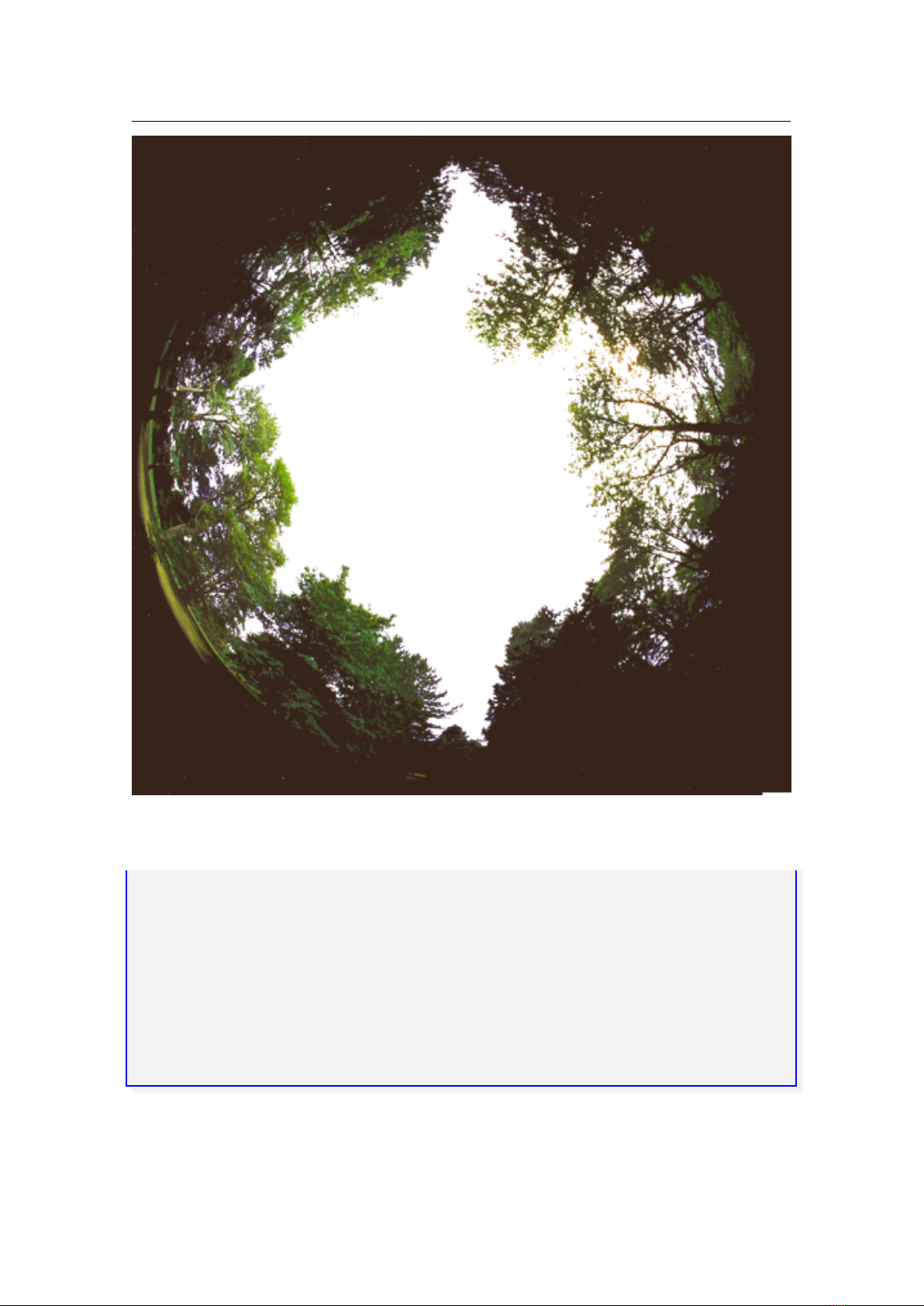
84 Chapter 7. Landscapes
Figure 7.2: Texture for the Trees Fisheye landscape.
type = fisheye
author = Robert Spearman . Light pollution image : Georg Zotti
description = Trees in Greenlake Park , Seattle
maptex = trees_512 . png
maptex_ill um = t rees_illum_512 . png
maptex_fog = trees_fo g_512 . png
texturefov = 210
angle _rotatez = 17
tesselat e_rows = 28
tesselat e_cols = 60
Where:
name appears in the landscape tab of the configuration window.
type identifies the method used for this landscape. fisheye in this case.
author lists the author(s) responsible for images and composition.

7.1 Stellarium Landscapes 85
description
gives a short description visible in the selection panel. The text will be superseded
by optional description.<lang>.utf8 files.
maptex is the name of the image file for this landscape.
maptex_fog (optional) is the name of the fog image file for this landscape.
maptex_illum
(optional) is the name of the nocturnal illumination/light pollution image file for
this landscape.
texturefov is the field of view that the image covers in degrees.
angle_rotatez (optional) Angle (degrees) to adjust azimuth.
tesselate_rows
(optional, default=20) If straight edges in your landscape appear broken, try
increasing.
tesselate_cols
(optional, default=40) If straight edges in your landscape appear broken, try
increasing.
polygonal_horizon_list (optional) see 7.1.3
polygonal_horizon_list_mode (optional) see 7.1.2
polygonal_angle_rotatez (optional, default=0) see 7.1.2
horizon_line_color (optional) see 7.1.2
minimal_brightness (optional) see 7.1.2
minimal_altitude (optional) see 7.1.2
7.1.6 Description
The short
description
entry in
landscape.ini
will be replaced by the contents of an optional
file
description.<LANG>.utf8
.
<LANG>
is the ISO 639-1 language code, or its extension which
contains language and country code, like
pt_BR
for Brazilian Portuguese. The long description
requires the file
description.en.utf8
, this is
en=english
text with optional HTML tags for
sections, tables, etc. You can also have embedded images in the HTML (Views of sacred landscapes,
other informative images, . . . ?), just make them PNG format please. The length of the description
texts is not limited, you have room for a good description, links to external resources, whatever
seems suitable.
If you can provide other languages supported by Stellarium, you can provide translations
yourself, else Stellarium translators may translate the English version for you. (It may take years
though.) The file ending
.utf8
indicates that for special characters like ÄÖÜßáé you should use
UTF8 encoding. If you write only English/ASCII, this may not be relevant.
7.1.7 Gazetteer
An optional feature for landscapes is a gazetteer function, i.e., labels for landscape features. The
Grossmugl landscape demonstrates an example and should be self-explanatory. This is again
multilingual, so the files are called gazetteer.<LANG>.utf8.
# demo g a z e t t e e r for Gross m u g l landscape .
# Can be used to b etter describe the landscape ,
# i. e. show labe ls on l a n d s c ape feat u r e s .
# Fields must be separa t e d by verti c a l line ,
# labe l m ust not have such a v e r t ical line .
# C o m ments have t his hash mark in first co lumn .
# c o o r dinates in d e grees from true North .
# line t o wards z enith draws a singl e line stri c t l y upw ard .
# labe l is c e n tered on line e n dpoint .
# A zimuth | Altitude | de grees | az imuth | label
# | | t owards zenith | shi ft |
11 3.66 | 5.5 | 4 | -6 | L e eberg
35 | 1.5 | 2.5 | 0 | G rossmugl
335 | 2 | 2 | 0 | Steinabru n n
305 | 2 | 1 | 0 | Ringendorf
180 | 2 | 2 | 0 | Vie nna (30 km )

86 Chapter 7. Landscapes
135 | 2 | 0.5 | 0 | Wind power pl ant S t r a s s hof
7.1.8 Packing and Publishing
You likely have developed your landscape already in your own Stellarium user data directory,
but when you are happy with your work, you may consider sharing it with other users. For easy
distribution and installation via Stellarium’s GUI (see section 4.4.5), you should create a ZIP
file. This must contain
landscape.ini
and any textures and auxiliary files described above
(
description.en.utf8
,
gazetteer.en.utf8
and their translations, horizon files, images for
the description .. . ) used by your landscape. If you want to release the landscape for download,
consider adding a
README.txt
clarifying license and usage conditions. It does not matter whether
the ZIP file contains a directory name inside the ZIP. If not, the directory name (ID) of the landscape
will be taken from the ZIP file name.
7.2 Creating Panorama Photographs for Stellarium
7.2.1 Panorama Photography
Traditional film-based panorama photography required dedicated cameras with curved film holders
and specialized lenses (Figure 7.3).
Digital photography has brought a revolution also in this field, and it has become quite easy to
create panoramas simply by taking a series of photographs with a regular camera on the same spot
and combining them with dedicated software.
A complete panorama photo visually encloses the observer like the mental image that as-
tronomers have been using for millennia: the celestial sphere. If we want to document the view,
say, in a big hall like a church, optimal results will be gained with a camera on a tripod with a
specialized panorama head (Figure 7.4) which assures the camera rotates around the entrance
pupil
9
of the lens in order to avoid errors by the parallax shift observed on photographs taken on
adjacent but separate positions.
Often however, both the upper half of the observer’s environment (the sky) and the ground
the photographer is standing on, are regarded of lesser importance, and only a series of laterally
adjacent photographs is taken and combined into a cylindrical or spherical ring that shows the
landscape horizon, i.e., where ground and sky meet. If the closest object of interest is farther
away that a few metres, requirements on parallax avoidance are far less critical, and the author has
taken lots of landscape panoramas with a camera on the usual tripod screw, and even more entirely
without a tripod. However, any visible errors that are caused by a shifted camera will require more
effort in postprocessing.
When you have no tripod, note that you must not rotate the camera on your outstretched arm!
Rather, the camera’s entrance pupil must be rotated, so you should appear to dance around the
camera!
The images should match in brightness and white balance. If you can shoot in RAW, do so to
be able to change white balance later. If the camera can only create JPG, ensure you have set the
camera to a suitable white balance before taking the photos and not to “auto”, because this may
find different settings and thus give colour mismatches. Exposure brightness differences can be
largely removed during stitching, but good, well-exposed original shots always give better results.
9
In many references you will find “Nodal Point” mentioned here. But see these:
https://en.w
ikipedia.org/wiki /Cardinal _point_%28optics%29#Nodal_points
,
http://web.archive .
org/web/20060513074042/http://doug.kerr.home.att.net /pumpkin/Pivot_Point.pdf
,
http://www.janrik.net/PanoPostings/No ParallaxPoint/TheoryOfTheNoParallaxPoint.pdf

7.2 Creating Panorama Photographs for Stellarium 87
Figure 7.3: Zenit “Horizon 202” panorama camera with rotating lens for 35mm film.
(Source: Wikipedia, “Horizon202” by BillC - Own Work. Licensed under CC BY-SA 3.0 via Wikimedia
Commons - https://commons.wikimedia.org/wiki/File:Horizon202.jpg)
Figure 7.4: Automated panorama head. (Source: Wikipedia
https://commons.wikimedia.org/
wiki/File:Rodeon_vr_head_01.jpg)

88 Chapter 7. Landscapes
As a general recommendation, the images of a panorama should be taken from left to right,
else please accordingly invert some of the instructions given below.
There are several panorama making programs. Often they are included in the software that
comes with a digital camera and allow the creation of simple panoramas. Other software titles are
available for purchase. However, there is one cost-free open-source program that does everything
we need for our task, and much more:
7.2.2 Hugin Panorama Software
Hugin
10
, named after one of the ravens that sits on Odin’s shoulder and tells him about the world,
is a user-friendly catch-all package with graphical user interface that allows creating panoramas
with a single application. Actually, Hugin is a GUI application which calls several specialized
sub-programs with fitting parameters. The instructions are based on Hugin V2014.0 and 2015.0.
Typically digital images come in JPG format with information about camera, lens, and settings
stored in invisible metadata in the EXIF format. When Hugin reads such images, it can automatically
derive focal length, field of view, and exposure differences (exposure time, aperture, color balance)
to create panoramas as easily as possible.
After starting Hugin for the first time, select
Interface Expert
to release several options not
visible to “beginners”. In the Preferences dialog (
Files Preferences
), edit number of CPU to
match the number of cores in your computer and allow parallel processing. E.g., if you have an
Intel Core-i7, you usually can set up to 8 cores (4 cores with hyperthreading; but maybe leave
one core for your other tasks while you wait for a processing job?). If your PC is equipped with a
modern programmable graphics card, you can enable its use in the
Programs
tab with activating
“Use GPU for remapping”.
After that, we are ready for creating our panoramas.
7.2.3 Regular creation of panoramas
The graphical user interface (GUI) consists of a main menu, symbols, and 4 tabs. We start on the
tab Photos.
•
Add images. . .
Opens a file browser. Select the images which you want to stitch. Usually,
lens data (focal length, horizontal field of view
11
, . . . ) are read from the EXIF data. If those
are not available (e.g. cheap cameras, images scanned from film), you can enter those data on
loading or later. The images are now listed in the file list, and you can edit image parameters
by marking one or more, and then choosing from the context menu which you get from
pressing the right mouse button. In case you have used different lenses (or inadvertently
used different focal lengths of a zoom lens), you can assign separate lenses to the images.
Caveat: If you have resized the images, or produced copied on your RAW converter with
non-native resolution, the horizontal Field of View (FoV) in Hugin may be misidentified.
You must edit lens parameters and fill in the field of view from a full-size image. Else the
first round of optimisation will run into unsolvable trouble.
•
Select one image as position anchor (usually the center image), and one as exposure anchor
(this can be the same image). For our purpose, the anchor image should face south.
•
Next, we must find common feature points. The next field below provides the required
settings. It is recommended to use the CPFind command. To avoid finding control points in
(moving) clouds, select setting
Hugin’s CPFind + Celeste
12
. Then press
Create control points
.
This opens a dialog box in which you can see output of the selected feature point extractor.
10
http://hugin.sourceforge.net/
11
contrary to Stellarium, field of view (FoV) in Hugin means the horizontal extent in degrees.
12
If you forget this, you can remove cloud points by calling Celeste in the control point editor later

7.2 Creating Panorama Photographs for Stellarium 89
It should finish with a box telling you the number of identified points. In rare cases some
images cannot be linked to others, you will have to manually add or edit feature points in
those cases.
•
Now it’s time to start optimisations. On the
Geometric Optimimisation
combo, start with
the button
Positions, incremental from anchor
, and press
Calculate
. Moments later, a first
rough match is available for inspection.
•
First open the Preview window (press
Ctrl
+
P
or click the blue icon). Assumed your
images cover the full horizon, the window shows an equirectangular area (360 degrees along
the horizon and 180 degrees from zenith to nadir). The anchor image should be close to the
image center, and the other images should be already well-aligned to both sides. You can set
the exact center point by clicking it in the image. If the horizon appears badly warped, use
the right mouse key and click on the horizon roughly near
−90
or
+90
degrees (halfway to
the left or right).
•
Open the OpenGL preview window (press
Ctrl
+
Shift
+
P
or click the blue icon with GL
inside). This panel provides several important views:
–
The
Preview
tab is similar to the non-OpenGL preview. You can display an overlay of
the control points, which are colored according to match quality. Also, with button
Identify
activated, you see the overlapping image frames when you move the mouse
over the image.
– The
Layout
tab helps finding links between images.
– The
Move/Drag
dialog may help to interactively adjust a panorama.
Sometimes the preview image may however be distorted and unusable.
•
Open the Control Points Table dialog (press
F3
or click the “table” button). Here you see
the points listed which link two images. Clicking a column label sorts by this column. It is
recommended that only neighboring overlapping images should be included here. If you
have very large overlap, it is possible that points are found between two images which are
not directly adjacent. In the OpenGL preview window, you can use the
Preview
or the
Layout
tabs to identify those image pairs. Such points should be deleted. In the point table,
click on columns “Right Img.”, then “Left Img.”, and then find pairs like 0/2, 1/3, 2/4 etc.
Mark those lines, and delete the points.
•
To re-run the optimisation, press the double-arrow icon or the
calculate
button in the
Optimise/Geometric area.
Preliminary Geometric Optimisation
Now the (usually) longest part begins: Iterative optimisation of the photo matchpoints. If your
images were taken on a panorama tripod head, there should only be very few bad matchpoints, e.g.
those found on persons or clouds
13
which have moved between photos. For handheld photos, the
following considerations should be observed.
The most important line which we want to create in all perfection is the visible horizon, where
sky and earth meet. The foreground, usually grassy or rocky, is of lesser interest, and stitching
errors in those areas may not even be relevant.
Therefore, matchpoints with large errors in the foreground can be safely removed, while, if
necessary, points on the horizon should be added manually. Use the
Control Points
tab, select
adjacent images (start with 0 on the left and 1 on the right side), and delete the worst-fitting
matchpoints closest to the camera (near the bottom of the images). We now start a long phase of
re-optimizing and deletion of ill-matching points as long as those are far from the horizon. When
all near matchpoints are deleted, the result should already look not too bad.
For continued optimisation, the number of parameters to optimize can be extended. To begin,
13
You should have created control points with the Celeste option!

90 Chapter 7. Landscapes
I recommend
Positions and View (y, p, r, v)
, which may find a new focal length slightly different
from the data in the EXIF tags. Again, delete further foreground points. If after a few rounds you
still have bad point distances, try
Positions and Barrel Distortion (y, p, r, b)
to balance distortion by
bad optics, or even go up to
Everything without translation
. Optimisation can only reach perfect
results if you did not move between exposures. Else, find a solution which shows the least error.
In case you took your photos not on a tripod and moved too much, you may even want to play
with the translation options, but errors will be increasingly hard to avoid.
Using Straight Edges as Guides
If the panorama contains straight lines like vertical edges of buildings, these can be used to automat-
ically get a correctly leveled horizon: Vertical lines are mapped to vertical lines in equirectangular
panos! In the
Control Points
tab, select the image with the vertical edge in both subframes, and
mark points on the vertical edge. (switch off auto-estimate!). Likewise, horizontal lines may help,
but make sure lines like rooves are perpendicular to your line of view, else the perspective effect
causes an inclination.
Multi-ring Panoramas
If you are trying to create a panorama with several rings (horizon, one or two rings below, and
nadir area), you must try to create/keep control points that best give a result without visible seams.
In this case, and esp. if you have only used a regular tripod or even dared to go for a free-handed
panorama, you may observe that it is best to remove control points in neighboring photos in the
lower rings, but keep only the “vertical” links between images with similar azimuth.
In total, and if the foreground is not important but only grassy or sandy, the rule of thumb is
that the horizon images must be strongly linked with good quality (small errors), while images in
the lower rings should be linked mostly to their respective upper photos, but not necessarily to the
images to its sides. The resulting panorama will then show a good horizon line, while stitching
artifacts in a grassy or otherwise only decorative ground will usually be acceptable and can, if
needed, be camouflaged in post-processing.
This optimization and editing of control points is likely a longish iterative process, and these
are the late night hours where you will finally wish you had used a panorama head. . .
Masking
If you have images with overlapping areas, you can usually not force Hugin to take pixels from the
image which you find best. you can however mask off an area from an image which you don’t want
to see in the output under any circumstances, e.g. a person’s arm or foot in one image. Just open
the image in the
Mask
tab and either press
Add new mask
and draw the mask polygon covering
the unwanted area, or use the crop settings to define rectangular areas to use.
Exposure disbalance
In the
Photos
tab, select
Photometric parameters
on the right side. The EV column lists the
Exposure Value. If you see disbalance here and in the preview window, you can run a photometric
optimization with the lowest button on the
Photos
tab. Simply select Low dynamic range and press
Calculate
. The preview should now show a seamless image. If all else fails, you can edit the EV
values directly.
Advanced photographers may want to correct exposures in their RAW images before creating
JPG or TIF images to combine with Hugin. This unfortunately may create exposure disbalance
because the EXIF tags may not be adjusted accordingly, so based on different exposure/f-stop
combinations Hugin may think it has to re-balance the values. In these cases, don’t run the
photometric optimizer. Some image exposure values have to be changed manually, and the effect
supervised in the preview window. Usually the smooth blending in the subprogam enblend called

7.3 Panorama Postprocessing 91
by Hugin will hide remaining differences.
Stitching
When you are happy with the panorama in the preview window and the match-points promise a
good fit, it is time to finally create the panorama image. Hugin can create a large number of different
projections which all have their application. For Stellarium, we can only use the equirectangular
projection. You still have 2 options:
spherical
landscapes (see 7.1.3) require single equirectangular images, the maximum size depends
on your graphics hardware and Qt limitations and is likely not larger than
8192 × 4096
pixels.
old_style
landscapes (see 7.1.4) can use several textures for the ring along the horizon, and one
image for the nadir zone. If you need high resolution, you should aim for creating this one.
Sometimes, creating the nadir zone is difficult: this is where usually the view is blocked by the
tripod, and we are not interested in views of tripod or our own feet. For our purpose it is usually
enough to fill in the feet area using the clone stamp, or a monochrome color, or, for
old_style
landscapes, you can instead insert an oriented site map or wind rose.
There is a button
create optimal size
in Hugin. It may recommend a panorama width around
13.000 pixels for an average camera and photos taken with a wide-angle lens. Increasing this
size will most likely not lead to higher optical resolution! The panorama width which you can
most usefully create depends on the resolution of the source images (which leads to the result
given by Hugin) and on your needs. If you need arc-minute resolution, you would aim for
360 × 60 = 21600
pixels, which cannot be loaded into graphics memory in a single piece, i.e.,
is too large for Stellarium, and must be configured as
old_style
landscape. In this case, 10 or
11 tiles of
2048× 2048
pixels (totalling 20480 or 22528 pixels) is the closest meaningful setting,
i.e., you could create an image of 20480 pixels width and cut this into usable pieces. Usually, a
size of
4096× 2048
or
8192× 4096
pixels (for better computers) is enough, and can be used in a
spherical landscape.
We have to edit the file after stitching, therefore select creation of an image in the TIFF format.
LZW compression is non-lossy, so use this to keep file size reasonably small.
For regular images, it is enough to create “Exposure corrected, low dynamic range”. If you
have a problem with persons that have moved between your images, you may want to post-process
the final result with import of the distorted sub-images and manually defining the best blending line.
For this, find the “Remapped Images” group and again activate “Exposure corrected, low dynamic
range”.
Now, press the
Stitch!
button in the lower right corner. This opens a helper program which
supervises the stitching process. Depending on your computer and size of the image, it will require
a few minutes of processing.
In case stitching fails with a cryptic error message, try to add the option --fine-mask to the
enblend options.
Store a copy of the Hugin project file to always be able to go back to the settings you used to
create the last panorama. We will get back to it when we want to make a truly calibrated panorama
(see 7.3.3).
7.3 Panorama Postprocessing
The image created has to be further processed to be used in Stellarium. The most obvious change is
the need for a transparent sky, which we can easily create in programs like Adobe Photoshop or
the free and open-source GIMP. I will describe only the free and open-source solution.
After that, we have to bring the image into shape for Stellarium, which may include some

92 Chapter 7. Landscapes
trimming. While we could also slice an image with interactive tools, higher accuracy and repeatable
results can be achieved with command-line programs, which makes the ImageMagick suite the
tool of our choice.
7.3.1 The GIMP
The GIMP (GNU Image Manipulation Program) has been developed as free alternative to the
leading commercial product, Adobe Photoshop. While it may look a bit different, basic concepts
are similar. Not everybody can (or wants to) afford Photoshop, therefore let’s use the GIMP.
Like Photoshop, the GIMP is a layer-aware image editor. To understand the concept, it is
easiest to imagine you operate on a growing stack of overhead slides. You can put a new transparent
slide (“layer”) on top of the stack and paint on this without modifying the lower layers.
A few important commands:
Zooming
Ctrl
+
Mouse Wheel
Layer visibility and transparency
Make sure to have layer dialog shown (
Windows Dockable Dialogs
).
A gray bar indicates opacity for the currently active layer. Note the mouse cursor in this
opacity bar (often also called transparency bar): near the top of the bar the upward pointer
immediately sets percentage. A bit lower the pointer looks different and can be used for
fine-tuning.
The most obvious post-processing need for our panorama is making the sky transparent. The
optimal tool usually is the “Fuzzy Select”, which is equivalent to the “Magic Wand” tool in
Photoshop. Simply mark the sky, and then delete it. The checkerboard background indicates
transparent pixels.
It sometimes helps to put an intensive bright red or blue background layer under the panorama
photo to see the last remaining clouds and other specks. In the layer dialog, create a new layer,
bucket-fill with blue or red, and drag it in the layer dialog below the pano layer. Write-protect this
layer, work on the image layer, and before exporting the image layer with transparent sky to PNG,
don’t forget to switch off the background.
We need this layer functionality especially to align the panorama on a calibration grid, see
section 7.3.3.
7.3.2 ImageMagick
ImageMagick (IM)
14
can be described as “Swiss Army Knife of image manipulation”. It can do
most operations usually applied to images in a GUI program, but is called from the command line.
This allows also to include IM in your own command scripts
15
. We will use it to do our final cut
and resize operations. I cannot give an exhaustive tutorial about more than a few of IM’s functions,
but the commands given here should be enough for our purpose.
To open a command window (console, a.k.a. DOS window), press the Windows key and enter
cmd, then press . (On Linux and Mac, you surely know how to open a console window.)
There are some things you might need to know:
• The command line is not your enemy, but a way to call expert tools.
• The Windows command line processor cmd.exe is far from user friendly.
•
There are remedies and alternatives. See notes on clink (7.5.3) for a considerable improve-
ment, and WSL (7.5.4) for experts.
Command-line magick for spherical landscapes
Let’s start with the commands for final dressing of an equirectangular panorama to be used as
spherical landscape which has been created in size
4096 × 2048
, but where you have seen that
14
https://www.imagemagick.org/
15
These may typically be .BAT files on Windows, or various shell scripts on Linux or Mac.

7.3 Panorama Postprocessing 93
nothing interesting is in the image above 11.25
◦
. This means we can cut away the sky area and
compress the image to 4096× 1024 to save graphics memory.
16
To understand the numbers in the example, consider that in a panorama image of
4096× 2048
pixels, 1024 pixels represent 90
◦
,
512px = 45
◦
,
256px = 22.5
◦
,
128px = 11.25
◦
. To keep a top
line of
11.25
◦
, we keep an image height of
1024 + 128 = 1152px
, but the crop starts at pixel
Y = 1024 − 128 = 896.
convert landscape . png - crop 4096 x1152 +0+896
- resize 4096 x1024 ! landsca pe_ cro ppe d . png
Note the exclamation mark in the -resize argument, which is required to stretch the image in a
non-proportional way.
Alternatively, you can operate with IM’s “gravity”, which indicates the corner or edge geometric
offsets are referred to. Given that we want the lower part of the image to exist completely, you only
need to compute the size of the cropped image:
convert landscape . png - gravity SouthWest - crop 4096 x1152 +0+0
- resize 4096 x1024 ! landsca pe_ cro ppe d . png
You still need the addition
+0+0
in the -crop option, else the image will be cut into several pieces.
In the file landscape.ini, you then have to set maptex_top=11.25.
Command-line magick for old_style landscapes
Let us assume we want to create a high-resolution landscape from a pano image of width 16384
which we have carefully aligned and calibrated on an oversized grid template that also shows a
measured horizon line (see 7.3.3). Usually it is not necessary to create the full-size image, but only
the horizon range, in this high resolution. Assume this image has been aligned and justified on
our grid image and is
HEIGHT
pixels high, the left border is at pixel
X_LEFT
, and top border (i.e.,
the point where relevant content like the highest tree is visible) is on pixel
Y_TOP
. Assume our
graphics card is a bit oldish or you aim for maximum compatibility, so we can load only textures of
at most 2048 pixels in size. Given that the horizon area usually only covers a few degrees, a vertical
extent of
2048px
seem a pretty good range for that most interesting zone. The ground can then be
filled with some low-resolution image of grass, soil, or a properly oriented site map, or you can use
Hugin to create a ground image (and using the maximum of
2048× 2048
also here usually is far
more than enough).
In GIMP (or Photoshop, . . . ), we must find the values for
X_LEFT
,
Y_TOP
and
HEIGHT
.
HEIGHT
is being resized to 2048, strictly, by the exclamation mark in the resize command. We can create
our image tiles now with this singular beast of a command line (write all in 1 line!), which puts our
files directly into STELLARIUM_LANDSCAPEPATH/LANDSCAPE_NAME:
convert PANO . png - crop 16384 xHEIGHT + X_LEFT + Y_TOP + repage
- resize 16384 x2048 !
- type TrueColo rMa tte - depth 8
- crop 2048 x2048 + repage
png : STEL LARIUM_ LANDSCA PEP ATH / LANDSCAPE_NAME / Horiz -% d. png
This creates 8 images. See section 7.1.4 for the
landscape.ini
where these images can be
referenced. Don’t forget to read off top and bottom lines (altitudes in degrees) from your grid,
the vertical extent will form the
decor_alt_angle
, and the bottom line the
decor_angle_shift
entries in this file.
16
Most modern graphics cards no longer require the “powers of two” image sizes, but we keep this practice
to increase compatibility.

94 Chapter 7. Landscapes
Creating a ground image for old_style landscapes
When you want a good ground image for an
old_style
landscape from your panorama and not
just fill the
groundtex
with a monochrome texture or a map, you have to create a ground view in
Hugin. But you may have already created a huge pano! This can also be used as source image, and
a ground shot can be extracted with a reversed operation. In principle, all you need to know is the
field of view around the nadir. Figure 7.5 shows a simple configuration file.
# hugin project file
# hug in_ pto ver sio n 2
p f0 w2048 h2048 v92 E0 R0 n " TIFF_m c: LZW r: CROP "
m g1 i0 f0 m2 p0 .00784314
# image lines
# - hugin cropFactor =1
i w16384 h8192 f4 v360 Ra0 Rb0 Rc0 Rd0 Re0 Eev0 Er1 Eb1 r0
p90 y0 TrX0 TrY0 TrZ0 Tpy0 Tpp0 j0 a0 b0 c0 d0 e0 g0 t0
Va1 Vb0 Vc0 Vd0 Vx0 Vy0 Vm5 n " E qirect_Pano360 . png"
Figure 7.5: Project file
ground.pto
usable to create the ground image with Hugin or, on
the command line, its nona stitcher. The last line, starting with
i
, has been wrapped, but
must be 1 line.
Say, the side panels extend down to
decor_angle_shift=-44
degrees, which means you
must close the ground with a Nadir
FoV = 2× (90− 44) = 92
. For maximum compatibility, we
will again make an image of width and height both 2048
px
. These values can be found in the
p
line
in Figure 7.5. The
i
line describes the input image, which is our full equirectangular pano of width
w= 16384 and height h= 8192. The last argument of that line is the image file name.
For processing, we do not use the Hugin GUI, but simply the command line. The actual
program to call is nona. If your stitched panorama is a 16-bit TIFF, nona will also make a 16-bit
image, but our textures are limited to 8-bit PNGs. We apply our most useful tool, convert from the
ImageMagick suite.
nona -v -m PNG ground . pto -o ground . png
convert ground . png - depth 8 ground_8bit . png
The file ground_8bit.png is then used in the groundtex field on landscape.ini.
7.3.3 Final Calibration
The creation of a calibrated panorama (which can be regarded as dependable proxy for further
measurements taken inside Stellarium) requires reference measurements to match the photos against.
We must take azimuth/altitude measurements with a theodolite or total station, in the optimal case
along the full horizon, and in addition I recommend to take azimuth and altitudes of some distinct
features along the horizon which must also be visible in the photographs: mountain summits,
electrical towers, church towers, .. .
I recommend you create grid templates of the sizes you are going to create, e.g. 4096, 8192,
16386 and 20480 pixels wide with some diagram tool. On these, you can then also draw the
measured horizon line.
Now, load a panorama on top of this in the GIMP, i.e., copy it into a separate layer over the grid
image, and set it semi-transparent.
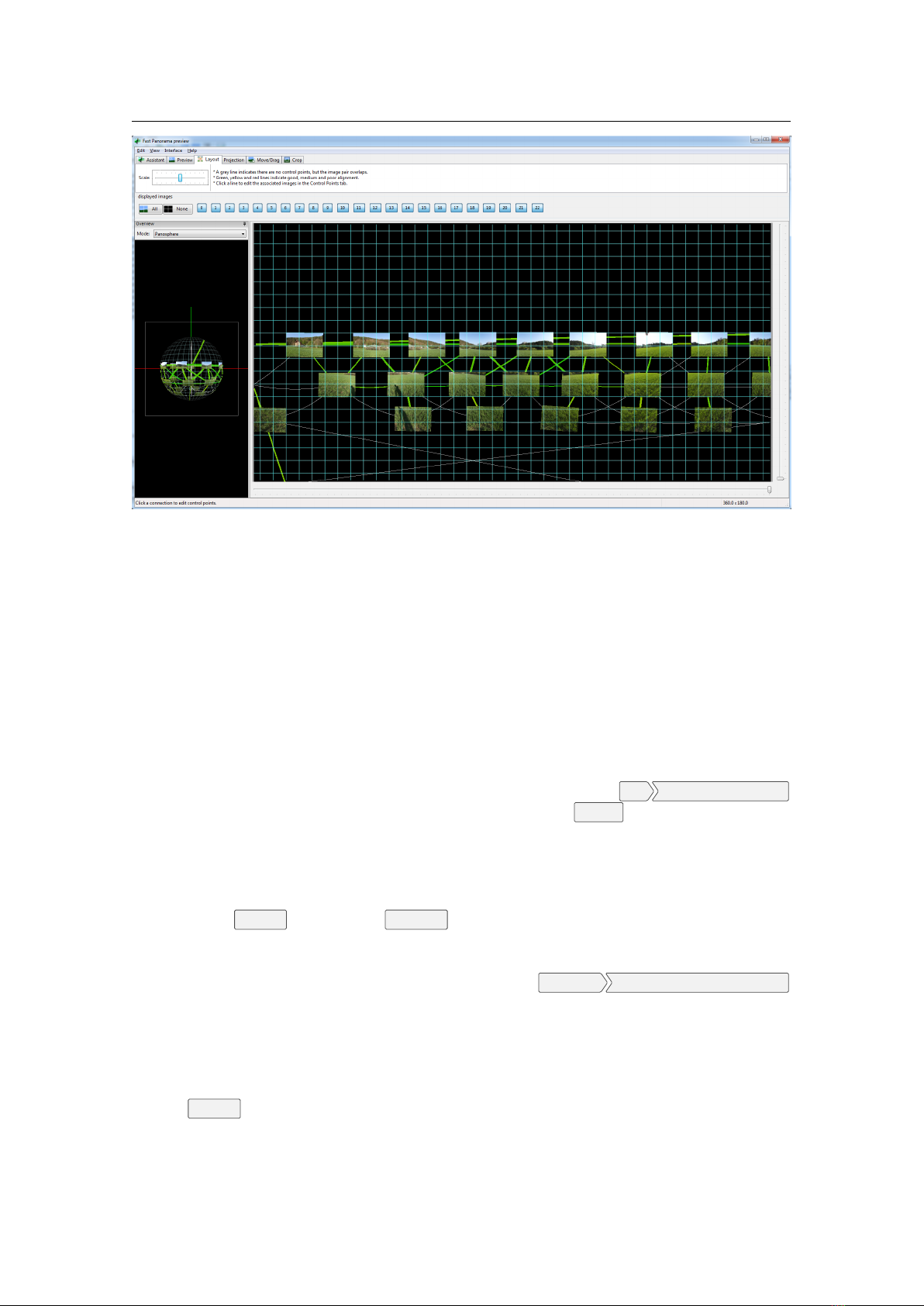
7.3 Panorama Postprocessing 95
Figure 7.6: Hugin’s Fast Panorama Preview can be used to check which images are
connected to its neighbors. Most important are good matches along the horizon, the images
in the lower rows are clearly less important. If captured on a tripod, they should still match.
Try to align the center of the image (where the geometric anchor has been defined; remember:
this should be the image pointing south!) with the measured horizon line or the distinct features.
The optimal solution consists of a photo panorama which aligns perfectly with the measured
line and features. We now have to iteratively bring deviations to a minimum. The process depends
on processor speed, image size, your training and – most of all – your requirements in accuracy!
In the GIMP, load your grid image with horizon line. Now select
File Open as Layers. . .
,
load your photo panorama, and then set layer transparency in the
Layers
dialog to about 50%.
Select the double-arrow tool to move the panorama via mouse drag and cursor keys over the
grid, and align the outline of the photo horizon’s southern point with the measured line. Now it’s
time to estimate the quality of the panorama.
In Hugin’s
Photos
tab, select the
Positions
view on the right side. Now you see “Yaw”, “Pitch”
and “Roll” values of camera-to-world orientation listed in the photos list. It should now be possible,
by changing the values only for the anchor image and re-optimizing, to come to a panorama with
only minimal error. In the process, start with Optimizing
Positions incremental from anchor
,
then go for view and barrel optimization, and so on. Always try to remove foreground match points
which have large error and are irrelevant for the task to match the horizon. Those are especially
cross-matches of horizon and sub-horizon rows of images. Only vertically and horizontally adjacent
images should be required to match. For handheld panoramas, also links between adjacent images
in the non-horizontal rows are usually too erroneous to be useful, just remove these match points.
Use the
Layout
tab in the Fast Panorama Preview to see the relations between images (Fig. 7.6):
Red lines have big errors, green lines are good, thin gray lines indicate possible overlap without
specified match points. After each optimization step, export a new pano image, load as layer in
GIMP, and check again.

96 Chapter 7. Landscapes
Basic rules to observe (use obvious inverses).
•
If image aligns well in azimuth but overshoots the grid to the right: Increase yaw accord-
ingly (0.022
◦
/pixel if image is 16384 pixels wide).
•
If the north end (left and right borders) is higher than the southern contact point: Increase
pitch angle.
•
If north and south points are OK, but the western (right) half is higher than the eastern
(left) half: Increase Roll angle.
The corrections required for pitch and roll may be surprisingly small!
Within a few rounds of adjustments, panorama creation, adding as layer in the image editor,
and comparing to the reference data, you should achieve a match to fit your needs.
In case you have taken photographs in several rings but without a panorama tripod, you
may have to first align only the horizontal images (deselect the lower images to exclude from
optimization), and when the horizon ring is aligned perfectly, deactivate further optimization in
Hugin for those photos while “attaching” (optimizing) the lower photos. In Hugin’s
Photos
tab,
select
Optimize Geometric Custom Parameters
. This opens an extra tab
Optimizer
, where
you can fine-tune your needs: Switch off all variables for the photos in the horizon ring, and make
sure the lower photos fit in the preview after optimization.
It may even help to define that the lower rows have been taken with a different Lens, so the
field of view and distortion settings of the horizon row will be used as it had been found during the
horizon-only match.
By now you should have enough experience what level of error may be acceptable for you.
7.3.4 Artificial Panoramas
I have created a website
17
where you can enter geographical coordinates and download a file
pano.kml
which helps with image creation from Google Earth imagery. Store this file for a site,
let us call it MYPLACE, into a new directory GE_MYPLACE inside your landscapes directory.
Store all scenes visible from the respective viewpoint MYPLACE as picture into one common
folder in your
landscapes/GE_MYPLACE
under the viewpoint name, e.g.,
75-30.jpg
, which
means 75 degrees from Nadir, azimuth 30 degrees. Also, double-click the pano entry or the marker
in Google Earth to open a window with the basic content of your
landscape.ini
. Copy and paste
from there into a new file
landscape.ini
and adjust the obvious entries. Complete as required
with the entries described in section 7.1.3.
On loading of the images, Hugin will not be able to detect any EXIF lens data and ask you
for the horizontal field of view. Enter 60 degrees, which is the standard value for Google Earth
screenshots
18
.
The viewpoint names translate almost directly to the yaw and pitch angles which you can enter
in the image list in Hugin’s
Photos
tab. For example, switch to the
Positions
display on the right
window edge in the
Photo
tab, mark all images that start with
25-
and assign a pitch angle of
−90+ 25 = −65
. The second part of the names is directly the azimuth. In this case, don’t run the
optimizer, but you can immediately set an output resolution and stitch (see 7.2.3). To get rid of
the image decorations (compass etc), apply masks
19
. Post-processing steps are the same as for
photo-panoramas: make sky invisible, crop, etc.
It is also interesting to switch on the 3D buildings layer before creating the images. If temples
or other buildings are accurate, this will give an even closer approximation to what would be visible
on-site. Note however that not every building will be modelled in usable quality, and that usually
17
https://homepage.univie.ac.at/Georg.Zotti/php/panoCam.php
18
Note that if you work with Google Earth Pro, you can create different FoV!
19
There is a wide overlap in the images to allow generous trimming.

7.4 Troubleshooting 97
vegetation is not included in the 3D buildings layer. Also, if you are too close to buildings, they
may be cut away by the near clipping plane of the rendering.
These images, based on Google Earth imagery and the SRTM topographic model, seem usable
as first rough approximation to a photo-based or surveyed panorama. Note that it is definitely not
accurate enough for representing nearby horizon features or critically important mountain peaks,
and please note that Google has image copyright which at least requires you to acknowledge when
displaying these pictures.
7.3.5 Nightscape Layer
Since version 0.13, Stellarium can simulate artificial illumination, like streetlamps, bright windows,
or the skyglow over cities (Zotti and Wuchterl, 2016). One way to create this layer is to make 2
panorama series during the day and night and process these in the same Hugin project to align
those photos, and then stitch two separate images by selecting either the daylight or the nighttime
shots. The night panorama has to be processed to remove stars, airplanes, etc.
The other way is a simple layer overpainted in the image processing program. As rough
recommendation, use several layers to prepare this feature:
•
Put a semitransparent black layer over your daylight image, this helps you to place your
painted pixels.
• Paint windows, street lamps, signs, .. . . You may apply a layer style to produce some glow.
•
To draw an impression of more light in the atmosphere (city skyglow), use a gradient with
some brownish color. Generally the color depends on the appropriate mix of city lights
(sodium, mercury vapour, etc.). Note that on the city outskirts a simple vertical gradient will
not work, towards the city the horizon is much brighter. Use a huge but weak brush to make
a more spotty sky.
•
Use the existing landscape as template for the layer mask for this gradient sky layer. (You
want to hide skyglow by leaves in the foreground!)
•
If you want to add only a few lights to an
old_style
landscape, you need to provide only
the panels showing those lights. Just load a side panel for reference, place a new layer on top,
and paint the lights on windows, lamps etc. There is no light option for the ground texture.
This makes
old_style
landscapes best suited for localized light pollution, not city skyglow.
The resulting image is then declared in the
maptex_illum
line of
landscape.ini
. Try also
to balance the global strength of light pollution with the
light_pollution
key, and a probable
minimal brightness with the minimal_brightness key.
Try to match the visual appearance, not necessarily what photographs may have recorded.
E.g., the Grossmugl sky shows horizon glow mostly towards the city of Vienna, where long-time
exposures may already be saturated.
The possibilities seem limited only by your time and skills!
7.4 Troubleshooting
If something does not work as described and Stellarium does not show your landscape as expected
but maybe just a bright magenta-colored box, don’t panic. Double and triple-check the entries in
landscape.ini
. Make sure the texture is in PNG format and the file name is correct. Check
the logfile for error messages. If the image is too large, it will be re-scaled on loading, but it is
more efficient to keep images as small as required. Only few systems can use textures larger than
16384× 16384 Pixels. If you need high resolution, use the old_style type (see section 7.1.4).

98 Chapter 7. Landscapes
7.5 Other recommended software
Here is a short collection of other useful programs for (panorama) image manipulation and other
tasks on Windows.
7.5.1 IrfanView
IrfanView is a free image viewer for Windows with many options. It can show almost any image
format, including several camera RAW formats, in windowed and full-screen mode. It is definitely
preferable over any image viewer built into Windows. Unfortunately however, it has no panorama
viewer function!
7.5.2 FSPViewer
FSPViewer
20
by Fulvio Senore is an excellent panorama viewer for equirectanglar images. Images
centered along the horizon can be viewed directly, while settings for images with different minimum
and maximum angles, as well as “hotspots” (similar to hyperlinks) which move to neighboring
panoramas, can be configured in an .FSV text file like figure 7.7.
Im ageName = Horizon_Rosenburg . jpg
WindowTitle = Horizon_Rosenburg
hFov =70
# Formula : HP =100*( h /2 - upper )/( lower - upper ) in Hugin crop , or
# HP =100* zeroRow / imgH eight
HorizonPosi tio n =33.8
Figure 7.7: FSP configuration file (example)
7.5.3 Clink and GNUWin32
Clink
21
is a command line enhancement for Windows developed by Martin Ridgers. If you have
ever worked under a Linux bash-like command line, you will easily feel that Windows’ cmd.exe
is extremely limited. Clink provides several useful features, most notably a really usable command-
line completion. It is not essential for our tasks, but a general improvement of usability of the
Windows command line which else has not caused me any trouble.
Compared to Linux, the command line of Windows can still be a humbling experience. None
of the wonderful helpers taken for granted on Linux are available. Many of the nice tools known
and taken for granted by Linux users (make, sed, awk etc.) have also been made available as
standalone commands for Windows. If you don’t need the inline scripting capabilities in
Makefile
s
which you would get from a more complete Linux installation but just want to call awk or sed
inside your .BAT scripts, maybe this is enough.
7.5.4 WSL – Windows Subsystem for Linux
Finally, the 64-bit editions of Windows 10 come with an optional feature that allows you to
install a complete Linux distribution like Ubuntu inside your Windows system. Combined with
an X11 server like XMing
22
, you can even run graphic applications like Stellarium, and all the
command-line tools are available.
20
Further details are available on its home page http://www.fsoft.it/FSPViewer/.
21
http://mridgers.github.io/clink/
22
https://sourceforge.net/projects/xming/
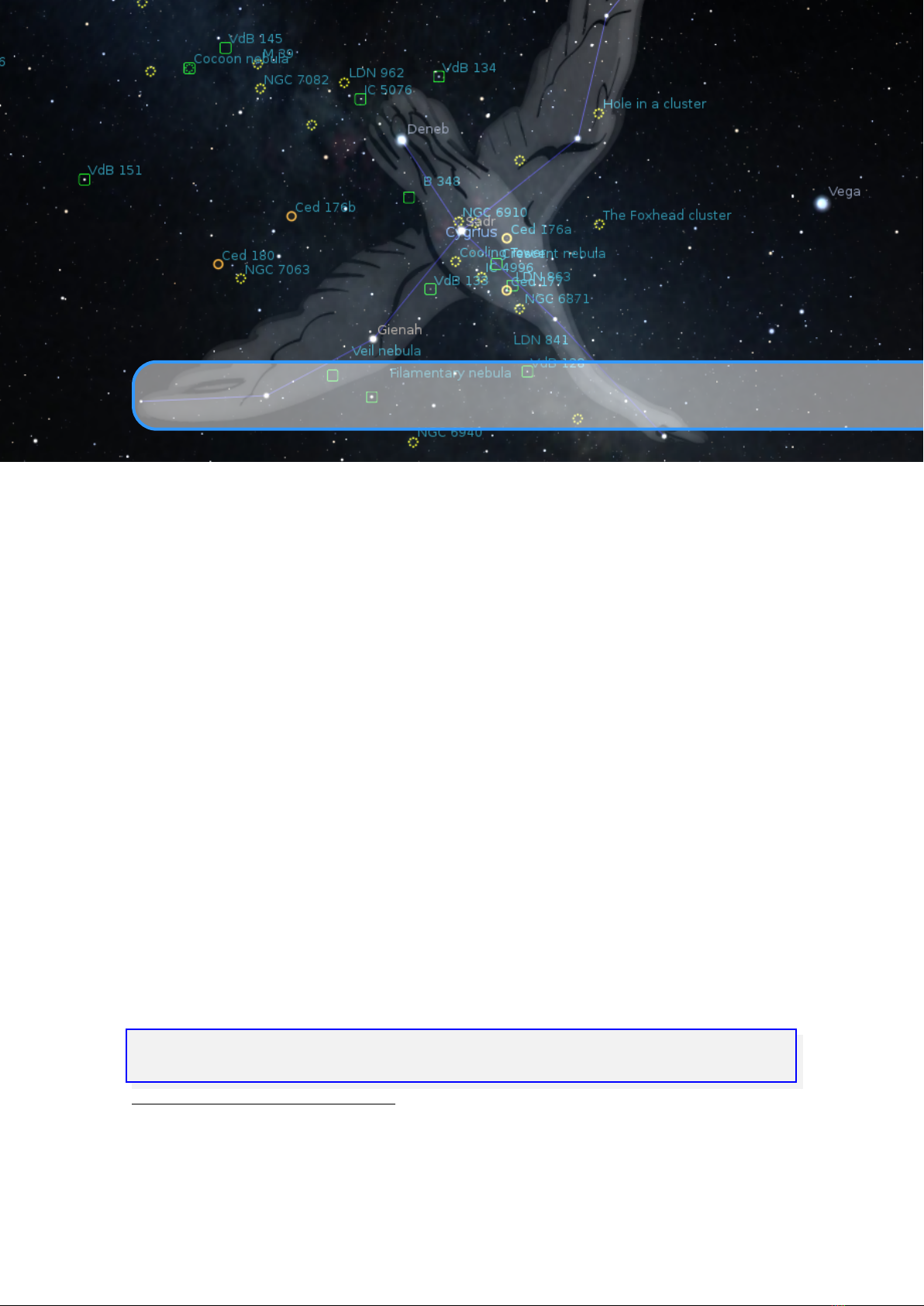
8. Deep-Sky Objects
Since version 0.10.0 Stellarium uses the “json” cataloguing system of configuring textures. At
the same time the Simbad online catalogue was added to the search feature, making the catalog
somewhat redundant and used now only as a first search point or if there is no Internet connection.
If the object has a name (not just a catalogue number), you should add one or more records
to the
.../nebulae/default/names.dat
file (where
...
is either the installation directory or
(preferably) the user directory). See section 8.1.2 Modifying
names.dat
for details of the file
format.
If you wish to associate a texture (image) with the object, you must add a record to the
.../nebulae/default/textures.json file. See section 8.1.3 for details.
If you wish to associate an outline with the object, you must add the series of lines to the
.../nebulae/default/outlines.dat file. See section 8.1.4 for details.
8.1 Stellarium DSO Catalog
Stellarium’s DSO Catalog contains over 94000 objects
1
(up to
15.5
m
for galaxies) and is available
for end users as collection of files:
catalog.txt Stellarium DSO Catalog in ASCII format for editing data
catalog.dat Stellarium DSO Catalog in zipped binary format for usage within Stellarium
2
names.dat List of proper names of the objects from file catalog.dat
An edited ASCII file can be converted into binary format through enabling an option in the file
config.ini (See 5.4):
[ devel ]
convert_d so_ catalog = true
1
An extended edition of this catalog with over one million objects may be downloaded and installed
manually (see section 5.5.2).
2
The file name
catalog-VERSION.dat
is used for extended edition of DSO Catalog, where VERSION
is version of catalog.

100 Chapter 8. Deep-Sky Objects
The file
catalog.txt
should be put into the directory
.../nebulae/default/
and you
should create an empty file
catalog.pack
to storing the binary catalog. After converting the data
into binary format you should gzip them by the command
gzip -nc catalog . pack > catalog . dat
Stellarium DSO Catalog contains data and supports the designations for follow catalogs
3
:
NGC New General Catalogue
IC Index Catalogue
M Messier Catalog
C Caldwell Catalogue
B Barnard Catalogue (Barnard, 1927)
SH2 Sharpless Catalogue (Sharpless, 1959)
vdB van den Bergh Catalogue of reflection nebulae (van den Bergh, 1966)
RCW
A catalogue of H
α
-emission regions in the southern Milky Way (Rodgers, Campbell,
and Whiteoak, 1960)
LDN Lynds’ Catalogue of Dark Nebulae (Lynds, 1962)
LBN Lynds’ Catalogue of Bright Nebulae (Lynds, 1965)
Cr Collinder Catalogue (Collinder, 1931)
Mel Melotte Catalogue of Deep Sky Objects (Melotte, 1915)
PGC HYPERLEDA. I. Catalog of galaxies
4
UGC The Uppsala General Catalogue of Galaxies
Ced Cederblad Catalog of bright diffuse Galactic nebulae (Cederblad, 1946)
Arp Atlas of peculiar galaxies
5
(Arp, 1966)
VV
The catalogue of interacting galaxies by Vorontsov-Velyaminov (Vorontsov-Velyaminov,
Noskova, and Arkhipova, 2001)
PK Version 2000 of the Catalogue of Galactic Planetary Nebulae (Kohoutek, 2001)
PN G The Strasbourg-ESO Catalogue of Galactic Planetary Nebulae
6
(Acker et al., 1992)
SNR G A catalogue of Galactic supernova remnants (Green, 2014)
Abell A Catalog of Rich Clusters of Galaxies (Abell, Corwin, and Olowin, 1989)
HCG Atlas of compact groups of galaxies (Hickson, 1993)
ESO ESO/Uppsala Survey of the ESO(B) Atlas (Lauberts, 1982)
vdBH
Catalogue of southern stars embedded in nebulosity
7
(van den Bergh and Herbst,
1975)
DWB
Catalogue and distances of optically visible H II regions (Dickel, Wendker, and
Bieritz, 1969)
Tr Trumpler Catalog
8
St Stock Catalog
Ru Ruprecht Catalog
vdB-Ha van den Bergh-Hagen Catalog (van den Bergh and Hagen, 1975)
Other
deep-sky objects without designations and sky regions — by formal rules objects
from this list are not included in any catalog known to Stellarium
Cross-index data for Stellarium’s DSO Catalog is partially obtained from “Merged catalogue of
reflection nebulae” (Magakian, 2003) and astronomical databases SIMBAD
9
(Wenger et al., 2000)
3
Abell Catalog of Planetary Nebulae was added in v0.18.2 and removed in v0.20.1
4
The PGC and UGC catalogs are partially supported
5
Arp, VV and PK was added in version 0.16.0
6
PN G, SNR G and Abell was added in version 0.16.1
7
vdBH and DWB was added in version 0.19.2
8
Tr, St, Ru and vdB-Ha was added in version 0.20.2
9
SIMBAD Astronomical Database — https://simbad.u-strasbg.fr/simbad/

8.1 Stellarium DSO Catalog 101
and NED
10
.
Distances for some deep-sky objects obtained from “The Magellanic Cloud Calibration of the
Galactic Planetary Nebula Distance Scale” (Stanghellini, Shaw, and Villaver, 2008), “A 1.4 GHz
Arecibo Survey for Pulsars in Globular Clusters” (Hessels et al., 2007), “Distance measurements of
LYNDS galactic dark nebulae.” (J. Hilton and Lahulla, 1995) and “A Catalog of Parameters for
Globular Clusters in the Milky Way” (Harris, 1996).
Morphological class for many open clusters obtained from “Classification of open star clusters”
(Ruprecht, 1966).
Visual magnitudes for Messier objects obtained from “Revised New General Catalogue and Index
Catalogue” by Dr. Wolfgang Steinicke (Version: 2 February 2021 — NI2021)
11
.
8.1.1 Modifying catalog.dat
This section describes the inner structure of the files
catalog.dat
(binary format) and
catalog.txt
(ASCII format). Stellarium can convert ASCII file into the binary format file for faster usage within
the program.
Each line contains one record, each record consisting of the following fields with tab char as
delimiter:
Column Type Description
1 integer Deep-Sky Object Identificator
2 float RA (decimal degrees)
3 float Dec (decimal degrees)
4 float B magnitude
5 float V magnitude
6 string Object type (See section 8.1.1 for details).
7 string Morphological type of object
8 float Major axis size or radius (arcmin)
9 float Minor axis size (arcmin)
10 integer Orientation angle (degrees)
11 float Redshift
12 float Error of redshift
13 float Parallax (mas)
14 float Error of parallax (mas)
15 float Non-redshift distance (Mpc for galaxies, kpc for other objects)
16 float Error of non-redsift distance (Mpc for galaxies, kpc for other objects)
17 integer NGC number (New General Catalogue)
18 integer IC number (Index Catalogue)
19 integer M number (Messier Catalog)
20 integer C number (Caldwell Catalogue)
21 integer B number (Barnard Catalogue)
22 integer SH2 number (Sharpless Catalogue)
23 integer vdB number (van den Bergh Catalogue of reflection nebulae)
24 integer
RCW number (A catalogue of H
α
-emission regions in the southern
Milky Way)
25 integer LDN number (Lynds’ Catalogue of Dark Nebulae)
10
NASA/IPAC Extragalactic Database (NED) — https://ned.ipac.caltech.edu/
11
Discovery and Cataloguing of Nebulae and Star Clusters —
http://www.klima-luft.de/steinic
ke/index_e.htm

102 Chapter 8. Deep-Sky Objects
26 integer LBN number (Lynds’ Catalogue of Bright Nebulae)
27 integer Cr number (Collinder Catalogue)
28 integer Mel number (Melotte Catalogue of Deep Sky Objects)
29 integer PGC number (HYPERLEDA. I. Catalog of galaxies); partial
30 integer UGC number (The Uppsala General Catalogue of Galaxies); partial
31 string
Ced identificator (Cederblad Catalog of bright diffuse Galactic nebulae)
32 integer Arp number (Atlas of Peculiar Galaxies)
33 integer VV number (The catalogue of interacting galaxies)
34 string PK identificator (Catalogue of Galactic Planetary Nebulae)
35 string
PN G identificator (The Strasbourg-ESO Catalogue of Galactic Planetary
Nebulae)
36 string SNR G identificator (A catalogue of Galactic supernova remnants)
37 string Abell identificator (A Catalog of Rich Clusters of Galaxies)
38 string HCG identificator (Atlas of compact groups of galaxies)
39 string ESO identificator (ESO/Uppsala Survey of the ESO(B) Atlas)
40 string
vdBH identificator (Catalogue of southern stars embedded in nebulosity)
41 integer
DWB identificator (Catalogue and distances of optically visible H II
regions)
42 integer Tr identificator (Trumpler Catalogue)
43 integer St identificator (Stock Catalogue)
44 integer Ru identificator (Ruprecht Catalogue)
45 integer
vdB-Ha identificator (Uniform survey of clusters in the Southern Milky
Way — van den Bergh-Hagen Catalogue)
Types of Objects
Possible values for type of objects in the file catalog.dat.
Type Description
G Galaxy
GX Galaxy
AGX Active Galaxy
RG Radio Galaxy
IG Interacting Galaxy
GC Globular Cluster
OC Open Cluster
NB Nebula
PN Planetary Nebula
DN Dark Nebula
RN Reflection Nebula
C+N Cluster associated with nebulosity
HII HII Region
SNR Supernova Remnant
SNC Supernova Candidate
SNRC Supernova Remnant Candidate
BN Bipolar Nebula
EN Emission Nebula
SA Stellar Association
SC Star Cloud
CL Cluster

8.1 Stellarium DSO Catalog 103
IR Infra-Red Object
QSO Quasar
Q? Possible Quasar
ISM Interstellar Matter
EMO Emission Object
LIN LINEAR-type Active Galaxies
BLL BL Lac Object
BLA Blazar
MOC Molecular Cloud
YSO Young Stellar Object
PN? Possible Planetary Nebula
PPN Protoplanetary Nebula
∗ Star
∗∗ Double Star
MUL Multiple Star
SY∗ Symbiotic Star
EM∗ Emission-line Star
CLG Cluster of galaxies
empty Unknown type, catalog errors, Unidentified Southern Objects etc.
8.1.2 Modifying names.dat
Each line in the file
names.dat
contains one record. A record relates an extended object catalog
number (from
catalog.dat
) with a name. A single catalogue number may have more than one
record in this file.
The record structure is as follows:
Offset Length Type Description
0 5 %5s Designator for catalog (prefix)
5 15 %d Identificator for object in the catalog
20 60 %s Proper name of the object (translatable)
If an object has more than one record in the file
names.dat
, the last record in the file will be used
for the nebula label.
8.1.3 Modifying textures.json
This file is used to describe each nebula image. The file structure follows the JSON format, a
detailed description of which may be found at
www.json.org
. The
textures.json
file which
ships with Stellarium has the following structure:
serverCredits (optional) a structure containing the following key/value pairs:
short a short identifier of a server where the json file is found, e.g. “ESO”
full a longer description of a server, e.g. “ESO Online Digitized Sky Survey Server”
infoURL a URL pointing at a page with information about the server
imageCredits
a structure containing the same parts as a serverCredits structure but referring to
the image data itself
shortName an identifier for the set of images, to be used inside Stellarium
minResolution
minimum resolution, applies to all images in the set, unless otherwise specified at
the image level
maxBrightness
the maximum brightness of an image, applies to all images in the set, unless
otherwise specified at the image level

104 Chapter 8. Deep-Sky Objects
subTiles
a list of structures describing individual image tiles, or referring to another json file. Each
subTile may contain:
minResolution
maxBrightness
worldCoords
subTiles
imageCredits
imageUrl
textureCoords
shortName (name for the whole set of images, e.g. “Nebulae”)
miniResolution (applies to all images in set)
alphaBlend (applies to all images in set)
subTiles list of images. Each image record has the following properties:
imageCredits (itself a list of key/pairs)
imageUrl (e.g. file name)
worldCoords (a list of four pairs of coordinates representing the corners of the image)
textureCoords
(a list of four pairs of corner descriptions. i.e. which is top left of image
etc)
minResolution (over-rides file-level setting)
maxBrightness
Items enclosed in Quotation marks are strings for use in the program. Syntax is extremely
important. Look at the file with a text editor to see the format. Items in <> are user provided strings
and values to suit the texture and source.
{
" imageCredits " : { " short " : "< author name > " ,
" in foUrl " : " http :// < m ysite .org >"
},
" im a g e Url " : " <myPhoto . png > " ,
" worldCoords " : [[[ X0 , Y0 ], [ X1 , Y1 ], [ X2 , Y2 ] , [ X3 , Y3 ] ]] ,
" textureCo o r d s " : [[[ 0 ,0] ,[1 ,0] ,[1 ,1] ,[0 ,1]]] ,
" minResolu t i o n " : 0.214881 0 463 ,
" maxBright n e s s " : <mag >
},
where
worldCoords
Decimal numerical values of the J2000 coordinates (RA and dec both in degrees) of
the corners of the texture. These values are usually given to 4 decimal places.
textureCoords
Where 0,0 is South Left, 1,0 the South Right, 1,1 North Right, 0,1 North Left
corners of the texture.
minResolution UNDOCUMENTED VALUE! Sorry!
maxBrightness total object brightness, magnitude
Calculating of the coordinates of the corners of the images (plate solving) is a time consuming
project and needs to be fine tuned from the screen display. As most images will be two dimensional,
display on a spherical display will limit the size to about 1 degree before distortion becomes evident.
Larger images should be sectioned into a mosaic of smaller textures for a more accurate display.
8.1.4 Modifying outlines.dat
Each line in the file
outlines.dat
contains three “columns” of data for outline elements. The
structure for each line is as follows:
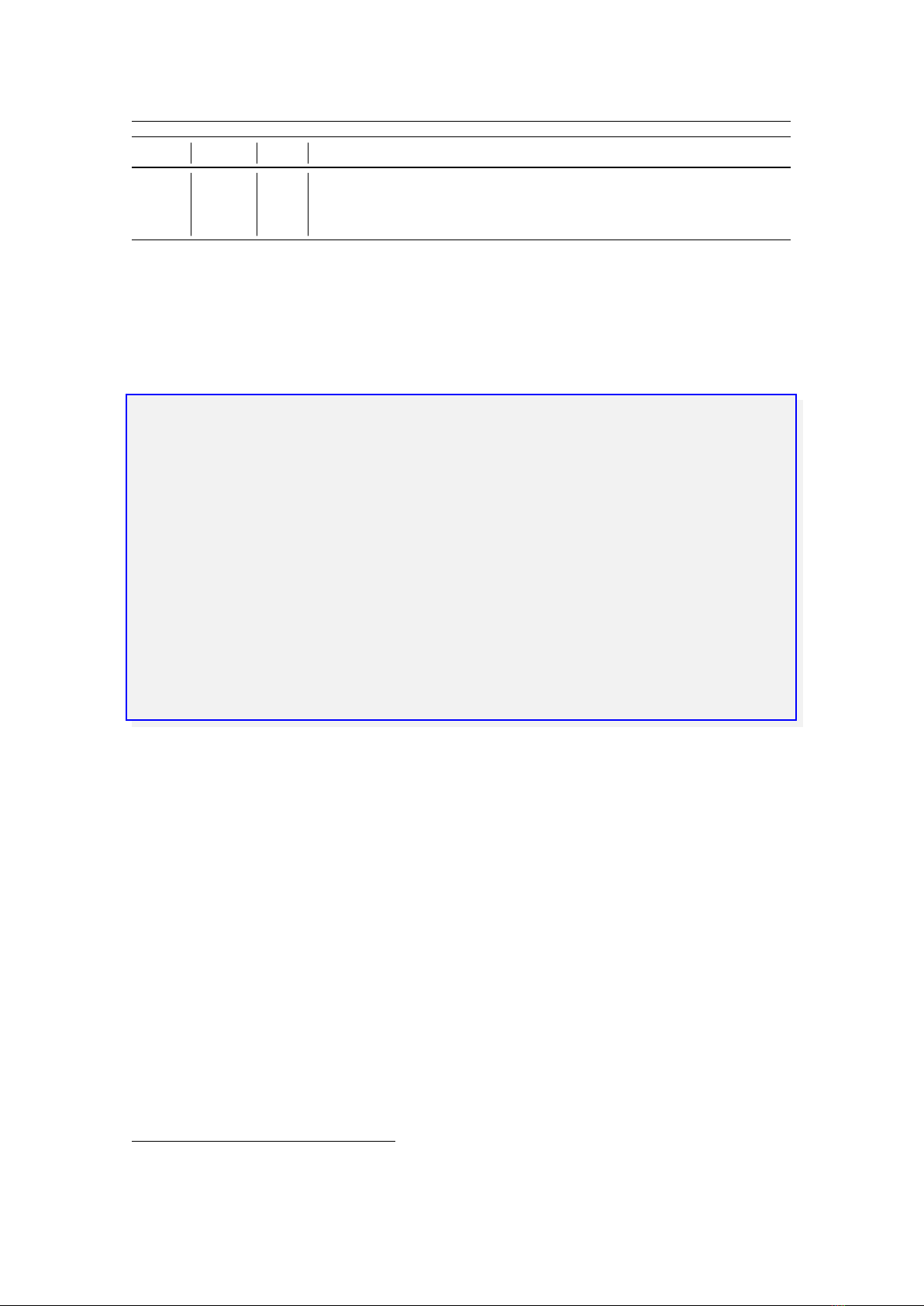
8.2 Adding Extra Nebula Images 105
Offset Length Type Description
0 8 %d Right ascension (decimal hours)
10 18 %d Declination (decimal degrees)
20 60 %s Command
Coordinates for each point of outline is represented in the equatorial coordinate system for epoch
J2000.0. The possible values of the third “column” (Command) are:
start
This command marks a start point of the outline. This command should also contain the
designation of the deep-sky object.
vertex This command marks an intermediate point of the outline.
end This command marks an end point of the outline.
Example for outline of M42:
05.56401 -05.49880 start M 42
05.56759 -05.39201 vertex
05.56635 -05.31749 vertex
05.57158 -05.21922 vertex
05.57601 -05.21716 vertex
05.58830 -05.30164 vertex
05.59140 -05.34341 vertex
05.59028 -05.37076 vertex
05.59008 -05.38175 vertex
05.59581 -05.37159 vertex
05.59943 -05.47123 vertex
05.59912 -05.65838 vertex
05.59520 -05.73212 vertex
05.58490 -05.68102 vertex
05.56948 -05.57675 end
The format of the file
outlines.dat
is compatible with the similar file of the SkyChart
(Cartes du Ciel) planetarium.
8.2 Adding Extra Nebula Images
GLENN NEWELL
In previous versions of this guide, the technique for preparing Deep Space Object (DSO) images
for inclusion in Stellarium involved plate solving the image to find its center on the sky, and then
calculating the corners of the image in the World Coordinate System (WCS
12
) using the scale of
the image, arc-seconds/pixel.
The problem with that approach is that it did not account for any spatial distortion in the image,
due to telescope optics or sensor tilt, etc. This resulted in a labor intensive manual process of trial
and error to adjust the WCS corners of the image until the stars in the image aligned with those
displayed in Stellarium.
Fortunately, this problem has been solved for us by astronomers with similar needs, extending
FITS
13
file headers to include information on how to map every pixel in an image correctly onto
WCS coordinates. This information can be added to your image when you plate solve it on
12
https://fits.gsfc.nasa.gov/fits_wcs.html
13
The Flexible Image Transport System is the dominating image format used in astronomy.
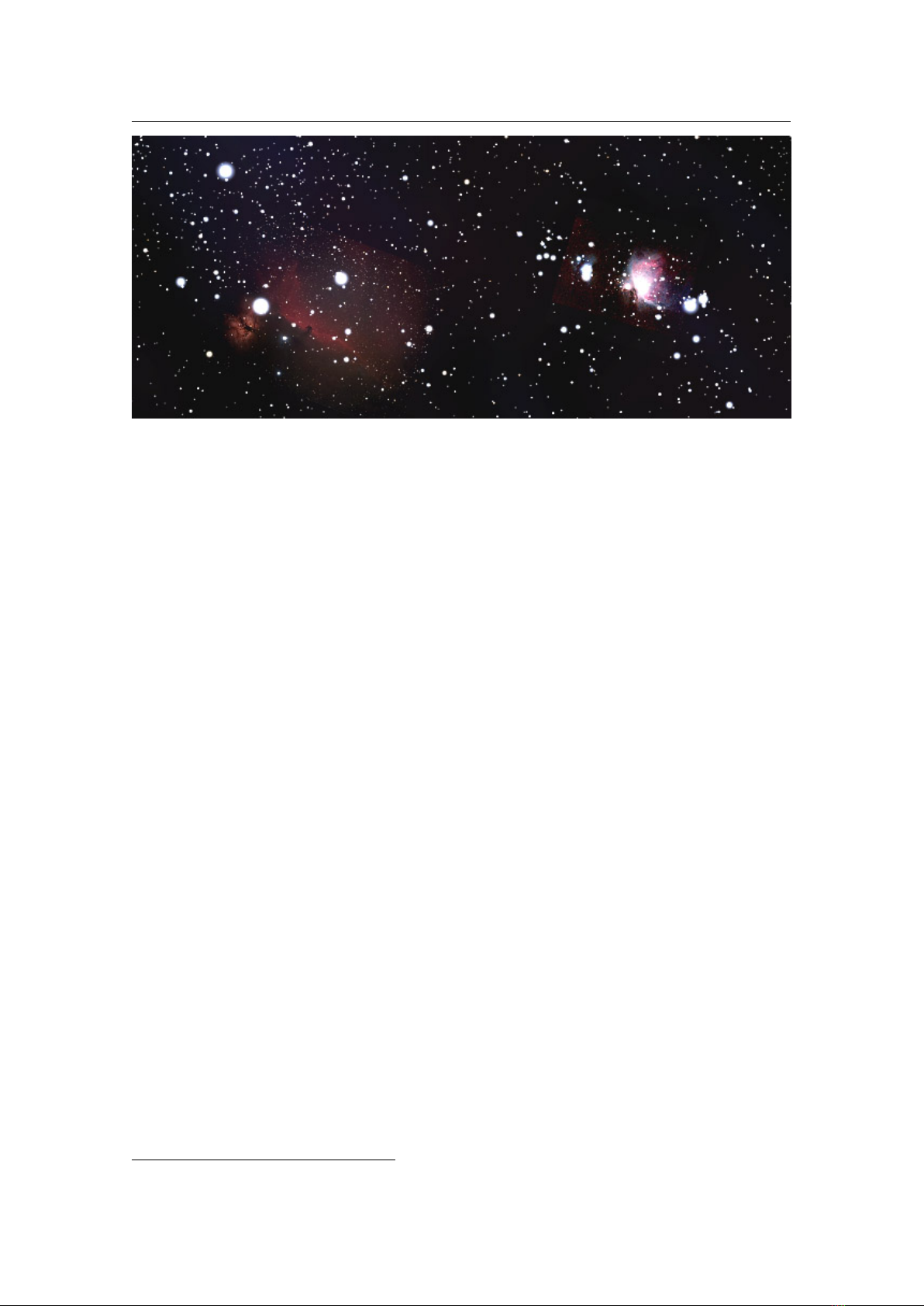
106 Chapter 8. Deep-Sky Objects
Figure 8.1: Screen shot of nebula images displayed in Stellarium
nova.astrometry.net, or similar services (local copies of astrometry.net, such as ansvr, or in
Pixinsight, etc.). This system of correcting for distortions in astronomical images was refined for
the Spitzer Space Telescope
14
.
It is now possible to utilize this pixel to WCS transformation data included in plate solved
images to prepare images for Stellarium that map perfectly to the Stellarium sky without manual
WCS corner adjustments.
There are Python libraries, namely astropy and a related “channel” astroquery, that can
automate some or all of the needed steps, and there are both manual and fully automated scripts for
that purpose available on Stellarium’s GitHub site. These scripts can be run on Windows, Mac, or
Linux platforms, using the Anaconda Python distribution.
8.2.1 Image requirements for inclusion in Stellarium
The final image must be aligned with the equatorial (J2000.0) coordinate system so that north is
directly up and not inverted side to side or up and down as can happen with photos taken with a
diagonal mirror in the path (In the WCS system, “Parity” must be 1.)
Next you will need to crop and/or re-scale the picture, setting the main feature at the center
and making the cropped size a power of 2, e.g. 64, 128, 256, 512, 1024 or 2048 pixels square (or
elongated like
512 × 1024
). If this requirement is not met, your textures may not be visible, or
graphics performance may be seriously impacted on some systems. Textures larger than 2048 may
only be supported on high-end hardware. Images must be in PNG format. When cropping, make
sure you leave at least six prominent background stars for plate solving). The next step is to process
your photo to make the background black, really black. This will ensure that your background
will meld with the Stellarium background and not be noticed as ugly gray square. Do not use
“transparent” pixels available in the PNG format as they will show as white, not black, in Stellarium.
Images covering more than 10 degrees of sky should be divided into separate images, and
images with pixel scales less than 1 arc-sec per pixel should be re-scaled so as to have a pixel scale
of 1 arc-sec per pixel or larger.
14
https://www.cs.helsinki.fi/group/goa/viewing/viewtransf/viewTrans.html

8.2 Adding Extra Nebula Images 107
8.2.2 Processing requirements
•
Python 3.7 (Anaconda 64 bit installer
15
) During installation, follow directions, taking
defaults to install for just your user (vs. everyone on your computer)
• Astropy (included in Anaconda)
•
Astroquery (latest version) To install on Windows, open an “Anaconda Prompt”. On Mac
and Linux, just open a terminal. At the prompt, enter:
pip install -- pre -- upgrade astroquery
• For the fully automated process:
– An API Key from your account at https://nova.astrometry.net:
*
Create an account (or log in with google, etc.) at
https://nova.astrometry.
net
*
On the API tab, copy your API key (shown in green)
*
Using a text editor (e.g., Notepad++ on Windows, Text Wrangler on Mac
OS), paste that key over the
X
’s in
Stellarium_Nebulae_Images_Prep.py
’s
ast.api_key = ’XXXXXXXXXXXXXXXX’
• For the more manual process:
–
Images plate solved at
https://nova.astrometry.net
(or Pixinsight – not yet
tested) so that WCS data is created
–
Graphics software to flip, rotate, scale, etc. and save as
.png
, e.g., Photoshop, GIMP,
Pixinsight, etc.
Script and Shortcut placement
Download the Python scripts from Stellarium’s site at Github
16
:
• WCS_corners.py script
• Stellarium_Nebulae_Image_Prep.py script
Windows
• Place the two .py and .bat scripts into %USERPROFILE%\Anaconda3\
• Place the two Shortcuts on your desktop or an astro tools folder (optional)
•
You can now drag and drop one or more images or
wcs.fits
files onto the shortcuts
(or .bat scripts) for processing
Mac
•
Place the two
.py
script files in the
anaconda3
directory, which should be inside your
home directory (the directory with your username).
• Place the two .app files on your desktop or an astro tools folder (optional)
•
You can now drag and drop one or more images or
wcs.fits
files onto the Automator
app icons for processing
Linux
•
Place the two
.py
script files in the
anaconda3
directory, which should be inside your
home directory (the directory with your username).
• Place the two .desktop files on your desktop or an astro tools folder (optional)
•
You can now drag and drop one or more images or
wcs.fits
files onto the desktop
icons for processing
15
https://www.anaconda.com/distribution/
16
https://github.com /Stellarium/stellarium-data/tree/mas ter/adding-nebula-image
s
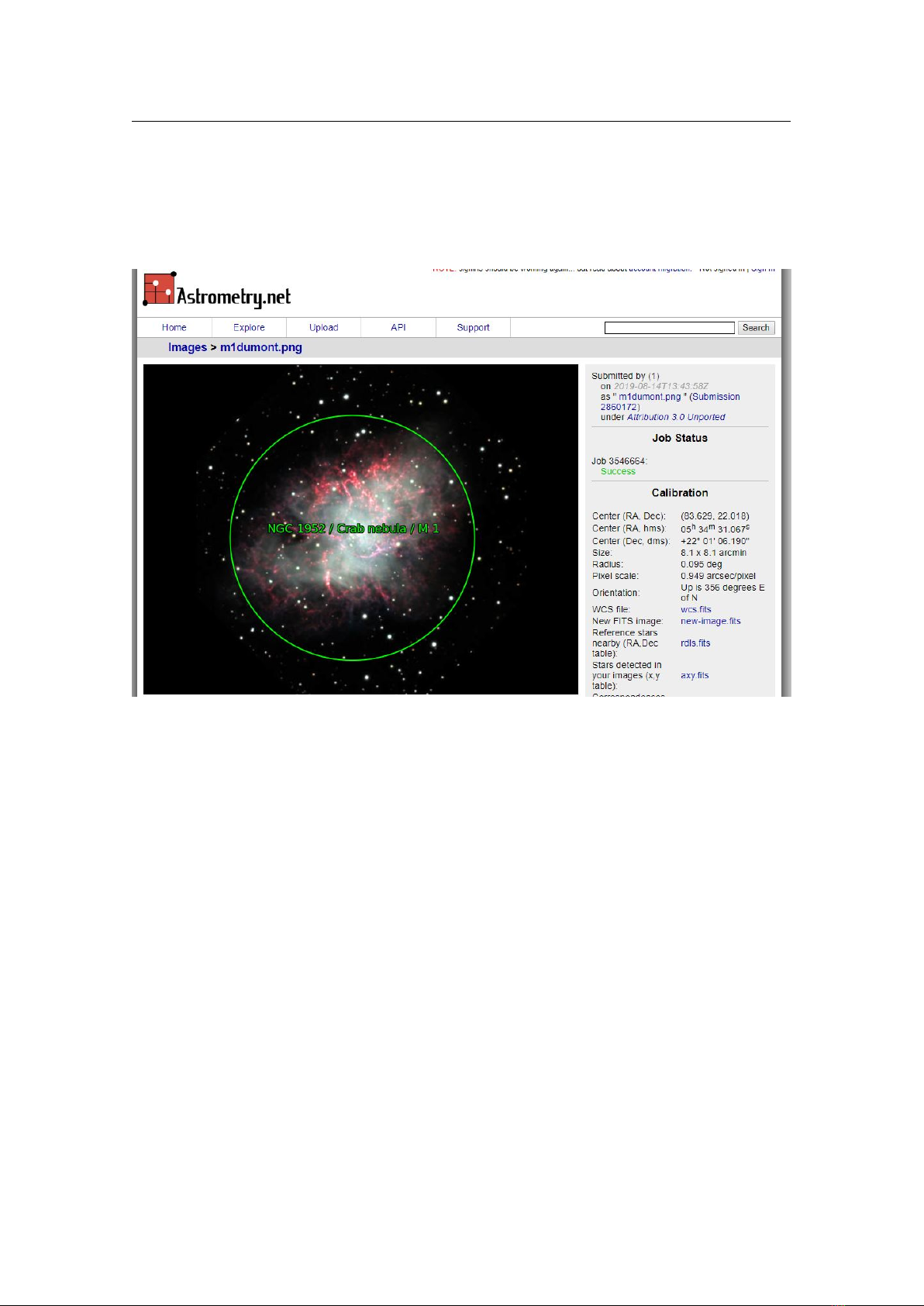
108 Chapter 8. Deep-Sky Objects
8.2.3 Manual processing
We present the more manual of the two workflows and script first, WCS_Corners.py, so you
understand the process, before introducing the completely automated image processing pipeline. It
is also possible that if plate solving fails in the fully automated script, you could continue, using
this manual process:
Figure 8.2: Online plate solving
Plate Solve
• Plate solve your image @ nova.astrometry.net (Fig. 8.2)
• Note pixel scale and orientation
Adjust Parity
•
Download the
wcs.fits
file from the “Results” page and run WCS_Corners.py on it
(Fig. 8.3).
• If Parity is -1, flip your image horizontally (do this before rotate step below)
Rotate
Rotate your image so “up” is exactly “North”. i.e., if the orientation of your image was
“261 degrees East of North” then rotate your image 261 degrees CW.
“Blacken” Sky
Fill in the blank areas of your rotated image with black pixels, and set your “sky”
background to be black.
Crop
Crop your image so that both
x
and
y
dimensions are powers of two pixels, e.g.
512× 512
,
1024× 1024, 2048× 2048, 1024 × 2048, etc.
Save PNG
• Save your image as .png file
• Place a copy into the %USERDIR%/nebulae/default directory
Plate Solve final image
•
Plate Solve your flipped, rotated, and cropped image again @
nova.astrometry.net
• Download the new wcs.fits file.
Calculate WCS corners
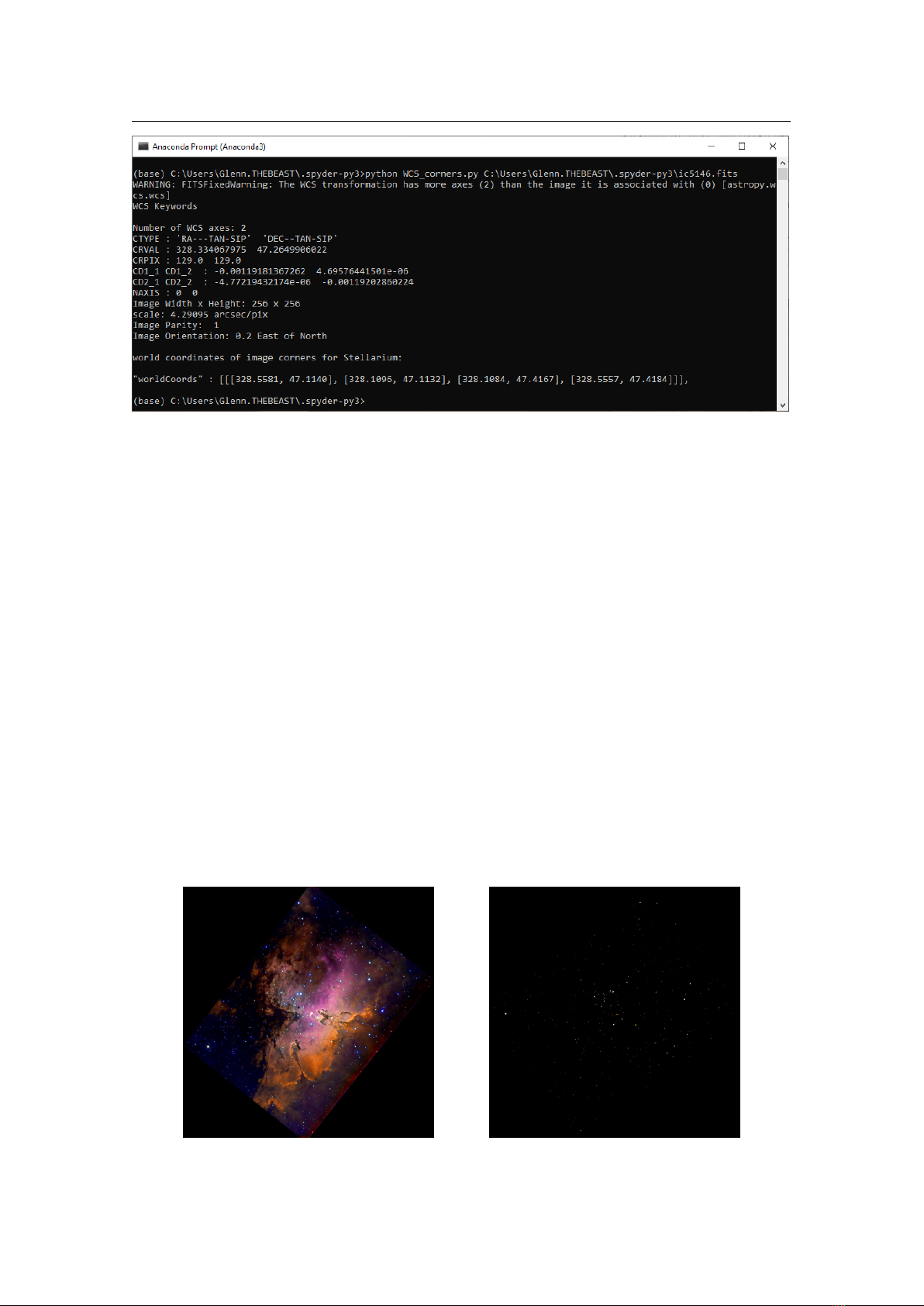
8.2 Adding Extra Nebula Images 109
Figure 8.3: Python processing. If you just leave a space after
python WCS_corners.py
,
you can drag and drop your wcs.fits file into Windows’ Anaconda Prompt window.
• Run WCS_Corners.py on the final wcs.fits file
•
Edit Stellarium’s
textures.json
with the image file name and the generated world
coordinates
Finalize image
Try to minimize the number of stars visible around your nebula in your image.
Stellarium draws its own stars, and a rectangle of excessive stars may look bad. Just blacken
them out.
Restart Stellarium
View your image in Stellarium (and adjust
maxBrightness
in
textures.json
if needed)
Some additional information you should be aware of:
• Images in Stellarium are NOT tied to an object, just placed on the sky by worldCoords
– So multiple image can overlap. E.g., the bubble nebula has overlapping textures
– Black is rendered transparent
– “Transparent” areas of .png show as white
•
See section 5.1 on Directories for where to put your own copy of the default images + yours,
so yours won’t get overwritten by Stellarium Updates
• If plate solve fails: adjust gamma/blackpoint so “only” stars are showing (Fig. 8.4)
→
Figure 8.4: Reduce gamma to temporarily help the plate solving algorithm finding stars.
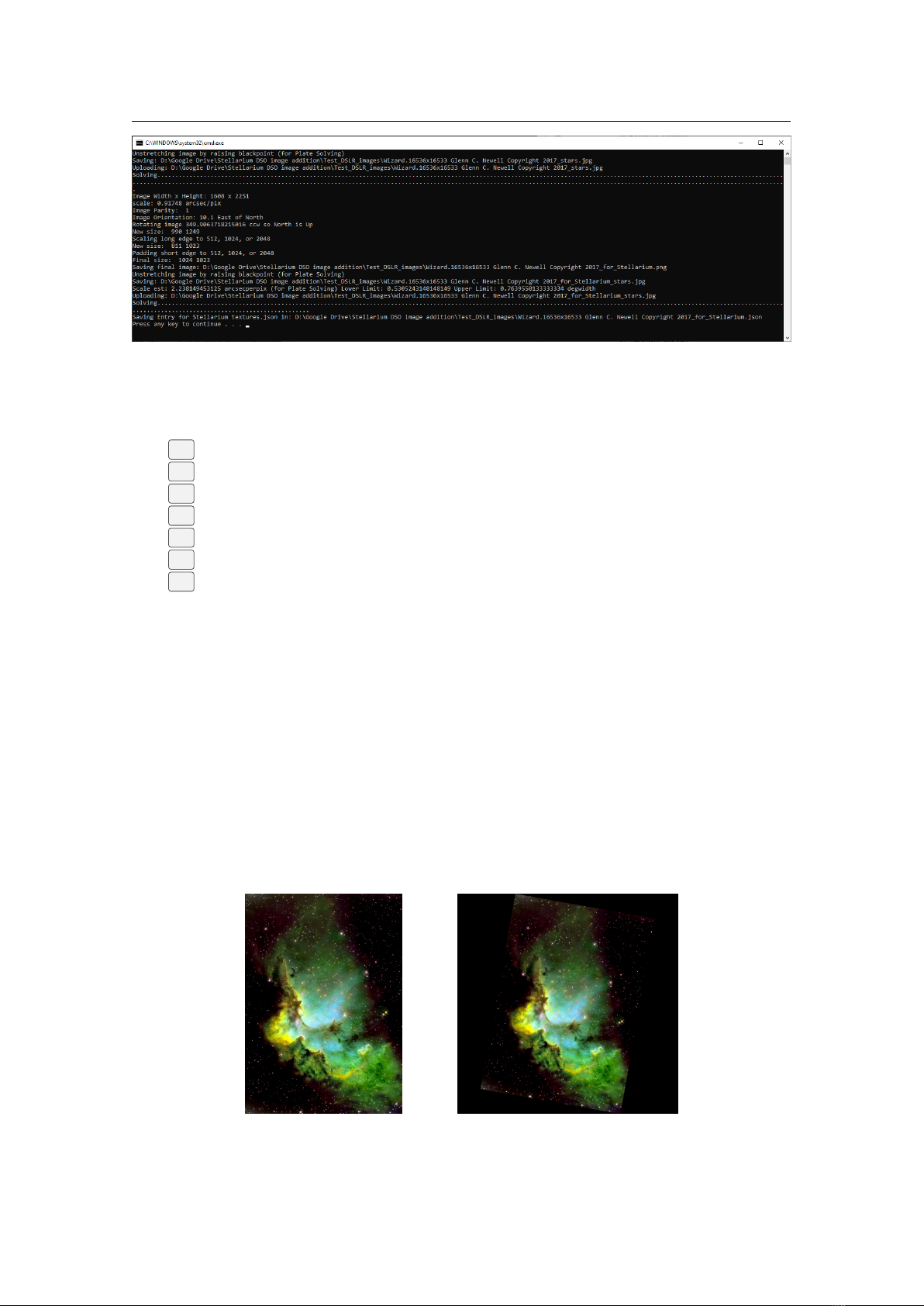
110 Chapter 8. Deep-Sky Objects
Figure 8.5: Automated Python processing with Stellarium_Nebulae_Image_Prep.py
Stellarium keyboard shortcuts you may find useful when adding images:
F3
brings up object search – Tab through search results
G
to remove ground (in case your object is currently behind the landscape)
A
to remove atmosphere (in case it is daytime)
I
to toggle nebulae images on and off – use to test star alignment
M
to toggle Milky Way on and off
/
to zoom into selected object
\
to zoom back out
8.2.4 Automated processing
With the recent addition of astrometry.net queries to the Python astroquery library it is now
possible to automate the entire image processing pipeline as well as automatically create full
.json
entries for each image for inclusion in the
textures.json
file. The python script for this is
Stellarium_Nebulae_Image_Prep.py. Wrapper scripts Stellarium_Nebulae_Image_Prep.bat
and Stellarium_Nebulae_Image_Prep.sh are also included so you can process multiple images at
once. With the desktop links you can even process one or more
.jpg
or
.tiff
files by drag and
drop, on Windows, Mac, and Linux systems.
Figure 8.5 is an example run of Stellarium_Nebulae_Image_Prep.py. This converts (rotates,
scales, etc.) the JPEG image as seen in Fig. 8.6, and a
.json
file for inclusion in
textures.json
(Fig. 8.7), along with two “unstretched”
_stars.jpg
images used for plate solving, which can be
deleted.
→
Figure 8.6: Automatic processing of a DSO image.

8.2 Adding Extra Nebula Images 111
Figure 8.7: .json result from processing with Stellarium_Nebulae_Image_Prep.py
8.2.5 Troubleshooting
If no images show up in Stellarium, chances are you have introduced one or more errors in the
textures.json file. You can use Json Lint
17
to check for problems.
Just paste the entire contents of the file in and press “Validate JSON”.
However, the original textures.json file as shipped in v0.19.1 also fails:
• Missing leading zeros in front of decimal points
• White space (a tab in this case) before http in infoUrl entries
These minor issues seem however not to irritate Stellarium.
17
An online service available at https://jsonlint.com/

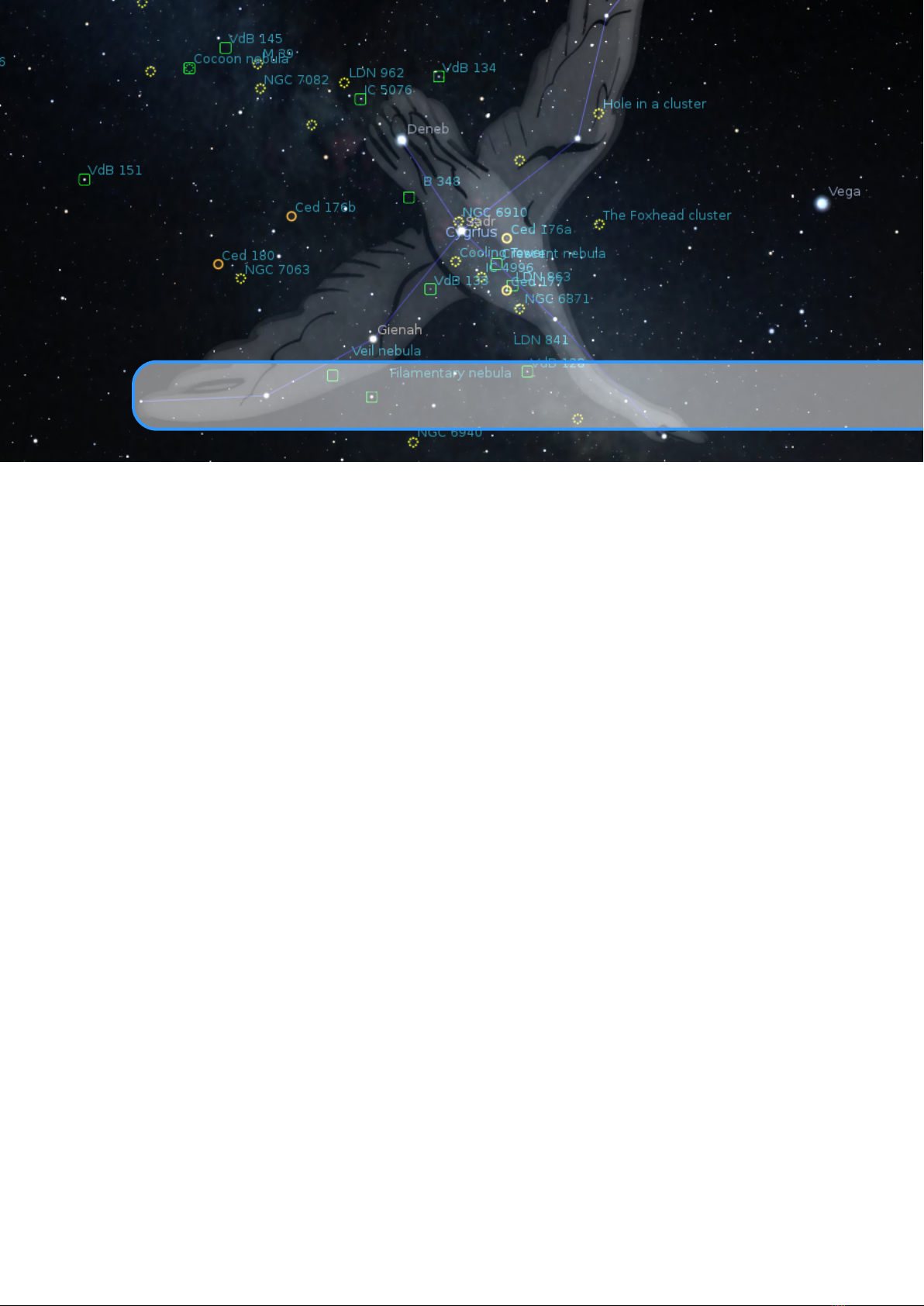
9. Adding Sky Cultures
GEORG ZOTTI, WITH ADDITIONS BY ALEXANDER WOLF AND SUSANNE
M. HOFFMANN
A sky culture in Stellarium is the entity that consists of
• a set of names for constellations
•
a description of the role these constellations and other celestial features (clouds, polar lights
(aurorae), meteors, comets, . . . ) had or still have for the human culture that used or use these
constellations, including some relevant background on the culture.
• stick figure definitions connecting stars into those constellations
• (optional) a list of names for individual stars
• (optional) artwork supporting the stick figures
• (optional) a description of boundaries or borders between the constellations
•
(optional) names and stick figure definitions of additional figures of lesser importance,
termed asterisms.
The CC-licence that the author of the SC chooses, is valid for the entire set of files, i.e. all texts and
images provided.
Stellarium comes with a nice set of sky cultures from all over the world (see section 4.4.6). For
ethnographers or historians of science it may be a worthwhile consideration to illustrate the sky
culture of the people they are studying. It is not very hard to do so, but depending on your data,
may require some skills in image processing.
Some features regarding translation and multilinguality have evolved over the years, and not all
sky cultures currently included in Stellarium adhere to the standards described above and in the
following sections. Sky cultures will also see continuous development in the coming versions. If
you add a new sky culture, please adhere to this description for an optimal result!
In the Stellarium program folder you can see a folder
skycultures
. Let us assume you work
on Windows and want to create a new sky culture, say, myCulture.
You can take the
inuit
directory as template to start with. Just copy the folder
C:\Program
Files\Stellarium\skycultures\inuit
to
C:\Users\[YOU]\AppData\Roaming\Stellarium\

114 Chapter 9. Adding Sky Cultures
skycultures\myculture
In the folder you see image files for the constellation artwork, and all other files with various
extensions are text files.
9.1 Basic Information
In myculture\info.ini, change the entries to
[ info ]
name = myCulture
au thor = me
cr e d its = my in s t i tute ( op t i o n al )
boundaries = non e
classif i c a t i on = personal
li c e nse = CC BY -SA 4.0 I n t e rnat i o n a l Publi c Li c e nse
re gion = We stern E urope
(or what seems best for you). The
name
is used for the list entry in the Starlore tab in the View
dialog (see 4.4.6).
author
should be the actual author(s)’ name(s). The optional
credits
can be
used to mention other involved parties.
9.1.1 Boundaries
The option “boundaries” is optional and may contain the following values:
none — (default) designates that this culture doesn’t have constellation boundaries.
iau — use this value for variants of “modern” sky cultures to enable use of IAU boundaries.
own — used for cultures which have their own set of constellation boundaries.
9.1.2 Classification
The option “classification” is also optional. It allows some form of quality control:
personal
– this is a personally developed sky culture which is not founded in published historical
or ethnological research. Stellarium may include it when it is “pretty enough” without really
approving its contents.
traditional
– (default value) content represents “common” knowledge by several members of an
ethnic community, and the sky culture has been developed by members of such community.
Our “Modern” sky culture is a key example: it has evolved for about 2500 years in the
“western” world, and modern astronomers use it.
ethnographic – provided by ethnographic researchers based on interviews of indigenous people.
historical – based on historical written sources from a (usually short) period of the past.
single – represents a single source like a historical atlas, or publications of a single author.
comparative
– special-purpose compositions of e.g. artwork from one and stick figures from
another sky culture, and optionally asterisms as representations of a third. Or comparison of
two stick figure sets in constellations and asterisms. These figures sometimes will appear not
to fit together well. This may be intended, to explain and highlight just those differences!
The description text must clearly explain and identify all sources and how these differences
should be interpreted.
9.1.3 License
The option “license” is technically optional (for backward compatibility; it defaults to “unknown”),
but we highly recommend to define it for your sky culture, and it is mandatory if you want your
sky culture to be distributed with Stellarium to prevent “unexpected” distribution of your content
to other software or applications out of our hands. The license info will be decoded for human
readable hints about allowed permissions for sky culture in the GUI.

9.1 Basic Information 115
We recommend to use one of the following possible licenses in this section:
GNU GPL v2.0 (or later)
– this is the most famous “copyleft” license for code and it may be
acceptable also for text and data.
CC0
(No Rights Reserved) – this is a “don’t care” license. Content may be freely distributed
without attribution for all purposes.
CC BY
(Creative Commons Attribution License) – this license lets others distribute, remix, adapt,
and build upon your work, even commercially, as long as they credit you for the original
creation. This is the most accommodating of licenses offered. Recommended for maximum
dissemination and use of licensed materials.
CC BY-SA
(Creative Commons Attribution-ShareAlike License) – this license lets others remix,
adapt, and build upon your work even for commercial purposes, as long as they credit you
and license their new creations under the identical terms. This license is often compared
to “copyleft” free and open source software licenses. All new works based on yours will
carry the same license, so any derivatives will also allow commercial use. This is the license
used by Wikipedia, and is recommended for materials that would benefit from incorporating
content from Wikipedia and similarly licensed projects.
CC BY-ND
(Creative Commons Attribution-NoDerivatives License) – this license lets others reuse
the work for any purpose, including commercially; however, it cannot be shared with others
in adapted form, and credit must be provided to you.
CC BY-NC
(Creative Commons Attribution-NonCommercial License) – this license lets others
remix, adapt, and build upon your work non-commercially, and although their new works
must also acknowledge you and be non-commercial, they don’t have to license their derivative
works on the same terms.
CC BY-NC-SA
(Creative Commons Attribution-NonCommercial-ShareAlike License) – this li-
cense lets others remix, adapt, and build upon your work non-commercially, as long as they
credit you and license their new creations under the identical terms.
CC BY-NC-ND (Creative Commons Attribution-NonCommercial-NoDerivatives License) – this
license is the most restrictive of the six main Creative Commons licenses, only allowing
others to download your works and share them with others as long as they credit you, but
they can’t change them in any way or use them commercially.
FAL
For illustrations we also expect usage of the Free Art License
1
(in addition to any other
licenses) – it is a “copyleft” license that grants the right to freely copy, distribute, and
transform creative works. You can specify, e.g., “GPL2, FAL” to indicate that the images are
additionally released under Free Art License.
Creative Commons provides a range of licenses
2
, each of which grants different rights to use
the materials licensed under them. All of these licenses offer more permissions than “all rights
reserved”. Some of Creative Commons are free and some are non-free. For example you can apply
only the most permissive of its licenses (CC0, CC BY and CC BY-SA) to material you create, to
meets the Freedom Defined definition of a “Free Cultural Work”.
3
If you have used one of the keys above in your
license
entry, a short (unofficial! Informative
only) description of license conditions will be displayed. You can use other licenses as well, but
please describe the conditions sufficiently well in a dedicated
h2
section close to the end of your
description.en.utf8.
1
https://artlibre.org/licence/lal/en/
2
Creative Commons License Chooser – https://creativecommons.org/choose/
3
See Creative Commons website to details –
https://creativecommons.org/share-your-work/
public-domain/freeworks

116 Chapter 9. Adding Sky Cultures
Caution for users!
While Stellarium is provided under the free GPL v2.0 licence which allows for commercial
use, some of our sky cultures have been contributed under CC NC/ND licenses, i.e., are for
noncommercial use only. Please respect their heritage holders and check-out the CC licence version
in the description before you use sky cultures in public events like TV documentaries, YouTube
videos, lectures, planetarium shows or printed matter. If in doubt, contact the respective authors.
9.1.4 Region
The option “region” is also optional and marks the origin region of the respective sky culture. It
v 1.2
allows some form of additional grouping. The names of regions are following the United Nations
geoscheme UN M49
4
:
Northern Africa – Algeria, Egypt, Libya, Morocco, Sudan, Tunisia, Western Sahara.
Eastern Africa
– British Indian Ocean Territory, Burundi, Comoros, Djibouti, Eritrea, Ethiopia,
French Southern Territories, Kenya, Madagascar, Malawi, Mauritius, Mayotte, Mozambique,
Réunion, Rwanda, Seychelles, Somalia, South Sudan, Uganda, United Republic of Tanzania,
Zambia, Zimbabwe.
Central Africa
– Angola, Cameroon, Central African Republic, Chad, Congo, Democratic Repub-
lic of the Congo, Equatorial Guinea, Gabon, Sao Tome and Principe.
Southern Africa – Botswana, Eswatini, Lesotho, Namibia, South Africa.
Western Africa
– Benin, Burkina Faso, Cabo Verde, Côte d’Ivoire, Gambia, Ghana, Guinea,
Guinea-Bissau, Liberia, Mali, Mauritania, Niger, Nigeria, Saint Helena, Senegal, Sierra
Leone, Togo.
Caribbean
– Anguilla, Antigua and Barbuda, Aruba, Bahamas, Barbados, Bonaire, Sint Eustatius
and Saba, British Virgin Islands, Cayman Islands, Cuba, Curaçao, Dominica, Dominican
Republic, Grenada, Guadeloupe, Haiti, Jamaica, Martinique, Montserrat, Puerto Rico, Saint
Barthélemy, Saint Kitts and Nevis, Saint Lucia, Saint Martin (French Part), Saint Vincent
and the Grenadines, Sint Maarten (Dutch part), Trinidad and Tobago, Turks and Caicos
Islands, United States Virgin Islands.
Central America
– Belize, Costa Rica, El Salvador, Guatemala, Honduras, Mexico, Nicaragua,
Panama.
Southern America
– Argentina, Bolivia (Plurinational State of), Bouvet Island, Brazil, Chile,
Colombia, Ecuador, Falkland Islands (Malvinas), French Guiana, Guyana, Paraguay, Peru,
South Georgia and the South Sandwich Islands, Suriname, Uruguay, Venezuela (Bolivarian
Republic of).
Northern America
– Bermuda, Canada, Greenland, Saint Pierre and Miquelon, United States of
America.
Antarctica – Antarctica.
Northern Asia – Russian Federation (Asian part).
Central Asia – Kazakhstan, Kyrgyzstan, Tajikistan, Turkmenistan, Uzbekistan.
Eastern Asia
– China, Hong Kong Special Administrative Region of China, Macao Special Ad-
ministrative Region of China, Democratic People’s Republic of Korea, Japan, Mongolia,
Republic of Korea, Taiwan.
South-eastern Asia
– Brunei Darussalam, Cambodia, Indonesia, Lao People’s Democratic Repub-
lic, Malaysia, Myanmar, Philippines, Singapore, Thailand, Timor-Leste, Viet Nam.
Southern Asia
– Afghanistan, Bangladesh, Bhutan, India, Iran (Islamic Republic of), Maldives,
Nepal, Pakistan, Sri Lanka.
4
Standard country or area codes for statistical use (M49) –
https://unstats.un.org/unsd/method
ology/m49/

9.2 Sky culture Description Files 117
Western Asia
– Armenia, Azerbaijan, Bahrain, Cyprus, Georgia, Iraq, Israel, Jordan, Kuwait,
Lebanon, Oman, Qatar, Saudi Arabia, State of Palestine, Syrian Arab Republic, Türkiye,
United Arab Emirates, Yemen.
Eastern Europe
– Belarus, Bulgaria, Czechia, Hungary, Poland, Republic of Moldova, Romania,
Russian Federation (European part), Slovakia, Ukraine.
Northern Europe
– Åland Islands, Channel Islands, Denmark, Estonia, Faroe Islands, Finland,
Iceland, Ireland, Isle of Man, Latvia, Lithuania, Norway, Svalbard and Jan Mayen Islands,
Sweden, United Kingdom of Great Britain and Northern Ireland.
Southern Europe
– Albania, Andorra, Bosnia and Herzegovina, Croatia, Gibraltar, Greece, Holy
See, Italy, Malta, Montenegro, North Macedonia, Portugal, San Marino, Serbia, Slovenia,
Spain.
Western Europe
– Austria, Belgium, France, Germany, Liechtenstein, Luxembourg, Monaco,
Netherlands, Switzerland.
Australasia
– Australia, Christmas Island, Cocos (Keeling) Islands, Heard Island and McDonald
Islands, New Zealand, Norfolk Island.
Melanesia – Fiji, New Caledonia, Papua New Guinea, Solomon Islands, Vanuatu.
Micronesia
– Guam, Kiribati, Marshall Islands, Micronesia (Federated States of), Nauru, Northern
Mariana Islands, Palau, United States Minor Outlying Islands.
Polynesia
– American Samoa, Cook Islands, French Polynesia, Niue, Pitcairn, Samoa, Tokelau,
Tonga, Tuvalu, Wallis and Futuna Islands.
For “modern” sky cultures we use the special region name World to define worldwide applicable
data.
9.2 Sky culture Description Files
In order to have translated texts, Stellarium uses files
description.<LANG>.utf8
, where
<LANG>
is the two-letter ISO 639-1 language code, or its extension which contains language and coun-
try code, like
pt_BR
for Brazilian Portuguese. A minimum sky culture must contain the file
description.en.utf8
, this is
en=English
text with HTML tags for sections, tables, etc. You
can also have embedded images in the HTML (your book cover? Views of sacred landscapes/build-
ings/artwork/.. . ?), just make them PNG or JPG format please. The length of the description
texts is not limited. You should provide a good description in the interest of future users: some
cultural/ethnographical background of the users of this sky culture, history of sky culture research
that provided this work, tables of names/translations, links to external resources, whatever seems
suitable. When you started from a copied sky culture, delete the other
description.*.utf8
files.
If you can provide other languages supported by Stellarium, you can provide translations
yourself, else Stellarium translators may translate the English version for you. (It may take years
though.) The file ending
.utf8
indicates that for special characters like ÄÖÜßáé you should use
UTF-8 encoding. If you write only English/ASCII, this may not be relevant.
9.3 Proper Names
9.3.1 Constellation Names
The native constellations are listed in
constellation_names.eng.fab
. It consists of 3 simple
columns: Abbreviation (or just a serial number), native name, and English translation. The writing
_("name")
allows automatic translation of the English strings to other languages. These strings
will be used as constellation labels.
You can add a reference comment after each 3-column entry. Just add a white-space, and then
a comma-separated list of numerical references to the books listed in reference.fab.
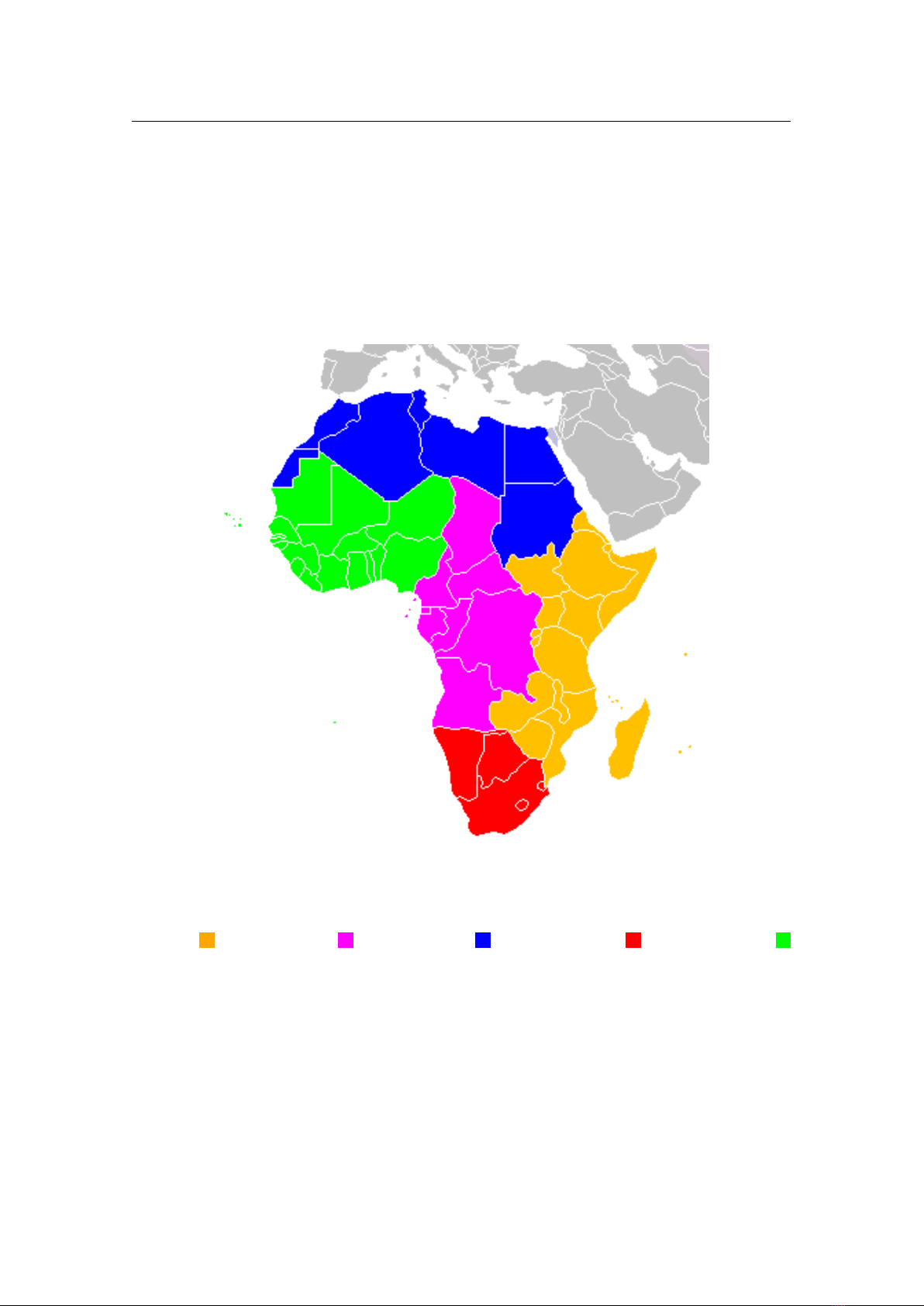
118 Chapter 9. Adding Sky Cultures
Figure 9.1: Africa: subregions as delineated by United Nations geographic classification
scheme: Eastern Africa, Central Africa, Northern Africa, Southern Africa,
Western Africa. Wikipedia / CC BY-SA 3.0
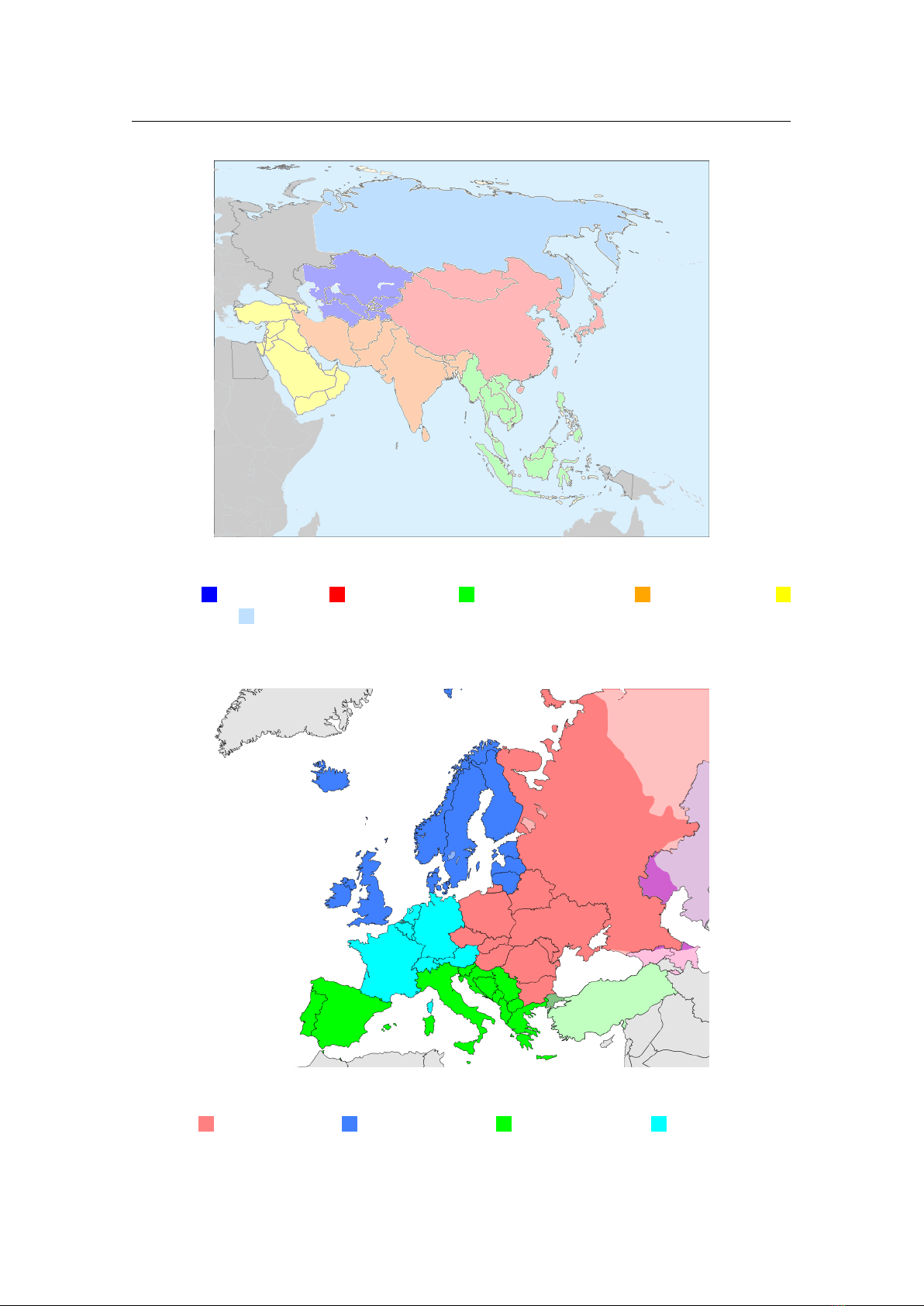
9.3 Proper Names 119
Figure 9.2: Asia: subregions as delineated by United Nations geographic classification
scheme: Central Asia, Eastern Asia, South-eastern Asia, Southern Asia,
Western Asia, Northern Asia. Wikipedia / CC BY-SA 3.0
Figure 9.3: Europe: subregions as delineated by United Nations geographic classification
scheme: Eastern Europe, Northern Europe, Southern Europe, Western Europe.
Wikipedia / CC BY-SA 3.0
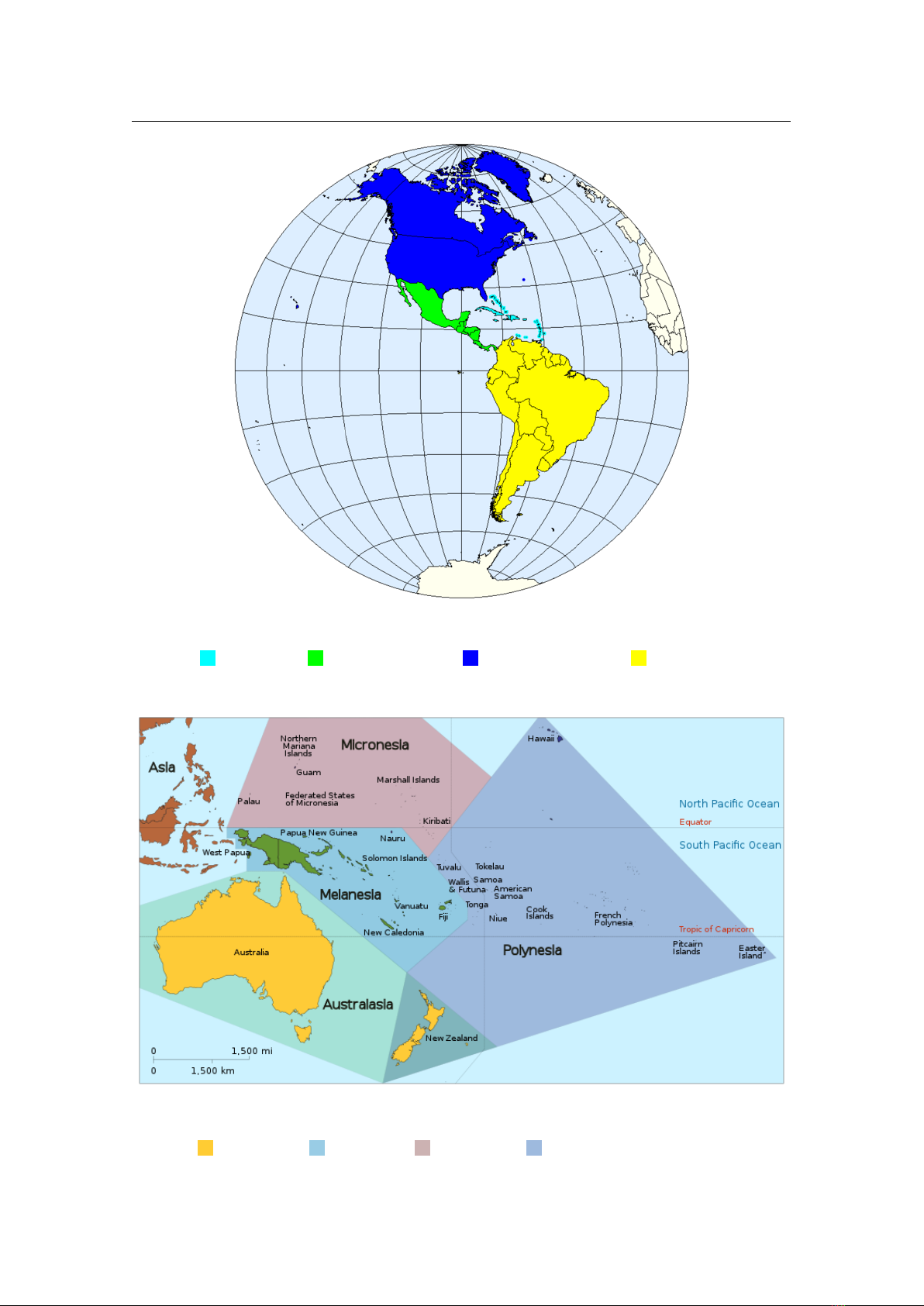
120 Chapter 9. Adding Sky Cultures
Figure 9.4: Americas: subregions as delineated by United Nations geographic classification
scheme: Caribbean, Central America, Northern America, Southern America.
Wikipedia / CC BY-SA 3.0
Figure 9.5: Oceania: subregions as delineated by United Nations geographic classification
scheme: Australasia, Melanesia, Micronesia, Polynesia. Wikipedia / CC BY-SA
3.0

9.3 Proper Names 121
The first column (abbreviation) in the Modern sky culture provides the canonical 3-letter
abbreviation for constellations as used by the International Astronomical Union. Such abbreviations
may not be available for the sky culture you are working with, so you must invent your own. These
abbreviations are used as keys in the other files, so they must be unique within your sky culture. It
is not necessary to have 3-letter keys, but they should act as mnemonic support, so numerical keys
are not recommended.
The keys can be displayed on screen when labels are requested in the Starlore GUI (sec-
tion 4.4.6). If you want to prevent certain abbreviations from being displayed, let them start with
a dot. See the effect in the
Modern (H.A.Rey)
sky culture: In
Abbreviated
mode, only the official
abbreviations are displayed. In
Native
mode, the second column of
constellation_names.eng.fab
is shown. Only with setting
Translated
, the text translated from the text shown in the third column
is shown. If your sky culture is a variant of the
Modern
sky culture, please use the canonical Latin
names, they have all been translated already.
If your sky culture is not a variant of the generally known
Modern
(western) sky culture, please
include an English translation to the name given in the native language. Else translators will not be
able to translate the name. See a good example in the Mongolian sky culture.
9.3.2 Star Names
The file
star_names.fab
contains a list of HIP catalog numbers and common names for those
stars. Each line of the file contains one record of two fields (separated by the pipe character (
|
)) or
three fields (the first pair is separated by the pipe character (
|
) and the last one separated by the
space character). The first field is the star’s Hipparcos catalog number, the second is the common
name of the star in a format that enables translation support, the third is an optional list of references
(see 9.8) to the source of the information about this name, e.g:
# Piscis A ustrinus ( PsA )
113368| _(" Fomalhaut ") 1 ,2 ,6 ,11 ,12
113368| _(" Thalim " )
In the sample you can see 3 lines: the first line is a comment, the second line has 3 fields and the
third line has 2 fields. Both lines with data have the same Hipparcos number of the star: Fomalhaut
is the well-known name of HIP 113368, and Thalim is an additional (not well-known) name of this
star for which a source reference is unfortunately missing.
9.3.3 Planet Names
The file
planet_names.fab
contains a list of native names of the planets. Each line of the file
contains one record of 3 fields, separated by the white space or tab character. The first field is
the English name of the planet, the second is the native name of the planet (can be in the native
language, but please for maximum utability use an English transliteration) and the third is the
translatable version of the native name of the planet (translated into English). Here is an example
from the Egyptian sky culture:
Mars " Horus - Desher " _ (" Red Horus " )
9.3.4 Deep-Sky Objects Names
The file
dso_names.fab
contains a list of native names for deep-sky objects (DSO). The format
of this file is similar to the
star_names.fab
format (see 9.3.2). Each line of the file contains one
record of two fields (separated by the pipe character (
|
)) or three fields (first pair is separated by the
pipe character (
|
) and the last one separated by the space character). The first field is an identifier

122 Chapter 9. Adding Sky Cultures
of the deep-sky object, the second is the native name of the DSO in a format that enables translation
support, the optional third is a list of references (see 9.8) to the source of the information about this
name, e.g.:
PGC 17223| _(" Native name for LMC ") 1 ,2 ,3
NGC 292 |_( " Native name for SMC ") 1 ,3
NGC 292 |_( " Small M agellanic Cloud ")
9.4 Stick Figures
The modern-style stick figures are coded in constellationship.fab
5
. Lines look like:
Abbr pairs pair1_star1 pair1 _star 2 pair2_star1 pa ir2_s tar2 ...
In this file,
Abbr is the abbreviation defined in constellation_names.eng.fab
pairs is the number of line pairs which follow.
pairN_starA
Hipparcos numbers for the stars which form the constellation stick figure. We need
two entries per line, longer line segments are not supported. To find the HIP number, just
have Stellarium open and click on the star in Stellarium while editing this file.
Anything after the last star number is currently ignored. Comments can be given in lines starting
with # signs. Empty lines are ignored.
9.5 Constellation Boundaries
An optional file
6
constellation_boundaries.dat
can provide data for the boundary lines
drawn between constellations. The boundaries for the IAU constellations are defined in the file
named
data/constellation_boundaries.dat
. The format for this file is a bit more difficult
than the other files. It contains sections which may consist of multiple lines, of the format:
N RA_1 DE_1 RA_2 DE_2 ... RA_N DE_N 2 CON1 CON2
where
N number of segments for boundary
RA_n, DE_n
right ascension (decimal hours) and declination (decimal degrees) of the points of
segments in J2000 coordinates.
2 CON1 CON2
this data indicate “border between 2 constellations CON1 and CON2”. They
are used to define isolated boundaries for each constellation (for proper working of the
Select single constellation
option).
9.6 Constellation Artwork
Constellation artwork is optional, but may give your sky culture the final touch, if it requires artwork
at all. E.g., H. A. Rey’s variant of the
Modern
sky culture deliberately does not contain artwork
other than his new set of stick figures.
Each constellation artwork is linked to 3 stars in its constellation. This is programmed in the
file constellationsart.fab. It consists of lines
5
To clarify some apparent misunderstanding of the name: this is not a new word coined with -ship as in
“friendship”, but simply constellations encoded in HIPparcos numbers.
6
Please define boundaries = own in the file info.ini to enable using custom boundaries.

9.7 Seasonal Rules 123
Abbr image_na me . png x1 y1 HIP1 x2 y2 HIP2 x3 y3 HIP3
where
Abbr is the abbreviation defined in constellation_names.eng.fab
image_name.png
is the file name of your texture. It should be sized in a power of two, like
512× 512
,
1024× 2048
etc. Avoid dimensions larger than 2048, they are not supported on
all systems. Use as little border in your textures as possible instead. You can distort images
to better exploit the pixels, the texture will be stretched back. The background of the artwork
image must be absolutely black.
xn, yn, HIPn
(
n ∈ [1,2,3]
) pixel locations of the star in the constellation drawing (find those in
any image editor) and HIPn is the star number in the Hipparcos catalog, which you find
when you click on the star in Stellarium.
In case the artwork is only available in a certain projection (e.g., an all-sky map), or is otherwise
heavily distorted so that the match is not satisfactory, you may have to re-project the image somehow.
For aligning, you should switch Stellarium to Stereographic projection for optimal results.
You don’t have to shutdown and restart Stellarium during creation/matching, just switch sky
culture to something else and back to the new one to reload.
9.7 Seasonal Rules
File
seasonal_rules.fab
(optional) contains possible seasonal rules for the visibility of constel-
lations. There is one rule per line. Each rule contains three elements separated with white space (or
tab character): constellation ID, start of visibility (month) and end of visibility (month), e.g:
Emu 6 3
This specifies that constellation Emu (abbreviated also as “Emu”) is visible only from June to
March.
9.8 References
The file
reference.fab
contains a list of information sources. Each line of the file contains one
record of 3 fields, separated by the pipe character (
|
) — number of source, description of source
and optional URL, e.g.:
9| Kruger 60| https :// en . wikipedia . org/ wiki / Kruger_60
This file will be used in future versions. It is most important for “traditional” sky cultures
collected from various sources to provide traceable references.
9.9 Asterisms and help rays
Sometimes there is a need to extract some part of a constellation into a figure in its own right, or to
merge parts from different constellations into one big figure — e.g. “Big Dipper” as part of Ursa
Major or the “Summer Triangle” consisting of 3 stars from the constellations Cygnus, Lyra and
Aquila. After the codification of the official 88 constellations by the IAU, those additional figures
are called asterisms.
7
7
In a more generalized context when describing the sky of other cultures, the distinction may be less
strict.

124 Chapter 9. Adding Sky Cultures
Other simple figures might be used as navigation helpers: the help rays. As example to help
in orientation in the sky the additional lines between constellations Ursa Major, Ursa Minor and
Cassiopeia might be useful. The asterisms and help rays are listed in
asterism_names.eng.fab
.
This file consists of 2 simple columns: Abbreviation (or just a serial number) and English name of
asterism. The writing
_("name", "asterism")
allows automatic, context sensitive translation of
the English strings to other languages. These strings will be used as asterisms labels. In addition,
after a hash mark (
#
) marking a comment sign, some reference information can be added in
comment lines, like “List found at .. . ”. Also, you can again add a reference comment after each
2-column entry. Just add a white-space, and then a comma-separated list of numerical references
to the books listed in
reference.fab
. Collecting sources and giving such references is always a
good idea. Some later versions of Stellarium may use and display this information.
The stick figures of asterisms are coded in
asterism_lines.fab
which looks similar to the
entries for the constellation figures. Lines look like:
Abbr type pai rs pair1_star1 pa ir1_star2 pair2_star1 pair2_star2 ...
or
Abbr 2 pairs pair1_RA1 p a i r 1 _ D E 1 pair1_RA2 p a i r 1 _ D E 2 pair2_RA1 ...
In this file,
Abbr is the abbreviation defined in asterism_names.eng.fab
type
is the type of line. Use 1 or 2 to define an asterism and 0 for the help rays (0 and 1 uses HIP
numbers, and 2 uses coordinates).
pairs is the number of line pairs which follow.
pairN_starA
Hipparcos numbers for the stars which form the asterism/help ray stick figure (similar
to constellations), or equatorial coordinates for epoch J2000.0 of the stars (decimal hours for
right ascension and decimal degrees for declination). The help rays are actually a special
form of asterisms in Stellarium.
9.10 Publish Your Work
If you are willing to let other users enjoy the result of your hard work (and we certainly hope you
do!), when you are done, please write a note in the Forum or at GitHub. We will decide about
acceptability and classification, and may ask for better descriptions for the benefit of our users.
Please be prepared to put the imagery and text under some compatible open-source license
(Creative Commons). Else the sky culture cannot be hosted by us. While we cannot be held respon-
sible for legal problems, it seems that CC BY 4.0 International
8
or CC BY-SA 4.0 International
9
licenses are best suited. See notes in section 9.1.3 above.
8
https://creativecommons.org/licenses/by/4.0/
9
https://creativecommons.org/licenses/by-sa/4.0/
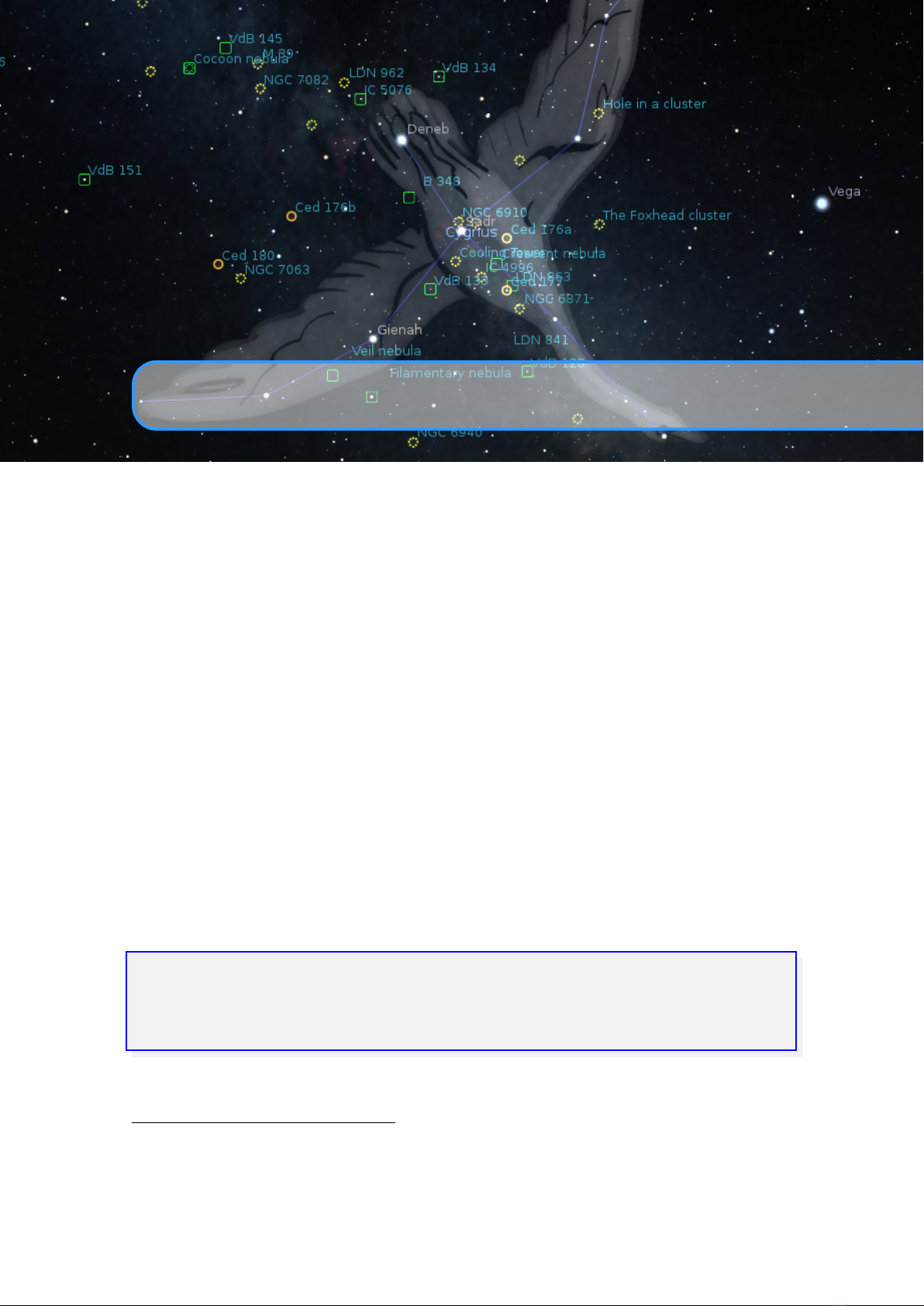
10. Surveys
GUILLAUME CHÉREAU
10.1 Introduction
A sky survey is a map of the sky stored as a hierarchical set of a potentially large number of smaller
images (called tiles). The advantage compared to a regular texture is that we need to render only
the visible tiles of a potentially gigantic image at the lowest resolution needed. This is particularly
interesting for rendering online images that can be stored on a server, while the client only has to
download the parts he currently uses.
Since version 0.18.0, Stellarium added some preliminary support for loading and rendering on-
line surveys in the Hierarchical Progressive Surveys (HiPS) format, developed by the International
Virtual Observatory Alliance. A full description of the format can be found on the IVOA website
1
.
10.2 Hipslist file and default surveys
Hipslist files are text files used to describe catalogs of HiPS surveys. The full specification is part
of the HiPS format, and looks like that:
# E xample of a hi p s l ist file .
# Date : 2018 -03 -19
hips_s e r v ice _ u r l = htt ps :// data . st e l l a r i u m . org / survey s / callisto
hips_ r e l eas e _ d at e = 2018 -03 -18 T14 :01 Z
hips_status = pub lic m i rror c l o nable O n c e
As of v0.18.0, by default Stellarium tries to load HiPS from two sources:
http://alaskybis.
unistra.fr/hipslist
2
and
https://data.stellarium.org/surveys/hipslist
. This can
1
https://www.ivoa.net/documents/HiPS/20170519/REC-HIPS-1.0-20170519.pdf
2
Since version 0.20.3 the first URL was changed to
http://alasky.u-strasbg.fr/MocServer/qu
ery?*/P/*&get=record due to changes in HiPS services

126 Chapter 10. Surveys
be changed with the hips/sources options in the configuration file (see also section D.1.28). For
example, you can add your own private HiPS surveys by running a local webserver and adding:
[ hips ]
so u r ces /1/ url = http :// alas ky .u - s trasbg . fr / M o c S e rver / qu ery ?*/ P /*& get = re c ord
so u r ces /2/ url = https :// data . stellarium . org / su rveys / hi p s l i st
so u r ces /3/ url = http :// localhost / Stellarium / hips / hipsl i s t
so u r ces / size = 3
10.3 Solar system HiPS survey
Though not specified in the HiPS standard, Stellarium recognises HiPS surveys representing planet
textures, as opposed to sky surveys. If the
obs_frame
property of a survey is set to the name of a
planet or other solar system body, Stellarium will render it in place of the default texture used for
the body.
10.4 Digitized Sky Survey 2 (TOAST Survey)
GEORG ZOTTI, ALEXANDER WOLF
The older way to provide a tessellated all-sky survey uses the TOAST encoding
3
. Stellarium
provides access to the Digitized Sky Survey 2, a combination of high-resolution scans of red- and
blue-sensitive photographic plates taken in 1983–2006 at Palomar Observatory and the Anglo-
Australian Observatory.
4
To enable access to the DSS layer, see section 4.3.3 and enable the DSS button. Then just press
that DSS button in the lower button bar, wait a moment, zoom in and enjoy!
10.4.1 Local Installation
This display normally requires access to the Internet. However, in some situations like frequent and
extensive use in fixed observatories, or use in the field when Internet connection is not possible,
you can download all image tiles to your local harddisk for local use. Please be considerate, don’t
waste bandwidth, and do this only if you really need it.
The images are stored in subdirectories that increase in size and number of files (see Table 10.1).
Zooming in loads the next level if available.
For partial downloads, you can limit the maximally used level (e.g. 9 or 10). The difference
from level 10 to 11 is really hardly noticeable, yet level 11 contains almost 75% of all data. On a
small system like Raspberry Pi 3, you may run into troubles with too little texture memory when
level is more than 7.
Another issue: the level 11 subdirectory holds over 4 million files. Windows Explorer is not
optimized to open and display this number of files and will take a long time to open. Just unpack
this archive, but don’t access the folder with Explorer.
If all that does not discourage you, you can download the archives at
https://dss.stellari
um.org/offline/.
Then add a few entries to the
[astro]
section in Stellarium’s
config.ini
. On Windows, if
you have a harddisk T: with path T:\StelDSS that contains the unpacked image subdirectories 0,
1, 2, . . . , 10, the section may look like
3
Please see http://montage.ipac.caltech.edu/docs/WWT/ for details
4
The original data are available at https://archive.stsci.edu/cgi-bin/dss_form.

10.4 Digitized Sky Survey 2 (TOAST Survey) 127
[ astro ]
toa st_ survey_ dir ectory = StelDSS
toast_survey_host =T:/
toast_sur vey _levels =10
On Linux, with the files stored in
/usr/local/share/Stellarium/StelDSS
, the same section
could look like
[ astro ]
toa st_ survey_ dir ectory = usr/ local / share / Stellarium / StelDSS
toast_survey_host =/
toast_sur vey _levels =10
Level No of files Filespace (kB)
0 1 32
1 4 124
2 16 472
3 64 1.820
4 256 7.172
5 1.024 27.920
6 4.096 109.628
7 16.384 429.800
8 65.536 1.661.808
9 262.144 6.119.092
10 1.048.576 20.250.216
11 4.194.305 83.583.724
Table 10.1: Number of files and storage requirements for local DSS TOAST installation

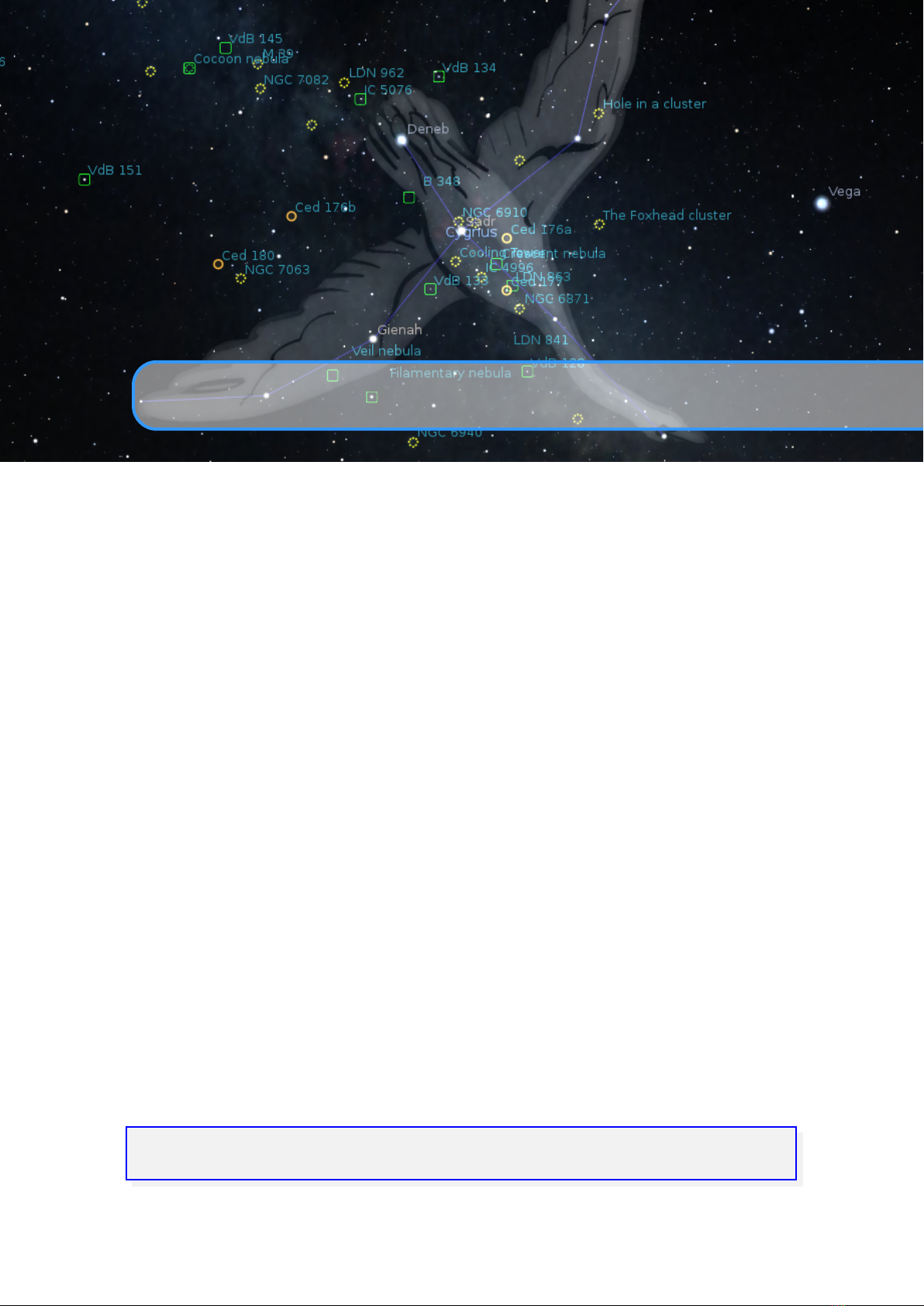
11. Stellarium’s Skylight Models
GEORG ZOTTI
11.1 Introduction
Stellarium’s main aim is a realistic simulation of the night sky. This is more than just the creation of
a star map. Especially a realistic simulation of twilight and the visibility of stars, deep-sky objects
or the Zodiacal light is a challenge. Since early in its history Stellarium has used models from the
computer graphics literature to achieve its goals. For most users, the models seem to work well, but
more advanced users may want to tweak some of the values.
11.2 The Skylight Models
11.2.1 Legacy Mode: The Preetham Skylight Model
A well-known fast computer graphics model for daylight has been presented by Preetham, Shirley,
and Smits (1999). Its brightness distribution is based on an all-weather model for sky luminance
distribution by Perez, Seals, and Michalsky (1993) and models chromaticity distribution with
similarly-shaped functions. It works reasonably well for average conditions, and a “turbidity”
parameter
T
allows a simple modelling of visibility conditions. In terms of the atmospheric
extinction coefficient k (see 19.13.1), we can define
T = 25(k − 0.16) + 1 (11.1)
In Stellarium, a value of
T = 5
has been used for many years, and the chromaticity parameters have
been slightly changed for a more pleasing color distribution at this value for
T
. Recently, we have
made the many parameters of the Preetham model accessible for users to fine-tune. Not many users
will even want to do this, and therefore you must enable this manually by editing config.ini:
[ Skylight ]
enable_gui = true

130 Chapter 11. Stellarium’s Skylight Models
Only with this setting, a button will be available in the View settings, Sky tab (sec-
tion 4.4.1).
All settings described here will immediately be stored in config.ini.
One setting allows to compute T from k with the above relation 11.1.
Please note that the parameters are far from intuitive, therefore we added two sets of reset
functions. One sets the values to those in the original paper, the other re-establishes Stellarium’s
sky colors from version 0.21.3 and earlier, which however seem only suitable for T = 5.
A sky brightness model better suited for astronomical simulation, including twilight and
brightness contributions of the Moon and airglow, was presented by B. E. Schaefer (1989-93
and 1993). By default, Stellarium uses this model in combination with chromaticity from the
Preetham model. For experiments, you can however revert from the Schaefer brightness model to
the Preetham model. The parameters of the Schaefer model are currently not accessible for further
experiments.
Some more parameters fine-tune some aspects of rendering of the Solar disk and the solar glare.
It makes a slight difference whether the Sun’s disk is plotted before or after the glare, and whether
the solar sphere is rendered after the atmosphere.
11.2.2 Advanced Mode: The ShowMySky Skylight Model
A much more advanced skylight model has been presented by Bruneton and Neyret (2008). An
implementation of this has been developed by Ruslan Kabatsayev just in time for inclusion in
version 1.0. Switching between the models is described in section 4.4.1.
It requires graphics hardware which uses OpenGL 3.3 or better and consists of two components.
Atmospheric data (a description of gas composition) is processed by an auxiliary program, Cal-
cMySky, which creates a lot of textures and shaders. For final display, a software component (the
ShowMySky library) is used that processes these data in real-time to compute the final sky colors.
This model and its default atmosphere data especially can deliver stunning reality of twilight colors
in a dry atmosphere, and also provides special modes for the “circular twilight” during a Total Solar
Eclipse.
To choose a dataset
press near the Path to data entry field, and in the dialog that opens,
choose the directory with the dataset. Stellarium comes with a default dataset that’s automat-
ically chosen after a fresh installation. Power users can use CalcMySky
1
to generate other
atmospheres. Creating a new dataset requires some understanding of the physics of light
scattering.
Eclipse simulation quality
option lets you configure the balance between realism of skylight
simulation during a solar eclipse. The values of this option can be:
0
This is the fastest and crudest mode. The atmosphere is simply dimmed to account for the
lower amount of direct sunlight.
1
This is the first mode that actually tries to simulate an eclipse. It uses precomputed
textures, and may look blocky in some cases like e.g. very low Sun (and Moon).
2
This mode is much slower than the previous one (2.5 FPS on an NVIDIA GeForce
GTX 750Ti). In this mode part of the calculation is done on the fly for the current
eclipse phase to improve correctness of the simulation, unlike the previous mode where
a texture was used that contains data only for totality, other phases being approximated
from this.
3
This is the slowest mode (1.1 FPS on NVIDIA GeForce GTX 750Ti), but computation is
done on the fly for the whole simulation, which yields best quality.
To achieve higher frame rates on slow systems, the configuration parameter in config.ini:
1
https://github.com/10110111/CalcMySky

11.3 Light Pollution 131
[ landscape ]
atm osph ere_res olut ion_ reducti on = 4
allows reducing the resolution of the skylight texture. Preferred values are:
1 full resolution (default)
2 half resolution
4 quarter resolution
The configuration switch in config.ini:
[ landscape ]
fla g_at mosp here_dynami c_re solu tion = true
allows to use the reduced resolution only while moving the view, when panning, zooming,
dimming or in time-lapse mode. With the real-time display, on the other hand, the full
resolution is retained. Possible values are:
false static resolution (default)
true dynamic resolution
Note:
In dynamic resolution mode, a motion analyzer selects either full or reduced resolution. The
change in resolution could be particularly visible in close proximity to the Sun. Especially at
full resolution, frames will be skipped depending on the speed of movement.
A more detailed description of how to create a custom atmosphere will be given in a future version
of this User Guide.
11.3 Light Pollution
In urban and suburban areas the night sky is lit by ground sources of light. This light is scattered by
the atmosphere, and the sky appears brighter. This reduces visibility of astronomical objects.
Stellarium simulates this effect. The main physical quantity that describes light pollution is
zenith luminance, measured in candelas per square meter (
cd/m
2
). It can be measured using a
device called sky quality meter (SQM).
For astronomical observations often another unit of sky brightness is useful: magnitudes per
square arcsecond (mag/arcsec
2
). It is related to cd/m
2
as
L = 10.8 × 10
4−0.4M
, (11.2)
where
L
is the value in
cd/m
2
, and
M
is the value in
mag/arcsec
2
. Some SQMs give readings in
mag/arcsec
2
. Stellarium supports input in both units.
Another way to characterize light pollution is by defining the naked-eye limiting magnitude
(NELM). Unlike luminance, which, although based on human vision, is well-standardized (in
particular, the candela is part of the SI), NELM is subjective and variable: it is based on human
vision, depends on weather conditions, and is not standardized. In Stellarium the calculations follow
B. E. Schaefer (1990). In particular, equation
(18)
is used, assuming observer’s acuity
F
s
= 1
(as
suggested in the text as “typical observer”), and absorption term
k
v
= 0.3
(as suggested for “typical
weather”).
A related subjective characterization of light pollution is the Bortle Dark Sky Scale, which
assigns an integral number from 1 to 9 to the sky based on its brightness. This scale is described in
detail in Appendix B.
Stellarium calculates both Bortle class and NELM for user convenience. They aren’t used in
the actual calculations for visualization.

132 Chapter 11. Stellarium’s Skylight Models
11.4 Tone Mapping
Tone mapping is the process which attempts to compress the brightness values found in nature into
the range of brightness values which can be achieved on a display device so that an image of a
natural scene looks reasonably natural and realistic. The process has been described by Tumblin and
Rushmeier (1993), Larson, Rushmeier, and Piatko (1997) and Devlin et al. (2002). For low-light
conditions like night and the transitional phase, twilight, special considerations have to be taken,
first described by Jensen et al. (2000). Stellarium’s transformation from skylight model to display
colors is based on these papers.
Parameters to tweak the tone mapping can be reached in the view settings dialog after pressing
.
Display max luminance
maximal brightness of the used screen. This used to be
100cd/m
2
applicable for CRT monitors, but more modern screens can achieve much higher luminances
of
250cd/m
2
or more, to be found in the spec sheets. Adjust this value to influence the
displayed brightness along the horizon.
Display adaptation luminance
describes the view environment where the screen is set up. For an
average office environment,
50cd/m
2
seems a usable default. In an outdoor setting, much
higher values are possible.
Display Gamma
describes the exponent of a nonlinear correlation between input values and
output luminance of the screen. Higher values push the average image brightness.
Use extra Gamma term
The original implementation of tone mapping included a gamma term
which did not exactly follow the description from Larson, Rushmeier, and Piatko (1997), but
looks better (more colorful) than the implementation without the gamma term. You can now
play with it to find your preferred setting. This flag is only used with the Preetham skylight
model.
Use sRGB
The final step of color creation is a transformation from CIE Yxy to some display RGB
color space. Nowadays most monitors can display the sRGB color space, therefore this
flag is usually enabled. Disabling this flag will lead to using the Adobe RGB (1998) color
space. The colors may look a bit better on monitors which are set to display Adobe RGB,
but washed-out on sRGB monitors.

III
12 Plugins: An Introduction . . . . . . . . . . . . . . . . . 135
13 Interface Extensions . . . . . . . . . . . . . . . . . . . . . 137
14 Object Catalog Plugins . . . . . . . . . . . . . . . . . 161
15 Scenery3d – 3D Landscapes . . . . . . . . . . . . 205
16 Stellarium at the Telescope . . . . . . . . . . . . . 219
17 Scripting . . . . . . . . . . . . . . . . . . . . . . . . . . . . . . . . . . 243
Extending Stellarium

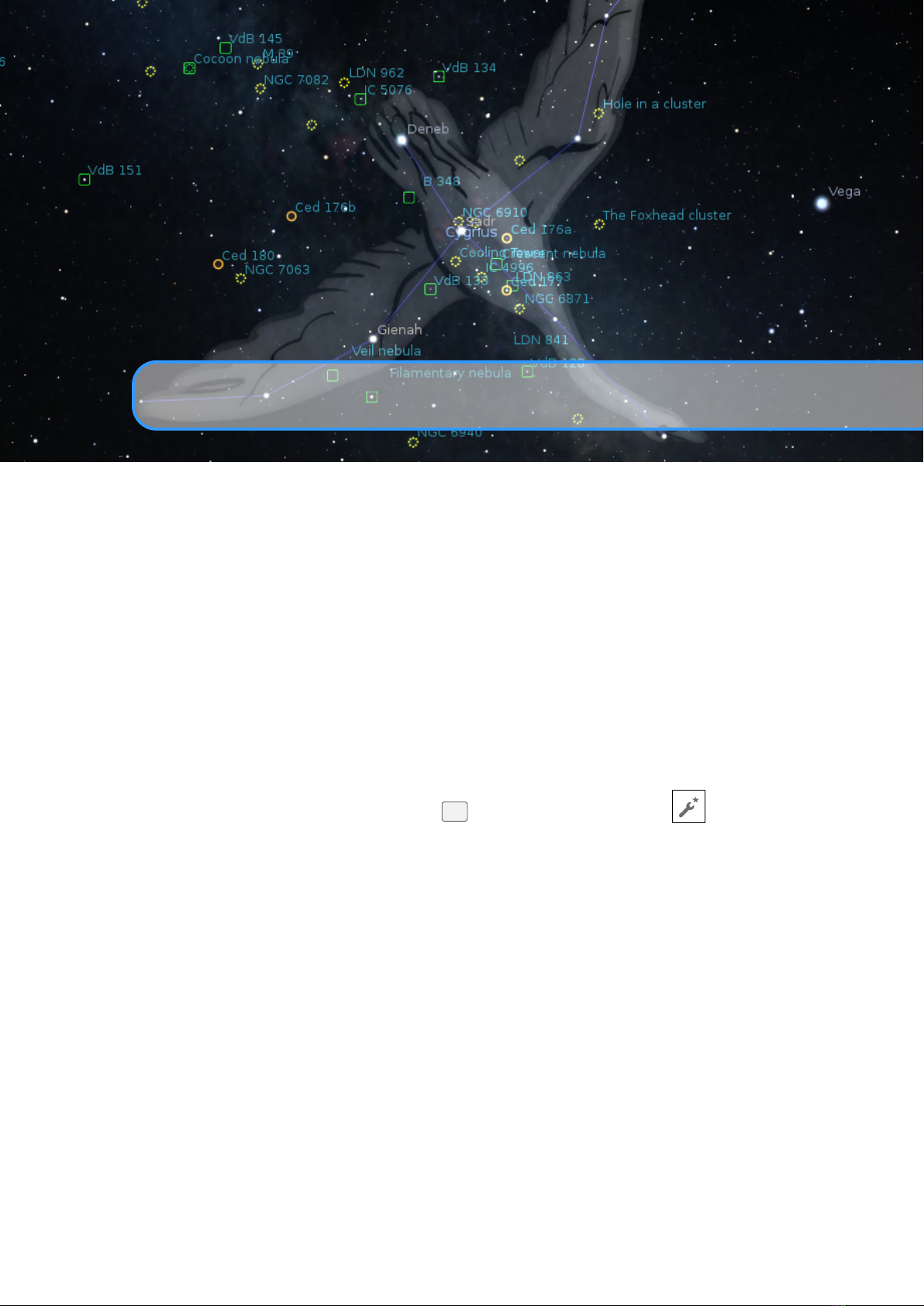
12. Plugins: An Introduction
Starting with version 0.10.3, Stellarium’s packages have included a steadily growing number of
optional extensions called plug-ins: Angle Measure, Compass Marks, Oculars, Telescope Control,
Text User Interface, Satellites, Solar System Editor, Historical Novae and Supernovae, Quasars,
Pulsars, Exoplanets, Observability analysis, ArchaeoLines, Scenery3D, RemoteControl, Navigation
Stars and RemoteSync. All these plug-ins are “built-in” in the standard Stellarium distribution and
don’t need to be downloaded separately.
12.1 Enabling plugins
To enable a plugin:
1. Open the Configuration dialog (press
F2
or use the left tool bar button )
2. Select the Plugins tab
3. Select the plugin you want to enable from the list
4. Check the Load at startup option
5. Restart Stellarium
If the plugin has configuration options, the configuration button will be enabled when the plugin
has been loaded and clicking it will open the plugin’s configuration dialog. When you only just
activated loading of a plugin, you must restart Stellarium to access the plugin’s configuration dialog.
The plugin’s configuration dialog is also available by right-clicking on the respective plugin’s main
button in the bottom button bar.
12.2 Data for plugins
Some plugins contain files with different data, e.g., catalogs. JSON is a typical format for those
files, and you can edit its contents manually. Of course, each plugin has a specific format of data for
its own catalogs, and you should read the documentation for the plugin before editing its catalog.
You can read some common instructions for editing catalogs of plugins below. In this example
we use file name catalog.json for identification of the catalog for a typical plugin.

136 Chapter 12. Plugins: An Introduction
You can modify the
catalog.json
files manually using a text editor. If you are using
Windows, it is strongly recommended to use an advanced text editor such as Notepad++
1
to
avoid problems with end-of-line characters. (It will also color the JSON code and make it easier
to read.)
Warning: Before editing your
catalog.json
file, make a backup copy. Leaving out the
smallest detail (such as a comma or forgetting to close a curly bracket) may prevent Stellarium
from starting.
As stated in section 5, the path to the directory
2
which contains
catalog.json
file is something
like:
Windows C:\Users\UserName\AppData\Roaming\Stellarium\modules\PluginName
Mac OS X HomeDirectory/Library/Application Support/Stellarium/modules/PluginName
Linux and UNIX-like OS ~/.stellarium/modules/PluginName
1
https://notepad-plus-plus.org/
2
This is a hidden folder, so in order to find it you may need to change your computer’s settings to display
hidden files and folders.
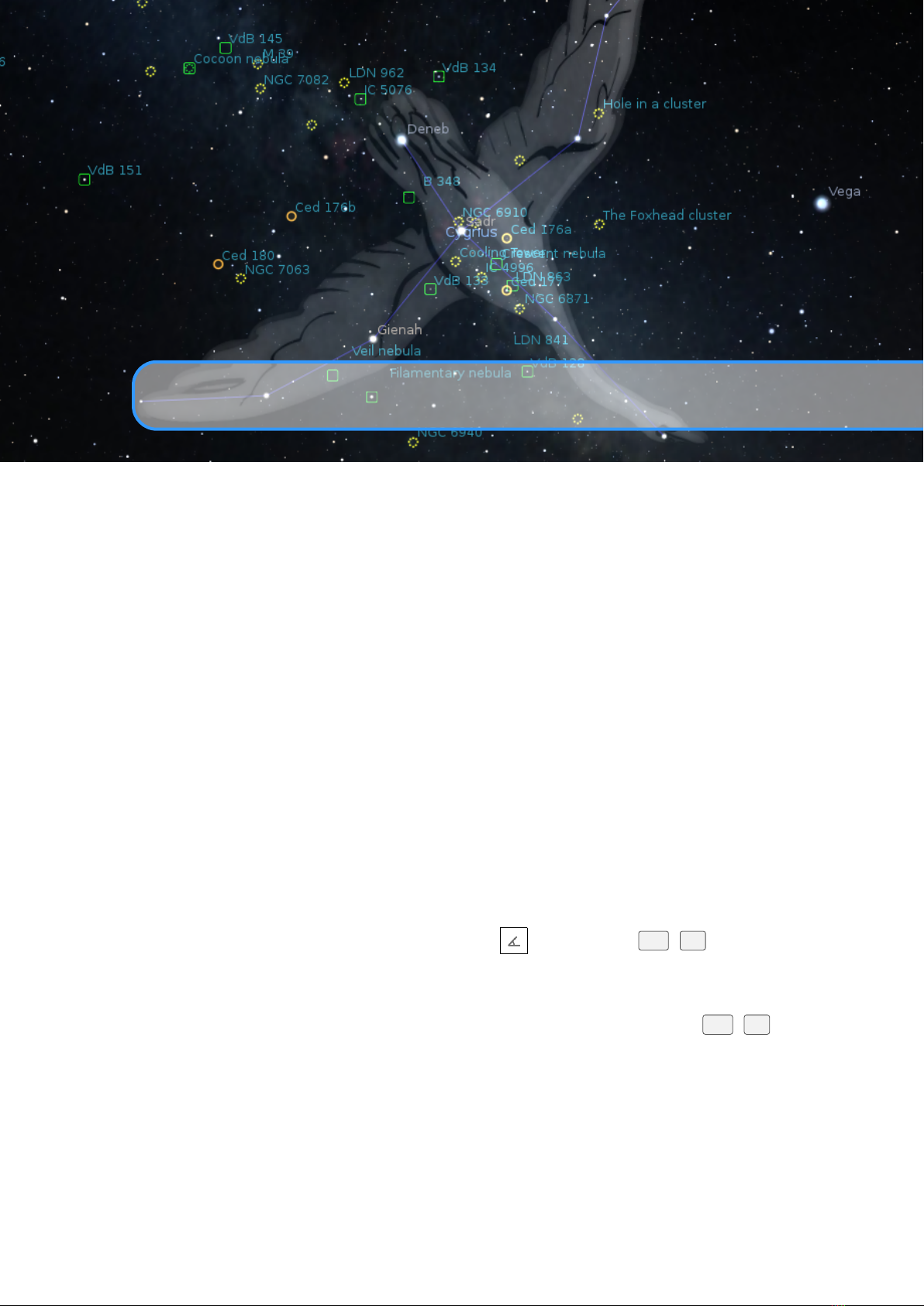
13. Interface Extensions
Most users will soon be familiar with the usual user interface. A few plugins are available which
extend the regular user interface with a few small additions which are presented first. However, some
applications and installations of Stellarium require completely different user interfaces. Mostly,
these serve to avoid showing the user interface panels to an audience, be that in your astronomy
club presentations, a domed planetarium or in a museum installation.
13.1 Angle Measure Plugin
goes misty eyed
I recall measuring the size of the Cassini Division when I was a student. It was not
the high academic glamor one might expect.. .It was cloudy.. . It was rainy. . . The
observatory lab had some old scopes set up at one end, pointing at a photograph of
Saturn at the other end of the lab. We measured. We calculated. We wished we were
in Hawaii. A picture is worth a thousand words.
The Angle Measure plugin is a small tool which is used to measure the angular distance between
two points on the sky.
1.
Enable the tool by clicking the tool-bar button , or by pressing
Ctrl
+
A
. A message
will appear at the bottom of the screen to tell you that the tool is active.
2. Drag a line from the first point to the second point using the left mouse button.
3. To measure to a different endpoint, click the right mouse button.
4. To deactivate the angle measure tool, press the tool-bar button again, or press
Ctrl
+
A
on
the keyboard.
In the configuration dialog, you can configure if you want to have distances given on the rotating
sphere, or in horizontal (alt-azimuthal) coordinates. You can also link one point to the resting
horizon, the other to the sky and observe how angles change. You can choose where to display the
measurement.
When option “Allow snap to selected object” is activated the process of measurement is
changed:

138 Chapter 13. Interface Extensions
Figure 13.1: Interface of Angle Measure plugin
•
The left mouse button is not used for angle measurement, so you can pan the screen and
left-click to select an object as usual.
• To draw the angle dimension line, you can drag with the right mouse button.
• A right click moves the end of the angle line that is closest to the mouse pointer.
•
If an object is selected, right-clicking will snap the end of the protractor line (closest to the
mouse pointer) to the selected object.
•
Double-click the right mouse button to capture the end of the line. Another double click
with the right mouse button removes the angle measuring line.
•
Which end of the protractor line is chosen depends on the position of the mouse pointer in
relation to the two ends of the line. The end of the line that is closer to the mouse pointer is
moved and defined as the new end point. The end of the line farther from the mouse pointer
is not moved and is defined as the new starting point.
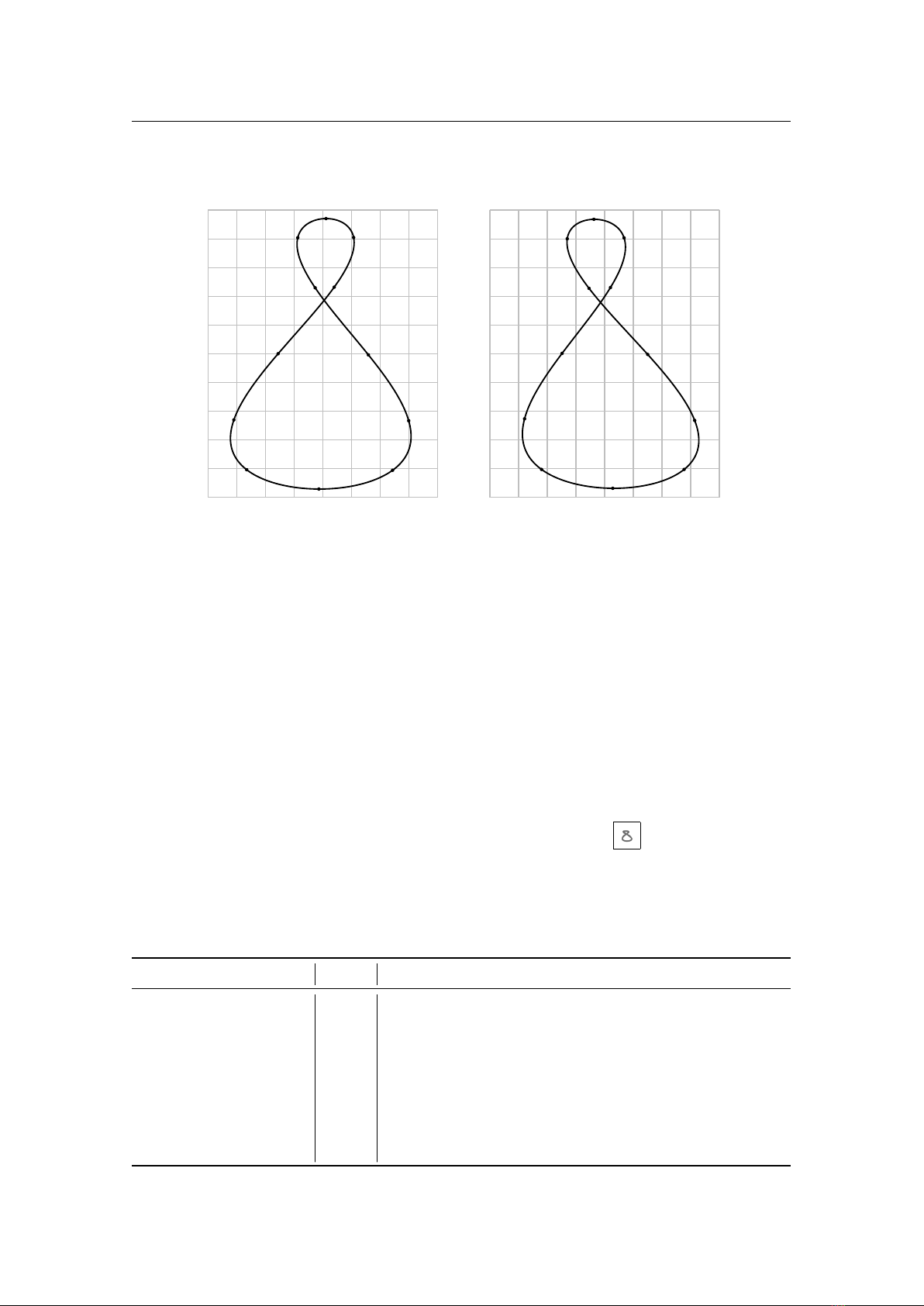
13.2 Equation of Time Plugin 139
13.2 Equation of Time Plugin
-20 -15 -10 -5 0 5 10 15 20
-25
-20
-15
-10
-5
0
5
10
15
20
25
Ari
Tau
Gem
Cnc
Leo
Vir
Lib
Sco
Sgr
Cap
Aqr
Psc
-20 -15 -10 -5 0 5 10 15 20
-25
-20
-15
-10
-5
0
5
10
15
20
25
Ari
Tau
Gem
Cnc
Leo
Vir
Lib
Sco
Sgr
Cap
Aqr
Psc
Figure 13.2: Figure-8 plots for Equation of Time, for years 1000 (left) and 2000 (right).
These plots, often found on sundials, link solar declination (vertical axis) and its deviation
at mean noon from the meridian, in minutes. Labeled dots indicate when the sun entered
the respective Zodiacal sign (30
◦
section of the ecliptic). Figures by Georg Zotti.
The Equation of Time plugin shows the solution of the equation of time. This describes the
discrepancy between two kinds of solar time:
Apparent solar time directly tracks the motion of the sun. Most sundials show this time.
Mean solar time tracks a fictitious “mean” sun with noons 24 hours apart.
There is no universally accepted definition of the sign of the equation of time. Some publications
show it as positive when a sundial is ahead of a clock; others when the clock is ahead of the sundial.
In the English-speaking world, the former usage is the more common, but is not always followed.
Anyone who makes use of a published table or graph should first check its sign usage.
If enabled (see section 12.1), click on the Equation of Time button on the bottom toolbar
to display the value for the equation of time on top of the screen.
13.2.1 Section
EquationOfTime
in config.ini file
You can edit
config.ini
file by yourself for changes of the settings for the Equation of Time
plugin – just make it carefully!
ID Type Description
enable_at_startup bool
Display solution of the equation of time at startup of Stel-
larium
flag_use_ms_format bool
Set format for the displayed solution – minutes and seconds
or decimal minutes
flag_use_inverted_value bool Change sign of the equation of time
flag_show_button bool Show the tool’s button on the bottom toolbar
text_color R,G,B
Font color for the displayed solution of the equation of time
font_size int
Font size for the displayed solution of the equation of time
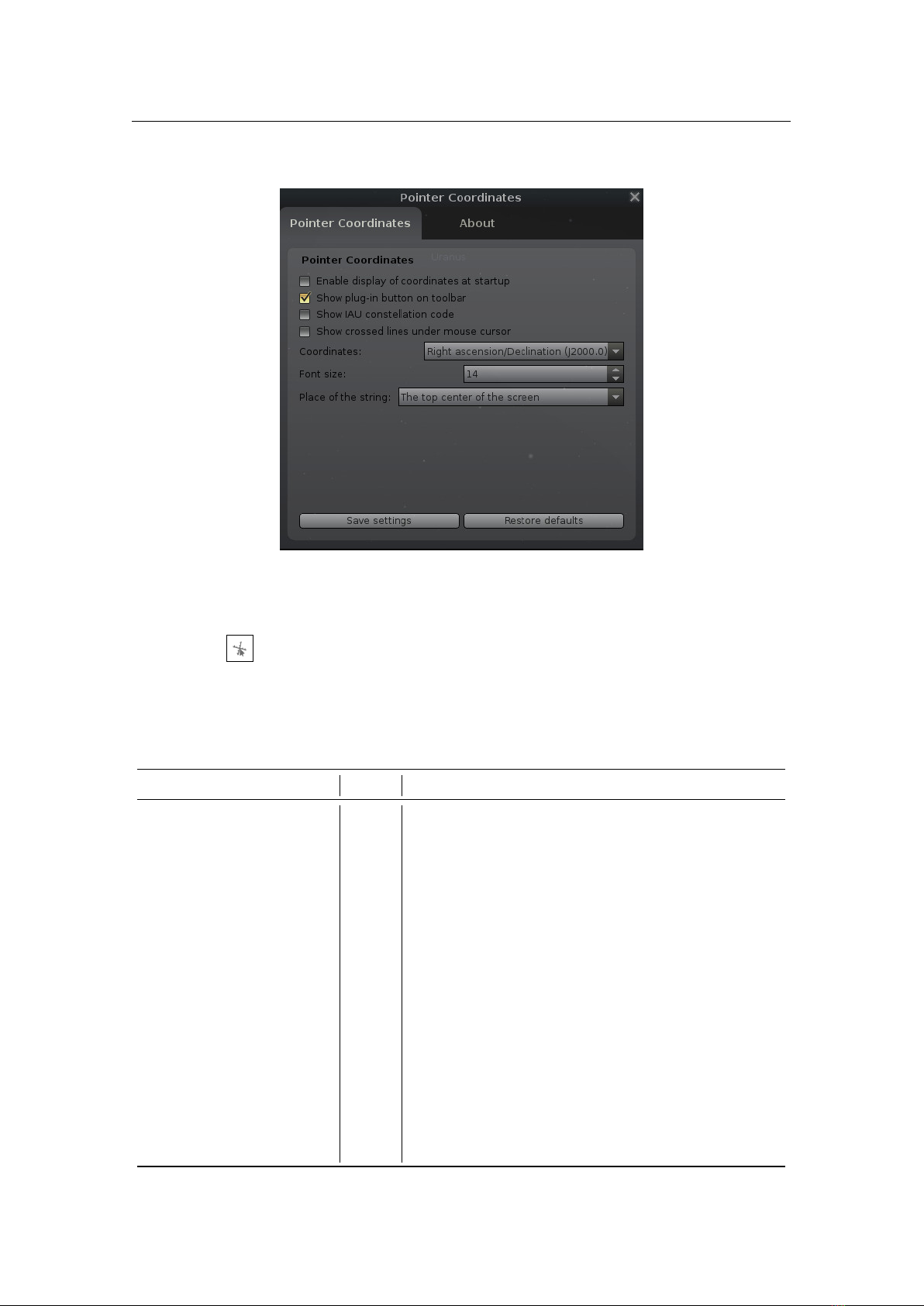
140 Chapter 13. Interface Extensions
13.3 Pointer Coordinates Plugin
Figure 13.3: Interface of Pointer Coordinates plugin
The Pointer Coordinates plugin shows the coordinates of the mouse pointer. If enabled, click on the
plugin button on the bottom toolbar to display the coordinates of the mouse pointer.
13.3.1 Section
PointerCoordinates
in config.ini file
You can edit
config.ini
file by yourself for changes of the settings for the Pointer Coordinates
plugin – just make it carefully!
ID Type Description
enable_at_startup bool
Enable displaying mouse pointer coordinates at pro-
gram startup
flag_show_button bool Show the plugin’s tool button on the bottom toolbar
text_color R,G,B Color for coordinates text of the mouse pointer
font_size int Font size for the displayed mouse pointer coordinates
current_displaying_place string
Specifies the place of displaying coordinates of
the mouse pointer. Possible values:
TopRight
,
TopCenter
,
RightBottomCorner
,
Custom
. Default
value: TopRight.
custom_coordinates int,int
Specifies the screen coordinates of the custom place
for displaying coordinates of the mouse pointer
current_coordinate_system string
Specifies the coordinate system. Possible values:
RaDecJ2000
,
RaDec
,
HourAngle
,
Ecliptic
,
AltAzi
,
Galactic. Default value: RaDecJ2000.
flag_show_constellation bool
Add the 3-letter IAU abbreviation for the constellation
of the mouse pointer location (Roman, 1987).
flag_show_crossed_lines bool Show crossed lines under mouse cursor.

13.4 Text User Interface Plugin 141
13.4 Text User Interface Plugin
This plugin re-implements the “TUI” of the pre-0.10 versions of Stellarium, an unobtrusive menu
used primarily by planetarium system operators to change settings, run scripts and so on.
A full list of the commands for the TUI plugin is given in section 13.4.2.
13.4.1 Using the Text User Interface
1. Activate the text menu using the
Alt
+
T
key.
1
2. Navigate the menu using the cursors keys.
3.
To edit a value, press the right cursor until the value you wish to change it highlighted with
> and < marks, e.g. >3.142<. Then press the cursor keys and to change the value.
You may also type in a new value with the other keys on the keyboard.
13.4.2 TUI Commands
1 Location (menu group)
1.1 Latitude Set the latitude of the observer in degrees
1.2 Longitude Set the longitude of the observer in degrees
1.3 Altitude Set the altitude of the observer in meters
1.4 Solar System Body Select the solar system body on which the observer is
2 Set Time (menu group)
2.1 Current date/time
Set the time and date for which Stellarium will generate
the view
2.2 Set Time Zone (disabled in 0.15)
2.3 Days keys (disabled in 0.15)
2.4 Startup date/time preset
Select the time which Stellarium starts with (if the “Sky
Time At Start-up” setting is “Preset Time”
2.5 Startup date and time
The setting “system” sets Stellarium’s time to the com-
puter clock when Stellarium runs. The setting “preset”
selects a time set in menu item “2.4 - Startup date/time
preset”
2.6 Date Display Format
Change how Stellarium formats date values. “sys-
tem_default” takes the format from the computer set-
tings, or it is possible to select “yyyymmdd”, “ddm-
myyyy” or “mmddyyyy” modes
2.7 Time Display Format
Change how Stellarium formats time values. “sys-
tem_default” takes the format from the computer set-
tings, or it is possible to select “24h” or “12h” clock
modes
3 General (menu group)
3.1 Starlore
Select the sky culture to use (changes constellation lines,
names, artwork)
3.2 Sky Language
Change the language used to describe objects in the sky
3.3 App Language Change the application language (used in GUIs)
1
This used to be hard-coded to
M
before version 0.15, but
Alt
+
T
is better to remember as it runs
parallel with
Ctrl
+
T
for switching the GUI panels, and frees up
M
for the Milky Way. The
Alt
+
T
keybinding is hard-coded, i.e., cannot be reconfigured by the user, and should not be used for another
function.

142 Chapter 13. Interface Extensions
4 Stars (menu group)
4.1 Show stars Turn on/off star rendering
4.2 Relative Scale
Change the relative brightness of the stars. Larger values
make bright stars much larger.
4.3 Absolute Scale
Change the absolute brightness of the stars. Large values
show more stars. Leave at 1 for realistic views.
4.4 Twinkle
Sets how strong the star twinkling effect is - zero is off,
the higher the value the more the stars will twinkle.
4.5 Mag limit Sets a custom magnitude cutoff for stars
4.6 Use mag limit Activates this magnitude limit
4.7 Spiky stars Use pointed star figures
4.8 Labels and Markers configures the amount of labels
4.9 Show additional star names
4.10
Use designations for screen
labels
5 Colors (menu group) change color/brightness of the. . .
5.1 Constellation lines constellation lines
5.2 Constellation labels labels used to name stars
5.3 Art brightness constellation art
5.4 Constellation boundaries constellation boundary lines
5.5 Cardinal points cardinal points markers
5.6 Planet labels labels for planets
5.7 Planet orbits orbital guide lines for planets
5.8 Planet trails planet trails lines
5.9 Meridian Line meridian line
5.10 Azimuthal Grid lines and labels for the azimuthal grid
5.11 Equatorial Grid lines and labels for the equatorial grid
5.12 Equatorial J2000 Grid lines and labels for the equatorial J2000.0 grid
5.13 Equator Line equator line
5.14 Ecliptic Line ecliptic line
5.15 Ecliptic Line (J2000) J2000 ecliptic line
5.16 Nebula names labels for nebulae
5.17 Nebula hints circles used to mark positions of unspecified nebulae
5.18 Galaxy hints ellipses used to mark positions of galaxies
5.19 Bright nebula hints squares used to mark positions of bright nebulae
5.20 Dark nebula hints squares used to mark positions of dark nebulae
5.21 Clusters hints symbols used to mark positions of clusters
5.22 Horizon line horizon line
5.23 Galactic grid galactic grid
5.24 Galactic equator line galactic equator line
5.25
Opposition/conjunction longi-
tude line
opposition/conjunction line
5.26 Sky background
sky background. Note that anything but black is only
useful for artistic works.
6 Effects (menu group)
6.1 Light Pollution
Changes the intensity of the light pollution (see Ap-
pendix B Bortle Scale index)

13.4 Text User Interface Plugin 143
6.2 Landscape
Select the landscape which Stellarium draws when
ground drawing is enabled. Press to activate.
6.3 Setting Landscape Sets Loca-
tion
If “Yes” then changing the landscape will move the
observer location to the location for that landscape (if
one is known). Setting this to “No” means the observer
location is not modified when the landscape is changed.
6.4
Auto zoom out returns to ini-
tial . . . view
Changes the behavior when zooming out from a selected
object. When set to “Off”, selected object will stay in
center. When set to “On”, view will return to startup
view.
6.5 Zoom Duration Sets the time for zoom operations to take (in seconds)
6.6 Milky Way intensity Changes the brightness of the Milky Way
6.6 Milky Way saturation Changes the saturation of the Milky Way
6.7 Zodiacal light intensity Changes the brightness of the Zodiacal light
7 Scripts (menu group)
7.1 Run local script
Run a script from the scripts sub-directory of the User
Directory or Installation Directory (see section 5 (Files
and Directories))
7.1 Stop running script Stop execution of a currently running script
8 Administration (menu group)
8.1 Load default configuration
Reset all settings according to the main configuration
file
8.2 Save current configuration Save the current settings to the main configuration file
8.3 Shutdown Emits a command configured in
13.4.3 Section
tui
in config.ini file
The section in
config.ini
for this plugin is named only
[tui]
for historical reasons. As always,
be careful when editing!
ID Type Description
tui_font_color R,G,B Font color for TUI text
tui_font_size int Font size for the TUI
flag_show_gravity_ui bool
Bend menu text around the screen center. May be
useful in planetarium setups, and should then be used
together with “Disc viewport” in the configuration
menu (see 4.3.5).
flag_show_tui_datetime bool Show date and time in lower center.
flag_show_tui_short_obj_info bool
Show some object info in lower right, or (in plane-
tarium setups with “Disc viewport” active,) wrapped
along the outer circle border.
admin_shutdown_cmd string executable command to shutdown your system. Best
used on Linux or Mac systems. E.g.
shutdown -h
now
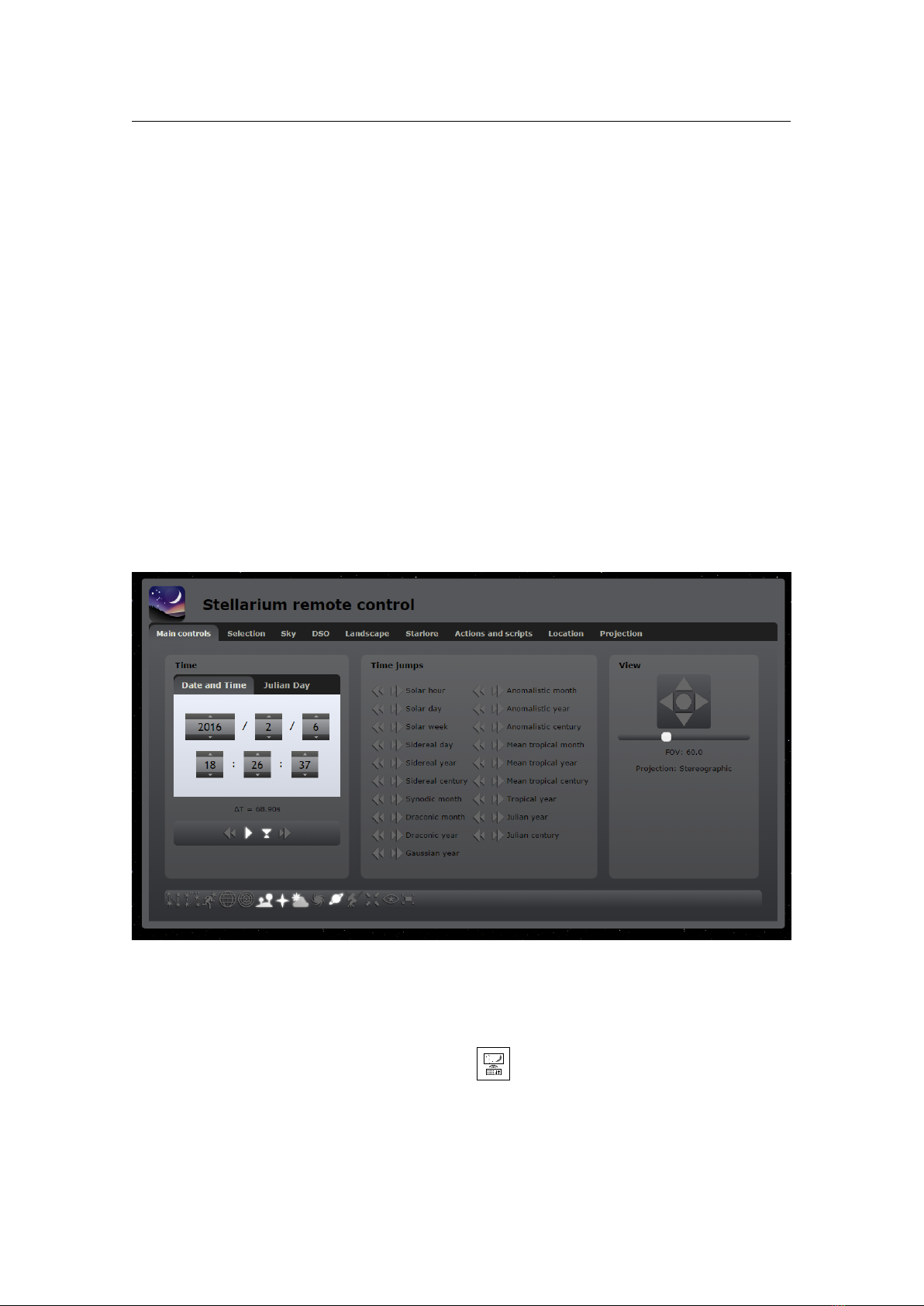
144 Chapter 13. Interface Extensions
13.5 Remote Control Plugin
The Remote Control plugin enables the user to control Stellarium through an external web interface
using a standard web browser like Firefox or Chrome, instead of using the main GUI. This works
on the same computer Stellarium runs as well as over the network. Even more, multiple “remote
controls” can access the same Stellarium instance at the same time, without getting in the way of
each other. Apart from system configuration options, most of the functionality the main interface
provides is available through it (Zotti, Schaukowitsch, and Wimmer, 2017).
The plugin may be most useful for presentation scenarios, hiding the GUI from the audience
and allowing the presenter to change settings on a separate monitor without showing distracting
dialog windows. It also allows to start and stop scripts remotely.
Because the web interface can be customized (or completely replaced) with some knowledge
of HTML, CSS and JavaScript, another possibility is a kiosk mode, where untrusted users can
execute a variety of predefined actions (like starting recorded tours) without having access to all
Stellarium settings. The web API can also be accessed directly (without using a browser and the
HTML interface), allowing control of Stellarium with external programs and scripts using HTTP
calls like with the tools wget and curl.
This plugin allows also interfacing other programs with Stellarium.
13.5.1 Using the plugin
Figure 13.4: The default remote control web interface
After enabling the plugin, you can set it up through the configuration dialog. You can configure
it to start the web server automatically whenever Stellarium starts or manually start/stop the server
using the “Server enabled” checkbox or the button in the toolbar.
The plugin starts an HTTP server on the specified port. The default port is 8090, so you should
reach the remote control after enabling it by starting a web browser on the same computer and
entering
http://localhost:8090
in the address bar. When trying to access the remote control
from another computer, you need the IP address or the hostname of the server on which Stellarium
runs. On a small tablet, you may want to use
http://myserver:8090/tablet7in.html
instead.

13.5 Remote Control Plugin 145
The plugin shows the locally detected address, but depending on your network or if you need
external access you might need to use a different one — contact your network administrator if you
need help with that.
Password
The access to the remote control may optionally be restricted with a simple password.
Warning: currently no network encryption is used, meaning that an attacker having access to
your network can easily find out the password by waiting for a user entering it. Access from the
Internet to the plugin should generally be restricted, except if countermeasures such as VPN usage
are taken! If you are in a home network using NAT (network access translation), this should be
enough for basic security except if port forwarding or a DMZ is configured.
CORS
The Web API also supports Cross-Origin Resource Sharing (CORS). By enabling CORS, compatible
websites and web apps can be used to control your Stellarium server.
Enable CORS by checking the “Enable CORS for the following origin” option in the config-
uration dialog. Then, enter the URL of the website you’d like to use to control Stellarium – e.g.
https://telescopius.com
. Specify “*” to let any website take control. Do this at your own
risk.
13.5.2 Remote Control Web Interface
If you are familiar with the main Stellarium interface, you should easily find your way around the
web interface. The remote control automatically uses the same language as set in the main program.
Tabs at the top allow access to different settings and controls.
Main
Contains the time controls and most of the buttons of the main bottom toolbar. An additional
control allows moving the view like when dragging the mouse or using the arrow keys in
Stellarium, and a slider enables the changing of the field of view. There are also buttons to
quickly execute time jumps using the commonly used astronomical time intervals.
Selection
Allows searching and selecting objects like in section 4.5. SIMBAD search is also
supported. Quick select buttons are available for the primary solar system objects. It also
displays the information text for current selection.
Sky
Settings related to the sky display as shown in the “View” dialog as shown in subsection 4.4.1.
DSO The deep-sky object catalog, filter and display settings like in subsection 4.4.4.
Landscape Changing and configuring the background landscape, see subsection 4.4.5
Actions and scripts
Lists all registered actions, and allows starting and stopping of scripts (chap-
ter 17). If there is no button for the action you want in another tab, you can find all actions
which can be configured as a keyboard shortcut (section 4.3) here.
Location
Allows changing the location, like in section 4.2. Custom location saving is currently
not supported.
Projection Switch the projection method used, like subsection 4.4.4.
13.5.3 Remote Control Commandline API
Apart from retrieving quick object info in your browser with e.g.
http://localhost:8090/api
/objects/info?format=json&name=Sun
, it is also possible to send commands via command
line
2
, e.g.,
wget -q -- post - data ’id = show . ssc ’ http :// st e lla :8 090/ api / scr i pts / run >/ dev / null 2 >&1
curl -- data ’id = myScript . ssc ’ http :// localhost :8090/ api / sc r ipts / run >/ dev / null 2 >&1
2
Depending on your operating system or command shell, you may have to use double quotes in the
--data argument to curl.

146 Chapter 13. Interface Extensions
curl -d ’id = myScript . ssc ’ http :// localhost :8090/ api / sc r ipts / run >/ dev / null 2 >&1
curl -d ’ id = L a ndsca p e M g r . f o g D isplay e d & val ue = false ’ \
http :// lo c a l h o s t :8090/ api / st e l p r o perty / set
This allows triggering automatic show setups for museums etc. via some centralized schedulers
like cron.
To get a complete pretty-printed list of properties and actions, use:
curl -G -d ’ propId = -2& actionId = -2 ’ http :// l o calhost :809 0/ api / main / stat us | \
py thon -m json . tool
13.5.4 Developer information
If you are a developer and would like to add functionality to the Remote Control API, customize
the web interface or access the API through another program, further information can be found in
the plugin’s developer documentation
3
.
13.5.5 Acknowledgements
This plugin was created by Florian Schaukowitsch in the 2015 campaign of the ESA Summer of
Code in Space
4
programme.
If you are using this plugin in your scientific publications, please cite Zotti, Schaukowitsch,
and Wimmer (2017).
3
https://stellarium.org/doc/head/remoteControlDoc.html
4
https://socis.esa.int/

13.6 Remote Sync Plugin 147
13.6 Remote Sync Plugin
The Remote Sync plugin enables setups which connect several instances of Stellarium running on a
network. This may be useful in installations where one presenter wants to allow a larger audience
to follow the actions on several dim screens (e.g., when you need to avoid a projector’s bright light
in a public observatory). The actions performed on a “master” instance, which acts as a server, are
automatically replicated on all connected clients. These clients may run on the same device the
server runs, or may access the server over a network.
The plugin is still quite experimental, but is provided for testing and developing purposes. You
can configure it through the standard plugin settings dialog (Figure 13.5). One Stellarium instance
can either run in the server mode or connect to an existing server as a client. A custom TCP protocol
is used for the connection. The port used by the server is configurable, and the clients must know
the IP address or host name and the port of the server.
Figure 13.5: RemoteSync settings window
Alternatively, you may start the plugin through command line arguments. This is useful
for automated setups or when multiple instances are running on the same computer. To start
the instance as a server, use the
--syncMode=server
argument with the optional
--syncPort
parameter to specify the port to listen on. To start a client instance, use
--syncMode=client
and
use --syncHost and --syncPort to specify the server to connect to.
In the settings window, you can also specify what should happen when the client loses the
connection to its server, and what to do when the server quits normally. You can choose between
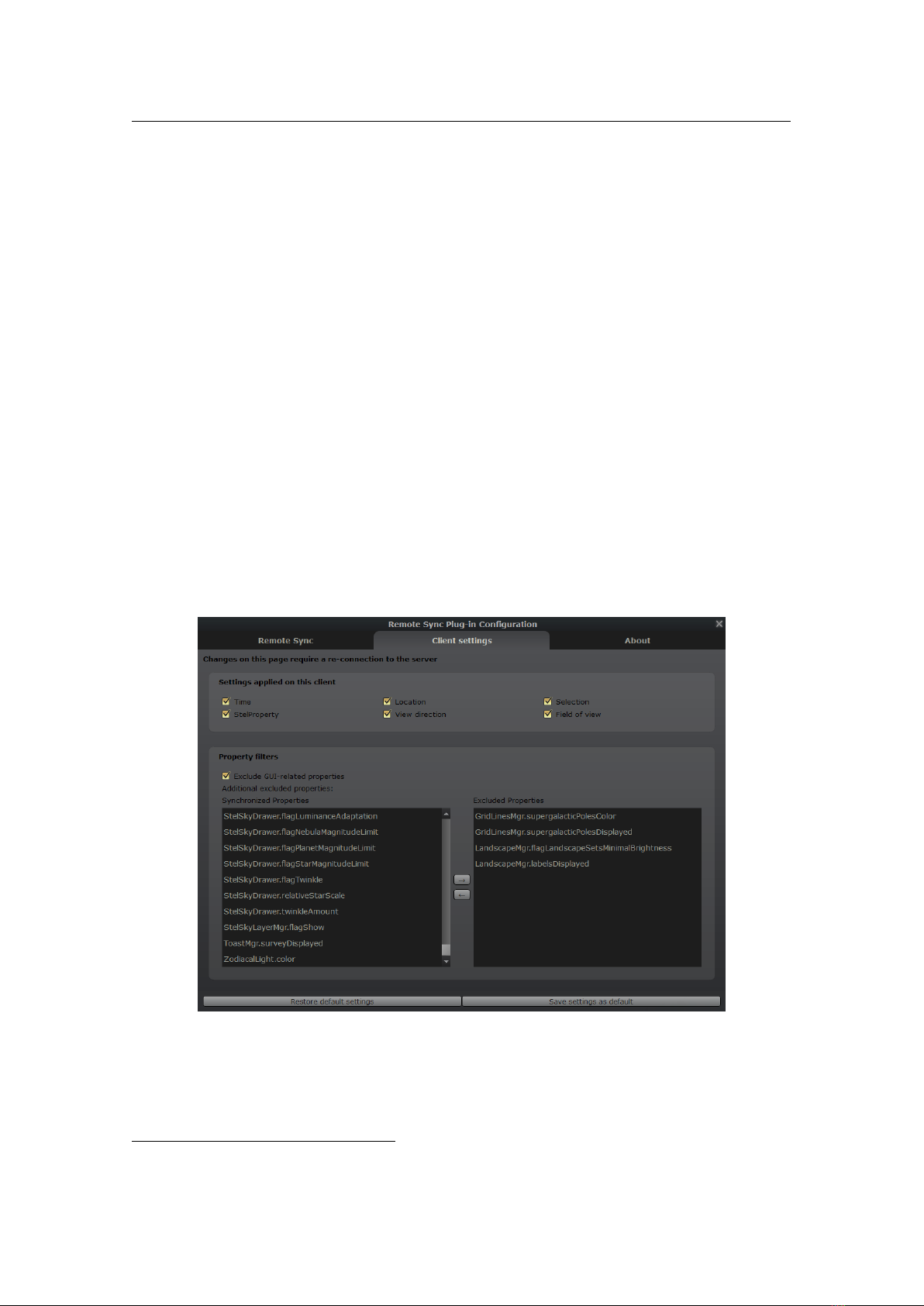
148 Chapter 13. Interface Extensions
Do nothing:
connection is lost and will not be re-established. Stellarium client keeps running in
whatever state it was, waiting for keyboard/mouse interaction.
Try reconnecting:
Assume Stellarium is switched off on the server but may come back online
again, or assume some temporary network problem. Stellarium client just keeps running in
whatever state it was, but tries to reconnect.
Quit:
Assume the server always runs until switched off at the end of operating hours. This is
intended for pure client screens without keyboards. When the server is shut down, assume
this is the end of the day, and exit Stellarium. An enclosing run script can then shutdown the
client computer before power is switched off with some main switch.
By default, the following things are synchronized:
• simulation time
• viewer location
• the selected object
• view direction
• current field of view
•
all StelProperty-based settings except for GUI-related properties. This includes almost all
settings visible in the configuration dialogs such as projection type, sky and view options,
landscape settings, line colors, etc.
Because there is currently no full time synchronization implemented, for the best results all client
computers should make sure their system clocks are set as close as possible to the server computer’s
clock (preferably a few milliseconds difference at most). This can be done for example by using an
NTP server.
5
If all your Stellarium instances run on the same device, this is of course not necessary.
Figure 13.6: RemoteSync client settings window
It is also possible to exclude some state from being synchronized. On each client, the client
configuration GUI (Figure 13.6) allows to disable specific settings from being synchronized on this
client.
5
Instructions on how to use the public NTP server pool for the most common operating systems can be
found at https://www.pool.ntp.org/en/use.html.

13.6 Remote Sync Plugin 149
The lower part of this dialog allows you to fine-tune which named StelProperties (which hold
parts of the internal program state) should be excluded from synchronization. The configuration
dialog lists all available properties which usually have easy to understand names on the left side.
Highlight one or more properties which you don’t want synchronized and press the arrow button to
move them to the list of excluded properties.
For historic reasons there are two kinds of Properties: Actions (Boolean switches, for which
also hotkeys can be assigned) and (genuine) StelProperties. The latter have names indicating which
module they belong to and may have other data types (numbers, colors, .. . ). Note that the actions
frequently are just alias names of Boolean StelProperties, so in order to inhibit a certain property
from being synchronized, you must find both entries.
Properties of plugins will only be visible when the respective plugin has been enabled. When
a plugin has been disabled, its properties may vanish from the stored list of non-synchronized
properties.
Each client can have different settings. This could allow installations with several screens
where on one screen you show the constellation figures, another screen shows the distribution of
deep-sky objects in the same frame, and a third screen may show a close-up view of the currently
centered object. Or just show several sky cultures, or show the sky at different locations, . . . .
The names of all available StelProperties from which you might want to select a few to exclude
from synchronisation can also be found with a little scripting (see chapter 17). Open the script
console
F12
and enter the following call:
core.output(core.getPropertyList());
Run the script and inspect the output tab. It may take a little guesswork to select the right names,
but the general structure of property names like
<Module>.<Property>
should help you to find
your way around.
13.6.1 Developer notes
Usually the synchronisation fails if you attempt to use different versions of Stellarium. You can
override this behaviour with an entry in the respective section of config.ini:
[ RemoteSync ]
allo w V e rs i o n Mi s m at c h = true
13.6.2 Finetuning
This plugin makes use of the QLoggingCategory infrastructure. By default it is very verbose and
prints each transmitted property to the logfile. To reduce verbosity when it works, configure an
environment variable with these entries (Note the closing semicolon!):
QT_LOG G I N G_R U L E S =" stel . plugin . r em o t e S y n c . debug = true ;
stel . plug i n . remoteSync . cl i ent . debug = false ;
stel . plug i n . remoteSync . protoc o l . deb ug = false ; "
The final parts may be debug|info|warning|critical = true|false. Default: true.
Author and Acknowledgements
This plugin was created mostly by Florian Schaukowitsch in the 2015-16 campaigns of the ESA
Summer of Code in Space
6
programme.
6
https://socis.esa.int/

150 Chapter 13. Interface Extensions
13.7 OnlineQueries Plugin
Stellarium includes and provides lots of information about many kinds of objects. However, there
are scientific websites which provide even more specialized information about particular objects.
This plugin (Zotti, S. M. Hoffmann, et al., 2023) allows online access to several websites on a
variety of special topics. To retrieve information, select the first tab and press the respective button
labeled with the information source. The result is displayed in a browser view
7
.
Wikipedia
The free online encyclopedia provides information about many bright stars, the planets,
moons and many asteroids, as well as many deep-sky objects. The lookup is based on the
English proper name.
AAVSO
The International Variable Star Index
8
of the American Association of Variable Star
Observers (AAVSO) provides data about variable stars.
GCVS
The General Catalogue of Variable Stars
9
of the Sternberg Astronomical Institute and the
Institute of Astronomy of the Russian Academy of Sciences in Moscow.
In addition, you can configure up to three further websites. These must provide some public
website which takes a query for a Hipparcos star number or object name. For example, the website
https://biblicalastronomy.co/playground/fetch.cfm?Hipp=n
provides various data
and cross-references for a star with Hipparcos number n.
Regardless of the current program language, the result is always presented in English or the
language of the respective website.
13.7.1 Section
OnlineQueries
in config.ini file
You can edit the
config.ini
file to change settings of the OnlineQueries plugin. The only strings
you should need to touch are the
customN_...
entries (
N ∈
{
1,2,3
}
). The placeholder
%1
will be
filled by either the Hipparcos number (if the respective
customN_use_hip
is
true
) or by the first
English name used in Stellarium. The
customN_use_hip
should be
true
to use a star’s Hipparcos
number, or false to use the English name as key.
ID Type Default
aavso_hip_url string (don’t override)
aavso_oid_url string (don’t override)
gcvs_url string (don’t override)
wikipedia_url string (don’t override)
custom1_url string https://biblicalastronomy.co/playground/fetch.cfm?Hipp=%1
custom2_url string
custom3_url string
custom1_use_hip boolean true
custom2_use_hip boolean true
custom3_use_hip boolean true
disable_webview boolean false
7
For technical reasons, on some platforms the result is displayed in the system’s default web browser. On
some other platforms, e.g. Windows/WSL with Ubuntu or some ARM computers, the web view fails to work
properly. On these platforms you should manually edit
config.ini
and set the
disable_webview
entry
in the config file.
8
https://www.aavso.org/vsx/
9
http://www.sai.msu.su/gcvs/

13.8 Solar System Editor Plugin 151
13.8 Solar System Editor Plugin
Stellarium stores its data (orbital elements and other details) about solar system objects (planets,
their moons, minor bodies) in two files. File
data/ssystem_major.ini
in the installation direc-
tory contains data for the planets and their moons, and should never be touched by users. File
data/ssystem_minor.ini
contains data for minor bodies, i.e., planetoids and comets. The file
will be taken from the user data directory if it also exists there, which means that users can add
minor planets or comets as they become observable by editing this file.
The orbits of minor bodies (minor planets and comets) are specified with orbital elements for
Kepler orbits (after JOHANNES KEPLER (1572–1630) who found the true shape of the orbit of a
small body around a large one being a conic section, i.e., circle, ellipse, parabola or hyperbola).
These elements describe the instantaneous shape and orientation of the object’s orbit around the
Sun at a particular time called the epoch. See Appendix D.2 for more details. We compute positions
from these unperturbed orbits, but the result is only valid for a moderately short timespan around
the epoch, because the major planets can exert noticeable gravitational perturbations on the objects
when they come close, and so these orbital elements need to be updated on a regular basis. When
you go out hunting for asteroids and comets, this plugin is for you.
This plugin provides access to the Minor Planet Center (MPC
10
) server where the latest Solar
System information can be found. When this plugin is loaded (see section 12.1) and you open the
configuration dialog, the first tab allows to import, export or reset your
ssystem_minor.ini
, and
also to load extra data for minor bodies in Stellarium’s
.ini
format. For example, the installation
directory contains a file
ssystem_1000comets.ini
which contains data for over 1000 historical
comets. Currently it is not possible to select only a few from that, so try loading this only on a
reasonably fast computer, and think about deleting comets again (or resetting the file) when you
don’t require them.
Figure 13.7: Interface of Solar System Editor plugin: Configuration file tab
The second tab lists all currently loaded minor bodies (see figure 13.8). It is recommended to
10
https://www.minorplanetcenter.net
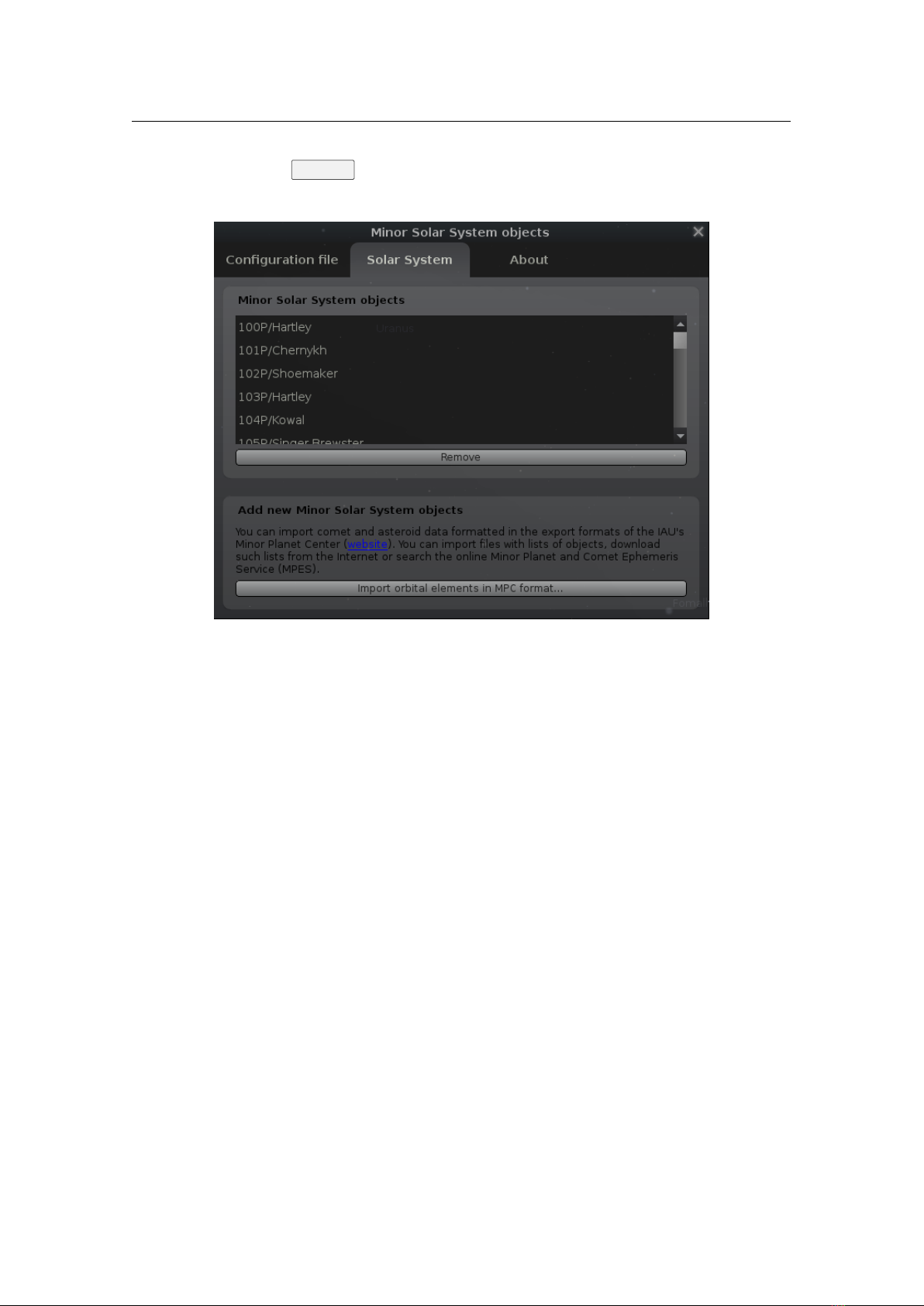
152 Chapter 13. Interface Extensions
remove old entries of yesteryear’s comets if you don’t need them any longer. Just select one or
more objects and press
Remove
. If you have a very weak computer, you may want to reduce the
number of minor bodies to just a handful to improve performance.
Figure 13.8: Interface of Solar System Editor plugin: Solar System tab
On this tab, you also find the option to connect to the MPC and download current orbital
elements, or load a text file in the format provided by MPC (see figures 13.9 and 13.10).
Once MPC data has been downloaded, the user can select objects for updating the user’s
ssystem_minor.ini.
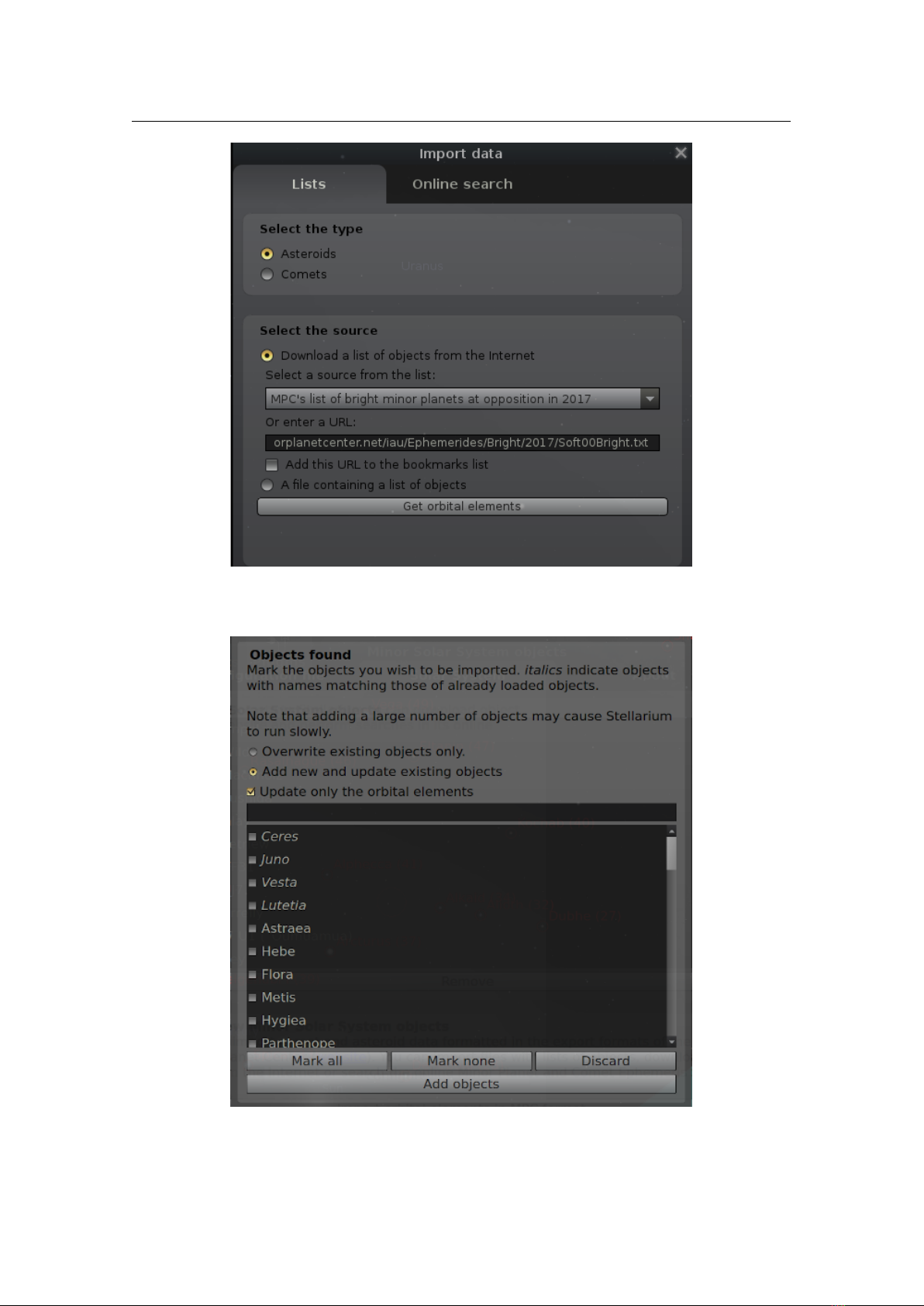
13.8 Solar System Editor Plugin 153
Figure 13.9: Interface of Solar System Editor plugin: Import data dialog
Figure 13.10: Interface of Solar System Editor plugin: Import data dialog — view after
downloading and parsing the MPC data.

154 Chapter 13. Interface Extensions
13.9 Calendars Plugin
GEORG ZOTTI
13.9.1 Introduction
The calendar dates in the main program behave like most other astronomical software titles:
• Dates are given in the Gregorian calendar for all dates beginning with October 15, 1582.
•
All earlier dates are given in the Julian Calendar in its finalized form by AUGUSTUS.
Historically, only dates beginning with March 1st, 4 A.D. coincide with historically recorded
dates: the Roman priesthood messed up the 4-year count introduced by JULIUS CAESAR
and counted leap years every third year. AUGUSTUS decreed to omit leap days from 12 B.C.
to 4 A.D. to move the seasons to where JULIUS CAESAR had placed them.
•
Given the errors in the Julian calendar, simulation in early prehistory will provide non-
intuitive calendar dates for the seasons’ beginnings.
•
Astronomical counting of years includes a year zero and negative years. Historical calendars
don’t have a year zero. 1 A.D. is preceded by 1 B.C. Therefore a negative year in Stellarium
may look uncommon to historians who may think Stellarium is one year off.
Since earliest times people all over the world have observed the sky and used its phenomena to
structure their lives, agree on future events (“we shall meet here again and exchange goods at
the third Full Moon from now”), record and measure time. Over millennia, various systematic
calendars evolved. A classic and often-cited presentation of calendars from the pre-computer era is
still the monumental work by Ginzel (1906; 1908; 1911). The next challenge was then to describe
the systematic of these algorithmically and make them available for computer programs. Reingold
and Dershowitz (2018) have presented a modern masterpiece of this kind and are our preferred
source of algorithms. This plugin will evolve over the next time to bring a good sample of calendars
into Stellarium.
In the configuration panel you can select which calendars you want to display in the lower right
corner of the screen, and you can also directly interact with some of them.
The calendars displayed in this plugin come with their own logic. Historically, when a calendar
was introduced, dates which precede its starting point (era) were of little interest to its users,
therefore if a date bears negative years (or negative units of its largest component) those dates may
not be useful.
Note that in some calendars the day did not begin at midnight, but for example at sunrise,
sunset, or dawn. This cannot be reflected in this plugin. Dates should be correct at noon, and may
be one day off dependent on these aspects.
11
13.9.2 The Calendars
Lunisolar European calendars
Julian
JULIUS CAESAR introduced this calendar, advised by the Egyptian astronomer SOSIGENES.
Every 4th year is a leap year of 366 instead of 365 days, yielding a mean length of the year
of 365.25 days.
In contrast to the default calendar display of Stellarium, this implementation utilizes historical
year counting, i.e., has no year zero. Years are marked A.D. or B.C., respectively. The
omission of year zero makes negative leap years break the simple 4-year count. Now they
are 1 B.C., 5 B.C., 9 B.C. etc. However, note that before 8 A.D. leap years are just counted
11
At the current point of implementation I cannot exclude further errors! The plugin reproduces the given
sample dates, but we cannot give any guarantee about the accuracy of historical dates. If you are more
familiar with any of the non-European calendars, you are invited to identify errors or at least additions to this
documentation, e.g. variants to the schemes used.

13.9 Calendars Plugin 155
proleptic, but the Romans did not keep the leap years commanded by JULIUS CAESAR until
AUGUSTUS put things back in order. This means, displayed dates before 8 A.D. may be off
by up to 3 days from historical accounts written by contemporaries.
Gregorian
This implementation acts like Stellarium with respect to year counting and counts
signed negative and positive years, with a year zero between them. It shows dates in a
Proleptic Gregorian calendar for dates before October 15, 1582. Given its improved rules for
leap years which provide a mean length of the year of 365.2425 days, it keeps the seasons’
beginnings closer to the commonly known dates, at least for many more centuries in the past
than the Julian calendar commonly used by historians.
Revised Julian Calendar
(also named Milankovi
´
c Calendar) In 1923, the Serbian scientist
MILUTIN MILANKOVI
´
C (1879–1958) proposed a calendar which should overcome the then
13-day calendar gap between the Eastern European Orthodox churches who still adhered
to the Julian calendar and the rest of the world which followed the Gregorian calendar. It
amends the 4-year Julian leap year cycle by omitting century years except for those where
division by 900 leaves a remainder of 200 or 600. Therefore the mean length of the year is
365.242
¯
2 days, 24 seconds less than the Gregorian and within 2 seconds of the correct length
of the mean tropical year. For a synchronisation with the Gregorian, October 1-13 1923 were
omitted. Between March 1600 and February 2800 the calendar dates are identical to those in
the Gregorian calendar. The calendar was adopted by several but not all Eastern Orthodox
churches, although date of Easter is still computed according to the Julian calendar
12
.
In historical context giving dates in the Revised Julian calendar for years before the dates
of religious festivals were defined in the calendar makes no sense. Its idea was to have a
continuous calendar as it was in use at the concile of Nicaea in A.D.325. Therefore dates
before A.D.325 are displayed like in the traditional Julian calendar.
ISO Week
The International Standards Organization describes weeks in the Gregorian calendar
from Monday (Day 1) to Sunday (Day 7). Week 1 of each year contains the first Thursday of
the year. Years may have a week 53, where the last days already belong to the next Gregorian
year.
Icelandic calendar
Since 1700, this counts weeks in summer and winter seasons, 12 months of
30 days with a few extra days and the occasional leap week after the third month of summer.
Year numbers concur with the Gregorian, but start with summer in late April.
Roman calendar
This presents the Roman way of writing calendar dates in the Julian calendar
and provides dates ab urbe condita (A.U.C.).
Olympic calendar
Another way to write the years in the Julian calendar uses the Greek Olympiads,
a 4-year cycle starting in 776 B.C.E. The Olympic games of antiquity were held in year 1 of
each cycle.
Near Eastern Solar calendars
Several calendars with 12 months of 30 days plus 5 (6 for leap years in some calendars) epagomenae
days, with different calendar eras.
Egyptian
A 365 day year without leap days. Following the tradition of PTOLEMY, we use the era
of Nabonassar.
Armenian also has no leap days.
Zoroastrian
also has no leap days. This uses different names for each day of the month and
for each epagomenae day. Month names are from Ginzel (1906, §69) with transliteration
adapted to Reingold and Dershowitz (2018).
Coptic
uses Month names derived from the Egyptian calendar, but observes leap years every 4th
year. Its era martyrum is also called Diocletian era.
12
More details can be found on https://en.wikipedia.org/wiki/Revised_Julian_calendar

156 Chapter 13. Interface Extensions
Ethiopic
is Parallel to the Coptic calendar, just with different year numbers, counted from the
ethiopic era of mercy.
Persian
a Solar calendar adopted in 1925, but based on the earlier Jal
¯
al
¯
ı calendar of the 11th
century A.D. Years begin at the Vernal equinox (nowruz) and follow a complicated leap
year cycle of 2820 years. Days begin at midnight (zone time). An identical calendar with
different month names was adopted in Afghanistan in 1957.
Stellarium provides both versions: the algorithmic version and the astronomically specified
one. They occasionally deviate from each other by 1 day.
Bahá’í
is a Solar calendar with years beginning on the day of Vernal equinox. In the algorithmic
v 1.2
version used in the West, March 21 in the Gregorian calendar was used, but the astronomical
version used since 2015 uses Tehran as reference location. Days begin at sunset. The
calendar uses a 7-day week but is else based on cycles of the number 19: 19 named months
of 19 named days plus 4-5 additional days after month 18. In addition, years are structured
in named 19-years (V
¯
ah
.
id, “unity”) and numbered 19
2
= 361-years (Kull-i-shay) cycles.
Near Eastern calendars
Several more calendars have been worked out in algorithmic forms:
Islamic
is a strict Lunar calendar without observance of seasons. Days begin at sunset, but we
cannot currently show this. The date should be correct at Noon. The week begins on Sunday.
Note that this algorithmic solution may deviate from the dates given by religious authorities
on basis of observation.
Hebrew is a Lunisolar calendar with strict Lunar months, but adherence to the seasons. It has 12
or 13 months, and 353-355 or 383-385 days per year. The algorithmic form was instroduced
in the mid-4th century A.D.
Asian calendars
Old Hindu Solar
used before about 1100 A.D. The implementation follows the (First)
¯
Arya
Siddh
¯
anta of
¯
Aryabha
t
.
a (499 C.E.), as amended by Lalla (circa 720–790 C.E.). The year is
split into 12 months (saura) of equal length. Days begin with sunrise, simplified as 6 am.
Years are counted as elapsed years (starting at 0) from the Kali Yuga (Iron Age) epoch (Feb.
18., 3102 B.C. jul.).
Old Hindu Lunisolar
used before about 1100 A.D. This implementation shows the south-Indian
method with months starting at New Moon (am
¯
anta scheme). (In the north, the p
¯
ur
n
.
im
¯
anta
scheme describes months starting with Full Moon. There are also some local differences.) It
also shows the K.Y. day count (ahargan
.
a), i.e., days elapsed since the K.Y. epoch.
New Hindu Solar and Lunisolar
This is the Hindu calendar from the S
¯
urya-Siddh
¯
anta (ca. 1000 A.D.).
It is based on epicyclical motions of the Sun and Moon around the Earth. While still an
approximation, this provides more accurate models of the motions at cost of much more
complicated computation. The Solar month begins when the Sun enters a sign on the Side-
real Zodiac. Months are therefore 29 to 32 days long. Solar days begin at sunrise, and the
zodiacal position of the sun at sunrise in Ujjain, India, decides on the date.
Years given for the Solar calendar are counted from the Saka era (A.D. 78).
The lunar month name is determined by the (first) zodiacal sign entered by the sun during the
month. When no sign is entered, the month is “leap” (adhika) and named after the following
month. When a Solar month passes without a New Moon, a lunar month can also be skipped
(kshaya). The Lunisolar year has 12 or 13 months, of which up to 2 can be leap and one
skipped!
A lunar day varies in length from 21.5 to 26.2 hours, and therefore may occasionally have to
be repeated (here the second day is the leap day or adhika), or skipped.
Years are given in the Vikrama era which began in 58 B.C. Both months schemes share the

13.9 Calendars Plugin 157
same 12 names.
Also this calendar is shown in the am
¯
anta scheme, i.e., months start at New Moon. There
are again several local variants, and of course a longitude difference to the reference location
may also lead to deviations.
In addition to the New Hindu Lunisolar date, the Hindu panchang is shown, a 5-part
description of the day consisting of
Tithi (lunar day)
Weekday
Naks
.
atra the part of the ecliptic the Moon is in at time of sunrise (in Ujjain).
Yoga a cycle of 27 names resulting from the “addition” of Solar and Lunar longitudes.
13
Karan
.
a
a count of 60 lunar half-days resulting in 11 names. The kara
n
.
a at time of sunrise
(in Ujjain) governs the karan
.
a for the day
14
.
Hindu Astronomical Solar and Lunisolar
These are similar to the New Hindu calendars, but
with even more accurate positional computations from the S
¯
urya-Siddh
¯
anta for Solar and
Lunar positions.
Tibetan calendar
is actually only one of several calendars used in Tibet. We show the date in the
official Phuglugs (or Phug-pa, Phukluk) version of the K
¯
alacakra calendar, derived from the
K
¯
alacakra Tantra which was translated from Sanskrit to Tibetan in the 11th century, and has
been sanctioned by the Dalai Lama. It is similar to the Hindu Lunisolar calendar, but has
also regional variants where astronomical events are computed in local time. In Tibet, the
actual calendar is issued only annually (after empirical corrections) by the Tibetan School
for Astro and Medicine and may diverge from the calendar shown here.
Months are 29 or 30 days long and numbered 1 to 12. Leap months precede their “regular”
counterparts but else have the same name.
Years are counted from the date of ascension of the first Yarlung king, NYATRI TSENPO, in
128 B.C. (We write “A.T.” for Anno Tibetorum.) However, it is more common to designate
years in a cycle of 60 years, with 5 elements which label two consecutive years which are
further named “male” and “female”, and a parallel cycle of 12 animal totems. This cycle has
been synchronized with the similar Chinese 60-years cycle.
Balinese Pawukon
is a 10-part sequence of day names with cycle lengths of 2 to 10, which can
also be written as numbers or symbols. Some numbers repeat in simple cycles, while others
follow more complicated rules. A full cycle takes 210 days. Due to space reasons this needs
two lines on the display. Formatting may improve in later versions.
Chinese calendars
v 1.2
The Chinese calendar (and related Japanese, Korean and Vietnamese) is a Lunisolar calendar based
on astronomical events. Days begin at midnight. Lunar months begin on the day of New Moon. The
position of the Sun along the Zodiac is given by Major (zh
¯
ongqì) and Minor (jiéqì) Solar Terms.
Chinese
The version here is the 1645 version. Earlier dates may be wrong. The calendar’s location
for astronomical computations is Beijing.
Japanese
The same principles of the Chinese calendar have been followed since 1844, but with
Tokyo as reference location. The years given are in the kigen count (years from 660 BCE).
Korean
Korea adopted the Gregorian calendar in 1896, but the older Chinese-based calendar is
still used for traditional purposes. The reference location for computing Solar longitudes and
lunar phases is Seoul City Hall. Years are counted in the Danki system starting in 2333 BCE.
Vietnamese
From 1813-1967 the Chinese calendar was used directly. The currently used tradi-
13
For technical reasons this is currently shown for midnight UTC. It is currently unclear if yoga should be
given for the time of sunrise or for the current moment.
14
Again, this is unconfirmed. If you know better, please tell us!

158 Chapter 13. Interface Extensions
tional calendar parallels the Chinese, but with Saigon as reference location. Years are not
counted, only named. It also seems that Solar terms are not used.
Mesoamerican calendars
Maya Long Count
is a 5-part sequence of numbers, conventionally written with dot separators.
Just like most modern people write numbers in the decimal system (base 10), and the
Mesopotamians developed a scheme with base 60 still used today for angular and temporal
minutes and seconds, the Maya used base 20 as their unit. However, this count uses a mixed-
base system. The lowest (rightmost) number (kin) runs from 0 to 19, the second-lowest
(uinal) from 0 to 17, the others from 0 to 19 again. It is assumed these lowest places of
18× 20 = 360
days have been used to approximate the solar year, so that the third number
from the right (tun) increases about once per year. The higher places are called katun and
baktun. Most scientists agree that the zero point of the long count corresponds to Monday,
September 6, 3114 B.C. (Julian), but in many sources dates in the proleptic Gregorian
calendar are listed, where this date is given as August 11, -3113. This plugin finally allows
the use of both systems, and of Long Count dates directly.
In December of 2012 some people were afraid that the switchover from baktun 12 to 13
(something which occurs about every 400 years) would cause Armageddon, just as other
people prefer to be afraid of turns of centuries or millennia of the Christian year count.
Maya Haab
is a calendar of 18 “months” of 20 days each (counted 1 to 20), plus 5 days (Uayeb)
at the end, providing “years” of 365 days. Years are not counted, but you can use buttons in
the calendar interface to move forth and back to the previous or next, respectively, day with
the same Haab name.
Maya Tzolkin is described as ritual calendar consisting of two cycles with 13 day numbers (1 to
13) and 20 names. Each day both counters are advanced. Date names repeat after 260 days.
Usually Haab and Tzolkin calendars were both used to define a unique date which repeats
only after a calendar round of 52 Haab years, corresponding to 73 Tzolkin cycles.
Aztec Xihuitl
is similar to the Maya Haab, consisting of 18 “months” of 20 days, plus 5 nemontemi
(worthless days). Days are counted from 1 to 20. The Aztecs may have used intercalation,
but details have been lost. The correlation in use here is based on the recorded Aztec date of
the fall of their empire to HERNÁN CORTÉS in 1521 and should provide correct dates in the
early 16th century.
Aztec Tonalpohualli
is similar in structure to the Mayan Tzolkin. Also an Aztec date is usually
given by both systems.
French Revolution calendar
The French Revolution of 1789 brought also a calendar reform. After a few years with different
year count only, a new calendar was introduced effective on November 24, 1793 (4. Frimaire, II).
This was based on an astronomical determination of the autumnal equinox at Paris, which marked
the start of the years.
The calendar has 12 months of
3× 10
days (décades), plus 5 (in leap years: 6) extra days at the
end of the year. These 10-day “weeks” made it pretty unpopular. The months were given names
that alluded to the climate or vegetation.
In 1795, an arithmetic version was proposed which got rid of the difficult astronomical compu-
tation with a leap year scheme similar to the Gregorian. However, this version of the calendar never
came into use. Stellarium also shows this calendar, which may be off from the original by 1 day.
With the end of Gregorian year 1805, the calendar was abolished, but re-introduced for a few
days in May 1871.

13.9 Calendars Plugin 159
13.9.3 Scripting
Advanced users who have the book at hand may find it useful that almost all functions from
Reingold and Dershowitz (2018) are available as scripting functions (as far as the implementation
of the described calendars has come). Whenever a location is needed, the current location is used,
or you can use a location from the location database by giving its name like “Vienna, Austria” or
“Madrid, Western Europe”. This should also work for user-specified locations. Take care to use
a “real” name for the timezone, or specify an UTC based zone exactly like “UTC+03:15”, else
timezone will be read as zero. Full documentation for this can be found at
https://stellarium
.org/doc/head/group__calendars.html.
13.9.4 Configuration Options
The configuration dialog allows the selection of the calendars which are of interest to you, and also
provides direct interaction with the calendars. The Mayan and Aztec calendars allow moving to the
previous or next date of that respective name.
Section
Calendars
in config.ini file
Apart from changing settings using the plugin configuration dialog, you can also edit the
config.ini
file to change settings for the Calendars plugin – just make it carefully!
ID Type Default ID Type Default
show bool true
flag_text_color_override bool false text_color R,G,B 0.5,0.5,0.7
show_julian bool true show_gregorian bool true
show_revised_julian bool false show_iso bool true
show_icelandic bool false
show_roman bool false show_olympic bool false
show_egyptian bool false
show_armenian bool false show_zoroastrian bool false
show_coptic bool false show_ethiopic bool false
show_persian_astronomical bool false show_persian_arithmetic bool false
show_bahai_astronomical bool false show_bahai_arithmetic bool false
show_islamic bool true show_hebrew bool true
show_old_hindu_solar bool false show_old_hindu_lunar bool false
show_new_hindu_solar bool true show_new_hindu_lunar bool true
show_astro_hindu_solar bool false show_astro_hindu_lunar bool false
show_tibetan bool false show_balinese_pawukon bool false
show_chinese bool false show_japanese bool false
show_korean bool false show_vietnamese bool false
show_maya_long_count bool true
show_maya_haab bool false show_maya_tzolkin bool false
show_aztec_tonalpohualli bool false show_aztec_xihuitl bool false
show_french_astronomical bool false show_french_arithmetic bool false
13.9.5 Further development
The plugin is still in development. More calendars will be added in later versions, and formatting
and setting options may be improved. Members of non-European cultures who are actually using

160 Chapter 13. Interface Extensions
the output and can judge its correctness are invited to report errors or suggest better formatting for
their respective calendars.
For example, our source book (Reingold and Dershowitz, 2018) describes one solution for the
“New Hindu” calendars, but notes several variants, which are in fact also location dependent. We
cannot show every variant here, but hope to have the version described in the book correct. If you
know what you are doing: we are accepting improvements and extensions in form of working code
plus documentation where this variant is used. Not just a few example dates, but an algorithmic
solution.
13.9.6 Acknowledgments
If you are using this plugin in scientific publications, please cite Zotti, S. Hoffmann, et al. (2021).
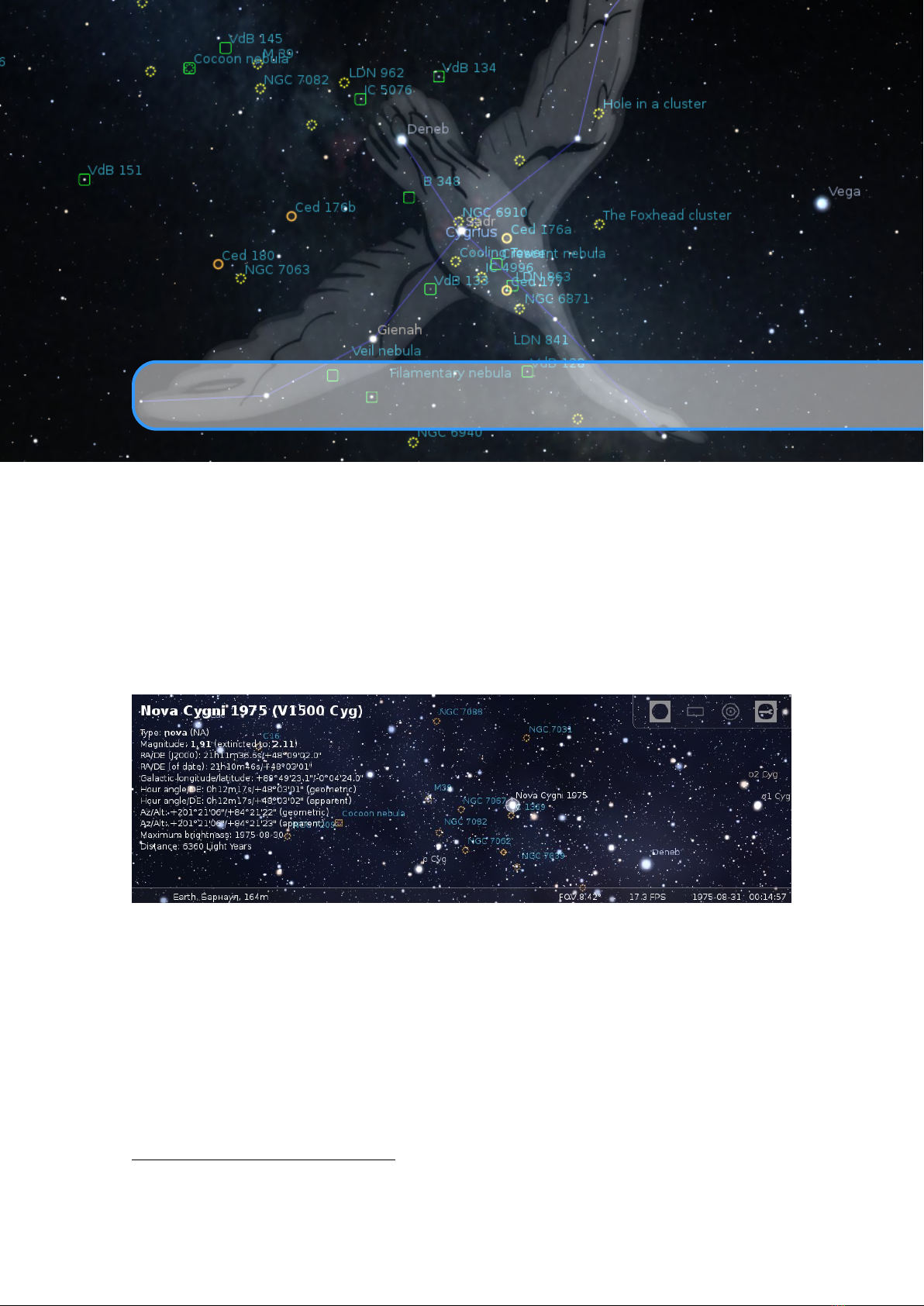
14. Object Catalog Plugins
Several plugins provide users with some more object classes.
14.1 Bright Novae Plugin
Figure 14.1: Nova Cygni 1975 (also known as V1500 Cyg)
The Bright Novae plugin provides visualization of some bright novae in the Milky Way galaxy. If
enabled (see section 12.1), bright novae from the past will be presented in the sky at the correct
times. For example, set date and time to 30 August 1975, look at the constellation Cygnus to see
Nova Cygni 1975
1
(Fig. 14.1).
14.1.1 Section
Novae
in config.ini file
You can edit
config.ini
file by yourself for changes of the settings for the Bright Novae plugin –
just make it carefully!
1
https://en.wikipedia.org/wiki/V1500_Cygni

162 Chapter 14. Object Catalog Plugins
ID Type Description
last_update string Date and time of last update
update_frequency_days int Frequency of updates, in days
updates_enable bool Enable updates of bright novae catalog from Internet
url string URL of bright novae catalog
14.1.2 Format of bright novae catalog
To add a new nova, open a new line after line 5 and paste the following, note commas and brackets,
they are important:
" Nova designation ":
{
" name " : " name of nova " ,
" type " : " type of nova " ,
" maxMagnitude ": value of maximal visual magnitude ,
" minMagnitude ": value of minimal visual magnitude ,
" peakJD ": JD for maximal visual magnitude ,
" m2 " : Time to decline by 2 mag from maximum ( in days ),
" m3 " : Time to decline by 3 mag from maximum ( in days ),
" m6 " : Time to decline by 6 mag from maximum ( in days ),
" m9 " : Time to decline by 9 mag from maximum ( in days ),
" distance ": value of distance between nova and
Earth ( in thousands of Light Years ),
" RA " : " Right ascension ( J2000 ) " ,
" Dec ": " Dec linat ion ( J2000 ) "
},
For example, the record for Nova Cygni 1975 (V1500 Cyg) looks like:
" V1500 Cyg ":
{
" name " : " Nova Cygni 1975 " ,
" type " : " NA " ,
" maxMagnitude ": 1.69 ,
" minMagnitude ": 21 ,
" peakJD ": 2442655 ,
" m2 " : 2 ,
" m3 " : 4 ,
" m6 " : 32 ,
" m9 " : 263
" distance ": 6.36 ,
" RA " : " 21 h11m36 .6 s" ,
" Dec ": " 48 d09m02s "
},
14.1.3 Light curves
This plugin uses a very simple model for calculation of light curves for novae stars. This model is
based on time for decay by
N
magnitudes from the maximum value, where
N
is 2, 3, 6 and 9. If a
nova has no values for decay of magnitude then this plugin will use generalized values for it.
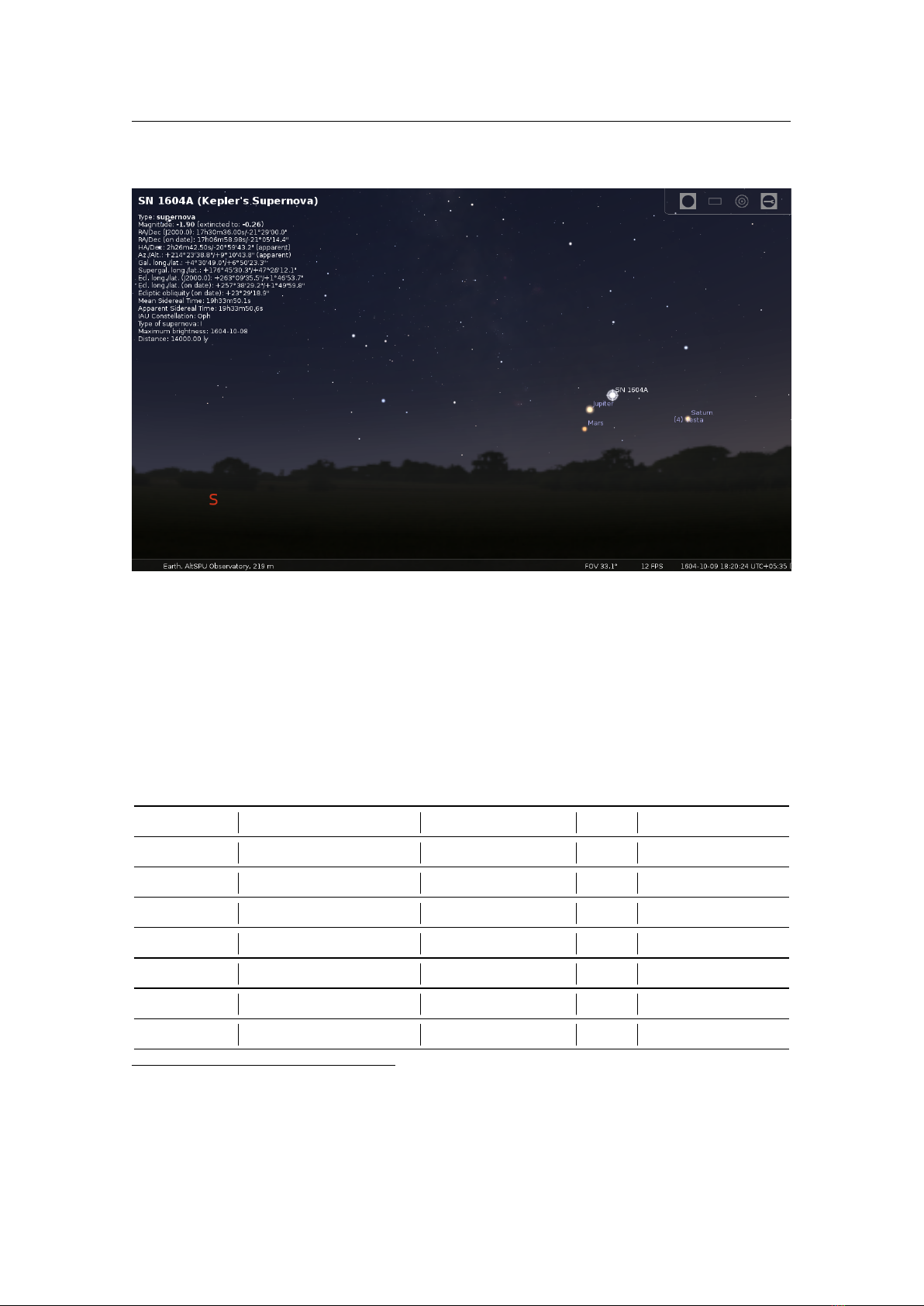
14.2 Historical Supernovae Plugin 163
14.2 Historical Supernovae Plugin
Figure 14.2: Supernova 1604 (also known as Kepler’s Supernova, Kepler’s Nova or
Kepler’s Star)
Similar to the Historical Novae plugin (section 14.1), the Historical Supernovae plugin provides
visualization of bright historical supernovae (Fig. 14.2) from the table below. If enabled (see
section 12.1), bright supernovae from the past will be presented in the sky at the correct times. For
example, set date and time to 29 April 1006, and look at the constellation Lupus to see SN 1006A.
14.2.1 List of supernovae in default catalog
Supernova Date of max. brightness Max. apparent mag. Type Name
SN 185A
2
7 December -6.0 Ia
SN 386A 24 April 1.5 II
SN 1006A
3
29 April -7.5 I
SN 1054A
4
3 July -6.0 II
SN 1181A
5
4 August -2.0 II
SN 1572A
6
5 November -4.0 I Tycho’s Supernova
SN 1604A
7
8 October -2.0 I Kepler’s Supernova
2
https://en.wikipedia.org/wiki/SN_185
3
https://en.wikipedia.org/wiki/SN_1006
4
https://en.wikipedia.org/wiki/SN_1054
5
https://en.wikipedia.org/wiki/SN_1181
6
https://en.wikipedia.org/wiki/SN_1572
7
https://en.wikipedia.org/wiki/SN_1604

164 Chapter 14. Object Catalog Plugins
SN 1680A
8
15 August 6.0 IIb Cassiopeia A
SN 1885A
9
17 August 5.8 IPec S Andromedae
SN 1895B 5 July 8.0 I
SN 1919A 14 March 11.0 I
SN 1920A 17 December 11.7 II
SN 1921C 11 December 11.0 I
SN 1937C 21 August 8.5 Ia
SN 1937D 15 September 11.87 Ia
SN 1960F 21 April 11.6 Ia
SN 1960R 19 December 12.0 I
SN 1961H 8 May 11.8 Ia
SN 1962M 26 November 11.5 II
SN 1965I 19 Juni 11.8 Ia
SN 1966J 2 December 11.3 I
SN 1968L 12 July 11.9 IIP
SN 1970G 30 July 11.4 IIL
SN 1971I 29 May 11.9 Ia
SN 1972E
10
8 May 8.4 Ia
SN 1974G 27 April 11.8 Ia
SN 1979C 15 April 11.6 IIL
SN 1980K 31 October 11.6 IIL
SN 1981B 9 March 12.0 Ia
SN 1983N 17 July 11.4 Ib
SN 1986G 12 May 11.44 Ia Pec
SN 1987A
11
24 February 2.9 IIPec
SN 1989B 6 February 11.9 Ia
SN 1991T 26 April 11.6 IaPec
SN 1993J
12
30 March 10.8 IIb
SN 1994ae 12 January 12.0 Ia
SN 1994D 31 March 11.8 Ia
SN 1998bu 21 May 11.9 Ia
SN 2004dj 31 July 11.3 IIP
SN 2004et 2 October 11.57 II
SN 2011fe
13
13 September 10.06 Ia
SN 2012cg 6 Juni 11.954 Ia
SN 2012fr 16 November 11.95 Ia
SN 2013aa 13 February 11.9 Ia
SN 2014j 30 January 10.5 Ia
8
https://en.wikipedia.org/wiki/Cassiopeia_A
9
https://en.wikipedia.org/wiki/S_Andromedae
10
https://en.wikipedia.org/wiki/SN1972e
11
https://en.wikipedia.org/wiki/SN_1987A
12
https://en.wikipedia.org/wiki/SN_1993J
13
https://en.wikipedia.org/wiki/SN_2011fe
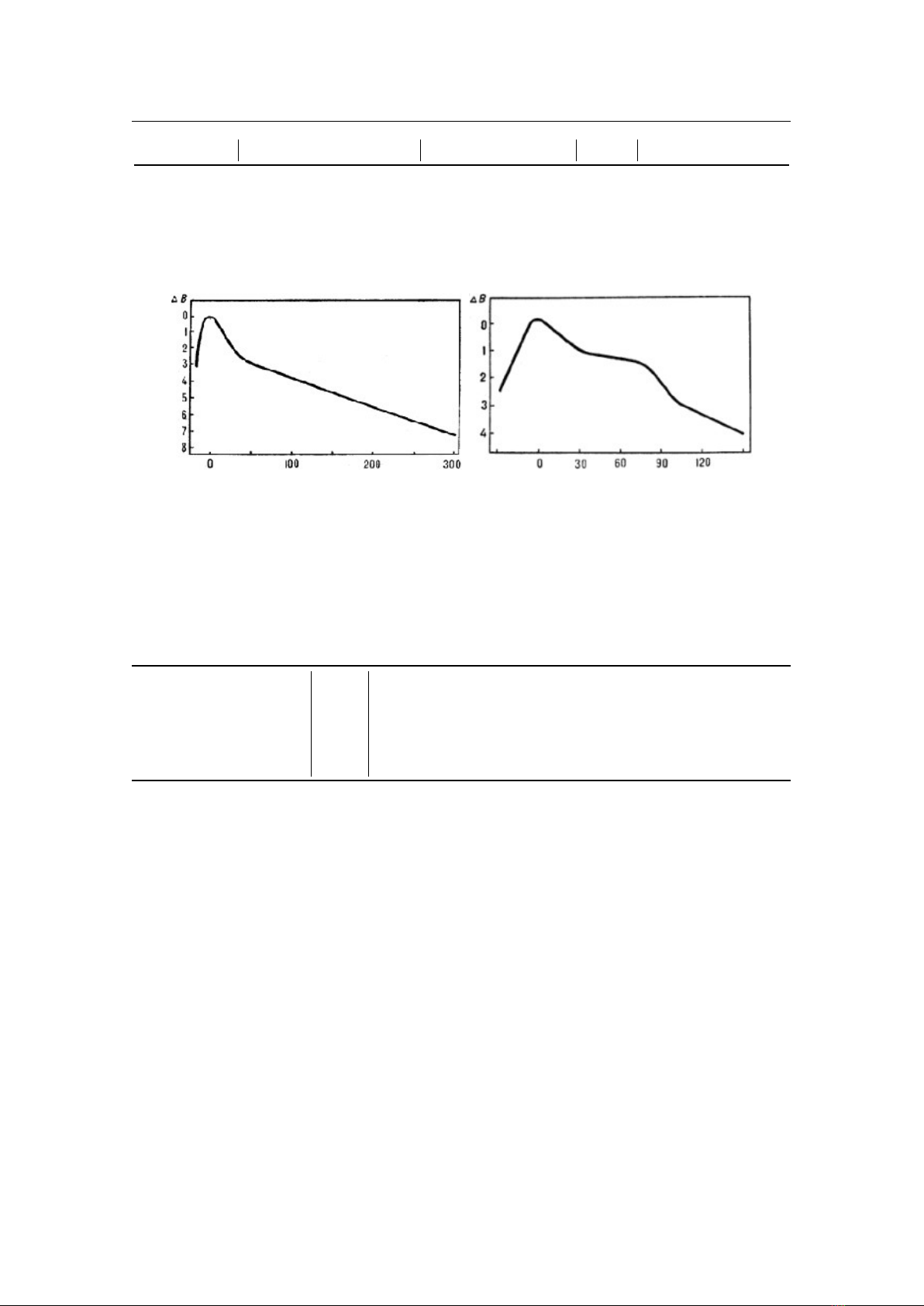
14.2 Historical Supernovae Plugin 165
SN 2017cbv 22 March 11.5 Ia
14.2.2 Light curves
In this plugin a simple model of light curves for different supernovae has been implemented
(Figure 14.3). While Type I supernovae show a peak and slow but steady decay, Type II supernovae
show a longer “plateau” in the decay curve.
Figure 14.3: Light Curves of Supernovae Types I (left) and II (right)
In both images for light curves the maximum brightness is marked as day 0.
14.2.3 Section
Supernovae
in config.ini file
You can edit
config.ini
file by yourself for changes of the settings for the Historical Supernovae
plugin – just make it carefully!
ID Type Description
last_update string Date and time of last update
update_frequency_days int Frequency of updates, in days
updates_enable bool Enable updates of bright novae catalog from Internet
url string URL of bright novae catalog

166 Chapter 14. Object Catalog Plugins
14.2.4 Format of historical supernovae catalog
To add a new nova, open a new line after line 5 and paste the following, note commas and brackets,
they are important:
" Supernova designation ":
{
" type " : " type of supernova " ,
" maxMagnitude ": value of maximal visual magnitude ,
" peakJD ": JD for maximal visual magnitude ,
" alpha " : " Right ascension ( J2000 ) " ,
" delta " : " Declination ( J2000 )",
" distance ": value of distance between supernova and
Earth ( in thousands of Light Years ),
" note " : " notes for supernova "
},
For example, the record for SN 1604A (Kepler’s Supernova) looks like:
" 1604 A ":
{
" type " : " I" ,
" maxMagnitude ": -2,
" peakJD ": 2307190 ,
" alpha " : " 17 h30m36 .00s" ,
" delta " : " -21 d29m00 .0 s" ,
" distance ": 14 ,
" note " : " Kepler ’ s Supernova "
},
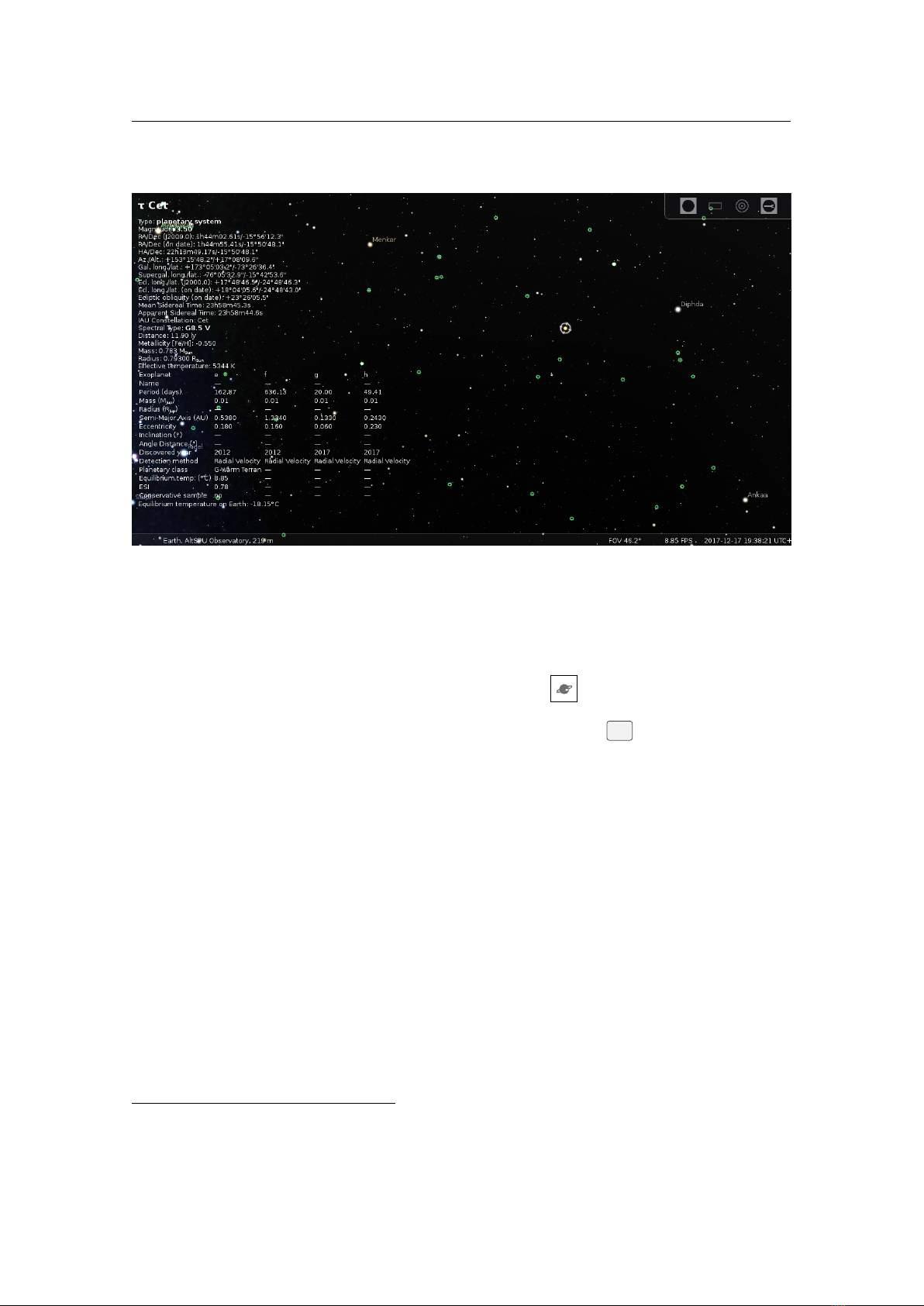
14.3 Exoplanets Plugin 167
14.3 Exoplanets Plugin
Figure 14.4: Planetary system τ Ceti
This plugin plots the position of stars with exoplanets. Exoplanets data is derived from “The
Extrasolar Planets Encyclopaedia”
14
. List of potential habitable exoplanets and data about them
were taken from “The Habitable Exoplanets Catalog”
15
by the Planetary Habitability Laboratory
16
.
If enabled (see section 12.1), just click on the Exoplanet button on the bottom toolbar to display
markers for the stars with known exoplanets. You can then either click on such a marked star or
find the stars with exoplanets by their designation (e.g., 24 Sex) in the
F3
dialog (see 4.5).
A large number of exoplanets was discovered by the Kepler space observatory mission (2009–
18) which in its primary mission observed a small field in the Cyg/Lib/Dra area. Accordingly you
will find a huge concentration of exoplanets there. This should give us a hint about how many more
must be out there. Its extended mission added many more exoplanet systems along the ecliptic.
The second tab in the plugin’s dialog shows a scatter plot relating two selectable properties. In
some cases a logarithmic axis is more useful, but if the original values can be negative only the
positive data are shown in log plots. Additional entry fields allow filtering the data range.
14.3.1 Potential habitable exoplanets
This plugin can display potential habitable exoplanets (orange marker) and some information about
those planets.
Planetary Class
Planet classification from host star spectral type (F, G, K, M; see section 19.2.4),
habitable zone (hot, warm, cold) and size (miniterran, subterran, terran, superterran, jovian,
neptunian) (Earth = G-Warm Terran).
Equilibrium Temperature
The planetary equilibrium temperature
17
is a theoretical temperature
(in
◦
C) that the planet would be at when considered simply as if it were a black body being
14
http://exoplanet.eu/
15
https://phl.upr.edu/projects/habitable-exoplanets-catalog
16
https://phl.upr.edu/home
17
https://en.wikipedia.org/wiki/Planetary_equilibrium_temperature

168 Chapter 14. Object Catalog Plugins
heated only by its parent star (assuming a 0.3 bond albedo). As example the planetary
equilibrium temperature of Earth is -18.15
◦
C (255 K).
Earth Similarity Index (ESI)
Similarity to Earth
18
on a scale from 0 to 1, with 1 being the
most Earth-like. ESI depends on the planet’s radius, density, escape velocity, and surface
temperature.
14.3.2 Proper names
In December 2015
19
and in December 2019
20
, the International Astronomical Union (IAU) has
officially approved names for several exoplanets after a public vote.
Veritate
* (14 And) – From the latin Veritas, truth. The ablative form means where there is truth
21
.
Spe * (14 And b) – From the latin Spes, hope. The ablative form means where there is hope.
Musica (18 Del) – Musica is Latin for music.
Arion
(18 Del b) – Arion was a genius of poetry and music in ancient Greece. According to
legend, his life was saved at sea by dolphins after attracting their attention by the playing of
his kithara.
Fafnir (42 Dra) – Fafnir was a Norse mythological dwarf who turned into a dragon.
Orbitar
(42 Dra b) – Orbitar is a contrived word paying homage to the space launch and orbital
operations of NASA.
Chalawan (47 UMa) – Chalawan is a mythological crocodile king from a Thai folktale.
Taphao Thong
(47 UMa b) – Taphao Thong is one of two sisters associated with the Thai folk
tale of Chalawan.
Taphao Kaew
(47 UMa c) – Taphao Kae is one of two sisters associated with the Thai folk tale of
Chalawan.
Helvetios
(51 Peg) – Helvetios is Celtic for the Helvetian and refers to the Celtic tribe that lived in
Switzerland during antiquity.
Dimidium
(51 Peg b) – Dimidium is Latin for half, referring to the planet’s mass of at least half
the mass of Jupiter.
Copernicus
(55 Cnc) – Nicolaus Copernicus or Mikolaj Kopernik (1473-1543) was a Polish
astronomer who proposed the heliocentric model of the solar system in his book “De
revolutionibus orbium coelestium”.
Galileo
(55 Cnc b) – Galileo Galilei (1564-1642) was an Italian astronomer and physicist often
called the father of observational astronomy and the father of modern physics. Using
a telescope, he discovered the four largest satellites of Jupiter, and the reported the first
telescopic observations of the phases of Venus, among other discoveries.
Brahe
(55 Cnc c) – Tycho Brahe (1546-1601) was a Danish astronomer and nobleman who
recorded accurate astronomical observations of the stars and planets. These observations
were critical to Kepler’s formulation of his three laws of planetary motion.
Lipperhey
* (55 Cnc d) – Hans Lipperhey (1570-1619) was a German-Dutch lens grinder and
spectacle maker who is often attributed with the invention of the refracting telescope in
1608
22
.
Janssen
(55 Cnc e) – Zacharias Janssen (1580s-1630s) was a Dutch spectacle maker who is often
attributed with invention of the microscope, and more controversially with the invention of
18
https://phl.upr.edu/projects/earth-similarity-index-esi
19
https://www.iau.org/news/pressreleases/detail/iau1514/
20
https://www.iau.org/news/pressreleases/detail/iau1912/
21
The original name proposed, Veritas, is that of an asteroid important for the study of the solar system.
22
The original spelling of Lippershey was corrected to Lipperhey on 15.01.2016. The commonly seen
spelling Lippershey (with an s) results in fact from a typographical error dating back from 1831, thus should
be avoided.

14.3 Exoplanets Plugin 169
the telescope.
Harriot
(55 Cnc f) – Thomas Harriot (ca. 1560-1621) was an English astronomer, mathematician,
ethnographer, and translator, who is attributed with the first drawing of the Moon through
telescopic observations.
Amateru
* (
ε
Tau b) – Amateru is a common Japanese appellation for shrines when they enshrine
Amaterasu, the Shinto goddess of the Sun, born from the left eye of the god Izanagi
23
.
Hypatia
(
ι
Dra b) – Hypatia was a famous Greek astronomer, mathematician, and philosopher. She
was head of the Neo-Platonic school at Alexandria in the early
5
th
century, until murdered
by a Christian mob in 415.
Ran
* (
ε
Eri) – Ran is the Norse goddess of the sea, who stirs up the waves and captures sailors
with her net.
AEgir
* (
ε
Eri b) – Ægir is Ran’s husband, the personified god of the ocean. Ægir and Ran both
represent the Jotuns who reign in the outer Universe; together they had nine daughters
24
.
Tadmor
* (
γ
Cep b) – Ancient Semitic name and modern Arabic name for the city of Palmyra, a
UNESCO World Heritage Site.
Dagon (α PsA b) – Dagon was a Semitic deity, often represented as half-man, half-fish.
Tonatiuh (HD 104985) – Tonatiuh was the Aztec god of the Sun.
Meztli (HD 104985 b) – Meztli was the Aztec goddess of the Moon.
Ogma
* (HD 149026) – Ogma was a deity of eloquence, writing, and great physical strength in the
Celtic mythologies of Ireland and Scotland, and may be related to the Gallo-Roman deity
Ogmios
25
.
Smertrios (HD 149026 b) – Smertrios was a Gallic deity of war.
Intercrus
(HD 81688) – Intercrus means between the legs in Latin style, referring to the star’s
position in the constellation Ursa Major.
Arkas (HD 81688 b) – Arkas was the son of Callisto (Ursa Major) in Greek mythology.
Cervantes
(
µ
Ara) – Miguel de Cervantes Saavedra (1547-1616) was a famous Spanish writer and
author of “El Ingenioso Hidalgo Don Quixote de la Mancha”.
Quijote
(
µ
Ara b) – Lead fictional character from Cervantes’s “El Ingenioso Hidalgo Don Quixote
de la Mancha”.
Dulcinea
(
µ
Ara c) — Fictional character and love interest of Don Quijote (or Quixote) in
Cervantes’s “El Ingenioso Hidalgo Don Quixote de la Mancha”.
Rocinante
(
µ
Ara d) – Fictional horse of Don Quijote in Cervantes’s “El Ingenioso Hidalgo Don
Quixote de la Mancha”.
Sancho
(
µ
Ara e) – Fictional squire of Don Quijote in Cervantes’s “El Ingenioso Hidalgo Don
Quixote de la Mancha”.
Thestias
* (
β
Gem b) – Thestias is the patronym of Leda and her sister Althaea, the daughters of
Thestius. Leda was a Greek queen, mother of Pollux and of his twin Castor, and of Helen
and Clytemnestra
26
.
Lich
(PSR B1257+12) – Lich is a fictional undead creature known for controlling other undead
creatures with magic.
Draugr (PSR B1257+12 b) – Draugr refers to undead creatures in Norse mythology.
Poltergeist
(PSR B1257+12 c) – Poltergeist is a name for supernatural beings that create physical
disturbances, from German for noisy ghost.
23
The name originally proposed, Amaterasu, is already used for an asteroid.
24
Note the typographical difference between Ægir and Aegir, the Norwegian transliteration. The same
name, with the spelling Aegir, has been attributed to one of Saturn’s satellites, discovered in 2004.
25
Ogmios is a name already attributed to an asteroid.
26
The original proposed name Leda is already attributed to an asteroid and to one of Jupiter’s satellites.
The name Althaea is also attributed to an asteroid.

170 Chapter 14. Object Catalog Plugins
Phobetor
(PSR B1257+12 d) – Phobetor is a Greek mythological deity of nightmares, the son of
Nyx, the primordial deity of night.
Titawin
(
υ
And) – Titawin (also known as Medina of Tetouan) is a settlement in northern Morocco
and UNESCO World Heritage Site. Historically it was an important point of contact between
two civilizations (Spanish and Arab) and two continents (Europe and Africa) after the
8
th
century.
Saffar
(
υ
And b) – Saffar is named for Abu al-Qasim Ahmed Ibn-Abd Allah Ibn-Omar al Ghafiqi
Ibn-al-Saffar, who taught arithmetic, geometry, and astronomy in
11
th
century Cordova in
Andalusia (modern Spain), and wrote an influential treatise on the uses of the astrolabe.
Samh
(
υ
And c) – Samh is named for Abu al-Qasim ’Asbagh ibn Muhammad ibn al-Samh al-
Mahri (or Ibn al-Samh), a noted
11
th
century astronomer and mathematician in the school of
al Majriti in Cordova (Andalusia, now modern Spain).
Majriti
(
υ
And d) – Majriti is named for Abu al-Qasim al-Qurtubi al-Majriti, a notable mathe-
matician, astronomer, scholar, and teacher in
10
th
century and early
11
th
century Andalusia
(modern Spain).
Libertas
* (
ξ
Aql) – Libertas is Latin for liberty. Liberty refers to social and political freedoms,
and a reminder that there are people deprived of liberty in the world even today. The
constellation Aquila represents an eagle – a popular symbol of liberty.
Fortitudo
* (
ξ
Aql b) – Fortitudo is Latin for fortitude. Fortitude means emotional and mental
strength in the face of adversity, as embodied by the eagle (represented by the constellation
Aquila).
Illyrian
(HD 82886) – Historians largely believe that the Albanians are descendants of the Illyrians,
a term Albanians proudly call themselves.
Arber (HD 82886 b) – Arber is the term for the inhabitants of Albania during the middle ages.
Hoggar
(HD 28678) – Hoggar is the name of the main mountain range in the Sahara Desert in
southern Algeria.
Tassili
(HD 28678 b) – Tassili is a UNESCO World Heritage Site situated in the Sahara Desert
and is renowned for its prehistoric cave art and scenic geological formations.
Arcalís
(HD 131496) – Arcalis is a famous peak in the north of Andorra, where the Sun passes
through a hole in the mountain twice a year at fixed dates. It was used as a primitive solar
calendar and reference point for shepherds and early inhabitants of Andorra.
Madriu
(HD 131496 b) – Madriu (Mare del riu in Catalan, Mother of the River in English) is the
name of a glacial valley and of the river that runs through it in the southeast of Andorra. It is
the main part of the Madriu-Perafita-Claror UNESCO World Heritage Site.
Nosaxa
(HD 48265) – Nosaxa means spring in the Moqoit language. The word comes from a
combination of nosahuec, which means renew, and ñaaxa, which means year.
Naqaya
(HD 48265 b) – Naqaya means brother-family-relative in the Moqoit language and leads
us to call all humans, indigenous or non-indigenous, brother.
Malmok
(WASP-39) – Malmok is an indigenous name given to a beach in Aruba with a narrow
sandy stretch that interrupts the limestone and rocky terrace along the coast. Its shallow clear
Caribbean waters make it a popular snorkelling spot.
Bocaprins
(WASP-39 b) – Boca Prins is a secluded beach with white dunes and iconic scenery
situated in Arikok National Park along the northeast coast of Aruba. It is named after
Plantation Prins where coconuts are cultivated.
Bubup (HD 38283) – Bubup is the Boonwurrung word for child.
Yanyan (HD 38283 b) – YanYan is the Boonwurrung word for boy.
Franz
(HAT-P-14) – Franz is a character in the movie “Sissi” embodying an emperor of Austria in
the 19
th
century. The role is played by the actor Karlheinz Böhm.
Sissi
(HAT-P-14 b) – Sissi is a character in the movie “Sissi”, who is married with Franz. The role

14.3 Exoplanets Plugin 171
is played by the actress Romy Schneider.
Mahsati
(HD 152581) – Mahsati Ganjavi (1089–1159) is one of the brightest shining stars of
Azerbaijani poetry. She was said to have associated with both Omar Khayyam and Nizami
and was well educated and talented and played numerous musical instruments.
Ganja
(HD 152581 b) – Ganja is an ancient city of Azerbaijan, and is the birth place of many
prominent people such as the poets Mahsati and Nizami. It is the ancient capital of Azerbai-
jan, the first capital of the Azerbaijan Democratic Republic and the city with the spirit of
wisdom and freedom.
Timir
(HD 148427) – Timir means darkness in Bengali language, alluding to the star being far
away in the darkness of space.
Tondra
(HD 148427 b) – Tondra means nap in Bengali language, alluding to the symbolic notion
that the planet was asleep until discovered.
Nervia (HD 49674) – Nervia, adapted from Nervii, was a prominent Belgian Celtic tribe.
Eburonia
(HD 49674 b) – Eburonia, adapted from Eburones, was a prominent Belgian Celtic
tribe.
Gakyid
(HD 73534) – Gakyid means happiness. Gross National Happiness is the development
philosophy conceived and followed in Bhutan and is one of Bhutan’s contributions to the
world.
Drukyul
(HD 73534 b) – Drukyul (land of the thunder dragon) is the native name for Bhutan, the
country that came up with the philosophy of Gross National Happiness.
Tapecue
(HD 63765) – Tapecue means eternal path in Guarani and represents the Milky Way
through which the first inhabitants of the Earth arrived and could return.
Yvaga
(HD 63765 b) – Yvaga means paradise for the Guarani and the Milky Way was known as
the road to Yvaga or paradise.
Bosona
(HD 206610) – Bosona is the name given to the territory of Bosnia in the
10
th
century.
Later, the name was transformed to Bosnia originating from the name of the Bosna river.
Naron
(HD 206610 b) – Naron is one of the names given to the Neretva river in Herzegovina
(and partly in Croatia) in antiquity originating with the Celts who called it Nera Etwa which
means the Flowing Divinity.
Tupi
(HD 23079) – Tupi is the name of the most populous Indigenous People living on the eastern
coast of South America, before the Portuguese arrived in the 16
th
century.
Guarani
(HD 23079 b) – Guarani is the name of the most populous Indigenous people living in
South Brazil and parts of Argentina, Paraguay and Uruguay.
Gumala
(HD 179949) – Gumala is a Malay word, which means a magic bezoar stone found in
snakes, dragons, etc.
Mastika
(HD 179949 b) – Mastika is a Malay word, which means a gem, precious stone, jewel or
the prettiest, the most beautiful.
Tangra (WASP-21) – Tangra is the supreme celestial god that early Bulgars worshiped.
Bendida
(WASP-21 b) – Bendida is the Great Mother Goddess of the Thracians. She was especially
revered as a goddess of marriage and living nature.
Mouhoun
(HD 30856) – Mouhoun, also called Volta Noire, is the largest river in Burkina Faso
and plays an important role in the lives of the people in the areas it passes through.
Nakanbé
(HD 30856 b) – The Nakanbé, also called Volta Blanche, is the second largest river in
Burkina Faso. Its source is in the heart of the Sahara Burkinabe and ends in Ghana.
Nikawiy
(HD 136418) – Nikawiy is the word for mother in the Indigenous Cree language of
Canada.
Awasis
(HD 136418 b) – Awasis is the word for child in the Indigenous Cree language of Canada.
Pincoya
(HD 164604) – Pincoya is a female water spirit from southern Chilean mythology who is
said to bring drowned sailors to the Caleuche so that they can live in the afterlife.

172 Chapter 14. Object Catalog Plugins
Caleuche
(HD 164604 b) – Caleuche is a large ghost ship from southern Chilean mythology which
sails the seas around the island of Chiloé at night.
Lionrock
(HD 212771) – Lion Rock is a lion-shaped peak overlooking Hong Kong and is a
cultural symbol with deep respect from the local community.
Victoriapeak
(HD 212771 b) – Victoria Peak overlooks the bustling Victoria Harbour and is
regarded as an ambassadorial gateway for foreign visitors wishing to experience Hong Kong
first hand.
Xihe
(HD 173416) – Xiheis the goddess of the sun in the Chinese mythology and also represents
the earliest astronomers and developers of calendars in ancient China.
Wangshu
(HD 173416 b) – Wangshu is the goddess who drives for the Moon and also represents
the Moon in Chinese mythology.
Formosa
(HD 100655) – Formosa is the historical name of Taiwan used in the
17
th
century,
meaning beautiful in Latin.
Sazum
(HD 100655 b) – Sazum is the traditional name of Yuchi, a Township in Nantou county,
in which the famous Sun-Moon Lake lies. Sazum means water in the language of the Thao
people who are a tribe of Taiwanese aborigines who lived in the region for hundreds of years.
Macondo
(HD 93083) – Macondo is the mythical village of the novel “One Hundred Years of
Solitude” (“Cien años de soledad”) the classic novel by Gabriel García Marquez. Macondo
is a fictional place where magic and reality are mixed.
Melquíades
(HD 93083 b) – Melquíades is a fictional character that walks around Macondo, like
a planet orbiting a star, connecting it with the external world by introducing new knowledge
using his inventions as well as his stories.
Poerava
(HD 221287) – Poerava is the word in the Cook Islands Maori language for a large
mystical black pearl of utter beauty and perfection.
Pipitea
(HD 221287 b) – Pipitea is a small, white and gold pearl found in Penrhyn lagoon in the
northern group of the Cook Islands.
Dìwö
(WASP-17) – Dìwö in Bribri language means the sun (bigger than the sun we know) and
that never turns off.
Ditsö (WASP-17 b) – Ditsö is the name that the god Sibö gave to the first Bribri people.
Stribor
(HD 75898) – Stribor is God of winds in Slavic mythology, as well as a literature character
in the book Pri
ˇ
ce iz davnine (Croatian Tales of Long Ago) by the Croatian author Ivana
Brli
´
c-Mažurani
´
c.
Veles (HD 75898 b) – Veles is a major Slavic god of earth, waters and the underworld.
Felixvarela
(BD-17 63) – Felix Varela (1788–1853) was the first to teach science in Cuba at the
San Carlos and San Ambrosio Seminary. He opened the way to education for all, and began
the experimental teaching of physics in Cuba.
Finlay
(BD-17 63 b) – Carlos Juan Finlay (1833–1915) was an epidemiologist recognized as
a pioneer in the research of yellow fever, determining that it was transmitted through
mosquitoes.
Alasia
(HD 168746) – Alasia is the first historically recorded name of Cyprus, dating back to
mid-fifteenth century BC.
Onasilos
(HD 168746 b) – Onasilos is the oldest historically recorded doctor in Cyprus, inscribed
on the fifth century BC Idalion Tablet. Also known as the Onasilou Plate, it is considered as
the oldest legal contract found in the world.
Absolutno
(XO-5) – Absolutno is a fictional miraculous substance in the sci-fi novel “Továrna na
absolutno” (“The Factory for the Absolute”) by influential Czech writer Karel
ˇ
Capek.
Makropulos
(XO-5 b) – Makropulos is the name from Karel
ˇ
Capek’s play V
ˇ
ec Makropulos (The
Makropulos Affair), dealing with problems of immortality and consequences of an artificial
prolongation of life.

14.3 Exoplanets Plugin 173
Muspelheim
(HAT-P-29) – Muspelheim is the Norse mythological realm of fire. The first gods
used the sparks of Muspelheim to form the sun, moon, planets, and stars.
Surt
(HAT-P-29 b) – Surt is the ruler of Muspelheim and the fire giants there in Norse mythology.
At Ragnarok, the end of the world, he will lead the attack on our world and destroy it in
flames.
Márohu
(WASP-6) – Márohu the god of drought is the protector of the Sun and is engraved at a
higher position on the stalagmite than Boinayel in the El Puente cave, where the Sun makes
its way down every 21 December.
Boinayel
(WASP-6 b) – Boinayel the god of rain that fertilizes the soil is engraved on the stalagmite
at a lower position than Márohu in the El Puente cave.
Nenque
(HD 6434) – Nenque means the Sun in the language spoken by the Indigenous Waorani
tribes of the Amazon regions of Ecuador
Eyeke
(HD 6434 b) – Eyeke means near in the language spoken by the Indigenous Waorani tribes
of the Amazon regions of Ecuador. This word is suggested for the exoplanet owing to the
proximity of the planet to the host star.
Citalá (HD 52265) – Citalá means River of stars in the native Nahuat language.
Cayahuanca
(HD 52265 b) – Cayahuanca means The rock looking at the stars in the native Nahuat
language.
Koit (XO-4) – Koit is Estonian for the time when the Sun rises in the morning (dawn).
Hämarik
(XO-4 b) – Hämarik is Estonian for the time when the Sun goes down in the evening
(twilight).
Buna (HD 16175) – Buna is the commonly used word for coffee in Ethiopia.
Abol
(HD 16175 b) – Abol is the first of three rounds of coffee in the Ethiopian traditional coffee
ceremony.
Horna (HAT-P-38) – Horna is hell or the underworld from Finnic mythology.
Hiisi
(HAT-P-38 b) – Hiisi represents sacred localities and later evil spirits from Finnic mythology.
Bélénos
(HD 8574) – Bélénos was the god of light, of the Sun, and of health in Gaulish mythology.
Bélisama
(HD 8574 b) – Bélisama was the goddess of fire, notably of the hearth and of metallurgy
and glasswork, in Gaulish mythology.
Itonda (HD 208487) – Itonda, in the Myene tongue, corresponds to all that is beautiful.
Mintome
(HD 208487 b) – Mintome, in the Fang tongue, is a mythical land where a brotherhood
of brave men live.
Mago
(HD 32518) – Mago is a National Park in Ethiopia noted for its giraffes. The star also
happens to be in the constellation of Camelopardis (the giraffe).
Neri (HD 32518 b) – The Neri river in Ethiopia runs through parts of the Mago National park.
Sika
(HD 181720) – Sika means gold in the Ewe language and gold is one of Ghana’s principal
exports.
Toge (HD 181720 b) – Toge means earring in the Ewe language.
Lerna
(HAT-P-42) – Lerna was the name of a lake in the eastern Peloponnese, where the Lernaean
Hydra, an immortal mythical nine-headed beast lived. The star lies in the constellation of
Hydra.
Iolaus
(HAT-P-42 b) – Iolaus was the nephew of Heracles from Greek mythology, moving around
lake Lerna in helping Heracles to exterminate the Lernaean Hydra. Similarly this exoplanet
in the constellation of Hydra moves around its parent star.
Tojil (WASP-22) – Tojil is the name of one of the Mayan deities related to rain, storms, and fire.
Koyopa’
(WASP-22 b) – Koyopa’ is the word associated with lightning in K’iche’ (Quiché) Mayan
language.
Citadelle
(HD 1502) – The Citadelle is a large mountaintop fortress in Nord, Haiti built after
Haiti’s independence, and was designated a UNESCO World Heritage site along with the

174 Chapter 14. Object Catalog Plugins
nearby Sans-Souci Palace.
Indépendance
(HD 1502 b) – Indépendance is named after the Haitian Declaration of Indepen-
dence on 1 January 1804, when Haiti became the first independent black republic.
Hunahpú
(HD 98219) – Hunahpú was one of the twin gods who became the Sun in K’iche’
(Quiché) Mayan mythology as recounted in the Popol Vuh.
Ixbalanqué
(HD 98219 b) – Ixbalanqué was one of the twin gods who became the Moon in K’iche’
(Quiché) Mayan mythology as recounted in the Popol Vuh.
Hunor
(HAT-P-2) – Hunor was a legendary ancestor of the Huns and the Hungarian nation, and
brother of Magor.
Magor
(HAT-P-2 b) – Magor was a legendary ancestor of the Magyar people and the Hungarian
nation, and brother of Hunor.
Funi (HD 109246) – Funi is an old Icelandic word meaning fire or blaze.
Fold (HD 109246 b) – Fold is an old Icelandic word meaning earth or soil.
Bibh
¯
a
(HD 86081) – Bibh
¯
a is the Bengali pronunciation of the Sanskrit word Vibha, which means
a bright beam of light.
Santamasa
(HD 86081 b) – Santamasa in Sanskrit means clouded, which alludes to the exoplanet’s
atmosphere.
Dofida (HD 117618) – Dofida means our star in Nias language.
Noifasui
(HD 117618 b) – Noifasui means revolve around in Nias language, derived from the
word ifasui, meaning to revolve around, and no, indicating that the action occurred in the
past and continued to the present time.
Kaveh
(HD 175541) – Kaveh is one of the heroes of Shahnameh, the epic poem composed by
Persian poet Ferdowsi between 977 and 1010 CE. Kaveh is a blacksmith who symbolises
justice.
Kavian
(HD 175541 b) – Kaveh carries a banner called Derafsh Kaviani (Derafsh: banner, Kaviani:
relating to Kaveh).
Uruk
(HD 231701) – Uruk was an ancient city of the Sumer and Babylonian civilizations in
Mesopotamia situated along an ancient channel of the Euphrates river in modern-day Iraq.
Babylonia
(HD 231701 b) – Babylonia was a key kingdom in ancient Mesopotamia from the
18
th
to 6
th
centuries BC whose name-giving capital city was built on the Euphrates river.
Tuiren
(HAT-P-36) – Tuiren was the aunt of the hunterwarrior Fionn mac Cumhaill of Irish legend,
who was turned into a hound by the jealous fairy Uchtdealbh.
Bran
(HAT-P-36 b) – Tuiren’s son Bran was a hound and cousin of the hunterwarrior Fionn mac
Cumhaill of Irish legend.
Tevel
(HAT-P-9) – Tevel means Universe or everything and begins with the letter Taf, the last letter
in the Hebrew alphabet.
Alef (HAT-P-9 b) – Alef is the first letter in the Hebrew alphabet and also means bull.
Flegetonte
(HD 102195) – Flegetonte is the underworld river of fire from Greek Mythology in the
Italian narrative poem on the afterlife “Divina Commedia” (“Divine Commedy”) by Dante
Alighieri, chosen as an allusion to the star’s fiery nature.
Lete
(HD 102195 b) – Lete is the oblivion river made of fog from Greek Mythology in the Italian
narrative poem on the afterlife “Divina Commedia” (“Divine Commedy”) by Dante Alighieri,
chosen as an allusion to the planet’s gaseous nature.
Nyamien (WASP-15) – Nyamien refers to the supreme creator deity of Akan mythology.
Asye (WASP-15 b) – Asye refers to the Earth goddess of Akan mythology.
Kamui
(HD 145457) – Kamui is a word in the Ainu language denoting a supernatural entity
possessing spiritual energy.
Chura
(HD 145457 b) – Chura is a word in the Ryukyuan/Okinawan language meaning natural
beauty.

14.3 Exoplanets Plugin 175
Petra
(WASP-80) – Petra is a historical and archaeological city in southern Jordan and a UNESCO
World Heritage site.
Wadirum
(WASP-80 b) – Wadi Rum (Valley of the Moon) is located at the far south of Jordan,
it is the largest valley in Jordan, set on the high plateau at the western edge of the Arabian
Desert.
Kalausi
(HD 83443) – The word Kalausi means a very strong whirling column of wind in the
Dholuo language of Kenya.
Buru
(HD 83443 b) – Buru means dust in the Dholuo language of Kenya and is typically associated
with wind storms.
Liesma
(HD 118203) – Liesma means flame, and it is the name of a character from the Latvian
poem Staburags un Liesma.
Staburags
(HD 118203 b) – Staburags is the name of a character from the Latvian poem Staburags
un Liesma, and denotes a rock with symbolic meaning in literature and history.
Phoenicia
(HD 192263) – Phoenicia was an ancient thalassocratic civilisation of the Mediterranean
that originated from the area of modern-day Lebanon.
Beirut
(HD 192263 b) – Beirut is one of the oldest continuously inhabited cities in the world and
was a Phoenician port. Beirut is now the capital and largest city of Lebanon.
Pipoltr
(TrES-3) – In the local dialect of Triesenberg, Pipoltr is a bright and visible butterfly,
alluding to the properties of a star.
Umbäässa
(TrES-3 b) – In the local dialect of southern Liechtenstein, Umbäässa is a small and
barely visible ant, alluding to the properties of a planet with respect to its star.
Taika (HAT-P-40) – Taika means peace in the Lithuanian language.
Vytis (HAT-P-40 b) – Vytis is the symbol of the Lithuanian coat of arms.
Lucilinburhuc
(HD 45350) – The Lucilinburhuc fortress was built in 963 by the founder of
Luxembourg, Count Siegfried.
Peitruss
(HD 45350 b) – Peitruss is derived from the name of the Luxembourg river Pétrusse, with
the river’s bend around Lucilinburhuc fortress alluding to the orbit of the planet around its
star.
Rapeto (HD 153950) – Rapeto is a giant creature from Malagasy tales.
Trimobe (HD 153950 b) – Trimobe is a rich ogre from Malagasy tales.
Intan
(HD 20868) – Intan means diamond in the Malay language (Bahasa Melayu), alluding to
the shining of a star.
Baiduri
(HD 20868 b) – Baiduri means opal in Malay language (Bahasa Melayu), alluding to the
mysterious beauty of the planet.
Sansuna
(HAT-P-34) – Sansuna is the name of the mythological giant from traditional Maltese
folk tales that carried the stones of the Gozo megalithic temples on her head.
˙
Ggantija
(HAT-P-34 b) –
˙
Ggantija means giantess: the megalithic temple complex on the island
of Gozo, which alludes to the grandeur of this gas giant exoplanet.
Diya
(WASP-72) – Diya is an oil lamp that is brought by Indian ancestors to Mauritius in the
1820’s, and is used for lighting during special occasions, including the light festival of
Diwali.
Cuptor
(WASP-72 b) – Cuptor is a thermally insulated chamber used for baking or drying sub-
stances, that has long disappeared in Mauritius and has been replaced by more sophisticated
ovens.
Axólotl
(HD 224693) – Axólotl means water animal in the native Nahuatl language, which is a
unique and culturally significant endemic amphibious species from the basin of Mexico.
Xólotl
(HD 224693 b) – Xólotl means animal in the native Nahuatl language and was an Aztec
deity associated with the evening star (Venus).
Tislit
(WASP-161) – Tislit is the name of a lake in the Atlas mountains of Morocco. It means the

176 Chapter 14. Object Catalog Plugins
bride in the Amazigh language and it is associated with a heartbroken beautiful girl in an
ancient local legend.
Isli
(WASP-161 b) – Isli is the name of a lake in the Atlas mountains of Morocco. It means the
groom in the Amazigh language and it is associated with a heartbroken handsome boy in an
ancient local legend.
Emiw
(HD 7199) – Emiw represents love in the local Makhuwa language of the northern region
of Mozambique.
Hairu
(HD 7199 b) – Hairu represents unity in the local Makhuwa language of the northern region
of Mozambique.
Ayeyarwady (HD 18742) – Ayeyarwady is the largest and most important river in Myanmar.
Bagan
(HD 18742 b) – Bagan is one of Myanmar’s ancient cities that lies beside the Ayeyarwardy
river.
Sagarmatha
(HD 100777) – Sagarmatha is the Nepali name for the highest peak in the world
(also known as Mount Everest) and symbol of national pride of Nepal.
Laligurans
(HD 100777 b) – Laligurans are the Nepali variation of the rhododendron flower and
is the national flower of Nepal.
Sterrennacht
(HAT-P-6) – The Sterrennacht (Starry Night) is a world-famous painting by Dutch
grand master Van Gogh that was painted in France in 1889 and now belongs to the permanent
collection of New York’s Museum of Modern Art.
Nachtwacht
(HAT-P-6 b) – The Nachtwacht (Night Watch) is a world-famous painting by Dutch
grand master Rembrandt that was completed in 1642 and now belongs to the collection of
the Rijksmuseum in Amsterdam.
Karaka
(HD 137388) – Karaka is the word in the M
¯
aori language for a plant endemic to New
Zealand that produces a bright orange, fleshy fruit.
Kerer
¯
u
(HD 137388 b) – Kerer
¯
u is the word in the M
¯
aori language for a large bush pigeon native
to New Zealand.
Cocibolca
(HD 4208) – Cocibolca is the Nahualt name for the largest lake in Central America in
Nicaragua.
Xolotlan
(HD 4208 b) – Xolotlan is the name of the second largest lake of Nicaragua and its
name is from the Nahualt language of the indigenous tribe that settled in Nicaragua, which
symbolises a native god and a refuge for animals.
Amadioha
(HD 43197) – Amadioha is the god of thunder in Igbo mythology. As well as repre-
senting justice, Amadioha is also a god of love, peace and unity.
Equiano
(HD 43197 b) – Equiano was a writer and abolitionist from Ihiala, Nigeria who fought
injustice and the elimination of the slave trade.
Násti (HD 68988) – Násti means star in the Northern Sami language of Norway.
Albmi (HD 68988 b) – Albmi means sky in the Northern Sami language of Norway.
Shama
(HAT-P-23) – Shama is an Urdu literary term meaning a small lamp or flame, symbolic of
the light of the star.
Perwana
(HAT-P-23 b) – Perwana means moth in Urdu, alluding to the eternal love of an object
circling the source of light (the lamp).
Moriah
(HD 99109) – Moriah is an ancient name for the mountain within the Old City of
Jerusalem.
Jebus
(HD 99109 b) – Jebus was the ancient name of Jerusalem in
2
nd
millennium BC when
populated by the Canaanite tribe of Jebusites.
Montuno
(WASP-79) – Montuno is the traditional costume the man wears in the “El Punto”, a
Panamanian dance in which a man and woman dance to the sound of drums.
Pollera
(WASP-79 b) – Pollera is the traditional costume the woman wears in the El Punto, a
Panamanian dance in which a man and woman dance to the sound of drums.

14.3 Exoplanets Plugin 177
Tupã
(HD 108147) – Tupã is one of four principle gods of the Guarani Cosmogony in popular
Paraguayan folklore that helped the supreme god Ñamandu to create the Universe.
Tumearandu
(HD 108147 b) – Tume Arandu is a son of Rupavê and Sypavê, the original man
and woman of the Universe, who is known as the Father of Wisdom in popular Paraguayan
folklore.
Inquill
(HD 156411) – Inquil was one half of the couple involved in the tragic love story Way to
the Sun by famous Peruvian writer Abraham Valdelomar.
Sumajmajta
(HD 156411 b) – Sumaj Majta was one half of the couple involved in a tragic love
story Way to the Sun by famous Peruvian writer Abraham Valdelomar.
Amansinaya
(WASP-34) – Aman Sinaya is one of the two trinity deities of the Philippine’s
Tagalog mythology, and is the primordial deity of the ocean and protector of fisherman.
Haik
(WASP-34 b) – Haik is the successor of the primordial Aman Sinaya as the God of the Sea
of the Philippine’s Tagalog mythology.
Uklun
(HD 102117) – Uklun means us or we in the Pitkern language of the people of Pitcairn
Islands.
Leklsullun
(HD 102117 b) – Lekl Sullun means child or children in the Pitkern language of the
people of Pitcairn Islands.
Solaris
(BD+14 4559) – Solaris is the title of a 1961 science fiction novel about an ocean-covered
exoplanet by Polish writer Stanislaw Lem.
Pirx
(BD+14 4559 b) – Pirx is a fictional character from books by Polish science-fiction writer
Stanislaw Lem.
Lusitânia
(HD 45652) – Lusitânia is the ancient name of the western region of the Iberic Peninsula
where the Lusitanian people lived and where most of modern-day Portugal is situated.
Viriato (HD 45652 b) – Viriato was a legendary leader of the Lusitanian people, a herdsman and
hunter who led the resistance against Roman invaders during 2
nd
century B.C.
Koeia
(HIP 12961) – Koeia was the word for star in the language of the Taíno Indigenous People
of the Caribbean.
Aumatex
(HIP 12961 b) – Aumatex was the God of Wind in the mythology of the Taíno Indigenous
People of the Caribbean.
Moldoveanu
(XO-1) – Moldoveanu is the highest peak in Romania of the F
˘
ag
˘
ara
s
,
mountain range
with an altitude of 2544 metres.
Negoiu
(XO-1 b) – Negoiu is the second highest peak in Romania of the F
˘
ag
˘
ara
s
,
mountain range
with an altitude of 2535 metres.
Dombay
(HAT-P-3) – Dombay is a resort region in the North Caucasus mountains that is enclosed
by mountain forests and rich wildlife, including bears (as this star lies in the constellation
Ursa Major, the great bear).
Teberda
(HAT-P-3 b) – Teberda is a mountain river in Dombay region with a rapid water flow,
symbolising the planet’s rapid motion around its host star.
Belel (HD 181342) – Belel is a rare source of water in the north of Senegal.
Dopere
(HD 181342 b) – Dopere is an expansive historical area in the north of Senegal where
Belel was located.
Morava (WASP-60) – Morava is the longest river system in Serbia.
Vlasina
(WASP-60 b) – Vlasina is one of the most significant tributaries of the South Morava
river.
Parumleo
(WASP-32) – Parumleo is a Latin term for little lion, symbolising Singapore’s struggle
for independence.
Viculus
(WASP-32 b) – Viculus is a Latin term for little village, embodying the spirit of the
Singaporean people.
Chaso
ˇ
n (HAT-P-5) – Chaso
ˇ
n is an ancient Slovak term for Sun.

178 Chapter 14. Object Catalog Plugins
Král’omoc (HAT-P-5 b) – Král’omoc is an ancient Slovak term for the planet Jupiter.
Irena
(WASP-38) – Irena is a leading character in the novel “Under the Free Sun: a Story of the
Ancient Grandfathers” by Slovene writer Fran Saleški Finžgar. Irena is a woman of the
court.
Iztok
(WASP-38 b) – Iztok is a leading character in the novel “Under the Free Sun: a Story of the
Ancient Grandfathers” by Slovene writer Fran Saleški Finžgar. Iztok is a freedom fighter for
the Slavic people.
Naledi
(WASP-62) – Naledi means star in the Sesotho, SeTswana and SePedi languages and is
typically given as a name to girls in the hope that they will bring light, joy and peace to their
communities.
Krotoa
(WASP-62 b) – Krotoa is considered the Mother of Africa and member of the indigenous
Khoi people, who was a community builder and educator during colonial times.
Baekdu
(8 Umi) – Baekdu is the highest mountain on the Korean peninsula, situated in North
Korea, and symbolises the national spirit of Korea.
Halla
(8 Umi b) – Halla is the highest mountain in South Korea and is regarded as a sacred place
in the region.
Rosalíadecastro
(HD 149143) – Rosalía de Castro was a significant figure of Galician culture and
prominent Spanish writer, whose pioneeting work often referenced the night and celestial
objects.
Riosar
(HD 149143 b) – Rio Sar is the name of a river that was present in much of the literary
work of the pioneering Spanish author Rosalía de Castro.
S
¯
amaya (HD 205739) – S
¯
amaya means peace in the Sinhalese language.
Samagiya (HD 205739 b) – Samagiya means togetherness and unity in the Sinhalese language.
Aniara
(HD 102956) – Aniara is the name of a spaceship in the epic poem Aniara by Swedish
author Harry Martinson.
Isagel (HD 102956 b) – Isagel is the name of the spaceship pilot in the epic science fiction poem
Aniara written by Swedish author Harry Martinson.
Mönch
(HD 130322) – Mönch is one of the prominent peaks of the Bernese Alps in Switzerland.
Eiger
(HD 130322 b) – Eiger is one of the prominent peaks of the Bernese Alps, in the Jungfrau-
Aletsch protected area.
Ebla
(HD 218566) – Ebla was one of the earliest kingdoms in Syria, and served as a prominent
region in the 2
nd
and 3
rd
millennia B.C.
Ugarit
(HD 218566 b) – Ugarit was a city where its scribes devised the Ugaritic alphabet around
1400 B.C. The alphabet was made up of thirty letters and was inscribed on clay tablets.
Mpingo
(WASP-71) – Mpingo is a famous tree that grows in southern Tanzania and produces
ebony wood used for musical instruments and curios.
Tanzanite
(WASP-71 b) – Tanzanite is the name of a precious stone mined in Tanzania and is
treasured worldwide.
Chaophraya (WASP-50) – Chao Phraya is the great river of Thailand.
Maeping
(WASP-50 b) – Mae Ping is one of the tributaries of Thailand’s great river Chao Phraya.
Atakoraka
(WASP-64) – Atakoraka means the chain of the Atacora: the largest mountain range
in Togo.
Agouto
(WASP-64 b) – Agouto (Mount Agou) is the highest mountain in Togo and a treasured
region of the Atakoraka.
Dingolay
(HD 96063) – Dingolay means to dance, twist and turn in elaborate movements, sym-
bolising the culture and language of the ancestors of the people of Trinidad and Tobago.
Ramajay
(HD 96063 b) – Ramajay means to sing and make music in a steelpan style, representing
the love of culture and languages of the ancestors of the people of Trinidad and Tobago.
Chechia
(HD 192699) – Chechia is a flat-surfaced, traditional red wool hat worn by men and

14.3 Exoplanets Plugin 179
women, symbolising the country’s rich traditions and is considered as the national headdress
for in Tunisia.
Khomsa
(HD 192699 b) – Khomsa is a palm-shaped amulet that is popular in Tunisia, used in
jewelry and decorations. It depicts an open right hand and is often found in modern designs.
Anadolu
(WASP-52) – Anadolu is the primary homeland of Turkey and refers to the motherland
in Turkish culture.
Göktürk
(WASP-52 b) – Göktürk refers to the historical origin of the Turkish people, as it was the
first established state in Turkey in
5
th
century AD. It is also the name of a Turkish satellite
and is the combination of two words, of which “Gök” means sky.
Berehinya
(HAT-P-15) – Berehinya was a Slavic deity of waters and riverbanks but in more
recent times her status has been promoted to that of a national goddess — “hearth mother,
protectress of the earth”.
Tryzub
(HAT-P-15 b) – Tryzub is the most recognised ancient symbol of Ukraine, that was minted
on the coins of Prince Volodymyr the Great and today remains one of the country’s state
symbols (a small coat).
Sharjah
(HIP 79431) – Sharjah is the cultural capital of United Arab Emirates, and considered the
city of knowledge due to its many educational centers, institutes, museums, libraries and
heritage centers.
Barajeel
(HIP 79431 b) – A barajeel is a wind tower used to direct the flow of the wind so that air
can be recirculated as a form of air conditioning.
Gloas (WASP-13) – In Manx Gaelic, Gloas means to shine (like a star).
Cruinlagh
(WASP-13 b) – In Manx Gaelic, Cruinlagh means to orbit (like a planet around its
star).
Nushagak
(HD 17156) – Nushagak is a regional river near Dilingham, Alaska, which is famous
for its wild salmon that sustain local Indigenous communities.
Mulchatna
(HD 17156 b) – The Mulchatna River is a tributary of the Nushagak River in south-
western Alaska, USA.
Ceibo
(HD 63454) – Ceibo is the name of the native tree of Uruguay that gives rise to the national
flower.
Ibirapitá
(HD 63454 b) – Ibirapitá is the name of a native tree that is characteristic of the country
of Uruguay, and is also known as Artigas’ tree, after the national hero.
Natasha (HD 85390) – Natasha means thank you in many languages of Zambia.
Madalitso
(HD 85390 b) – Madalitso means blessings in the native language of Nyanja in Zambia.
All names with asterix mark (*) are modified based on the original proposals, to be consistent
with the IAU rules.
14.3.3 Section
Exoplanets
in config.ini file
You can edit
config.ini
file by yourself for changes of the settings for the Exoplanets plugin –
just make it carefully!
ID Type Description
last_update string Date and time of last update
update_frequency_hours int Frequency of updates, in hours
updates_enable bool
Enable updates of exoplanets catalog from Inter-
net
url string URL of exoplanets catalog
flag_show_exoplanets_button bool
Enable showing button of exoplanets on bottom
bar
distribution_enabled bool Enable distribution mode of display
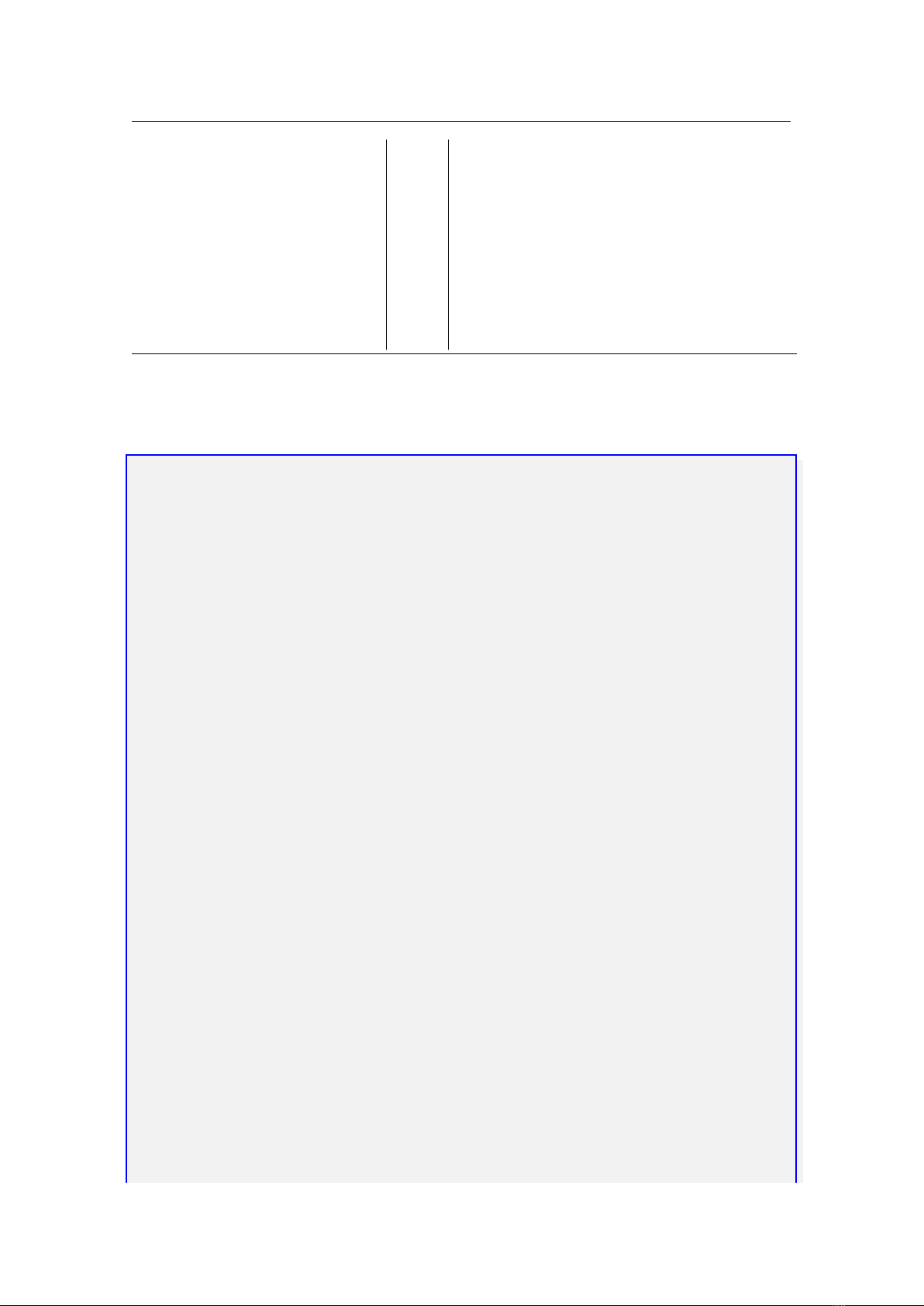
180 Chapter 14. Object Catalog Plugins
timeline_enabled bool Enable timeline mode of display
habitable_enabled bool Enable habitable mode of display
enable_at_startup bool
Enable displaying exoplanets at startup of the plu-
gin
exoplanet_marker_color R,G,B Color for marker of star with planetary system
habitable_exoplanet_marker_color R,G,B
Color for marker of star with planetary system
with potential habitable exoplanets
temperature_scale string
Temperature scale for equilibrium temperature
of exoplanets. Possible values: Kelvin, Celsius,
Fahrenheit. Default value: Celsius.
14.3.4 Format of exoplanets catalog
To add a new exoplanet system, open a new line after line 5 and paste the following, note commas
and brackets, they are important:
" Star design ation " :
{
" exopl anets ":
[
{
" mass ": mass of exopl anet (M jup ),
" radius " : radius of ex oplanet (R jup ) ,
" period " : period of ex oplanet ( days ),
" s emiAxis ": semi - major axis ( AU ) ,
" eccentric ity " : orbit ’s eccentricity ,
" inclina tion ": orbit ’s incl ination ( degree ),
" angleDistan ce " : angle d istance from star
( arcse conds ),
" disco vered ": exop lanet discove red year ,
" de tectionMethod " : " ex oplanet detection method " ,
" pclass " : " planetary class " ,
" EqTemp " : e quilibr ium te mperatu re ( K) ,
" conservat ive " : co nservat iv e or optimistic
ha bitabil it y of the exoplanet ,
" ESI " : Earth S imilarity Index (*100) ,
" pl an et ProperName ": " proper name of planet " ,
" plane tName ": " design ation of planet "
},
{
" mass ": mass of exopl anet (M jup ),
" radius " : radius of ex oplanet (R jup ) ,
" period " : period of ex oplanet ( days ),
" s emiAxis ": semi - major axis ( AU ) ,
" eccentric ity " : orbit ’s eccentricity ,
" inclina tion ": orbit ’s incl ination ( degree ),
" angleDistan ce " : angle d istance from star
( arcse conds ),
" disco vered ": exop lanet discove red year ,
" de tectionMethod " : " ex oplanet detection method " ,
" pclass " : " planetary class " ,
" EqTemp " : e quilibr ium te mperatu re ( K) ,
" conservat ive " : co nservat iv e or optimistic
ha bitabil it y of the exoplanet ,
" ESI " : Earth S imilarity Index (*100) ,

14.3 Exoplanets Plugin 181
" pl an et ProperName ": " proper name of planet " ,
" plane tName ": " design ation of planet "
}
],
" d istance ": value of dist ance to star ( pc ),
" stype " : " sp ectral type of star " ,
" smass " : value of mass of star (M sun),
" smetal " : value of m etallic ity of star ,
" Vmag ": value of visual magnitude of star ,
" sradius " : value of radius of star (R sun ) ,
" effectiveTe mp " : value of ef fective t emperat ure
of star (K ),
" starProperNam e ": " proper name of the star " ,
" hasHP " : boolean ( has potential habitable plan ets ) ,
" RA " : " Right asce nsion ( J2000 ) " ,
" DE " : " Declin ation ( J2000 )"
},
For example, the record for 24 Sex looks like:
" 24 Sex ":
{
" exopl anets ":
[
{
" mass ": 1.99 ,
" period " : 452.8 ,
" s emiAxis ": 1.333 ,
" eccentric ity " : 0.09 ,
" angleDistan ce " : 0.017821 ,
" disco vered ": 2010 ,
" plane tName ": " b"
},
{
" mass ": 0.86 ,
" period " : 883.0 ,
" s emiAxis ": 2.08 ,
" eccentric ity " : 0.29 ,
" angleDistan ce " : 0.027807 ,
" disco vered ": 2010 ,
" plane tName ": " c"
}
],
" d istance ": 74.8 ,
" stype " : "G5 " ,
" smass " : 1.54 ,
" smetal " : -0.03 ,
" Vmag ": 7.38 ,
" sradius " : 4.9 ,
" effectiveTe mp " : 5098 ,
" RA " : "10 h23m28s " ,
" DE " : " -00 d54m08s "
},
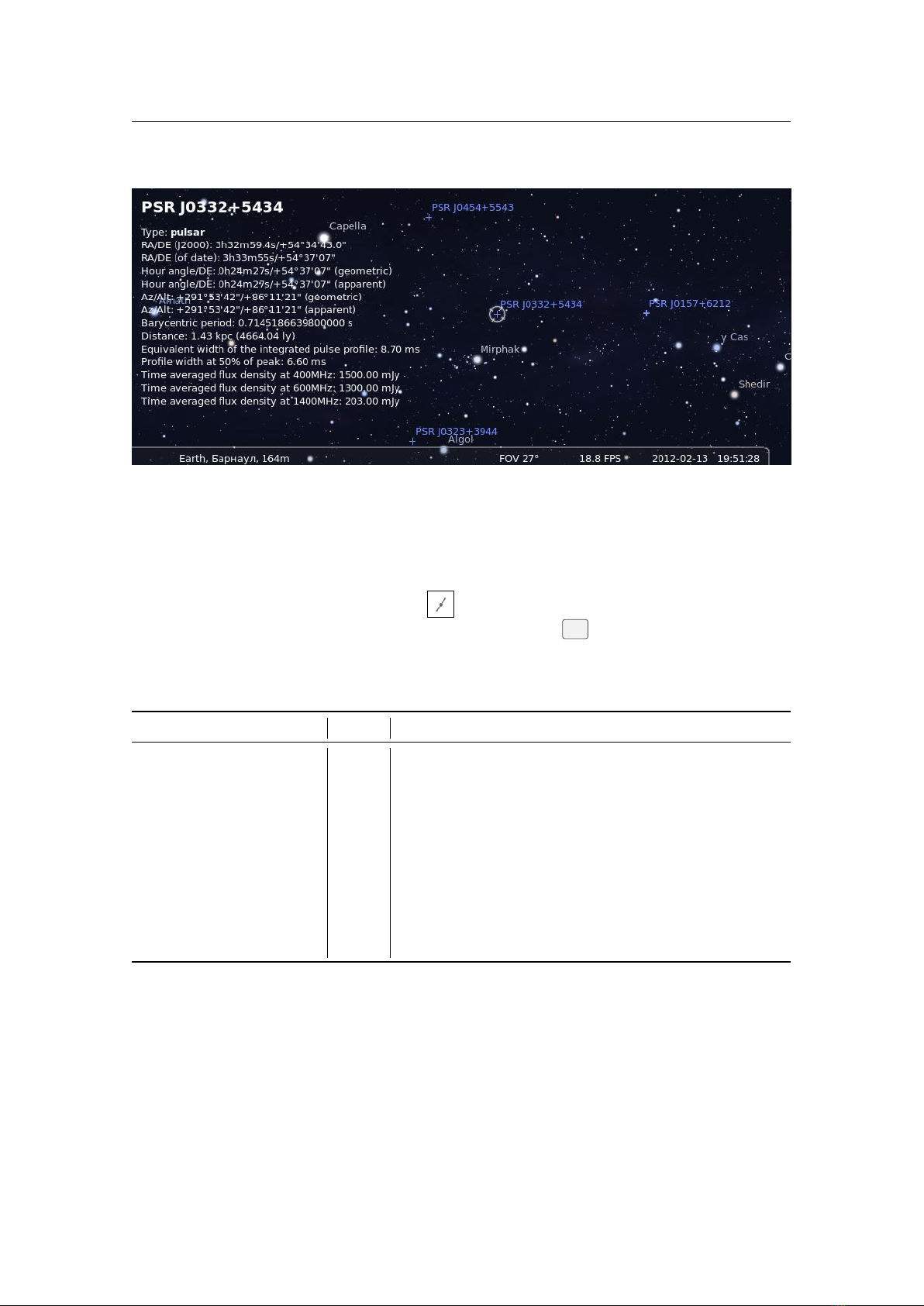
182 Chapter 14. Object Catalog Plugins
14.4 Pulsars Plugin
Figure 14.5: PSR J0332+5434
This plugin plots the position of various pulsars, with object information about each one. Pulsar
data is derived from “The Australia Telescope National Facility Pulsar Catalogue” (Manchester
et al., 2005).
If enabled (see section 12.1), use the button to activate display of pulsars. The GUI
allows a few configuration options. You can also find a pulsar (
F3
) by its designation (e.g., PSR
J0437-4715).
14.4.1 Section
Pulsars
in config.ini file
ID Type Description
last_update string Date and time of last update
update_frequency_days int Frequency of updates [days]
updates_enable bool Enable updates of pulsars catalog from Internet
url string URL of pulsars catalog
enable_at_startup bool Enable displaying of pulsars at startup of Stellarium
distribution_enabled bool Enable distribution mode for the pulsars
flag_show_pulsars_button bool Enable displaying pulsars button on toolbar
marker_color R,G,B Color for marker of the pulsars
glitch_color R,G,B Color for marker of the pulsars with glitches
use_separate_colors bool Use separate colors for different types of the pulsars

14.4 Pulsars Plugin 183
14.4.2 Format of pulsars catalog
To add a new pulsar, open a new line after line 5 and paste the following, note commas and brackets,
they are important:
" Pulsar des ignat ion " :
{
" RA " : " Right ascension ( J2000 ) " ,
" DE " : " Declination ( J2000 )",
" notes " : " type of pulsar " ,
" distance ": value of distance based on electron density
model ( kpc ),
" period ": value of b aryce ntric period of the pulsar (s),
" parallax ": value of annual parallax ( mas),
" bperiod ": value of binary period of pulsar ( days ) ,
" pderi vativ e ": value of time d erivative of barcyc entric
period ,
" dmeasure ": value of dispersion measure ( pc /( cm * cm * cm )) ,
" frequency ": value of barycentric rotation frequency ( Hz ),
" pfrequency " : value of time derivative of baryc entri c
rotation frequency (1/( s*s))
" eccentricity ": value of eccentricity ,
" w50 ": value of profile width at 50% of peak ( ms ) ,
" s400 " : value of time averaged flux density at
400 MHz ( mJy ),
" s600 " : value of time averaged flux density at
600 MHz ( mJy ),
" s1400 " : value of time averaged flux density at
1400 MHz ( mJy )
},
For example, the record for PSR J0014+4746 looks like:
" PSR J0014 +4746 ":
{
" distance ": 1.82 ,
" dmeasure ": 30.85 ,
" frequency ": 0.805997239145 ,
" pfrequency " : -3.6669 E -16 ,
" w50 ": 88.7 ,
" s400 " : 14 ,
" s600 " : 9 ,
" s1400 " : 3 ,
" RA " : " 00 h14m17 .75s",
" DE " : " 47 d46m33 .4 s"
},
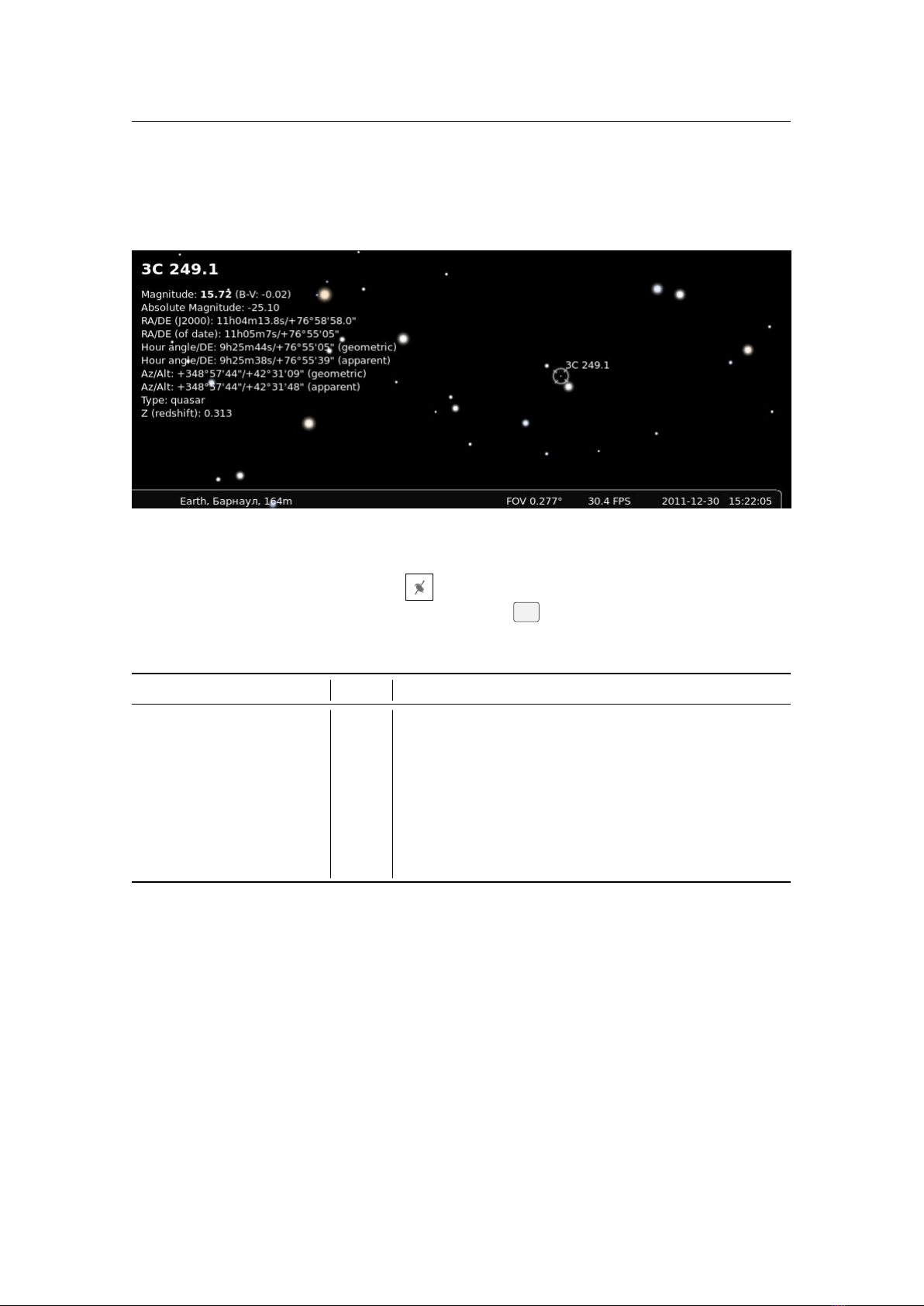
184 Chapter 14. Object Catalog Plugins
14.5 Quasars Plugin
The Quasars plugin provides visualization of some quasars brighter than 16 visual magnitude. The
catalogue of quasars has been compiled from “A catalogue of quasars and active nuclei: 13th
edition” (Véron-Cetty and Véron, 2010).
Figure 14.6: 3C 249.1, also known as LEDA 2821945 or 4C 77.09
If enabled (see section 12.1), use the button to activate display of quasars. The GUI allows
a few configuration options. You can also find a quasar (
F3
) by its designation (e.g., 3C 273).
14.5.1 Section
Quasars
in config.ini file
ID Type Description
last_update string Date and time of last update
update_frequency_days int Frequency of updates, in days
updates_enable bool Enable updates of quasars catalog from Internet
url string URL of quasars catalog
enable_at_startup bool Enable displaying of quasars at startup of Stellarium
distribution_enabled bool Enable distribution mode for the quasars
flag_show_quasars_button bool Enable displaying quasars button on toolbar
marker_color R,G,B Color for marker of the quasars

14.5 Quasars Plugin 185
14.5.2 Format of quasars catalog
To add a new quasar, open a new line after line 5 and paste the following, note commas and brackets,
they are important:
" Quasar des ignat ion " :
{
" RA " : " Right ascension ( J2000 ) " ,
" DE " : " Declination ( J2000 )",
" Amag " : value of absolute magnitude ,
" Vmag " : value of visual magnitude ,
"z": value of Z ( redshift ),
" bV " : value of B - V colour
},
For example, the record for 3C 249.1 looks like:
"3C 249.1 ":
{
" RA " : " 11 h04m13 .8 s" ,
" DE " : " +76 d58m58s " ,
" Amag " : -25.1 ,
" Vmag " : 15.72 ,
"z": 0.313 ,
" bV " : -0.02
},
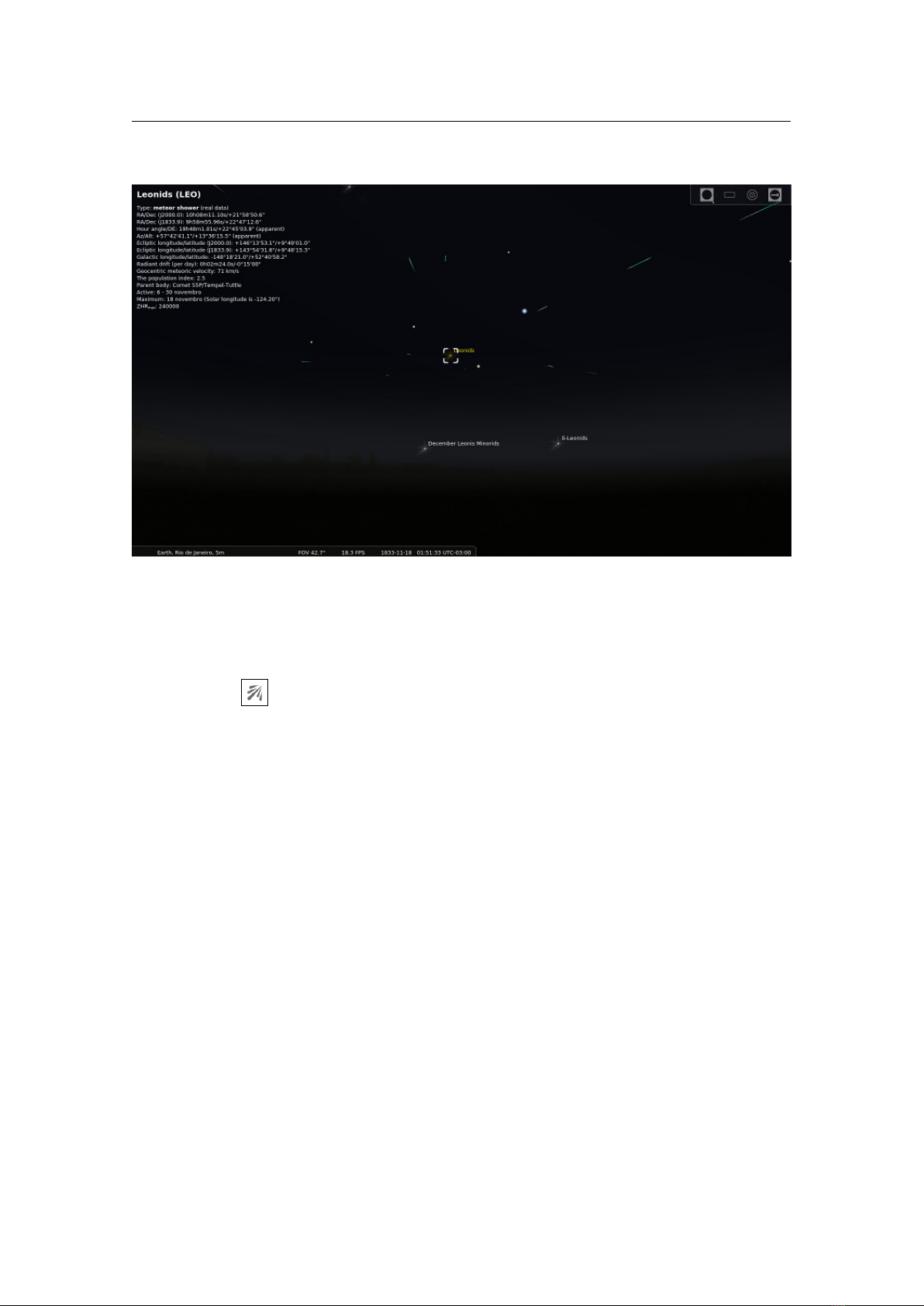
186 Chapter 14. Object Catalog Plugins
14.6 Meteor Showers Plugin
Figure 14.7: The 1833 Leonids replayed with the Meteor Showers plugin.
In contrast and extension of the random shooting stars feature of Stellarium (see section 19.6),
this plugin provides data for real meteor showers and a marker for each active and inactive radiant,
showing real information about its activity. If enabled (see section 12.1), just click on the Meteor
Showers button on the bottom toolbar to display markers for the radiants.
14.6.1 Terms
Meteor shower
A meteor shower is a celestial event in which a number of meteors are observed to radiate, or
originate, from one point in the night sky. These meteors are caused by streams of cosmic debris
called meteoroids entering Earth’s atmosphere at extremely high speeds on parallel trajectories.
Most meteors are smaller than a grain of sand, so almost all of them disintegrate and never hit
the Earth’s surface. Intense or unusual meteor showers are known as meteor outbursts and meteor
storms, which may produce greater than 1,000 meteors an hour.
Radiant
The radiant or apparent radiant of a meteor shower is the point in the sky from which (to a planetary
observer) meteors appear to originate. The Perseids, for example, are meteors which appear to
come from a point within the constellation of Perseus.
An observer might see such a meteor anywhere in the sky but the direction of motion, when
traced back, will point to the radiant. A meteor that does not point back to the known radiant for a
given shower is known as a sporadic and is not considered part of that shower.
Many showers have a radiant point that changes position during the interval when it appears.
For example, the radiant point for the Delta Aurigids drifts by more than a degree per night.
Zenithal Hourly Rate (ZHR)
The Zenithal Hourly Rate (ZHR) of a meteor shower is the number of meteors a single observer
would see in one hour under a clear, dark sky (limiting apparent magnitude of 6.5) if the radiant

14.6 Meteor Showers Plugin 187
of the shower were at the zenith. The rate that can effectively be seen is nearly always lower and
decreases the closer the radiant is to the horizon.
Population index
The population index indicates the magnitude distribution of the meteor showers. Values below
2.5 correspond to distributions where bright meteors are more frequent than average, while values
above 3.0 mean that the share of faint meteors is larger than usual.
Solar longitude
The solar longitude (equinox J2000) gives the position of the Earth on its orbit. It is a more
appropriate information on a meteor shower than the date.
14.6.2 Section
MeteorShowers
in config.ini file
You can edit
config.ini
file by yourself for changes of the settings for the Meteor Showers
plugin – just make it carefully!
ID Type Description
last_update string Date and time of last update
update_frequency_hours int Frequency of updates, in hours
updates_enable bool
Enable updates of the meteor showers catalog from Internet
url string URL of the meteor showers catalog
flag_show_ms_button bool
Enable showing button of the meteor showers on bottom
bar
flag_show_radiants bool
Enable displaying markers for the radiants of the meteor
showers
flag_active_radiants bool
Flag for displaying markers for the radiants of the active
meteor showers only
enable_at_startup bool Enable displaying meteor showers at startup plugin
show_radiants_labels bool
Flag for displaying labels near markers of the radiants of
the meteor showers
font_size int
Font size for label of markers of the radiants of the meteor
showers
colorARG R,G,B
Color for marker of active meteor showers with generic
data
colorARR R,G,B Color for marker of active meteor showers with real data
colorIR R,G,B Color for marker of inactive meteor showers
14.6.3 Format of Meteor Showers catalog
To add a new meteor shower, you just need to:
1. Copy the code of some valid meteor shower;
2. Paste it in the line 6 (right after the “showers”: {) of the MeteorShowers.json document;
3. Replace the information according with your needs.
Note commas and brackets, they are very important!
" Three - letter code ":
{
" designa tion ": " Name " ,
" IAUNo " : "IAU shower number " ,
" a ctivity ":
[
{

188 Chapter 14. Object Catalog Plugins
" year ": " generic " ,
" zhr " : Maxi mum ZHR ( -1 if variable ) ,
" v ariable ": " Minimum - maximum ( if variable ) " ,
" start " : Solar longit ude at start ,
" finish " : Solar longitude at finish ,
" peak ": Solar longitude at peak ,
" d isttype ": Type of d is tributi on function
(0= Gauss , 1= Lorentz ),
" b1 " : Slope of di st ributio n function
before peak ,
" b2 " : Slope of di st ributio n function
after peak
}
],
" speed " : Geoce ntric speed ( km / s),
" radiantAl pha " : Right Ascension ( J2000 ) ( degree ) ,
" radiantDe lta " : Declina tion ( J2000 ) ( degree ),
" drift Alpha ": Radiant drift in Right Ascension ,
" drift Delta ": Radiant drift in Declination ,
" colors " :
[
{
" color " : " white " ,
" intensity " : 70
},
{
" color " : " blueGre en " ,
" intensity " : 30
}
],
" parentObj " : " Parent object " ,
" pidx ": popu latio n index
},
For example, below is a record for Northern Taurids:
" NTA " :
{
" designa tion ": " No rthern Taurids " ,
" IAUNo " : "17 " ,
" a ctivity ":
[
{
" year ": " generic " ,
" zhr " : 5,
" start " : 206 ,
" finish " : 258 ,
" peak ": 230
}
],
" speed " : 29 ,
" radiantAl pha " : 58 ,
" radiantDe lta " : 22 ,
" drift Alpha ": 1.03 ,
" drift Delta ": 0.26 ,
" colors " :

14.6 Meteor Showers Plugin 189
[
{
" color " : " yellow " ,
" intensity " : 80
},
{
" color " : " white " ,
" intensity " : 20
}
],
" parentObj " : " Comet 2P/ Encke " ,
" pidx ": 2.3
},
14.6.4 Notes
•
This plugin uses two models (P. Jenniskens, 1994) and (Peter Jenniskens et al., 1998)
to calculate ZHR, assuming that the activity profile of meteor shower follows a double
exponential shape.
•
To predict the local hourly rate, altitude of radiant and limiting magnitude of the sky are
taken into account. Moonlight can also reduce the hourly rate, but is not taken into account.
•
Most of the numerical data for past meteor outbursts (Leonids, etc.) come from (P. Jenniskens,
2006). There is a wide range of reported values for the maximum ZHR for the 1833 and 1966
Leonids (P. Brown, 1999). We decided to use a maximum number of 150,000 to demonstrate
meteor outbursts with very high rate.
14.6.5 Further Information
You can get more info about meteor showers here:
•
Wikipedia about Meteor showers:
https://en.wikipedia.org/wiki/Meteor_Showers
• International Meteor Organization: https://www.imo.net/
• IAU Meteor Data Center: https://www.ta3.sk/IAUC22DB/MDC2007/
Acknowledgements
This plugin was initially created as project of ESA Summer of Code in Space 2013
27
.
27
http://sophia.estec.esa.int/socis2013/?q=about
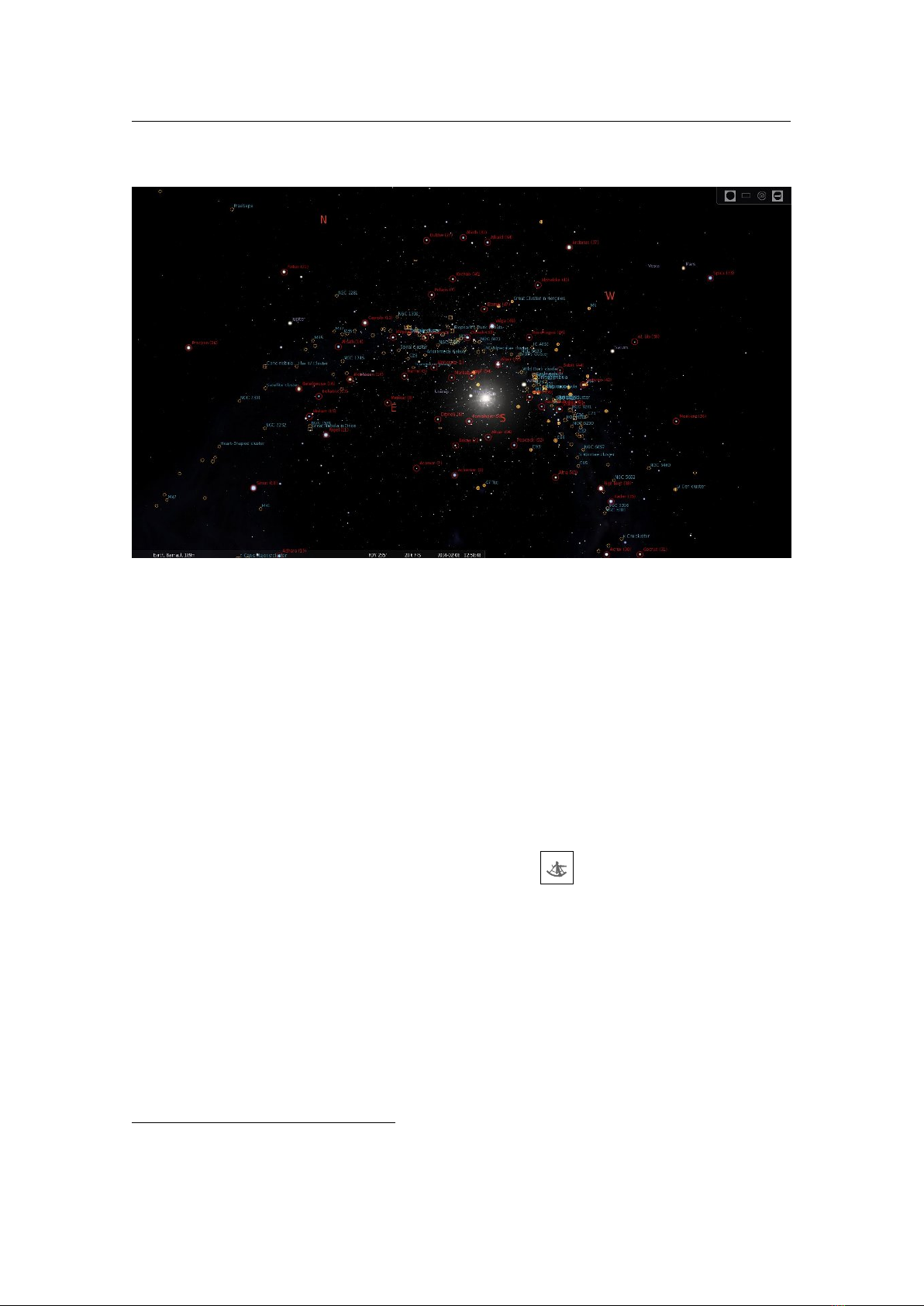
190 Chapter 14. Object Catalog Plugins
14.7 Navigational Stars Plugin
Figure 14.8: Navigational stars on the screen
This plugin marks navigational stars from a selected set (Figure 14.9):
Anglo-American
— the 57 “selected stars” that are listed in The Nautical Almanac
28
jointly
published by Her Majesty’s Nautical Almanac Office and the US Naval Observatory since
1958; consequently, these stars are also used in navigational aids such as the 2102-D Star
Finder
29
and Identifier.
French
— the 81 stars that are listed in the Ephémérides Nautiques published by the French Bureau
des Longitudes.
Russian — the 160 stars that are listed in the Russian Nautical Almanac.
German
— the 80 stars that are listed in the German Nautical Almanac (The original German title
is Nautisches Jahrbuch) published by the Federal Maritime and Hydrographic Agency of
Germany.
If enabled (see section 12.1), just click on the Sextant button on the bottom toolbar to display
markers for the navigational stars. This can help you in training your skills in astronomical
navigation before you cruise the ocean in the traditional way, with your sextant and chronometer.
In the second tab (“Today”, see Figure 14.10) in the plugin’s dialog (right-click the button) you
can see times of sunrise and sunset, twilights, moonrise and moonset.
Civil Twilight
occurs when the zenith angle of the center of the Sun is less than
96
◦
(
6
◦
below
the horizon) and the available skylight is still typically sufficient for most civilian outdoor
activities. The apparent horizon is still clearly visible against the glowing sky and only the
brightest stars are beginning to show.
Nautical Twilight
occurs when the zenith angle of the center of the Sun is less than
102
◦
(
12
◦
below the horizon) and the available skylight is no longer sufficient for detailed outdoor
activities. However, the outline of the apparent horizon, as well as most large topographical
28
The Nautical Almanac website – https://aa.usno.navy.mil/publications/docs/na.php
29
Rude Starfinder 2102-D description and usage instruction –
https://oceannavigation.blogspot
.com/2008/12/rude-starfinder-2102-d.html
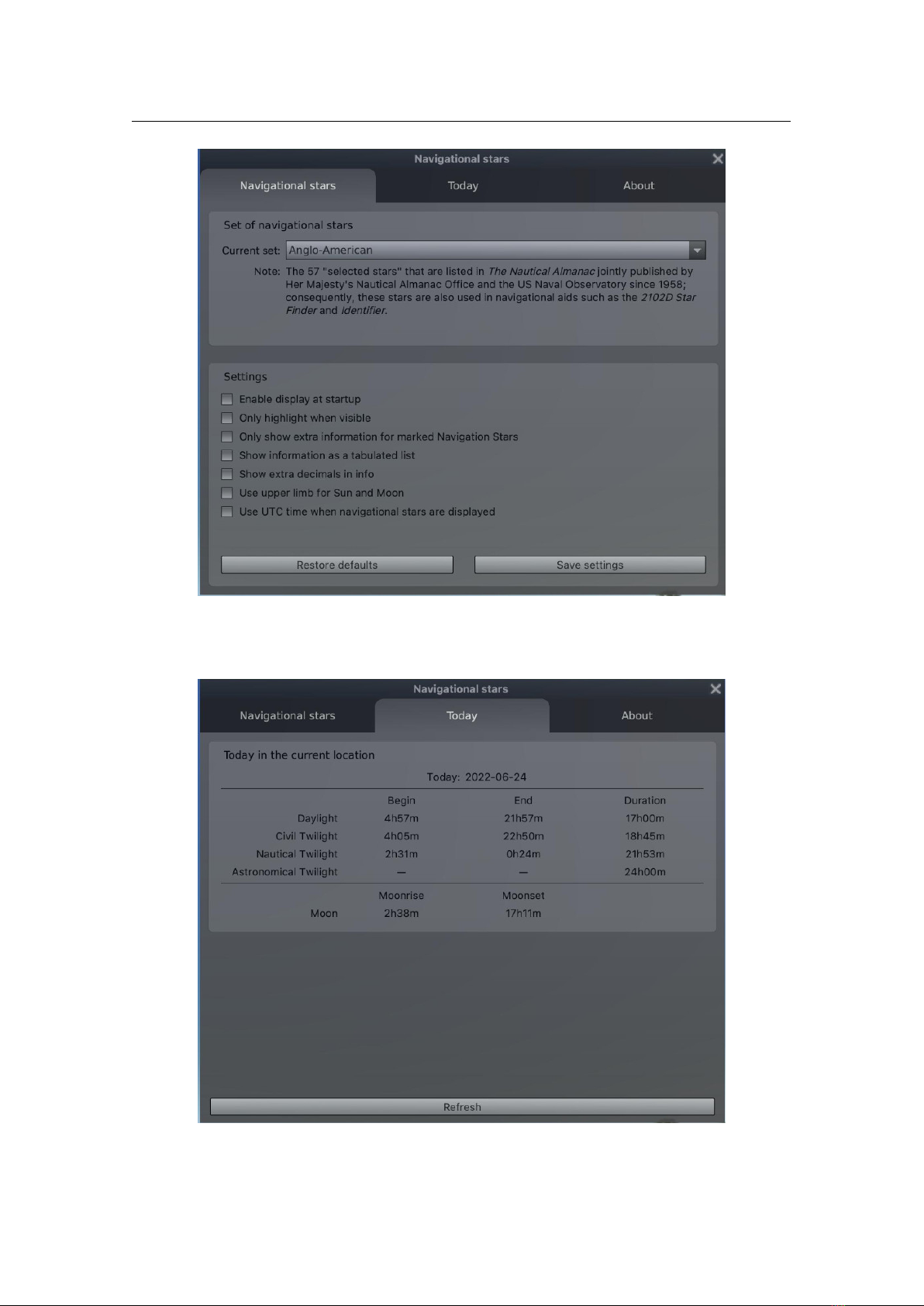
14.7 Navigational Stars Plugin 191
Figure 14.9: Settings of the Navigational stars plugin
Figure 14.10: Today tab in the Navigational stars plugin

192 Chapter 14. Object Catalog Plugins
features, are still distinguishable and the key stars used for navigational purposes have all
typically become visible.
Astronomical Twilight
occurs when the zenith angle of the center of the Sun is less than
108
◦
(
18
◦
below the horizon) and the available skylight is effectively imperceptible compared to
moonlight and starlight. Beyond this angle there is no longer any discernible atmospheric
scattering of sunlight, so the time after astronomical twilight is basically night.
14.7.1 Section
NavigationalStars
in config.ini file
You can edit
config.ini
file by yourself for changes of the settings for the Navigational Stars
plugin – just make it carefully!
ID Type Description
navstars_color R,G,B Color of markers of navigational stars
enable_at_startup bool
Set to true to display navigational stars at startup of plane-
tarium
use_utc_time bool
Set to true to use UTC time when navigational stars are
displayed
extra_decimals bool Set to true to show extra decimals in info
upper_limb bool Set to true to use upper limb for Sun and Moon
tabulated_display bool Set to true to show information as a tabulated list
limit_info_to_nav_stars bool
Set to true to show extra information only for marked Navi-
gation Stars
highlight_when_visible bool Set to true to highlight only visible stars
current_ns_set string
Current set of navigational stars. Possible values: An-
gloAmerican, French, Russian and German.
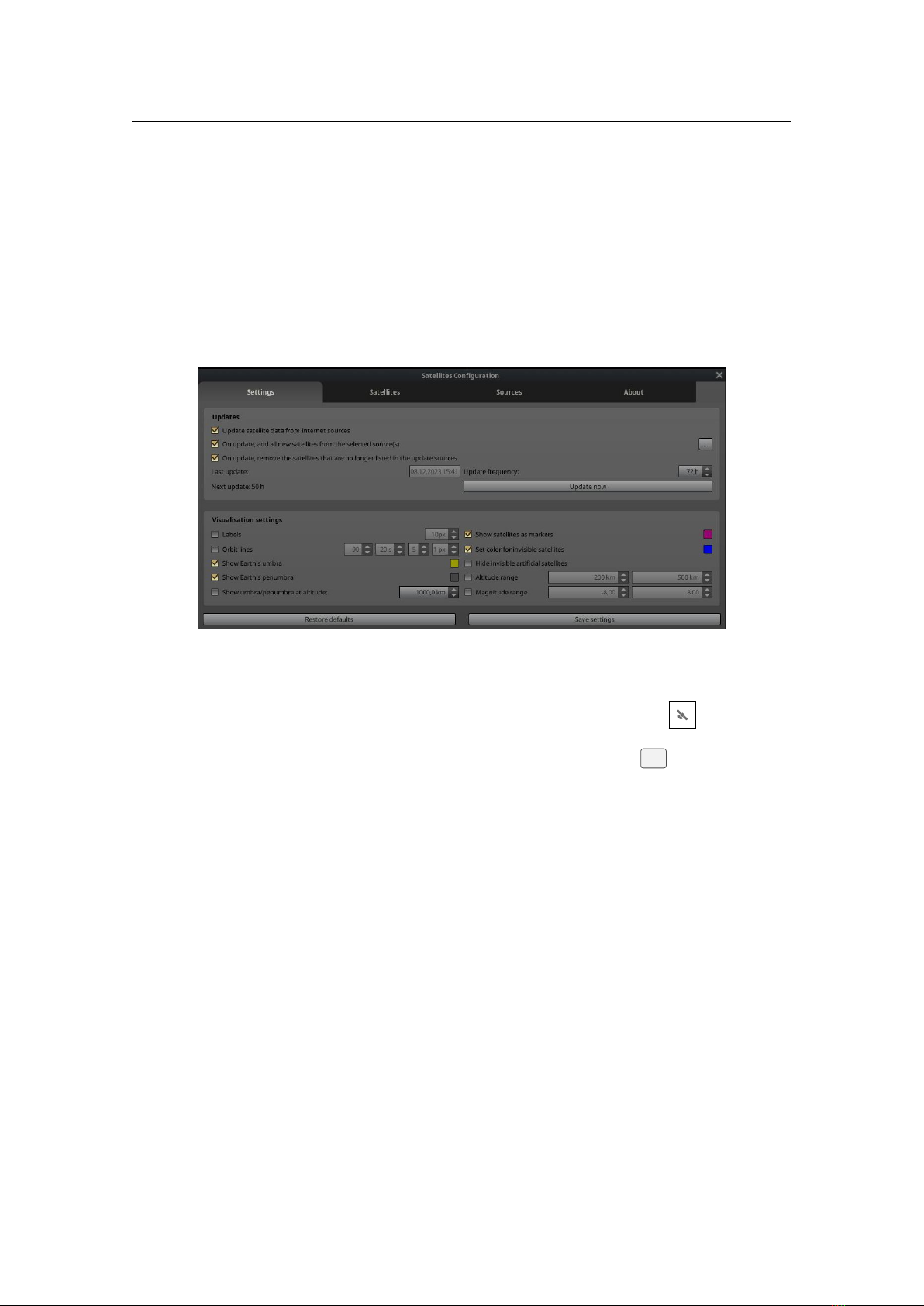
14.8 Satellites Plugin 193
14.8 Satellites Plugin
The Satellites plugin displays the positions of artificial satellites in Earth’s orbit based on a catalog
of orbital data. It allows automatic updates from online sources and manages a list of update file
URLs.
To calculate satellite positions, the plugin uses an implementation of the SGP4/SDP4 algorithms
(J.L. Canales’ gsat library), using as its input data in NORAD’s two-line element set (TLE
30
)
format. Lists with TLEs for hundreds of satellites are available online and are regularly updated.
The plugin downloads the lists prepared by
https://celestrak.org
to keep itself up-to-date,
but the users can specify other sources online or load updates from local files.
Figure 14.11: Configuration of the Satellites plugin
If the plugin has been enabled (see section 12.1), just click on the Satellite button on the bottom
toolbar to display markers for the satellites, or use right click to call the GUI.
You can search for artificial satellites using the regular search dialog (
F3
). Note that at any
given time, most Satellites will be below the horizon.
Satellites can be either shown as white dots of appropriate brightness similar to moving stars
(just like they appear to the naked eye), or as satellite-shaped markers (icons). Especially this latter
view shows the huge number of satellites in orbit, most of which are invisible to the unaided eye.
You can display circles representing the Earth’s shadow (penumbra and umbra, defined just
like for Lunar eclipses, see section 19.11.2), at the altitude of the currently selected satellite, or at a
fixed (configurable) altitude from Earth’s surface.
14.8.1 Satellite Properties
Name
Each satellite has a name. It’s displayed as a label of the satellite hint and in the list of
satellites. Names are not unique though, so they are used only for presentation purposes.
Catalog number
In the Satellite Catalog satellites are uniquely identified by their NORAD
number, which is encoded in TLEs.
I.D. (The International Designator)
In the Satellite Catalog satellites are also uniquely identified
by their International Designator also known as COSPAR ID, which is encoded in TLEs.
Standard magnitude
The standard magnitude may be an estimate based on the mean cross-
sectional area derived from its dimensions, or it may be a mean value derived from visual
30
TLE: https://en.wikipedia.org/wiki/Two-line_element_set
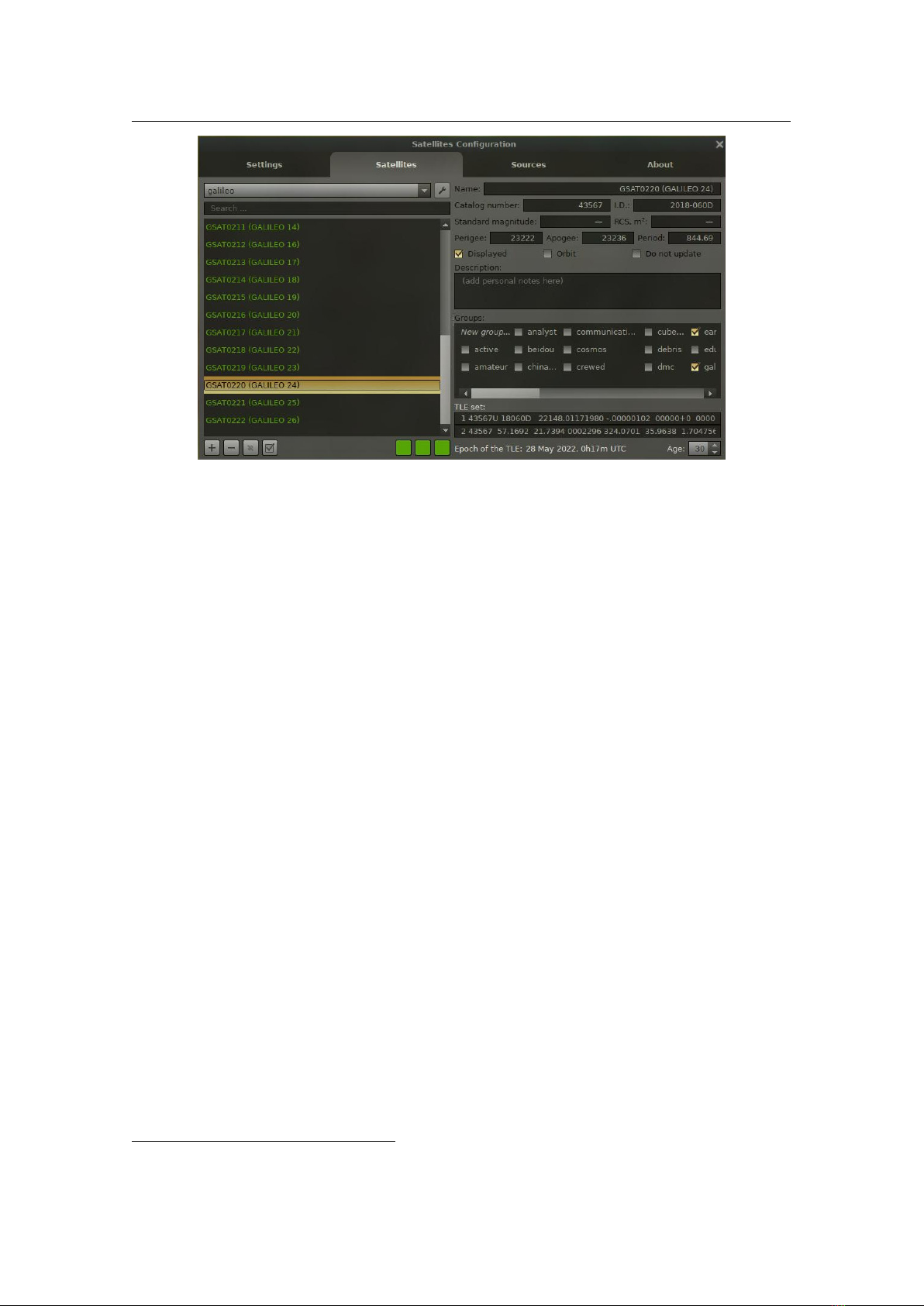
194 Chapter 14. Object Catalog Plugins
Figure 14.12: Configuration of the Satellites plugin: satellite properties
observations.
31
RCS
The Radar Cross Section is a median value derived from the last several years of values in
the Satellite Situation Report. The units of the RCS are square meters.
Perigee
The perigee is the nearest point respectively of a satellite’s direct orbit around the Earth.
The unit of perigee is kilometers.
Apogee
The apogee is the farthest point respectively of a satellite’s direct orbit around the Earth.
The unit of apogee is kilometers.
Period
The orbital period is simply how long an orbiting satellite takes to complete one orbit. The
unit of period is minutes.
Displayed
In the Satellite Catalog tab this property controls whether the selected satellite should
be displayed on the sky.
Orbit In the Satellite Catalog tab this property controls whether the orbit of the selected satellite
should be displayed in the sky.
Do not update
In the Satellite Catalog tab this property marks satellites for which TLE should
not be updated.
Description The user-defined notes for the selected satellite.
Groups
A satellite can belong to one or more groups such as “amateur”, “geostationary” or
“navigation”. They have no other function but to help the user organize the satellite collection.
Group names are arbitrary strings defined in the Satellite Catalog for each satellite and are
more similar to the concept of tags than a hierarchical grouping. A satellite may also not
belong to any group at all.
By convention, group names are in lowercase. The GUI translates some of the groups used
in the default catalog.
The group names also can be used as an additional filters for the satellites (see UI elements
on the left side).
TLE set
The raw TLE data of selected satellite. A two-line element set (TLE) is a data format
encoding a list of orbital elements of an Earth-orbiting object for a given point in time, the
epoch. Using a suitable prediction model, the state (position and velocity) at any point in the
31
The standard magnitude and RCS data were obtained from Mike McCants’ quicksat catalog with his
kind permission.
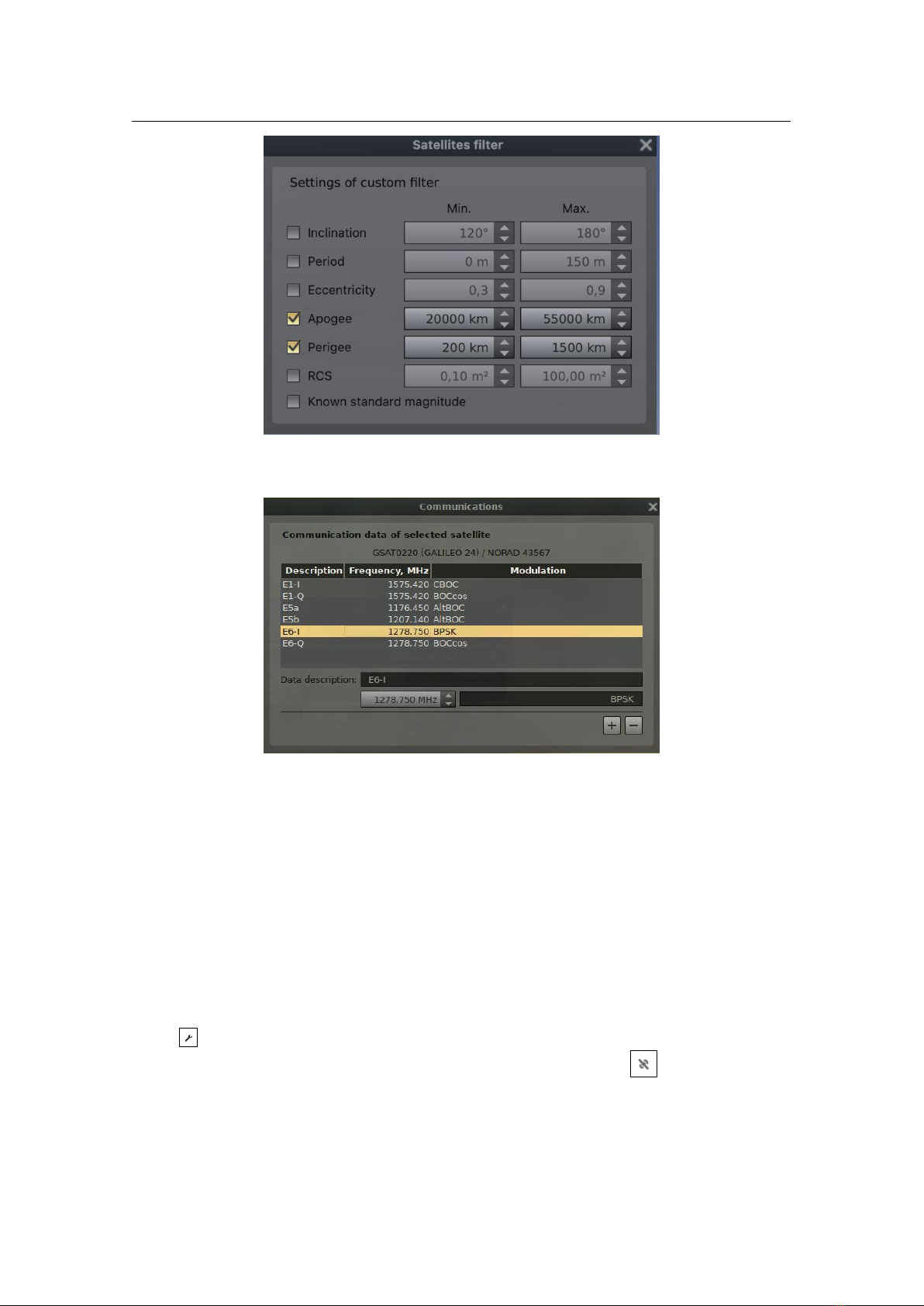
14.8 Satellites Plugin 195
Figure 14.13: Configuration of the Satellites plugin: satellites custom filter
Figure 14.14: Configuration of the Satellites plugin: satellite communication data
past or future can be estimated to some accuracy.
Epoch of the TLE Human-readable epoch of current TLE set.
On the left side of this tab you may see tools for filtering the satellites. The upper part shows a
drop-down list with many predefined filters. Some filters are connected to user defined groups to
quickly get a list of satellites in some group, such as all satellites from group “navigation”. Some
filters are connected to orbital properties of satellites, e.g., selecting the filter “[LEO]” will show all
low-orbital satellites.
You can display a list of satellites by specific selection of their properties, when the filter
“[custom filter]” has been selected (Fig. 14.13). The settings of this filter are available through the
button , which is located at the right of the drop-down list.
You can edit communication data for individual satellites by pressing (Fig. 14.14), where
“Description” and “Frequency” are required fields and field “Modulation” is optional. Some
individual satellites and their groups already have the communication data filled in the default
catalog.
Abbreviations of some types of modulation:
APT Automatic Picture Transmission

196 Chapter 14. Object Catalog Plugins
LRPT Low Resolution Picture Transmission
HRPT High Resolution Picture Transmission
AHRPT Advanced High Resolution Picture Transmission
AX.25 Amateur Radio adaptation of X.25 packet protocol
CW Continuous Wave, Morse Code
AM Amplitude Modulation
FM Frequency Modulation
DUV Data Under Voice
FSK Frequency Shift Keying
GFSK Gaussian Frequency Shift Keying
GMSK Gaussian Minimum Shift Keying
AFSK Audio Frequency Shift Keying
ASK Amplitude-shift Keying
PSK Phase-shift Keying
BPSK Binary Phase-shift Keying
QPSK Quadrature Phase-shift Keying
OQPSK Offset Quadrature Phase-shift Keying
DPSK Differential Phase-shift Keying
BOC Binary Offset Carrier
MBOC Multiplexed Binary Offset Carrier
14.8.2 Satellite Catalog
The satellite catalog is stored on disk in JSON
32
format, in a file named
satellites.json
. A
default copy is embedded in the plug-in at compile time. A working copy is kept in the user data
directory.
To add a new satellite, open a new line after line 5 and paste the following. Note the structure
of commas and brackets, they are important:
" NORAD nu m ber ":
{
" name ": " name of the satellite "
" description ": " description goes h ere " ,
" comms " : [
{
" description ": " do w n l ink 1" ,
" fr e q u e n c y " : 437.49 ,
" modulation ": " AFSK 1200 bps "
},
{
" description ": " do w n l ink 2" ,
" fr e q u e n c y " : 14 5 . 825
}
],
" groups ": [" group1 " , " gro up2 "] ,
" stdMag ": 2.0 ,
" tle1 ": "1 1 2345 U 90005 D 09 080 . 8 5 2 3 626 5 .00000014 00000 -0 20602 -4 0 5632 " ,
" tle2 ": "2 1 2345 98.270 0 53.2 7 0 2 001 1 918 71 .1776 2 8 9 . 0 705 14.31818920 653 ",
" vi sible ": true
},
Explanation of the fields:
NORAD number
required parameter, surrounded by double quotes (
"
), followed by a colon (
:
).
It is used internally to identify the satellite. You should replace the text
"NORAD number"
with the first number on both lines of the TLE set (in this case,
"12345"
). It must match
32
https://www.json.org/
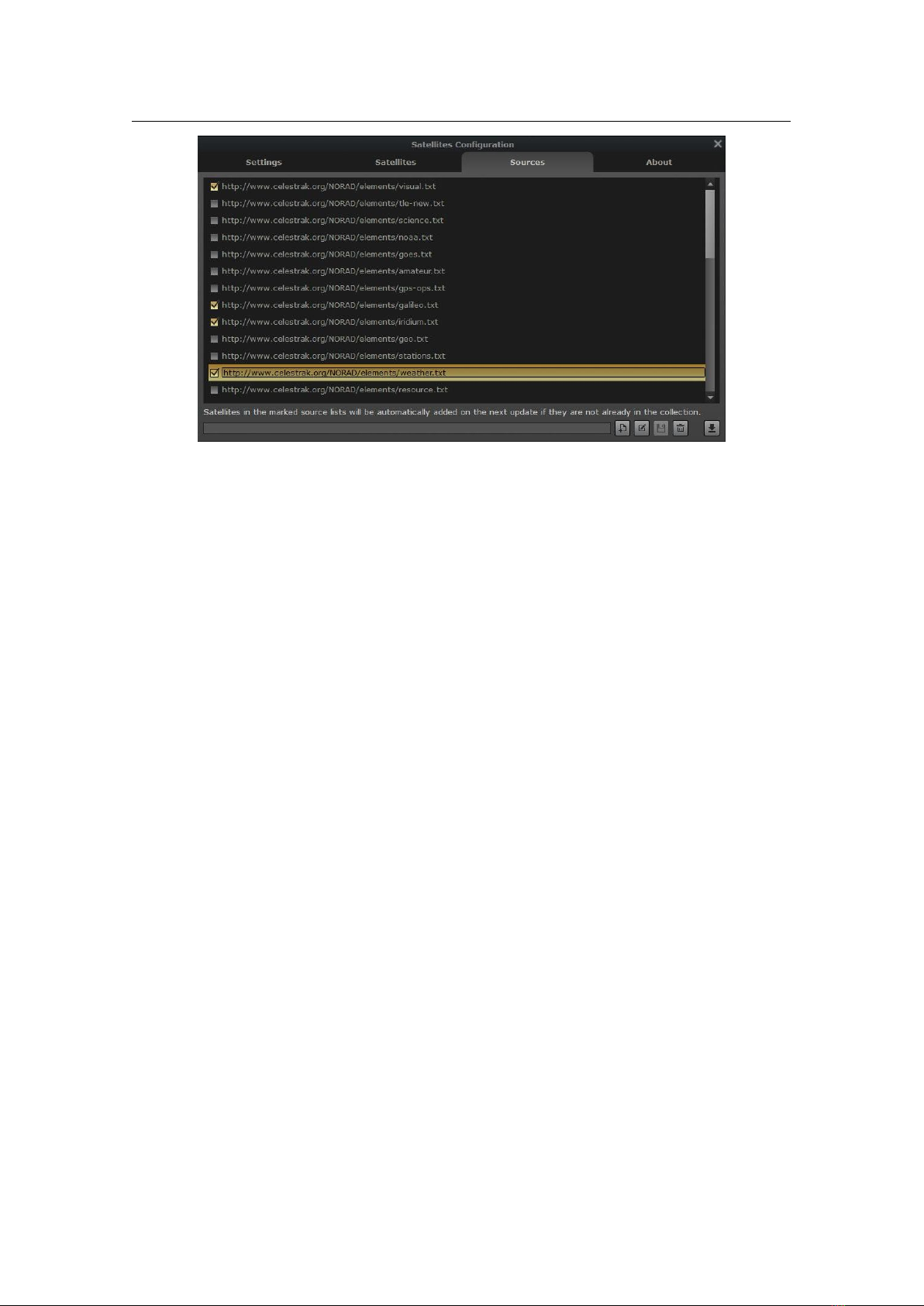
14.8 Satellites Plugin 197
Figure 14.15: Configuration of the Satellites plugin: sources for TLE data
the number of the satellite in the source you are adding from if you want the TLE to be
automatically updated.
The remaining parameters should be listed between two curly brackets, and the closing curly bracket
must be followed by a comma to separate it from the next satellite in the list:
name
required parameter. It will be displayed on the screen and used when searching for the
satellite with the Find window. Use the description field for a more readable name if you
like.
description
optional parameter, double quoted. Appears when you click on the satellite. The
description field can accept HTML tags such as <br/> (new line), <b>bold</b>, etc.
comms
optional parameter, square bracketed list of curly bracketed communications information.
groups
optional parameter, comma separated list of double quoted group names contained in
square brackets. Used for grouping satellites in the drop down box on the config (see above)
tle1 required, line 1 of the TLE, must be contained in double quotes and begin with "1 "
tle2 required, line 2 of the TLE, must be contained in double quotes and begin with "2 "
visible
required parameter, set to true if you want to see it, this can be toggled from the configura-
tion window once the satellite is loaded.
stdMag optional parameter, containing standard magnitude of satellite.
rcs
optional parameter, containing the satellite’s Radar Cross Section. The units of the RCS are
square meters.
You can edit the tags for a satellite, modify the description and comms data, and even add new
satellites.
14.8.3 Configuration
The plug-in’s configuration data is stored in Stellarium’s main configuration file.
14.8.4 Sources for TLE data
TLE sets have to be accessed online. Occasionally the source path changes, and configurations set
up with previous versions may no longer be available. Use the bottom right button in the Sources
tab (Figure 14.15) to restore the installation defaults.

198 Chapter 14. Object Catalog Plugins
Celestrak
33
used as default update source, it also has TLE lists beyond those included by default
in Satellite plug-in
TLE.info
34
Space Track
35
the definitive source, requires sign-up, operated by United States Department of
Defense
33
https://celestrak.org/NORAD/elements/
34
https://www.tle.info/joomla/index.php
35
https://www.space-track.org/

14.9 Missing Stars Plugin 199
14.9 Missing Stars Plugin
Over the years some users have reported that some stars, usually telescopic targets only, are missing
from Stellarium’s star catalogs. This can be hardly avoided given selection criteria of catalogs (see
Appendix C). There are doubtlessly many more stars missing. If you need to compare your own
photographs or observations and check for stars that may be missing from Stellarium’s catalog, it is
best to switch on the DSS layer (see section 10.4).
This plugin is enabled by default and has no UI button. If enabled (see section 12.1), it just
v 23.3
draws the stars from its add-on catalog.

200 Chapter 14. Object Catalog Plugins
14.10 ArchaeoLines Plugin
GEORG ZOTTI
Figure 14.16: Declination Lines provided by the ArchaeoLines plugin
14.10.1 Introduction
In the archaeoastronomical literature, several astronomically derived orientation schemes are
prevalent. Often prehistorical and historical buildings are described as having been built with a
main axis pointing to a sunrise on summer or winter solstice. There can hardly be a better tool than
Scenery3D (see chapter 15) to investigate a 3D model of such a building, and this plugin has been
introduced in version 0.13.3 as a further tool in the archaeoastronomer’s toolbox (Zotti, 2016b).
When activated (see section 12.1), you can find a a tool bar button (in the shape of a
trilithon with the sun shining through it). Press this, or
Ctrl
+
U
, to display the currently selected
set of characteristical diurnal arcs.
14.10.2 Characteristic Declinations
The ArchaeoLines plugin displays any combination of declination arcs
δ
most relevant to archaeo-
or ethnoastronomical studies. Of course, principles used in this context are derived from natural
observations, and many of these declinations are still important in everyday astronomy.
• Declinations of equinoxes (i.e., the equator, δ = 0) and the solstices (δ = ±ε)
•
Declinations of the crossquarter days (days between solstices and equinoxes,
δ(λ = ±45
◦
)
)
• Declinations of the Major Lunar Standstills (δ = ±(ε + i))
• Declinations of the Minor Lunar Standstills (δ = ±(ε − i))
• Declination of the Zenith passage (δ = ϕ)
• Declination of the Nadir passage (δ = −ϕ)
• Declination δ of the currently selected object
• Current declination δ
À
of the sun
• Current declination δ
Á
of the moon
• Current declination δ
P
of a naked-eye planet
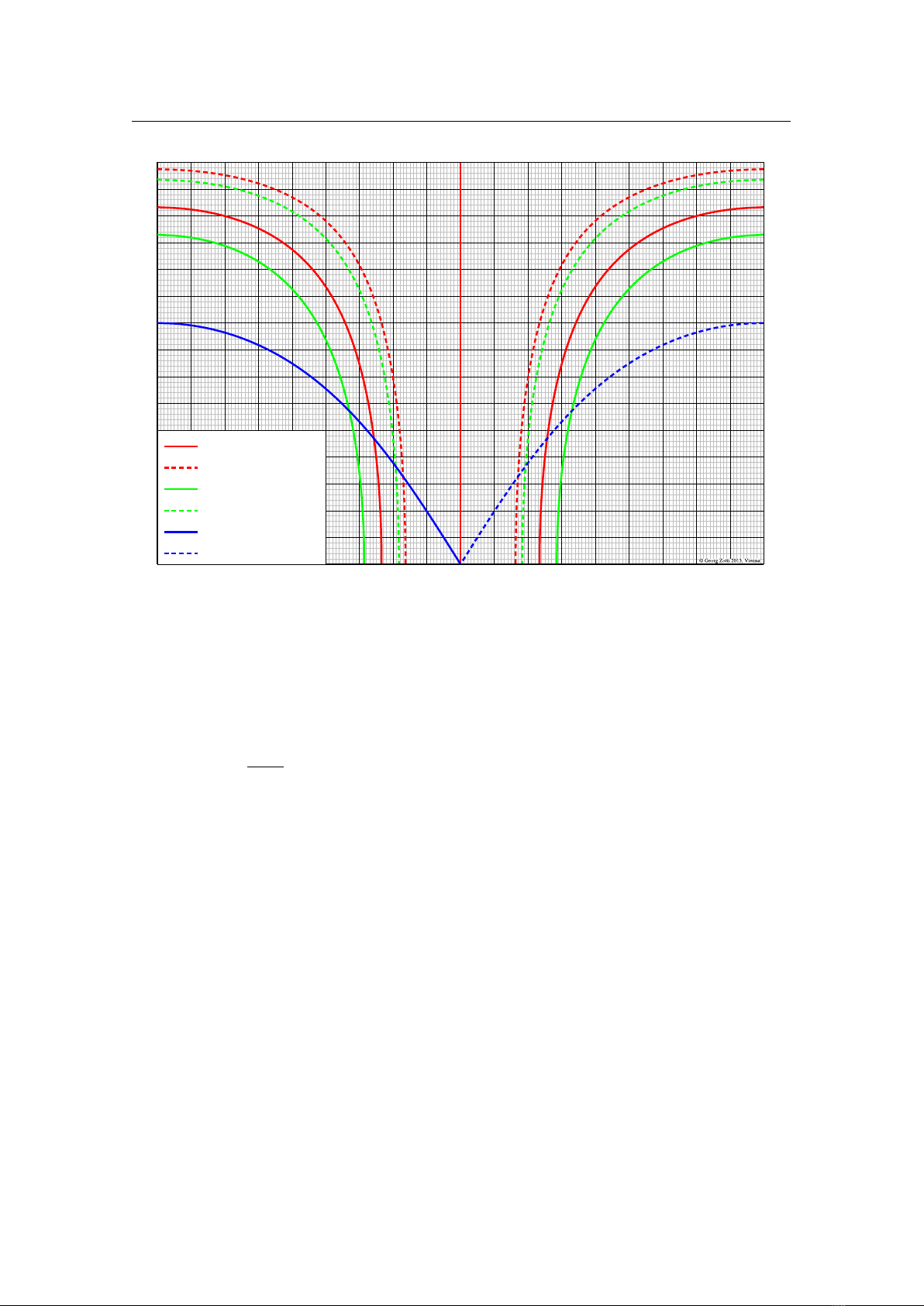
14.10 ArchaeoLines Plugin 201
0 10 20 30 40 50 60 70 80 90 100 110 120 130 140 150 160 170 180
0
5
10
15
20
25
30
35
40
45
50
55
60
65
70
75
0
5
10
15
20
25
30
35
40
45
50
55
60
65
70
75
Solstices, Equinoxes
Solar Crossquarters
Major Standstills
Minor Standstills
Zenith Passage
Nadir Passage
Rising Azimuths, Year 2000
Figure 14.17: Rising azimuths of a few important events for sun and moon, and zenith and
nadir passages depending on geographic latitudes (vertical axis).
The principal relation between declinations
δ
, geographic latitude
ϕ
, and the rising azimuth
A
is computed from
cosA = −
sinδ
cosϕ
. (14.1)
This formula does not take into account local horizon elevation nor atmospheric refraction nor
lunar parallax correction. The effect applied to characteristic declinations is shown graphically for
the present time (J2000.0) in figure 14.17. For example, in a latitude of 30
◦
, an object which goes
through the zenith rises at azimuth 55
◦
. Lunar major standstill risings occur at azimuths 56.7
◦
and
123.5
◦
, lunar minor standstill risings at azimuths 69
◦
and 111
◦
. The summer solstice sun rises at
62.6
◦
, the winter solstice sun at 117.3
◦
. An object which goes through the nadir rises at 125
◦
.
The blue lines seem to vanish at
ϕ = 45
◦
: while there are still objects going through the zenith
in higher latitudes, they are circumpolar and do not cross the horizon.
For the lunar events, there are two lines each drawn by the plugin, for maximum and minimum
distance of the moon. The lunar extreme declinations are computed taking horizon parallax effects
into account. For technical reasons however, the derived declinations are then used to draw small
circles of constant declinations on the sphere, without taking the change of lunar horizontal parallax
into account. Note that therefore the observed declination of the moon at the major standstill can
exceed the indicated limits if it is high in the sky. The main purpose of this plugin is however to
show an indication of the intersection of the standstill lines with the horizon.
It may be very instructive to let the time run quite fast and observe the declination line of
“current moon” swinging between its north and south limits each month. These limits grow and
shrink between the Major and Minor Standstills in the course of 18.6 years.
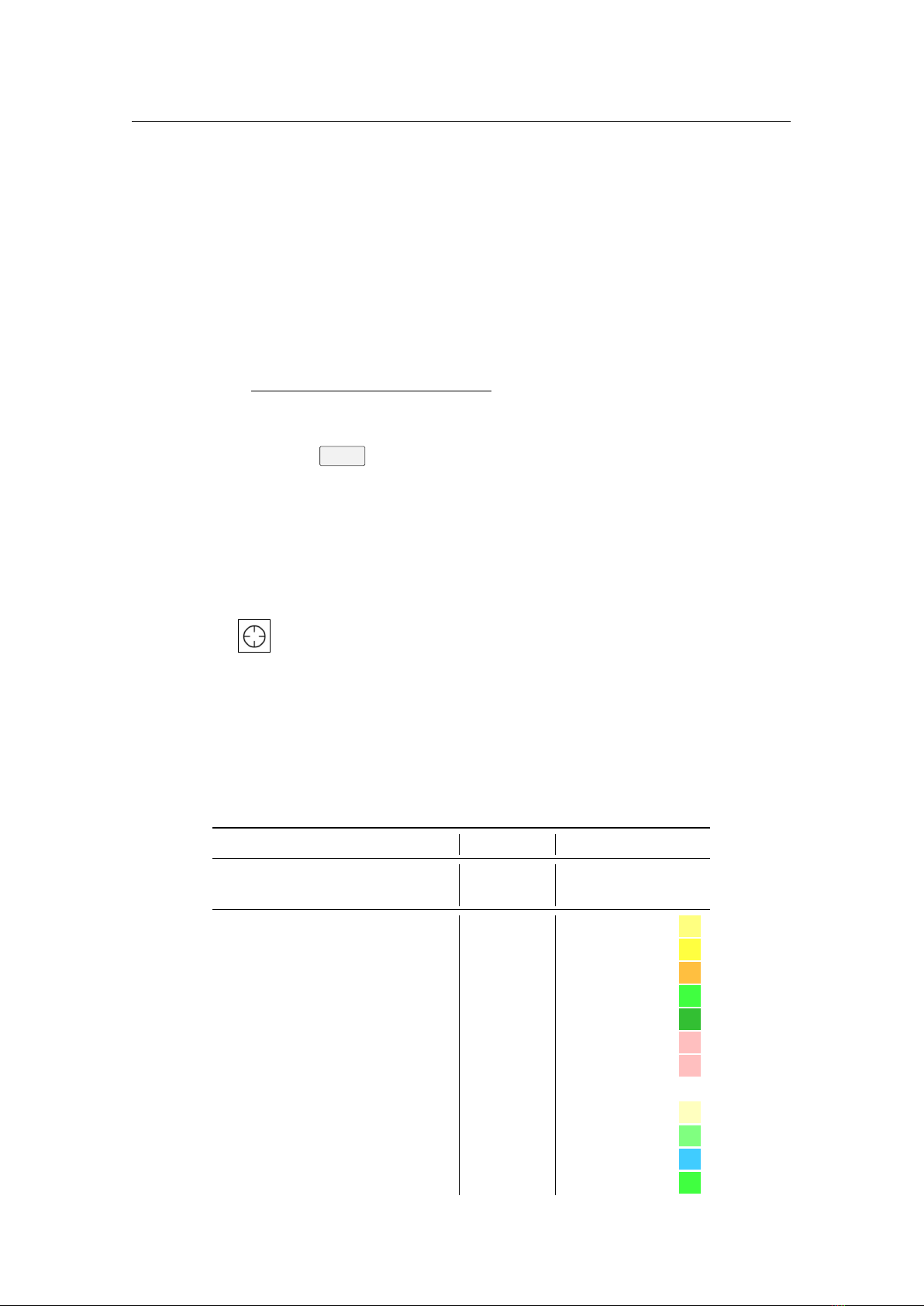
202 Chapter 14. Object Catalog Plugins
The sun likewise swings between the solstices. Over centuries, the solstice declinations very
slightly move as well due to the slightly changing obliquity of the ecliptic.
14.10.3 Geographical Targets
Some religions, e.g., Islam or Bahai, adhere to a practice of observing a prayer direction towards a
particular location. Azimuth lines for two locations can be shown, these lines indicate the great
circle direction towards the locations which can be edited in the configuration window. Default
locations are Mecca (Kaaba) and Jerusalem. The azimuth
q
towards a location
T = (λ
T
,ϕ
T
)
can
be computed for an observer at
O = (λ
O
,ϕ
O
)
based on spherical trigonometry on a spherical
Earth (Abdali, 1997) as
q = arctan
sin(λ
T
− λ
O
)
cosϕ
O
tanϕ
T
− sinϕ
O
cos(λ
T
− λ
O
)
(14.2)
You can set geographical coordinates and a name label directly, or select locations from Stellarium’s
location list by pressing the
Pick...
button. You can search for locations in the list. When you click
on a location, its data are taken as target.
14.10.4 Custom Lines
In addition, lines can be shown which indicate arbitrary azimuths (great circles through the zenith),
altitudes, and declinations. Note that these azimuths are always counted from north, regardless of
the azimuth setting described in section 4.3.5. These lines can be marked with a custom label.
When some celestial object is selected, you can take over its current respective data and name
by pressing the button, however the lines are not linked to the selected objects, and changing
angle values or time will make labels invalid.
14.10.5 Configuration Options
The configuration dialog allows the selection of the lines which are of interest to you. In addition,
you can select the color of the lines by clicking on the color swatches.
Section
ArchaeoLines
in config.ini file
ID Type Default
enable_at_startup bool false
line_thickness int 1
color_equinox float R,G,B 1.00,1.00,0.50
color_solstices float R,G,B 1.00,1.00,0.25
color_crossquarters float R,G,B 1.00,0.75,0.25
color_major_standstill float R,G,B 0.25,1.00,0.25
color_minor_standstill float R,G,B 0.20,0.75,0.20
color_zenith_passage float R,G,B 1.00,0.75,0.75
color_nadir_passage float R,G,B 1.00,0.75,0.75
color_selected_object float R,G,B 1.00,1.00,1.00
color_current_sun float R,G,B 1.00,1.00,0.75
color_current_moon float R,G,B 0.50,1.00,0.50
color_current_planet float R,G,B 0.25,0.80,1.00
color_geographic_location_1 float R,G,B 0.25,1.00,0.25
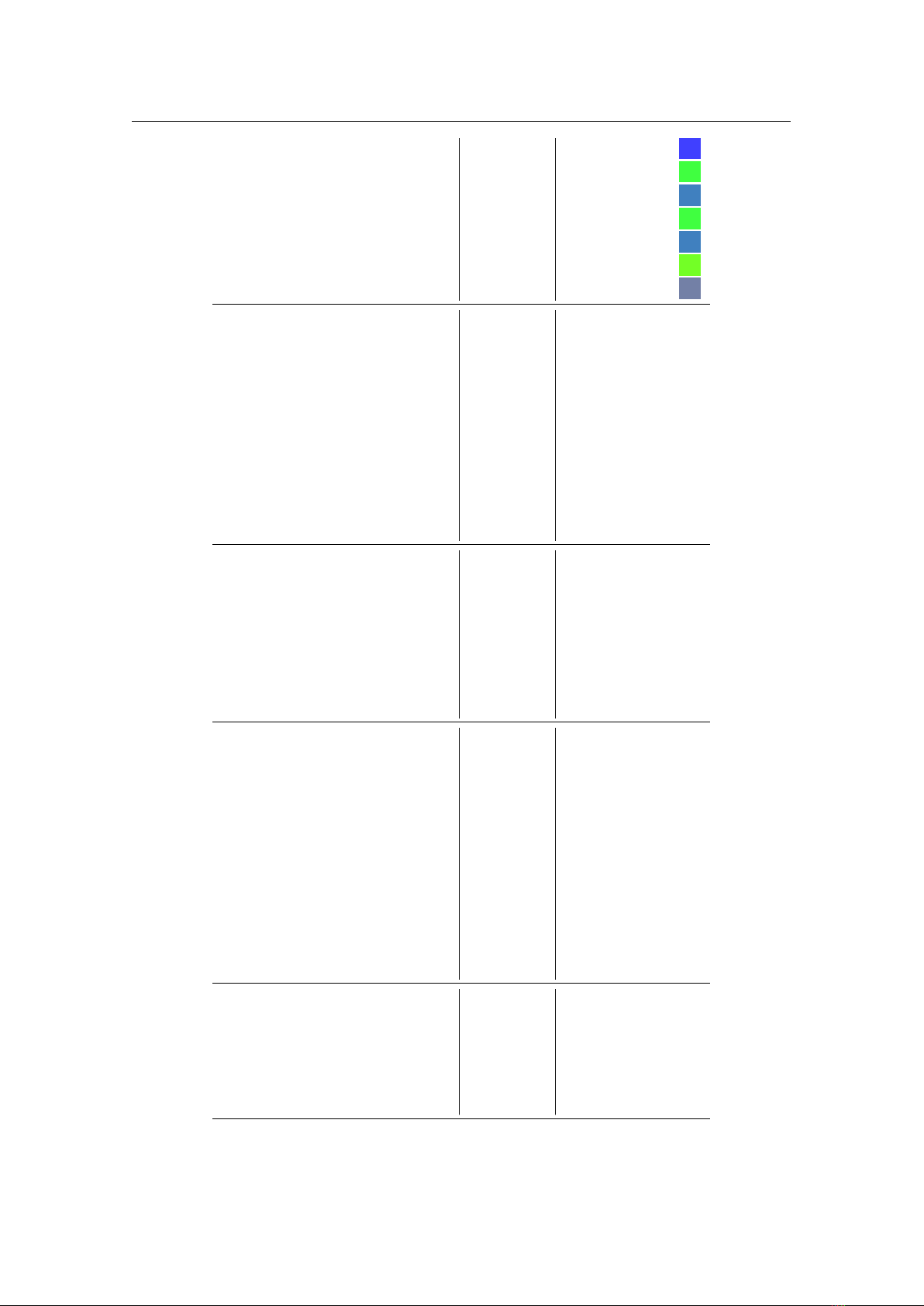
14.10 ArchaeoLines Plugin 203
color_geographic_location_2 float R,G,B 0.25,0.25,1.00
color_custom_azimuth_1 float R,G,B 0.25,1.00,0.25
color_custom_azimuth_2 float R,G,B 0.25,0.50,0.75
color_custom_altitude_1 float R,G,B 0.25,1.00,0.25
color_custom_altitude_2 float R,G,B 0.25,0.50,0.75
color_custom_declination_1 float R,G,B 0.45,1.00,0.15
color_custom_declination_2 float R,G,B 0.45,0.50,0.65
show_equinox bool true
show_solstices bool true
show_crossquarters bool true
show_major_standstills bool true
show_minor_standstills bool true
show_zenith_passage bool true
show_nadir_passage bool true
show_selected_object bool true
show_current_sun bool true
show_current_moon bool true
show_current_planet string none
show_geographic_location_1 bool false
show_geographic_location_2 bool false
geographic_location_1_longitude double 39.826175
geographic_location_1_latitude double 21.4276
geographic_location_1_label string Mecca (Qibla)
geographic_location_2_longitude double 35.235774
geographic_location_2_latitude double 31.778087
geographic_location_2_label string Jerusalem
show_custom_azimuth_1 bool false
show_custom_azimuth_2 bool false
custom_azimuth_1_angle double 0.0
custom_azimuth_2_angle double 0.0
custom_azimuth_1_label string custAzi1
custom_azimuth_2_label string custAzi2
show_custom_altitude_1 bool false
show_custom_altitude_2 bool false
custom_altitude_1_angle double 0.0
custom_altitude_2_angle double 0.0
custom_altitude_1_label string custAlt1
custom_altitude_2_label string custAlt2
show_custom_declination_1 bool false
show_custom_declination_2 bool false
custom_declination_1_angle double 0.0
custom_declination_1_label string custDec1
custom_declination_2_angle double 0.0
custom_declination_2_label string custDec2
14.10.6 Acknowledgements
If you are using this plugin in scientific publications, please cite Zotti (2016b).

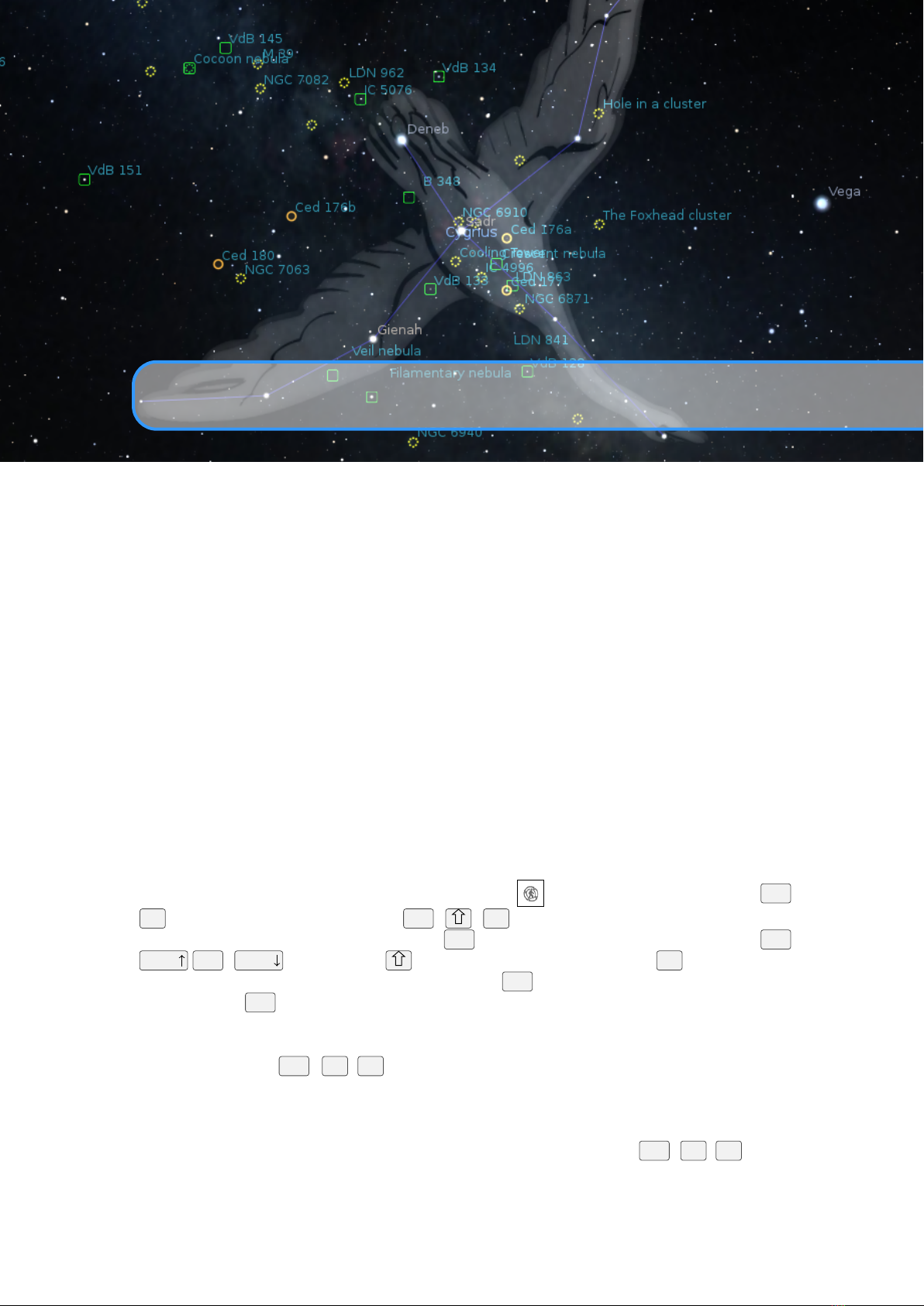
15. Scenery3d – 3D Landscapes
GEORG ZOTTI AND FLORIAN SCHAUKOWITSCH
15.1 Introduction
Have you ever wished to be able to walk through Stonehenge or other ancient building structures de-
scribed as being constructed with astronomical orientation in mind, and experience such orientation
in a 3D virtual environment that also provides a good sky simulation?
The Stellarium Scenery3d plugin allows you to see architectural 3D models embedded in a
landscape combined with the excellent representation of the sky provided by Stellarium. You can
walk around, check for (or demonstrate) possible astronomical alignments of ancient architecture,
see sundials and other shadow casters in action, etc.
15.2 Usage
You activate the plugin with the circular enclosure button at screen bottom or by pressing
Ctrl
+
W
. A right-click on that button (or
Ctrl
+ +
W
) opens the settings dialog. Once loaded
and displaying, you can walk around pressing
Ctrl
plus cursor keys. Change eye height with
Ctrl
+
Page
/
Ctrl
+
Page
keys. Adding key increases speed by 10, adding
Alt
multiplies by 5
(pressing both keys multiplies by 50!). If you release
Ctrl
before the cursor key, animation will
continue. (Press
Ctrl
+any cursor key to stop moving.)
Further key bindings exist which can be configured using the Stellarium default key-binding
interface. Some options are also available in the Scenery3d dialog. For example, coordinate display
can be enabled with
Ctrl
+
R
+
T
. If your models are georeferenced in a true geographical
coordinate grid, e.g. UTM or Gauss-Krueger, you will especially like this, and this makes the plugin
usable for scientific purposes. Display shows grid name, Easting, Northing, Altitude of ground, and
eye height above ground.
Other features include a virtual “torchlight”, which can be enabled with
Ctrl
+
R
+
L
to give
additional local illumination around the viewer to help to see in the dark. Interesting points of view

206 Chapter 15. Scenery3d – 3D Landscapes
can be saved and restored later by the user, including a description of the view. Scene authors can
also distribute predefined viewpoints in their scene.
The plugin also simulates the shadows of the scene’s objects cast by the Sun, Moon and even
Venus (only 1 shadow caster used at a time, you will never see shadows cast by Venus in moonlight),
so you could use it for examining sundials, or analyze and simulate light-and-shadow interactions
in archaeological structures.
Sometimes, light patches cast through small holes are important, e.g., in churches with merid-
v 23.2
iana “sundial/calendar” lines. If these patches appear too dim, you can increase the power of
the directional light using the
Directional light enhancement
switch. (Use value 1.0 to revert to
normal.)
15.3 Hardware Requirements & Performance
In order to work with the non-linear projection models in Stellarium, this plugin uses a trick to
create the foreground renderings: it renders the scene into the six planes of a so-called cubemap,
which is then correctly reprojected onto the sides of a cube, depending on the current projection
settings. Your graphics card must be able to do this, i.e. it must support the OpenGL extension
called
EXT_framebuffer_object
. Typical modern 3D cards (by Nvidia or ATI/AMD) support
this extension. In case your graphics hardware does not support it, the plugin will still work, but
you are limited to perspective projection.
You can influence rendering quality, but also speed, using the plugin’s GUI, which provides
some options such as enabling the use of shadows, bumpmapping (provides more realistic surface
lighting) or configuring the sizes of the textures used for the cubemap or shadowmaps. Larger
values there improve the quality, but require faster hardware and more video memory for smooth
results.
Because the “cubemap trick” requires quite a large amount of performance (in essence, the
scene has to be rendered 6 times), there are some options available that try to reduce this burden.
The first option is to change the type of the “cubemap”. The most compatible setting is 6 textures,
which seems to work best on older integrated Intel GPUs. The recommended default is the second
setting, Cubemap, which uses a more modern OpenGL feature and generally works a bit faster
than 6 textures on more modern graphics cards. Finally, the Geometry shader option tries to render
all 6 cube faces at once. This requires a more recent GPU + drivers (at least OpenGL 3.2 must
be supported), the setting is disabled otherwise. Depending on your hardware and the scene’s
complexity, this method may give a speedup or may be slower, you must find this out yourself.
Another option prevents re-rendering of the cubemap if nothing relevant has changed. You can
define the interval (in Stellarium’s simulation time) in which nothing is updated in the GUI. You
can still rotate the camera without causing a re-draw, giving a subjective performance that is close
to Stellarium’s performance without Scenery3d. When moving, the cubemap will be updated. You
can enable another option that only causes 1 or 2 sides of the cubemap to be updated while you
move, giving a speedup but causing some parts of the image to be outdated and discontinuous. The
cubemap will be completed again when you stop moving.
Shadow rendering may also cause quite a performance impact. The Simple shadows option
can speed this up a lot, at the cost of shadow quality especially in larger scenes. Another perfor-
mance/quality factor is shadow filtering. The sharpest (and fastest) possible shadows are achieved
with filtering Off, but depending on shadowmap resolution and scene size the shadows may look
quite “blocky”. Hardware shadow filtering is usually very fast, but may not improve appearance
a lot. Therefore, there are additional filter options available, the High filter option is relatively
expensive. Finally, the PCSS option allows to approximate the increase of solar and lunar shadow
penumbras relative to the distance from their shadow casters, i.e. shadows are sharp near contact

15.4 Model Configuration 207
Geometry Yes
Lights Yes
Clay No
Photomatched Yes
DefaultUVs No
Instanced No
Table 15.1: Kerkythea Export Settings
points, and more blurred further away. This again requires quite a bit of performance, and only
works if the shadow filter option is set to Low or High (without Hardware).
The configuration GUI shows tooltips for most of its settings, which can explain what a setting
does. All settings are saved automatically, and restored when you reopen Stellarium.
15.3.1 Performance notes
This plugin clearly runs better with proper 3D graphics cards. On reasonably good hardware (tested
on a notebook PC with Nvidia M960), models with over 10.000.000 triangles are working nicely
with shadows and bumpmaps, although your mileage may vary. On very small hardware like
single-board computers with native OpenGL ES2, models may be limited to 64k vertices (points).
If display is too slow, switch to perspective projection: all other projections require almost sixfold
effort! Or try the “lazy” cubemap mode and lazy updates of tiles, where the scene is only rendered
in specific timesteps or when movement happens.
15.4 Model Configuration
The model format supported in Scenery3d is Wavefront .OBJ, which is pretty common for 3D
models. You can use several modeling programs to build your models. Software such as Blender,
Maya, 3D Studio Max etc. can export OBJ.
15.4.1 Exporting OBJ from Sketchup
A simple to use and cost-free modeling program is Sketchup, commonly used to create the 3D
buildings seen in Google Earth. It can be used to create georeferenced models. OBJ is not a native
export format for the standard version of Sketchup. If you are not willing to afford Sketchup Pro,
you have to find another way to export a textured OBJ model.
One good exporter is available in the Kerkythea renderer project
1
. You need SU2KT 3.17 or
better, and KT2OBJ 1.1.0 or better. Deselect any selection, then export your model to the Kerkythea
XML format with settings shown in 15.1. (Or, with selection enabled, make sure settings are
No-Yes-Yes-No-Yes-No-No.) You do not have to launch Kerkythea unless you want to create nice
renderings of your model. Then, use the KT2OBJ converter to create an OBJ. You can delete the
XML after the conversion. Note that some texture coordinates may not be exported correctly. The
setting
Photomatched:Yes
seems now to have corrected this issue, esp. with distorted/manually
shifted textures.
Another free OBJ exporter has been made available by TIG:
OBJexporter.rb
2
. This is the
only OBJ exporter tested so far capable of handling large TIN landscapes (
> 450.000
triangles).
As of version 2.6 it seems to be the best OBJ exporter available for Sketchup.
1
Available at http://www.kerkythea.net/cms/
2
Available from http://forums.sketchucation.com/viewtopic.php?f=323&t=33448

208 Chapter 15. Scenery3d – 3D Landscapes
This exporter swaps Y/Z coordinates, but you can add a key to the config file to correct swapped
axes, see below. Other exporters may also provide coordinates in any order of X, Y, Z – all those
can be properly configured.
Another quirk has to be fixed manually though: in the material description file (MTL), TIG’s
exporter writes both
d
and
Tr
lines with the same value. Actually,
Tr = 1.0 − d
according to
OBJ/MTL documentation, so you should edit away one line, or else the later line overwrites the
value given earlier. Moreover, given that
Tr=1
should actually specify fully transparent objects,
such a line will make your object entirely invisible!
Another (almost) working alternative:
ObjExporter.rb
by author Honing. Here, export with
settings
0xxx00
. This will not create a
TX...
folder but dump all textures in the same directory as
the OBJ and MTL files. Unfortunately, currently some material assignments seem to be bad.
15.4.2 Notes on OBJ file format limitations
The OBJ format supported is only a subset of the full OBJ format: Only (optionally textured)
triangle meshes are supported, i.e., only lines containing statements:
mtllib
,
usemtl
,
v
,
vn
,
vt
,
f
(with three elements only!),
g
. Negative vertex numbers (i.e., a specification of relative positions)
are not supported.
A further recommendation for correct illumination is that all vertices should have vertex
normals. Sketchup models exported with the Kerkythea or TIG plugins should have correct
normals. If your model does not provide them, default normals can be reconstructed from the
triangle edges, resulting in a faceted look.
If possible, the model should also be triangulated, but the current loader may also work with
non-triangle geometry. The correct use of objects (
o
) and groups (
g
) will improve performance: it
is best if you pre-combine all objects that use the same material into a single one. The loader will
try to optimize it anyways if this is not the case, but can do this only partly (to combine 2 objects
with the same material into 1, it requires them to follow directly after each other in the OBJ). A
simple guide to use Blender
3
for this task follows:
1.
File Import Wavefront .obj
- you may need to change the forward/up axes for correct
orientation, try “-Y forward” and “Z up”
2. Select an object which has a shared material
3. Press
+
L
and select ’By Material’
4. Select ’Join’ in the left (main) tool window
5. Repeat for other objects that have shared materials
6.
Export the .obj, making sure to select the same forward/up axes as in the import, also make
sure “Write Normals”, “Write Materials” and “Include UVs” are checked
For transparent objects (with a
d
or
Tr
value, alpha testing does NOT need this), this recommenda-
tion does NOT hold: for optimal results, each separate transparent object should be exported as a
separate “OBJ object”. This is because they need to be sorted during rendering to achieve correct
transparency. If the objects are combined already, you can separate them using Blender:
1. Import .obj (see above)
2. Select the combined transparent object
3. Enter “Edit” mode with and make sure everything is selected (press
A
if not)
4.
Press
P
and select “By loose parts”, this should separate the object into its unconnected
regions
5. Export .obj (see above), also check “Objects as OBJ Objects”
The MTL file specified by
mtllib
contains the material parameters. The minimum that should
be specified is either
map_Kd
or a
Kd
line specifying color values used for the respective faces.
3
https://www.blender.org

15.4 Model Configuration 209
Parameter Default Range Meaning
Ka set to Kd values 0.. .1 each R/G/B Ambient color
Kd 0.8 0.8 0.8 0.. .1 each R/G/B Diffuse color
Ke 0.0 0.0 0.0 0.. .1 each R/G/B Emissive color
Ks 0.0 0.0 0.0 0.. .1 each R/G/B Specular color
Ns 8.0 0... ∞ shinyness
d or Tr 1.0 0.. .1 opacity
bAlphatest 0 0 or 1 perform alpha test
bBackface 0 0 or 1 render backface
map_Kd (none) filename texture map to be mixed with Ka, Kd
map_Ke (none) filename texture map to be mixed with Ke
map_bump (none) filename normal map for surface roughness
illum 2 integer illumination mode in the standard MTL format.
vis_fadeIn (none) double see 15.4.5
vis_fadeOut (none) double see 15.4.5
Table 15.2: MTL parameters evaluated
But there are other options in MTL files, and the supported parameters and defaults are listed in
Table 15.2.
If no ambient color is specified, the diffuse color values are taken for the ambient color. An
optional emissive term
Ke
can be added, which is modulated to only be visible during nighttime.
This also requires the landscape’s self-illumination layer to be enabled. It allows to model self-
illuminating objects such as street lights, windows etc. It can optionally also be modulated by the
emissive texture map_Ke.
If a value for
Ks
is specified, specularity is evaluated using the Phong reflection model
4
with
Ns
as the exponential shininess constant. Larger shininess means smaller specular highlights (more
metal-like appearance). Specularity is not modulated by the texture maps. Unfortunately, some 3D
editors export unusable default value combinations for
Ks
and
Ns
. Blender may create lines with
Ks
=1/1/1 and
Ns
=0. This creates a look of “partial overexposed snow fields”. While the values are
allowed in the specification, in most cases the result looks ugly. Make sure to set
Ns
to 1 or higher,
or disable those two lines.
If a value for
d
or
Tr
exists, alpha blending is enabled for this material. This simulates
transparency effects. Transparency can be further controlled using the alpha channel of the
map_Kd
texture.
A simpler and usually more performant way to achieve simple “cutout” transparency effects is
alpha-testing, by setting
bAlphatest
to 1. This simply discards all pixels of the model where the
alpha value of the
map_Kd
is below the
transparency_threshold
value from
scenery3d.ini
,
making “holes” in the model. This also produces better shadows for such objects. If required, alpha
testing can be combined with “real” blending-based transparency.
Sometimes, exported objects only have a single side (“paper wall”), and are only visible from
one side when looked at in Scenery3d. This is caused by an optimization called back-face culling
5
,
which skips drawing the back sides of objects because they are usually not visible anyway. If
possible, avoid such “thin” geometry, this will also produce better shadows on the object. As a
workaround, you can also set bBackface to 1 to disable back-face culling for this material.
The optional
map_bump
enables the use of a tangent-space normal maps
6
, which provides a
dramatic improvement in surface detail under illumination.
4
https://en.wikipedia.org/wiki/Phong_reflection_model
5
https://en.wikipedia.org/wiki/Back-face_culling
6
https://en.wikipedia.org/wiki/Normal_mapping

210 Chapter 15. Scenery3d – 3D Landscapes
15.4.3 Configuring OBJ for Scenery3d
The walkaround in your scene can use a ground level (piece of terrain) on which the observer can
walk. The observer eye will always stay “eye height” above ground. Currently, there is no collision
detection with walls implemented, so you can easily walk through walls, or jump on high towers, if
their platform or roof is exported in the ground layer. If your model has no explicit ground layer,
walk will be on the highest surface of the scenery layer. If you use the special name
NULL
as ground
layer, walk will be above zero_ground_height level.
Technically, if your model has cavities or doors, you should export your model twice. Once,
just the ground plane, i.e. where you will walk. Of course, for a temple or other building, this
includes its socket above soil, and any steps, but pillars should not be included. This plane is
required to compute eye position above ground. Note that it is not possible to walk in several floors
of a building, or in a multi-plane staircase. You may have to export several “ground” planes and
configure several scenery directories for those rare cases. For optimal performance, the ground
model should consist of as few triangles as you can tolerate.
The second export includes all visible model parts, and will be used for rendering. Of course,
this requires the ground plane again, but also all building elements, walls, roofs, etc.
If you have not done so by yourself, it is recommended to separate ground and buildings into
Sketchup layers (or similar concepts in whichever editor you are using) in order to easily switch the
model to the right state prior to exporting.
Filename recommendations:
<Temple>.skp
Name of a Sketchup Model file. (The
<>
brackets signal “use your
own name here!”) The SKP file is not used by Scenery3d, but you
may want to leave it in the folder for later improvements.
<Temple>.obj Model in OBJ format.
<Temple>_ground.obj Ground layer, if different from Model file.
OBJ export may also create folders
TX_<Temple>
and
TX_<Temple>_ground
. You can delete the
TX_<Temple>_ground folder, <Temple>_ground.obj is just used to compute vertical height.
Put the OBJ, MTL and TX directories into a subdirectory of your user directory (see sec-
tion 5.1), e.g.
<USERDATA>/Stellarium/scenery3d/<Temple>
, and add a text file into it called
scenery3d.ini (This name is mandatory!) with content described as follows.
[model]
name=<Temple>
Unique ID within all models in scenery3d directory. Recom-
mendation: use directory name.
landscape=<landscapename> Name of an available Stellarium landscape.
This is required if the landscape file includes geographical coordinates and your model does not:
First, the location coordinates of the
landscape.ini
file are used, then location coordinates given
here. The landscape also provides the background image of your scenery. If you want a zero-height
(mathematical) horizon, use the provided landscape called Zero Horizon.
scenery=<Temple>.obj The complete model, including visible ground.
ground=<Temple>_ground.obj
Optional: separate ground plane. (NULL for zero altitude.)
description=<Description> A basic scene description (including HTML tags)
The
scenery3d.ini
may contain a simple scene description, but it is recommended to use the
localizable description format: in the scene’s directory (which contains
scenery3d.ini
) create
files in the format
description.<lang>.utf8
which can contain arbitrary UTF-8–encoded
HTML content. <lang> stands for the ISO 639 language code.
author=<Your Name yourname@yourplace.com>
copyright=<Copyright Info>

15.4 Model Configuration 211
obj_order=XYZ
Use this if you have used an exporter which swaps Y/Z
coordinates. Defaults to
XYZ
, other options:
XZY
,
YZX
,
YXZ
,
ZXY, ZYX
camNearZ=0.3
This defines the distance of the camera near plane, default
0.3. Everything closer than this value to the camera can not
be displayed. Must be larger than zero. It may seem tempting
to set this very small, but this will lead to accuracy issues.
Recommendation is not to go under 0.1
camFarZ=10000 Defines the maximal viewing distance, default 10000.
shadowDistance=<val>
The maximal distance shadows are displayed. If left out, the
value from
camFarZ
is used here. If this is set to a smaller
value, this may increase the quality of the shadows that are
still visible.
shadowSplitWeight=0..1
Decimal value for further shadow tweaking. If you require
better shadows up close, try setting this to higher values. The
default is calculated using a heuristic that incorporates scene
size.
[general]
The general section defines some further import/rendering options.
transparency_threshold=0.5
Defines the alpha threshold for alpha-testing, as described
in section 15.4.2. Default 0.5
scenery_generate_normals=0
Boolean, if true normals are recalculated by the plugin,
instead of imported. Default false
ground_generate_normals=0
Boolean, same as above, for ground model. Default
false
.
[location]
Optional section to specify geographic longitude
λ
, latitude
ϕ
, and altitude. The section is
required if
coord/convergence_angle={from_grid|from_utm}
, else location is inherited from
landscape.
planet = Earth
latitude = +48d31’30.4"
Required if
coord/convergence_angle=from_{grid|utm}
longitude = +16d12’25.5" "–"
altitude =from_model|<int>
altitude (for astronomical computations) can be computed
from the model: if
from_model
, it is computed as
(z
min
+
z
max
)/2+ orig_H
, i.e. from the model bounding box centre
height.
display_fog = 0
atmospheric_extinction_coefficient = 0.2
atmospheric_temperature = 10.0
atmospheric_pressure = -1
light_pollution = 1
[coord]
Entries in the
[coord]
section are again optional, default to zero when not specified, but are
required if you want to display meaningful eye coordinates in your survey (world) coordinate
system, like UTM or Gauss-Krüger.

212 Chapter 15. Scenery3d – 3D Landscapes
grid_name=<string>
Name of grid coordinates, e.g.
"UTM 33 U
(WGS 84)"
,
"Gauss-Krüger M34"
or
"Relative to
<Center>"
This name is only displayed, there is no
evaluation of its contents.
orig_E=<double> | (Easting) East-West-distance to zone central meridian
orig_N=<double> | (Northing) North distance from Equator
orig_H=<double> | (Height) Altitude above Mean Sea Level of model origin
These entries describe the offset, in metres, of the model coordinates relative to coordinates in a
geographic grid, like Gauss-Krüger or UTM. If you have your model vertices specified in grid
coordinates, do not specify orig_... data, but please definitely add start_... data, below.
Note that using grid coordinates without offset for the vertices is usually a bad idea for real-
world applications like surveyed sites in UTM coordinates. Coordinate values are often very large
numbers (ranging into millions of meters from equator and many thousands from the zone meridian).
If you want to assign millimetre values to model vertices, you will hit numerical problems with the
usual single-precision floating point arithmetic. Therefore we can specify this offset which is only
necessary for coordinate display.
Typically, digital elevation models and building structures built on those are survey-grid aligned,
so true geographical north for a place with geographical longitude
λ
and latitude
ϕ
will in general
not coincide with grid north, the difference is known as meridian convergence
7
and, on a spherical
globe, amounts to:
γ(λ ,ϕ) = arctan(tan(λ − λ
0
)sinϕ) (15.1)
This amount can be given in
convergence_angle
(degrees), so that your model will be rotated
clockwise by this amount around the vertical axis to be aligned with True North
8
.
convergence_angle = from_grid | from_utm | < double >
grid_ meridian =< double >|+ < int >d<int > ’ < float >"
grid_meridian
is the central meridian
λ
0
of the grid zone, e.g. for Gauss-Krüger, and is only
required to compute convergence angle if
convergence_angle=from_grid
. If your model coordi-
nates is based on UTM, you can use
coord/convergence_angle=from_utm
for a more accurate
computation.
zero_grou nd_ hei ght =< double >
height of terrain outside
<Temple>_ground.OBJ
, or if
ground=NULL
. Allows smooth approach
from outside. This value is relative to the model origin, or typically close to zero, i.e., use a Z
value in model coordinates, not world coordinates! (If you want the terrain height surrounding your
model to be orig_H, use 0, not the correct mean height above sea level!) Defaults to minimum of
height of ground level (or model, resp.) bounding box.
start_E=<double>
start_N=<double>
start_H=<double> only meaningful if ground==NULL, else H is derived from ground
start_Eye=<double> default: 1.65m
start_az_alt_fov=<az_deg>,<alt_deg>,<fov_deg>
initial view direction and field of view.
7
https://en.wikipedia.org/wiki/Transverse_Mercator_projection
8
Note that Sketchup’s georeferencing dictionary provides a NorthAngle entry, which is
360 −
convergence_angle.
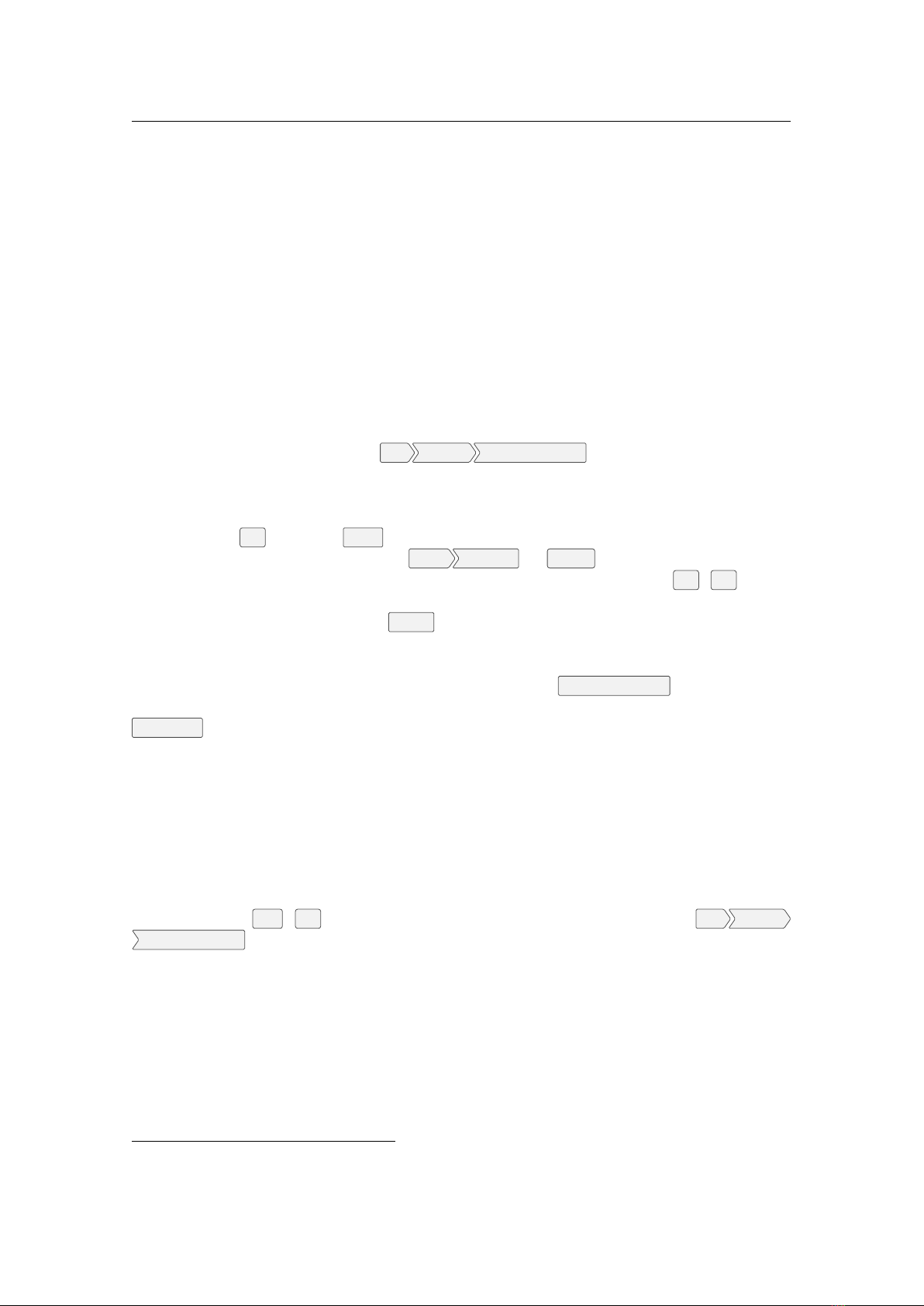
15.4 Model Configuration 213
start_...
defines the view position to be set after loading the scenery. Defaults to center of
model boundingbox.
It is advisable to use the grid coordinates of the location of the panoramic photo (landscape) as
start_...
coordinates, or the correct coordinates and some carefully selected
start_az_alt_fov
in case you want to highlight a certain view corridor (temple axis, . . . ).
In some setups like digital full-dome planetaria it is advisable to disable the use of the
v 23.2
start_az_alt_fov
. You can do that in the Scenery3D configuration dialog or by the entry
ignore_start_az_alt_fov in config.ini.
15.4.4 Concatenating OBJ files
Some automated workflows may involve tiled landscape areas, e.g. to overcome texture limitations
or triangle count limits in simpler tools like Sketchup. In this case you can create separate meshes
in the same coordinate system, but you need to concatenate them. One powerful program to
assemble your parts is again Blender.
In Blender, import the OBJ files
File Import Wavefront .obj
. If your OBJ coordinates have
Z as vertical axis (common for terrestrial models), use “Z up”, “-Y Forward” as import settings for
the coordinate axes. The model will appear south-up.
Blender may not show anything except the default cube because of aggressive camera far plane
clipping. Press
N
and in the
View
set at least the far clipping plane as required to see the full
extent of your terrain model. Then press
View View All
(or
Home
).
The landscape may look white now. Switch on textured view if required (
Alt
+
Z
). If the
scene looks almost black now, reconfigure the light to be sunlight: Select the lamp in the outliner
graph, press the lamp icon and in the
Lamp
select “Sun”. Now the scene should be in full color,
and the Y axis should point towards grid-south.
After importing the first model, you may consider locking it in place to avoid errors. Select the
model in the outliner, select the cube button below, then open
Transform Locks
and lock all. The
other model parts may have to be transformed, and numerical transformation can be added in the
Transform
settings in this menu.
If you have created a VRML (WRL) of some structures in ArcScene, export that without
shifting to center, and import the WRL file in Blender with default orientation “Y up”, “Z forward”.
Models from other sources may still be different.
In the end, all parts should fit neatly together. Blender is a very powerful program, you can
enhance your model as you wish.
When the model configuration is complete, select all relevant parts which you want to have
visible in Stellarium (click on the lines in the outline view containing the object names to light
them up gray, then Rightclick-Select, so that the triangle (mesh) icon has a colored background
circle) and press
Ctrl
+
J
to optionally join them, then export to a single OBJ
File Export
Wavefront .obj
. In the export options, apply “Selection Only”, and “-Y Forward” and “Z Up”
9
.
Verify the new model loads correctly, e.g. in Meshlab
10
!
15.4.5 Beyond 3D: Temporally evolving Models
Stellarium working as “time machine” can display the sky for any calendar date in its range of
valid dates. Also landscapes and human-built structures evolve. Temples are being rebuilt, changed,
re-dedicated or repurposed, new windows are cut, old windows closed. To show landscape and
buildings in the right shape for the time in question, we can make material transparent, so that parts
of the model are not displayed. To allow for archaeological uncertainties in dating construction and
9
https://blender.stackexchange.com/questions/3352/merging-multiple-obj-files
10
https://www.meshlab.net/

214 Chapter 15. Scenery3d – 3D Landscapes
destruction, we can gradually fade in and fade out the model parts in question (Zotti, Schaukowitsch,
and Wimmer, 2018).
To enable this magic, you must combine all your models into one (see section 15.4.4), export as
one OBJ/MTL as usual, and manually edit the MTL file. It is wise to give the material for the parts
in question a reasonable name that you can later identify in the MTL file. Then you simply add
one or both of the new keywords
vis_fadeIn
or
vis_fadeOut
to the material description, with 2
arguments which are the Julian days of begin and end of a phase transition. For sharp transitions,
just use the same JD dates.
# Some structure has been put up around -3100/ -3000
vis_fadeIn 588783.5 625308.5
# Fade away between 500 AD /700 AD
vis_fadeOut 1903682.5 1976732.5
15.4.6 Working with non-georeferenced OBJ files
There exists modeling software which produces nice models, but without concept of georeference.
One spectacular example is AutoDesk PhotoFly, a cloud application which delivers 3D models
from a bunch of photos uploaded via its program interface. This “technological preview” is in
version 2 and free of cost as of mid-2011.
The problem with these models is that you cannot assign surveyed coordinates to points in
the model, so either you can georeference the models in other applications, or you must find the
correct transformation matrix. Importing the OBJ in Sketchup may take a long time for detailed
photo-generated models, and the texturing may suffer, so you can cut the model down to the
minimum necessary e.g. in Meshlab, and import just a stub required to georeference the model in
Sketchup.
Now, how would you find the proper orientation? The easiest chance would be with a structure
visible in the photo layer of Google Earth. So, start a new model and immediately
add location
from the Google Earth interface. Then you can import the OBJ with TIG’s importer plugin. If
the imported model looks perfect, you may just place the model into the Sketchup landscape and
export a complete landscape just like above. If not, or if you had to cut/simplify the OBJ to be
able to import it, you can rotate/scale the OBJ (it must be grouped!). If you see a shadow in the
photos, you may want to set the date/time of the original photos in the scene and verify that the
shadows created by Sketchup illuminating the model match those in the model’s photo texture.
When you are satisfied with placement/orientation, you create a
scenery3d.ini
like above with
the command
Plugins ASTROSIM/Stellarium scenery3d helpers Create scenery3d.ini
.
Then, you select the OBJ group, open the
Windows Ruby Console
and readout data by calling
Plugins ASTROSIM/Stellarium scenery3d helpers Export transformation of selected group
.
On the Ruby console, you will find a line of numbers (the
4× 4
transformation matrix) which
you copy/paste (all in one line!) into the [model] section in scenery3d.ini.
obj2grid _trafo = < a11 >,<a12 >,<a13 >,<a14 >,<a21 >,<a22 >,<a23 >,<a24 >,
<a31 > , < a32 > , < a33 > , < a34 > , < a41 > , < a42 > ,< a43 > , < a44 >
You edit the
scenery3d.ini
to use your full (unmodified) PhotoFly model and, if you don’t have a
panorama, take
Zero Horizon
landscape as (no-)background. It depends on the model if you want
to be able to step on it, or to declare
ground=NULL
for a constant-height ground. Run Stellarum
once and adjust the start_N, start_E and zero_ground_height.
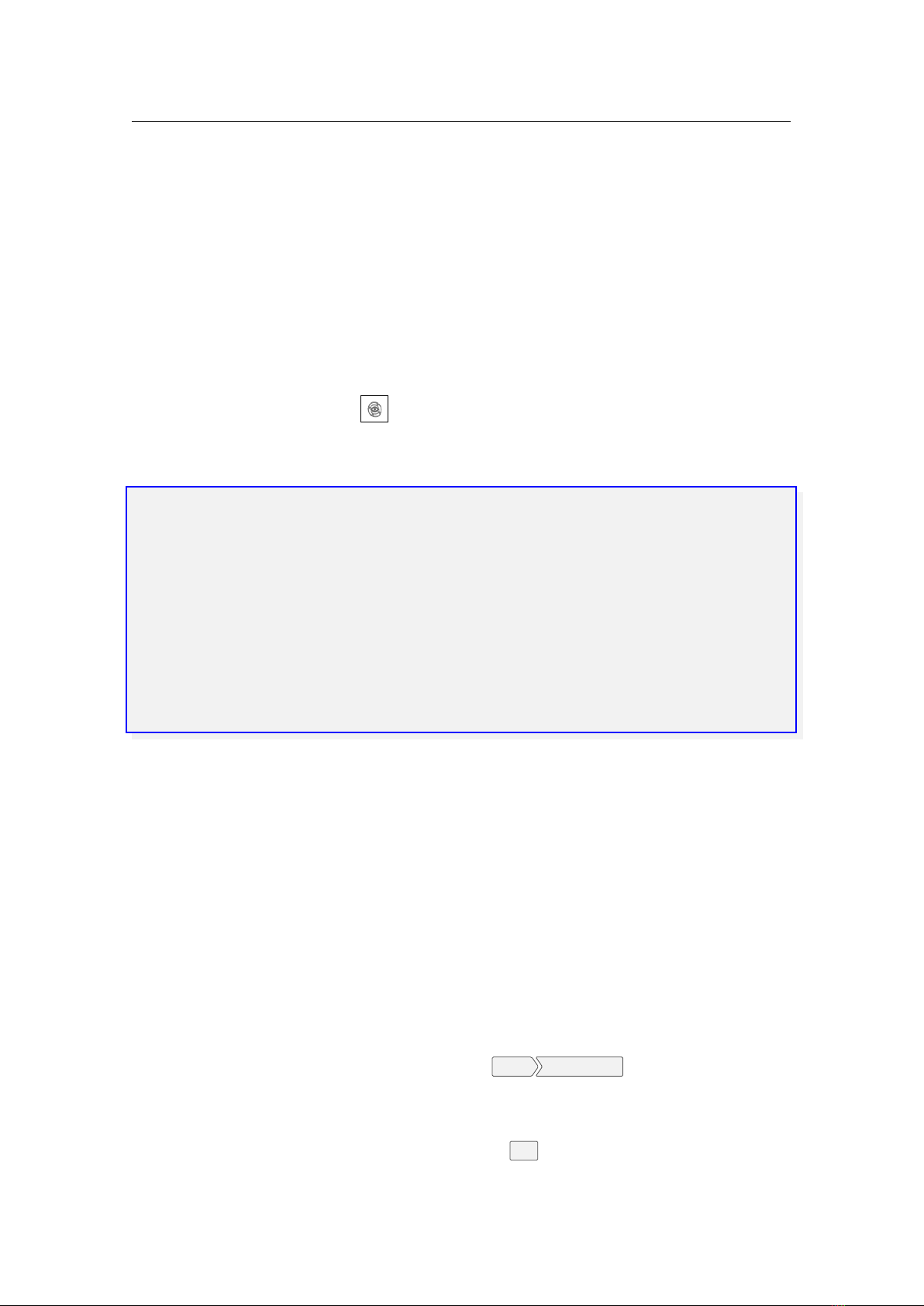
15.5 Predefined views 215
15.4.7 Rotating OBJs with recognized survey points
If you have survey points measured in a survey grid plus an image-based model with those points
visible, you can use Meshlab to find the model vertex coordinates in the photo model, and some
other program like CoordTrans in the JavaGraticule3D suite to find either the matrix values to
enter in
scenery3d.ini
or even rotate the OBJ points. However, this involves more math than can
be described here; if you came that far, you likely know the required steps. Here it really helps if
you know how to operate automatic text processors like AWK.
15.5 Predefined views
You can also configure and distribute some predefined views with optional date of interest with your
model in a
viewpoints.ini
file. The viewpoints can be loaded and stored with the viewpoint
dialog which you can call with the button. See the provided “Sterngarten” scene for an example.
These entries are not editable by the user through the interface. The user can always save his own
views, they will be saved into the file
userviews.ini
in the user’s Stellarium user directory, and
are editable.
[ StoredViews ]
size =< int > De f ines how many e n t ries are in this file .
Pr efix each entry with its in dex !
1/ label =< string > The name of thi s e ntry
1/ d e s c r i p tion = < string > A descri p t i o n of this entry ( can i n c lude HTML )
1/ p osition =<x ,y ,z , h > The x ,y ,z grid coor d i n a t e s
( like o rig_ * or start_ * in scenery3d . ini )
+ the current eye heig h t h
1/ v iew_fov =< az_deg , alt_deg , fov_deg > The view di r e c t i o n + FOV
( like start_ a z _ alt _ f o v in scener y 3 d . ini )
; an examp l e for a second en try ( note the 2 at the b e g i n n i n g of each line !)
2/ label = Si gns
2/ d e s c r i p tion = Two signs that de s c r i be the Sterngarten
2/ p osition = 593155.2421 ,5333 3 4 8 . 6 3 0 4 ,3 2 5 . 7295809 0 3 8 , 0 . 8 8 05
2/ v iew_fov = 84 .315399 , -8 .187078 ,8 3 .000000
2/ JD = 2451545.5 [ o p tional ]
15.6 Example
Let us add a quick example here. A recent paper (Pollard, 2017) claims that the Uffington White
Horse, a geoglyph carved into a hillsite in England during the Bronze Age, may depict the mythical
“Sun Horse”, a common conception of that period.
Unfortunately, as of 2017, the official UK Lidar repository does not include the Uffington
area, so a detailed GIS-based model is not available. We could use EUdem25 data with aerial
imagery, or for a quick look, we just use Sketchup. Yet another unfortunate development: Trimble
declared that after the 5-year transition period from Google to Trimble is over in May 2017, terrain
modelling will be limited to Sketchup Pro. But note that a fresh installation comes with a 30-day
Pro trial time, this should be enough for this example.
First, locate the site in Google Earth at
λ = −1.56718,ϕ = 51.582843
. (Or just search for
“Uffington”.) Try to identify which parts of the landscape may be visible from your site, so you
can estimate which parts of terrain should be included in the model. Open Sketchup, select the
meter-based “Landscape Architecture” template, add
View Toolbars. . .
: Locations. Click on the
“Add Location” button of that toolbar. Enter “Uffington” into the location search dialog. This brings
you close to our site of interest. Clip a part of terrain to import it to Sketchup. Optionally, add more
terrain.
If installed, TIG’s OBJ exporter is available from the
File
menu, or you can use Sketchup Pro’s
built-in OBJ export. Export
UffingtonHorse.obj
to a subdirectory
scenery3d/Uffington
in

216 Chapter 15. Scenery3d – 3D Landscapes
your Stellarium user data directory. The geolocation is stored in an “AttributeDictionary”. To read
this, press
Window Ruby Console
to open the Ruby Console. Then write a few lines of Ruby to
get access to the Georeference dictionary and other data:
model = Sketchup . a ctive_model
at trdicts = model . attribu te_ diction aries
at trdicts . each {| d|
puts " Attr ibu teDictionary : %s" % d. name
d. each_pair { |k , v | puts " %s=% s" % [k , v ] }
}
model . shadow_info . each {|k,v| puts " #{ k } #{ v}" }
utm = model . point_to_ut m Geom :: Point3d . new (0 ,0 ,0)
puts ( " grid_name = UTM % i %s (% s)" %
[ utm. zone_number , utm . zone_letter , model . get_datum ])
Note the
ModelTranslation
values. Those are inches (of all units!) in the UTM reference
frame and define the model coordinate origin in world coordinates. (Actually, it uses the negative
values.) Multiplication by 2.54 gives cm, and by 0.0254, meters in the UTM coordinate system. We
will use the negatives of these values as
orig_E
,
orig_N
,
orig_H
. Additionally, we have found
information about meridian convergence correction (Sketchup’s
NorthAngle
), UTM zone number
etc. All this goes into our configuration file. Create this file
scenery3d.ini
with the content seen
in fig. 15.1
15.7 Limitations
Models with up to 14 million triangles have been used successfully on a mid-range notebook PC
from 2016. However, take some restrictions into account:
•
The model is rendered in Cartesian coordinates. Earth’s surface is curved. If your model
extends by tens of kilometres, the visible horizon formed by faraway mountains may appear
too high. You can display a landscape polygon defined in the currently displayed Landscape
on top of your 3D scene by activating
Draw horizon polyline in foreground
in the plugin’s
settings dialog.
•
The OBJ format is static. Simulation of interaction with 3D objects is not possible with this
plugin.
Authors and Acknowledgements
Scenery3d was conceived by Georg Zotti for the ASTROSIM
11
project. A first prototype was
implemented in 2010/2011 by Simon Parzer and Peter Neubauer as student work supervised
by Michael Wimmer (TU Wien). Models for accuracy tests (Sterngarten, Testscene), and later
improvements in integration, user interaction,
.ini
option handling, OBJ/MTL loader bugfixes
and georeference testing by Georg Zotti.
Andrei Borza in 2011/12 further improved rendering quality (shadow mapping, normal map-
ping) and speed (Zotti, 2015; Zotti and Neubauer, 2012a; Zotti and Neubauer, 2012b).
In 2014–17, Florian Schaukowitsch adapted the code to work with Qt 5 and the Stellarium 0.13
codebase, replaced the renderer with a more efficient, fully shader-based system, implemented
various performance, quality and usability enhancements, and did some code cleanup. Both
Andrei and Florian were again supervised by Michael Wimmer (Zotti, 2016a; Zotti, 2016b; Zotti,
Schaukowitsch, and Wimmer, 2018).
11
https://astrosim.univie.ac.at
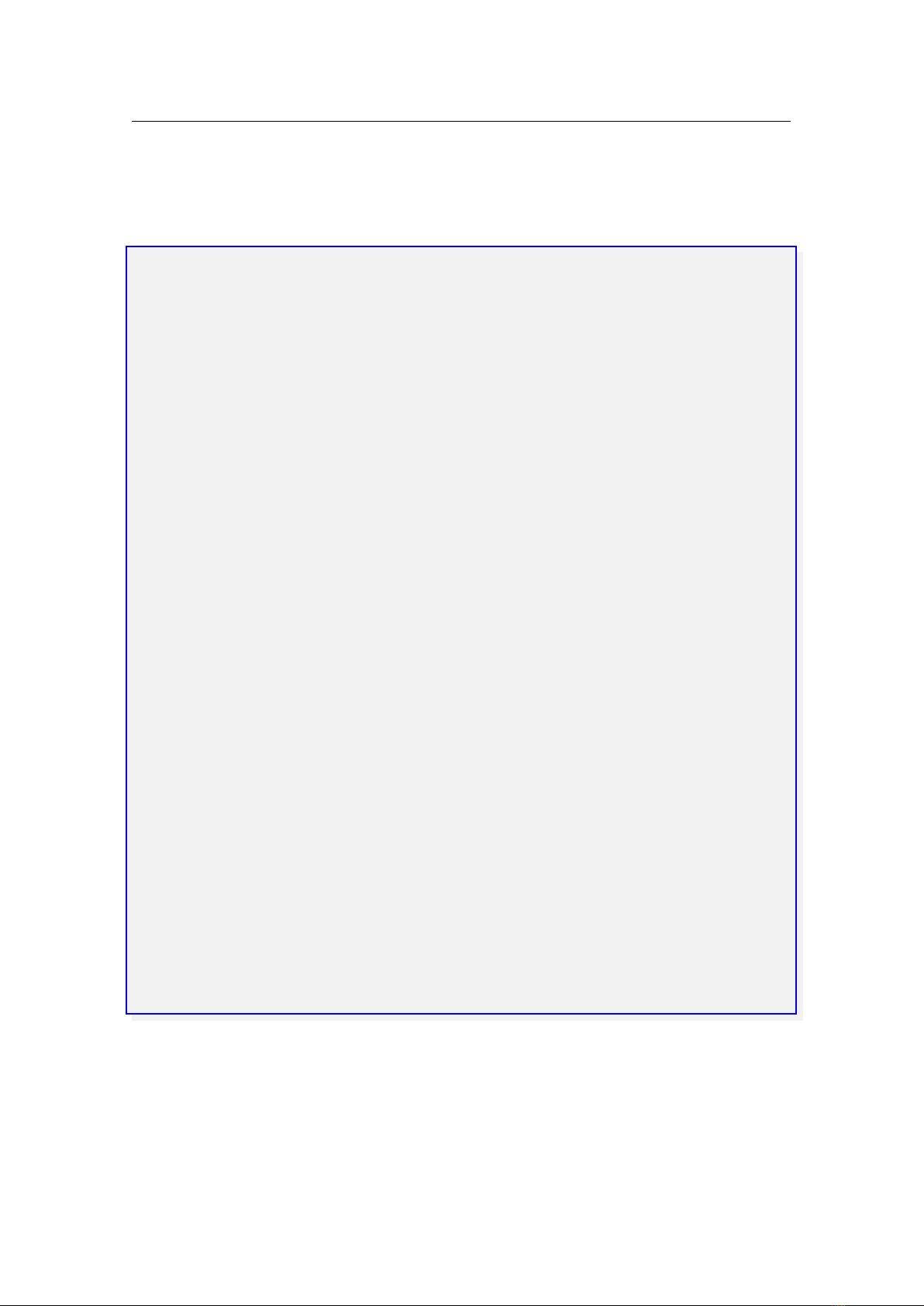
15.7 Limitations 217
[ model ]
name = UffingtonHors e
; Either a fitting landscape or just ’ Zero Horizon ’:
la ndscape = Zero Horizon
scenery = Uff ingtonHorse . obj
; activate the next line if you have a separate ground layer
; ground = U ffingtonHo rse _ground . obj
; If model Y - axis points up , activate the next line
; obj_order = XZY
author = Georg Zotti
co pyright =( c ) 2017 Georg Zotti
description = Uffington Horse may represent the Sun Horse . \
See Joshua Pollard in Antiquity 91 356(2017): 406 -20.
[ location ]
name = UffingtonHors e
country = UK
planetName = Earth
; Set the following to a fitting landscape
landscapeK ey = Zero Horizon
lo ngitude = -1.56718254089355
latitude =51 .58 284 327 498 23
altitude =137
[ coord ]
gr id_name = UTM 30 U ( WGS 84)
gridType = UTM
orig_E =5 992 73. 021 195 78
orig_N =5715615.15079106
orig_H =136.295297626736
convergence_angle =1.12284363771988
; Height used outside the terrain , to not " fall off " the rim .
zero_grou nd_ hei ght =137
; You may want to reset these coordinates .
; Observer is set to those on loading the scenery .
start_E =599273.02119578
start_N =5715615.1507910 6
start_az_alt_fov =50 ,10 ,83
Figure 15.1: scenery3d.ini for the Uffington example.

218 Chapter 15. Scenery3d – 3D Landscapes
This work has been originally created during the ASTROSIM project supported 2008-2012
by the Austrian Science Fund (FWF) under grant number P 21208-G19. Further development has
partially been supported by the Ludwig Boltzmann Institute for Archaeological Prospection and
Virtual Archaeology in Vienna, Austria
12
.
If you are using this plugin in scientific work, please cite: (Zotti, 2016a; Zotti, 2016b; Zotti,
2019; Zotti, Frischer, et al., 2019; Zotti, S. Hoffmann, et al., 2021; Zotti, Schaukowitsch, and
Wimmer, 2018).
12
https://archpro.lbg.ac.at
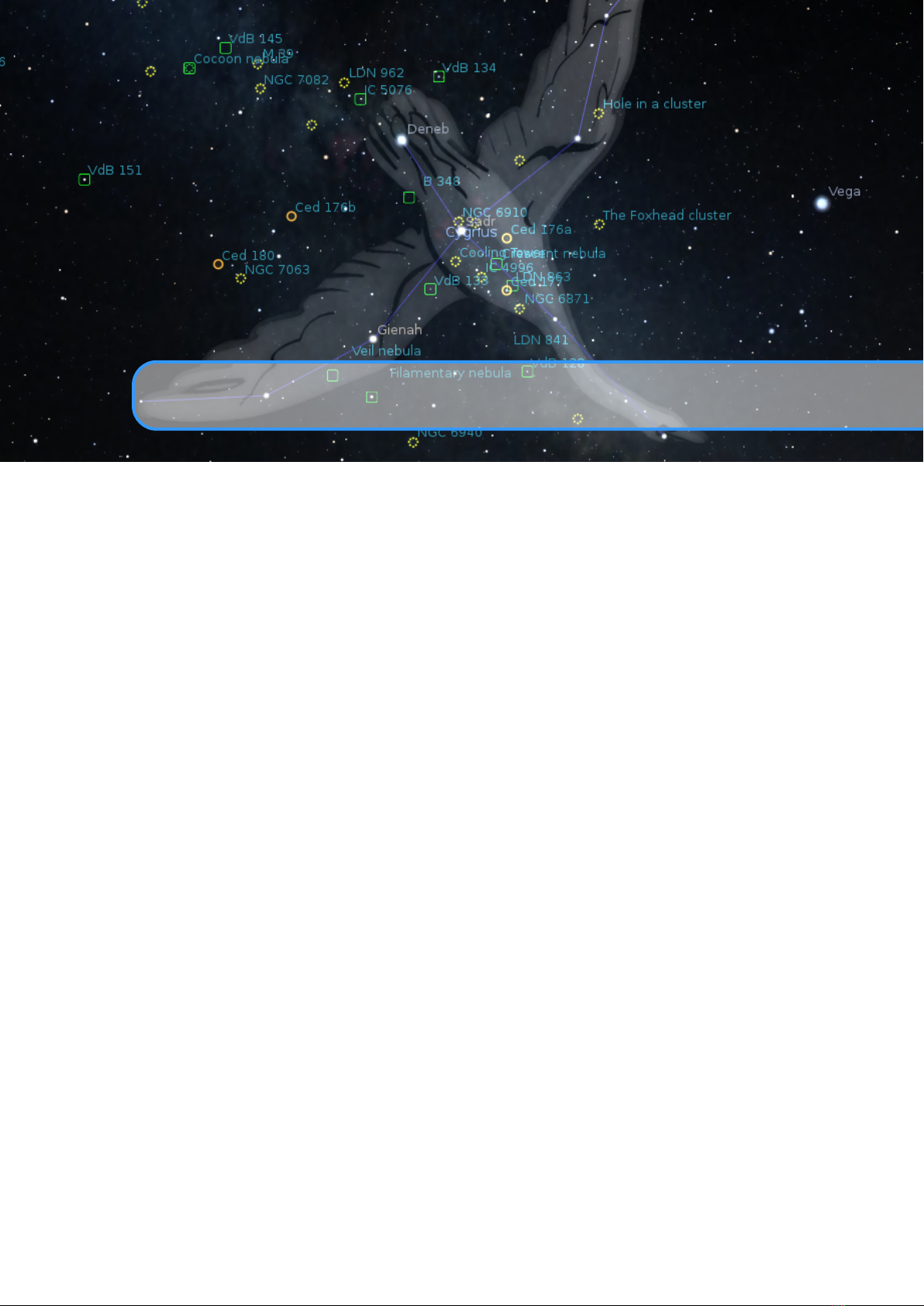
16. Stellarium at the Telescope
Stellarium is great for indoor use on the desktop, but it is also very useful outdoors under the real
sky, and several plugins enhance its usability particularly for observers.
Two plugins are bundled with Stellarium which are designed to be used at the telescope:
Oculars (section 16.1), which provides field of view hints for telescopes, oculars and sensors, and
TelescopeControl (section 16.2), which allows you to send GOTO commands to most motorized
telescope mounts. Other GOTO telescopes are supported by external programs which you must
install separately: RTS2 (section 16.2.6), INDI (section 16.2.7) or ASCOM (section 16.2.8). This
can also help DIY hardware tinkerers who like to build their own control systems (section 16.2.10).
In addition, the Observability plugin (section 16.3) can be used for planning the best times to
observe your favorite objects.
16.1 Oculars Plugin
TIMOTHY REAVES, WITH ADDITIONS BY ALEXANDER WOLF
This plugin serves several purposes:
•
to see what the sky looks like through a particular combination of eyepiece, lens (Barlow or
Shapley types) and telescope. This plugin helps to get an idea of what you should see when
looking through a physical telescope, and understand why one eyepiece may be better suited
to observe a particular target than another. This can also be very useful for deciding what
telescope is best suited to a style of viewing. And with the support for binoculars, you also
have the ability to understand just about any type of optics-enhanced visual observing.
•
to show what a particular combination of camera and telescope (or photographic lens) would
be able to photograph of the sky.
•
lastly, with the help of the Telrad sight, understand where object in the sky are in relation to
each other. This can be helpful for star-hopping with a non-GOTO telescope.
None of these activities can take the place of hands-on experience, but they are a good way to
supplement your visual astronomy interests.
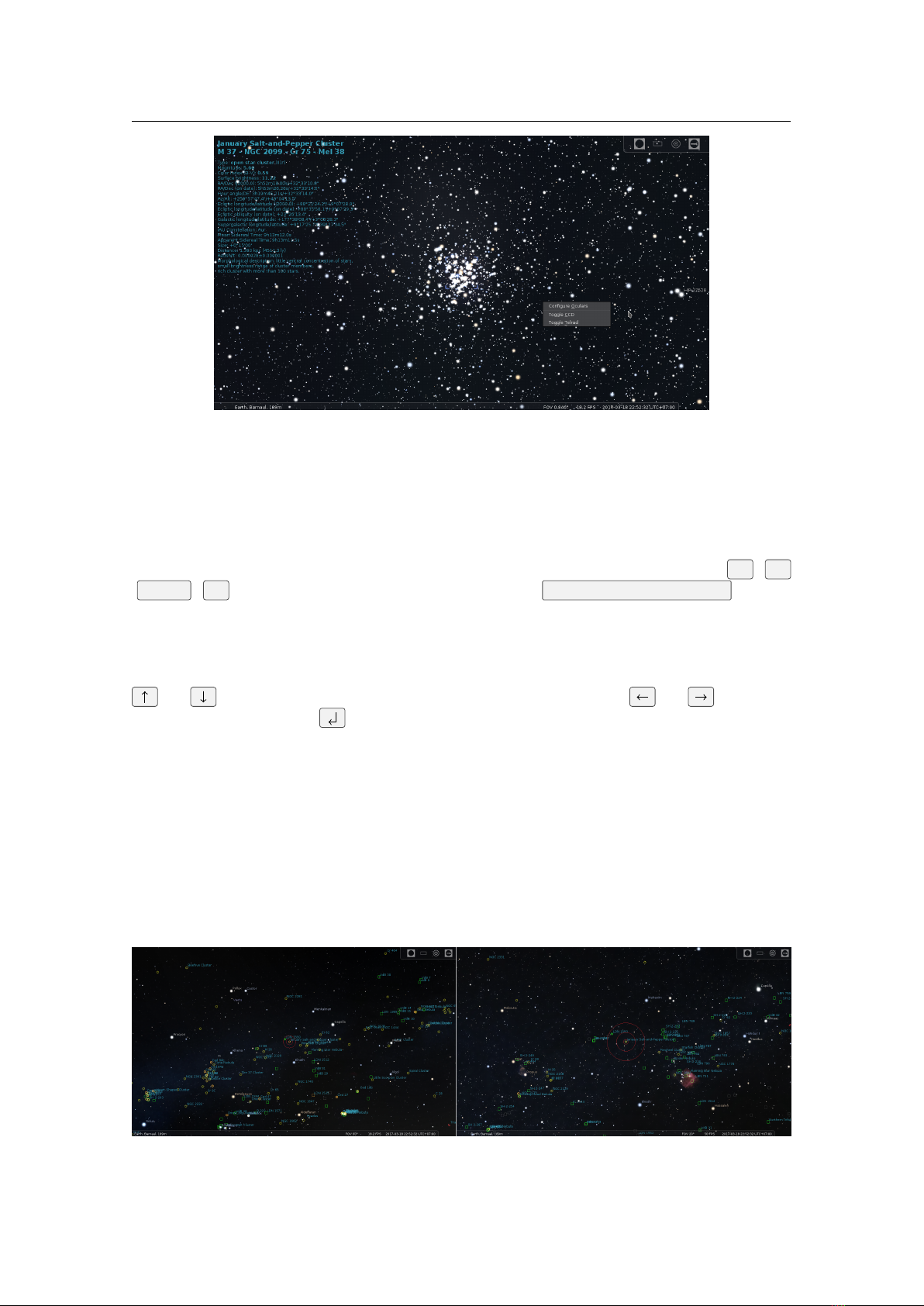
220 Chapter 16. Stellarium at the Telescope
Figure 16.1: The on-screen menu (top right) and popup menu (lower right) of the Oculars
plugin.
16.1.1 Using the Ocular plugin
The plugin is controlled through a popup menu or through an on-screen control panel (see top
right corner on screens in fig. 16.17). By default, the hot key to display the popup is
Alt
+
O
(
Option
+
O
for Mac users). This can be changed in the
Editing Keyboard Shortcuts
window
(see section 4.8). The menu will popup where your cursor is located.
The options available in the popup menu depend on what you are currently doing. In the default
menu, you can choose to configure the plugin, activate a CCD, or activate the Telrad finder (see
fig. 16.1). The menu is navigated by either the arrow keys on your keyboard or by your mouse. The
and arrow keys move the selection up or down the menu, and the and arrow keys
display or hide sub-menus. activates an option.
Telrad Finder
The Telrad view can be used without defining any of the items below. As a reflex sight is non-
magnifying, this feature can only be enabled when no eyepiece is selected. You still may want to
zoom in a bit to better see which stars are in the circles (fig. 16.2). The three circles that appear in
the center of the screen are
0.5
◦
,
2.0
◦
, and
4.0
◦
in diameter. They stay centered in the screen, so
move the “telescope” (click-drag the background) to center the circles on the object of interest.
While the Telrad finder is active, you can not activate a CCD with the popup menu, but only
with the on-screen menu.
Figure 16.2: The left image is the default 60
◦
, and the right one is 40
◦
.
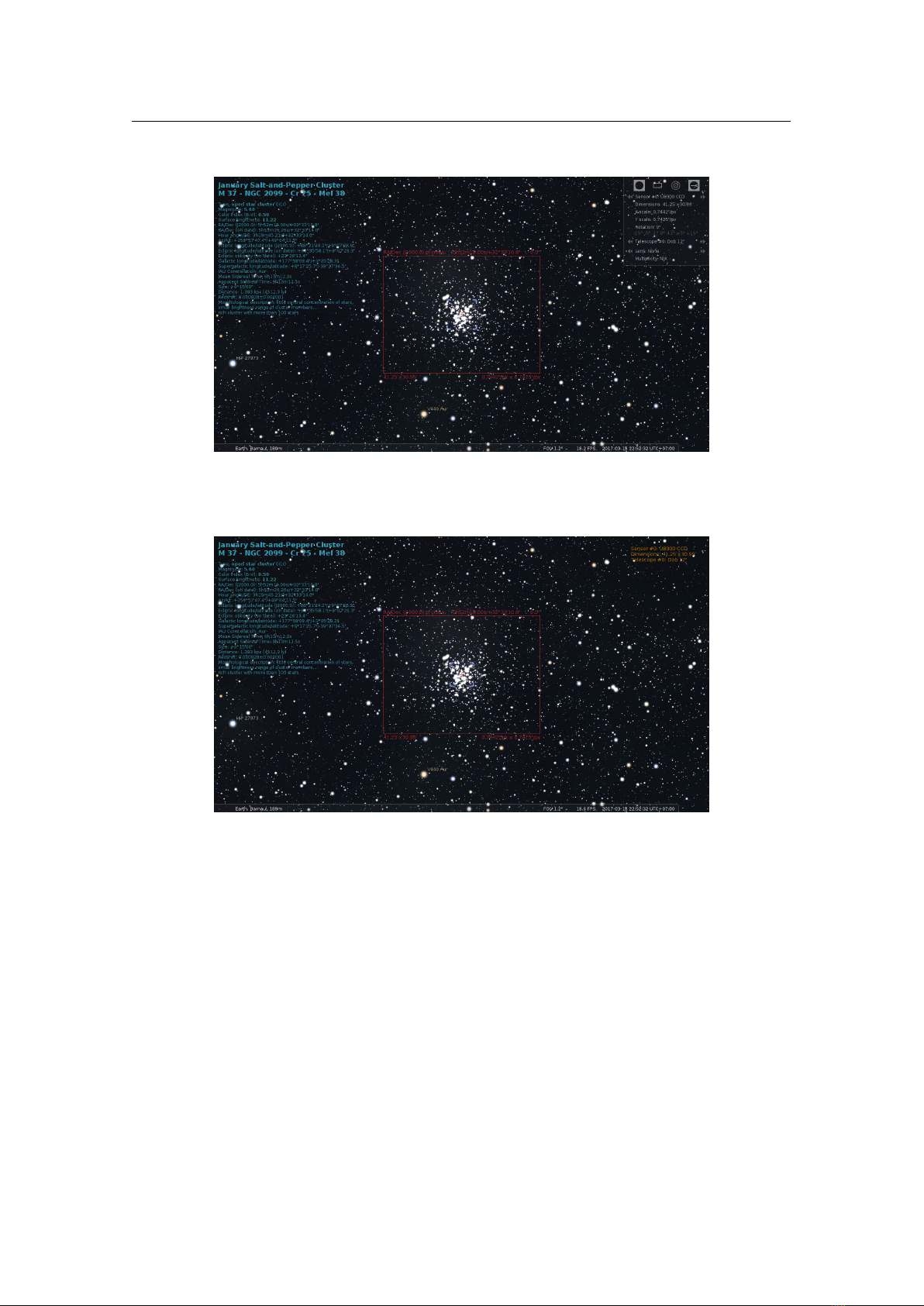
16.1 Oculars Plugin 221
CCD Sensors
Figure 16.3: View of M37 through a CCD sensor of the Oculars plugin.
Figure 16.4: View of M37 through a CCD sensor of the Oculars plugin (without on-screen
control panel).
This is a great way to get an idea of what a particular camera will be able to capture when attached
to a particular telescope or lens. For using camera lenses, you must describe them as telescope with
the appropriate values for the lens. When active, this feature will display a red bounding box of the
area that will be captured, as well as zoom in to give a better view of the surroundings. You can
manually zoom in or out from there.
The default CCD view will appear similar to fig. 16.3 or, when you are working without the
on-screen control panel, the information area in the upper right hand corner also shows angular size
captured by the CCD (see fig. 16.4).
When a CCD view is displayed, the popup menu changes as seen in fig. 16.5. You can select
what telescope to use, as well as progress to the previous or next CCD, or go to a specific CCD.
You can also rotate the CCD to better frame your subject, or to see if the CCD can be rotated in
such a way as to catch your area of interest (see fig. 16.6). Once rotated, the CCD frame on screen
displays the new orientation (see fig. 16.7).
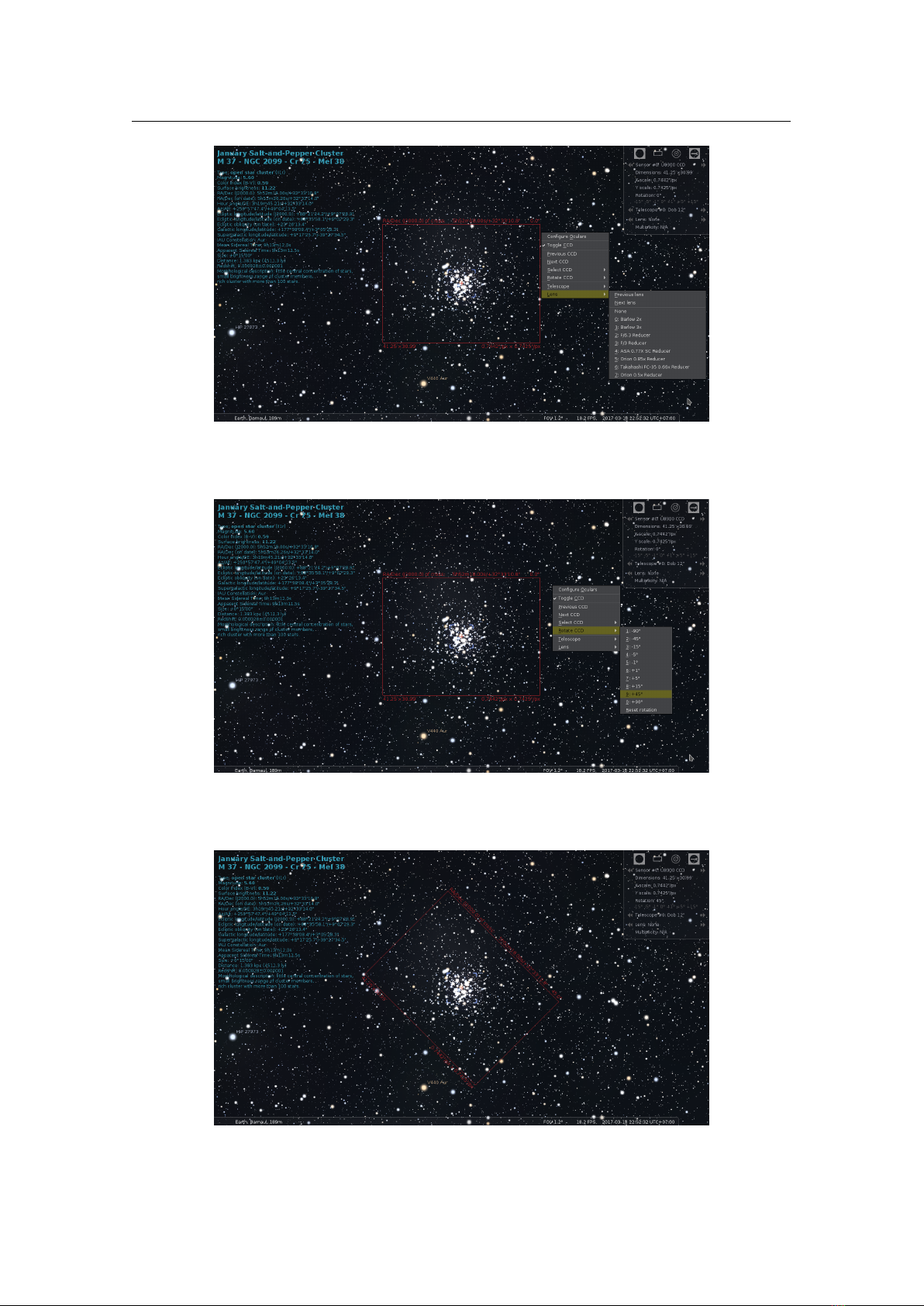
222 Chapter 16. Stellarium at the Telescope
Figure 16.5: The CCD sensor popup menu of the Oculars plugin.
Figure 16.6: Setting rotation of CCD sensor in the popup menu.
Figure 16.7: A rotated CCD sensor frame of the Oculars plugin.
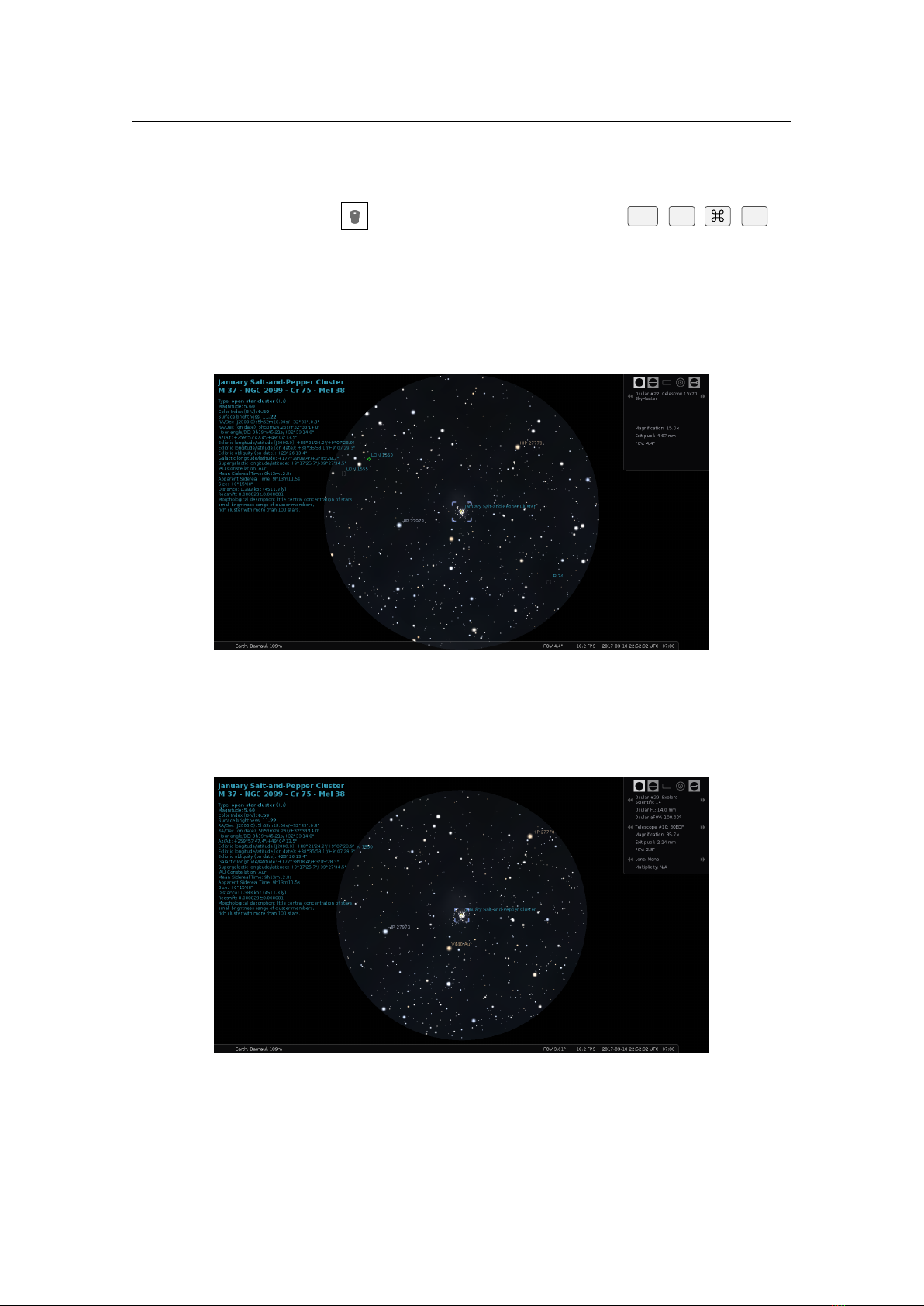
16.1 Oculars Plugin 223
Oculars
• Define some eyepieces and telescope (see section 16.1.2).
• Select an object to view (i.e. a star, planet, etc.)
•
Click the toolbar button for toggling the Ocular view, or press
Ctrl
+
O
(
+
O
for
Mac users).
• Swap between eye pieces and telescopes to see how the view changes.
This is really the area of interest to most telescopic observers. It is a great way to compare
different eyepiece/telescope combinations, to see how they change the view of the sky. And it is
easy to do so with binoculars too. To show this, let us use the M37 cluster as target. Through a pair
of Celestron 15x70 binoculars, it would look like in fig. 16.8.
Figure 16.8: The M37 cluster through a Celestron 15x70 binocular.
A very pretty sight. Now, what would it look like through a Celestron 80 mm EDF finder ’scope,
with an Explore Scientific 14 mm 100
◦
eyepiece? See fig. 16.9!
Figure 16.9: The M37 cluster through a Celestron 80 mm EDF with Explore Scientific
14 mm eyepiece.
Not bad at all. But we like to see more! So we move the eyepiece to a C1400. See fig. 16.10 for the
resulting view.
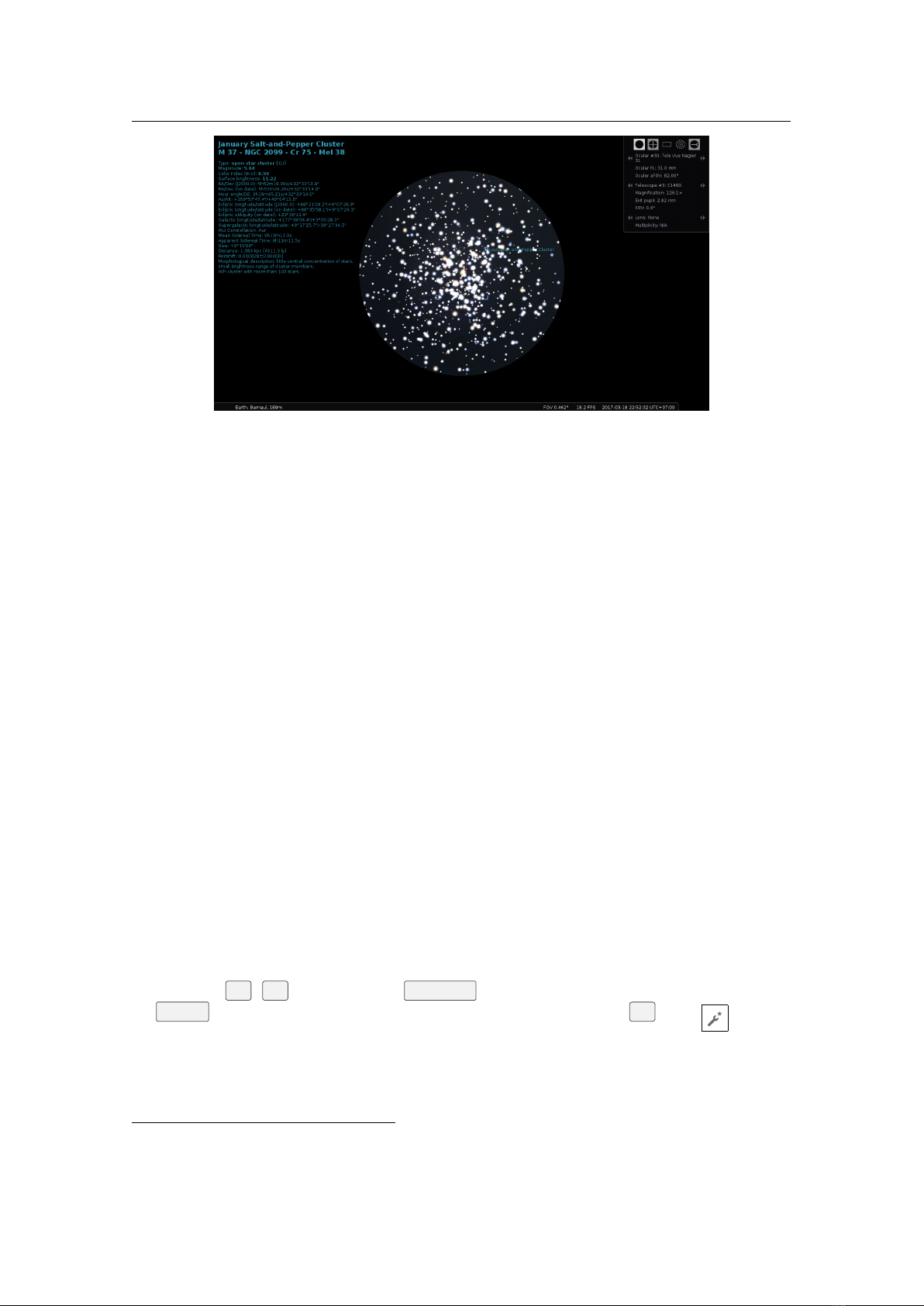
224 Chapter 16. Stellarium at the Telescope
Figure 16.10: The M37 cluster through a Celestron C1400 with Tele Vue Nagler 31 mm
eyepiece.
Very nice indeed! So for this target, the C1400 is going to be the best bet. However, if my
target was the Pleiades, the C1400 with that eyepiece would not be good — the 80EDF would do
much better!
When an eyepiece is active, the popup menu again changes. With a non-binocular eyepiece
selected, you also have the ability to select a particular eyepiece or telescope. When a binocular is
active, you can not select a telescope, as it is not relevant. Changing the eyepiece to a non-binocular
will again allow the telescope to be selected. Also notice that when your mouse cursor is very near
the right hand border of the screen, the popup menu’s sub-menus display to the left, not the right.
Star Scales
As you know from section 4.4.1, the number and relative size of stars of various magnitudes can be
adjusted to your personal preferences in the view settings window to approximate the appearance
of the stars as seen by the naked eye. Some observers prefer to have a simulated ocular view with
very small, or more, stars, quite different from what Stellarium usually shows. The Oculars plugin
therefore keeps two additional sets of scaling values for ocular views and CCD views, which are
activated automatically when you switch to ocular or CCD view, and which are stored immediately
and permanently in the plugin’s ocular.ini file.
1
16.1.2 Configuration
All configuration is done through the user interface in the application. To open the configuration
dialog hit the
Alt
+
O
key, or click the
configure
button on the plugin setup dialog (available in
the
Plugins
tab of Stellarium’s Configuration window (opened by pressing
F2
or the button in
the left toolbar)), or the rightmost button of the on-screen panel (if displayed in the top right corner
of screen). There are six tabs in the configuration dialog: General, Eyepieces, Lenses, Sensors,
Telescopes, and About. The first five are the ones we are interested in here.
1
The appearance of stars may depend on various other factors: telescope type, ocular type, quality of
optics, seeing, . . . Such details with all combinations cannot meaningfully be stored, though. These values
should allow a rapid toggle on any single night.
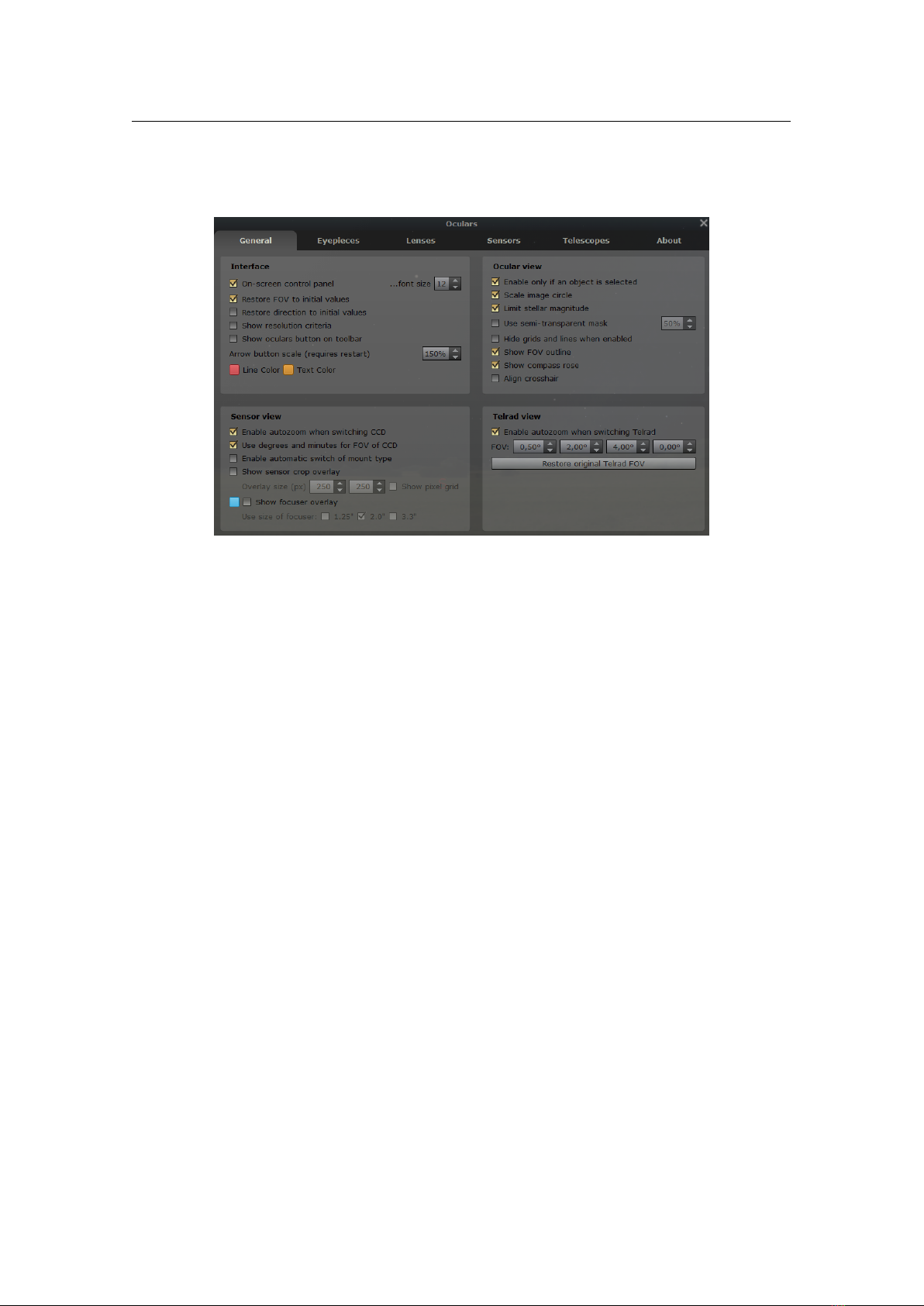
16.1 Oculars Plugin 225
General
The first option allows you to define the general behavior of the plugin. The options are grouped by
areas of usage: Interface, Ocular view, Sensor view and Telrad view (see figure 16.11).
Figure 16.11: General tab of the Oculars plugin configuration dialog.
Interface: this group of options allows to change behavior of the plugin in general.
On-screen control panel:
show an additional GUI panel in the top-right corner of the
screen to allow switching features of the plugin (in addition to the popup window).
Restore FOV to initial values and
Restore direction to initial values
options allow restoration field of view and direction of
view, resp., to the initial values at program start at the end of the plugin usage (e.g.,
when disabling the view through CCD frame).
Show resolution criteria
compute and show Rayleigh criterion, Dawes’, Abbe’s and Spar-
row’s limits for combination of telescope, lens and eyepiece. In addition, this option
will show visual resolution for selected “setup”. This option may be very helpful for
double star observers.
Show oculars button on toolbar
option allows to toggle visibility the plugin button on
main toolbar.
Arrow button scale
allows to change the size of the arrow buttons in the ocular GUI panel.
Line Color Select color for ocular and sensor outlines and their labels.
Text Color
Select color for screen messages which are shown only when the on-screen
control panel is not shown.
Ocular view
is a group of options that allows to change the plugin’s behavior in visual observation
mode.
Enable only if an object is selected
– uncheck this option if you want to use the visual
observation mode when no object is selected.
Auto-limit stellar magnitude
sets the magnitude limitation for stars based on telescope
diameter. When disabled, the main program’s setting applies (see section 4.4.1). Note
that two manual limits for ocular view and main program are handled, and switching
between ocular and main view also switches those values.
Hide grids and lines when enabled
allows to hide grids and lines when you observe the
sky through the eyepiece and re-enables their visibility when leaving visual observation
mode.

226 Chapter 16. Stellarium at the Telescope
Scale image circle
option allows you to define whether or not to scale the images based on
apparent FOV. When deactivated, the image circle will fill your screen. In general,
we recommend you not select this, unless you have a need to, because it can really
reduce the image size on the screen. It can however be very useful in comparing
two eyepieces. If you set this option, the on-screen image will be scaled based on
the eyepieces and telescopes you define. See section 16.1.3 for information on what
scaling means, and why you might want to use it.
Use semi-transparent mask
uncheck this option if you want to see visible field of view as
in real telescope. You may define level of transparency for mask.
Hide grids and lines when enabled
allows to hide grids and lines when you observe the
sky through the eyepiece and re-enables their visibility when leaving visual observation
mode.
Show FOV outline
option enables drawing the border of the eyepiece’s FOV and it may be
helpful in combination with a semi-transparent mask.
Show compass rose
option enables drawing cardinal directions in the equatorial coordinate
system.
Align crosshair
option enables alignment of the cross-hair according to the equatorial
coordinate system.
Sensor view
is group of options allows to change behavior of the plugin for photographic observa-
tions mode.
Enable autozoom when switching CCD
Use degrees and minutes for FOV of CCD
– for many cases the use of decimal degrees
for the value of the field of view is not comfortable, and this option allows to use the
more human readable format for FOV.
Use horizontal coordinates instead of equatorial (J2000.0) coordinates
in the top left
frame corner.
Show max exposure time for moving objects
For solar system objects, the top right edge
can indicate the maximum exposure time so that the object moves less than a pixel
against the stars.
Enable automatic switch of mount type
allows to store the CCD frame orientation when
the type of telescope mount is changed.
Show sensor crop overlay
toggles drawing a crop box within the CCD frame. In addition,
a pixel grid can be drawn within the crop overlay especially for astrophotographers.
Show focuser overlay
allows drawing a circle which represents the telescope’s focuser.
We added sizes of 3 common modern focusers to allow users to check the visible
aberrations in the FOV of the telescope.
Telrad view
is a group of options which allows to change behavior of the plugin for Telrad mode.
Enable autozoom when switching Telrad
option allows you to define whether or not to
zoom the field of view to twice the size of the Telrad circles.
FOV:
If you don’t use the original Telrad but a similar device, you may define up to 4
circles to show its specific FOV in the sky.
Eyepieces
This is the tab used to enter your own eyepieces (see figures 16.12 and 16.13). By default, a few
sample ones have been added; feel free to delete those once you’ve entered your own.
The fields on this tab are:
Name
– a free-text description of the eye piece. You could modify this to match your personal
descriptions of eyepieces.
aFOV – apparent field of view in degrees.
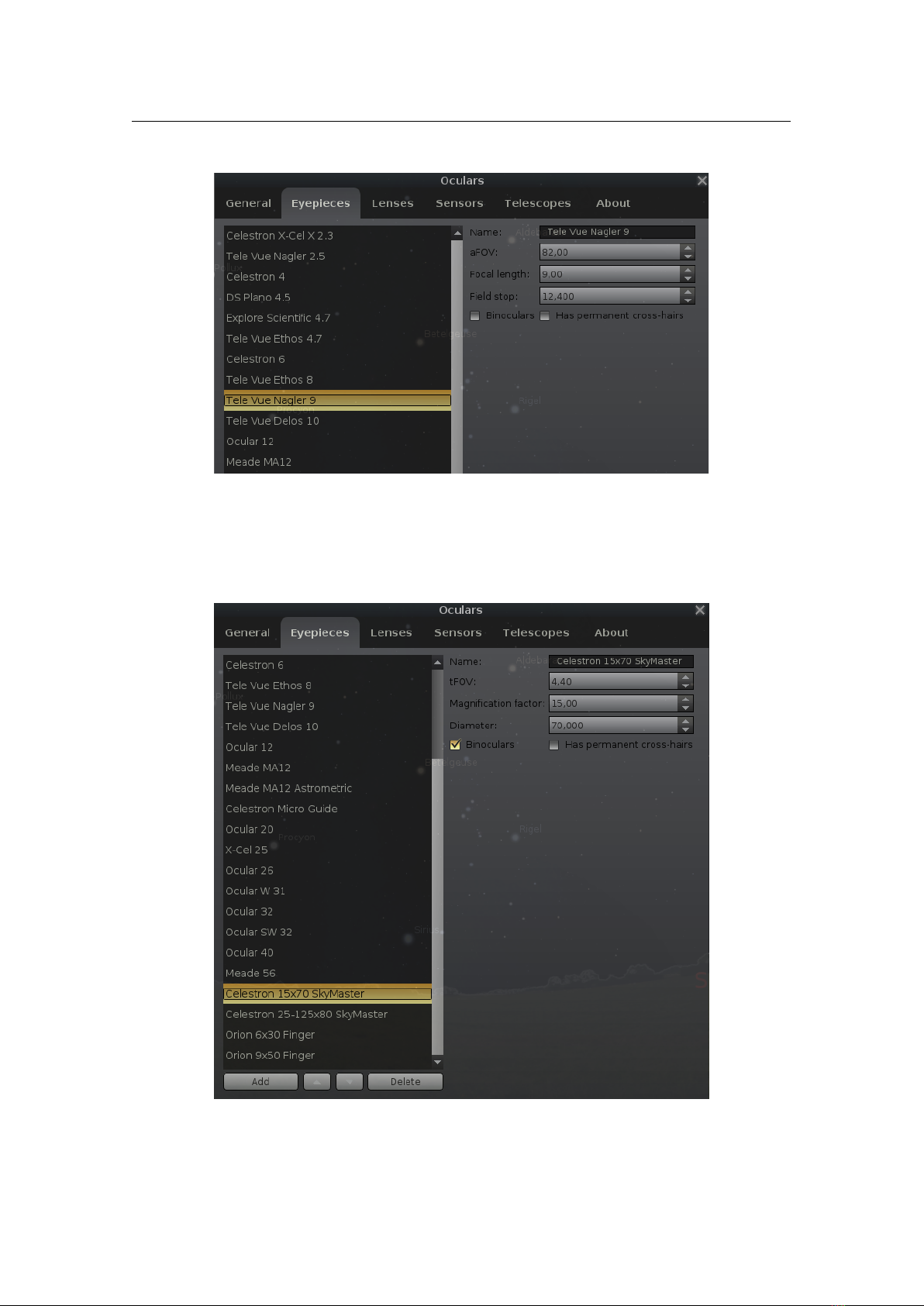
16.1 Oculars Plugin 227
Figure 16.12: Eyepieces tab of Oculars plugin configuration dialog.
Figure 16.13: Eyepieces tab of Oculars plugin configuration dialog (settings for binocular).
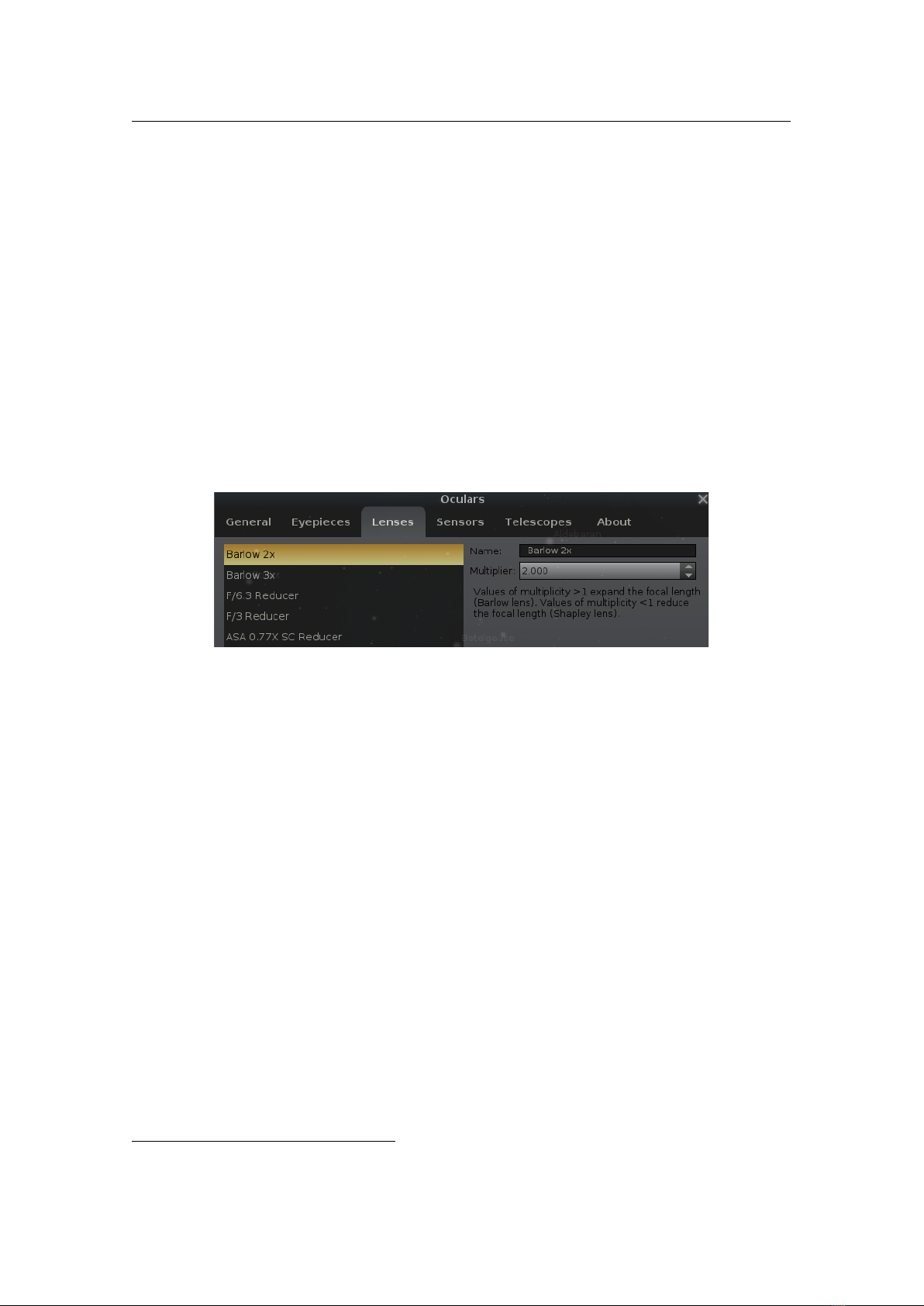
228 Chapter 16. Stellarium at the Telescope
Focal Length – eyepiece focal length in mm.
Field Stop
– the field stop of the eyepiece in
mm
. This is used to calculate the true field of view of
an eyepiece. If you do not know what it is just leave it the default zero. Not all manufacturers
provide this value; Tele Vue is one that does.
Binoculars
– selecting this checkbox tells the system that this eyepiece is binoculars or finders;
this means that this eyepiece can be used without defining a telescope.
Has permanent cross-hairs
– selecting this checkbox tells the system that this eyepiece or binoc-
ular (finder) has also simple cross-hairs
2
.
When Binoculars are described, the relevant fields change to
tFOV – true field of view in degrees.
Magnification factor – the magnification of the binocular.
Diameter – the diameter of the binocular objective in mm.
Lenses
This is the tab used to enter your own focal extender or reducer lenses (see figure 16.14). By default,
a few sample ones have been added; feel free to delete them once you’ve entered your own.
Figure 16.14: Lenses tab of Oculars plugin configuration dialog.
The fields on this tab are:
Name
– a free-text description of the lens. You could modify this to match your personal descrip-
tions of lenses.
Multiplier
– a factor larger than 1 expands the focal length, and lenses with this type are named
Barlow lens; a factor less than 1 reduces the focal length, and lenses with this type are named
Shapley lens or focus reducer.
Sensors
This tab allows you to define sensors for any camera you may have (see figure 16.15). When defined
and selected, this will draw a red bounding rectangle in the center of the eye piece view, showing
what the CCD will capture. Because of the way floating point numbers are stored, sometimes you
may see one of your defined values change (for example from 2.2 to 2.19999) but this should not
affect what you see.
The fields on this tab are:
Name – A free-text description of the sensor.
Resolution x – the width of the sensor in pixels.
Resolution y – the height of the sensor in pixels.
Chip width – the width of the sensor in mm.
Chip height – the height of the sensor in mm.
Rotation Angle – the rotation angle of the sensor, in degrees.
2
The Oculars plugin supports eyepieces with reticle patterns – both special eyepieces are available in the
default list of eyepieces, and the option Has permanent cross-hairs is not related to those eyepieces.
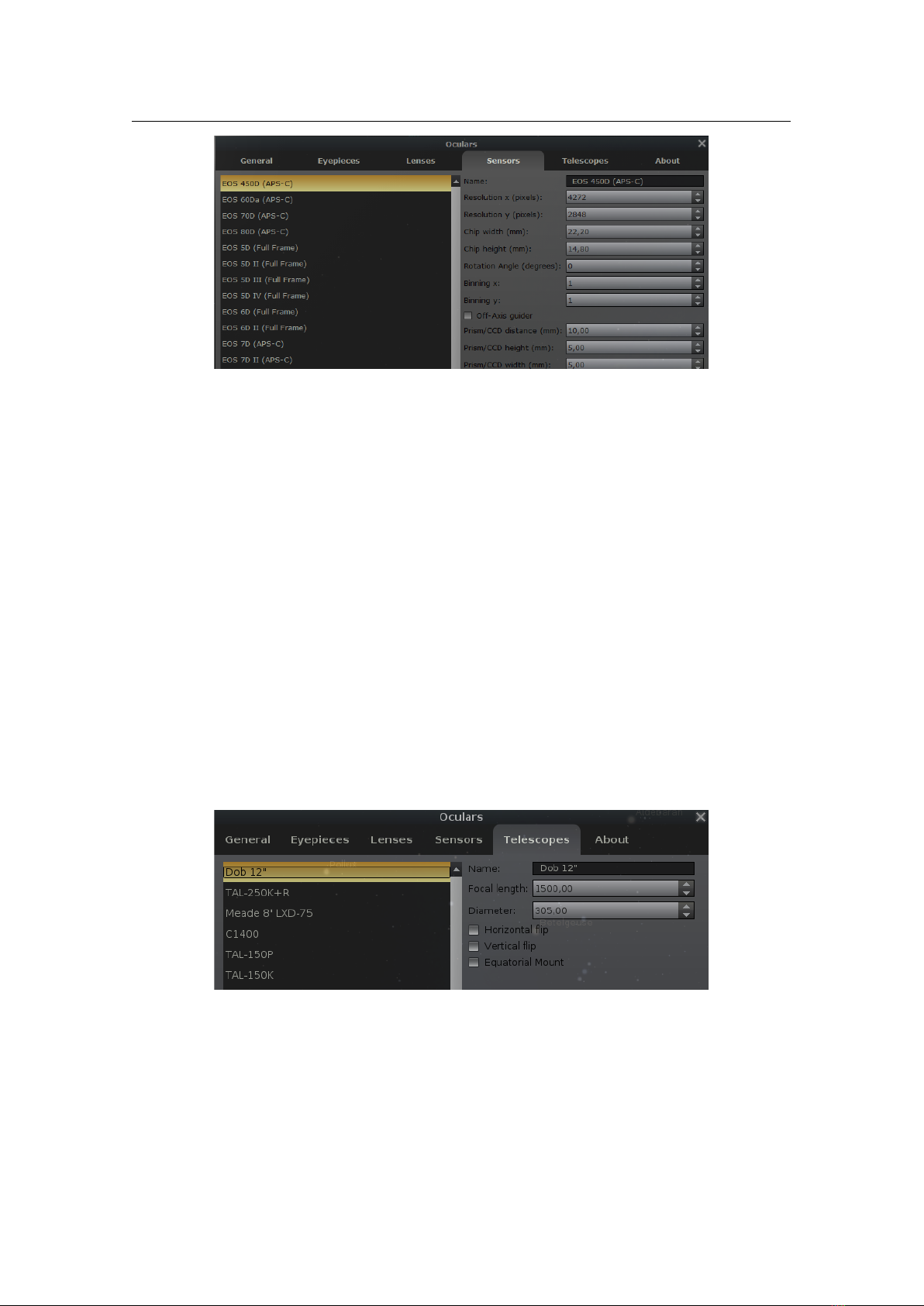
16.1 Oculars Plugin 229
Figure 16.15: Sensors tab of Oculars plugin configuration dialog.
Binning x – the binning factor for the width of the sensor.
Binning y – the binning factor for the height of the sensor.
Off-Axis guider
– selecting this checkbox tells the system that this sensor has support an off-axis
guider also.
Prism/CCD distance
– distance between center of prism/CCD of Off-Axis Guider and optical
axis of telescope in mm.
Prism/CCD width – the width of the prism/CCD of Off-Axis Guider in mm.
Prism/CCD height – the height of the prism/CCD of Off-Axis Guider in mm.
Position Angle – the position angle of the prism/CCD of Off-Axis Guider, in degrees.
The resolution is easy to find: these are simply the image dimensions of a (non-binned) frame. The
chip size and pixel size may be more difficult, but the manual, or searching the Internet, should turn
up these values. For a “full-frame” DSLR, this should be close to 36x24
mm
, while APS-C should
be around 22.5x15mm. Some cameras may have unsquare pixels.
Telescopes
This is the tab used to enter your own telescopes and photographic objectives (see fig. 16.16). The
fields on this tab are:
Figure 16.16: Telescopes tab of Oculars plugin configuration dialog.
Name – A free-text description of the telescope.
Focal Length – telescope focal length f in mm.
Diameter
– telescope diameter (aperture
) in
mm
. If you add a photographic objective that
does not provide this information but provides a largest f stop like “100
mm
f/2.8”, you can
estimate from = f /s, where s = 2.8 and thus = 100/2.8 = 35.7mm in this example.
Horizontal flip – if the view through this telescope should flip horizontally.

230 Chapter 16. Stellarium at the Telescope
Vertical flip – if the view through this telescope should flip vertically.
Equatorial Mount – select it if this telescope has an equatorial mount.
16.1.3 Scaling the eyepiece view
I (TR) would like to thank Al Nagler over at Tele Vue
3
for helping to set me straight on the topic of
eyepieces. They are a lot more complicated than you might think!
By default, the view drawn on your computer screen when the plugin is active fills the screen.
That is, there is a circle drawn to represent the view through the eyepiece, and this circle will fill
the screen. For general use, this is what most people would want. There will be times that it’s not.
If you are going to be observing any deep space object, it can be very important to choose the
best eyepiece for that object. You will typically want an eyepiece that will magnify the object as
much as possible, while showing all of the object in the eyepiece view. Getting this can be tricky,
especially if you do not like changing eyepieces at the telescope. Or maybe you want to understand
why one type of telescope may be better than another type for observing what you are interested in.
This is where you will want to scale the image on screen based on your eyepiece.
Different eyepieces generally have a different apparent field of view (aFOV). An easy way
to think about this is: the larger the aFOV, the bigger the picture you see in the eyepiece. Older
types of eyepiece (some types still built and in wide use today have been constructed in the 19th
century) generally have their aFOV in the
50
◦
range. Today, there are massive eyepieces available
with
82
◦
, and recently even
100
◦
aFOV! These eyepieces are huge, as they require a lot of very
special glass to achieve their incredible fields of view. An eyepiece of the same focal length with a
100
◦
aFOV will produce an image through the eyepiece that is twice as wide as one produced by a
50
◦
eyepiece.
Different telescopes, with an eyepiece of a given aFOV, will also produce a different true field
of view. This is the actual size of the piece of sky that you see through the eyepiece. Getting these
two “just right” can be very important. It’s easy to assume that you want the biggest telescope
you can get, with the eyepiece that gives you the highest magnification. This is never true in
reality. Depending on where you live, and especially what you like to look at, a 100-120
mm
quality
refractor with a wide aFOV eyepiece may very well be better than a large SCT with the same
eyepiece. This is something I learned the hard way.
So how does scaling the eyepiece view help? The plugin will find the eyepiece you have with
the largest aFOV. This aFOV becomes
100%
of the computer screen diameter. Then, any other
eyepiece will have its aFOV compared, and the view on screen will be scaled down accordingly.
These
100
◦
aFOV eyepieces makes the math here easy. If you have one, then when that eyepiece
is used, the circle that represents the view through the eyepiece will take up
100%
of the screen
diameter. Next, if you select an eyepiece with an
82
◦
aFOV, its view will be scaled to
82%
of the
screen, and a 62
◦
aFOV eyepiece will be scaled to 62% of the screen.
Example in action
This is easier to understand in action, so let us look at an example that uses three eyepieces all with
the same 17
mm
focal length, so they all produce the same level of magnification (well, one has
an 17.3
mm
focal length, but its magnification is nearly identical) and see how the view changes.
These example all use a Celestron C8 8" SCT telescope, and the target is the Great Orion Nebula.
We can see from the images in fig. 16.17 that the target is all three images is the same size.
The
100
◦
image fills the screen, the
82
◦
is smaller, and the
62
◦
is smallest yet, filling
62%
of the
computer screen. Note that in each image, the field of view that you see changes. The larger the
aFOV, the more you can see of the sky. So in this example, if you had an 8" telescope, you would
want to use the 17mm 100
◦
Ethos eyepiece to see as much of the nebula as possible.
3
https://www.televue.com/
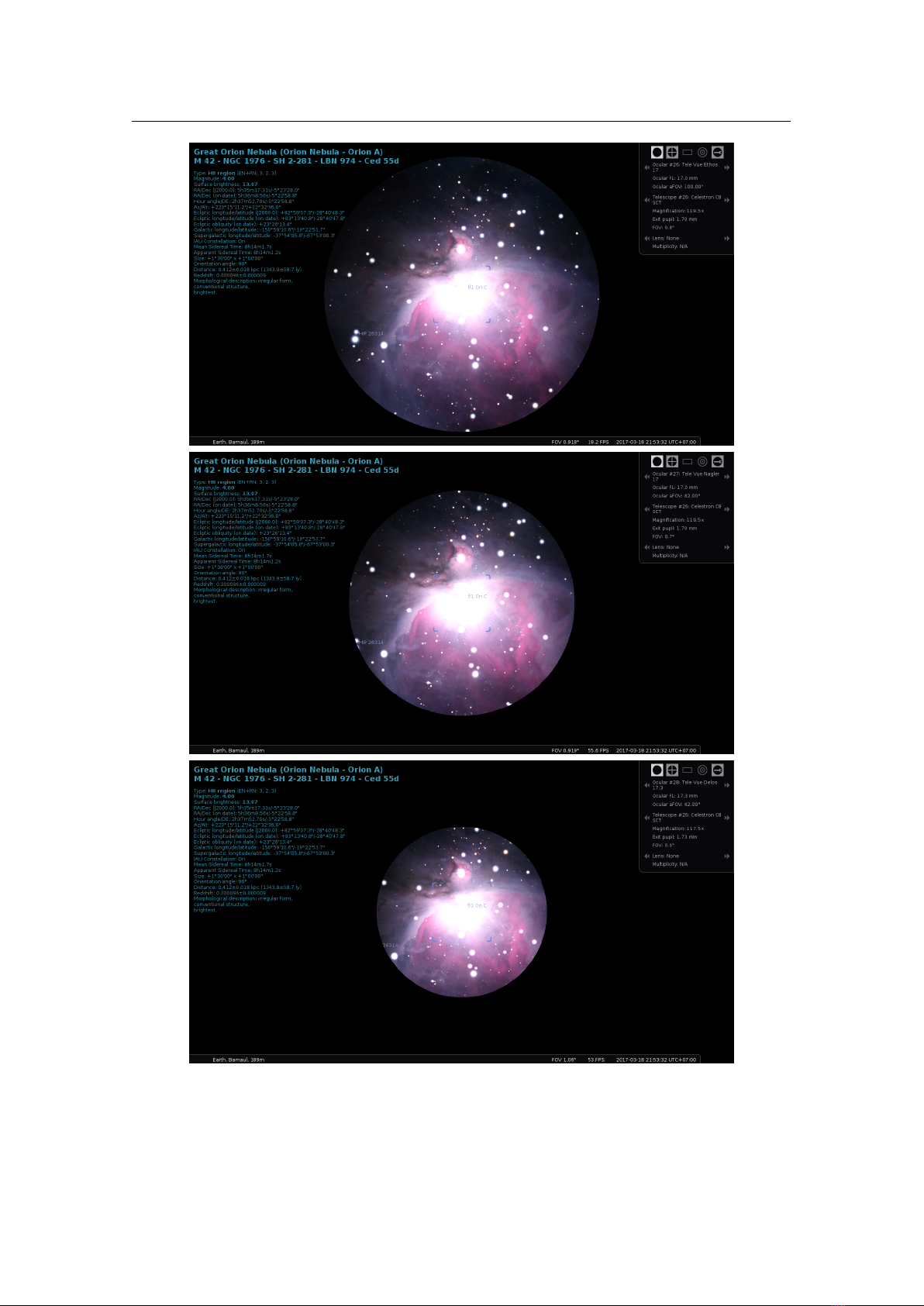
16.1 Oculars Plugin 231
Figure 16.17: Comparing apparent fields of view of (top) a 17
mm
Tele Vue Ethos eyepiece
with an aFOV of
100
◦
. Magnification is
119.5×
. (center) a 17
mm
Tele Vue Nagler
eyepiece with an aFOV of
82
◦
. Magnification is
119.5×
. (bottom) a 17.3
mm
Tele Vue
Delos eyepiece with an aFOV of 62
◦
. Magnification is 117.5×.

232 Chapter 16. Stellarium at the Telescope
16.2 TelescopeControl Plugin
This plugin provides a simple control mechanism for motorized telescope mounts. The user selects
an object (i.e. by clicking on something – a planet, a star etc.) and presses the telescope go-to key,
and the telescope will be guided to the object.
Multiple telescopes may be controlled simultaneously.
WARNING
Stellarium cannot prevent your telescope from being pointed at the Sun. It is up to you to ensure
proper filtering and safety measures are applied!
Never point your telescope at the Sun without a proper solar filter installed. The powerful light
amplified by the telescope WILL cause irreversible damage to your eyes and/or your equipment.
Even if you don’t do it deliberately, a slew during daylight hours may cause your telescope to
point at the sun on its way to the given destination, so it is strongly recommended to avoid using
the telescope control feature before sunset without appropriate protection.
16.2.1 Abilities and limitations
This plug-in allows Stellarium to send ’slew’ (’go to’) commands to the device and to receive its
current position. There are some scopes which additionally support ’sync’ commands to be received
in order to update the internal pointing model of the mount. Some scopes also have the ability
to abort a previous slew command. However, users should always be aware of the possibility for
mount collisions and similar situations. You should always make sure that a slew does not cause
parts of the telescope to collide with the environment or mount itself.
Currently this plug-in does not allow satellite tracking unless the controlled telescope is an
RTS2 system (see section 16.2.6), and is not very suitable for lunar or planetary observations. Many
mounts can be set to a ’lunar’ tracking speed, you may prefer this.
Some users are running Stellarium on little, low-power “Telescope computers” connected to
their powerful indoor PCs via RemoteDesktop or similar setups. Keep in mind that Stellarium
is a graphics-heavy program that may challenge the outdoor computer’s graphics subsystem or
network. See framerate intent settings on page 26 for optimizing your screen refresh rates. Better,
run Stellarium on your indoor system and use INDI or ASCOM protocols.
16.2.2 Using this plug-in
Here are two general ways to control a device with this plug-in, depending on the situation:
DIRECT CONNECTION
A device supported by the plug-in is connected with a cable to the
computer running Stellarium
INDIRECT CONNECTION
local
A device is connected to the same computer but it is driven by a stand-alone telescope
server program or a third-party application that can ’talk’ to Stellarium;
remote
A device is connected to a remote computer and the software that drives it can
’talk’ to Stellarium over the network; this software can be either one of Stellarium’s
stand-alone telescope servers, or a third party application.
Most older telescopes use cables that connect to a serial port (RS-232), the newer ones use USB
(Universal Serial Bus). On Linux and Max OS X, both cases are handled identically by the plug-in.
On Windows, a USB connection may require a ’virtual serial port’ software, if it is not supplied
with the cable or the telescope. Such a software creates a virtual (’fake’) COM port that corresponds
to the real USB port so it can be used by the plug-in. On all three platforms, if the computer
has no ’classic’ serial ports and the telescope can connect only to a serial port, a serial-to-USB
(RS-232-to-USB) adapter may be necessary.

16.2 TelescopeControl Plugin 233
Telescope set-up (setting geographical coordinates, performing alignment, etc.) should be done
before connecting the telescope to Stellarium.
16.2.3 Main window (’Telescopes’)
The plug-in’s main window can be opened:
•
By pressing the
configure
button for the plug-in in the
Plugins
tab of Stellarium’s Configu-
ration window (opened by pressing
F2
or the button in the left toolbar).
•
By pressing the
Configure telescopes...
button in the
Slew to
window (opened by pressing
Ctrl
+
0
or the respective button on the bottom toolbar).
The
Telescopes
tab displays a list of the telescope connections that have been set up:
•
The number (#) column shows the number used to control this telescope. For example, for
slewing telescope #2, the shortcut is
Ctrl
+
2
.
•
The Status column indicates if this connection is currently active or not. Unfortunately, there
are some cases in which ’Connected’ is displayed when no working connection exists.
• The Type field indicates what kind of connection this is:
virtual means a virtual telescope (test mode).
local, Stellarium means a DIRECT connection to the telescope (see above).
local, external
means an INDIRECT connection to a program running on the same com-
puter.
local, ASCOM
means an INDIRECT connection to a ASCOM driver running on the same
computer.
remote, unknown means an INDIRECT connection over a network to a remote machine.
remote, RTS2 means an INDIRECT connection over a network to an RTS2 server.
remote, INDI means an INDIRECT connection over a network to an INDI server.
To set up a new telescope connection, press the
Add
button. To modify the configuration of an
existing connection, select it in the list and press the
Configure
button. In both cases, a telescope
connection configuration window will open.
16.2.4 Telescope configuration window
Connection type
The topmost field represents the choice between the types of connections (see section 16.2.2):
Telescope controlled by:
Stellarium, directly through a serial port is the DIRECT case
External software or a remote computer is an INDIRECT case
RTS2 Telescope is another INDIRECT case
INDI is another INDIRECT case
ASCOM is another INDIRECT case
Nothing, just simulate one (a moving reticle) is a virtual telescope (no connection)
Telescope properties
Name is the label that will be displayed on the screen next to the telescope reticle.
Connection delay
If the movement of the telescope reticle on the screen is uneven, you can try
increasing or decreasing this value.
Coordinate system
Some Celestron telescopes have had their firmware updated and now interpret
the coordinates they receive as coordinates that use the equinox of the date (EOD, also
known as JNow), making necessary this setting. With ASCOM telescopes it’s also possible
to use this setting to override the default device preference.
Start/connect at startup
Check this option if you want Stellarium to attempt to connect to the

234 Chapter 16. Stellarium at the Telescope
telescope immediately after it starts. Otherwise, to start the telescope, you need to open the
main window, select that telescope and press the
Start/Connect
button.
Device settings
This section is active only for DIRECT connections (see above).
Serial port
sets the serial port used by the telescope. There is a pop-up box that suggests some
default values:
• On Windows, serial ports COM1 to COM10
•
On Linux, serial ports
/dev/ttyS0
to
/dev/ttyS3
and USB ports
/dev/ttyUSB0
to
/dev/ttyUSB3. Make sure you have read/write access to the tty device. Depending
on your flavour of Linux, this may e.g. require some group membership.
•
On Mac OS X, the list is empty as it names its ports in a peculiar way. If you are using
a USB cable, the default serial port of your telescope most probably is not in the list of
suggestions. To list all valid serial port names in Mac OS X, open a terminal and type:
ls / dev /*
This will list all devices, the full name of your serial port should be somewhere in the
list (for example, /dev/cu.usbserial-FTDFZVMK).
Device model : see 16.2.5 Supported devices.
Connection settings
Both fields here refer to INDIRECT connections, which implies communication over a network
(TCP/IP).
Host
can be either a host name or an IPv4 address such as ’127.0.0.1’. The default value of
’localhost’ means ’this computer’.
Modifying the default host name value makes sense only if you are attempting a remote
connection over a network. In this case, it should be the name or IP address of the computer
that runs a program that runs the telescope.
Port
refers to the TCP port used for communication. The default value depends on the telescope
number and ranges between 10001 and 10009.
RTS2 settings
(see also 16.2.6) You will need access to an RTS2 HTTPD server through HTTP/JSON calls. Please
see RTS2 documentation (man rts2-httpd) for details. You will as well need username and password
for HTTPD. Please be aware that in order to move the telescope, your user must have the telescope
in the list of allowed devices in the database. Please see
man rts2-user
for details on how to
manipulate RTS2 users.
URL
points to RTS2 HTTPD. Can include anything a URL can have - port (:8889) and prefix path
for RTS2 access.
Username username used for login to RTS2 HTTPD.
Password password for login to RTS2 HTTPD.
INDI settings
(see also 16.2.7) You will need access to an INDI server through a TCP/IP connection. Please see
INDI documentation for details. You will need to select the correct INDI device to manage it.
ASCOM settings
You can choose an ASCOM telescope driver installed in your system using the ASCOM chooser.
Additionally you can choose how Stellarium is determining the coordinate system used to commu-
nicate with the ASCOM mount. For more information, please see 16.2.8.

16.2 TelescopeControl Plugin 235
User Interface Settings: Field of view indicators
A series of circles representing different fields of view can be added around the telescope marker.
This is a relic from the times before the Oculars plug-in (see 16.1) existed.
Activate the ’Use field of view indicators’ option, then enter a list of values separated with
commas in the field below. The values are interpreted as degrees of arc.
These marks can be used in combination with a virtual telescope to display a moving reticle
with the Telrad circles.
’Slew telescope to’ window
The
Slew telescope to
window can be opened by pressing
Ctrl
+
0
or the respective button in
the bottom toolbar.
It contains two fields for entering celestial coordinates, selectors for the preferred format
(Hours-Minutes-Seconds, Degrees-Minutes-Seconds, or Decimal degrees), a drop-down list and
two buttons.
The drop-down list contains the names of the currently connected devices. If no devices are
connected, it will remain empty, and the
Slew
button will be disabled.
Pressing the
Slew
button slews the selected device to the selected set of coordinates. See the
section about keyboard commands below for other ways of controlling the device.
Pressing the
Configure telescopes. . .
button opens the main window of the plug-in.
TIP: Inside the ’Slew’ window, underlined letters indicate that pressing
Alt
+
underlined letter
can be used instead of clicking. For example, pressing
Alt
+
S
is equivalent to clicking the
Slew
button, pressing
Alt
+
E
switches to decimal degree format, etc.
Sending commands
Once a telescope is successfully started/connected, Stellarium displays a telescope reticle labelled
with the telescope’s name on its current position in the sky. The reticle is an object like every other
in Stellarium - it can be selected with the mouse, it can be tracked and it appears as an object in the
’Search’ window.
To point a device to an object: Select an object (e.g. a star) and press the number of the device
while holding down the
Ctrl
key. (For example,
Ctrl
+
1
for telescope #1.) This will move the
telescope to the selected object. Note that most telescopes can only execute a single command
to move to that object’s position, but if the telescope is an RTS2 telescope, you can even track a
satellite (if the mount then is fast enough to support it).
4
To point a device to the center of the view: Press the number of the device while holding down
the Alt key. (For example,
Alt
+
1
for telescope #1.) This will slew the device to the point in
the center of the current view. (If you move the view after issuing the command, the target won’t
change unless you issue another command.)
To point a device to a given set of coordinates: Use the
Slew to
window (press
Ctrl
+
0
).
16.2.5 Supported devices
Directly connected telescopes
All devices listed in the ’Device model’ list are convenience definitions using one of the two built-in
interfaces: the Meade LX200 (the Meade Autostar controller) interface and the Celestron NexStar
interface.
The device list contains the following:
Celestron NexStar (compatible) Any device using the NexStar interface.
4
Actually, the TLE orbital elements of the selected satellite are transmitted to RTS2, which does then
compute the satellite position itself.

236 Chapter 16. Stellarium at the Telescope
Losmandy G-11
A computerized telescope mount made by Losmandy (Meade LX-200/Autostar
interface).
Meade Autostar compatible Any device using the LX-200/Autostar interface.
Meade ETX-70 (#494 Autostar, #506 CCS)
The Meade ETX-70 telescope with the #494 Au-
tostar controller and the #506 Connector Cable Set. According to the tester, it is a bit slow,
so its default setting of ’Connection delay’ is 1.5 seconds instead of 0.5 seconds.
Meade LX200 (compatible) Any device using the LX-200/Autostar interface.
Sky-Watcher SynScan AZ mount
The Sky-Watcher SynScan AZ GoTo mount is used in a num-
ber of telescopes.
Sky-Watcher SynScan (version 3 or later)
SynScan is also the name of the hand controller used
in other Sky-Watcher GoTo mounts, and it seems that any mount that uses a SynScan
controller version 3.0 or greater is supported by the plug-in, as it uses the NexStar protocol.
Wildcard Innovations Argo Navis (Meade mode)
Argo Navis is a ’Digital Telescope Computer’
by Wildcard Innovations. It is an advanced digital setting circle that turns an ordinary
telescope (for example, a dobsonian) into a ’Push To” telescope (a telescope that uses a
computer to find targets and human power to move the telescope itself). Just don’t forget to
set it to Meade compatibility mode and set the baud rate to 9600B1.
RTS2 telescopes
Setting up a robotic telescope and dome control system with RTS2 is beyond the scope of this
handbook, but see section 16.2.6 for a few notes to be able to connect and command the telescope
with Stellarium. Please refer to the RTS2 Web pages
5
for further details.
Please be aware that some RTS2 usernames might have only read-only access. If this is case for
your username, the telescope marker will be painted red (or
color_telescope_readonly
from
Stellarium’s settings file).
INDI telescopes
Setting up a robotic telescope and dome control system with INDI is beyond the scope of this
handbook, but see section 16.2.7 for a few notes to be able to connect and command the telescope
with Stellarium. Please refer to the INDI web pages
6
for further details.
ASCOM telescopes
ASCOM specific settings can be configured when a ASCOM telescope was selected. Please see
section 16.2.8 for further information about configuration possibilities.
Virtual telescope
If you want to test this plug-in without an actual device connected to the computer, choose “Nothing,
just simulate one (a moving reticle)” in the
Telescope controlled by:
field. It will show a telescope
reticle that will react in the same way as the reticle of a real telescope controlled by the plug-in.
See the section above about field of view indicators for a possible practical application (emulating
’Telrad’ circles).
16.2.6 RTS2
RTS2, the Remote Telescope System 2, is a complete robotic observatory control system for Linux
by Petr Kubánek, who kindly provided the plugin code to make RTS2 interoperate with Stellarium.
We cannot give a full manual or any further support for RTS2 here, please refer to its website
7
for
5
https://rts2.org/
6
https://indilib.org
7
https://rts2.org

16.2 TelescopeControl Plugin 237
complete instructions about dome control, cameras, filter wheels, weather sensors, etc. A few notes
may be useful for beginners, though.
RTS2’s central piece is a daemon. Start the system:
sudo service rts2 start
RTS2’s main control screen is text-based, rts2-mon. For a quick check, switch on the system using
F9
. Telescope
T0
is a dummy telescope which you can select and operate with commands like
move 120 35
(this moves to RA=120
◦
=8h, DEC=35
◦
, but only when this position is above your
horizon).
Stellarium’s Telescope plugin can communicate with RTS2 using the RTS2 web interface. You
must run rts2-httpd for this, which may require the right permissions to write the lock files in
/var/run
. This program requires that a database has been created as described in the file
RUN
in
RTS2’s source directory and on the RTS2 website
8
. Also, you must create a ’user’ for RTS2. This
is not a regular Linux account, but an entry in the RTS2 database. Create a user with rts2-user -a
<user>. You should use a password different from your regular Linux password, as this will be
transmitted in plain text between the computer running Stellarium and the RTS2 control computer,
and may also be written into Stellarium’s logfile. Then you can enable device control for the
respective user. If you want to send slew commands from Stellarium, make sure to allow access to
telescope
T0
. If not, Stellarium will be able to show the telescope marker, but you will not be able
to control the telescope. To enable control for existing users in the default stars database,
psql stars
update users set allowed_d evi ces = ’* ’;
In case you cannot properly connect to the RTS2 telescope or cannot send slew commands,
check Stellarium’s logfile log.txt for some diagnostic messages.
RTS2 is the only type of telescope supported by Stellarium which can autonomously track
satellites. Tracking accuracy fully depends on Stellarium’s TLE satellite elements being up-to-date
(see section 14.8) and the accuracy of your RTS2 installation.
16.2.7 INDI
INDI, the Instrument Neutral Distributed Interface, is a distributed control system (DCS) protocol
to enable control, data acquisition and exchange among hardware devices and software front ends,
emphasizing astronomical instrumentation
9
.
INDI client (v1.6.0) has been incorporated into Stellarium’s Telescope Control plugin by
Alessandro Siniscalchi to allow Stellarium to communicate with INDI hardware drivers via INDI
server. INDI server is a hub that sits between drivers and clients. It reroutes traffic for control
and data across distributed networks. Each device or client in the network is a node and may
communicate with other nodes whenever desired. The server supports broadcasting, chaining, and
marshalling of data.
Stellarium only supports INDI mounts (no other INDI devices), and you will need to select the
correct INDI device to manage it at the stage of configuration of telescope. For this purpose the
plug-in has a tool to getting the list of connected devices from the INDI server (when the server is
working!). Please define hostname and port
10
in the “INDI Settings” block, press
Refresh devices
and select the required device in the list “Devices”.
List of telescope types supported by INDI
11
:
8
https://rts2.org/faq.html
9
https://en.wikipedia.org/wiki/Instrument_Neutral_Distributed_Interface
10
The Internet Assigned Numbers Authority (IANA) has assigned to INDI the Transmission Control
Protocol and User Datagram Protocol (TCP/UDP) port 7624.
11
https://indilib.org/devices/telescopes/all.html

238 Chapter 16. Stellarium at the Telescope
• Meade Autostar
• Meade LX200 (Classic/GPS/16)
• Celestron NexStar
• Celestron NexStar Evolution
• Orion Synscan Telescope
• EQ-6 MCU Update
• HEQ-5 MCU Update
• LittleFoot Vpower
• LittleFoot Elegance Photo
• Astro-Electronic FS-2
• EQMod
• Pulsar2
• SkySensor2000PC
• Takahashi Temma
• 10 Micron
• Losmandy Gemini
• Astrophysics
• Skywatcher Virtuoso (Alt/Az)
• IOptron IEQPro/CEM60
• IOptron ZEQ25/SmartEQ
• IOptron GotoNova Upgrade Kit 8400
16.2.8 ASCOM (Windows only)
ASCOM is probably the most widely used way how to communicate with telescopes, mounts and
other astronomy equipment on Microsoft Windows operating systems. The ASCOM platform aims
to decouple device dependent specifics by introducing a common standard for communication
between device drivers and applications. Almost every telescope mount comes with an ASCOM
driver and most of the astronomy software and tools can communicate with ASCOM compatible
devices.
The ASCOM telescope support has been added to Stellarium’s Telescope Control plugin by
Gion Kunz in version 0.19.3.
Note that in order for Stellarium to communicate with your ASCOM compatible mount, you
will need to have the ASCOM platform installed on your Windows machine (version 6 or higher
12
).
Also, the ASCOM driver of your telescope mount needs to be installed before you can start using
the telescope in Stellarium.
Important: Most modern ASCOM drivers are written to run in 32bit and 64bit mode (any) and
therefore are compatible with the 64bit and 32bit version of Stellarium. However, if you happen
to have a 32bit or 64bit only driver for your telescope mount, you will also need to install the
respective Stellarium version.
In order to use your ASCOM telescope you need to select the correct device in the ASCOM
chooser by clicking the button
Choose ASCOM telescope
. The selected device is shown below
that button.
By default, Stellarium is trying to ask the ASCOM driver in order to determine if JNow or
J2000 coordinates should be used for communicating with the mount. If you’d like to override this
behavior and tell the ASCOM telescope to communicate in the coordinate system configured in
the section Telescope properties, you can switch the radio button
Let ASCOM device decide
to
Use Stellarium settings
in the ASCOM settings of the Configure Telescope dialog.
12
https://ascom-standards.org/Downloads/Index.htm

16.2 TelescopeControl Plugin 239
16.2.9 StellariumScope
StellariumScope is a free add-on that enables you to control your ASCOM enabled telescope with
Stellarium.
Note that Stellarium supports ASCOM telescopes natively since version 0.19.3. There’s no
need to use StellariumScope in order to use your ASCOM telescopes with Stellarium anymore. We
are encouraging our users to use the native ASCOM option unless they need particular features of
StellariumScope.
The original StellariumScope program was designed and implemented by Scott of ByteArts
but is no longer available. It is now maintained by and available for download from Welsh Dragon
Computing
13
.
Features
• Provides an interface between Stellarium and ASCOM telescope drivers.
•
Provides the ability to both “Sync” and “Slew” the telescope. It’s also possible to issue a
stop/cancel command from Stellarium.
•
You can easily host Stellarium on one computer linked to another control computer that hosts
the telescope driver.
•
The installation program will automatically install the documentation, but the link to the
documentation is provided by the developer
14
so you can read it before installation.
Use this application (like all software that controls your mount) with supervision of your
mount’s movements.
16.2.10 Other telescope servers and Stellarium
Other developers have also been busy creating hard- and software often involving Arduino or
Raspberry Pi boards which can control GOTO or PUSHTO (manually driven but position-aware,
usually Dobsonian) telescopes and are ultimately controlled from Stellarium. Those are not related
nor authored by the Stellarium team, so while we welcome such development (esp. open-sourced)
in general, we cannot provide documentation nor any support.
A few examples:
iTelescope http://simonbox.info/index.php/astronomy/93-raspberry-pi-itelesc
ope
node-telescope-server https://www.npmjs.com/package/node-telescope-server
OnStep https://groups.io/g/onstep
One anonymous user sent a troubleshooting solution when connecting Stellarium to the Cele-
stron NexRemote software:
One tricky Window XP issue I fixed was that my older laptop would transiently lose
connection with Stellarium although the status would still be “Connected” and all
looked normal. [. . . ]
I boosted the NexRemote.exe process in Windows XP to High under Set Priority under
the Windows Task Manager via
Ctrl
+
Alt
+
Del
.
All slews now proceed normally. Problem went away.
15
13
http://welshdragoncomputing.ca/ x/index.php/home/ stellariumscope/about-stellar
iumscope
14
StellariumScope User’s Guide —
http://welshdragoncomputi n g . ca/x/st/misc/stellari
umscope_user_guide.2016.03.05.pdf
15
ht tps://sourceforge.net/p/stellarium /discussion/278769/ thread/16e4c054/?li mi
t=25#8ffa

240 Chapter 16. Stellarium at the Telescope
16.3 Observability Plugin
This Plugin is activated with the button . It analyzes the observability of the selected object
(or the screen center, if no object is selected). The plugin can show the best epoch of the year (i.e.,
largest angular separation from the Sun), the date range when the source is above the horizon at
dark night, and the dates of Acronychal and Cosmical rise/set. Ephemerides of the Solar-System
objects and parallax effects are taken into account.
Explanation of some parameters
Sun altitude at twilight
Any celestial object will be considered visible when the Sun is below this
altitude. The altitude at astronomical twilight ranges usually between -12 and -18 degrees.
This parameter is only used for the estimate of the range of observable epochs (see below).
Horizon altitude
Minimum observable altitude (due to mountains, buildings, or just a limited
telescope mount).
Acronychal/Cosmical/Heliacal rise/set
The days of Cosmical rise/set of an object are estimated
as the days when the object rises (or sets) together with the rise/set of the Sun. The exact
dates of these ephemeris depend on the Observer’s location. On the contrary, the Acronycal
rise (or set) happens when the star rises/sets with the setting/rising of the Sun (i.e., opposite
to the Sun). On the one hand, it is obvious that the source is hardly observable (or not
observable at all) in the dates between Cosmical set and Cosmical rise. On the other hand,
the dates around the Acronychal set and rise are those when the altitude of the celestial
object uses to be high when the Sun is well below the horizon (hence the object can be
well observed). The date of Heliacal rise is the first day of the year when a star becomes
visible. It happens when the star is close to the eastern horizon roughly before the end of the
astronomical night (i.e., at the astronomical twilight). In the following nights, the star will
be visible during longer periods of time, until it reaches its Heliacal set (i.e., the last night
of the year when the star is still visible). At the Heliacal set, the star sets roughly after the
beginning of the astronomical night.
Largest Sun separation
Happens when the angular separation between the Sun and the celestial
object are maximum. In most cases, this is equivalent to say that the Equatorial longitudes of
the Sun and the object differ by 180 degrees, so the Sun is in opposition to the object. When
an object is at its maximum possible angular separation from the Sun (no matter if it is a
planet or a star), it culminates roughly at midnight, and on the darkest possible area of the
Sky at that declination. Hence, that is the ’best’ night to observe a particular object.
Nights with source above horizon
The program computes the range of dates when the celestial
object is above the horizon at least during one moment of the night. By ’night’, the program
considers the time span when the Sun altitude is below that of the twilight (which can be set
by the user; see above). When the objects are fixed on the sky (or are exterior planets), the
range of observable epochs for the current year can have two possible forms: either a range
from one date to another (e.g., 20 Jan to 15 Sep) or in two steps (from 1 Jan to a given date
and from another date to 31 Dec). In the first case, the first date (20 Jan in our example) shall
be close to the so-called ’Heliacal rise of a star’ and the second date (15 Sep in our example)
shall be close to the ’Heliacal set’. In the second case (e.g., a range in the form 1 Jan to 20
May and 21 Sep to 31 Dec), the first date (20 May in our example) would be close to the
Heliacal set and the second one (21 Sep in our example) to the Heliacal rise. More exact
equations to estimate the Heliacal rise/set of stars and planets (which will not depend on the
mere input of a twilight Sun elevation by the user) will be implemented in future versions of
this plugin.
Full Moon
When the Moon is selected, the program can compute the exact closest dates of the

16.3 Observability Plugin 241
Moon’s opposition to the Sun.
Note on Terminology
The (sparse) literature on terminology about computing these Heliacal, Acronychal or Cosmic
events seems to disagree on which end of the night is to be computed. While all agree about Heliacal
rises taking place in the morning, Acronychal and Cosmic are sometimes applied in reverse order
from those described here. In case you use these data, make sure you keep this definition as well.
Author
This plugin has been contributed by Ivan Marti-Vidal (Onsala Space Observatory)
16
with some
advice by Alexander Wolf and Georg Zotti.
16
mailto:i.martividal@gmail.com

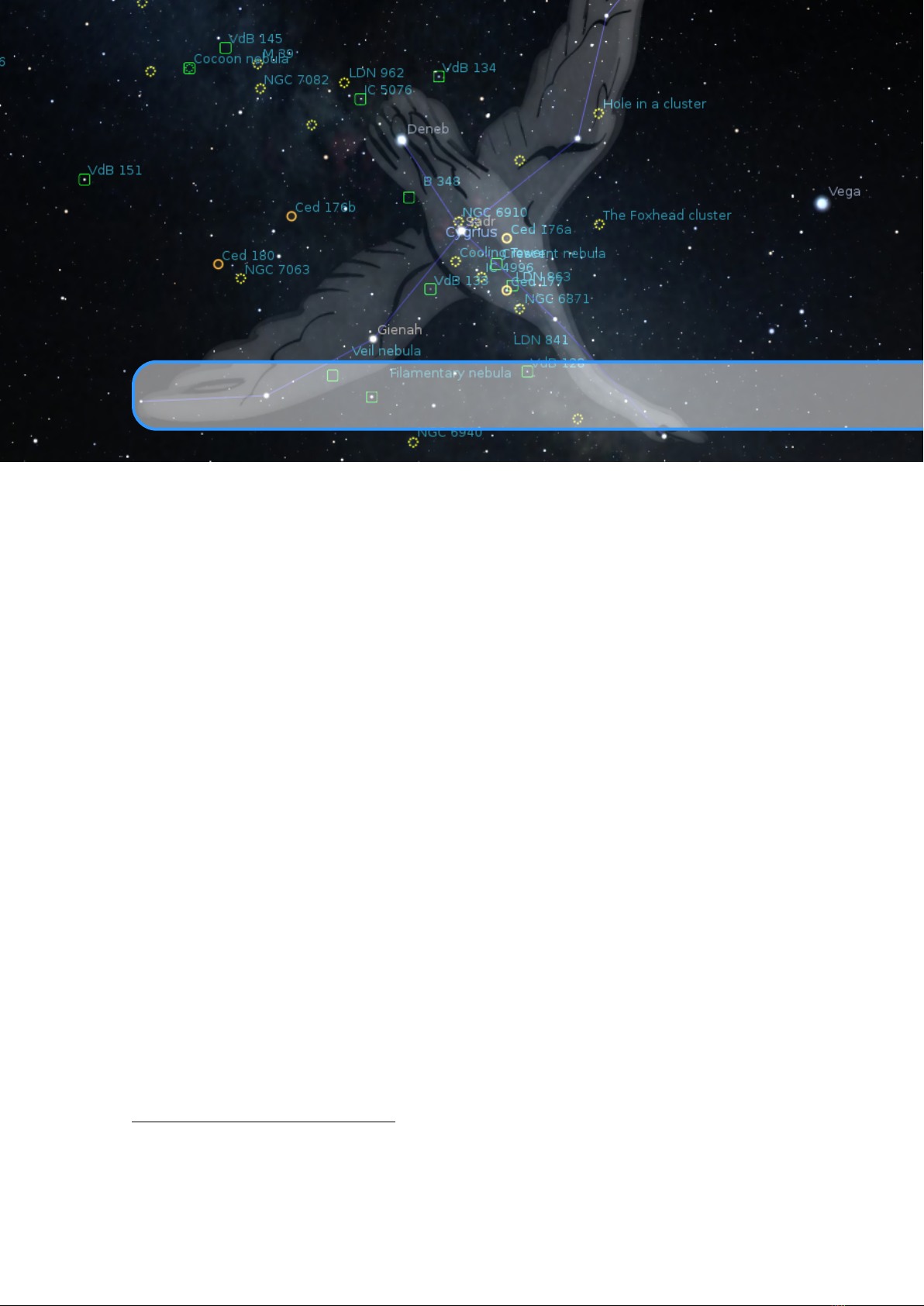
17. Scripting
A. WOLF, G. ZOTTI, WITH ADDITIONS BY WOLFGANG LAUN
17.1 Introduction
The scripting facility is Stellarium’s version of a Presentation, a feature that may be used to run an
astronomical or other show for instruction or entertainment from within the Stellarium program.
The use of scripts was recognized as a perfect way of arranging a presentation of a sequence of
astronomical events from the earliest versions of Stellarium.
The original Stratoscript was quite limited in what it could do, and so a new Stellarium Scripting
System has been developed.
Since version 0.10.1, Stellarium has included a scripting feature based on the Qt5 Scripting
Engine
1
. This made it possible to write small programs within Stellarium to produce automatic
presentations, set up custom configurations, and to automate repetitive tasks. By version 0.14.0 the
new scripting engine had reached a level where it had all required features for usage, and support
of scripts for the old Stratoscript engine has been discontinued.
The programming language ECMAScript
2
(also known as JavaScript) gives users access to
all basic ECMAScript language features such as flow control, variables, string manipulation and
so on. Its integration with Qt’s QtScript module and the way Stellarium’s main components
(“StelModule”s) have been designed to work means that all module functions which are labeled as
“slots” can be called from JavaScript.
Interaction with Stellarium-specific features is done via a collection of objects which represent
components of Stellarium itself. The various modules of Stellarium, and also activated plugins, can
be called in scripts to calculate, move the scene, switch on and off display of objects, etc. You can
write text output into text files with the
output()
command. You can call all public slots which
are documented in the scripting API documentation
3
.
1
https://doc.qt.io/qt-5/qtscript-index.html
2
https://en.wikipedia.org/wiki/ECMAScript
3
https://www.stellarium.org/doc/23.0/scripting.html

244 Chapter 17. Scripting
With the adaptation to Qt6 in versions 1.0 and later we had to switch to yet another scripting
engine in 2022. Qt6 comes with QJSEngine
4
, another JavaScript engine which behaves mostly
similar to the older QtScript. However, small differences exist, so that care must be taken if scripts
should be developed for both series of Stellarium. Some older scripts will not work on versions 1.0
and later or at least require some adaptations described in section 17.5.
17.2 The Script Console
It is possible to load, edit, run and save scripts using the script console window. To toggle the script
console, press
F12
.
17.2.1 The Tabs in the Console
The three tabs “Script”, “Log” and “Output” each provide a text field. In the “Script” text field you
can edit a script, which can be loaded from and saved to a file, and executed. The “Log” text field
receives all errors and other messages resulting from the script’s execution; the “Output” text field
will show the results of core.output() function calls.
The fourth tab, “Settings”, provides some configuration options.
17.2.2 The Menu Bar
The menu bar contains buttons for loading and saving a script. A file dialog is shown for selecting
the file. The “clear” button lets you clear the contents of the text field in the currently selected
tab. The drop-down menu “Execute:” offers a selection of menu entries, mainly intended to let
you restore the sky to a clean state. The entry “selected text as script” executes selected text
in the “Script” text field, allowing to test scripts during development. Entries “remove screen
text”, “remove screen images” and “remove screen markers” remove labels, images and markers,
respectively, that may have been left over on the screen from previous script actions. Each of
the “clear map” entries results in a call to
core.clear()
, using one of the arguments “natural”,
“starchart”, “deepspace”, “galactic” or “supergalactic”. These calls reset Stellarium’s state, resulting
in a basic state of the display and providing a clean starting point for another run of your script.
The button SSC runs the Stellarium Script Preprocessor with the script in the text field as
input and produces an output by recursively inserting all included scripts into the text. This output
replaces the contents of the Script text field. Store the original script if you need it!
17.2.3 German Keyboards
There is a glitch in the keyboard module of the underlying system that is responsible for keyboard
handling. It affects users of Windows and Linux systems with a German, and probably also other
international keyboards: The key combinations
AltGr
+
8
and
AltGr
+
9
cannot be used for
typing
[
and
]
. You need to work around by copy-pasting these two characters. You can also try to
use a command line argument like -platform windows:altgr.
17.3 Includes
Stellarium provides a mechanism for splitting scripts into different files. Typical functions or lists
of variables or celestial objects can be stored in separate
.inc
files and used within other scripts
through the include() command:
include("common_objects .inc");
4
https://doc.qt.io/qt-6/qtjavascript.html

17.4 Minimal Scripts 245
17.4 Minimal Scripts
This script prints “Hello Universe” in the Script Console log window and into log.txt:
core.debug("Hello Universe ");
This script prints “Hello Universe” in the Script Console output window and into the file
output.txt
which you will also find in the user data directory. The absolute path to the file will also be given in
log.txt.
core.output("Hello Universe ");
The file
output.txt
will be rewritten on each run of Stellarium. In case you need to save a copy
of the current output file to another file, call
core.saveOutputAs(" myImportantData .txt");
core.resetOutput();
This script uses the LabelMgr module to display “Hello Universe” in red, fontsize 20, on the screen
for 3 seconds.
var label=LabelMgr.labelScreen(" Hello Universe ", 200, 200,
true, 20, "#ff0000 ");
core.wait(3);
LabelMgr.deleteLabel(label);
17.5 Critical Scripting Differences introduced with version 1.0
Qt5’s QtScript module which has been used in versions 0.10 to 0.22 was more flexible and easier to
fine-tune than Qt6’s QJSEngine, which is used in the 1.* series of the program, i.e., versions 1.0
(22.3) and later. Still, most scripts that have been developed for Stellarium versions 0.10 to 0.22
still run without or with just minor modifications as described in this section.
17.5.1 Pause/Resume
The Qt6-based builds (version 1.0 and later) do not offer a way to pause and resume a script as was
available in the Qt5-based builds (0.10 to 0.22).
17.5.2 The Vec3f problem
One of the most important little helper classes in the main program are three-dimensional vectors.
Vec3f
describe those with single-precision floating point data, and
Vec3d
are those with double-
precision floating point data.
As late as in version 0.19 we added
Vec3f
and later
Vec3d
data types to the Javascript
environment. These allowed addressing variables of C++ classes
Vec3f
or
Vec3d
with named
sub-fields
r
,
g
,
b
(if used to describe colors), or
x
,
y
,
z
(same data but contextually understood
as 3D data). These functions may have pleased the JavaScript connoisseur when running scripts
with Qt5-based builds of Stellarium (series 0.*, now usually found on 32-bit systems), but we
recommend to abstain from their use in new scripts.
Qt6’s scripting module cannot be extended that easily. The
Vec3d
and
Vec3f
data types are not
directly scriptable, but we can deal with method arguments of these types when they are mentioned
in the API documentation (see 17.1). To access internals of these classes, we must use wrapper
classes which bear different names:
V3d can be used where Vec3d must be accessed.
V3f can be used where Vec3f must be accessed.

246 Chapter 17. Scripting
Input Result with Qt5 Result with Qt6
x var f1=new V3d(.1,.2,.3);
core.output(f1); [0.1, 0.2, 0.3] V3d(0x249a1cf37c0) [some address]
core.output(+f1.toString()); [0.1, 0.2, 0.3] V3d(0x249a1cf37c0) [some address]
x core.output(f1.toHex()); #19334c #19334c
x core.output(f1.toVec3d()); [0.1, 0.2, 0.3] [0.1, 0.2, 0.3]
x var f2=new V3d(f1.x(), 2*f1.y(), 3*f1.z());
core.output(f2); [0.1, 0.4, 0.9] V3d(0x249a1cf3a60) [some address]
x core.output(f2.toVec3d()); [0.1, 0.4, 0.8999999999999999] [0.1, 0.4, 0.9]
x var crimson=new Color("Crimson");
x core.output(crimson.toHex()); #dc143c #dc143c
core.output(crimson.toVec3f()); [r:0.8627451062202454, g:0.0784313753247261, b:0.23529411852359772] [0.862745, 0.0784314, 0.235294]
core.output(crimson.r); 0.8627451062202454 error
core.output(crimson.r()); error 0.8627451062202454
x core.output(crimson.getR()); 0.8627451062202454 0.8627451062202454
x core.output(crimson.getG()); 0.0784313753247261 0.0784313753247261
x core.output(crimson.getB()); 0.23529411852359772 0.23529411852359772
crimson.g=0.444; (works) (error)
crimson.setG(0.444); (error) (works)
x crimson=new Color(crimson.getR(), 0.444, crimson.getB()); (reassign crimson; recommended for Qt5 and Qt6)
x core.output(crimson.toRGBString()); [r:0.862745, g:0.444, b:0.235294] [r:0.862745, g:0.444, b:0.235294]
x var eq=new Color(GridLinesMgr.getColorEquatorJ2000Grid());
x core.output(eq.toHex()); #00aaff #00aaff
core.output(eq.toVec3f()); [r:0, g:0.6666669845581055, b:1] [0, 0.666667, 1]
core.output(eq.toVec3d()); (n.a.) [0, 0.666667, 1]
core.output(eq.toString()); [0, 0.666667, 1] Color(0x24a11712910) [some address]
x core.output(eq.toRGBString()); [r:0, g:0.666667, b:1] [r:0, g:0.666667, b:1]
x var c=new Color(core.vec3f(.3, .4, .5));
core.output(c.toString()); [0.3, 0.4, 0.5] Color(0x249a1e078b0) [some address]
core.output(c.toVec3f()); [r:0.30000001192092896, g:0.4000000059604645, b:0.5] [0.3, 0.4, 0.5]
x var d=c; // assign to other
core.output(d.toVec3f()); [r:0.30000001192092896, g:0.4000000059604645, b:0.5] [0.3, 0.4, 0.5]
x var c2=new Color(.3, .4, .5);
core.output(c2.toString()); [0.3, 0.4, 0.5] Color(0x24a11712a60) [some address]
core.output(c2.toVec3f()); [r:0.30000001192092896, g:0.4000000059604645, b:0.5] [0.3, 0.4, 0.5]
x var d2=c2; // assign to other
core.output(d2.toVec3f()); [r:0.30000001192092896, g:0.4000000059604645, b:0.5] [0.3, 0.4, 0.5]
Table 17.1: Use of V3d, V3f and Color wrapper classes. Only use the calls marked with x in scripts targeted at all versions of Stellarium.
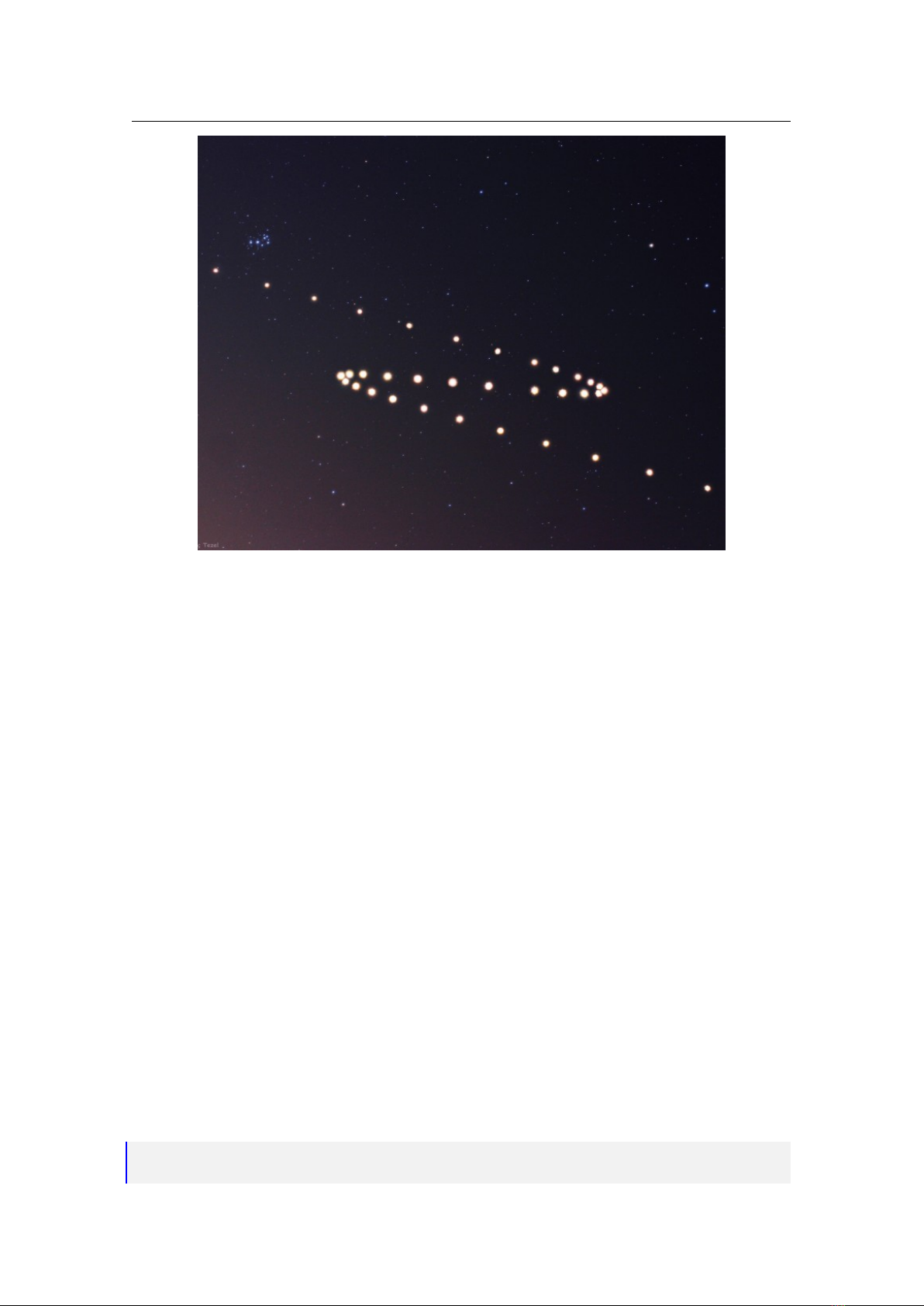
17.6 Example: Retrograde motion of Mars 247
Figure 17.1: Retrograde motion of Mars in 2005. (Credit & Copyright: Tunc Tezel — APOD:
2006 April 22 – Z is for Mars.)
Color can be used where a Vec3f must be accessed which represents a color value.
They behave slightly different when run using Qt5 or Qt6, as shown in Table 17.1. If you aim
for maximum compatibility between versions, only use the calls which provide equal results in both
series. This current state is far from optimal or even pretty, but a pragmatic solution that works. We
invite advanced developers to find a better solution that works with both Qt5 and Qt6.
17.6 Example: Retrograde motion of Mars
A good way begin writing of scripts: set yourself a specific goal and try to achieve it with the help
of few simple steps. Any complex script can be split into simple parts or tasks, which may solve
any newbie problems in scripting.
Let me explain it with examples.
Imagine that you have set a goal to make a demonstration of a very beautiful, but longish
phenomenon — the retrograde motion of the planet Mars (Fig. 17.1).
17.6.1 Script header
Any “complex” script should contain a few lines in the first part of the file, which contains important
data for humans — the name of the script and its description — and some rules for Stellarium.
You can even assign default shortcuts in the script header, but make sure you assign a key not used
elsewhere! The shortcuts are read during startup from all scripts in the
scripts
sub-directories of
both program and user data directories (see section 5.2). The description may cover several lines
(until the end of the commented header) and should therefore be the last entry of the header.
//
// Name: Retrograde motion of Mars

248 Chapter 17. Scripting
// Author : John Doe
// License : Public Domain
// Version : 1.0
// Shortcut: Ctrl+M
// Description : A demo of retrograde motion of Mars.
//
17.6.2 A body of script
At the first stage of writing of the script for a demo of retrograde motion of Mars we should set
some limits for our demo. For example we want to see motion of Mars every day during 250 days
since October
1
st
, 2009. Choosing a value of field of view and of the coordinates of the center of
the screen should be done at the this stage also.
Let’s add few lines of code into the script after the header and run it:
core.setDate("2009 -10 -01 T10 :00:00 ");
core.moveToRaDec("08 h44m41s ", "+18 d09m13s ",1);
StelMovementMgr.zoomTo(40, 1);
for (i=0; i<250; i++)
{
core.setDate("+ 1 days ");
core.wait(0.2);
}
OK, Stellarium is doing something, but what exactly is it doing? The ground and atmosphere is
enabled and any motion of Mars is invisible. Let’s add an another few lines into the script (hiding
the landscape and atmosphere) after setting date and time:
LandscapeMgr.setFlagLandscape(false);
LandscapeMgr.setFlagAtmosphere(false);
The whole sky is moving now — let’s lock it! Add this line after previous lines:
StelMovementMgr.setFlagLockEquPos(true);
It looks better now, but what about cardinal points, elements of GUI and some “glitch of
movement”? Let’s change the script:
core.setDate("2009 -10 -01 T10 :00:00 ");
LandscapeMgr.setFlagCardinalsPoints(false);
LandscapeMgr.setFlagLandscape(false);
LandscapeMgr.setFlagAtmosphere(false);
core.setGuiVisible(false);
core.moveToRaDec("08 h44m41s ", "+18 d09m13s ",1);
StelMovementMgr.setFlagLockEquPos(true);
StelMovementMgr.zoomTo(40, 1);
core.wait(2);
for (i=0; i<250; i++)
{
core.setDate("+ 1 days ");
core.wait(0.2);
}
core.setGuiVisible(true);
It’s better, but let’s draw the “path” of Mars! Add those line before the loop:

17.6 Example: Retrograde motion of Mars 249
core.selectObjectByName("Mars", false);
SolarSystem.setFlagIsolatedTrails(true);
SolarSystem.setFlagTrails(true);
Hmm. . . let’s add a few strings with info for users (insert those lines after the header):
var color = "# ff9900 ";
var info = LabelMgr.labelScreen("A motion of Mars", 20, 20,
false, 24, color);
var apx = LabelMgr.labelScreen(" Setup best viewing angle , FOV
and date / time .", 20, 50, false, 18, color);
LabelMgr.setLabelShow(info, true);
LabelMgr.setLabelShow(apx, true);
core.wait(2);
LabelMgr.setLabelShow(apx, false);
Let’s add some improvements to display info for users — change in the loop:
var label = LabelMgr.labelObject(" Normal motion , West to
East ", "Mars ", true, 16, color, "SE");
for (i=0; i<250; i++)
{
core.setDate("+ 1 days ");
if ((i % 10) == 0)
{
var strDate = "Day " + i;
LabelMgr.setLabelShow(apx, false);
var apx = LabelMgr.labelScreen(strDate, 20,
50, false, 16, color);
LabelMgr.setLabelShow(apx, true);
}
if (i == 75)
{
LabelMgr.deleteLabel(label);
label = LabelMgr.labelObject(" Retrograde or
opposite motion begins ", "Mars ",
true, 16, color, "SE");
core.wait(2);
LabelMgr.deleteLabel(label);
label = LabelMgr.labelObject(" Retrograde
motion ", "Mars ", true, 16, color,
"SE");
}
if (i == 160)
{
LabelMgr.deleteLabel(label);
label = LabelMgr.labelObject(" Normal motion
returns ", " Mars ", true, 16, color,
"SE");
core.wait(2);
LabelMgr.deleteLabel(label);
label = LabelMgr.labelObject(" Normal motion ",

250 Chapter 17. Scripting
"Mars ", true, 16, color, "SE");
}
core.wait(0.2);
}
17.7 More Examples
The best source of examples is the
scripts
sub-directory of the main Stellarium source tree. This
directory contains a sub-directory called
tests
which are not installed with Stellarium, but are
nonetheless useful sources of example code for various scripting features.

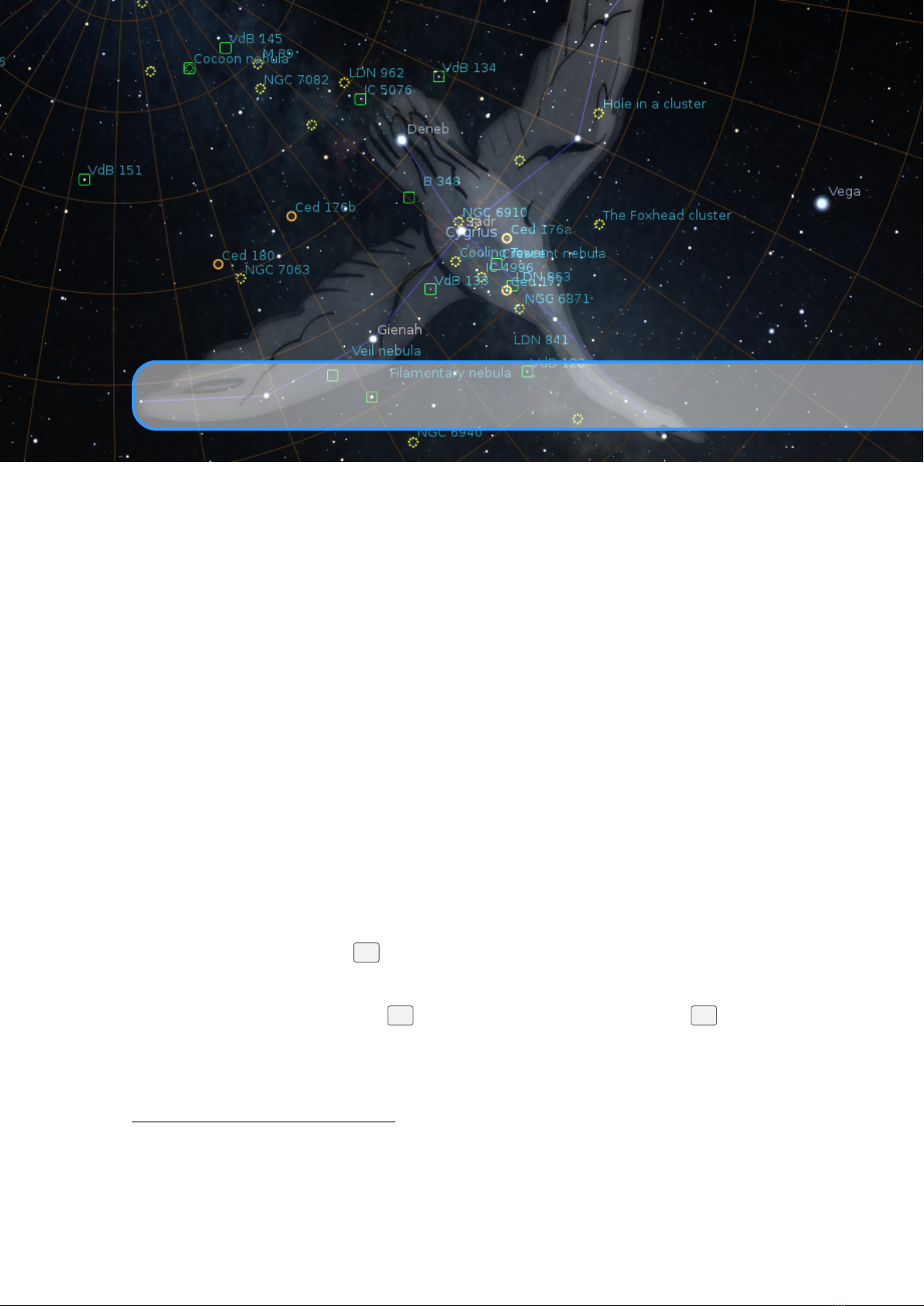
18. Astronomical Concepts
BARRY GERDES, WITH ADDITIONS BY GEORG ZOTTI
This section includes some general notes on astronomy in an effort to outline some concepts that
are helpful to understand features of Stellarium. Material here is only an overview, and the reader is
encouraged to get hold of a couple of good books on the subject. A good place to start is a compact
guide and ephemeris such as the National Audubon Society Field Guide to the Night Sky
1
. Also
recommended is a more complete textbook such as Universe
2
. There are also some nice resources
on the net, such as the Wikibooks Astronomy book
3
.
18.1 The Celestial Sphere
The Celestial Sphere is a concept which helps us think about the positions of objects in the
sky. Looking up at the sky, you might imagine that it is a huge dome or top half of a sphere (a
hemisphere), and the stars are points of light on that sphere. Visualizing the sky in such a manner,
it appears that the sphere moves, taking all the stars with it — it seems to rotate. Watching the
movement of the stars we can see that they seem to rotate around a static point about once a day
(the diurnal motion). Stellarium is the perfect tool to demonstrate this!
1.
Open the location dialog (
F6
). Set the location to be somewhere in mid-northern latitudes.
(Just click on the map to select a location, or fine-tune with the settings.) The United
Kingdom is an ideal location for this demonstration.
2.
Turn off atmospheric rendering
A
and ensure cardinal points are turned on (
Q
). This will
keep the sky dark so the Sun doesn’t prevent us from seeing the motion of the stars when it
is above the horizon.
3. Pan round to point north, and make sure the field of view is about 90
◦
.
4. Pan up so the ‘N’ cardinal point on the horizon is at the bottom of the screen.
1
https://www.amazon.com/National-Audubon-Society-Field-Series/dp/0679408525
2
https://www.amazon.com/Universe-Definitive-Visual-Martin-Rees/dp/0756636701
3
https://en.wikibooks.org/wiki/Subject:Astronomy

254 Chapter 18. Astronomical Concepts
5.
Now increase the time rate. Press
K
,
L
,
L
,
L
,
L
– this should set the time rate so
the stars can be seen to rotate around a point in the sky about once every ten seconds. If
you watch Stellarium’s clock you’ll see this is the time it takes for one day to pass at this
accelerated rate.
The point which the stars appear to move around is one of the Celestial Poles.
The apparent movement of the stars is due to the rotation of the Earth. Our location as the
observer on the surface of the Earth affects how we perceive the motion of the stars. To an observer
standing at Earth’s North Pole, the stars all seem to rotate around the zenith (the point directly
upward). As the observer moves south towards the equator, the location of the celestial pole moves
down towards the horizon. At the Earth’s equator, the North Celestial Pole appears to be on the
northern horizon.
Similarly, observers in the southern hemisphere see the Southern Celestial Pole at the zenith
when they are at the South Pole, and it moves to the horizon as the observer travels towards the
equator.
1.
Leave time moving on nice and fast, and open the configuration window. Go to the location
tab and click on the map right at the top – i.e., set your location to the North Pole. See how
the stars rotate parallel to the horizon, around a point right at the top of the screen. With the
field of view set to
90
◦
and the horizon at the bottom of the screen, the top of the screen is
the zenith.
2.
Now click on the map again, this time a little further south. You should see the positions of
the stars jump, and the center of rotation has moved a little further down the screen.
3.
Click on the map even further towards and equator. You should see the centre of rotation
having moved down again.
To help with the visualization of the celestial sphere, turn on the equatorial grid by clicking the
button on the main toolbar or pressing the
E
key. Now you can see grid lines drawn on the sky.
These lines are like lines of longitude and latitude on the Earth, but drawn for the celestial sphere.
The Celestial Equator is the line around the celestial sphere that is half way between the
celestial poles – just as the Earth’s equator is the line half way between the Earth’s poles.
18.2 Coordinate Systems
18.2.1 Altitude/Azimuth Coordinates
The Horizontal Coordinate System (also called Altitude/Azimuth coordinate system) can be used
to describe a direction of view (the azimuth angle) and an angular height in the sky (the altitude
angle). The azimuth angle is measured clockwise round from due north
4
. Hence North itself is 0
◦
,
East
90
◦
, Southwest is
225
◦
and so on. The altitude angle is measured up from the mathematical
horizon, which is just halfway between “straight up” and “straight down”, without regard to the
landscape. Looking directly up (at the zenith) would be
90
◦
, half way between the zenith and the
horizon is 45
◦
and so on. The point opposite the zenith is called the nadir.
The Altitude/Azimuth coordinate system is attractive in that it is intuitive – most people are
familiar with azimuth angles from bearings in the context of navigation, and the altitude angle is
something most people can visualise pretty easily.
However, the altitude/azimuth coordinate system is not suitable for describing the general
position of stars and other objects in the sky – the altitude and azimuth values for a celestial object
change with time and the location of the observer.
4
In some textbooks azimuth is counted from south. There is no global authority to decide upon this issue,
just be aware of this when you compare numbers with other sources.
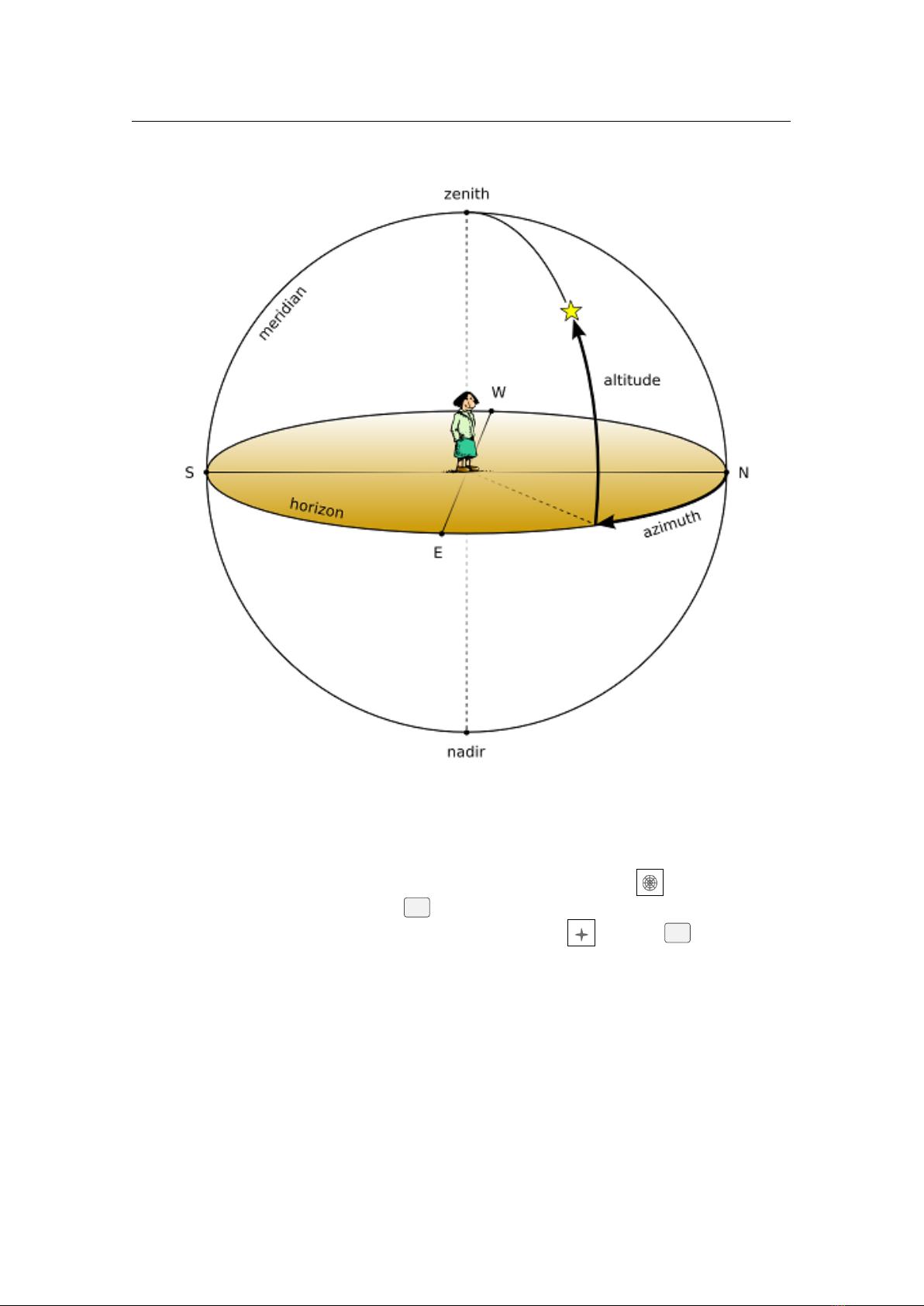
18.2 Coordinate Systems 255
Figure 18.1: Altitude/Azimuth (Horizontal) Coordinate System
Stellarium can draw grid lines for altitude/azimuth coordinates. Use the button on the main
toolbar to activate this grid, or press the
Z
key.
In addition, the cardinal points can be highlighted using the button or
Q
key.
There are a few great circles with special names which Stellarium can draw (see section 4.4.4).
Meridian
This is a great circle which runs through the North Pole towards the zenith and further
to the South Pole and nadir.
(Mathematical) Horizon This is the line exactly 90
◦
away from the zenith.
First Vertical
This is the vertical circle perpendicular to the horizon and which runs from the East
point through the zenith, down the West point and to the nadir.
18.2.2 Right Ascension/Declination Coordinates
Like the Altitude/Azimuth system, the Right Ascension/Declination (RA/Dec) Coordinate System
(or Equatorial Coordinate System) uses two angles to describe positions in the sky. These angles
are measured from standard points on the celestial sphere. Right ascension
α
and declination
δ
are
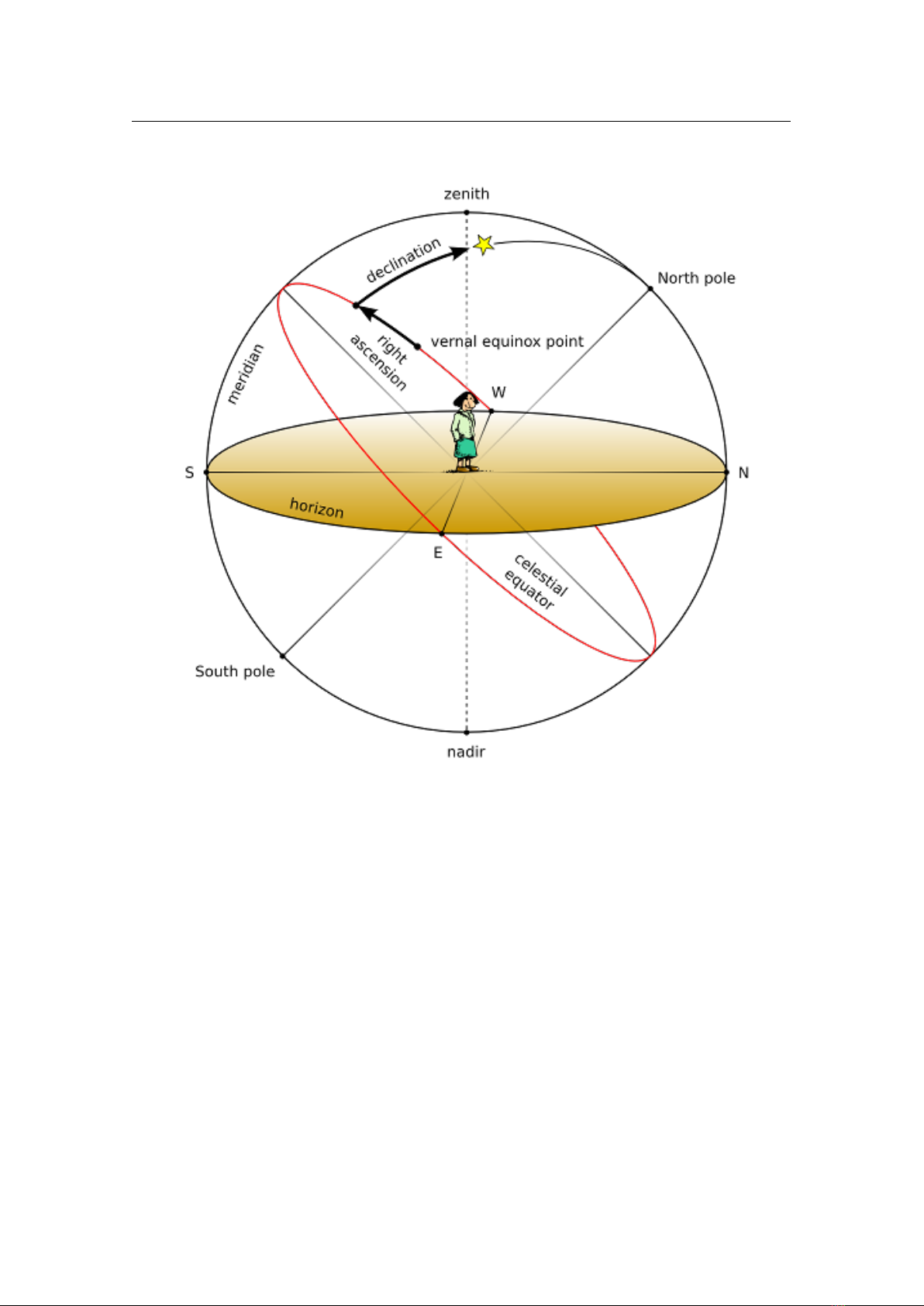
256 Chapter 18. Astronomical Concepts
Figure 18.2: Equatorial Coordinates
to the celestial sphere what longitude and latitude are to terrestrial map makers.
The Northern Celestial Pole has a declination of
δ = 90
◦
, the celestial equator has a declination
of δ = 0
◦
, and the Southern Celestial Pole has a declination of δ = −90
◦
.
Right ascension is measured as an angle round from the vernal equinox, a point in the sky also
known as the First Point of Aries
à
, in the same way that longitude is measured around the Earth
from Greenwich. Figure 18.2 illustrates RA/Dec coordinates. The angle
α
is usually expressed as
time with minute and seconds, with 15
◦
equaling one hour.
Unlike Altitude/Azimuth coordinates, RA/Dec coordinates of a star do not change when the
observer changes latitude, and do not change noticeably over the course of the day due to the
rotation of the Earth. RA/Dec coordinates are generally used nowadays in star catalogs such as the
Hipparcos catalog.
However, the story is complicated a little by precession (section 18.8) and parallax (sec-
tion 18.9). Precession causes a slow drift of the coordinates almost parallel to the ecliptic, and
therefore star catalogs always have to specify their equinox of validity.

18.2 Coordinate Systems 257
Current catalogs and atlases use coordinates for the standard epoch J2000.0. The currently best
defined coordinate system, the International Celestial Reference Frame (ICRF), is one particular
version described in detail in the astronomical literature (Urban and Seidelmann, 2013). Other
catalogs with data referring to “J2000.0” may have to be slightly adjusted (usually in sub-arcsecond
rotations) to match the ICRF coordinate system (short ICRS).
Stars close to the celestial poles are permanently visible above the horizon and thus called
circumpolar. Those stars have observable upper and lower culminations when they pass the
meridian arc spanning from the celestial pole over the zenith to the opposite point on the horizon,
or from the celestial pole to the horizon below, respectively.
Those circumpolar stars which show their upper culmination between pole and zenith also have
limits in azimuth which they can reach in their daily course, the points of greatest digression. At
these points they move vertically upwards (in the east) or downwards (in the west), respectively.
Stellarium can draw grid lines for equatorial coordinates. Use the button on the main
toolbar to activate this grid, or press the
E
key to draw the equatorial grid for the simulation time.
The Markings dialog (4.4.4) allows you to set also the grid for J2000.0 standard coordinates.
There are again a few great circles with special names which Stellarium can draw in addition,
both for simulation time and for J2000.0 (see section 4.4.4).
Celestial Equator
the line directly above the Earth’s (or more generally, the observer’s planet’s)
equator.
Colures
These are lines similar to meridian and first vertical in the azimuthal system. The
Equinoctial Colure runs from the North Celestial Pole NCP through the First Point of Aries
à
, South Celestial Pole SCP and First Point of Libra
æ
, while the Solstitial Colure runs
from the NCP through First Point of Cancer ã, SCP and First Point of Capricorn é.
In case you are observing from another celestial object, the equatorial coordinates use a system
similar to the one referring to the Earth-based coordinates, but parallel to the planet’s rotational
axis.
18.2.3 Fixed Equatorial Coordinates
The celestial sphere with its stars and other objects located in equatorial coordinates seems to rotate
around the celestial polar axis. When observing with a telescope, it proved useful to mount the
instrument on an axis which is aimed to be parallel to the earth’s axis, i.e., points to the celestial
pole. In this case, after setting the objects’s declination, it is enough to move the telescope around
this polar axis to track its course over time and keep the object in the field of view. We can describe
the Fixed Equatorial Coordinate System as an intermediate coordinate system which uses the
same equator and declination as the equatorial system, but does not rotate as time goes by. The
longitudinal coordinate is counted in hours from the meridian towards the west and is aptly named
Hour Angle. A star which has passed the meridian will reach hour angle of 1 hour one sidereal hour
later.
Stellarium can display the fixed equatorial coordinates in the Markings dialog (4.4.4).
18.2.4 Ecliptical Coordinates
The Earth’s orbit around the Sun, i.e., the ecliptic, defines the “equatorial line” of this coordinate
system, which is traditionally used when computing the coordinates for planets because of their
close proximity to this line. Mirroring Earth’s motion, the Sun is seen to move along the ecliptic.
The zero point of ecliptical longitude
λ
is the same as for equatorial coordinates (
à
), and
the ecliptical latitude
β
is counted positive towards the Northern Ecliptical Pole NEP in the
constellation of Draco.
Moon and Sun (and to a much lesser extent, the other planets) pull on the equatorial bulge and
try to put Earth’s axis normal to its orbital plane. Earth acts like a spinning top and evades this pull

258 Chapter 18. Astronomical Concepts
in a sideways motion, so that Earth’s axis seems to describe a small circle over a period of almost
26.000 years (see section 18.8).
In addition, ecliptic obliquity against the equatorial coordinates, which mirrors the Earth’s axial
tilt, slowly changes.
Therefore, also for ecliptical coordinates it is required to specify which date (epoch) the
coordinates refer to. Stellarium can draw grids for two epochs. Use the
,
key to draw the ecliptic
for the simulation time. The Markings dialog (4.4.4) allows you to add date marks to the ecliptic
line and also show a line for epoch J2000.0 and grids for the ecliptical coordinates for current epoch
v 23.1
and epoch J2000.0. You can assign your own shortcut keys (section 4.8) if you frequently operate
with these coordinates.
Since version 0.14.0 Stellarium can very accurately show the motions between the coordinate
systems (Vondrák, Capitaine, and Wallace, 2011; Vondrák, Capitaine, and Wallace, 2012), and it is
quite interesting to follow these motions for several millennia. To support such demonstrations,
Stellarium can also draw the precession circles between celestial and ecliptical poles (activate
them in the Markings dialog (4.4.4). However, these circles are simply plotted centered on the
instantaneous ecliptic pole by the instantaneous value of obliquity. If you observe long enough, you
will see that these circles vary in size, reflecting the changes in ecliptic obliquity. The real track of
where Earth’s axis is pointing forms an open helical loop.
The inner planets are best observed when their apparent distance from the Sun, or elongation,
reaches a maximum. Unfortunately there are two definitions for elongation, though:
ψ angular distance on the sphere. This is today the most widely used definition.
∆λ
À
difference between solar and the object’s ecliptical longitude. The advantage of using this
definition is that we can easily read opposition (
∆λ
À
= 180
◦
) and conjunction (
∆λ
À
= 0
◦
).
We can also see whether we have eastern elongation (
∆λ
À
> 0
) where the planet is visible in
the evening sky, or western elongation (
∆λ
À
< 0
) where the planet is visible in the morning
sky. For the inner planets Mercury and Venus we further discern superior conjunction,
when the planet is “above”, or behind, the Sun, and inferior conjunction, when the planet is
“below”, or closer than, the Sun.
Many of the minor bodies are best observed around the times of their opposition. Stellarium
can display a great circle in the ecliptical coordinates which runs through the ecliptic poles and
through the Sun, thereby allowing to estimate opposition and conjunction. Activate display of
this Opposition/Conjunction Line in the Markings dialog (Labeled “O./C. longitude”; 4.4.4). The
Markings dialog also provides the possibility to visualize the antisolar point, which lies opposite of
the Sun, on the intersection of the ecliptic and the O/C line.
Another interesting aspect of planets is their quadrature from the Sun. Here their angular
distance is 90
◦
. You can activate display of the quadrature circle in the Markings dialog (4.4.4).
It is interesting to note that star catalogs before TYCHO BRAHE’s (1546–1601), most notably
the one in PTOLEMY’s Almagest, used ecliptical coordinates. The reason is simple: it was known
since HIPPARCHUS that stellar coordinates slowly move along the ecliptic through precession, and
the correction to coordinates of a date of interest was a simple addition of a linear correction to the
ecliptical longitude in the catalog. Changes of ecliptic obliquity were discovered much later.
18.2.5 Galactic Coordinates
The Milky Way appears to run along a great circle over the sky, mirroring the fact that the Sun
is a star in it. Coordinates for non-stellar objects which belong to the Milky Way like pulsars
or planetary nebulae are often mapped in Galactic Coordinates, where galactic longitude
l
and
galactic latitude
b
are usually given in decimal degrees. Here, the zero point of galactic longitudes
lies in the Galactic Center.
Stellarium can also draw a galactic grid and the galactic equator by activating the respective

18.3 Distance 259
options in the Markings dialog (see section 4.4.4). You can assign a keyboard shortcut if you
frequently use these coordinates (see 4.8).
18.2.6 Planet Coordinates
The larger objects in the Solar system are described as spheroids, sometimes flattened into slightly
ellipsoid shape.
Just like the Prime Meridian on Earth has been defined to run through Greenwich Observatory,
each such object in the Solar system for which any kind of rotation has been detected has a prime
meridian defined by the IAU Working Group on Cartographic Coordinates and Rotational Elements
(WGCCRE). On a rocky planet this is usually defined by some surface feature like a crater. For
the Moon, it has traditionally been the center of the Lunar disk. For the gas giant planets with
ever-changing atmospheric features, there are even several systems of rotation. Most notably on
Jupiter, System I describes the rotation of its equatorial area, while System II describes the mean
atmospheric rotation north of the south component of the north equatorial belt, and south of the
north component of the south equatorial belt. Official sources prefer to list the rotation of the
magnetic fields (System III) for these planets. The most interesting feature on Jupiter for most
observers is the Great Red Spot (GRS), a huge storm that has been observed since the 19th, if not
even since the 17th century.
Astronomical almanacs and observing guides often list transit times when the GRS crosses the
center of Jupiter’s visible disk. Stellarium aims to show it at the right place. The storm moves in
longitude, and to adjust for this you can configure its System II longitude in the settings, see 4.4.2.
Like many planet moons, also Earth’s Moon shows one side towards its planet. However,
given its elliptical orbit and disturbations by Earth, Sun and other planets, the Moon seems to
nod slightly in east-west and north-south directions. This motion is called Libration. Stellarium
gives geocentric libration in longitude
L
and latitude
B
, which are the coordinates of the apparent
center of the Lunar disk. Another way to express this shift is the total angle of libration and the
direction into which the Moon’s mean center has been shifted. This angle is given counterclockwise
from the direction of the North pole on the Lunar disk. The larger this shift is, the better you can
observe the opposite side, which is therefore marked in brackets. If libration is larger than 3/5/7
degrees, Stellarium shows 1, 2 or 3 exclamation marks to draw your attention further to this lunar
rim. However, you also need light on this edge.
Another interesting point for which Stellarium gives coordinates is the sub-solar point
(L
s
,B
s
)
.
The Selenographic colongitude of the Sun
c
0
= 450
◦
− L
s
is given for the Moon. This helps
estimating the terminator (Meeus, 1998):
• The morning terminator is at 360
◦
− c
0
.
• The evening terminator is at 180
◦
− c
0
.
• When c
0
= 0
◦
, the Sun rises at selenographic longitude L = 0
◦
, near First Quarter.
• When c
0
= 90
◦
, the Sun rises at selenographic longitude L = 270
◦
, near Full Moon.
• When c
0
= 180
◦
, the Sun rises at selenographic longitude L = 180
◦
, near Last Quarter.
• When c
0
= 270
◦
, the Sun rises at selenographic longitude L = 90
◦
, near New Moon.
c
0
is used to compute the Sun’s altitude
h
over a surface point, e.g. a crater on the Moon at
position (η,θ ), which is displayed when you select a surface feature.
sinh = sinB
s
sinθ + cosB
s
cosθ sin(c
0
+ η) (18.1)
18.3 Distance
As DOUGLAS ADAMS (1952–2001) pointed out in The Hitchhiker’s Guide to the Galaxy (Adams,
1981),
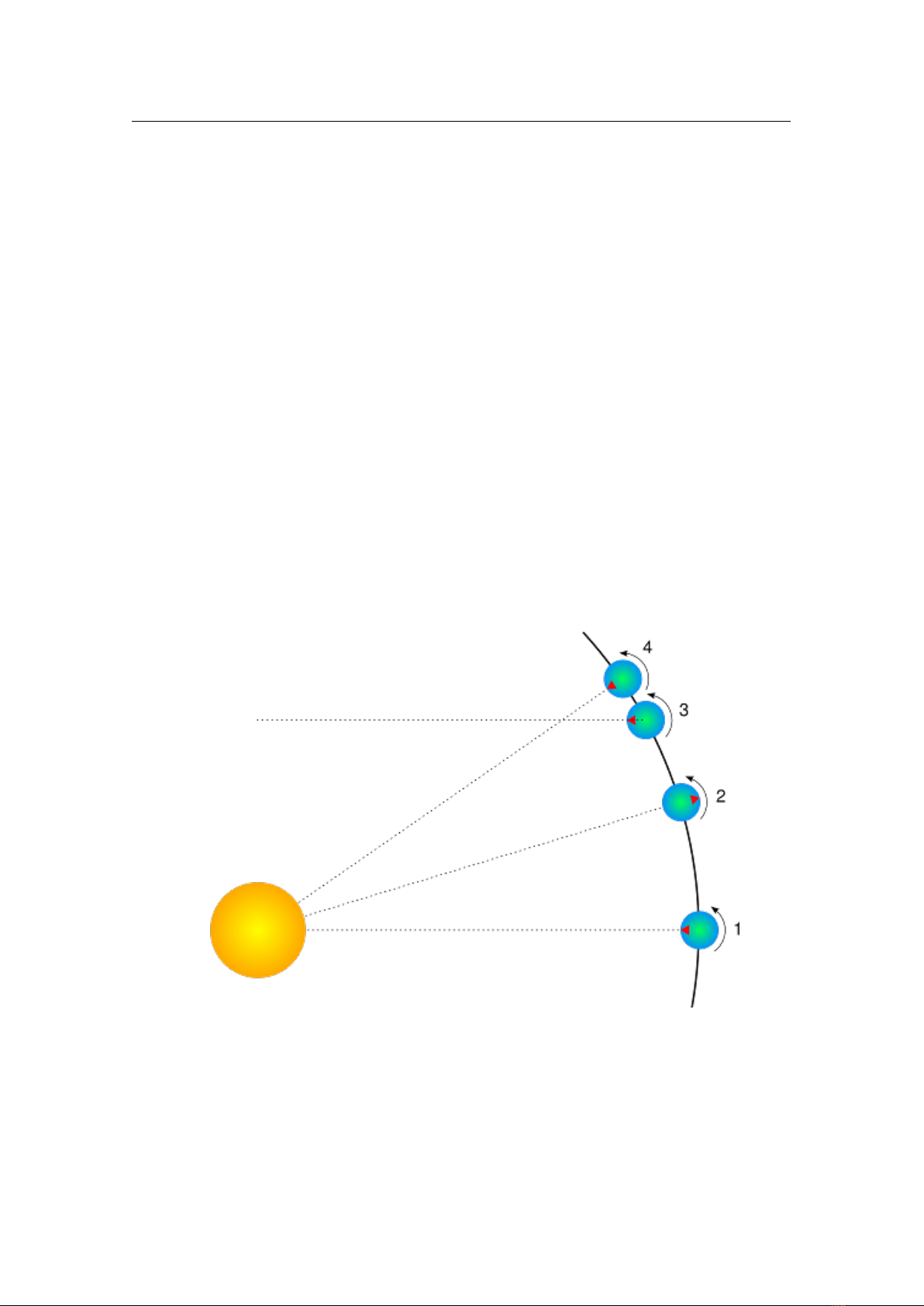
260 Chapter 18. Astronomical Concepts
Space [. . . ] is big. Really big. You just won’t believe how vastly, hugely, mind-
bogglingly big it is. I mean, you may think it’s a long way down the road to the
chemist, but that’s just peanuts to space.[p.76]
Astronomers use a variety of units for distance that make sense in the context of the mind-boggling
vastness of space.
Astronomical Unit (AU)
This is the mean Earth-Sun distance. Roughly 150 million kilometers
(
1.49598× 10
8
km
). The AU is used mainly when discussing the solar system – for example
the distance of various planets from the Sun.
Light year (LY)
A light year is not, as some people believe, a measure of time. It is the distance
that light travels in a year. The speed of light being approximately 300,000 kilometers per
second means a light year is a very large distance indeed, working out at about 9.5 trillion
kilometers (
9.46073× 10
12
km
). Light years are most frequently used when describing the
distance of stars and galaxies or the sizes of large-scale objects like galaxies, nebulae etc.
Parsec (pc)
A parsec is defined as the distance of an object that has an annual parallax of 1 second
of arc. This equates to 3.26156 light years (
3.08568 × 10
13
km
). Parsecs (and derivatives:
kiloparsec
kpc
, megaparsec
Mpc
) are most frequently used when describing the distance of
stars or the sizes of large-scale objects like galaxies, nebulae etc.
18.4 Time
Figure 18.3: Sidereal day
The length of a day is defined as the amount of time that it takes for the Sun to travel from
the highest point in the sky at mid-day to the next high-point on the next day. In astronomy this is
called a solar day. The apparent motion of the Sun is caused by the rotation of the Earth. However,

18.4 Time 261
in this time, the Earth not only spins, it also moves slightly round its orbit. Thus in one solar day
the Earth does not spin exactly
360
◦
on its axis. Another way to measure day length is to consider
how long it takes for the Earth to rotate exactly 360
◦
. This is known as one sidereal day.
Figure 18.3 illustrates the motion of the Earth as seen looking down on the Earth orbiting the
Sun. The red triangle on the Earth represents the location of an observer. The figure shows the
Earth at four times:
1. The Sun is directly overhead - it is mid-day.
2.
Twelve hours have passed since 1. The Earth has rotated round and the observer is on the
opposite side of the Earth from the Sun. It is mid-night. The Earth has also moved round in
its orbit a little.
3. The Earth has rotated exactly 360
◦
. Exactly one sidereal day has passed since 1.
4.
It is mid-day again – exactly one solar day since 1. Note that the Earth has rotated more than
360
◦
since 1.
It should be noted that in figure 18.3 the sizes of the Sun and Earth and not to scale. More
importantly, the distance the Earth moves around its orbit is much exaggerated. The Earth takes a
year to travel round the Sun –
365
1
4
solar days. The length of a sidereal day is about 23 hours, 56
minutes and 4 seconds.
18.4.1 Sidereal Time
It takes exactly one sidereal day for the celestial sphere to make one revolution in the sky. As-
tronomers find sidereal time useful when observing. This is the Right Ascension which is currently
passing the meridian line, or, equivalent, the Hour Angle of the First Point of Aries
à
. When
visiting observatories, look out for doctored alarm clocks that have been set to run faster and show
sidereal time!
18.4.2 Julian Day Number
In the 19th century, astronomer JOHN HERSCHEL (1792–1871) introduced the use of Julian Day
numbers (invented around the time of the Gregorian calendar reform). This is a simple continuous
day count starting on January 1, -4712 (4713 BC). There are no years, months etc., and the integral
day number switches at noon, so during a single night of observation (in Europe) the date never
changes.
The fractional part of the number is just the fraction of day that has elapsed since last noon.
Given that a day has 86400 seconds, we should give a JD with 5 decimal places to capture the
nearest second.
This causes a problem for modern computers: even a “double precision float” can keep
only about 13 decimal places. More than 2.4 million days have passed, so that e.g. Jan-
uary 1, 2000, 12:00UT is 2451545.0, which is an accurately storable number with 7 decimal
places, but 12:34:56UT is computed as 2451545.02426. A more accurate result would yield
2451545.024259259259... So, for a field where sub-second accuracy became crucial like spacecraft
operations, the Modified Julian Day (MJD) has been introduced. It is simply
MJD = JD − 2400000.5. (18.2)
This means, days start at midnight, and the (constant, in our era) decimal places of the “big numbers”
at the begin of the number have been traded in for more decimal places at the end.
Don’t put your expectations too high when you see MJD displayed (section 4.1): Stellarium
uses a double-precision floating point number for JD for internal timekeeping, and Stellarium’s
display of MJD is simply computed from it. So you cannot set temporal increments smaller than a
second, and it hardly would make sense to expect more accuracy from the simulation algorithms.

262 Chapter 18. Astronomical Concepts
18.4.3 Delta T
Until around 1900, the Earth’s rotation was regarded as perfect standard of time. There were
86400 seconds per mean solar day, and the accuracy of reproducing time with mechanical clocks
only in this time started to become as good as the Earth’s rotation itself.
Astronomers who computed solar eclipses reported in texts from antiquity wondered about a
required time shift which they originally attributed to a yet-unknown “secular acceleration of the
lunar motion”. However, it turned out that indeed the gravitational effect of the Moon which causes
the tides also has effects on Earth’s rotation: the tides slowly break Earth’s rotational speed. The
energy is also transferred to the Moon, and the acceleration leads to the Moon slowly moving away
from the Earth
5
.
This led to the introduction of a time named Ephemeris Time (ET) with progresses in the speed
of the second in the year 1900, to be used for positional computation in our solar system, in addition
to Greenwich Mean Time (GMT), from which all zone times and “civil” clock times were derived.
The introduction of atomic clocks in the middle of the 20th century led to a redefinition of the
(temporal) second, which has been de-coupled from Earth’s rotation. This time, the International
Atomic Time TAI
6
, is the basis for Terrestrial Time TT which can be considered as constantly
progressing at constant speed
7
, and is used for computation of the planetary positions.
Still, people living on Earth prefer to have the mean solar noon governing the run of day and
night. Therefore all forms of civil time are linked to Coordinated Universal Time UTC. Seconds
in UTC and TAI are of equal length. The slow and irregular divergence between TAI and UTC is
observed by a few standardization institutes. When necessary, a leap second can be introduced to
the UTC to bring the Earth’s rotation back in sync so that the Mean Sun again culminates at noon.
The difference
∆T = T T −UT
(or “Delta T”) describes the temporal offset which amounts
already to more than a minute in the 21st century. There have been many attempts to properly
model
∆T
, and Stellarium offers several models you can choose from in the configuration dialog
(see section 4.3.4). “Espenak and Meeus (2006, 2014)”, is a widely accepted standard. The default,
“Modified Espenak and Meeus (2006, 2014, 2023)”, is created to make
∆T
closely in line with
observed and predicted values between the years 2015-2050. But if you are a researcher and want
to experiment with alternative models, you will hopefully like this feature. you can even specify
your own data for
a
,
b
,
c
,
y
and the secular term for lunar acceleration
n
(actually
˙n = dn/dt
in
units of arcseconds/century
2
) if you can model ∆T according to the formula
∆T = a + b · u + c · u
2
where (18.3)
u =
year− y
100
(18.4)
List of ∆T models in Stellarium
The following list describes sources and a few details about the models for
∆T
implemented in
Stellarium.
Without correction. Correction is disabled. Use only if you know what you are doing!
Schoch (1931).
This historical formula was obtained by Schoch (1931) and was also used in “A
New Test of Einstein’s Theory of Relativity by Ancient Solar Eclipses” (Henriksson, 2009).
See for more in Peters (2010). ˙n = −29.68
00
/cy
2
.
5
No need to worry, the Moon recedes from the Earth only a few centimeters per year as measured with
the laser reflectors left by the Apollo astronauts in the 1970s. In a very far future, however, there will only be
annular solar eclipses as a consequence!
6
From the French name temps atomique international
7
We don’t discuss relativity here. The advanced reader is referred to the presentation in the Wikipedia,
https://en.wikipedia.org/wiki/Delta_T.

18.4 Time 263
Clemence (1948).
This empirical equation was published in “On the system of astronomical
constants” (Clemence, 1948). Valid range of usage: between years 1681 and 1900.
˙n =
−22.44
00
/cy
2
.
IAU (1952).
This formula is based on a study of post-1650 observations of the Sun, the Moon and
the planets (Spencer Jones, 1939) and reproduced in Astronomical Formulae for Calculators
(Meeus, 1988). It was also adopted in the PC program SunTracker Pro. Valid range of usage:
between years 1681 and 1936. ˙n = −22.44
00
/cy
2
.
Astronomical Ephemeris (1960).
This is a slightly modified version of the IAU 1952 (Spencer
Jones, 1939) formula which was adopted in the “Astronomical Ephemeris” (Wilkins, 1961)
and in the Canon of Solar Eclipses -2003 to +2526 (Mucke and Meeus, 1983). Valid range
of usage: between years -500 and 2000. ˙n = −22.44
00
/cy
2
.
Tuckerman (1962, 1964) & Goldstine (1973).
The famous tables (Tuckerman, 1962; Tuckerman,
1964) list the positions of the Sun, the Moon and the planets at 5- and 10-day intervals from
601 BCE to 1649 CE. The same relation was also implicitly adopted in the syzygy tables of
Goldstine (1973). Valid range of usage: between years -600 and 1649.
Muller & Stephenson (1975).
This equation was published in “The accelerations of the earth and
moon from early astronomical observations” (Muller and F. R. Stephenson, 1975). Valid
range of usage: between years -1375 and 1975. ˙n = −37.5
00
/cy
2
.
Stephenson (1978).
This equation was published in “Pre-Telescopic Astronomical Observations”
(F. R. Stephenson, 1978). ˙n = −30.0
00
/cy
2
.
Schmadel & Zech (1979).
This 12th-order polynomial equation (outdated and superseded by
Schmadel and Zech (1988)) was published in “Polynomial approximations for the correction
delta T E.T.-U.T. in the period 1800-1975” (Schmadel and Zech, 1979) as fit through data
published by Brouwer (1952). Valid range of usage: between years 1800 and 1975, with
meaningless values outside this range. ˙n = −23.8946
00
/cy
2
.
Morrison & Stephenson (1982).
This algorithm Morrison and F. R. Stephenson, 1982 was adopted
in Planetary Programs and Tables from –4000 to +2800 (Pierre Bretagnon and Simon, 1986)
and in the PC planetarium program RedShift. Valid range of usage: between years -4000
and 2800. ˙n = −26.0
00
/cy
2
.
Stephenson & Morrison (1984).
This formula was published in “Long-term changes in the rota-
tion of the earth - 700 B.C. to A.D. 1980” (F. R. Stephenson and Morrison, 1984). Valid
range of usage: between years -391 and 1600. ˙n = −26.0
00
/cy
2
.
Stephenson & Houlden (1986).
This algorithm (Houlden and F. Stephenson, 1986) is used in the
PC planetarium program Guide 7. Valid range of usage: between years -600 and 1600.
˙n = −26.0
00
/cy
2
.
Espenak (1987, 1989).
This algorithm was given in Fifty Year Canon of Solar Eclipses: 1986 –
2035 (Espenak, 1987) and in Fifty Year Canon of Lunar Eclipses: 1986 – 2035 (Espenak,
1989). Valid range of usage: between years 1950 and 2100.
Borkowski (1988).
This formula was obtained by Borkowski (1988) from an analysis of 31 solar
eclipse records dating between 2137 BCE and 1715 CE. Valid range of usage: between years
-2136 and 1715. ˙n = −23.895
00
/cy
2
.
Schmadel & Zech (1988).
This 12th-order polynomial equation was published in “Empirical
Transformations from U.T. to E.T. for the Period 1800-1988” (Schmadel and Zech, 1988) as
data fit through values given by F. R. Stephenson and Morrison (1984). Valid range of usage:
between years 1800 and 1988, with a mean error of less than one second, max. error 1.9s,
and meaningless values outside this range. ˙n = −26.0
00
/cy
2
.
Chapront-Touze & Chapront (1991).
This formula was adopted by M. Chapront-Touze & J.
Chapront in the shortened version of the ELP 2000-85 lunar theory in their Lunar Tables and
Programs from 4000 B.C. to A.D. 8000 (Chapront-Touzé and Chapront, 1991). The relations

264 Chapter 18. Astronomical Concepts
are based on those of F. R. Stephenson and Morrison (1984), but slightly modified to make
them compatible with the tidal acceleration parameter of
˙n = −23.8946
00
/cy
2
adopted in the
ELP 2000-85 lunar theory (Chapront-Touzé and Chapront, 1988a).
Stephenson & Morrison (1995).
This equation was published in “Long-Term Fluctuations in the
Earth’s Rotation: 700 BC to AD 1990” (F. R. Stephenson and Morrison, 1995). Valid range
of usage: between years -700 and 1600. ˙n = −26.0
00
/cy
2
.
Stephenson (1997).
F. R. Stephenson published this formula in his book Historical Eclipses and
Earth’s Rotation (F. Richard Stephenson, 1997). Valid range of usage: between years -500
and 1600. ˙n = −26.0
00
/cy
2
.
Meeus (1998) (with Chapront, Chapront-Touze & Francou (1997)).
From Astronomical Algo-
rithms (Meeus, 1998), and widely used. Table for 1620..2000, and includes a variant of
Chapront, Chapront-Touze & Francou (1997) for dates outside 1620..2000. Valid range of
usage: between years -400 and 2150. ˙n = −25.7376
00
/cy
2
.
JPL HORIZONS.
The JPL Solar System Dynamics Group of the NASA Jet Propulsion Labora-
tory use this formula in their interactive website JPL HORIZONS
8
. Valid range of usage:
between years -2999 and 1620, with zero values outside this range. ˙n = −25.7376
00
/cy
2
.
Meeus & Simons (2000).
This polynome was published in “Polynomial approximations to Delta
T, 1620-2000 AD” (Meeus and Simons, 2000). Valid range of usage: between years 1620
and 2000, with zero values outside this range. ˙n = −25.7376
00
/cy
2
.
Montenbruck & Pfleger (2000).
The fourth edition of Astronomy on the Personal Computer
(Montenbruck and Pfleger, 2000) provides simple 3rd-order polynomial data fits for the
recent past. Valid range of usage: between years 1825 and 2005, with a typical 1-second
accuracy and zero values outside this range.
Reingold & Dershowitz (2002, 2007, 2018). E. M. Reingold & N. Dershowitz present this poly-
nomial data fit in Calendrical Calculations: The Ultimate Edition (Reingold and Dershowitz,
2018) and in their Calendrical Calculations (Reingold and Dershowitz, 2007), Calendri-
cal Tabulations 1900-2200 (Reingold and Dershowitz, 2002). It is based on Astronomical
Algorithms (Meeus, 1991).
Morrison & Stephenson (2004, 2005).
This important solution was published in “Historical val-
ues of the Earth’s clock error
∆
T and the calculation of eclipses” (Morrison and F. R.
Stephenson, 2004) with addendum (Morrison and F. R. Stephenson, 2005). Valid range of
usage: between years -1000 and 2000. ˙n = −26.0
00
/cy
2
.
Stephenson, Morrison & Hohenkerk (2016, 2021).
This important new solution was published
in “Measurement of the Earth’s rotation: 720 BC to AD 2015” (F. R. Stephenson, Morrison,
and Hohenkerk, 2016). The solution combines a spline fit to observations (used between
the given limits) with a parabolic fit (used as fallback outside the range, but without smooth
transitions at the limits, i.e., values for 2016 and later deviate notably from current estimates,
and should not be used for dates after 2015). The solution was updated in “Addendum
2020 to ‘Measurement of the Earth’s rotation: 720 BC to AD 2015’” (Morrison, F. R.
Stephenson, et al., 2021). Recommended range of usage: between years -720.0 and 2019.0
˙n = −25.82
00
/cy
2
.
Espenak & Meeus (2006, 2014).
This solution by F. Espenak and J. Meeus, based on Morrison
and F. R. Stephenson (2004) and a polynomial fit through tabulated values for 1600-2000, is
used for the NASA Eclipse Web Site
9
, in their Five Millennium Canon of Solar Eclipses: -
1900 to +3000 (Espenak and Meeus, 2006) and Thousand Year Canon of Solar Eclipses 1501
to 2500 (Espenak, 2014). This formula is also used in the solar, lunar and planetary ephemeris
program SOLEX. Valid range of usage: between years -1999 and 3000. ˙n = −25.858
00
/cy
2
.
8
https://ssd.jpl.nasa.gov/?horizons
9
https://eclipse.gsfc.nasa.gov/eclipse.html

18.5 Angles 265
Modified Espenak & Meeus (2006, 2014, 2023).
This solution
10
is a modification from Espenak
& Meeus (2006, 2014). Values for 2015-2033 are interpolated from observations and
predictions by IERS Rapid Service/Prediction Center. A simple formula is used to connect
with F. Espenak’s predicted value at year 2050. Valid range of usage: between years -1999
and 3000. ˙n = −25.858
00
/cy
2
.
Reijs (2006).
From the Length of Day (LOD; as determined by Morrison and F. R. Stephenson
(2004)), Victor Reijs derived a
∆T
formula by using a Simplex optimization with a cosine
and square function. This is based on a possible periodicity described by Morrison and F. R.
Stephenson (2004). Valid range of usage: between years -1500 and 1100.
˙n = −26.0
00
/cy
2
.
Banjevic (2006).
This solution is based on F. R. Stephenson and Morrison (1984) and was pub-
lished in “Ancient eclipses and dating the fall of Babylon” (Banjevic, 2006). Valid range of
usage: between years -2020 and 1620, with zero values outside this range.
˙n = −26.0
00
/cy
2
.
Islam, Sadiq & Qureshi (2008, 2013).
This solution by S. Islam, M. Sadiq and M. S. Qureshi,
based on Meeus and Simons (2000), was published in “Error Minimization of Polynomial
Approximation of Delta T” (Islam, Sadiq, and Qureshi, 2008) and revisited by Sana Islam
in 2013. Valid range of usage: between years 1620 and 2007, with zero values outside this
range.
Khalid, Sultana & Zaidi (2014).
This polynomial approximation with 0.6 seconds of accuracy
was published in “Delta T: Polynomial Approximation of Time Period 1620–2013” (Khalid,
Sultana, and Zaidi, 2014). Valid range of usage: between years 1620 and 2013, with zero
values outside this range.
Henriksson (2017).
A solution which combines Schoch’s 1931 solution (parabolic fit) with a
discussion of and correction for relativistic effects. The author claims an accurate fit for solar
eclipses probably depicted in artifacts going back to the mid-fourth millennium BC. Also with
this setting, the exact times from his paper (Henriksson, 2017) cannot be reproduced probably
because the author used a different ephemeris, but the phenomena are plausibly reproduced.
Recommended range of usage: between years -4000.0 and 2000.0 ˙n = −30.128
00
/cy
2
.
Custom equation of ∆T .
This is the quadratic formula 18.3 for calculation of
∆T
with coefficients
defined by the user.
18.5 Angles
Astronomers typically use degrees to measure angles. Since many observations require very precise
measurement, the degree is subdivided into sixty minutes of arc also known as arc-minutes. Each
minute of arc is further subdivided into sixty seconds of arc, or arc-seconds. Thus one degree is
equal to 3600 seconds of arc. Finer grades of precision are usually expressed using the SI prefixes
with arc-seconds, e.g. milli arc-seconds (one milli arc-second is one thousandth of an arc-second).
18.5.1 Notation
Degrees are denoted using the
◦
symbol after a number. Minutes of arc are denoted with a
0
, and
seconds of arc are denoted using
00
. Angles are frequently given in two formats:
1.
DMS format — degrees, minutes and seconds. For example
90
◦
15
0
12
00
. When more precision
is required, the seconds component may include a decimal part, for example
90
◦
15
0
12.432
00
.
2. Decimal degrees, for example 90.2533
◦
10
This solution is used by default.

266 Chapter 18. Astronomical Concepts
18.5.2 Handy Angles
Being able to estimate angular distance can be very useful when trying to find objects from star
maps in the sky. One way to do this with a device called a crossbow.
Crossbows are a nice way get an idea of angular distances, but carrying one about is a little
cumbersome. A more convenient alternative is to hold up an object such as a pencil at arm’s length.
If you know the length of the pencil,
d
, and the distance of it from your eye,
D
, you can calculate
its angular size, θ using this formula:
θ = 2 · arctan
d
2· D
(18.5)
Another, more handy (ahem!) method is to use the size of your hand at arm’s length:
Tip of little finger About 1
◦
Middle three fingers About 4
◦
Across the knuckles of the fist About 10
◦
Open hand About 18
◦
Using your hand in this way is not very precise, but it’s close enough to give you some way to
translate an idea like “Mars will be
45
◦
above the southeastern horizon at 21:30”. Of course, there
are variations from person to person, but the variation is compensated for somewhat by the fact
that people with long arms tend to have larger hands. In exercise 21.2 you will work out your own
“handy angles”.
18.6 The Magnitude Scale
When astronomers talk about magnitude, they are referring to the brightness of an object. How
bright an object appears to be depends on how much light it is giving out and how far it is from the
observer. Astronomers separate these factors by using two measures: absolute magnitude (Mag or
M
) which is a measure of how much light is being given out by an object, and apparent magnitude
(mag or m) which is how bright something appears to be in the sky.
For example, consider two 100 watt lamps, one which is a few meters away, and one which is a
kilometer away. Both give out the same amount of light – they have the same absolute magnitude.
However the nearby lamp seems much brighter – it has a much greater apparent magnitude. When
astronomers talk about magnitude without specifying whether they mean apparent or absolute
magnitude, they are usually referring to apparent magnitude.
The magnitude scale has its roots in antiquity. The Greek astronomer HIPPARCHUS defined the
brightest stars in the sky to be first magnitude, and the dimmest visible to the naked eye to be sixth
magnitude. In the 19th century British astronomer NORMAN POGSON (1829–1891) quantified the
scale more precisely, defining it as a logarithmic scale where a magnitude 1 object is 100 times
as bright as a magnitude 6 object (a difference of five magnitudes). The zero-point of the modern
scale was originally defined as the brightness of the star Vega, however this was re-defined more
formally in 1982 (Aller et al., 1989). Objects brighter than Vega are given negative magnitudes.
The absolute magnitude of a star is defined as the magnitude a star would appear if it were 10
parsecs from the observer.
Table 18.1 lists several objects that may be seen in the sky, their apparent magnitude and their
absolute magnitude where applicable (only stars have an absolute magnitude value. Planets nor
Moon emit light like a star does – they reflect the light from the Sun).
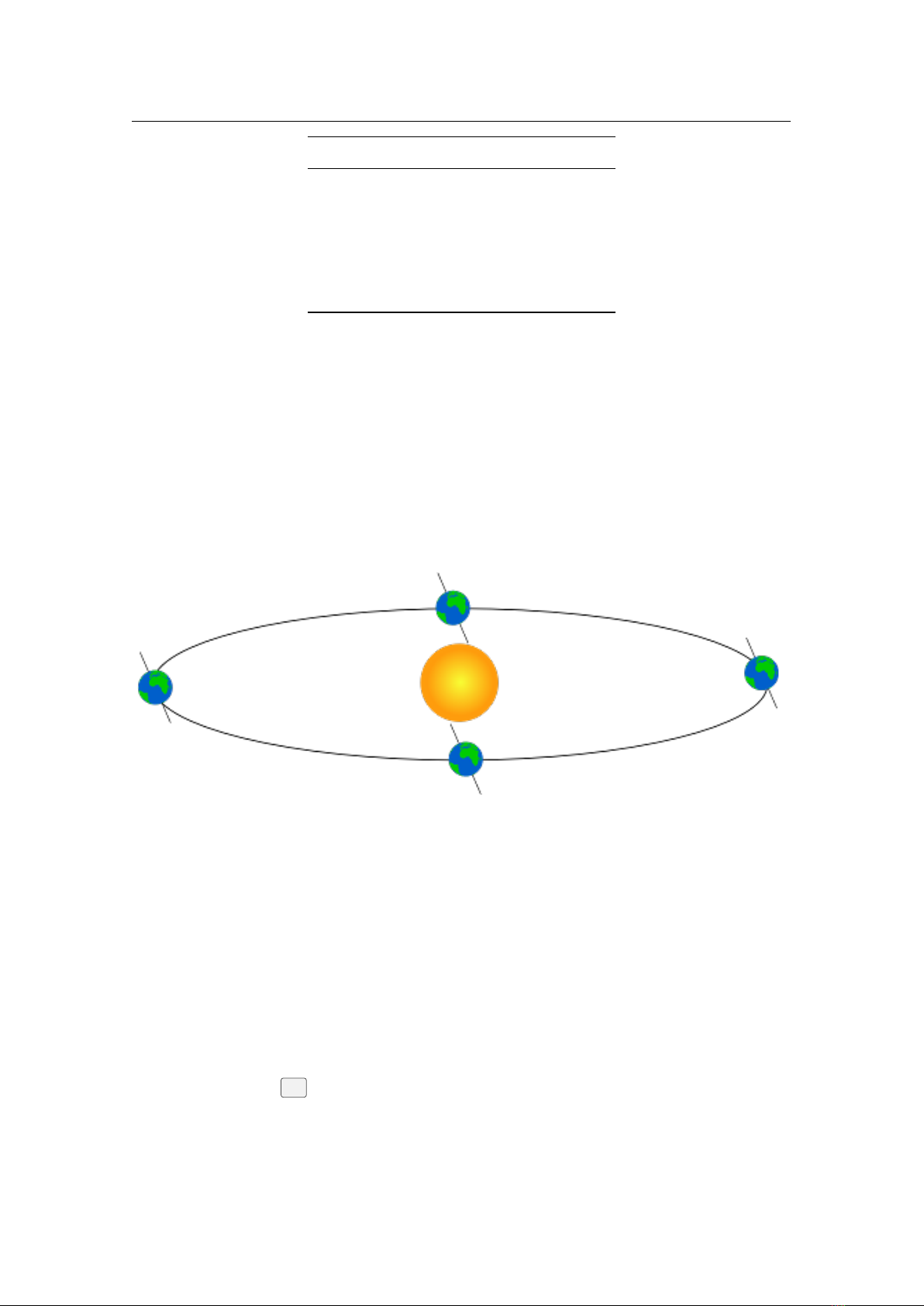
18.7 Luminosity 267
Object m M
The Sun -27 4.8
Vega 0.05 0.6
Betelgeuse 0.47 -7.2
Sirius (the brightest star) -1.5 1.4
Venus (at brightest) -4.4 —
Full Moon (at brightest) -12.6 —
Table 18.1: Magnitudes of a few objects
18.7 Luminosity
Luminosity is an expression of the total energy radiated by a star. It may be measured in watts,
however, astronomers tend to use another expression — solar luminosities where an object with
twice the Sun’s luminosity is considered to have two solar luminosities and so on. Luminosity is
related to absolute magnitude.
18.8 Precession
Figure 18.4: Ecliptic obliquity
As the Earth orbits the Sun throughout the year, the axis of rotation (the line running through the
rotational poles of the Earth) seems to point towards the same position on the celestial sphere, as
can be seen in figure 18.4. The angle between the axis of rotation and the perpendicular of the
orbital plane is called the obliquity of the ecliptic. It is currently about
23
◦
27
0
and is the angle
between equatorial plane (18.2.2) and ecliptical plane (18.2.4).
Observed over very long periods of time the direction the axis of rotation points to does actually
change. The angle between the axis of rotation and the orbital plane stays fairly constant, but the
direction the axis points — the position of the celestial pole — transcribes a figure similar to a
circle on the celestial sphere. The motion is similar to the way in which a gyroscope slowly twists,
as figure 18.5 illustrates. This process is called precession. The circles can be shown in Stellarium:
from the View menu (
F4
), tab “Markings”, switch on “Precession Circles” (4.4.4).
Precession is a slow process. The axis of rotation twists through a full
360
◦
about once
every 26,000 years. However, over these long times other gravitational perturbations (“planetary
precession”) play a role, and what may be thought of as rigid “precession circle” can actually only
show the instantaneous (current) state. Over millennia the circle slightly varies.
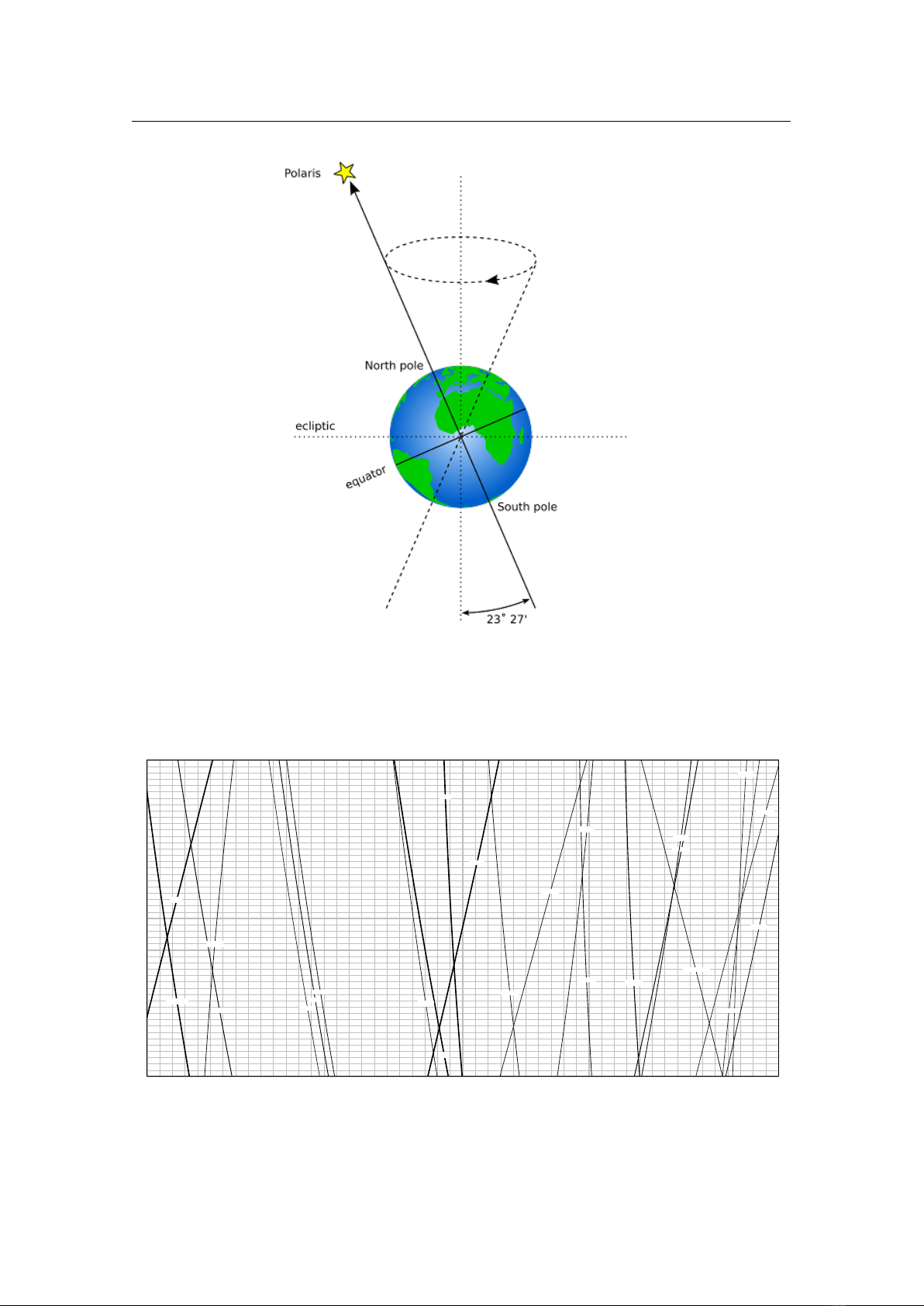
268 Chapter 18. Astronomical Concepts
Figure 18.5: Precession
90 95 100 105 110 115 120 125 130 135
85 90 95 100 105 110 115 120 125 130 135
Azimuth
-1000
-900
-800
-700
-600
-500
-400
-300
-200
-100
0
Deneb Kaitos
Rigel
Gam Ori
Mintaka
Alnilam
Alnitak
Kap Ori
Betelgeuse
Bet CMa
Sirius
Eps CMa
Del CMa
Zet Pup
Lam Vel
Alphard
Gam Cen
Spica
The Cen
Antares
Lam Sco
The Sco
Eps Sgr
Sig Sgr
Precession Shift of Stars on the Horizon
Geograpical Latitude: 30°0’ 0’’. Stars to mag=2.25. Azimuths from North, without refraction.
© Georg Zotti 2010, http://astrosim.univie.ac.at
Figure 18.6: Precession: Change of rising positions of the stars along the eastern horizon
from azimuths 85 to 135 degrees, between years 1000 BC and 0, for latitude ϕ = 30
◦
.

18.9 Parallax 269
Precession has some important implications:
1.
RA/Dec coordinates change over time, albeit slowly. Measurements of the positions of
stars recorded using RA/Dec coordinates must also include a date (“equinox”) for those
coordinates. Therefore the current star catalogues list their objects for the epoch and equinox
J2000.0.
2.
Polaris, the Pole Star, won’t stay a good indicator of the location of the Northern Celestial
Pole. In 14,000 years time Polaris will be nearly 47
◦
away from the celestial pole!
3.
The change in declination causes a shift in the rising and setting positions of the stars along
the horizon. Figure 18.6 shows part of the horizon for latitude
ϕ = 30
◦
north. For a given
year (left vertical labels), make a horizontal line to find rising azimuth of the bright stars
indicated by the twisting lines. Depending on where on the celestial sphere a star is located,
it may appear to move north or south, or be almost stationary for several centuries.
18.9 Parallax
Parallax is the change of angular position of two stationary points relative to each other as seen by
an observer, due to the motion of said observer. Or more simply put, it is the apparent shift of an
object against a background due to a change in observer position.
This can be demonstrated by holding one’s thumb up at arm’s length. Closing one eye, note the
position of the thumb against the background. After swapping which eye is open (without moving),
the thumb appears to be in a different position against the background.
18.9.1 Geocentric and Topocentric Observations
When computing planetary positions was done manually by adding numbers tabulated in yearly
almanacs, computing the Earth’s position and, say, the position of a minor planet was usually good
enough to find the object in the sky. In both cases, the exact numbers refer to the gravitational
centers of the respective bodies. However, we are sitting on Earth’s surface, so the observed planet
will be seen in a slightly shifted location. The amount for objects in the inner solar system is usually
just a few arc-seconds and is mostly negligible when we just want to find an object. But it makes
a difference when it comes to observations of stellar occultations by planets or asteroids. Such a
body may measure only a few tens of kilometers, and the shadow track which it leaves on Earth’s
surface is of approximately the same size.
11
A much closer and bigger object is the Moon, which can also occult stars. It can even occult
the one big star we call the Sun: this is a solar eclipse. And here it makes a huge difference where
on the planet you are located.
If you are interested in astronomical computing, you may still be interested in geocentric
numerical results. From the Settings panel (
F2
), tab “Tools”, there is a checkbox for “Topocentric
Coordinates”. Switch it off to put yourself into the center of the planet you are located.
18.9.2 Stellar Parallax
A similar thing happens due to the Earth’s motion around the Sun. Nearby stars appear to move
against more distant background stars, as illustrated in figure 18.7. The movement of nearby stars
against the background is called stellar parallax, or annual parallax.
Since we know the radius of the Earth’s orbit around the Sun from other methods, we can use
simple geometry to calculate the distance of the nearby star if we measure annual parallax.
11
Unfortunately Stellarium (as of v0.15.0) is not accurate enough to reliably compute such occultations.
Even a deviation of 0.5 arc-seconds is too much here.
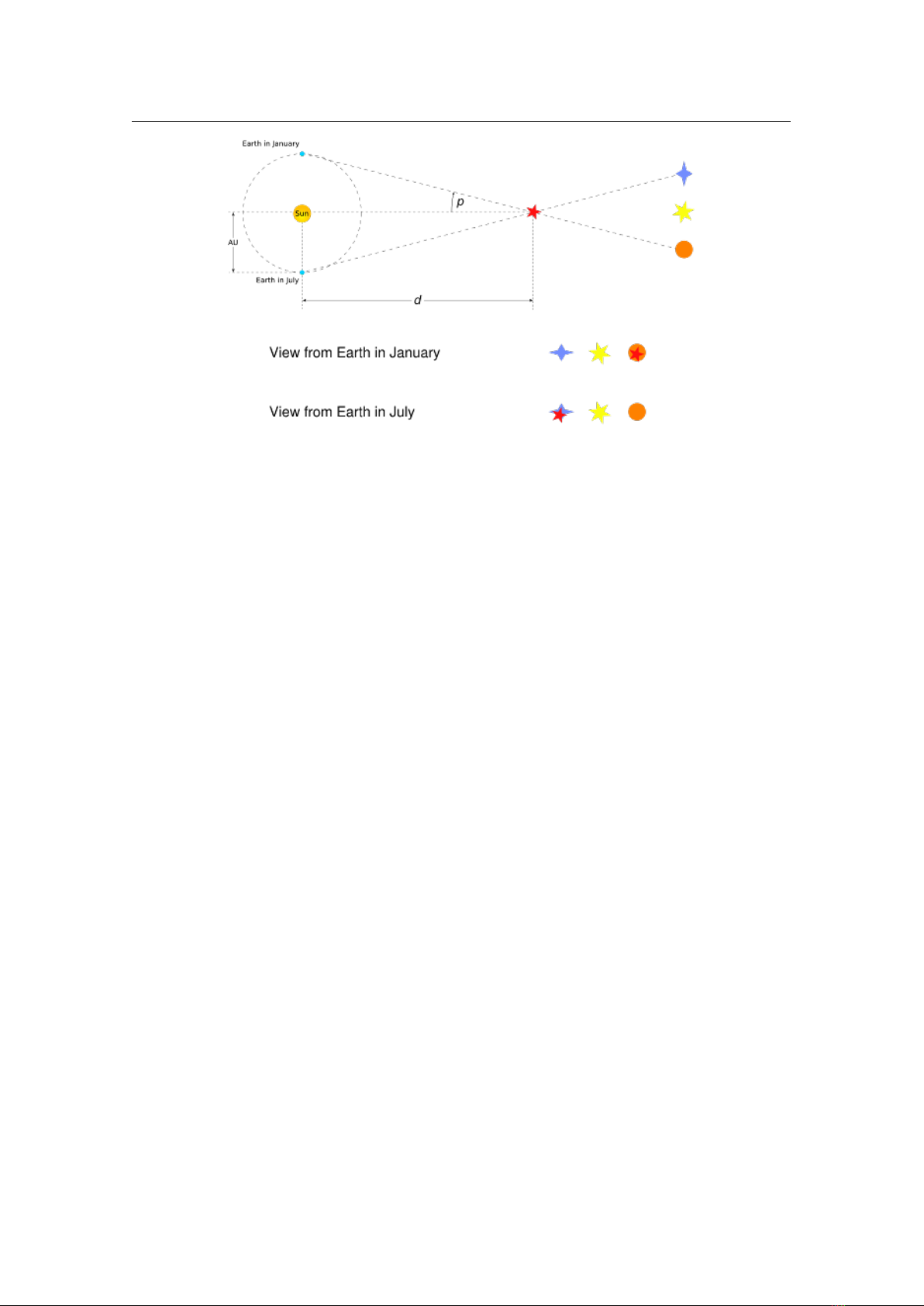
270 Chapter 18. Astronomical Concepts
Figure 18.7: Stellar Parallax
As can be seen from figure 18.7, the annual parallax
p
is half the angular distance between the
apparent positions of the nearby star. The distance of the nearby object is
d
. Astronomers use a unit
of distance called the parsec (
pc
) which is defined as the distance at which a nearby star has
p = 1
00
.
Even the nearest stars exhibit very small movement due to parallax. The closest star to the
Earth other than the Sun is Proxima Centauri. It has an annual parallax of
0.77199
00
, corresponding
to a distance of 1.295pc (4.22 light years).
Even with the most sensitive instruments for measuring the positions of the stars it is only
possible to use parallax to determine the distance of stars up to about 1,600 light years from the
Earth, after which the annual parallax is so small it cannot be measured accurately enough.
In Stellarium, the annual parallax can be listed in the object information for stars when available.
It is not accounted for in the positional calculations.
18.10 Aberration of Light
When you are standing under a rainy but windless sky with an umbrella placed vertically over your
head, your feet will not be hit by raindrops. But when you are walking, raindrops which just missed
the umbrella may hit your feet. Relative to your umbrella and feet, it seems that the raindrops are
coming not quite vertically from above, but inclined from the direction you are heading into, and
therefore you tilt the umbrella slightly forward to fend off the raindrops from your feet.
Light propagates very fast compared to the motion of the planets, but still with a finite velocity.
Therefore, just like the raindrops mentioned above, light from all celestial objects seem to come in
from a position slightly distorted towards the point in space the observer is heading to.
In search for stellar parallax (see section 18.9.2), this effect of the aberration of light was
fortuitously discovered and then explained by JAMES BRADLEY (1693–1762) in 1725. This was
also the final proof for Earth’s movement around the Sun. For an observer on the moving Earth, the
apparent deviation of a star from the mean coordinates can reach
20.4”
. As the months pass, Earth
is changing its direction along its orbit, and so the light distortion also changes, i.e., the direction
towards the object moves against the fixed coordinate axes. The effect is significant when we want
to compute, for example, stellar occultations by the Moon.
In Stellarium, you can observe a slight annual wobble in all objects’ positions against the fixed
celestial grids. Just enable the equatorial grid, zoom in and run through the months. You can also

18.11 Proper Motion 271
exaggerate the aberration effect upto 5× to make it more apparent.
12
18.11 Proper Motion
Proper motion is the change in the position of a star over time as a result of its motion through
space relative to the Sun. It does not include the apparent shift in position of star due to annular
parallax. The star exhibiting the greatest proper motion is Barnard’s Star which moves more than
ten seconds of arc per year.
If you want to simulate the effect of proper motion with Stellarium, put the map into equatorial
view mode, switch off ground and cardinal marks, and set some high time lapse speed. You will see
a few stars change their locations quite soon, those are usually stars in our galactic neighbourhood
(see section 21.12).
Note however some limitations:
1.
Stellarium will stop at
±100.000
years. This limit may be still suitable for most stellar
locations. The planetary locations are not trustworthy outside of a much narrower temporal
window (see section F). You cannot simulate the sky over the dinosaurs or such things.
2.
Proper motion is only modeled by linear components. True 3D motion in space requires
more computation, which would slow down the program.
3.
Double stars are listed in catalogs as two individual stars with their current proper motion
which consists of a common spatial motion and the orbital motion around their common
center of gravity. However, their orbital motion around each other is not modelled in
Stellarium. They may be seen flying apart, which is of course not realistic.
12
Exaggerating even more causes graphics defects and has been disabled for now.

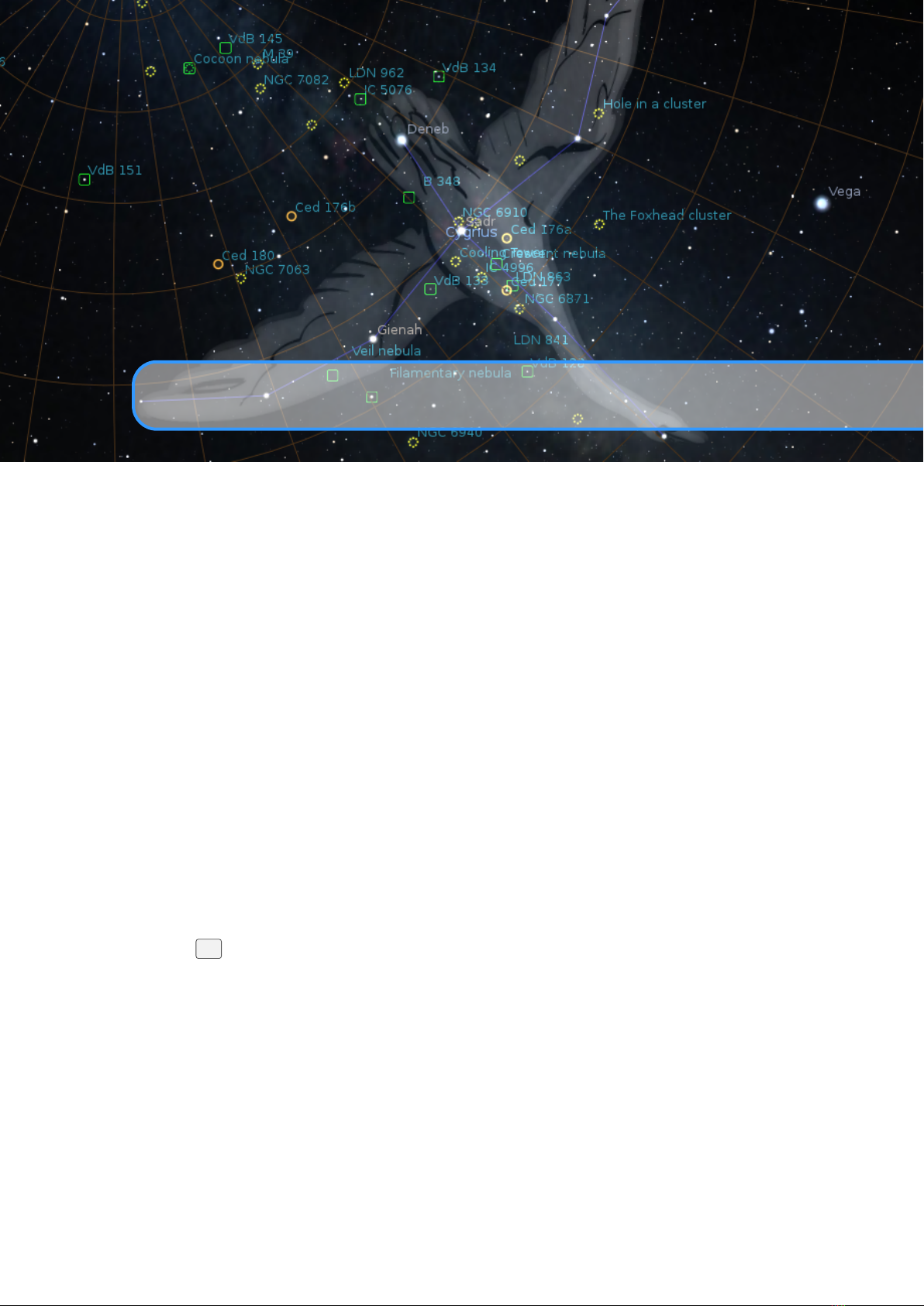
19. Astronomical Phenomena
BARRY GERDES, WITH ADDITIONS BY GEORG ZOTTI
This chapter focuses on the observational side of astronomy — what we see when we look at the
sky.
19.1 The Sun
Without a doubt, the most prominent object in the sky is the Sun. The Sun is so bright that when it
is in the sky, its light is scattered by the atmosphere to such an extent that almost all other objects in
the sky are rendered invisible.
The Sun is a star like many others but it is much closer to the Earth at approximately 150
million kilometres (a distance also called 1 Astronomical Unit). The next nearest star, Proxima
Centauri is approximately 260,000 times further away from us than the Sun! The Sun is also known
by its Latin name, Sol.
Over the course of a year, the Sun appears to move round the celestial sphere in a great circle
known as the ecliptic. Stellarium can draw the ecliptic on the sky. To toggle drawing of the ecliptic,
press the
,
key.
WARNING: Looking at the Sun with even the smallest telescope or binoculars can permanently
damage the eye. Never look at the Sun without using the proper filters attached to the front end
(objective lens) of your instrument! Never use screw-in ocular filters, they may break in the heat
and expose your eye to damaging amounts of energy. By far the safest way to observe the Sun is to
look at it on a computer screen, courtesy of Stellarium!
19.1.1 Twilight
The sunlight is scattered in Earth’s atmosphere even if the Sun is below the horizon. The period
after sunset when the Sun is higher than
−6
◦
is called civil twilight. The sky is generally bright
enough for outdoor activity or reading the newspaper.

274 Chapter 19. Astronomical Phenomena
As time progresses, the first stars will appear. The phase where the Sun is between
−6
◦
and
−12
◦
below the (mathematical) horizon is called nautical twilight: before the invention of satellite
navigation, celestial navigation was used to find a ship’s position on the oceans. This required that
it was still bright enough so that the horizon line was visible, but already dark enough to see enough
stars to clearly identify them and measure the altitude of a few of them. (See also section 14.7.)
The twilight phase when the Sun is between
−12
◦
and
−18
◦
is called astronomical twilight.
Only the western horizon shows some brightening, but else the natural sky is “almost” as dark as it
can get.
In the morning the game is reversed. Dawn starts with astronomical twilight, progresses to
nautical and civil twilight, and sunrise ends the night.
In Stellarium, you can set the time when the Sun reaches a configured altitude. See section 4.8.1
about how to configure the program.
19.2 Stars
The Sun is just one of billions of stars. Even though many stars have a much greater absolute
magnitude than the Sun (they give out more light), they have an enormously smaller apparent
magnitude due to their large distance. Stars have a variety of forms — different sizes, brightnesses,
temperatures, and colours. Measuring the position, distance and attributes of the stars is known as
astrometry, and is a major part of observational astronomy.
19.2.1 Multiple Star Systems
Many stars have stellar companions. As many as six stars can be found orbiting one-another in close
associations known as multiple star systems — binary systems being the most common with two
stars. Multiple star systems are more common than solitary stars, putting our Sun in the minority
group.
Sometimes multiple stars orbit each other in a way that means one will periodically eclipse the
other. These are eclipsing binaries or Algol variables.
Optical Doubles & Optical Multiples
Sometimes two or more stars appear to be very close to one another in the sky, but in fact have
great separation, being aligned from the point of view of the observer but of different distances.
Such pairings are known as optical doubles and optical multiples.
19.2.2 Constellations
The constellations are groupings of stars that are visually close to one another in the sky. The
actual groupings are fairly arbitrary — different cultures have grouped stars together into different
constellations. In many cultures, the various constellations have been associated with mythological
entities. As such people have often projected pictures into the skies as can be seen in figure 19.1
which shows the constellation of Ursa Major. On the left is a picture with the image of the mythical
Great Bear, on the right only a line-art version (or stick figure) is shown. The seven bright stars of
Ursa Major are widely recognised, known variously as “the plough”, the “pan-handle”, and the
“big dipper”. This sub-grouping is known as an asterism — a distinct grouping of stars. On the
right, the picture of the bear has been removed and only a constellation diagram remains.
Stellarium can draw both constellation diagrams and artistic representations of the constellations.
Multiple sky cultures are supported: Western, Polynesian, Egyptian, Chinese, and several other sky
cultures are available, although at time of writing the non-Western constellations are not complete,
and as yet there are no artistic representations of these sky-cultures.

19.2 Stars 275
Figure 19.1: Ursa Major
Aside from historical and mythological value, to the modern astronomer the constellations
provide a way to segment the sky for the purposes of describing locations of objects, indeed one of
the first tasks for an amateur observer is learning the constellations — the process of becoming
familiar with the relative positions of the constellations, at what time of year a constellation is
visible, and in which constellations observationally interesting objects reside. The International
Astronomical Union has adopted 88 “Western” constellations as a common system for segmenting
the sky (Table 19.1). They are based on Greek/Roman mythology, but with several additions from
Renaissance and later centuries. As such some formalisation has been adopted, each constellation
having a proper name, which is in Latin, and a three letter abbreviation of that name. For example,
Ursa Major has the abbreviation UMa. Also, the “Western” constellation have clearly defined
boundaries (Delporte, 1930), which you can draw in Stellarium when you press the
B
key
1
. The
IAU constellation a selected object is placed in is also available in the object information data
(Roman, 1987), regardless of the currently active sky culture. On the other hand, the shapes of
mythological figures, and also stick figures, have not been canonized, so you will find deviations
between Stellarium and printed atlases.
19.2.3 Star Names
The brighter stars often have one or more common names relating to mythical characters from the
various traditions. For example the brightest star in the sky, Sirius is also known as The Dog Star
(the name Canis Major — the constellation Sirius is found in — is Latin for “The Great Dog”).
Most bright names have been given names in antiquity. PTOLEMY’s most influential book, the
Syntaxis, was translated to the Arab language in the age of early Muslim scientists. When, centuries
later, the translation, called Almagest, was re-introduced to the re-awakening European science,
those names, which often only designated the position of the star within the figure, were taken from
the books, often misspelled, and used henceforth as proper names.
A few more proper names have been added later, sometimes dedicatory names added by court
astronomers into their maps. There are also 3 stars named after the victims of the Apollo 1 disaster
in 1967. Today, the International Astronomical Union (IAU) is the only scientifically accepted
authority which can give proper names to stars. Some companies offer a paid name service for
commemoration or dedication of a star for deceased relatives or such, but all you get here is a piece
1
These boundaries or borders have been drawn using star maps from 1875. Due to the effect of precession,
these borders are no longer parallel to today’s coordinates.

276 Chapter 19. Astronomical Phenomena
Abbr. Name Genitive Abbr. Name Genitive
And Andromeda Andromedae Lac Lacerta Lacertae
Ant Antlia Antliae Leo Leo Leonis
Aps Apus Apodis LMi Leo Minor Leonis Minoris
Aqr Aquarius Aquarii Lep Lepus Leporis
Aql Aquila Aquilae Lib Libra Librae
Ara Ara Arae Lup Lupus Lupi
Ari Aries Arietis Lyn Lynx Lyncis
Aur Auriga Aurigae Lyr Lyra Lyrae
Boo Bootes Bootis Men Mensa Mensae
Cae Caelum Caeli Mic Microscopium Microscopii
Cam Camelopardalis Camelopardalis Mon Monoceros Monocerotis
Cnc Cancer Cancri Mus Musca Muscae
Cvn Canes Venatici Canum Venaticorum Nor Norma Normae
CMa Canis Maior Canis Maioris Oct Octans Octantis
CMi Canis Minor Canis Minoris Oph Ophiuchus Ophiuchi
Cap Capricornus Capricorni Ori Orion Orionis
Car Carina Carinae Pav Pavo Pavonis
Cas Cassiopeia Cassiopeiae Peg Pegasus Pegasi
Cen Centaurus Centauri Per Perseus Persei
Cep Cepheus Cephei Phe Phoenix Phoenicis
Cet Cetus Ceti Pic Pictor Pictoris
Cha Chamaeleon Chamaeleonis Psc Pisces Piscium
Cir Circinus Circini PsA Piscis Austrinus Piscis Austrini
Col Columba Columbae Pup Puppis Puppis
Com Coma Berenices Comae Berenicis Pyx Pyxis Pyxidis
CrA Corona Australis Coronae Australis Ret Reticulum Reticuli
CrB Corona Borealis Coronae Borealis Sge Sagitta Sagittae
Crt Crater Crateris Sgr Sagittarius Sagittarii
Crv Corvus Corvi Sco Scorpius Scorpii
Cru Crux Crucis Scl Sculptor Sculptoris
Cyg Cygnus Cygni Sct Scutum Scuti
Del Delphinus Delphini Ser Serpens Serpentis
Dor Dorado Doradus Sex Sextans Sextantis
Dra Draco Draconis Tau Taurus Tauri
Equ Equuleus Equulei Tel Telescopium Telescopii
Eri Eridanus Eridani Tri Triangulum Trianguli
For Fornax Fornacis TrA Triangulum Australe Trianguli Australis
Gem Gemini Geminorum Tuc Tucana Tucanae
Gru Grus Gruis UMa Ursa Major Ursae Majoris
Her Hercules Herculis UMi Ursa Minor Ursae Minoris
Hor Horologium Horologii Vel Vela Velae
Hya Hydra Hydrae Vir Virgo Virginis
Hyi Hydrus Hydri Vol Volans Volantis
Ind Indus Indi Vul Vulpecula Vulpeculae
Table 19.1: The official 88 IAU constellation names and abbreviations

19.2 Stars 277
of paper with coordinates of (usually) an unremarkably dim star only visible in a telescope, and a
name to remember, stored (at best) in the company’s database.
There are several more formal naming conventions that are in common use.
Bayer Designation
The German astronomer JOHANN BAYER (1572–1625) devised one such system for his atlas, the
Uranographia, first published in 1603. His scheme names the stars according to the constellation
in which they lie prefixed by a lower case Greek letter (see Tab. 19.2), starting at
α
for (usually)
the brightest star in the constellation and proceeding with
β,γ,. . .
in descending order of apparent
magnitude. For example, such a Bayer Designation for Sirius is “
α
Canis Majoris” (note that
the genitive form of the constellation name is used, refer to Table 19.1; today also the short form
α
CMa is in use). There are some exceptions to the descending magnitude ordering, and some
multiple stars (both real and optical) are named with a numerical superscript after the Greek letter,
e.g. π
1
... π
6
Orionis.
α alpha η eta ν nu τ tau
β beta θ theta ξ xi υ upsilon
γ gamma ι iota o omicron ϕ phi
δ delta κ kappa π pi χ chi
ε epsilon λ lambda ρ rho ψ psi
ζ zeta µ mu σ sigma ω omega
Table 19.2: The Greek alphabet used by Bayer
Flamsteed Designation
English astronomer JOHN FLAMSTEED (1646–1719) numbered stars in each constellation in order
of increasing right ascension followed by the genitive form of the constellation name, for example
“61 Cygni” (or short: “61 Cyg”).
Hipparcos
Hipparcos (for High Precision Parallax Collecting Satellite) was an astrometry mission of the
European Space Agency (ESA) dedicated to the measurement of stellar parallax and the proper
motions of stars. The project was named in honour of the Greek astronomer HIPPARCHUS.
Ideas for such a mission dated from 1967, with the mission accepted by ESA in 1980. The
satellite was launched by an Ariane 4 on 8 August 1989. The original goal was to place the satellite
in a geostationary orbit above the earth, however a booster rocket failure resulted in a highly
elliptical orbit from 500 to 35,800 km (310 to 22,240 miles) altitude. Despite this difficulty, all of
the scientific goals were accomplished. Communications were terminated on 15 August 1993.
The program was divided in two parts: the Hipparcos experiment whose goal was to measure
the five astrometric parameters of some 120,000 stars to a precision of some 2 to 4 milli arc-seconds
and the Tycho experiment, whose goal was the measurement of the astrometric and two-colour
photometric properties of some 400,000 additional stars to a somewhat lower precision.
The final Hipparcos Catalogue (120,000 stars with 1 milli arc-second level astrometry) and the
final Tycho Catalogue (more than one million stars with 20-30 milli arc-second astrometry and
two-colour photometry) were completed in August 1996. The catalogues were published by ESA in
June 1997. The Hipparcos and Tycho data have been used to create the Millennium Star Atlas: an
all-sky atlas of one million stars to visual magnitude 11, from the Hipparcos and Tycho Catalogues
and 10,000 non-stellar objects included to complement the catalogue data.
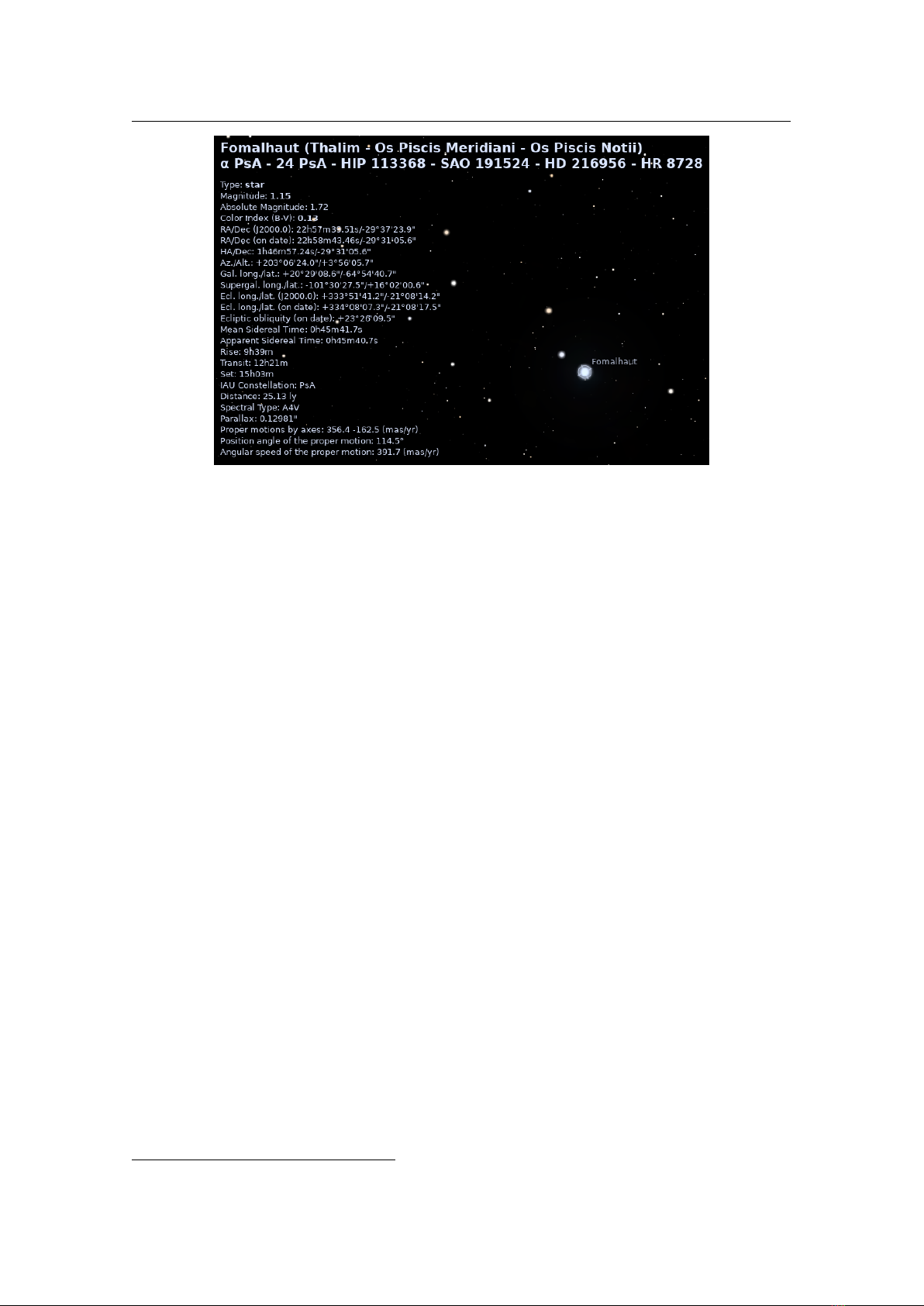
278 Chapter 19. Astronomical Phenomena
Figure 19.2: Star Names and Data
There were questions over whether Hipparcos has a systematic error of about 1 milli arc-second
in at least some parts of the sky. The value determined by Hipparcos for the distance to the Pleiades
is about 10% less than the value obtained by some other methods. By early 2004, the controversy
remained unresolved.
Stellarium uses the Hipparcos Catalogue for star data, as well as having traditional names
for many of the brighter stars. The stars tab of the search window allows for searching based
on a Hipparcos Catalogue number (as well as traditional names), e.g. the star Sadalmelik in the
constellation of Aquarius can be found by searching for the name, or its Hipparcos number, 109074.
Figure 19.2 shows the information Stellarium displays when a star is selected. At the top, the
common name, Bayer/Flamsteed designations and Hipparcos number are shown, followed by the
RA/Dec coordinates, apparent magnitude, distance and other data.
19.2.4 Spectral Type & Luminosity Class
Stars have many different colours. Seen with the naked eye most appear to be white, but this is
due to the response of the eye — at low light levels the eye is not sensitive to colour. Typically
the unaided eye can start to see differences in colour only for stars that have apparent magnitude
brighter than 1. Betelgeuse, for example has a distinctly red tinge to it, and Sirius appears to be
blue, while Vega is the prototype “white” star.
By splitting the light from a star using a prism attached to a telescope and measuring the
relative intensities of the colours of light the star emits — the spectrum — a great deal of interesting
information can be discovered about a star including its surface temperature, and the presence of
various elements in its atmosphere.
Astronomers groups stars with similar spectra into spectral types, denoted by one of the
following letters: O, B, A, F, G, K and M.
2
Type O stars have a high surface temperature (up to
around 50,000 K) while the at other end of the scale, the M stars are red and have a much cooler
surface temperature, typically 3000 K. The Sun is a type G star with a surface temperature of
around 5,500 K. Spectral types may be further sub-divided using a numerical suffix ranging from
0-9 where 0 is the hottest and 9 is the coolest. Table 19.3 shows the details of the various spectral
2
The classic mnemonic for students of astrophysics says: “Oh, Be A Fine Girl, Kiss Me”.

19.2 Stars 279
Spectral Type Surface Temperature (K) Star Colour
O 28,000—50,000 Blue
B 10,000—28,000 Blue-white
A 7,500—10,000 White-blue
F 6,000—7,500 Yellow-white
G 4,900—6,000 Yellow
K 3,500—4,900 Orange
M 2,000—3,500 Red
Table 19.3: Spectral Types
Luminosity class Description
Ia, Ib Super-giants
II Bright giants
III Normal giants
IV Sub-giants
V Main sequence
VI Sub-dwarfs
VII White-dwarfs
Table 19.4: Luminosity Classification
types.
For about 90% of stars, the absolute magnitude increases as the spectral type tends to the O
(hot) end of the scale. Thus the whiter, hotter stars tend to have a greater luminosity. These stars
are called main sequence stars. There are however a number of stars that have spectral type at the
M end of the scale, and yet they have a high absolute magnitude. These stars are close to the ends
of their lives and have a very large size, and consequently are known as giants, the largest of these
known as super-giants.
There are also stars whose absolute magnitude is very low regardless of the spectral class.
These are known as dwarf stars, among them white dwarfs (dying stars) and brown dwarfs (“failed
stars”).
The luminosity class is an indication of the type of star — whether it is main sequence, a
giant or a dwarf. Luminosity classes are denoted by a number in roman numerals, as described in
table 19.4.
Plotting the luminosity of stars against their spectral type/surface temperature gives a diagram
called a Hertzsprung-Russell diagram (after the two astronomers EJNAR HERTZSPRUNG (1873–
1967) and HENRY NORRIS RUSSELL (1877–1957) who devised it). A slight variation of this is
shown in figure 19.3 (which is technically a colour/magnitude plot).
19.2.5 Variable Stars
Most stars are of nearly constant luminosity. The Sun is a good example of one which goes through
relatively little variation in brightness (usually about 0.1% over an 11 year solar cycle). Many stars,
however, undergo significant variations in luminosity, and these are known as variable stars. There
are many types of variable stars falling into two categories, intrinsic and extrinsic.
Intrinsic variables are stars which have intrinsic variations in brightness, that is, the star itself
gets brighter and dimmer. There are several types of intrinsic variables, probably the best-known
and most important of which is the Cepheid variable whose luminosity is related to the period
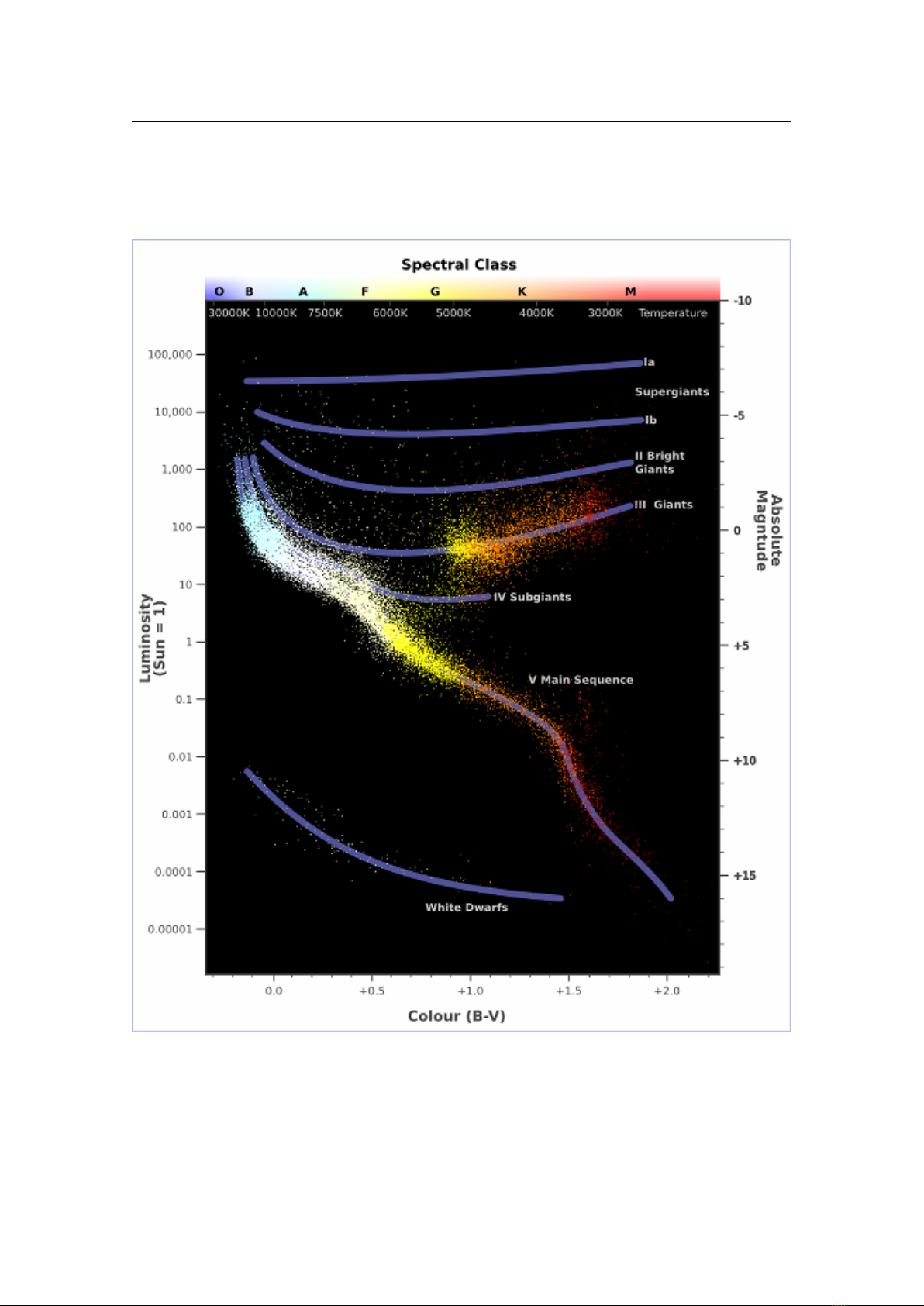
280 Chapter 19. Astronomical Phenomena
Figure 19.3: Hertzsprung-Russell Diagram

19.3 Our Moon 281
New Moon
The moon’s disc is fully in shadow, or there is just a slither of illuminated
surface on the edge.
Waxing Crescent Less than half the disc is illuminated, but more is illuminated each night.
First Quarter Approximately half the disc is illuminated, and increasing each night.
Waxing Gibbous More than half of the disc is illuminated, and still increasing each night.
Full Moon The whole disc of the moon is illuminated.
Waning Gibbous
More than half of the disc is illuminated, but the amount gets smaller each
night.
Last Quarter Approximately half the disc is illuminated, but this gets less each night.
Waning Crescent
Less than half the disc of the moon is illuminated, and this gets less each
night.
Table 19.5: Lunar Phases
with which its brightness varies. Since the luminosity (and therefore absolute magnitude) can be
calculated, Cepheid variables may be used to determine the distance of the star when the annual
parallax is too small to be a reliable guide. This is especially welcome because they are giant stars,
and so they are even visible in neighboring galaxies.
Extrinsic variables are stars of constant brightness that show changes in brightness as seen from
the Earth. These include rotating variables, stars whose apparent brightness change due to rotation,
and eclipsing binaries.
Stellarium’s catalogs include many kinds variable stars. See section C.3 for more details.
19.3 Our Moon
The Moon is the large satellite which orbits the Earth approximately every 28 days. It is seen as a
large bright disc in the early night sky that rises later each day and changes shape into a crescent
until it disappears near the Sun. After this it rises during the day then gets larger until it again
becomes a large bright disc again.
19.3.1 Phases of the Moon
As the moon moves round its orbit, the amount that is illuminated by the sun as seen from a vantage
point on Earth changes. The result of this is that approximately once per orbit, the moon’s face
gradually changes from being totally in shadow to being fully illuminated and back to being in
shadow again. This process is divided up into various phases as described in table 19.5.
19.3.2 The Lunar Magnitude
The eastern half of the Moon has more dark maria, therefore careful studies (Russell, 1916) have
shown that in the waxing phases the Moon is slightly brighter than in the waning phase of the same
degree of illumination.
Around Full Moon, the Moon shows an opposition surge, a strong increase in brightness which
Krisciunas and B. Schaefer (1991) describe as a 35% increase in luminous flux over the curve
extrapolated from measurements when the phase angle |α| < 7
◦
.
Of course, just at Full Moon when the opposition is near-perfect, the Moon will also move
through Earth’s shadow during a Lunar eclipse.
The Moon is a large reflective body which reflects not only sunlight which directly hits it, but
also sunlight reflected from Earth to the Moon (Agrawal, 2016). This earthshine, also known as
ashen glow, is brightest when Earth is most strongly illuminated for the Moon, i.e., when the Moon
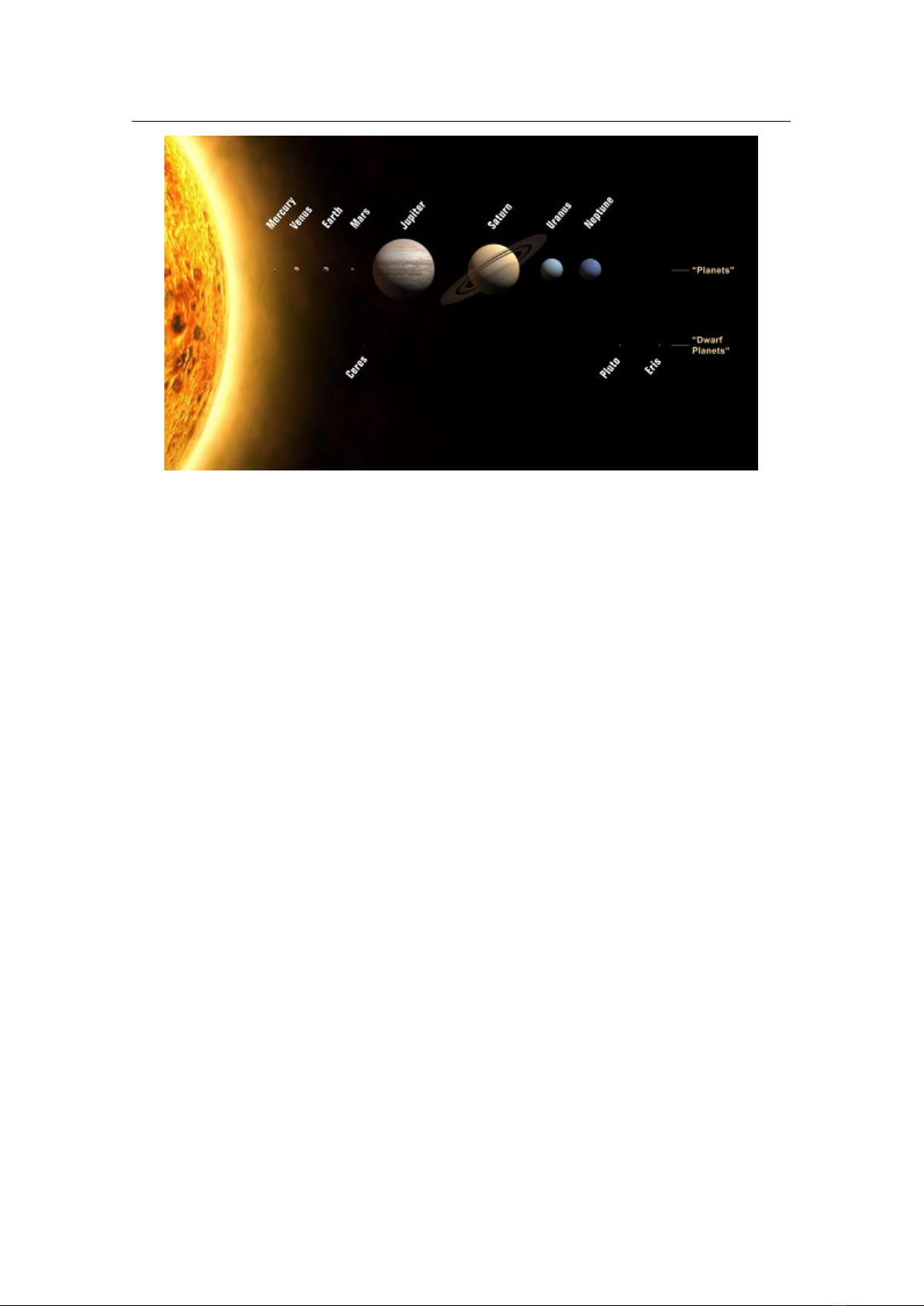
282 Chapter 19. Astronomical Phenomena
Figure 19.4: The Planets
as seen from Earth shows only a thin crescent. Therefore in these days around the New Moon, the
thin crescent can often be seen complemented into a softly glowing full disk. Stellarium’s estimate
for visual magnitude is based on the mentioned references and a new standard value for the solar
illumination constant of 133.1 klx (Ashdown, 2019).
19.4 The Major Planets
Unlike the stars whose relative positions remain more or less constant, the planets seem to move
across the sky over time (the word “planet” comes from the Greek for “wanderer”). The planets
are siblings of the Earth, massive bodies that are in orbit around the Sun. Until 2006 there was no
formal definition of a planet, leading to some confusion about the classification for some bodies
traditionally regarded as being planets, but which didn’t seem to fit with the others.
In 2006 the International Astronomical Union (IAU) defined a planet as a celestial body that,
within the Solar System:
1. is in orbit around the Sun
2.
has sufficient mass for its self-gravity to overcome rigid body forces so that it assumes a
hydrostatic equilibrium (nearly round) shape; and
3. has cleared the neighbourhood around its orbit
or within another system:
1. is in orbit around a star or stellar remnants
2. has a mass below the limiting mass for thermonuclear fusion of deuterium; and
3. is above the minimum mass/size requirement for planetary status in the Solar System.
Moving from the Sun outwards, the 8 major planets are: Mercury, Venus, Earth, Mars, Jupiter,
Saturn, Uranus and Neptune. Since the formal definition of a planet in 2006 Pluto has been relegated
to having the status of dwarf planet, along with bodies such as Ceres and Eris. See figure 19.4.
19.4.1 Terrestrial Planets
The planets closest to the sun are called collectively the terrestrial planets. The terrestrial planets
are: Mercury, Venus, Earth and Mars.

19.5 The Minor Bodies 283
The terrestrial planets are relatively small, comparatively dense, and have solid rocky surface.
Most of their mass is made from solid matter, which is mostly rocky and/or metallic in nature.
19.4.2 Jovian Planets
Jupiter, Saturn, Uranus and Neptune make up the Jovian planets, also called gas giants. They are
much more massive than the terrestrial planets, and do not have a solid surface. Jupiter is the largest
of all the planets with a diameter of about 12, and mass over 300 times that of the Earth!
The Jovian planets do not have a solid surface – the vast majority of their mass being in
gaseous form (although they may have rocky or metallic cores). Because of this, they have an
average density which is much less than the terrestrial planets. Saturn’s mean density is only about
0.7g/cm
3
– it would float in water!
19.4.3 Apparent Magnitudes of the Planets
The apparent magnitude of the planets can be found in astronomical almanachs. Over time, several
scientific studies have refined these models. A few of them have been implemented in Stellarium:
Müller 1893 G. Müller formulated visual magnitudes for the planets from visual observations of
1877–1891. They can be found in Meeus (1998) and Wilkins (1961). They give notably lower
brightness estimates than the later models, which however provide instrumental magnitudes
in the Johnson V photometric system. Several important historical studies from the early
20th century are based on these estimates.
Astronomical Almanac 1984
This model was used in the Astronomical Almanac starting in 1984.
The expressions are allegedly “due to D. L. Harris”, but J. Meeus (1998, p.286) denies this
origin.
Explanatory Supplement 1992 Expressions from Seidelmann (1992).
Explanatory Supplement 2013 Expressions from Urban and Seidelmann (2013).
Mallama & Hilton 2018
The currently most modern expressions include e.g. a model for Mars
which takes the brightening and dimming of albedo features into account (Mallama and
J. L. Hilton, 2018).
Generic A simple model based on albedo, size and distance.
19.5 The Minor Bodies
As well as the Major Planets, the solar system also contains innumerable smaller bodies in orbit
around the Sun. These are generally the dwarf planets (Ceres, Pluto, Eris), the other minor planets,
also known as planetoids or asteroids, and comets.
While the positions of the major planets can meanwhile be computed for many millennia in the
past and future, the minor bodies have only been systematically observed since the beginning of the
19th century.
3
The small masses occasionally pass by the larger planets which exert gravitational
forces, so that the orbits of the minor bodies are not stable and cannot be computed for long periods.
The positions are computed by using osculating orbital elements, which describe the motions on
instantaneous Kepler orbits
4
. If you want to compute positions of these objects with Stellarium,
you need to have valid (current) orbital elements. See Appendix D.2.2 for more details.
3
The first discovered asteroid, (1) Ceres, was in fact discovered on January 1, 1801.
4
The mathematician and astronomer JOHANNES KEPLER (1571–1630) discovered that planets do not
move on circles (which had been postulated since antiquity), but on “conical sections”, i.e., ellipses, parabolae
or even hyperbolae. The latter two can be observed for far-out comets and recently even interstellar objects
passing the Sun.

284 Chapter 19. Astronomical Phenomena
19.5.1 Asteroids
Asteroids are celestial bodies orbiting the Sun in more or less regular orbits mostly between Mars
and Jupiter. They are generally rocky bodies like the inner (terrestrial) planets, but of much smaller
size. They are countless in number ranging in size from about ten meters to hundreds of kilometres.
19.5.2 Comets
A comet is a small body in the solar system that orbits the Sun and (at least occasionally) exhibits a
coma (or atmosphere) and/or a tail.
Most comets have a very eccentric orbit (featuring a highly flattened ellipse, or even a parabolic
track), and as such spend most of their time a very long way from the Sun. Comets are composed
of rock, dust and ices. When they come close to the Sun, the heat evaporates the ices, causing a
gaseous release. This gas and loose material which comes away from the body of the comet is
swept away from the Sun by the Solar wind, forming the tail. The outgassing may also change the
orbit of the comet, so that its orbital elements should be used only for a few months around their
epoch.
Most larger comets exhibit two kinds of tail: a straight gas tail (often blue-green in photographs),
and a wider, occasionally curved dust tail (reflecting whitish sunlight).
Comets whose orbit brings them close to the Sun more frequently than every 200 years are
considered to be short period comets, the most famous of which is probably Comet Halley, named
after the British astronomer EDMUND HALLEY (1656–1741/42
5
), which has an orbital period of
roughly 76 years.
19.6 Meteoroids
These objects are small pieces of space debris left over from the early days of the solar system or
which crumbled off a comet when it came close to the sun. These particles orbit the Sun and come
in a variety of shapes, sizes an compositions, ranging from microscopic dust particles up to about
ten meters across.
Sometimes these objects collide with the Earth. The closing speed of these collisions is
generally extremely high (tens of kilometres per second). When such an object ploughs through the
Earth’s atmosphere, a large amount of kinetic energy is converted into heat and light, and a visible
flash or streak can often be seen with the naked eye. Even the smallest particles can cause these
events which are commonly known as shooting stars.
While smaller objects tend to burn up in the atmosphere, larger, denser objects can penetrate
the atmosphere and strike the surface of the planet, sometimes leaving meteor craters.
Sometimes the angle of the collision means that larger objects pass through the atmosphere but
do not strike the Earth. When this happens, spectacular fireballs are sometimes seen.
To clarify some terminology:
Meteoroids are the objects when they are floating in space.
Meteor is the name given to the visible atmospheric phenomenon.
Shooting Star colloquial term for a small meteor
Fireball, Bolide
term for a very bright meteor. These illuminate the landscape, sometimes
for several seconds, and occasionally even cause sounds. These are also candidates for
Meteorites , the objects that penetrate the atmosphere and land (or impact) on the surface.
5
EDMUND HALLEY lived in a time when Great Britain still used the Julian calendar and started the years
in March. He died on January 14th, 1741 (British Julian), which was called January 25th 1742 (Gregorian)
in most other European countries.

19.7 Zodiacal Light and Gegenschein 285
In some nights over the year you can observe increased meteorite activity. Those meteors seem
to come from a certain point in the sky, the Radiant. But what we see is similar to driving through a
mosquito swarm which all seem to come head-on. Earth itself moves through space, and sweeps up
a dense cloud of particles which originates from a comet’s tail. Stellarium’s Meteor Shower plugin
(see section 14.6) can help you planning your next meteor observing night.
19.7 Zodiacal Light and Gegenschein
In very clear nights on the best observing sites, far away from the light pollution of our cities, you
can observe a feeble glow also known as “false twilight” after evening twilight in the west, or
before dawn in the east. The glow looks like a wedge of light along the ecliptic. Exactly opposite
the sun, there is another dim glow that can be observed with dark-adapted eyes in perfect skies: the
Gegenschein (counterglow).
This is sunlight reflected off the same dust and meteoroids in the plane of our solar system
which is the source of meteors. Stellarium’s sky can show the Zodiacal light (Kwon, Hong, and
Weinberg, 2004), but observe how quickly light pollution kills its visibility!
19.8 The Milky Way
There is a band of very dense stars running right round the sky in huge irregular stripe. Most of
these stars are very dim, but the overall effect is that on very dark clear nights we can see a large,
beautiful area of diffuse light in the sky. It is this for which we name our galaxy the Milky Way.
The reason for this effect is that our galaxy is somewhat like a disc, and we are off to one side.
Thus when we look towards the centre of the disc, we see more a great concentration of stars (there
are more star in that direction). As we look out away from the centre of the disc we see fewer stars -
we are staring out into the void between galaxies!
It’s a little hard to work out what our galaxy would look like from far away, because when we
look up at the night sky, we are seeing it from the inside. All the stars we can see are part of the
Milky Way, and we can see them in every direction. However, there is some structure. There is a
higher density of stars in particular places.
19.9 Nebulae
Seen with the naked eye, binoculars or a small telescope, a nebula (plural nebulae) is a fuzzy patch
on the sky. Historically, the term referred to any extended object, but the modern definition excludes
some types of object such as galaxies.
Observationally, nebulae are popular objects for amateur astronomers – they exhibit complex
structure, spectacular colours (in most cases only visible in color photography) and a wide variety
of forms. Many nebulae are bright enough to be seen using good binoculars or small to medium
sized telescopes, and are a very photogenic subject for astro-photographers.
Nebulae are associated with a variety of phenomena, some being clouds of interstellar dust and
gas in the process of collapsing under gravity, some being envelopes of gas thrown off during a
supernova event (so called supernova remnants), yet others being the remnants of dumped outer
layers around dying stars (planetary nebulae).
Examples of nebulae for which Stellarium has images include the Crab Nebula (M1), which
is a supernova remnant, and the Dumbbell Nebula (M27) and the Ring Nebula (M57) which are
planetary nebulae.

286 Chapter 19. Astronomical Phenomena
19.9.1 The Messier Objects
The Messier objects are a set of astronomical objects catalogued by CHARLES MESSIER (1730–
1817) in his catalogue of Nebulae and Star Clusters first published in 1774. The original motivation
behind the catalogue was that Messier was a comet hunter, and he was frustrated by objects which
resembled but were not comets. He therefore compiled a list of these annoying objects.
The first edition covered 45 objects numbered M1 to M45. The total list consists of 110
objects, ranging from M1 to M110. The final catalogue was published in 1781 and printed in the
Connaissance des Temps in 1784. Many of these objects are still known by their Messier number.
Because the Messier list was compiled by astronomers in the Northern Hemisphere, it contains
only objects from the north celestial pole to a celestial latitude of about
−35
◦
. Many impressive
Southern objects, such as the Large and Small Magellanic Clouds are excluded from the list.
Because all of the Messier objects are visible with binoculars or small telescopes (under favourable
conditions), they are popular viewing objects for amateur astronomers. In early spring, astronomers
sometimes gather for “Messier Marathons”, when all of the objects can be viewed over a single
night.
Stellarium includes images of many Messier objects.
19.9.2 The Caldwell catalogue
The Caldwell catalogue is an astronomical catalogue of 109 star clusters, nebulae, and galaxies for
observation by amateur astronomers. The list was compiled by PATRICK MOORE (1923–2012) as a
complement to the Messier catalogue (O’Meara, 2003).
While the Messier catalogue is used by amateur astronomers as a list of deep-sky objects for
observation, Moore noted that Messier’s list was not compiled for that purpose and excluded many
of the sky’s brightest deep-sky objects (O’Meara, 2003), such as the Hyades, the Double Cluster
(NGC 869 and NGC 884), and the Sculptor Galaxy (NGC 253). The Messier catalogue was actually
compiled as a list of known objects that might be confused with comets. Moore also observed that
since Messier compiled his list from observations in Paris, it did not include bright deep-sky objects
visible in the Southern Hemisphere, such as Omega Centauri, Centaurus A, the Jewel Box, and 47
Tucanae (O’Meara, 2003). Moore compiled a list of 109 objects to match the commonly accepted
number of Messier objects (he excluded M110 (Moore, 1995)), and the list was published in Sky &
Telescope in December 1995 (Moore, 1995).
Moore used his other surname – Caldwell – to name the list, since the initial of “Moore” is
already used for the Messier catalogue (O’Meara, 2003). Entries in the catalogue are designated
with a “C” and the catalogue number (1 to 109).
Unlike objects in the Messier catalogue, which are listed roughly in the order of discov-
ery by Messier and his peers, the Caldwell catalogue is ordered by declination, with C1 being
the most northerly and C109 being the most southerly (O’Meara, 2003), although two objects
(C 26=NGC 4244 and C 41, the Hyades) are listed out of sequence (O’Meara, 2003). Other
errors in the original list have since been corrected: it incorrectly identified the S Norma Clus-
ter (C 89=NGC 6087) as NGC 6067 and incorrectly labelled the Lambda Centauri Cluster
(C 100=IC 2944) as the Gamma Centauri Cluster (O’Meara, 2003).
19.10 Galaxies
Stars, it seems, are gregarious – they like to live together in groups. These groups are called galaxies.
The number of stars in a typical galaxy is literally astronomical – many billions – sometimes over
hundreds of billions of stars!
Our own star, the sun, is part of a galaxy. When we look up at the night sky, all the stars we
can see are in the same galaxy. We call our own galaxy the Milky Way (or sometimes simply “the

19.11 Eclipses and Transits 287
Galaxy”
6
).
Other galaxies appear in the sky as dim fuzzy blobs. Only four are normally visible to the
naked eye. The Andromeda galaxy (M31) visible in the Northern hemisphere, the two Magellanic
clouds, visible in the Southern hemisphere, and the home galaxy Milky Way, visible in parts from
north and south under dark skies.
There are thought to be billions of galaxies in the universe comprised of an unimaginably large
number of stars.
The vast majority of galaxies are so far away that they are very dim, and cannot be seen without
large telescopes, but there are dozens of galaxies which may be observed in medium to large sized
amateur instruments. Stellarium includes images of many galaxies, including the Andromeda
galaxy (M31), the Pinwheel Galaxy (M101), the Sombrero Galaxy (M104) and many others.
Astronomers classify galaxies according to their appearance. Some classifications include
spiral galaxies, elliptical galaxies, lenticular galaxies and irregular galaxies.
19.11 Eclipses and Transits
Eclipses occur when an apparently large celestial body (planet, moon etc.) moves between the
observer and a more distant object – the more distant object being eclipsed by the nearer one.
19.11.1 Solar Eclipses
Solar eclipses occur when our Moon moves between the Earth and the Sun. This happens when the
inclined orbit of the Moon causes its path to cross the ecliptic and our line of sight to the Sun. In
essence it is the observer falling under the shadow of the Moon.
By a wonderful coincidence, Sun and Moon appear of almost identical size in Earth’s sky, but
the Moon’s elliptical orbit sometimes causes it to appear just a bit smaller than the Sun.
There are therefore three types of solar eclipses:
Partial The Moon only covers part of the Sun’s surface.
Total The Moon completely obscures the Sun’s surface.
Annular
The Moon is at or close to apogee (furthest from Earth in its elliptic orbit) and its disc is
too small to completely cover the Sun. In this case most of the Sun’s disc is obscured – all
except a thin ring around the edge.
Sometimes the eclipse starts annular, but when the shadow reaches the part of the globe closest
to the Moon, it becomes just large enough to cover the sun totally, and when receding, it may go
back to the annular characteristic. This is called annular-total in the classical literature, or hybrid
in more recent works.
19.11.2 Lunar Eclipses
Lunar eclipses occur when the Earth moves between the Sun and the Moon, and the Moon is in the
Earth’s shadow. They occur under the same basic conditions as the solar eclipse but appear to occur
more often because the Earth’s shadow is so much larger than the Moon’s, and a Lunar eclipse is
observable from more than half the Earth’s surface, while a Solar eclipse is limited to a smaller
region.
The geometrical begin of a Lunar eclipse is totally unobservable: Seen from a point near the
observable edge of the Lunar surface, the large black disk of Earth just touches the Solar disk.
While the time of this event can be determined, the effect on the apparent brightness of the Moon’s
surface as observed from Earth is close to zero. Only as more of the Solar disk is occulted by Earth,
this spot on the Lunar surface will receive less sunlight and will appear darker when observed
6
Which means closely the same thing, the word deriving from Greek gala=milk.

288 Chapter 19. Astronomical Phenomena
from Earth. A rule of thumb says that 70% of the Moon must enter the Earth’s penumbra (partial
shadow) before a light defect can be noted by attentive human observers.
The Earth’s umbra (deep shadow) is then much darker. As soon as an observer on the Lunar
edge experiences a Total Solar eclipse, observers on Earth see the begin of the partial eclipse.
Total lunar eclipses are more noticeable than partial eclipses because the Moon moves fully
into the Earth’s shadow and there is very noticeable darkening. However, the Earth’s atmosphere
refracts light (bends it) in such a way that some sunlight can still fall on the Moon’s surface even
during total eclipses. The blue parts of sunlight are scattered and filtered away, so that there is a
marked reddening of the light as it passes through the atmosphere, and this makes the Moon appear
in a deep red colour. The darkness and colors are notably influenced by atmospheric clarity and
clouds. After big volcanic eruptions eclipses are often reported to appear darker. ANDRÉ DANJON
(1890–1967) has introduced a scale for the apparent brightness of the fully eclipsed Moon, where
0 is given for extremely dark eclipses and 4 for very bright ones. These unpredictable brightness
differences make accurate simulation of the exact appearance impossible, but Stellarium’s display
gives a pretty good impression for eclipses given as 2-3 on this Danjon scale.
Earth’s atmosphere also makes the shadow slightly larger than what can be derived by the geo-
metrical sizes and distances of the involved objects. The Astronomical Almanac uses a traditional
enlargement by 2% after WILLIAM CHAUVENET (1820–1870) while recent eclipse experts prefer
another formulation which leads to a slightly smaller enlargement after ANDRÉ DANJON (Espenak
and Meeus, 2009). You can select which formulation you prefer (see section 4.4.2).
19.11.3 Transits
The term “transit” generally describes the passage of one object in front of another
7
. The most
prominent examples are the passages of the inferior planets Mercury or Venus between the Sun and
Earth, where they appear as tiny black disks on the glaringly bright Solar disk. The disk of Venus
can be seen with the unaided eye
8
, while Mercury is too small to be discernible.
Observing the transits of Venus from various locations on Earth was an important scientific
endeavour in previous centuries. It allows a direct determination of the distance scale in the Solar
System. Unfortunately, these transits are rare events: After two such transits 8 years apart, there is
a gap lasting more than a century. The last such transits occurred in 2004 and 2012. Mercury’s
transits are much more frequent.
In the telescope age, this also can be a passage of a Jovian Moon in front of Jupiter, or even
the passage of a shadow of such a moon over Jupiter’s disk, or, more recently, the passage of an
artificial satellite in front of the Sun or Moon.
19.11.4 Contact Times
Eclipse and transit observers like to prepare tables of precomputed contact times for which they use
terminology shown in Tables 19.6-19.8.
19.12 Observing Hints
When stargazing, there’s a few little things which make a lot of difference, and are worth taking
into account.
Dark skies
For many people getting away from light pollution isn’t an easy thing. At best it means
a drive away from the towns, and for many the only chance to see a sky without significant
glow from street lighting is on vacation. If you can’t get away from the cities easily, make
the most of it when you are away.
7
Another “transit” means the crossing of the meridian by the object.
8
Never look into the Sun without proper filters!

19.12 Observing Hints 289
Contact Name Description
First Begin of partial eclipse Moon first touches Sun from the outside
Second Begin of totality Moon completely covers the Sun
Mid-eclipse central time
Third End of totality Bright Solar edge re-appears from complete occultation
Fourth End of partial eclipse Moon leaves Sun completely
Table 19.6: Contact terminology for Total Solar eclipses.
Contact Name, Description
First Penumbral Begin of (penumbral) eclipse. Unobservable.
Moon first touches Earth’s geometrical shadow cone from the outside.
Second Penumbral Begin of total immersion in penumbra
Moon shows a notable darkening
First Umbral Begin of partial eclipse
Moon first touches the central dark shadow
Second Umbral Begin of totality
Moon completely immersed in Earth’s umbra (dark shadow)
Maximum Mid-eclipse, central time
Third Umbral End of totality
A bright Lunar edge re-appears from complete occultation
Fourth Umbral End of partial eclipse
Moon leaves umbra completely
Third Penumbral End of total penumbral phase
Lunar edge leaves penumbra. The opposide side is still darkened
Fourth Penumbral End of (penumbral) eclipse. Unobservable.
Moon leaves penumbra completely.
Table 19.7: Contact terminology for Lunar eclipses. Depending on shadow geometry,
the second penumbral contact may occur only after the first umbral, and third penumbral
contact before fourth umbral.
Contact Name Description
First Exterior Ingress Planet/Moon first touches Sun from the outside
Second Interior Ingress Planet/Moon starts to be visible completely inside Sun
Mid-transit central time
Third Interior Egress Planet/Moon first touches Sun from the inside
Fourth Exterior Egress Planet/Moon leaves Sun completely
Table 19.8: Contact terminology for Transits and Annular Solar eclipses.

290 Chapter 19. Astronomical Phenomena
Wrap up warm
The best observing conditions are the same conditions that make for cold nights,
even in the summer time. Observing is not a strenuous physical activity, so you will feel the
cold more than if you were walking around. Wear a lot of warm clothing, don’t sit/lie on the
floor (at least use a camping mat, better take a deck-chair), and take a flask of hot drink.
Dark adaptation
The true majesty of the night sky only becomes apparent when the eye has had
time to become accustomed to the dark. This process, known as dark adaptation, can take up
to half an hour, and as soon as the observer sees a bright light they must start the process
over. Red light doesn’t compromise dark adaptation as much as white light, so use a red
torch if possible (and one that is as dim as you can manage with). A dim single red LED
light is ideal, also to have enough light to take notes.
The Moon
Unless you’re particularly interested in observing the Moon on a given night, it can be
a nuisance—it can be so bright as to make observation of dimmer objects such as nebulae
impossible. When planning what you want to observe, take the phase and position of the
Moon into account. Of course Stellarium is the ideal tool for finding this out!
Averted vision
A curious fact about the eye is that it is more sensitive to dim light towards the
edge of the field of view. If an object is slightly too dim to see directly, looking slightly off
to the side but concentrating on the object’s location can often reveal it.
Angular distance
Learn how to estimate angular distances. Learn the angular distances described
in section 18.5.2. If you have a pair of binoculars, find out the angular distance across the
field of view and use this as a standard measure.
19.13 Atmospheric effects
19.13.1 Atmospheric Extinction
Atmospheric Extinction is the attenuation of light of a celestial body by Earth’s atmosphere. In
the last split-second of its travel into our eyes or detectors, light from outer space has to pass our
atmosphere, through layers of mixed gas, water vapour and dust. If a star is in the zenith, its light
must pass one air mass and is reduced by whatever amount of water and dust is above you. When
the star is on the horizon, it has to pass about 40 times longer through the atmosphere: 40 air masses
(Fig. 19.5). The number of air masses increases fast in low altitudes, this is why we see so few
stars along the horizon. Usually blue light is extinguished more, this is why the sun and moon (and
brighter stars) appear reddish on the horizon.
Stellarium can simulate extinction, and you can set the opacity of your atmosphere with a
global factor
k
, the magnitude loss per airmass (see section 4.4.1). The best mountaintop sites may
have k = 0.15, while k = 0.25 seems a value usable for good locations in lower altitudes.
19.13.2 Atmospheric Refraction
Atmospheric Refraction is a lifting effect of our atmosphere which can be observed by the fact that
objects close to the horizon appear higher than they should be if computed only with spherical
trigonometry. Stellarium simulates refraction for terrestrial locations when the atmosphere is
switched on. Refraction depends on air pressure and temperature. Figure 19.6 has been created
from the same formulae that are employed in Stellarium. You can see how fast refraction grows
very close to the mathematical horizon.
Note that these models can only give approximate conditions. There are many weird effects in
the real atmosphere, when temperature inversion layers can create light ducts, double sunsets etc.
Also note that the models give meaningful results only for altitudes above approximately
−2
◦
.
Below that, in nature, there is always ground which blocks our view. In Stellarium you can switch
off the ground, and you can observe a sunset with a strange egg-shaped sun below the horizon. This
is of course nonsense. Stellarium is also not able to properly recreate the atmospheric distortions as
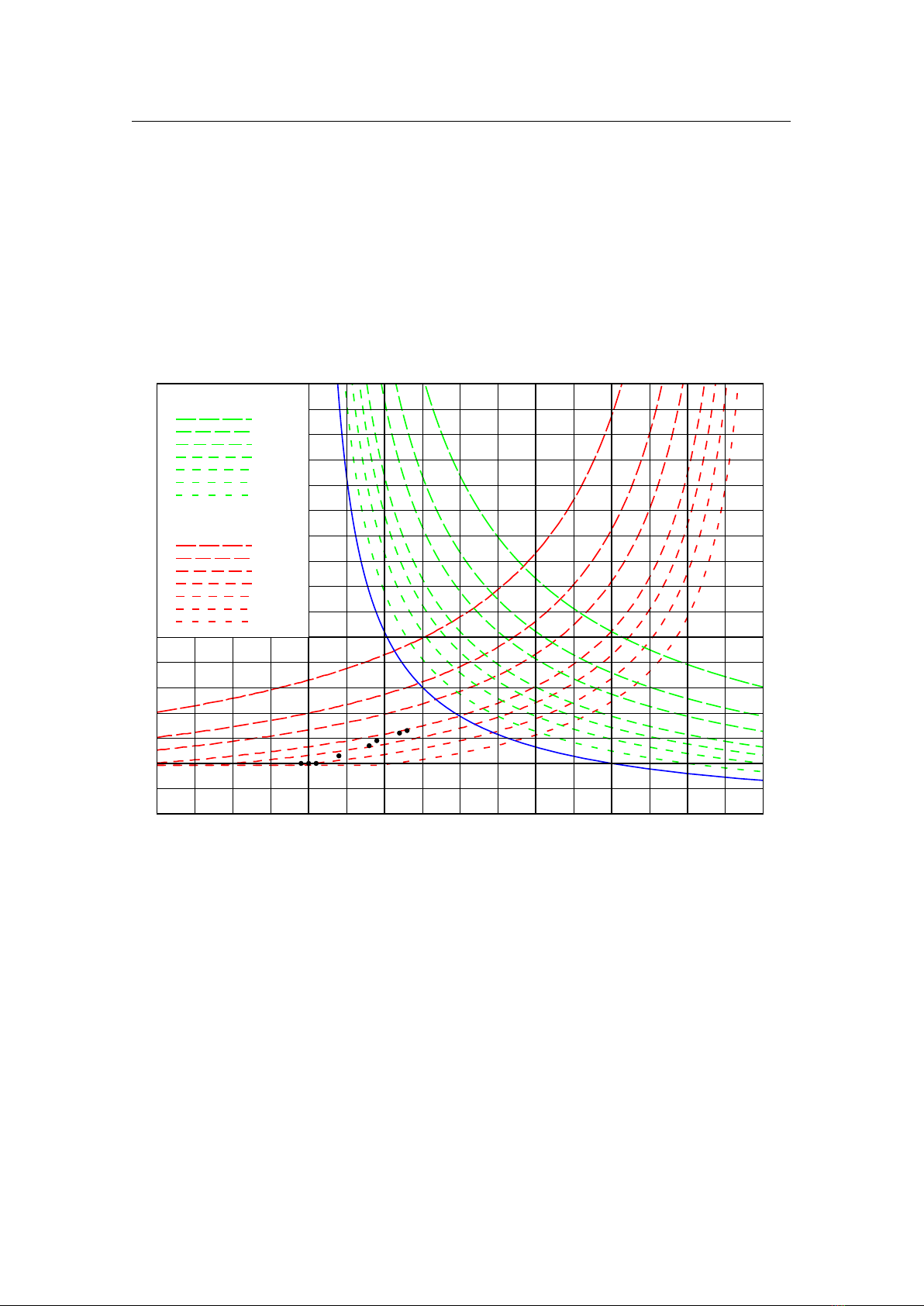
19.13 Atmospheric effects 291
0 10 20 30 40 Airmass
−2 −1 0 1 2 3 4 5 6
mag =
0°
5°
10°
15°
0.4
0.3
0.25
0.2
0.175
0.15
0.125
Star invisible at k_v
0.4
0.3
0.25
0.2
0.175
0.15
0.125
Absorption [Dmag] k_v
Airmass, Absorption and Extinction Angle (m_z=6.5; apparent altitudes)
(Model: Schaefer, S&T4/1987; Airmass: Rozenberg 1966; Observations: Müller 1970)
© Georg Zotti 2009−2010, ASTROSIM
Figure 19.5: Airmass and Extinction. The figure shows Airmass (blue) along the line of
sight in the altitude labeled on the left side. The green curves show how many magnitudes
an object is dimmed down, depending on extinction factor
k
(called
k
v
in the figure). The
red curves indicate at which altitude a star of given magnitude can be seen with good
eyesight, again depending on
k
. The black dots are observed values found in the literature.
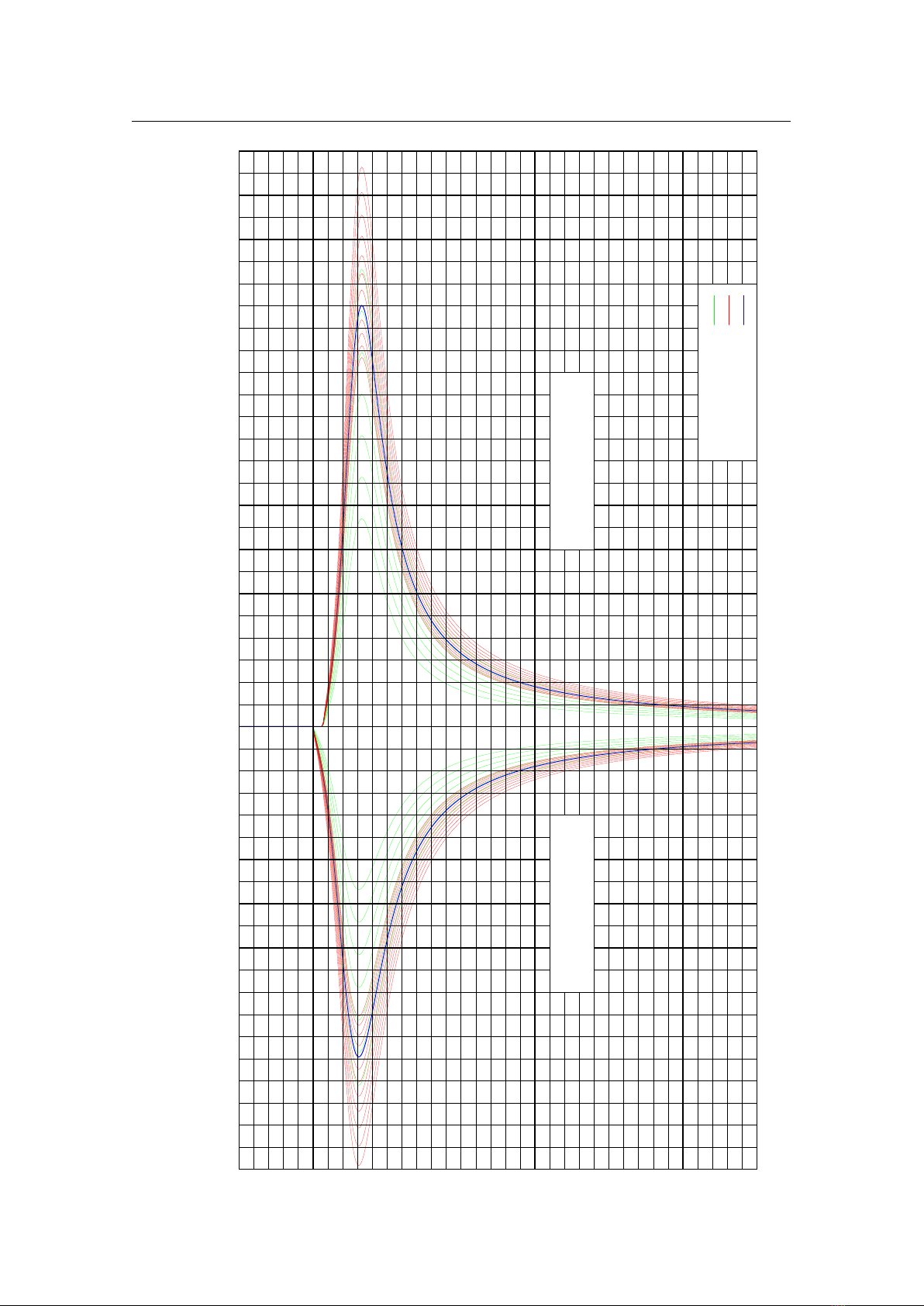
292 Chapter 19. Astronomical Phenomena
−1.3° −1.2° −1.1° −1.0° −0.9° −0.8° −0.7° −0.6° −0.5° −0.4° −0.3° −0.2° −0.1° 0.0° 0.1° 0.2° 0.3° 0.4° 0.5° 0.6° 0.7° 0.8° 0.9°
Dalt
−10°
−5°
0°
5°
10°
15°
20°
25°
1013.25 mbar, 10°C
Temperature: −60..10..50°C
Pressure: −500..100..1100 mbar
Bennett’s Formula
Correction of observed altitudes
Sæmundsson’s Formula
Correction of geometric altitudes
Refraction
(Model: Meeus, Astr.Alg.1994)
© Georg Zotti 2010, ASTROSIM
Figure 19.6: Refraction. The figure shows corrective values (degrees) which are subtracted from observed altitudes (left side) to reach geometric
altitudes, or values to be added to computed values (right side). The models used are not directly inverse operations.

19.13 Atmospheric effects 293
seen from a stratosphere balloon, where the height of earth’s surface is several degrees below the
mathematical horizon.
Scintillation
Scintillation is the scientific name of the twinkling which stars show in turbulent atmosphere. The
twinkling is caused by moving pockets of air with different temperature. Observe a star low on the
horizon with a telescope, and you will note it does not stand still but dances around a bit, often also
changing color to show red or blue hues. While the twinkling of stars may look fine and comforting
to the naked eye on a nice warm summer evening, telescopic observers and astrophotographers
don’t like it at all. They rather complain about “bad seeing”, because it deteriorates the optical
resolution of their instruments and photographs.
Just like extinction and refraction are stronger along the horizon, stars in low altitude in general
show more twinkling than stars higher up in the sky.
Note that planets seem to be affected less by scintillation: they are not point sources, but little
disks, and so the effect of the turbulent pockets of air distorting different parts of the disks cancels
out a bit when observing with the naked eye: planets appear to be more stable. Of course, the view
in a telescope will still be deteriorated by the turbulent atmosphere.
While bad seeing was one key motivation of sending telescopes into earth orbit since the 1970s,
the latest generation of ground-based giant telescopes is able to compensate for the turbulent motion
by rapidly deforming their secondary mirror.
19.13.3 Light Pollution
An ugly side effect of civilisation is a steady increase in outdoor illumination. Many people
think it increases safety, but while this statement can be questioned, one definite result, aside
from environmental issues like dangers for the nocturnal fauna, are ever worsening conditions for
astronomical observations or just enjoyment of the night sky.
Stellarium can simulate the effect of light pollution on the visibility of celestial objects. This is
controlled from the light pollution section of the Sky tab of the View window (see section 4.10).
Light pollution levels are set using a numerical value between 1 and 9 which corresponds to the
Bortle Dark Sky Scale (see Appendix B). Given that public lighting became bright enough to cause
adverse effects on observability only during the 19th century, Stellarium presents an unpolluted
sky for dates before 1825. Note that of course light pollution was not switched on over night, but
became gradually noticeable over decades, but you have to estimate the appropriate level.
In addition, local variations of the amount of light pollution can be included in a light pollution
layer in the landscapes, see section 7 for details. This foreground layer may include all kinds of
light, e.g. campfires, so this is also available for earlier dates.

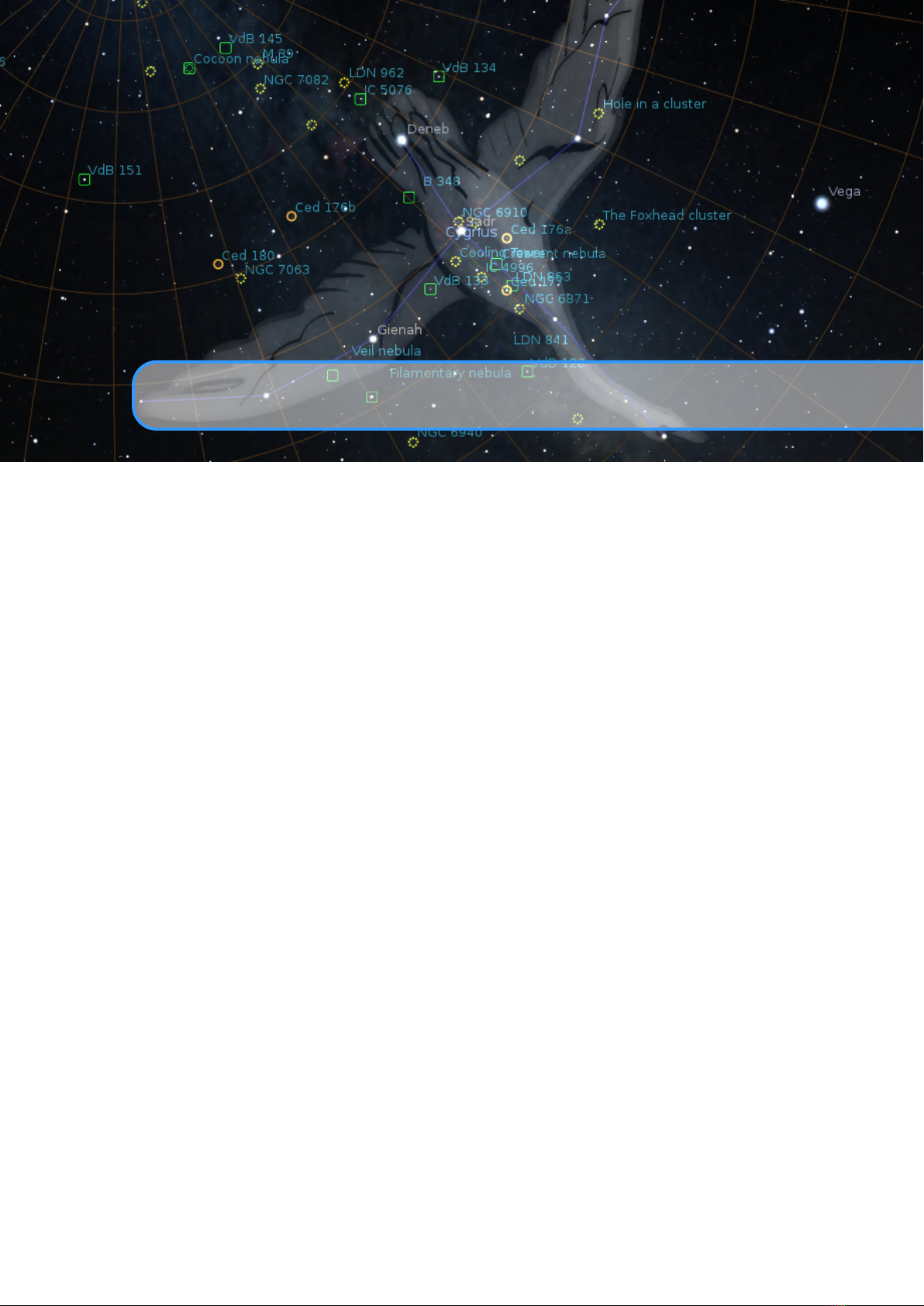
20. A Little Sky Guide
PAUL ROBINSON, WITH ADDITIONS BY ALEXANDER WOLF
This chapter lists some astronomical objects that can be located using Stellarium. All of them
can be seen with the naked eye or binoculars. Since many astronomical objects have more than
one name (often having a “proper name”, a “common name” and various catalogue numbers), the
chapter lists the name as it appears in Stellarium — use this name when using Stellarium’s search
function — and any other commonly used names.
The Location Guide entry gives brief instructions for finding each object using nearby bright
stars or groups of stars when looking at the real sky — a little time spent learning the major
constellations visible from your latitude will pay dividends when it comes to locating fainter (and
more interesting!) objects. When trying to locate these objects in the night sky, keep in mind that
Stellarium displays many stars that are too faint to be visible without optical aid, and even bright
stars can be dimmed by poor atmospheric conditions and light pollution.
20.1 Dubhe and Merak, The Pointers
Type: Stars
Magnitude: 1.83, 2.36
Location Guide: The two “rightmost” of the seven stars that form the main shape of “The Plough”
(or “Big Dipper”, part of Ursa Major).
Northern hemisphere observers are very fortunate to have two stars that point towards Polaris,
which lies very close to the Northern Celestial Pole. Whatever the time of night or season of the
year, they are always an immediate clue to the location of Polaris, the Pole Star.
20.2 M31, Messier 31, The Andromeda Galaxy
Type: Spiral Galaxy
Magnitude: 3.4

296 Chapter 20. A Little Sky Guide
Location Guide: Find the three bright stars that constitute the main part of the constellation of
Andromeda. From the middle of these look toward the constellation of Cassiopeia.
M31 is the most distant object visible to the naked eye, and among the few nebulae that can be
seen without a telescope or powerful binoculars. Under good conditions it appears as a large fuzzy
patch of light. It is a galaxy containing billions of stars whose distance is roughly 2.5 million light
years from Earth.
20.3 The Garnet Star, µ Cephei
Type: Variable Star
Magnitude: 4.25 (Avg.)
Location Guide: Cephius lies “above” the W-shape of Cassiopeia. The Garnet Star lies slightly to
one side of a point halfway between 5 Cephei and 21 Cephei.
A “supergiant” (1035 solar radii) of spectral class M with a strong red colour. Given its name
by Sir William Herschel in the 18th century, the colour is striking in comparison to its blue-white
neighbours.
20.4 4 and 5 Lyrae, ε Lyrae
Type: Double Star
Magnitude: 4.7
Location Guide: Close to Vega (α Lyrae), one of the brightest stars in the sky.
In binoculars
ε
Lyrae is resolved into two separate stars. Remarkably, each of these is also a
double star (although this will only be seen with a telescope) and all four stars form a physical
system.
20.5 M13, Hercules Cluster
Type: Globular Cluster
Magnitude: 5.8
Location Guide: Located approximately 1/3 of the way along a line from 44 (
η
) to 40 (
ζ
) Herculis.
This cluster of hundreds of thousands of mature stars appears as a circular “cloud” using the
naked eye or binoculars (a large telescope is required to resolve individual stars). Oddly the cluster
appears to contain one young star and several areas that are almost devoid of stars.
20.6 M45, The Pleiades, The Seven Sisters
Type: Open Cluster
Magnitude: 1.2 (Avg.)
Location Guide: Lies on the Bull’s back, about 1/3 between Aldebaran in Taurus and Almaak in
Andromeda.
Depending upon conditions, 6 to 9 of the blueish stars in this famous cluster will be visible to
someone with average eyesight, and in binoculars it is a glorious sight. The cluster has more than
500 members in total, many of which are shown to be surrounded by nebulous material in long
exposure photographs.

20.7 C41, The Hyades 297
20.7 C41, The Hyades
Type: Open Cluster
Magnitude: 0.5 (Avg.)
Location Guide: Lies near Aldebaran in Taurus.
The Hyades span about 6
◦
of sky because they are one of the nearest open clusters, being about
153 light years away. The age of the Hyades is estimated to be about 625 million years. The five
brightest member stars of the Hyades have consumed their hydrogen fuel in their cores and are now
evolving into giant stars. Four of these stars, with Bayer designations
γ
,
δ
1
,
ε
, and
θ
Tauri, form an
asterism that is traditionally identified as the head of Taurus, the Bull.
20.8 Algol, The Demon Star, β Persei
Type: Variable Star
Magnitude: 3.0 (Avg.)
Location Guide: Halfway between Aldebaran in Taurus and the middle star of the “W” of
Cassiopeia.
Once every three days or so, Algol’s brightness changes from 2.1 to 3.4 and back within a
matter of hours. The reason for this change is that Algol has a dimmer giant companion star, with an
orbital period of about 2.8 days, that causes a regular partial eclipse. Although Algol’s fluctuations
in magnitude have been known since at least the 17th century, it was the first to be proved to be due
to an eclipsing companion — it is therefore the prototype Eclipsing Variable.
20.9 Sirius, α Canis Majoris
Type: Star
Magnitude: -1.47
Location Guide: Sirius is easily found by following the line of three stars in Orion’s belt south-
wards.
Sirius is a white dwarf star at a comparatively close 8.6 light years. This proximity and its high
innate luminance makes it the brightest star in our sky. Sirius is a double star; its companion is a
white dwarf, much dimmer but very hot, and is believed to be smaller than Earth.
20.10 M44, The Beehive, Praesepe
Type: Open Cluster
Magnitude: 3.7
Location Guide: Cancer lies about halfway between the twins (Castor & Pollux) in Gemini and
Regulus, the brightest star in Leo. The Beehive can be found between Asellus Borealis and Asellus
Australis.
There are probably 350 or so stars in this cluster, although it appears to the naked eye simply as
a misty patch. It contains a mixture of stars from red giants to white dwarf and is estimated to be
some 700 million years old.
20.11 27 Cephei, δ Cephei
Type: Variable Star
Magnitude: 4.0 (Avg.)
Location Guide: Locate the four stars that form the square of Cepheus. One corner of the square

298 Chapter 20. A Little Sky Guide
has two other bright stars nearby forming a distinctive triangle —
δ
is at the head of this triangle
in the direction of Cassiopeia.
δ
Cephei gives its name to a whole class of variables, all of which are pulsating high-mass stars
in the later stages of their evolution.
δ
Cephei is also a double star with a companion of magnitude
6.3 visible in binoculars.
20.12 Betelgeuse, α Orionis, 58 Orionis
Type: Star
Magnitude: 0.45
Location Guide: The distinctly reddish star in the constellation of Orion – one of the shoulders of
Orion.
Betelgeuse is a distinctly reddish, semiregular variable star whose apparent magnitude varies
between 0.0 and 1.3. It is classified as a red supergiant of spectral type M1-2, and is one of the
largest stars visible to the naked eye. If Betelgeuse were at the center of the Solar System, its
surface would extend past the asteroid belt, completely engulfing the orbits of Mercury, Venus,
Earth, Mars, and possibly Jupiter.
In 1920, Betelgeuse became the first extrasolar star to have the angular size of its photosphere
measured. Subsequent studies have reported an angular diameter (apparent size) ranging from
0.042 to 0.056 arcseconds, with the differences ascribed to the non-sphericity, limb darkening,
pulsations, and varying appearance at different wavelengths. It is also surrounded by a complex,
asymmetric envelope roughly 250 times the size of the star, caused by mass loss from the star itself.
20.13 M42, The Great Orion Nebula
Type: Nebula
Magnitude: 4.0
Location Guide: Almost in the middle of the area bounded by Orion’s belt and lower stars, Saiph
and Rigel.
The Great Orion Nebula is the brightest nebula visible in the night sky and lies at about 1.500
light years from Earth. It is a truly gigantic gas and dust cloud that extends for several hundred light
years, reaching almost halfway across the constellation of Orion. The nebula contains a cluster
of hot young stars known as the Trapezium, and more stars are believed to be forming within the
cloud.
20.14 La Superba, Y Canum Venaticorum, HIP 62223
Type: Star
Magnitude: 5.4 (Avg.)
Location Guide: Almost the center of the arch of stars of Ursa Major’s tail. Forms a neat triangle
with Phekda (γ) and Alkaid (η, tail tip) in Ursa Major towards Canes Venatici.
La Superba (215 solar radii) is a “Carbon Star” — a group of relatively cool gigantic (usually
variable) stars that have an outer shell containing high levels of carbon. This shell is very efficient
at absorbing the short wavelengths of blue light, giving carbon stars a distinctive red or orange tint.
It is one of the coolest and reddest known stars.

20.15 52 and 53 Bootis, ν
1
and ν
2
Bootis 299
20.15 52 and 53 Bootis, ν
1
and ν
2
Bootis
Type: Double Star
Magnitude: 5.0, 5.0
Location Guide: Follow a line from Seginus (
γ
Boo, left shoulder) to Nekkar (
β
Boo, the head)
and then continue for the same distance again to arrive at this double star.
This optical double star consists of a pair of different spectral types. 52 Bootis, at approximately
800 light years, is twice as far away as 53 Boo.
20.16 Almach, γ Andromedae
Type: Multiple Star
Magnitude: 2.15 (Avg.)
Location Guide: The bright star located in the “legs” of Andromeda.
In 1778, JOHANN TOBIAS MAYER discovered that
γ
Andromedae was a double star. When
examined in a small telescope, it appears to be a bright, golden-yellow star (
γ
1
Andromedae) next to
a dimmer, indigo-blue star (
γ
2
Andromedae), separated by approximately
10
00
. It is often considered
by stargazers to be a beautiful double star with a striking contrast of color. It was later discovered
that
γ
2
Andromedae is itself a triple star system. What appears as a single star to the naked eye is
thus a quadruple star system.
20.17 Algieba, γ Leonis, 41 Leonis
Type: Double Star
Magnitude: 2.20 (Avg.)
Location Guide: The third brightest star in the constellation Leo – located on the “neck” of Leo.
The bright binary system in Leo with orange-red and yellow or greenish-yellow components
is visible through a modest telescope under good atmospheric conditions. To the naked eye, the
Algieba system shines at mid-second magnitude, but a telescope easily splits the pair. On November
6, 2009, the discovery of a planetary companion around primary star
γ
1
Leonis (
γ
Leonis A) was
announced.
20.18 Castor, α Geminorum
Type: Multiple Star
Magnitude: 1.9 (Avg.)
Location Guide: Castor is the second-brightest object in the constellation of Gemini.
Castor is a multiple star system made up of six individual stars; there are three visual compo-
nents, all of which are spectroscopic binaries. Appearing to the naked eye as a single star, Castor
was first recorded as a double star in 1718 by JAMES POUND, but it may have been resolved into at
least two sources of light by Cassini as early as 1678. The separation between Castor A and Castor
B has increased from about
2
00
(2 arcseconds) in 1970 to about
6
00
in 2017. These two binary pairs
have magnitudes of 1.9 and 3.0.
Both components have much fainter companions, Castor Aa and Ba, and both have orbits of a
few days.
Castor C, or YY Geminorum, was discovered to vary in brightness with a regular period. It is
an eclipsing binary with additional variations due to areas of different brightness on the surface of
one or both stars, as well as irregular flares. The Castor C components orbit each other in less than
a day. Castor C is believed to be in orbit around Castor AB, but with an extremely long period of
several thousand years. It is 73
00
distant from the bright components.

300 Chapter 20. A Little Sky Guide
20.19 PZ Cas, HIP 117078
Type: Variable Star
Magnitude: 8.2 (Avg.)
Location Guide: Lies about 1/3 between Caph (
β
Cas, the top right star of “W”) in Cassiopeia
and ι Cephei (32 Cep, top left star in “rectangle” of Cepheus).
This faint red star is one of the biggest known stars — its average size parameter is 1565 solar
radii (the true value is from 1340 to 1940 solar radii). PZ Cas is a pulsating variable star located in
a region with heavy dust extinction.
20.20 VV Cephei, HIP 108317
Type: Variable Star, Double Star
Magnitude: 5.1 (Avg.)
Location Guide: Lies near the center of the “rectangle” of Cepheus).
This is an interesting eclipsing binary system — VV Cep A (1457 solar radii) is a highly
distorted star in a binary system, losing mass to its B-type companion VV Cephei B (10 solar radii)
for at least part of its orbit.
20.21 AH Scorpii, HIP 84071
Type: Variable Star
Magnitude: 7.1 (Avg.)
Location Guide: Lies in Scorpius, about 1
1
4
of a continuation of the Scorpion’s “tail”.
AH Sco (1411 solar radii) is variable by nearly 3 magnitudes in the visual range, and an
estimated 20% in total luminosity. The variation in diameter is not clear because the temperature
also varies.
20.22 Albireo, β Cygni
Type: Double Star
Magnitude: 3.4, 5.1
Location Guide: The “head” of Cygni.
When viewed with the naked eye, it appears to be a single star. However, in a telescope it
readily resolves into a double star, consisting of Albireo A (amber), and Albireo B (blue-green).
Separated by
35
00
, the two components provide one of the best contrasting double stars in the sky
due to their different colors.
20.23 31 and 32 Cygni, o
1
and o
2
Cygni
Type: Multiple Star
Magnitude: 3.8, 4.0
Location Guide: The two bright stars about 1/2 between Deneb (
α
Cygni, “tail” of Cygnus) and
Rukh (δ Cygni, middle of the left “wing” of Cygnus).
The wide binary
o
1
Cygni and
o
2
Cygni is separated 61
0
(NNE), and this star is an easy naked-
eye double.
o
1
Cygni with 30 Cyg and HD 192579 (HIP 99676) is a moderately difficult triple
system. And surprise — each of o
1
Cyg and o
2
Cyg are also Algol-type eclipsing binaries!
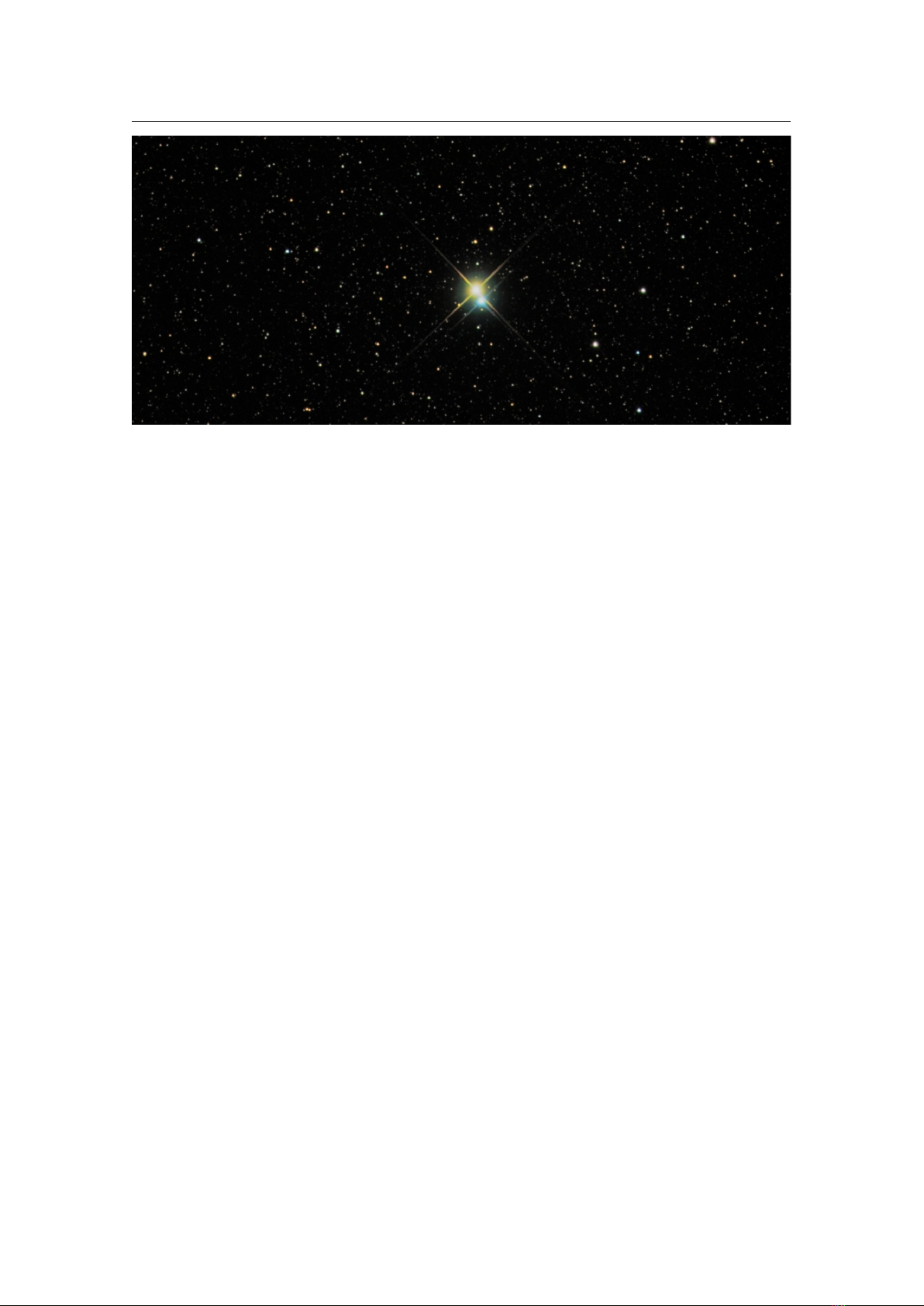
20.24 The Coathanger, Brocchi’s Cluster, Cr 399 301
Figure 20.1: Albireo: A Bright and Beautiful Double. Credit & Copyright: Richard
Yandrick.
20.24 The Coathanger, Brocchi’s Cluster, Cr 399
Type: Asterism
Location Guide: It is best found by slowly sweeping across the Milky Way along an imaginary line
from the bright star Altair toward the even brighter star Vega (around 1/3 between Altair and Vega).
The asterism is made up of 10 stars ranging from 5th to 7th magnitude which form the
conspicuous “coathanger”, a straight line of 6 stars with a “hook” of 4 stars on the south side. Under
a dark sky, Collinder 399 can be seen with the naked eye as an unresolved patch of light; binoculars
or a telescope at very low power are usually needed in order to view the “coathanger” asterism.
20.25 Kemble’s Cascade
Type: Asterism
Location Guide: The asterism lies in the constellation Camelopardalis, about 1/3 between CS
Cam and α Cam — HIP 18505 has magnitude 5 and can be found in the center of the chain.
Kemble’s Cascade is a chain of stars which are visible in binoculars, even in light-polluted
skies.
20.26 The Double Cluster, χ and h Persei, NGC 884 and NGC 869
Type: Open Clusters
Location Guide: The two open clusters near stars χ and h in the constellation Perseus.
The Double Cluster (also known as Caldwell 14 or C14) is the common name for the naked-eye
open clusters NGC 869 and NGC 884 (often designated h Persei and
χ
Persei, respectively). The
Double Cluster is approximately the radiant of the Perseid meteor shower, which peaks annually
around August 12 or 13. Although easy to locate in the northern sky, observing the Double
Cluster in its two parts requires optical aid. They are described as being an “awe-inspiring” and
“breathtaking” sight, and are often cited as targets in astronomical observers’ guides.
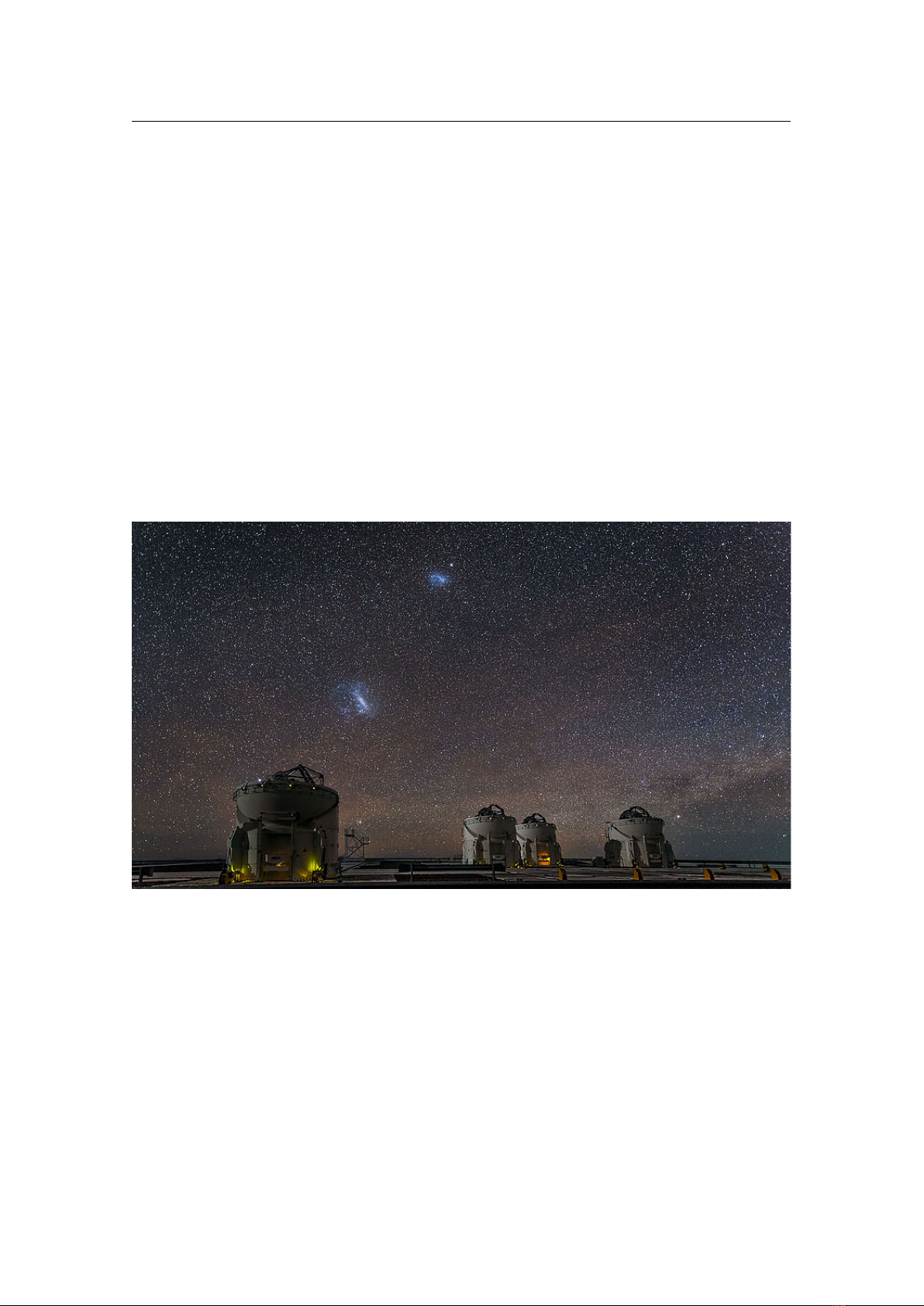
302 Chapter 20. A Little Sky Guide
20.27 Large Magellanic Cloud, PGC 17223
Type: Dwarf Spiral Galaxy
Magnitude: 0.9
Location Guide: It is visible as a faint “cloud” in the night sky of the southern hemisphere
straddling the border between the constellations of Dorado and Mensa, and it appears from Earth
more than 20 times the width of the full moon.
The Large Magellanic Cloud (LMC) is a satellite galaxy of the Milky Way. The Large
Magellanic Cloud is usually considered an irregular galaxy. However, it shows signs of a bar
structure, and has more recently been reclassified as a Magellanic-type dwarf spiral galaxy. At
a distance of 50 kiloparsecs, the LMC is the third closest galaxy to the Milky Way, after the
Sagittarius Dwarf Spheroidal (~16 kiloparsecs) and the putative Canis Major Dwarf Galaxy (~12.9
kiloparsecs, though its status as a galaxy is under dispute) lying closer to the center of the Milky
Way. The LMC has a diameter of about 14,000 light-years (~4.3 kpc) and a mass of approximately
10 billion (
10
10
) solar masses, making it roughly 1/100 as massive as the Milky Way. The LMC has
a wide range of galactic objects and phenomena — surveys of the galaxy have found roughly 60
globular clusters, 400 planetary nebulae, and 700 open clusters, along with hundreds of thousands
of giant and supergiant stars.
Figure 20.2: Small and Large Magellanic Clouds over Paranal Observatory. Credit: ESO/J.
Colosimo.
20.28 Tarantula Nebula, C 103, NGC 2070
Type: Nebula
Magnitude: 7.3
Location Guide: Part of Large Magellanic Cloud.
The Tarantula Nebula (also known as 30 Doradus) is an H II region in the Large Magellanic
Cloud (LMC). 30 Doradus has at its centre the star cluster NGC 2070 which includes the compact
concentration of stars known as R136 that produces most of the energy that makes the nebula
visible. The estimated mass of the cluster is 450,000 solar masses, suggesting it will likely become

20.29 Small Magellanic Cloud, NGC 292, PGC 3085 303
a globular cluster in the future (Bosch, E. Terlevich, and R. Terlevich, 2009). The closest supernova
observed since the invention of the telescope, Supernova 1987A, occurred in the outskirts of the
Tarantula Nebula.
20.29 Small Magellanic Cloud, NGC 292, PGC 3085
Type: Dwarf Irregular Galaxy
Magnitude: 2.2
Location Guide: It is located mostly in the constellation of Tucana and appears as a hazy, light
patch in the night sky about 3
◦
across, looking like a detached piece of the Milky Way. Since it has
a very low surface brightness, it is best viewed from a dark site away from city lights.
The Small Magellanic Cloud (SMC) is a dwarf galaxy near the Milky Way. It is classified
as a dwarf irregular galaxy. It has a diameter of about 7,000 light-years and has a total mass of
approximately 7 billion times the mass of the Sun. The SMC contains a central bar structure and it
is speculated that it was once a barred spiral galaxy that was disrupted by the Milky Way to become
somewhat irregular. At a distance of about 200,000 light-years, it is one of the Milky Way’s nearest
neighbors. It is also one of the most distant objects that can be seen with the naked eye.
20.30 ω Centauri cluster, C 80, NGC 5139
Type: Globular Cluster
Magnitude: 5.3
Location Guide: It is located around 1/3 between ζ and γ Centauri.
Omega Centauri (
ω
Cen), or NGC 5139, is a globular cluster in the constellation of Centaurus
that was first identified as a non-stellar object by Edmond Halley in 1677. Located at a distance
of 15,800 light-years (4,850 pc), it is the largest globular cluster in the Milky Way at a diameter
of roughly 150 light-years. It is estimated to contain approximately 10 million stars and a total
mass equivalent to 4 million solar masses. Omega Centauri is so distinctive from the other galactic
globular clusters that it is thought to have an alternate origin as the core remnant of a disrupted
dwarf galaxy (Noyola, Gebhardt, and Bergmann, 2008).
20.31 47 Tucanae, C 106, NGC 104
Type: Globular Cluster
Magnitude: 4.1
Location Guide: It can be seen with the naked eye near Small Magellanic Cloud.
It is the one of brightest globular cluster in the sky, and is noted for having a very bright and
dense core. It is also one of the most massive globular clusters in the Milky Way Galaxy, containing
millions of stars. The cluster appears roughly the size of the full moon in the sky under ideal
conditions.
20.32 The Coalsack Nebula, C 99
Type: Dark Nebula
Location Guide: Dark region between α and β Crux.
The Coalsack Nebula is the most prominent dark nebula in the skies, easily visible to the
naked eye as a dark patch silhouetted against the southern Milky Way. It is located at a distance of
approximately 600 light years away from Earth. The Coalsack is important in Australian Aboriginal
astronomy, and forms the head of the Emu in the sky in several Aboriginal cultures.
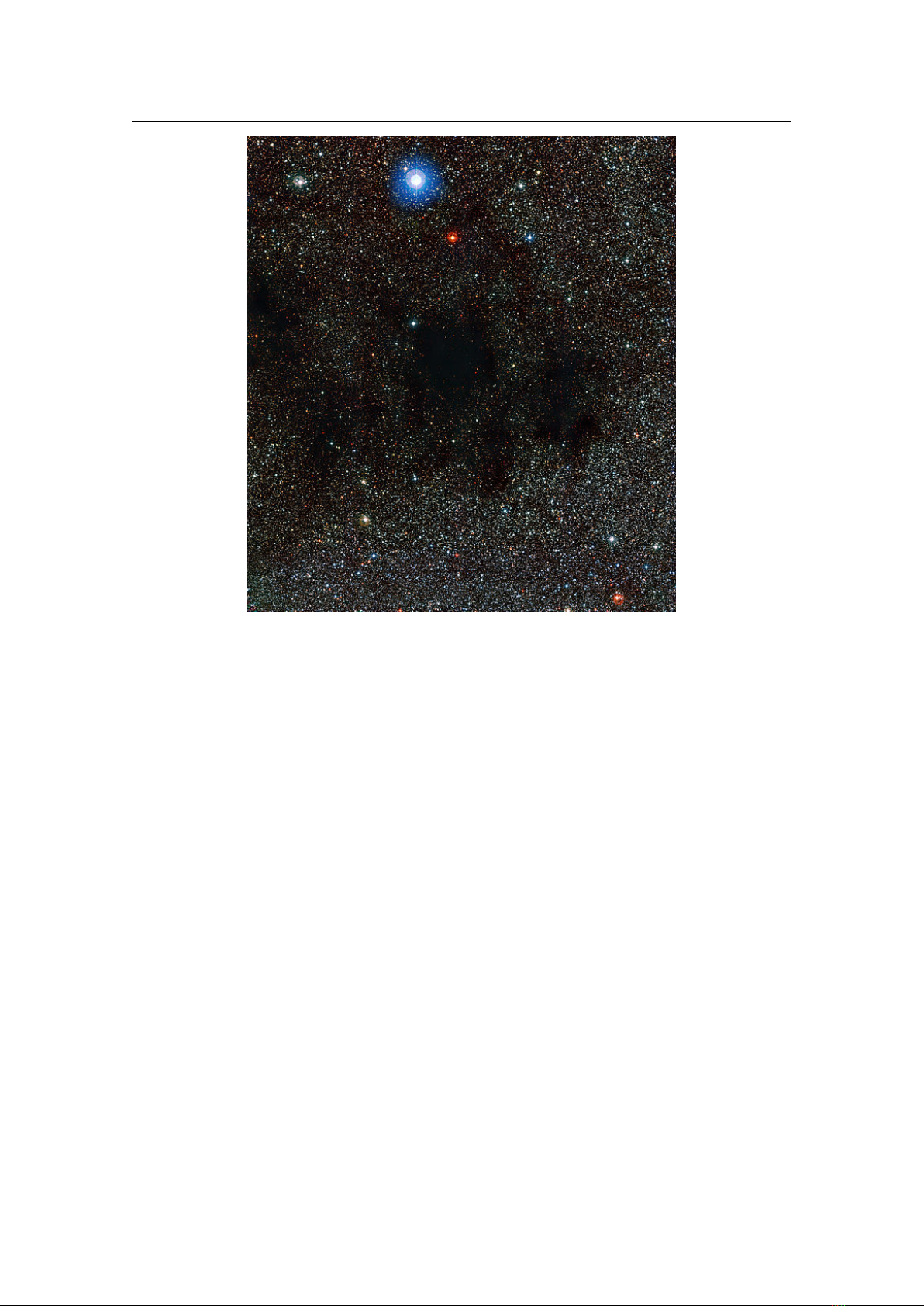
304 Chapter 20. A Little Sky Guide
Figure 20.3: The Coalsack Nebula taken by the Wide Field Imager on the MPG/ESO
2.2-metre telescope. Credit: ESO.
20.33 Mira, o Ceti, 68 Cet
Type: Variable Star
Magnitude: 2.0–10.1
Location Guide: It is located around 1/3 between δ and θ Ceti.
Mira (
o
Ceti) is a star estimated 200–400 light years away in the constellation Cetus. Mira is a
binary star system that consists of a red giant (Mira A) undergoing mass loss and a high temperature
white dwarf companion (Mira B) that is accreting mass from the primary. Such an arrangement of
stars is known as a symbiotic system, and this is the closest such symbiotic pair to the Sun. Mira is
the brightest periodic variable in the sky that is not visible to the naked eye for part of its cycle. Its
distance is uncertain. Mira A is a well-known example of a category of long-period variable stars
known as Mira variables, which are named after it.
20.34 α Persei Cluster, Cr 39, Mel 20
Type: Open Cluster
Magnitude: 1.2
Location Guide: Around the white-yellow supergiant Mirfak, also known as
α
Persei in direction
to δ Persei.
The Alpha Persei Cluster, also known as Melotte 20 or Collinder 39, is an open cluster in the
constellation of Perseus. To the naked eye, the cluster consists of several blue (spectral class B)
stars.

20.35 M7, The Ptolemy Cluster 305
20.35 M7, The Ptolemy Cluster
Type: Open Cluster
Magnitude: 3.3
Location Guide: The cluster is easily detectable with the naked eye, close to the “sting” of
Scorpius — near the center of the line between Shaula (λ Scorpii) and Kaus Media (δ Sagittarii).
M7 has been known since antiquity — it was first recorded by the 2nd-century Greek-Roman
astronomer Ptolemy, who described it as a nebula in 130 AD. Telescopic observations of the cluster
reveal about 80 stars within a field of view of 1.3
◦
across. At the cluster’s estimated distance of 980
light years this corresponds to an actual diameter of 25 light years.
20.36 M22, NGC 6656, The Great Sagittarius Cluster
Type: Globular Cluster
Magnitude: 5.1
Location Guide: Located just south of the Ecliptic, and northwest of
λ
Sagittarii (Kaus Borealis),
the northernmost star of the “Teapot” asterism.
M22 is an elliptical globular cluster of stars in the constellation Sagittarius, near the Galactic
bulge region. It is one of the brightest and nearest globular clusters that is visible in the night sky.
M22 is very unusual in that it is one of only four globulars that are known to contain a planetary
nebula. In 2012 two black holes of between 10 and 20 solar masses each have been discovered
in this globular cluster, initially with the Very Large Array radio telescope in New Mexico, and
corroborated by the Chandra X-ray telescope. The angular size of M22 is over 0.5
◦
.
20.37 M24, The Sagittarius Star Cloud
Type: Star Cloud
Magnitude: 4.6
Location Guide: In the Milky Way region near Polis (µ Sagittarii).
The Sagittarius Star Cloud is a star cloud in the constellation of Sagittarius, approximately 600
light years wide. The stars, clusters and other objects comprising M24 are part of the Sagittarius or
Sagittarius-Carina arms of the Milky Way galaxy. Messier described M24 as a “large nebulosity
containing many stars” and gave its dimensions as being some 1.5
◦
across.
20.38 IC 4665, The Summer Beehive Cluster
Type: Open Cluster
Magnitude: 4.2
Location Guide: Visible to the naked eye near Cebalrai (β Ophiuchi).
IC 4665 is an open cluster in the constellation Ophiuchus which is easily visible in the smallest
of telescopes and also with binoculars. From a sufficiently dark place it is also visible to the naked
eye.
20.39 The E Nebula, Barnard 142 and 143
Type: Dark Nebula
Location Guide: A well-defined dark area on a background of Milky Way near Tarazed (
γ
Aquilae).
The “E” or “Barnard’s E” Nebula (officially designated as B142 and B143) is a pair of dark
nebulae in the constellation Aquila. It is a well-defined dark area on a background of the Milky

306 Chapter 20. A Little Sky Guide
Way. The size of the nebula is roughly
0.5
◦
, and its distance from Earth is estimated at about 2000
light years.
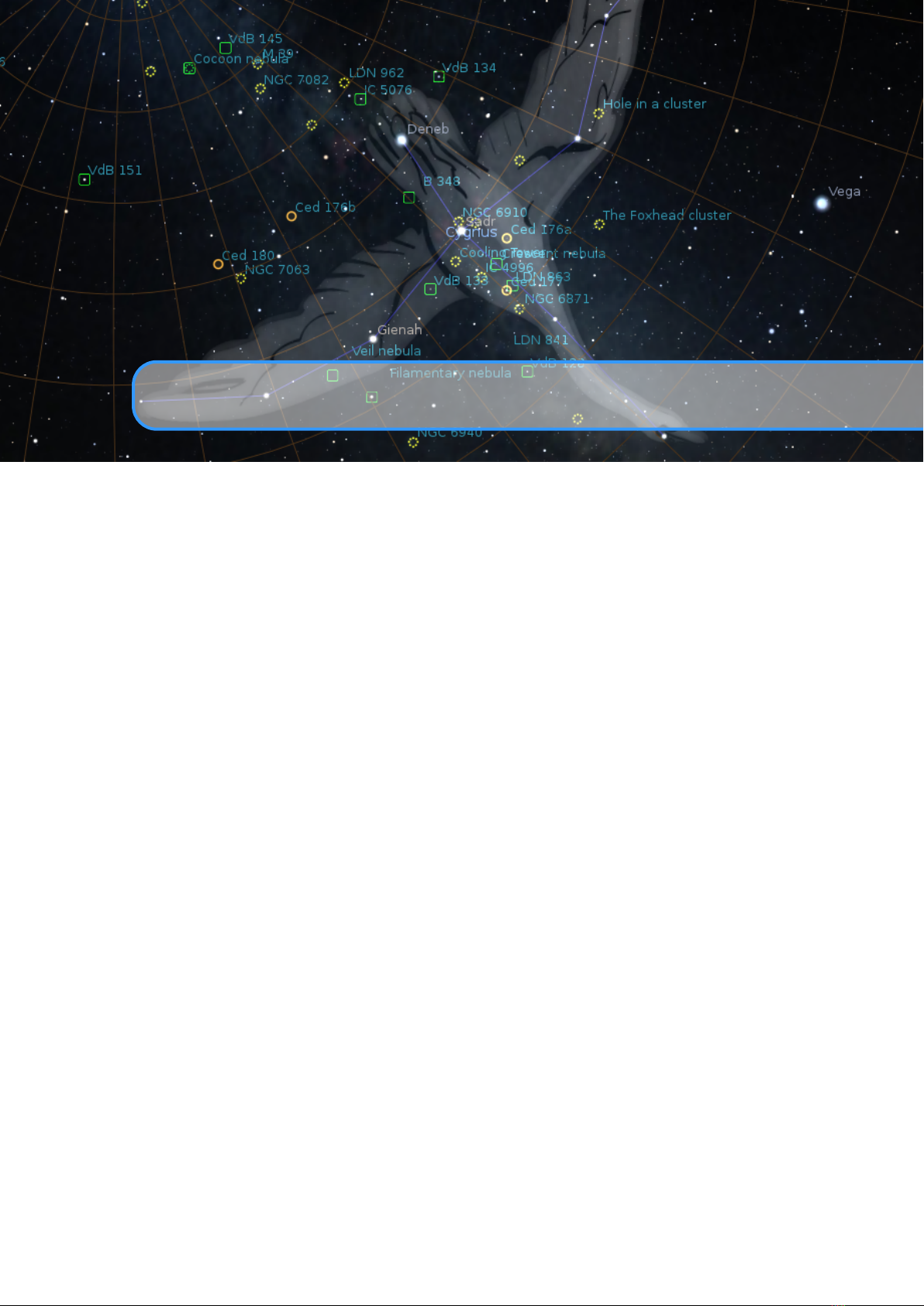
21. Exercises
PAUL ROBINSON, WITH ADDITIONS BY ALEXANDER WOLF
21.1 Find M31 in Binoculars
M31 – the Andromeda Galaxy – is the most distant object visible to the naked eye. Finding it in
binoculars is a rewarding experience for new-comers to observing.
21.1.1 Simulation
1.
Set the location to a mid-Northern latitude if necessary (M31 isn’t always visible for Southern
hemisphere observers). The UK is ideal.
2.
Find M31 and set the time so that the sky is dark enough to see it. The best time of year for
this at Northern latitudes is Autumn/Winter, although there should be a chance to see it at
some time of night throughout the year.
3.
Set the field of view to
6
◦
(or the field of view of your binoculars if they’re different.
6
◦
is
typical for 7x50 binoculars).
4.
Practice finding M31 from the bright stars in Cassiopeia and the constellation of Andromeda.
Learn the chain of stars that extends from Andromeda’s central star perpendicular to her
body.
21.1.2 For Real
This part is not going to be possible for many people. First, you need a good night and a dark sky.
In urban areas with a lot of light pollution it’s going to be very hard to see Andromeda.
21.2 Handy Angles
As described in section 18.5.2, your hand at arm’s length provides a few useful estimates for
angular size. It’s useful to know whether your handy angles are typical, and if not, what they are.

308 Chapter 21. Exercises
The method here below is just one way to do it – feel free to use another method of your own
construction!
Hold your hand at arm’s length with your hand open – the tips of your thumb and little finger
as far apart as you can comfortably hold them. Get a friend to measure the distance between your
thumb and your eye, we’ll call this
D
. There is a tendency to over-stretch the arm when someone
is measuring it – try to keep the thumb-eye distance as it would be if you were looking at some
distant object.
Without changing the shape of your hand, measure the distance between the tips of your thumb
and little finger. It’s probably easiest to mark their positions on a piece of paper and measure the
distance between the marks, we’ll call this
d
. Using some simple trigonometry, we can estimate the
angular distance θ using equation (18.5).
Repeat the process for the distance across a closed fist, three fingers and the tip of the little
finger.
For example, for one author D = 72cm, d = 21cm, so:
θ = 2 · arctan
21
144
≈ 16
1
2
◦
(21.1)
Remember that handy angles are not very precise – depending on your posture at a given time
the values may vary by a fair bit.
21.3 Find a Lunar Eclipse
Stellarium comes with two scripts for finding lunar eclipses, but can you find one on a different
date?
21.4 Find a Solar Eclipse
Find a Solar Eclipse using Stellarium and take a screenshot of it. Use the location panel and see
how the eclipse look on different locations at the same time. Don’t forget to have “Topocentric
coordinates” enabled in the settings (see section 18.9.1).
21.5 Find a retrograde motion of Mars
Find Mars using Stellarium and take a series of screenshots of its position at different times. Use
the date and time panel and see how the motion of Mars changes over the time. Find periods of
direct and retrograde motion of Mars (see also section 17.6).
21.6 Analemma
Set a time around noon and set time rate to pause, turn on the azimuthal grid. Find the Sun and
check its horizontal coordinates. Use the date and time panel and see how the horizontal coordinates
of the Sun change over time (please use one time step for simulation — look at the position of the
Sun every 7 days for example). Use the location panel and see how the positions of the Sun look
from different location at the same times. Check the change of positions of the Sun on Mars at the
same times.

21.7 Transit of Venus 309
21.7 Transit of Venus
Set date to
6
th
of June, 2012, find Venus near the Sun and change scale of the view (zoom in). Find
time of all four contacts and maximum of transit for your location. Because the Sun appears to
rotate as it crosses the sky, Venus will appear to move on some curve — for example it will be an
inverted “U” shape for eastern states of Australia. Check difference of path shape of Venus for
equatorial and azimuthal mounts. Find a few dates and times for transit of Venus in past and in
future. Notice how they usually come in pairs 8 years apart, with gaps of over 100 years between
pairs.
21.8 Transit of Mercury
Set date to
9
th
of May, 2016, find Mercury near the Sun and change scale of the view (zoom in).
Find time of all four contacts and maximum of transit for your location. Because the Sun appears
to rotate as it crosses the sky, Mercury will appear to move on some curve — for example it will be
an inverted “U” shape for observers from Europe. Check difference of path shape of Mercury for
equatorial and azimuthal mounts. Find few dates and times for transit of Mercury in past and in
future.
21.9 Triple shadows on Jupiter
Set date to
24
th
of January, 2015, find Jupiter and change scale of the view (zoom in). Find the
time when three shadows will be visible on the disk of Jupiter. Which moons cast those shadows?
Check which moons cause triple shadows on Jupiter at 3 June 2014. Details for this phenomenon
you can find in the book Mathematical astronomy morsels (Meeus, 1997).
21.10 Jupiter without satellites
Set date to
9
th
November, 2019, find Jupiter and change scale of the view (zoom in). Find time
limits for the disappearance of the moons. Which moons are on the back of the planet, and which
— in front of it? Please give answer on the same questions for 3 September 2009. Details for this
phenomenon you can find in the book Mathematical astronomy morsels (Meeus, 1997)
21.11 Mutual occultations of planets
Set date to
13
th
October, 1590, find Venus and change scale of the view (zoom in). Find time of
minimal separation of Venus and Mars on this date. Set typical scale of view for visual observation
and check Venus and Mars again. What would the typical observer of that time had said? Find the
minimal separation between Venus and Saturn near end of August 1771. What would the typical
observer on Earth had said? Find the minimal separation between Mars and Mercury in first half of
August 2079.
Find mutual occultation of Earth and Mercury as seen from Mars near the end of November
2022. Find mutual occultation of Saturn and Mercury as seen from Venus near the middle of May
1967.
Details for this phenomenon you can find in the books More mathematical astronomy morsels
(Meeus, 2002) and Mathematical astronomy morsels III (Meeus, 2004)

310 Chapter 21. Exercises
21.12 The proper motion of stars
Turn off ground and atmosphere, set time rate on pause, find the star HIP 87937 and change the
scale of the view to better see Barnard’s Star. Use the date and time panel and see how the location
of the star is changing in time (please try use one time step for simulation — look at the position of
the star every year for example). When will Barnard’s star cross the border of constellation? When
has Barnard’s star crossed the border of constellation in the past?
Please check the proper motions of Sirius (HIP 32349), Procyon (HIP 37279), 61 Cyg (HIP
104214) and
τ
Cet (HIP 8102). Which star has the fastest proper motion? Which star has the
slowest rate of proper motion?
When will observers see Arcturus and HIP 68706 as close optical binary? Find the minimal
angular separation between θ and ε Ind in the past.
How will the appearance of following constellations change over a wide range of time
(−100000..100000 years for example): Ursa Major, Orion, Bootes?
A note of caution, however: the proper motions are only modelled by extrapolating their current
shift rates in right ascension and declination, but don’t take radial velocity into account. The results
in very far times should be seen only as approximations.

V
A Default Hotkeys . . . . . . . . . . . . . . . . . . . . . . . . . . 313
B The Bortle Scale of Light Pollution . . . . . . . 321
C Star Catalogues . . . . . . . . . . . . . . . . . . . . . . . . . . 325
D Configuration Files . . . . . . . . . . . . . . . . . . . . . . . 359
E Planetary nomenclature . . . . . . . . . . . . . . . . 395
F Accuracy . . . . . . . . . . . . . . . . . . . . . . . . . . . . . . . . . 407
G GNU Free Documentation License . . . . . 417
H Acknowledgements . . . . . . . . . . . . . . . . . . . . . 425
Bibliography . . . . . . . . . . . . . . . . . . . . . . . . . . . . . . 437
Index . . . . . . . . . . . . . . . . . . . . . . . . . . . . . . . . . . . . . . 449
Appendices

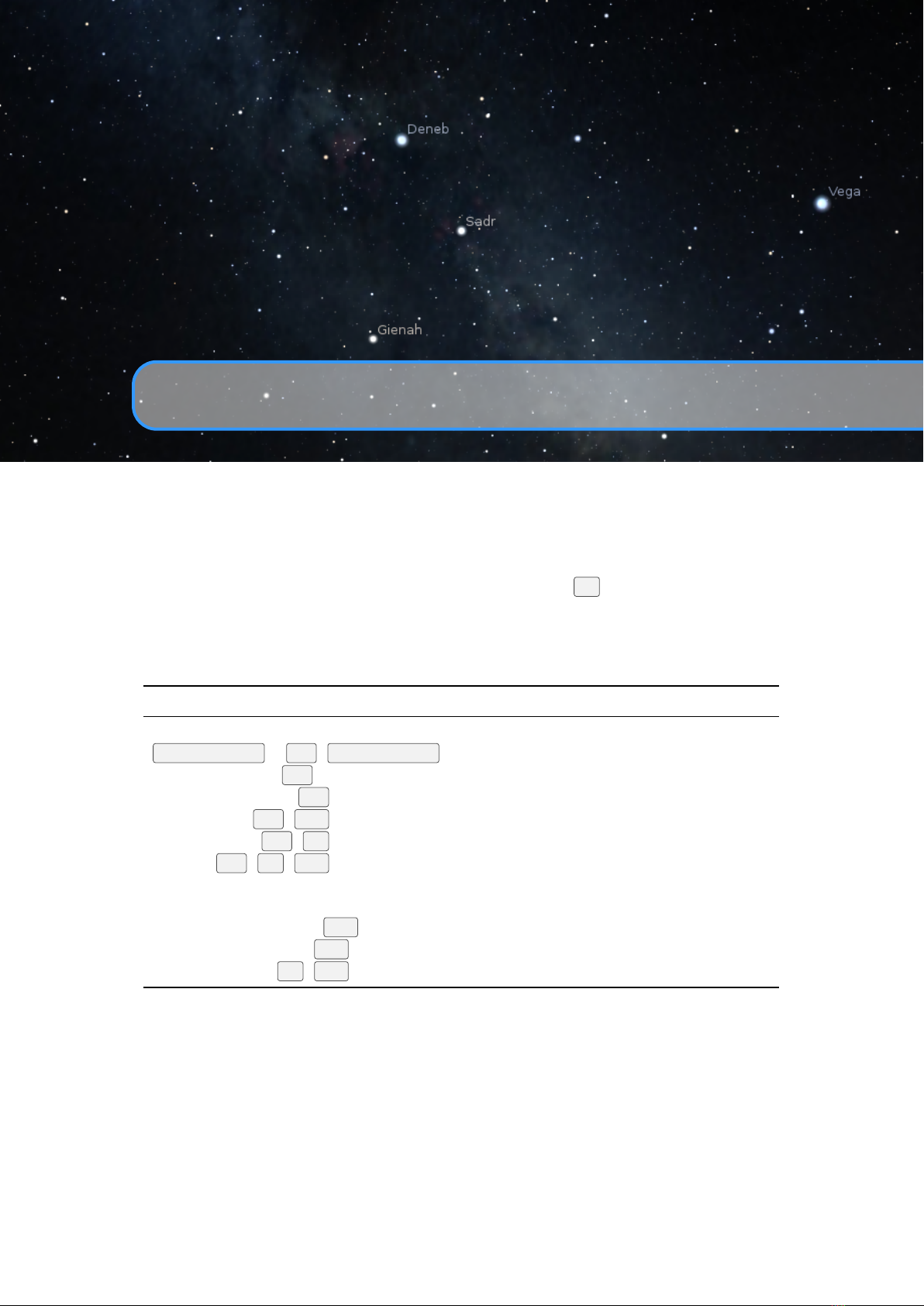
A. Default Hotkeys
The currently configured hotkeys are visible in the Help dialog (
F1
). Here is the default list for
reference.
A.1 Mouse actions with combination of the keyboard keys
Actions Description
Arrow keys & left mouse drag Pan view around the sky
Page Up/Down
&
Ctrl
+
Page Up/Down
Zoom in/out
Ctrl
& left mouse drag Time dragging
Ctrl
& mouse wheel Time scrolling: minutes
Ctrl
+
Shift
& mouse wheel Time scrolling: hours
Ctrl
+
Alt
& mouse wheel Time scrolling: days
Ctrl
+
Alt
+
Shift
& mouse wheel Time scrolling: years
Left click Select object
Right click Clear selection
Shift
& left click Add custom marker
Shift
& right click Delete the one closest marker to mouse cursor
Alt
+
Shift
& right click Delete all custom markers

314 Appendix A. Default Hotkeys
A.2 Display Options
Shortcut key Description
P
Planets
Alt
+
P
Planet labels
Ctrl
+
P
Planet markers
O
Planet orbits
Shift
+
T
Planet trails
Ctrl
+
Shift
+
P
Planet selection marker
Alt
+
N
Nomenclature labels
S
Stars
Alt
+
S
Star labels
D
Deep-sky objects (symbols)
I
Deep-sky objects background images
Ctrl
+
I
Reload the deep-sky objects background images
Ctrl
+
Alt
+
D
Toggle Hierarchical Progressive Surveys (experimental)
M
Milky Way
Ctrl
+
Shift
+
Z
Zodiacal Light
G
Ground
F
Fog
Shift
+
G
Landscape Illumination
Ctrl
+
Shift
+
G
Landscape Labels
A
Atmosphere
Q
Cardinal points
,
Ecliptic line
.
Equator line
E
Equatorial grid
Z
Azimuthal grid
H
Horizon line
;
Meridian line
C
Constellation lines
V
Constellation labels
R
Constellation art
B
Constellation boundaries
Ctrl
+
Alt
+
Shift
+
V
Select single constellation
Tab
Remove selection of constellations
Ctrl
+
Shift
+
N
Native planet names (from starlore)
Alt
+
V
Asterism labels
Alt
+
A
Asterism lines
Alt
+
R
Ray helpers
Ctrl
+
Alt
+
I
Reload the sky culture
W
Remove selection of constellations
Alt
+
W
Select all constellations
F11
Full-screen mode
Ctrl
+
N
Night mode
Ctrl
+
Shift
+
H
Flip scene horizontally

A.3 Miscellaneous 315
Ctrl
+
Shift
+
V
Flip scene vertically
A.3 Miscellaneous
Shortcut key Description
Ctrl
+
C
Copy selected object information to clipboard
Ctrl
+
Q
Quit
Ctrl
+
S
Save screenshot
Ctrl
+
M
Switch between equatorial and azimuthal mount
Ctrl
+
T
Toggle visibility of GUI
Ctrl
+
R
,
P
Reload shaders (for development)
A.4 Movement and Selection
Shortcut key Description
Center on selected object
Ctrl
+
H
Go to home
Ctrl
+
G
Set home planet to selected planet (“go there”)
Shift
+
E
Look towards East
Shift
+
N
Look towards North
Shift
+
S
Look towards South
Shift
+
W
Look towards West
Shift
+
Z
Look towards Zenith
Alt
+
Shift
+
N
Look towards North Celestial pole
Alt
+
Shift
+
S
Look towards South Celestial pole
T
Track object
/
Zoom in on selected object
\
Zoom out
Ctrl
+
Alt
+
1
Set FOV to 180
◦
Ctrl
+
Alt
+
2
Set FOV to 90
◦
Ctrl
+
Alt
+
3
Set FOV to 60
◦
Ctrl
+
Alt
+
4
Set FOV to 45
◦
Ctrl
+
Alt
+
5
Set FOV to 20
◦
Ctrl
+
Alt
+
6
Set FOV to 10
◦
Ctrl
+
Alt
+
7
Set FOV to 5
◦
Ctrl
+
Alt
+
8
Set FOV to 2
◦
Ctrl
+
Alt
+
9
Set FOV to 1
◦
Ctrl
+
Alt
+
0
Set FOV to 0.5
◦

316 Appendix A. Default Hotkeys
A.5 Date and Time
Shortcut key Description
=
Add 1 solar day
-
Subtract 1 solar day
Ctrl
+
=
Add 1 solar hour
Ctrl
+
-
Subtract 1 solar hour
Alt
+
=
Add 1 sidereal day
Alt
+
-
Subtract 1 sidereal day
]
Add 7 solar days
[
Subtract 7 solar days
Ctrl
+
Alt
+
Shift
+
]
Add 1 sidereal year
Ctrl
+
Alt
+
Shift
+
[
Subtract 1 sidereal year
J
Decrease time speed
Shift
+
J
Decrease time speed (a little)
K
Set normal time rate
L
Increase time speed
Shift
+
L
Increase time speed (a little)
7
Set time rate to zero
8
Set time to now
0
Set reverse time direction
Ctrl
+
D
,
P
Pause script execution
Ctrl
+
D
,
R
Resume script execution
Ctrl
+
D
,
S
Stop script execution
A.6 Scripts
Shortcut key Description
Ctrl
+
D
,
0
Run script “Solar System Screensaver”
Ctrl
+
D
,
1
Run script “Western Constellations Tour”
Ctrl
+
D
,
2
Run script “Sky Culture Tour”
Ctrl
+
D
,
3
Run script “Screensaver”
Ctrl
+
D
,
B
Run script “Skybox Tiles”
Ctrl
+
D
,
M
,
1
Run script “Jupiter and triple shadow phenomena”
Ctrl
+
D
,
M
,
2
Run script “Jupiter without Galilean satellites”
Ctrl
+
D
,
M
,
3
Run script “Occultations of bright stars by planets”
Ctrl
+
D
,
M
,
4
Run script “Mutual occultations of planets”

A.7 Windows 317
A.7 Windows
Shortcut key Description
F1
Toggle Help window
F2
Toggle Configuration window
F3
Toggle Search window
F4
Toggle Sky and viewing options window
F5
Toggle Date/time window
F6
Toggle Location window
F7
Toggle Shortcuts window
F10
Toggle Astronomical calculations window
F12
Toggle Script Console window
Alt
+
B
Toggle Bookmarks window
A.8 Plugins
A.8.1 Angle Measure
Shortcut key Description
Ctrl
+
A
Toggle angle measurement
A.8.2 ArchaeoLines
Shortcut key Description
Ctrl
+
U
Toggle archaeolines
Ctrl
+
Shift
+
U
Toggle archaeolines dialog
A.8.3 Calendars
Shortcut key Description
Alt
+
K
Toggle Calendars display
Alt
+
Shift
+
K
Toggle Calendars dialog
A.8.4 Equation of Time
Shortcut key Description
Ctrl
+
Alt
+
T
Show solution for Equation of Time
A.8.5 Exoplanets
Shortcut key Description
Ctrl
+
Alt
+
E
Show exoplanets
Alt
+
E
Toggle Exoplanets configuration window

318 Appendix A. Default Hotkeys
A.8.6 Meteor Showers
Shortcut key Description
Ctrl
+
Shift
+
M
Toggle meteor showers
Shift
+
M
Toggle radiant labels
Ctrl
+
Alt
+
M
Show search dialog
Ctrl
+
Alt
+
Shift
+
M
Show settings dialog
A.8.7 Oculars
Shortcut key Description
Ctrl
+
O
Ocular view
Alt
+
O
Oculars popup menu
Alt
+
C
Show crosshairs
Ctrl
+
B
Telrad sight
A.8.8 Pulsars
Shortcut key Description
Ctrl
+
Alt
+
P
Show pulsars
A.8.9 Quasars
Shortcut key Description
Ctrl
+
Alt
+
Q
Show quasars
A.8.10 Satellites
Shortcut key Description
Ctrl
+
Z
Toggle satellite hints
Alt
+
Shift
+
Z
Toggle satellite labels
Alt
+
Z
Toggle Satellites configuration window
A.8.11 Scenery3d: 3D landscapes
Shortcut key Description
Ctrl
+
W
Toggle 3D landscape
Ctrl
+
Shift
+
W
Show settings dialog
Ctrl
+
Alt
+
W
Show viewpoint dialog
Ctrl
+
R
,
T
Toggle location text
Ctrl
+
R
,
S
Toggle shadows
Ctrl
+
R
,
L
Toggle torchlight
Ctrl
+
R
,
D
Toggle debug information
Ctrl
+
R
,
P
Reload shaders
A.8.12 Solar System Editor
Shortcut key Description
Ctrl
+
Alt
+
S
Import orbital elements in MPC format...

A.8 Plugins 319
A.8.13 Telescope Control
Shortcut key Description
Ctrl
+
0
Move a telescope to a given set of coordinates (shows dialog)
Ctrl
+
1
Move telescope #1 to selected object
Ctrl
+
2
Move telescope #2 to selected object
Ctrl
+
3
Move telescope #3 to selected object
Ctrl
+
4
Move telescope #4 to selected object
Ctrl
+
5
Move telescope #5 to selected object
Ctrl
+
6
Move telescope #6 to selected object
Ctrl
+
7
Move telescope #7 to selected object
Ctrl
+
8
Move telescope #8 to selected object
Ctrl
+
9
Move telescope #9 to selected object
Alt
+
1
Move telescope #1 to the point currently in the center of the screen
Alt
+
2
Move telescope #2 to the point currently in the center of the screen
Alt
+
3
Move telescope #3 to the point currently in the center of the screen
Alt
+
4
Move telescope #4 to the point currently in the center of the screen
Alt
+
5
Move telescope #5 to the point currently in the center of the screen
Alt
+
6
Move telescope #6 to the point currently in the center of the screen
Alt
+
7
Move telescope #7 to the point currently in the center of the screen
Alt
+
8
Move telescope #8 to the point currently in the center of the screen
Alt
+
9
Move telescope #9 to the point currently in the center of the screen
Ctrl
+
Shift
+
0
Move a telescope to a given set of coordinates (shows dialog)
Ctrl
+
Shift
+
1
Sync telescope #1 to selected object
Ctrl
+
Shift
+
2
Sync telescope #2 to selected object
Ctrl
+
Shift
+
3
Sync telescope #3 to selected object
Ctrl
+
Shift
+
4
Sync telescope #4 to selected object
Ctrl
+
Shift
+
5
Sync telescope #5 to selected object
Ctrl
+
Shift
+
6
Sync telescope #6 to selected object
Ctrl
+
Shift
+
7
Sync telescope #7 to selected object
Ctrl
+
Shift
+
8
Sync telescope #8 to selected object
Ctrl
+
Shift
+
9
Sync telescope #9 to selected object
Ctrl
+
Shift
+
Alt
+
1
Abort last slew command of telescope #1
Ctrl
+
Shift
+
Alt
+
2
Abort last slew command of telescope #2
Ctrl
+
Shift
+
Alt
+
3
Abort last slew command of telescope #3
Ctrl
+
Shift
+
Alt
+
4
Abort last slew command of telescope #4
Ctrl
+
Shift
+
Alt
+
5
Abort last slew command of telescope #5
Ctrl
+
Shift
+
Alt
+
6
Abort last slew command of telescope #6
Ctrl
+
Shift
+
Alt
+
7
Abort last slew command of telescope #7
Ctrl
+
Shift
+
Alt
+
8
Abort last slew command of telescope #8
Ctrl
+
Shift
+
Alt
+
9
Abort last slew command of telescope #9
A.8.14 Text User Interface (TUI)
Shortcut key Description
Alt
+
T
Activate TUI

320 Appendix A. Default Hotkeys
A.9 Special local keys
All these hotkeys are locally available to run when specific window or tab is opened.
Shortcut key Description
Script console
Ctrl
+
Shift
+
O
Load script from file
Ctrl
+
Shift
+
S
Save script to file
Ctrl
+
Return
Run script
Astronomical calculations
Shift
+
F10
Update positions
Shift
+
F10
Calculate ephemeris
Shift
+
F10
Calculate transits
Shift
+
F10
Calculate phenomena
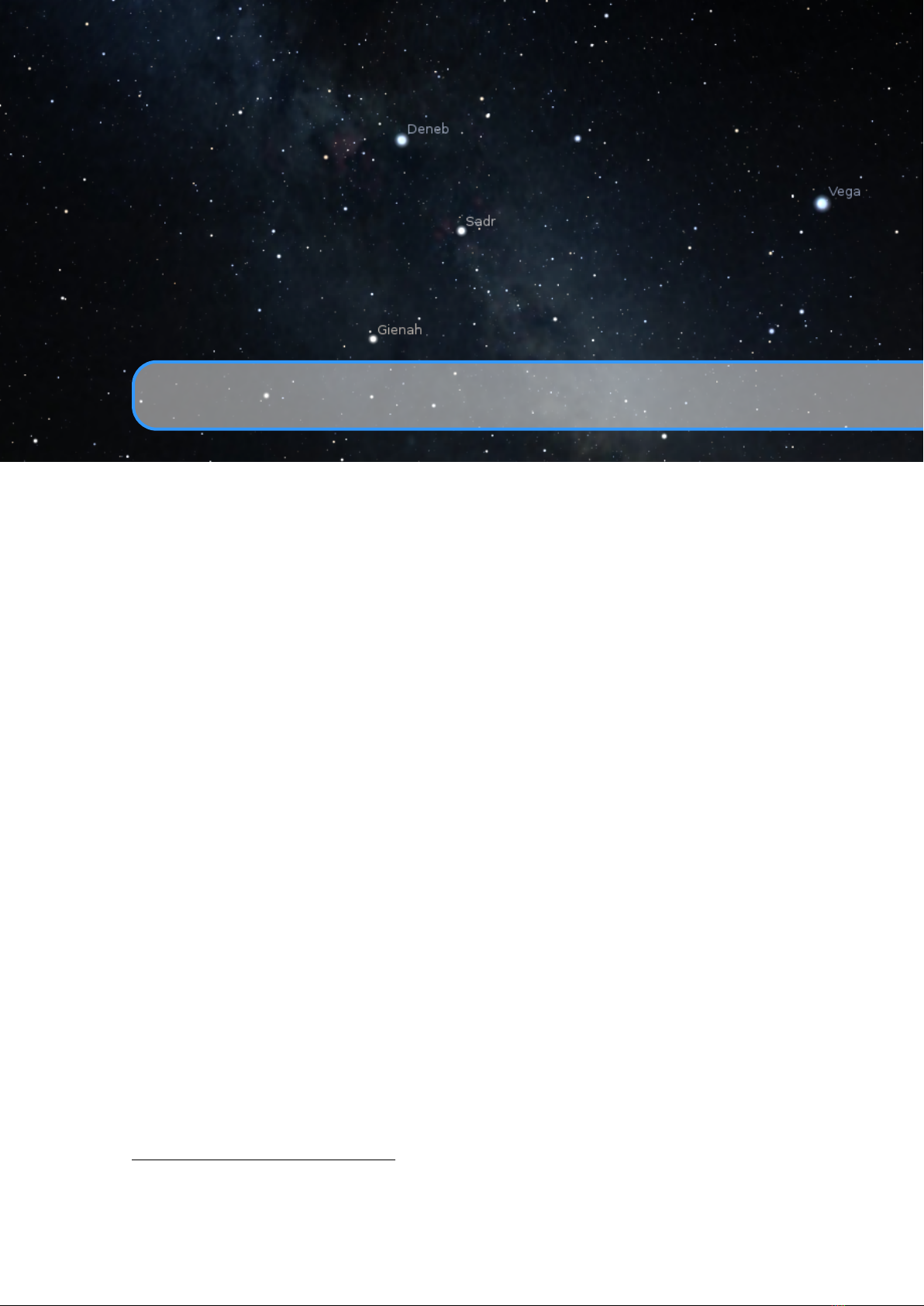
B. The Bortle Scale of Light Pollution
The Bortle scale is a nine-level numeric scale that measures the night sky’s brightness of a particular
location. It quantifies the astronomical observability of celestial objects and the interference
caused by light pollution. JOHN E. BORTLE created the scale and published it in Sky & Telescope
magazine (Bortle, 2001) to help amateur astronomers evaluate the darkness of an observing site,
and secondarily, to compare the darkness of observing sites. The scale ranges from Class 1, the
darkest skies available on Earth, through Class 9, inner-city skies. It gives several criteria for each
level beyond naked-eye limiting magnitude (NELM). The accuracy and utility of the scale have
been questioned in recent research (Crumey, 2014).
B.1 Excellent dark sky site
Level: 1
Naked-eye limiting magnitude: 7.6 – 8.0
Approx. SQM mag/arcsec
2
: 21.7 – 22.0
1
Zodiacal light, gegenschein, zodiacal band visible; M33 direct vision naked-eye object; Scorpius
and Sagittarius regions of the Milky Way cast obvious shadows on the ground; Airglow is readily
visible; Jupiter and Venus affect dark adaptation; surroundings basically invisible.
B.2 Typical truly dark site
Level: 2
Naked-eye limiting magnitude: 7.1 – 7.5
Approx. SQM mag/arcsec
2
: 21.5 – 21.7
Airglow weakly visible near horizon; M33 easily seen with naked eye; highly structured
Summer Milky Way; distinctly yellowish zodiacal light bright enough to cast shadows at dusk and
dawn; clouds only visible as dark holes; surroundings still only barely visible silhouetted against
the sky; many Messier globular clusters still distinct naked-eye objects.
1
Dark Skies Awareness – http://www.darkskiesawareness.org/nomogram.php
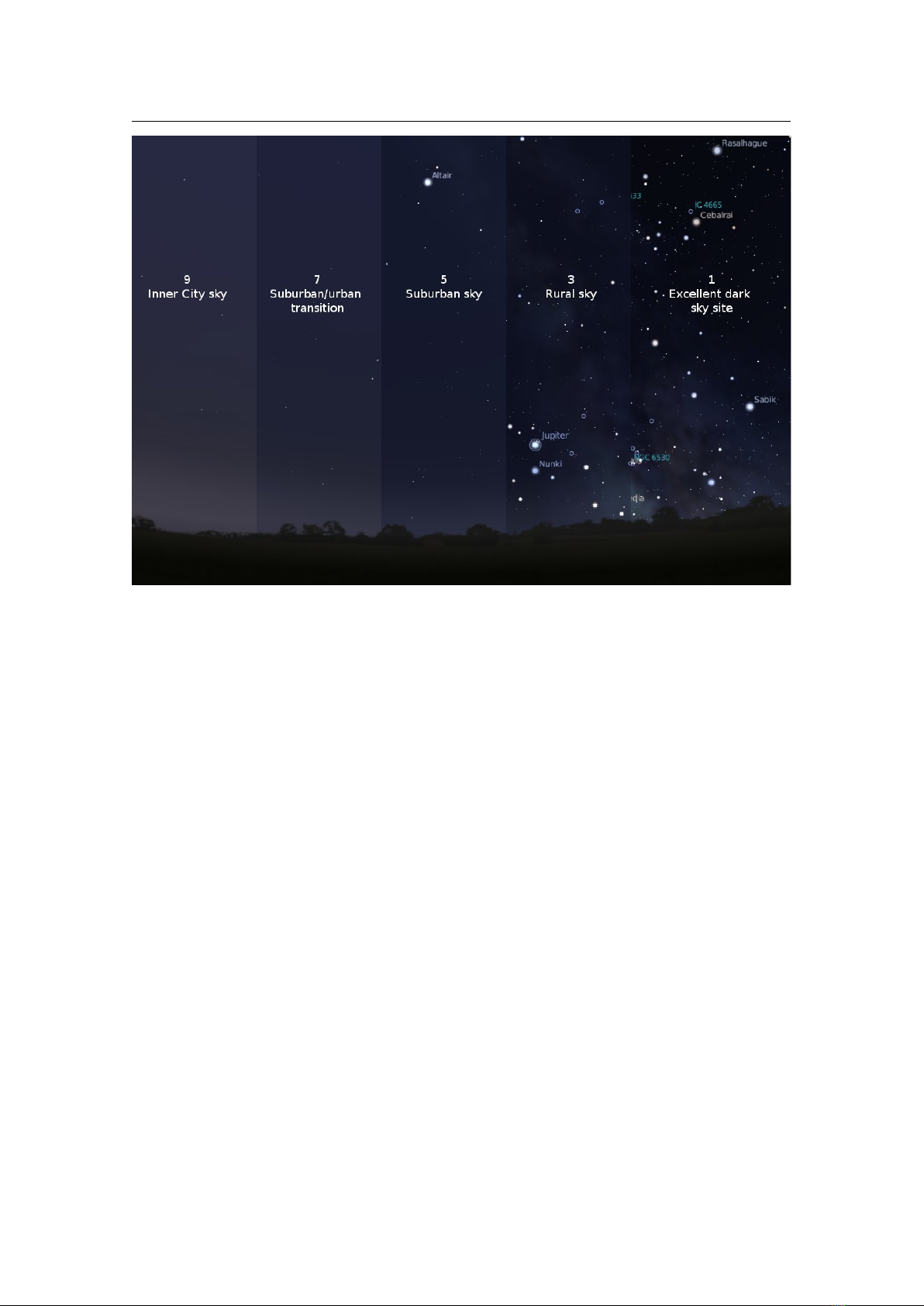
322 Appendix B. The Bortle Scale of Light Pollution
Figure B.1: Light Pollution Simulation / Bortle Scale
B.3 Rural sky
Level: 3
Naked-eye limiting magnitude: 6.6 – 7.0
Approx. SQM mag/arcsec
2
: 21.3 – 21.5
Some light pollution evident at the horizon; clouds illuminated near horizon, dark overhead;
Milky Way still appears complex; M15, M4, M5, M22 distinct naked-eye objects; M33 easily
visible with averted vision; zodiacal light striking in spring and autumn, color still visible; nearer
surroundings vaguely visible.
B.4 Rural/suburban transition
Level: 4
Naked-eye limiting magnitude: 6.1 – 6.5
Approx. SQM mag/arcsec
2
: 20.4 – 21.3
Light pollution domes visible in various directions over the horizon; zodiacal light is still
visible, but not even halfway extending to the zenith at dusk or dawn; Milky Way above the horizon
still impressive, but lacks most of the finer details; M33 a difficult averted vision object, only
visible when higher than 55
◦
; clouds illuminated in the directions of the light sources, but still dark
overhead; surroundings clearly visible, even at a distance.

B.5 Suburban sky 323
B.5 Suburban sky
Level: 5
Naked-eye limiting magnitude: 5.6 – 6.0
Approx. SQM mag/arcsec
2
: 19.1 – 20.4
Only hints of zodiacal light are seen on the best nights in autumn and spring; Milky Way is
very weak or invisible near the horizon and looks washed out overhead; light sources visible in
most, if not all, directions; clouds are noticeably brighter than the sky.
B.6 Bright suburban sky
Level: 6
Naked-eye limiting magnitude: 5.1 – 5.5
Approx. SQM mag/arcsec
2
: 18.0 – 19.1
Zodiacal light is invisible; Milky Way only visible near the zenith; sky within 35
◦
from the
horizon glows grayish white; clouds anywhere in the sky appear fairly bright; surroundings easily
visible; M33 is impossible to see without at least binoculars, M31 is modestly apparent to the
unaided eye.
B.7 Suburban/urban transition
Level: 7
Naked-eye limiting magnitude: 4.6 – 5.0
Approx. SQM mag/arcsec
2
: 18.0 – 19.1
Entire sky has a grayish-white hue; strong light sources evident in all directions; Milky Way
invisible; M31 and M44 may be glimpsed with the naked eye, but are very indistinct; clouds are
brightly lit; even in moderate-sized telescopes the brightest Messier objects are only ghosts of their
true selves.
B.8 City sky
Level: 8
Naked-eye limiting magnitude: 4.1 – 4.5
Approx. SQM mag/arcsec
2
: <18.0
Sky glows white or orange — you can easily read; M31 and M44 are barely glimpsed by an
experienced observer on good nights; even with telescope, only bright Messier objects can be
detected; stars forming familiar constellation patterns may be weak or completely invisible.
B.9 Inner-city sky
Level: 9
Naked-eye limiting magnitude: 4.0 at best
Approx. SQM mag/arcsec
2
: <18.0
Sky is brilliantly lit with many stars forming constellations invisible and many weaker constel-
lations invisible; aside from Pleiades, no Messier object is visible to the naked eye; only objects to
provide fairly pleasant views are the Moon, the Planets and a few of the brightest star clusters.

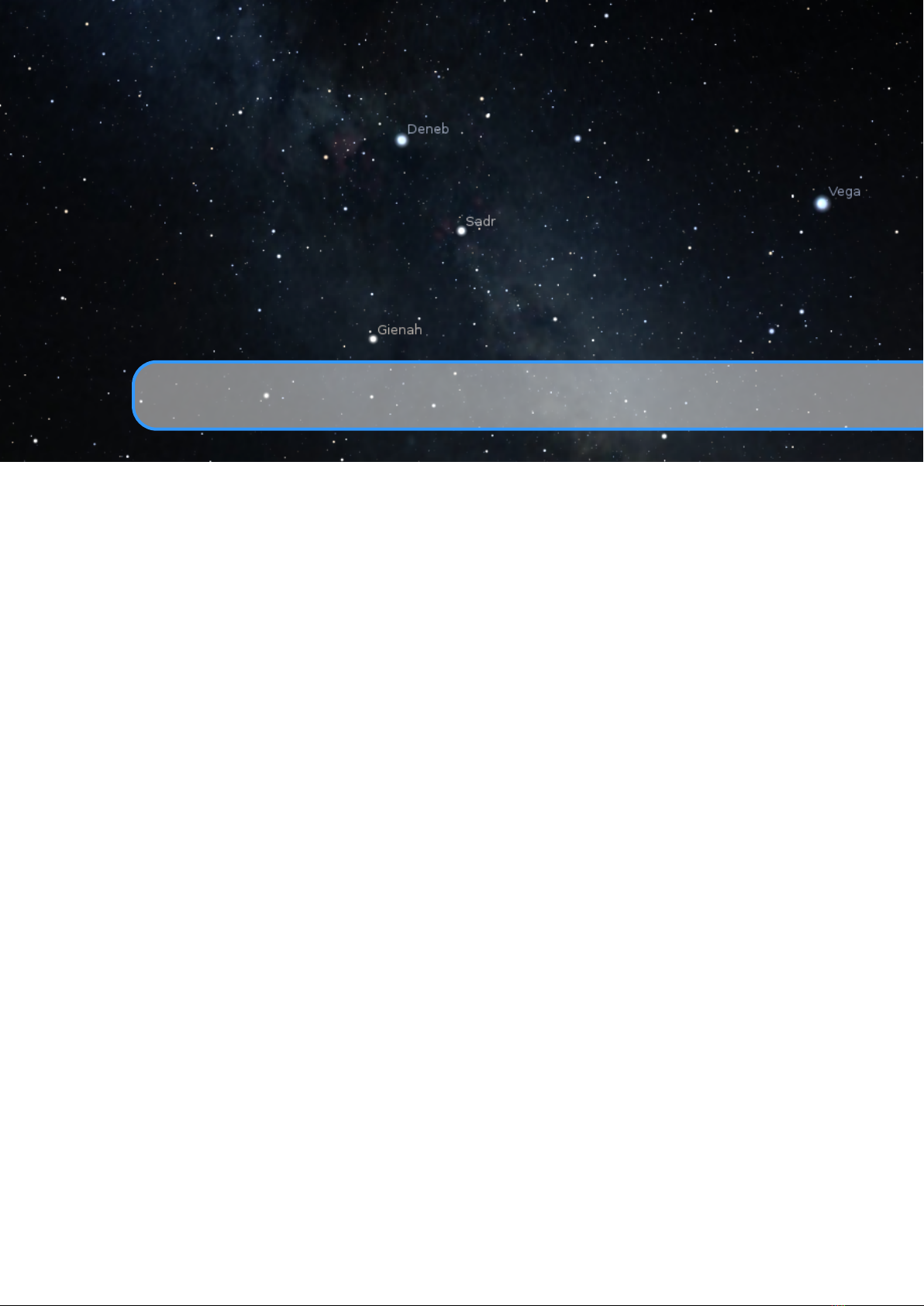
C. Star Catalogues
This chapter provides technical descriptions on how Stellarium records its star catalogues, and the
related file formats.
C.1 Stellarium’s Sky Model
C.1.1 Zones
The celestial sphere is split into zones, which correspond to the triangular faces of a geodesic sphere.
The number of zones (faces) depends on the level of sub-division of this sphere. The lowest level,
0, is an icosahedron (20 faces), subsequent levels L of sub-division give the number of zones n as:
n = 20 · 4
L
(C.1)
Stellarium uses levels 0 to 7 in the existing star catalogues. Star Data Records contain the
position of a star as an offset from the central position of the zone in which that star is located, thus
it is necessary to determine the vector from the observer to the centre of a zone, and add the star’s
offsets to find the absolute position of the star on the celestial sphere.
This position for a star is expressed as a 3-dimensional vector which points from the observer
(at the centre of the geodesic sphere) to the position of the star as observed on the celestial sphere.
C.2 Star Catalogue File Format
C.2.1 General Description
Stellarium’s star catalogue data is kept in the
stars/default
sub-directory of the Installation
Directory and/or User Directory (see section 5.1).
The main catalogue data is split into several files:
stars_0_0v0_8.cat
stars_1_0v0_8.cat

326 Appendix C. Star Catalogues
stars_2_0v0_8.cat
stars_3_1v0_4.cat
stars_4_1v0_2.cat
stars_5_2v0_1.cat
stars_6_2v0_1.cat
stars_7_2v0_1.cat
stars_8_2v0_1.cat
There also exist some control and reference files:
stars_hip_cids_0v0_0.cat
stars_hip_sp_0v0_3.cat
gcvs_hip_part.dat
wds_hip_part.dat
cross-id.dat
hip_plx_err.dat
stars.ini
name.fab
When Stellarium starts, it reads the
stars.ini
file, from which it determines the names of the
other files, which it then loads.
The files
stars_hip_cids_0v0_0.cat
and
stars_hip_sp_0v0_2.cat
contain reference
data for the main catalogue files. The file
gcvs_hip_part.dat
contains data about variables stars
(see section C.3) and file
wds_hip_part.dat
contains data about double stars (see section C.4)
which again contains references into the main catalogue files.
The file
cross-id.dat
(see section C.5) contains cross-identification data between HIP, SAO,
HD and HR designations.
The file hip_plx_err.dat contains parallax errors data for HIP stars.
A given catalogue file models stars for one and only one level (i.e. for a fixed number of zones),
which is recorded in the header of the file. Individual star records do not contain full positional
coordinates, instead they contain coordinates relative to the central position of the zone they occupy.
Thus, when parsing star catalogues, it is necessary to know about the zone model to be able to
extract positional data.
File Data Data Geodesic #Records Notes
Type Record Size Level
stars_0_0v0_8.cat 0 28 bytes 0 4,979 Hipparcos
stars_1_0v0_8.cat 0 28 bytes 1 21,806 Hipparcos
stars_2_0v0_8.cat 0 28 bytes 2 150,824 Hipparcos
stars_3_1v0_4.cat 1 10 bytes 3 425,807 Tycho 2
stars_4_1v0_2.cat 1 10 bytes 4 1,692,779 Tycho 2
stars_5_2v0_1.cat 2 8 bytes 5 7,083,058 NOMAD
stars_6_2v0_1.cat 2 8 bytes 6 24,670,782 NOMAD
stars_7_2v0_1.cat 2 8 bytes 7 50,733,321 NOMAD
stars_8_2v0_1.cat 2 8 bytes 7 92,304,337 NOMAD
For a given catalogue file, there may be one of three formats for the actual star data. The
variation comes from the source of the data – the larger catalogues of fainter stars providing less
data per star than the brighter star catalogues. See tables Stellarium’s star catalogue and for details.
Stellarium’s star catalogues are based on Hipparcos (Anderson and Francis, 2012; ESA, 1997),
Tycho 2 (Høg et al., 2000) and NOMAD (Zacharias et al., 2004) catalogues.

C.2 Star Catalogue File Format 327
C.2.2 File Sections
The catalogue files are split into three main sections as described in table C.1.
Section Offset Description
File Header Record 0
Contains magic number, geodesic subdivision level, and
magnitude range
Zone Records 32
A list of how many records there are for each zone. The
length of the zones section depends on the level value
from the header
Star Data Records 32+4n
This section of the file contains fixed-size star records,
as described below. Records do not contain zone infor-
mation, which must be inferred by counting how many
records have been read so far and switching zones when
enough have been read to fill the number of stars for the
zone, as specified in the zones section above. The value
of
n
used in the offset description is the number of zones,
as described above.
Table C.1: File sections
C.2.3 Record Types
File Header Record
The File Header Record describes file-wide settings. It also contains a magic number which servers
as a file type identifier. See table C.2.
Zone Records
The Zone Records section of the file lists the number of star records there are per zone. The number
of zones is determined from the level value in the File Header Record, as described in section C.1.1.
The Zones section is simply a list of integer values which describe the number of stars for each
zone. The total length of the Zones section depends on the number of zones. See table C.3.
Star Data Records
After the Zones section, the actual star data starts. The star data records themselves do not contain
the zone in which the star belongs. Instead, the zone is inferred from the position of the record
in the file. For example, if the Zone Records section of the file says that the first 100 records are
for zone 0, the next 80 for zone 1 and so on, it is possible to infer the zone for a given record by
counting how many records have been read so far.
The actual record structure depends on the value of the Data Type, as found in the File Header
Record. See tables C.4, C.5 and C.6 for record structure details.
It should be noted that although the positional data loses accuracy as one progresses though the
Star Record Types, this is compensated for by the face that the number of zones is much higher for
the files where the smaller precision position fields are used, so the actual resolution on the sky
isn’t significantly worse for the type 1 and 2 records in practice.

328 Appendix C. Star Catalogues
Name Offset Type Size Description
Magic 0 int 4
magic number which identifies the file as
a star catalogue. 0xde0955a3
Data Type 4 int 4
type of the file, which defines the size
and structure of the Star Data record for
the file.
Major Version 8 int 4 file format major version number
Minor Version 12 int 4 file format minor version number
Level 16 int 4
sets the level of sub-division of the
geodesic sphere used to create the zones.
0 means an icosahedron (20 triangular
faces), subsequent levels of sub-division
lead to numbers of zones as described in
section C.2.3
Magnitude Minimum 20 int 4
low bound of the magnitude scale for val-
ues in this file. Note that this is still an
integer in Stellarium’s own internal rep-
resentation
Magnitude Range 24 int 4
range of magnitudes expressed in this file
Magnitude Steps 28 int 4
number of steps used to describes values
in the range
Table C.2: Header Record
Name Offset Type Size Description
num stars in zone 0 0 int 4
number of records in this file which are in
zone 0
num stars in zone 1 4 int 4
number of records is this file which are in
zone 1
. . .
num stars in zone n 4n int 4
number of records is this file which are in
zone n
Table C.3: Zones section

C.2 Star Catalogue File Format 329
Name Offset Type Size Description
hip 0 int 3 Hipparcos catalogue number
component_ids 3 unsigned char 1
index to an array of cat-
alogue number suffixes.
The list is read from the
stars_hip_component_ids.cat
file. The value of this field turns
out to be the line number in the
file - 1
x0 4 int 4
position of the star relative to the
central point in the star’s zone, in
axis 1
x1 8 int 4
position of the star relative to the
central point in the star’s zone, in
axis 2
b_v 9 unsigned char 1
magnitude level in B-V colour.
This value refers to one of 256
discrete steps in the magnitude
range for the file
mag 10 unsigned char 1
magnitude level in the V-I colour.
This value refers to one of 256
discrete steps in the magnitude
range for the file
sp_int 11 unsigned short int 2
index into an array of
spectral type descriptions
which is taken from the file
stars_hip_sp.cat
, the index
corresponds to the line number
in the file - 1
dx0 13 int 4
proper motion of the star in axis
1
dx1 17 int 4
proper motion of the star in axis
2
plx 21 int 4
parallax of the star. To get the
actual value, divide by 10000.
Table C.4: Star Data Record Type 0

330 Appendix C. Star Catalogues
Name Offset Type Size Description
x0 0 int 20 bits
position of the star relative to the central point
in the star’s zone, in axis 1
x1 20 bits int 20 bits
position of the star relative to the central point
in the star’s zone, in axis 2
dx0 40 bits int 14 bits proper motion of the star in axis 1
dx1 54 bits int 14 bits proper motion of the star in axis 2
b_v 68 bits unsigned int 7 bits
magnitude level in B-V colour. This value
refers to one of 128 discrete steps in the mag-
nitude range for the file
mag 75 bits unsigned int 5 bits
magnitude level in the V-I colour. This value
refers to one of 32 discrete steps in the mag-
nitude range for the file
Table C.5: Star Data Record Type 1
Name Offset Type Size Description
x0 0 int 18 bits
position of the star relative to the central point
in the star’s zone, in axis 1
x1 18 bits int 18 bits
position of the star relative to the central point
in the star’s zone, in axis 2
b_v 36 bits unsigned int 7 bits
magnitude level in B-V colour. This value
refers to one of 128 discrete steps in the mag-
nitude range for the file
mag 43 bits unsigned int 5 bits
magnitude level in the V-I colour. This value
refers to one of 32 discrete steps in the mag-
nitude range for the file
Table C.6: Star Data Record Type 2

C.3 Variable Stars 331
Name Type Description
HIP int
This is the HIP identificator for the star. Used for reference to the
main star catalogue.
GCVS string This is the GCVS designation for the variable star.
Type string Type of variability.
Max float Magnitude at maximum brightness.
MFlag int
Magnitude flag code (0=No flag; 1="(" if max. magnitude is an
amplitude; 2="<" if max. magnitude is a bright limit; 3=">" is max.
magnitude is a faint limit).
Min I float First minimum magnitude or amplitude.
Min II float Second minimum magnitude.
V char The photometric system for magnitudes.
Epoch float Epoch for maximum or minimum light (in Julian days).
Period float Period for the variable star (in days).
M-m float Rising time or duration of the eclipse (in percent).
Spectrum string Spectral class of the variable star.
Table C.7: Variable Star Catalog File Format
C.3 Variable Stars
Since version 0.12.2 Stellarium supports the subset of variable stars from GCVS
1
which have HIP
identificators (i.e., stars from the Hipparcos catalog). Stellarium’s Catalog of Variable Stars is based
on the “General catalogue of variable stars: Version GCVS 5.1” (Samus’ et al., 2017).
C.3.1 Variable Star Catalog File Format
General Description
Stellarium’s Variable Stars catalog data is kept in the
stars/default
sub-directory of the Installa-
tion Directory and/or User Directory (see section 5.1).
File Format
The
gcvs_hip_part.dat
file contains data about 6862 Variable Stars (see section 19.2.5) which
have HIP identificators and are stored in a plain text format with tab delimiter (Table C.7).
C.3.2 GCVS Variability Types
An improved system of variability classification is used in the fourth edition of the GCVS, based
on recent developments in classification principles and taking into account the suggestions of a
number of specialists. Variability types are grouped according to the major astrophysical reasons
for variability.
All of these classes include objects of a dissimilar nature that belong to different types of light
variability. On the other hand, an object may be variable because of almost all of the possible
reasons or because of any combination of them. If a variable belongs to several types of variability,
the types are joined in the data field by a “+” sign, e.g., E+UG, UV+BY.
Despite considerable success in understanding stellar variability processes, the classification
adopted in the Catalogue is far from perfect. This is especially the case for explosive, symbiotic
and novalike variables; X-ray sources; and peculiar objects.
1
http://www.sai.msu.su/gcvs/gcvs/

332 Appendix C. Star Catalogues
The new variability types (ZZO, AM, R, BE, BLBOO, EP, SRS, LPB) have been added in the
Name-Lists 67-77 and in the GCVS vol.V.
You can read about latest different types of variability at SAI GCVS page
2
.
Eruptive Variable Stars
Eruptive variables are stars varying in brightness because of violent processes and flares occurring
in their chromospheres and coronae. The light changes are usually accompanied by shell events
or mass outflow in the form of stellar winds of variable intensity and/or by interaction with the
surrounding interstellar medium. This class includes the following types:
BE
It becomes more and more clear that, although the majority of Be stars are photometrically
variable, not all of them could be properly called GCAS variables. Quite a number of
them show small-scale variations not necessarily related to shell events; in some cases the
variations are quasi-periodic. By now we are not able to present an elaborated system of
classification for Be variables, but we adopt a decision that in the cases when a Be variable
cannot be readily described as a GCAS star we give simply BE for the type of variability.
FU
Orion variables of the FU Orionis type. Characterized by gradual increases in brightness by
about 6 mag in several months, followed by either almost complete constancy at maximum
that is sustained for long periods of time or slow decline by 1-2 mag. Spectral types at
maximum are in the range Ae(alpha) - Gpe(alpha). After an outburst, a gradual development
of an emission spectrum is observed and the spectral type becomes later. These variables
probably mark one of the evolutionary stages of T Tauri-type Orion variables (INT), as
evidenced by an outburst of one member, V1057 Cyg, but its decline (2.5 mag in 11 years)
commenced immediately after maximum brightness was attained. All presently known FU
Ori variables are coupled with reflecting cometary nebulae.
GCAS
Eruptive irregular variables of the Gamma Cas type. These are rapidly rotating B III-IVe
stars with mass outflow from their equatorial zones. The formation of equatorial rings or
disks is often accompanied by temporary fading. Light amplitudes may reach 1.5 mag in V.
I
Poorly studied irregular variables with unknown features of light variations and spectral types.
This is a very inhomogeneous group of objects.
IA Poorly studied irregular variables of early (O-A) spectral type.
IB Poorly studied irregular variables of intermediate (F-G) to late (K-M) spectral type.
IN
Orion variables. Irregular, eruptive variables connected with bright or dark diffuse
nebulae or observed in the regions of these nebulae. Some of them may show cyclic
light variations caused by axial rotation. In the Spectrum-Luminosity diagram, they
are found in the area of the main sequence and subgiants. They are probably young
objects that, during the course of further evolution, will become light-constant stars on
the zero-age main sequence (ZAMS). The range of brightness variations may reach
several magnitudes. In the case of rapid light variations having been observed (up to 1
mag in 1-10 days), the letter “S” is added to the symbol for the type (INS). This type
may be divided into the following subtypes:
INA
Orion variables of early spectral types (B-A or Ae). They are often characterized
by occasional abrupt Algol-like fadings (T Ori);
INB
Orion variables of intermediate and late spectral types, F-M or Fe-Me (BH Cep,
AH Ori). F-type stars may show Algol-like fadings similar to those of many INA
stars; K-M stars may produce flares along with irregular light variations;
INT,IT
Orion variables of the T Tauri type. Stars are assigned to this type on the
basis of the following (purely spectroscopic) criteria: spectral types are in the
range Fe-Me. The spectra of most typical stars resemble the spectrum of the solar
2
http://www.sai.msu.su/gcvs/gcvs/vartype.htm

C.3 Variable Stars 333
chromosphere. The feature specific to the type is the presence of the fluorescent
emission lines Fe II 4046, 4132 A (anomalously intense in the spectra of these
stars), emission lines [Si II] and [O I], as well as the absorption line Li I 6707 A.
These variables are usually observed only in diffuse nebulae. If it is not apparent
that the star is associated with a nebula, the letter “N” in the symbol for the type
may be omitted, e.g., IT (RW AUR);
IN(YY)
Some Orion variables (YY Ori) show the presence of absorption components
on the redward sides of emission lines, indicating the infall of matter toward the
stars’ surfaces. In such cases, the symbol for the type may be accompanied by
the symbol “YY”.
IS
Rapid irregular variables having no apparent connection with diffuse nebulae and showing
light changes of about 0.5 - 1.0 mag within several hours or days. There is no strict
boundary between rapid irregular and Orion variables. If a rapid irregular star is
observed in the region of a diffuse nebula, it is considered an Orion variable and
designated by the symbol INS. To attribute a variable to the IS type, it is necessary
to take much care to be certain that its light changes are really not periodic. Quite a
number of the stars assigned to this type in the third edition of the GCVS turned out
to be eclipsing binary systems, RR Lyrae variables, and even extragalactic BL Lac
objects.
ISA Rapid irregular variables of the early spectral types, B-A or Ae;
ISB
Rapid irregular variables of the intermediate and late spectral types, F-M and
Fe-Me.
RCB
Variables of the R Coronae Borealis type. These are hydrogen-poor, carbon- and helium-
rich, high-luminosity stars belonging to the spectral types Bpe-R, which are simultaneously
eruptive and pulsating variables. They show slow nonperiodic fadings by 1-9 mag in V
lasting from a month or more to several hundred days. These changes are superposed on
cyclic pulsations with amplitudes up to several tenths of a magnitude and periods in the
range 30-100 days.
RS
Eruptive variables of the RS Canum Venaticorum type. This type is ascribed to close binary
systems with spectra showing Ca II H and K in emission, their components having enhanced
chromospheric activity that causes quasi-periodic light variability. The period of variation
is close to the orbital one, and the variability amplitude is usually as great as 0.2 mag in V
(UX Ari). They are X-ray sources and rotating variables. RS CVn itself is also an eclipsing
system (see below).
SDOR
Variables of the S Doradus type. These are eruptive, high-luminosity Bpec-Fpec stars
showing irregular (sometimes cyclic) light changes with amplitudes in the range 1-7 mag in
V. They belong to the brightest blue stars of their parent galaxies. As a rule, these stars are
connected with diffuse nebulae and surrounded by expanding envelopes (P Cyg, Eta Car).
UV
Eruptive variables of the UV Ceti type, these are K Ve-M Ve stars sometimes displaying flare
activity with amplitudes from several tenths of a magnitude up to 6 mag in V. The amplitude
is considerably greater in the ultraviolet spectral region. Maximum light is attained in several
seconds or dozens of seconds after the beginning of a flare; the star returns to its normal
brightness in several minutes or dozens of minutes.
UVN
Flaring Orion variables of spectral types Ke-Me. These are phenomenologically almost
identical to UV Cet variables observed in the solar neighborhood. In addition to being related
to nebulae, they are normally characterized by being of earlier spectral type and greater
luminosity, with slower development of flares (V389 Ori). They are possibly a specific
subgroup of INB variables with irregular variations superimposed by flares.
WR
Eruptive Wolf-Rayet variables. Stars with broad emission features of He I and He II as well as

334 Appendix C. Star Catalogues
C II-C IV, O II-O IV, and N III-N V. They display irregular light changes with amplitudes up
to 0.1 mag in V, which are probably caused by physical processes, in particular, by nonstable
mass outflow from their atmospheres.
Pulsating Variable Stars
Pulsating variables are stars showing periodic expansion and contraction of their surface layers.
The pulsations may be radial or nonradial. A radially pulsating star remains spherical in shape,
while in the case of nonradial pulsations the star’s shape periodically deviates from a sphere, and
even neighboring zones of its surface may have opposite pulsation phases.
Depending on the period value, on the mass and evolutionary status of the star, and on the scale
of pulsational phenomena, the following types of pulsating variables may be distinguished:
ACYG
Variables of the Alpha Cygni type, which are nonradially pulsating supergiants of Bep-
AepIa spectral types. The light changes with amplitudes of the order of 0.1 mag often seem
irregular, being caused by the superposition of many oscillations with close periods. Cycles
from several days to several weeks are observed.
BCEP
Variables of the Beta Cephei type (Beta Cep, Beta CMa), which are pulsating O8-B6 I-V
stars with periods of light and radial-velocity variations in the range of 0.1 - 0.6 days and
light amplitudes from 0.01 to 0.3 mag in V. The light curves are similar in shape to average
radial-velocity curves but lag in phase by a quarter of the period, so that maximum brightness
corresponds to maximum contraction, i.e., to minimum stellar radius. The majority of these
stars probably show radial pulsations, but some (V469 Per) display nonradial pulsations;
multiperiodicity is characteristic of many of these stars.
BCEPS
A short-period group of Beta Cep variables. The spectral types are B2-B3 IV-V;
periods and light amplitudes are in the ranges 0.02 - 0.04 days and 0.015 - 0.025 days,
respectively, i.e., an order of magnitude smaller than the normally observed ones.
BLBOO
The so-called “anomalous Cepheids”, i.e. stars with periods characteristic of compar-
atively long-period RRAB variables, but considerably brighter by luminosity (BL Boo =
NGC 5466 V19).
CEP
Cepheids. Radially pulsating, high luminosity (classes Ib-II) variables with periods in the
range of 1-135 days and amplitudes from several hundredths to 2 mag in V (in the B band,
the amplitudes are greater). Spectral type at maximum light is F; at minimum, the types are
G-K. The longer the period of light variation, the later is the spectral type. The maximum of
the surface-layer expansion velocity almost coinciding with maximum light.
CEP(B)
Cepheids (TU Cas, V 367 Sct) displaying the presence of two or more simultane-
ously operating pulsation modes (usually the fundamental tone with the period P0 and
the first overtone P1). The periods P0 are in the range from 2 to 7 days, with the ratio
P1/P0 approx. 0.71.
CW
Variables of the W Virginis type. These are pulsating variables of the galactic spherical
component (old disk) population with periods of approximately 0.8 to 35 days and amplitudes
from 0.3 to 1.2 mag in V. They obey a period-luminosity relation different from that for Delta
Cep variables (see DCEP). For an equal period value, the W Vir variables are fainter than the
Delta Cep stars by 0.7 - 2 mag. The light curves of W Vir variables for some period intervals
differ from those of Delta Cep variables for corresponding periods either by amplitudes or
by the presence of humps on their descending branches, sometimes turning into broad flat
maxima. W Vir variables are present in globular clusters and at high galactic latitudes. They
may be separated into the following subtypes:
CWA W Vir variables with periods longer than 8 days (W Vir);
CWB W Vir variables with periods shorter than 8 days (BL Her).
DCEP
These are the classical cepheids, or Delta Cep-type variables. Comparatively young objects

C.3 Variable Stars 335
that have left the main sequence and evolved into the instability strip of the Hertzsprung-
Russell (H-R) diagram, they obey the well-known Cepheid period-luminosity relation and
belong to the young disk population. DCEP stars are present in open clusters. They display
a certain relation between the shapes of their light curves and their periods.
DCEPS
These are Delta Cep variables having light amplitudes <0.5 mag in V (<0.7 mag
in B) and almost symmetrical light curves (M-m approx. 0.4 - 0.5 periods); as a rule,
their periods do not exceed 7 days. They are probably first-overtone pulsators and/or
are in the first transition across the instability strip after leaving the main sequence
(SU Cas).
Traditionally, both Delta Cep and W Vir stars are quite often called Cepheids because
it is often impossible to discriminate between them on the basis of the light curves for
periods in the range 3 - 10 days. However, these are distinct groups of entirely different
objects in different evolutionary stages. One of the significant spectral differences
between W Vir stars and Cepheids is the presence, during a certain phase interval, of
hydrogen-line emission in the former and of Ca II H and K emission in the latter.
DSCT
Variables of the Delta Scuti type. These are pulsating variables of spectral types A0-F5
III-V displaying light amplitudes from 0.003 to 0.9 mag in V (usually several hundredths of
a magnitude) and periods from 0.01 to 0.2 days. The shapes of the light curves, periods, and
amplitudes usually vary greatly. Radial as well as nonradial pulsations are observed. The
variability of some members of this type appears sporadically and sometimes completely
ceases, this being a consequence of strong amplitude modulation with the lower value of
the amplitude not exceeding 0.001 mag in some cases. The maximum of the surface layer
expansion does not lag behind the maximum light for more than 0.1 periods. DSCT stars are
representatives of the galactic disk (flat component) and are phenomenologically close to the
SX Phe variables.
DSCTC
Low amplitude group of Delta Sct variables (light amplitude <0.1 mag in V). The
majority of this type’s representatives are stars of luminosity class V; objects of this
subtype generally are representative of the Delta Sct variables in open clusters.
GDOR
Gamma Doradus stars. Early type F dwarfs showing (multiple) periods from several
tenths of a day to slightly in excess of one day. Amplitudes usually do not exceed 0.1 mag.
Presumably low degree g-mode non-radial pulsators. Prototype: gamma Dor.
L
Slow irregular variables. The light variations of these stars show no evidence of periodicity, or
any periodicity present is very poorly defined and appears only occasionally. Like for the
type I, stars are often attributed to this type because of being insufficiently studied. Many
type L variables are really semiregulars or belong to other types.
LB
Slow irregular variables of late spectral types (K, M, C, S); as a rule, they are giants
(CO Cyg). This type is also ascribed, in the GCVS, to slow red irregular variables in
the case of unknown spectral types and luminosities.
LC
Irregular variable supergiants of late spectral types having amplitudes of about 1 mag in
V (TZ Cas).
LPB The comparatively long-period pulsating B stars (periods exceeding (LBV) one day).
M
Mira (Omicron) Ceti-type variables. These are long-period variable giants with characteristic
late-type emission spectra (Me, Ce, Se) and light amplitudes from 2.5 to 11 mag in V. Their
periodicity is well pronounced, and the periods lie in the range between 80 and 1000 days.
Infrared amplitudes are usually less than in the visible and may be <2.5 mag. For example,
in the K band they usually do not exceed 0.9 mag. If the amplitudes exceed 1 - 1.5 mag , but
it is not certain that the true light amplitude exceeds 2.5 mag, the symbol “M” is followed by
a colon, or the star is attributed to the semiregular class with a colon following the symbol
for that type (SR).

336 Appendix C. Star Catalogues
PVTEL
Variables of the PV Telescopii type. These are helium supergiant Bp stars with weak
hydrogen lines and enhanced lines of He and C. They pulsate with periods of approximately
0.1 to 1 days, or vary in brightness with an amplitude of 0.1 mag in V during a time interval
of about a year.
RPHS
Very rapidly pulsating hot (subdwarf B) stars. Typical periods are hundreds of seconds,
amplitudes are within several hundredths of a magnitude. Prototype: V361 Hya = EC
14026-2647.
RR
Variables of the RR Lyrae type, which are radially-pulsating giant A-F stars having amplitudes
from 0.2 to 2 mag in V. Cases of variable light-curve shapes as well as variable periods are
known. If these changes are periodic, they are called the Blazhko effect.
Traditionally, RR Lyrae stars are sometimes called short-period Cepheids or cluster-type
variables. The majority of these stars belong to the spherical component of the Galaxy; they
are present, sometimes in large numbers, in some globular clusters, where they are known as
pulsating horizontal-branch stars. Like Cepheids, maximum expansion velocities of surface
layers for these stars practically coincide with maximum light.
RR(B)
RR Lyrae variables showing two simultaneously operating pulsation modes, the
fundamental tone with the period P0 and the first overtone, P1 (AQ Leo). The ratio
P1/P0 is approximately 0.745;
RRAB
RR Lyrae variables with asymmetric light curves (steep ascending branches), periods
from 0.3 to 1.2 days, and amplitudes from 0.5 to 2 mag in V;
RRC
RR Lyrae variables with nearly symmetric, sometimes sinusoidal, light curves, periods
from 0.2 to 0.5 days, and amplitudes not greater than 0.8 mag in V (SX UMa).
RV
Variables of the RV Tauri type. These are radially pulsating supergiants having spectral types
F-G at maximum light and K-M at minimum. The light curves are characterized by the
presence of double waves with alternating primary and secondary minima that can vary in
depth so that primary minima may become secondary and vice versa. The complete light
amplitude may reach 3-4 mag in V. Periods between two adjacent primary minima (usually
called formal periods) lie in the range 30-150 days (these are the periods appearing in the
Catalogue). Two subtypes, RVA and RVB, are recognized:
RVA RV Tauri variables that do not vary in mean magnitude (AC Her);
RVB
RV Tauri variables that periodically (with periods from 600 to 1500 days and ampli-
tudes up to 2 mag in V) vary in mean magnitude (DF Cyg, RV Tau).
SR
Semiregular variables, which are giants or supergiants of intermediate and late spectral types
showing noticeable periodicity in their light changes, accompanied or sometimes interrupted
by various irregularities. Periods lie in the range from 20 to >2000 days, while the shapes of
the light curves are rather different and variable, and the amplitudes may be from several
hundredths to several magnitudes (usually 1-2 mag in V).
SRA
Semiregular late-type (M, C, S or Me, Ce, Se) giants displaying persistent periodicity
and usually small (<2.5 mag in V) light amplitudes (Z Aqr). Amplitudes and light-
curve shapes generally vary and periods are in the range of 35-1200 days. Many of
these stars differ from Miras only by showing smaller light amplitudes;
SRB
Semiregular late-type (M, C, S or Me, Ce, Se) giants with poorly defined periodicity
(mean cycles in the range of 20 to 2300 days) or with alternating intervals of periodic
and slow irregular changes, and even with light constancy intervals (RR CrB, AF Cyg).
Every star of this type may usually be assigned a certain mean period (cycle), which is
the value given in the Catalogue. In a number of cases, the simultaneous presence of
two or more periods of light variation is observed;
SRC
Semiregular late-type (M, C, S or Me, Ce, Se) supergiants (Mu Cep) with amplitudes
of about 1 mag and periods of light variation from 30 days to several thousand days;

C.3 Variable Stars 337
SRD
Semiregular variable giants and supergiants of F, G, or K spectral types, sometimes
with emission lines in their spectra. Amplitudes of light variation are in the range from
0.1 to 4 mag, and the range of periods is from 30 to 1100 days (SX Her, SV UMa).
SRS
Semiregular pulsating red giants with short period (several days to a month), probably
high-overtone pulsators. Prototype: AU Ari.
SXPHE
Phenomenologically, these resemble DSCT (Delta Sct) variables and are pulsating subd-
warfs of the spherical component, or old disk galactic population, with spectral types in the
range A2-F5. They may show several simultaneous periods of oscillation, generally in the
range 0.04-0.08 days, with variable-amplitude light changes that may reach 0.7 mag in V.
These stars are present in globular clusters.
ZZ
ZZ Ceti variables. These are nonradially pulsating white dwarfs that change their brightnesses
with periods from 30 s to 25 min and amplitudes from 0.001 to 0.2 mag in V. They usually
show several close period values. Flares of 1 mag are sometimes observed; however, these
may be explained by the presence of close UV Ceti companions.
These variables are divided into the following subtypes:
ZZA
ZZ Cet-type variables of DA spectral type (ZZ Cet) having only hydrogen absorption
lines in their spectra;
ZZB
ZZ Cet-type variables of DB spectral type having only helium absorption lines in their
spectra.
ZZO
ZZ Cet-type variables of the DO spectral type showing HeII and and CIV absorpion
lines in their spectra.
Rotating Variable Stars
Variable stars with nonuniform surface brightness and/or ellipsoidal shapes, whose variability is
caused by axial rotation with respect to the observer. The nonuniformity of surface brightness
distributions may be caused by the presence of spots or by some thermal or chemical inhomogeneity
of the atmosphere caused by a magnetic field whose axis is not coincident with the rotation axis.
These stars are subdivided into the following types:
ACV
Alpha2 Canum Venaticorum variables. These are main-sequence stars with spectral types
B8p-A7p and displaying strong magnetic fields. Spectra show abnormally strong lines of
Si, Sr, Cr, and rare earths whose intensities vary with rotation. They exhibit magnetic field
and brightness changes (periods of 0.5-160 days or more). The amplitudes of the brightness
changes are usually within 0.01-0.1 mag in V.
ACVO
Rapidly oscillating Alpha2 CVn variables. These are nonradially pulsating, rotating
magnetic variables of Ap spectral type (DO Eri). Pulsation periods are in the range
of 6-12 mmag (0.004-0.01 days), while amplitudes of light variation caused by the
pulsation are about 0.01 mag in V. The pulsational variations are superposed on those
caused by rotation.
BY
BY Draconis-type variables, which are emission-line dwarfs of dKe-dMe spectral type showing
quasiperiodic light changes with periods from a fraction of a day to 120 days and amplitudes
from several hundredths to 0.5 mag in V. The light variability is caused by axial rotation
of a star with a variable degree of nonuniformity of the surface brightness (spots) and
chromospheric activity. Some of these stars also show flares similar to those of UV Cet
stars, and in those cases they also belong to the latter type and are simultaneously considered
eruptive variables.
ELL
Rotating ellipsoidal variables (b Per, Alpha Vir). These are close binary systems with
ellipsoidal components, which change combined brightnesses with periods equal to those
of orbital motion because of changes in emitting areas toward an observer, but showing no
eclipses. Light amplitudes do not exceed 0.1 mag in V.

338 Appendix C. Star Catalogues
FKCOM
FK Comae Berenices-type variables. These are rapidly rotating giants with nonuniform
surface brightnesses, which have G-K spectral types with broad H and K Ca II emission
and sometimes Halpha. They may also be spectroscopic binary systems. Periods of light
variation (up to several days) are equal to rotational periods, and amplitudes are several
tenths of a magnitude. It is not excluded that these objects are the product of further evolution
of EW (W UMa) close binary systems (see below).
PSR
Optically variable pulsars (CM Tau), which are rapidly rotating neutron stars with strong
magnetic fields, radiating in the radio, optical, and X-ray regions. Pulsars emit narrow beams
of radiation, and periods of their light changes coincide with rotational periods (from 0.004
to 4 s), while amplitudes of the light pulses reach 0.8 mag.
R
Close binary systems characterized by the presence of strong reflection (re-radiation) of the light
of the hot star illuminating the surface of the cooler companion. Light curves are sinusoidal
with the period equal to Porb, maximum brightness coinciding with the passage of the hot
star in front of the companion. The eclipse may be absent. The range of light variation is
about 0.5-1.0mag V (KV Vel).
SXARI
SX Arietis-type variables. These are main-sequence B0p-B9p stars with variable-intensity
He I and Si III lines and magnetic fields. They are sometimes called helium variables.
Periods of light and magnetic field changes (about 1 day) coincide with rotational periods,
while amplitudes are approximately 0.1 mag in V. These stars are high-temperature analogs
of the ACV variables.
Cataclysmic (Explosive and Novalike) Variables
These are variable stars showing outbursts caused by thermonuclear burst processes in their surface
layers (novae) or deep in their interiors (supernovae). We use the term “novalike” for variables
that show novalike outbursts caused by rapid energy release in the surrounding space (UG-type
stars - see below) and also for objects not displaying outbursts but resembling explosive variables at
minimum light by their spectral (or other) characteristics. The majority of explosive and novalike
variables are close binary systems, their components having strong mutual influence on the evolution
of each star. It is often observed that the hot dwarf component of the system is surrounded by an
accretion disk formed by matter lost by the other, cooler, and more extended component. This
category is subdivided into the following types:
N
Novae. Close binary systems with orbital periods from 0.05 to 230 days. One of the components
of these systems is a hot dwarf star that suddenly, during a time interval from one to several
dozen or several hundred days, increases its brightness by 7-19 mag in V, then returns
gradually to its former brightness over several months, years, or decades. Small changes
at minimum light may be present. Cool components may be giants, subgiants, or dwarfs
of K-M type. The spectra of novae near maximum light resemble A-F absorption spectra
of luminous stars at first. Then broad emission lines (bands) of hydrogen, helium, and
other elements with absorption components indicating the presence of a rapidly expanding
envelope appear in the spectrum. As the light decreases, the composite spectrum begins to
show forbidden lines characteristic of the spectra of gas nebulae excited by hot stars. At
minimum light, the spectra of novae are generally continuous or resemble the spectra of
Wolf-Rayet stars. Only spectra of the most massive systems show traces of cool components.
Some novae reveal pulsations of hot components with periods of approximately 100 s and
amplitudes of about 0.05 mag in V after an outburst. Some novae eventually turn out to be
eclipsing systems. According to the features of their light variations, novae are subdivided
into fast (NA), slow (NB), very slow (NC), and recurrent (NR) categories.
NA
Fast novae displaying rapid light increases and then, having achieved maximum light,
fading by 3 mag in 100 or fewer days (GK Per);

C.3 Variable Stars 339
NB
Slow novae that fade after maximum light by 3 mag in >= 150 days (RR Pic). Here the
presence of the well-known “dip” in the light curves of novae similar to T Aur and DQ
Her is not taken into account: The rate of fading is estimated on the basis of a smooth
curve, its parts before and after the “dip” being a direct continuation of one another;
NC
Novae with a very slow development and remaining at maximum light for more than
a decade, then fading very slowly. Before an outburst these objects may show long-
period light changes with amplitudes of 1-2 mag in V (RR Tel); cool components of
these systems are probably giants or supergiants, sometimes semiregular variables,
and even Mira variables. Outburst amplitudes may reach 10 mag. High excitation
emission spectra resemble those of planetary nebulae, Wolf-Rayet stars, and symbiotic
variables. The possibility that these objects are planetary nebulae in the process of
formation is not excluded;
NL
Novalike variables, which are insufficiently studied objects resembling novae by the
characteristics of their light changes or by spectral features. This type includes, in
addition to variables showing novalike outbursts, objects with no bursts ever observed;
the spectra of novalike variables resemble those of old novae, and small light changes
resemble those typical for old novae at minimum light. However, quite often a
detailed investigation makes it possible to reclassify some representatives of this highly
inhomogeneous group of objects into other types;
NR
Recurrent novae, which differ from typical novae by the fact that two or more outbursts
(instead of a single one) separated by 10-80 years have been observed (T CrB).
SN
Supernovae (B Cas, CM Tau). Stars that increase, as a result of an outburst, their brightnesses
by 20 mag and more, then fade slowly. The spectrum during an outburst is characterized
by the presence of very broad emission bands, their widths being several times greater than
those of the bright bands observed in the spectra of novae. The expansion velocities of SN
envelopes are in the thousands of km/s. The structure of a star after outburst alters completely.
An expanding emission nebula results and a (not always observable) pulsar remains at the
position of the original star. According to the light curve shape and the spectral features,
supernovae are subdivided into types I and II.
SNI
Type I supernovae. Absorption lines of Ca II, Si, etc., but no hydrogen lines are present
in the spectra. The expanding envelope almost lacks hydrogen. During 20-30 days
following maximum light, the brightness decreases by approximately 0.1 mag per day,
then the rate of fading slows and reaches a constant value of 0.014/day;
SNII
Type II supernovae. Lines of hydrogen and other elements are apparent in their
spectra. The expanding envelope consists mainly of H and He. Light curves show
greater diversity than those of type I supernovae. Usually after 40-100 days since
maximum light, the rate of fading is 0.1 mag per day.
UG
U Geminorum-type variables, quite often called dwarf novae. They are close binary systems
consisting of a dwarf or subgiant K-M star that fills the volume of its inner Roche lobe and a
white dwarf surrounded by an accretion disk. Orbital periods are in the range 0.05-0.5 days.
Usually only small, in some cases rapid, light fluctuations are observed, but from time to
time the brightness of a system increases rapidly by several magnitudes and, after an interval
of from several days to a month or more, returns to the original state. Intervals between two
consecutive outbursts for a given star may vary greatly, but every star is characterized by a
certain mean value of these intervals, i.e., a mean cycle that corresponds to the mean light
amplitude. The longer the cycle, the greater the amplitude. These systems are frequently
sources of X-ray emission. The spectrum of a system at minimum is continuous, with broad
H and He emission lines. At maximum these lines almost disappear or become shallow
absorption lines. Some of these systems are eclipsing, possibly indicating that the primary

340 Appendix C. Star Catalogues
minimum is caused by the eclipse of a hot spot that originates in the accretion disk from the
infall of a gaseous stream from the K-M star. According to the characteristics of the light
changes, U Gem variables may be subdivided into three types: SS Cyg, SU UMa, and Z
Cam.
UGSS
SS Cygni-type variables (SS Cyg, U Gem). They increase in brightness by 2-6 mag
in V in 1-2 days and in several subsequent days return to their original brightnesses.
The values of the cycle are in the range 10 days to several thousand;
UGSU
SU Ursae Majoris-type variables. These are characterized by the presence of two
types of outbursts called “normal” and “supermaxima”. Normal, short outbursts
are similar to those of UGSS stars, while supermaxima are brighter by 2 mag, are
more than five times longer (wider), and occur several times less frequently. During
supermaxima the light curves show superposed periodic oscillations (superhumps),
their periods being close to the orbital ones and amplitudes being about 0.2-0.3 mag in
V. Orbital periods are shorter than 0.1 days; companions are of dM spectral type;
UGZ
Z Camelopardalis-type stars. These also show cyclic outbursts, differing from UGSS
variables by the fact that sometimes after an outburst they do not return to the original
brightness, but during several cycles retain a magnitude between maximum and mini-
mum. The values of cycles are from 10 to 40 days, while light amplitudes are from 2
to 5 mag in V.
ZAND
Symbiotic variables of the Z Andromedae type. They are close binaries consisting of a hot
star, a star of late type, and an extended envelope excited by the hot star’s radiation. The
combined brightness displays irregular variations with amplitudes up to 4 mag in V. A very
inhomogeneous group of objects.
Close Binary Eclipsing Systems
We adopt a triple system of classifying eclipsing binary systems: according to the shape of the
combined light curve, as well as to physical and evolutionary characteristics of their components.
The classification based on light curves is simple, traditional, and suits the observers; the second
and third classification methods take into account positions of the binary-system components in the
(MV ,B-V) diagram and the degree of inner Roche lobe filling. Estimates are made by applying the
simple criteria proposed by Svechnikov and Istomin (1979). The symbols for the types of eclipsing
binary systems that we use are given below.
Classification based on the shape of the light curve
E
Eclipsing binary systems. These are binary systems with orbital planes so close to the observer’s
line of sight (the inclination i of the orbital plane to the plane orthogonal to the line of sight
is close to 90 deg) that the components periodically eclipse each other. Consequently, the
observer finds changes of the apparent combined brightness of the system with the period
coincident with that of the components’ orbital motion.
EA
Algol (Beta Persei)-type eclipsing systems. Binaries with spherical or slightly ellip-
soidal components. It is possible to specify, for their light curves, the moments of
the beginning and end of the eclipses. Between eclipses the light remains almost
constant or varies insignificantly because of reflection effects, slight ellipsoidality of
components, or physical variations. Secondary minima may be absent. An extremely
wide range of periods is observed, from 0.2 to >= 10000 days. Light amplitudes are
also quite different and may reach several magnitudes.
EB
Beta Lyrae-type eclipsing systems. These are eclipsing systems having ellipsoidal
components and light curves for which it is impossible to specify the exact times
of onset and end of eclipses because of a continuous change of a system’s apparent
combined brightness between eclipses; secondary minimum is observed in all cases,

C.3 Variable Stars 341
its depth usually being considerably smaller than that of the primary minimum; periods
are mainly longer than 1 day. The components generally belong to early spectral types
(B-A). Light amplitudes are usually <2 mag in V.
EP Stars showing eclipses by their planets. Prototype: V0376 Peg.
EW
W Ursae Majoris-type eclipsing variables. These are eclipsers with periods shorter than
1 days, consisting of ellipsoidal components almost in contact and having light curves
for which it is impossible to specify the exact times of onset and end of eclipses. The
depths of the primary and secondary minima are almost equal or differ insignificantly.
Light amplitudes are usually <0.8 mag in V. The components generally belong to
spectral types F-G and later.
Classification according to the components’ physical characteristics
GS
Systems with one or both giant and supergiant components; one of the components may be a
main sequence star.
PN Systems having, among their components, nuclei of planetary nebulae (UU Sge).
RS
RS Canum Venaticorum-type systems. A significant property of these systems is the presence
in their spectra of strong Ca II H and K emission lines of variable intensity, indicating
increased chromospheric activity of the solar type. These systems are also characterized
by the presence of radio and X-ray emission. Some have light curves that exhibit quasi
sine waves outside eclipses, with amplitudes and positions changing slowly with time. The
presence of this wave (often called a distortion wave) is explained by differential rotation of
the star, its surface being covered with groups of spots; the period of the rotation of a spot
group is usually close to the period of orbital motion (period of eclipses) but still differs from
it, which is the reason for the slow change (migration) of the phases of the distortion wave
minimum and maximum in the mean light curve. The variability of the wave’s amplitude
(which may be up to 0.2 mag in V) is explained by the existence of a long-period stellar
activity cycle similar to the 11-year solar activity cycle, during which the number and total
area of spots on the star’s surface vary.
WD Systems with white-dwarf components.
WR Systems having Wolf-Rayet stars among their components (V444 Cyg).
Classification based on the degree of filling of inner Roche lobes
AR
Detached systems of the AR Lacertae type. Both components are subgiants not filling their
inner equipotential surfaces.
D Detached systems, with components not filling their inner Roche lobes.
DM
Detached main-sequence systems. Both components are main-sequence stars and do
not fill their inner Roche lobes.
DS
Detached systems with a subgiant. The subgiant also does not fill its inner critical
surface.
DW
Systems similar to W UMa systems in physical properties (KW, see below), but not in
contact.
K Contact systems, both components filling their inner critical surfaces.
KE
Contact systems of early (O-A) spectral type, both components being close in size to
their inner critical surfaces.
KW
Contact systems of the W UMa type, with ellipsoidal components of F0-K spectral
type. Primary components are main-sequence stars and secondaries lie below and to
the left of the main sequence in the (MV,B-V) diagram.
SD
Semidetached systems in which the surface of the less massive component is close to its inner
Roche lobe.
The combination of the above three classification systems for eclipsers results in the assignment

342 Appendix C. Star Catalogues
of multiple classifications for object types. These are separated by a solidus (“/”) in the data field.
Examples are: E/DM, EA/DS/RS, EB/WR, EW/KW, etc.
Optically Variable Close Binary Sources of Strong, Variable X-ray Radiation (X-ray
Sources)
AM
AM Her type variables; close binary systems consisting of a dK-dM type dwarf and of a
compact object with strong magnetic field, characterized by variable linear and circular
polarization of light. The total range of light variations may reach 4-5 mag V.
X
Close binary systems that are sources of strong, variable X-ray emission and which do not
belong to or are not yet attributed to any of the above types of variable stars. One of the
components of the system is a hot compact object (white dwarf, neutron star, or possibly a
black hole). X-ray emission originates from the infall of matter onto the compact object or
onto an accretion disk surrounding the compact object. In turn, the X-ray emission is incident
upon the atmosphere of the cooler companion of the compact object and is reradiated in the
form of optical high-temperature radiation (reflection effect), thus making that area of the
cooler companion’s surface an earlier spectral type. These effects lead to quite a peculiar
complex character of optical variability in such systems. These objects may be subdivided
into the following types:
XB
X-ray bursters. Close binary systems showing X-ray and optical bursts, their duration
being from several seconds to ten minutes, with amplitudes of about 0.1 mag in V (V
801 Ara, V 926 Sco);
XF
Fluctuating X-ray systems showing rapid variations of X-ray (Cygnus X-1 = V1357
Cyg) and optical (V821 Ara) radiation on time scalesof dozens of milliseconds;
XI
X-ray irregulars. Close binary systems consisting of a hot compact object surrounded by
an accretion disk and a dA - dM-type dwarf. These display irregular light changes on
time scales of minutes and hours, and amplitudes of about 1 mag in V. Superposition
of a periodic variation because of orbital motion is possible (V818 Sco);
XJ
X-ray binaries characterized by the presence of relativistic jets evident at X-ray and radio
wavelengths, as well as in the optical spectrum in the form of emission components
showing periodic displacements with relativistic velocities (V1343 Aql);
XND
X-ray, novalike (transient) systems containing, along with a hot compact object, a
dwarf or subgiant of G-M spectral type. These systems occasionally rapidly increase
in brightness by 4-9 mag in V, in the visible simultaneously with the X-ray range, with
no envelope ejected. The duration of the outburst may be up to several months (V616
Mon);
XNG
X-ray, novalike (transient) systems with an early-type supergiant or giant primary
component and a hot compact object as a companion. Following the main component’s
outburst, the material ejected by it falls onto the compact object and causes, with a
significant delay, the appearance of X rays. The amplitudes are about 1-2 mag in V
(V725 Tau);
XP
X-ray pulsar systems. The primary component is usually an ellipsoidal early-type
supergiant. The reflection effect is very small and light variability is mainly caused by
the ellipsoidal primary component’s rotation. Periods of light changes are between
1 and 10 days; the period of the pulsar in the system is from 1 s to 100 min. Light
amplitudes usually do not exceed several tenths of a magnitude (Vela X-1 = GP Vel);
XPR
X-ray pulsar systems featuring the presence of the reflection effect. They consist of a
dB-dF-type primary and an X-ray pulsar, which may also be an optical pulsar. The
mean light of the system is brightest when the primary component is irradiated by X
rays; it is faintest during a low state of the X-ray source. The total light amplitude may

C.4 Double Stars 343
reach 2-3 mag in V (HZ Her);
XPRM,XM
X-ray systems consisting of a late-type dwarf (dK-dM) and a pulsar with a
strong magnetic field. Matter accretion on the compact object’s magnetic poles is
accompanied by the appearance of variable linear and circular polarization; hence,
these systems are sometimes known as “polars”. The amplitudes of the light changes
are usually about 1 mag in V but, provided that the primary component is irradiated by
X rays, the mean brightness of a system may increase by 3 mag in V. The total light
amplitude may reach 4-5 mag in V (AM Her, AN UMa).
If the beam of X-ray emission originating at the magnetic poles of the rotating hot compact
object does not pass through the observer’s position and the system is not observed as a pulsar, the
letter “P” in the above symbols for X-ray-system types is not used. If an X-ray system is also an
eclipsing or an ellipsoidal variable, the X-ray symbol is preceded by “E” or “ELL” joined with the
X-ray symbol by a “+” sign (e.g., E+X, ELL+X).
Other Symbols
In addition to the variable-star types described above, certain other symbols that need to be explained
will be found in the Type data field:
BLLAC
Extragalactic BL Lacertae-type objects. These are compact quasistellar objects showing
almost continuous spectra with weak emission and absorption lines and relatively rapid
irregular light changes with amplitudes up to 3 mag in V or more. Sources of strong X-ray
radiation and radio waves, their emission displays strong and variable linear polarization in
the visible and infrared spectral regions. Some objects of this type, considered erroneously to
be variable stars and designated in the GCVS system, will probably sometimes be included
in the main table of the Catalogue in the future, too.
CST
Nonvariable stars, formerly suspected to be variable and hastily designated. Further observa-
tions have not confirmed their variability.
GAL
Optically variable quasistellar extragalactic objects (active galactic nuclei [AGNs]) consid-
ered to be variable stars by mistake.
L: Unstudied variable stars with slow light changes.
QSO
Optically variable quasistellar extragalactic sources (quasars) that earlier were erroneously
considered to be variable stars.
S Unstudied variable stars with rapid light changes.
*
Unique variable stars outside the range of the classifications described above. These probably
represent either short stages of transition from one variability type to another or the earliest
and latest evolutionary stages of these types, or they are insufficiently studied members of
future new types of variables.
+
If a variable star belongs to several types of light variability simultaneously, the types are joined
in the Type field by a “+” sign (e.g., E+UG, UV+BY).
: Uncertainty flag on Type of Variability
C.4 Double Stars
Since version 0.15.0 Stellarium supports the subset of double stars from WDS
3
which have HIP
identificators (i.e., stars from the Hipparcos catalog). Stellarium’s Catalog of Double Stars is based
on the “The 2001 US Naval Observatory Double Star CD-ROM. I. The Washington Double Star
Catalog” (Mason et al., 2001). Cross reference data for WDS and HIP designations is based on the
3
http://www.astro.gsu.edu/wds/
or
https://www.stelledoppie.it/index2.php?section
=1

344 Appendix C. Star Catalogues
XHIP catalog (Anderson and Francis, 2012) through the astronomical database SIMBAD (Wenger
et al., 2000).
C.4.1 Double Star Catalog File Format
Stellarium’s Double Stars catalog data is kept in the
stars/default
sub-directory of the Installa-
tion Directory and/or User Directory (see section 5.1).
File Format
The
wds_hip_part.dat
file contains data about 16411 double stars which have HIP identificators
and stored in plain text format with tab delimiters.
Name Type Description
HIP int
HIP identificator for the star. Used for reference to the main
star catalogue.
WDS string WDS designation for the double star.
Observation int Date of last satisfactory observation (in years).
Position Angle float
Position Angle at date of last satisfactory observation (in
decimal degrees).
Separation float
Separation at date of last satisfactory observation (in arcsec).
Table C.8: Format of wds_hip_part.dat
C.4.2 Designations
In version 0.20.4 we incorporated support for additional designations for double stars which have
also HIP identification. All these designations were added especially for double star observers and
people who use Stellarium as reference software. The cross-identification data for double stars
were obtained from The Cambridge Double Star Atlas (MacEvoy and Tirion, 2015; Mullaney and
Tirion, 2009).
In version 0.21.1 we updated cross-identification data according to The Washington Double
Star Catalog data (Mason et al., 2001).
Traditional ID Modern ID
4
N.
5
Observer Active period
— A R. G. Aitken 1891—1937
— ABH H.A. Abt 1961—2006
— ABT G. Abetti 1911—1925
AC AC A. Clark 1857—1864
— ACA A.C. Ashcraft 2005—2007
ACG ACG Astrographic Catalog (Greenwich)
— ADA C. Adam 2014
— ADM E.R. Adams 2012—2013
— AG Astronomische Gesellschaft Katalog 1903
AGC AGC A.G. Clark 1862
— AHD A. Ahad 2010—2020
— ALB Albany Observatory 1910–1936
4
Latinized and capitalized version of traditional ID
5
Note: * — Stellarium uses traditional designation of double star
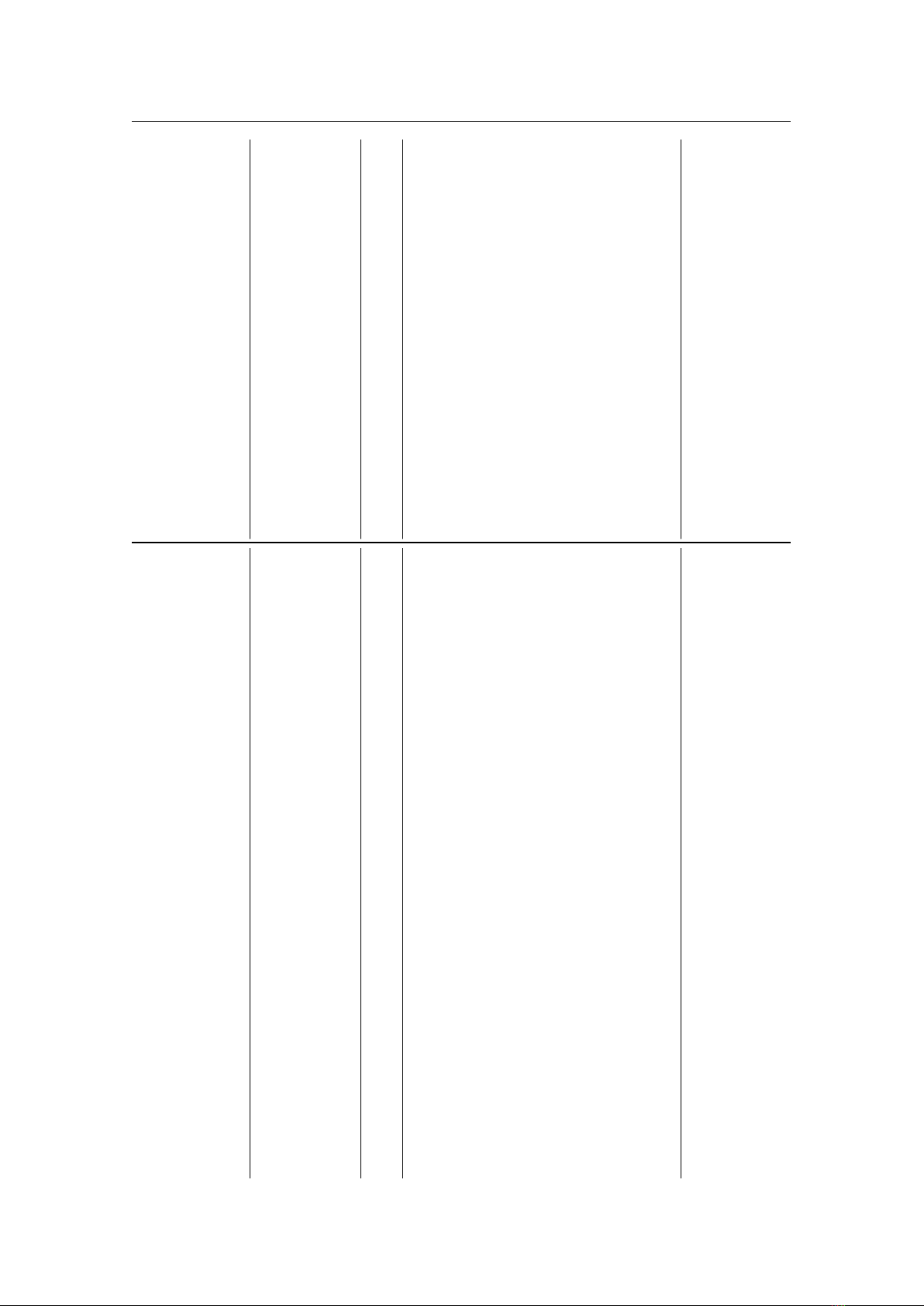
C.4 Double Stars 345
— ALC C. Allen 2000—2014
— ALD H.L. Alden 1924—1957
— ALI A. Ali 1949—1955
— ALL R.M. Aller 1930—1960
— ALP P.R. Allen 2007—2012
— AMM M. Ammler-von Eiff 2016
— AMS A. Amosse 2012—2020
— ANJ J.A. Anderson 1920
— ANT R. Anton 2001—
AOT AOT Astronomical Observatory Torino
— ARA S. Aravamudan 1961—1963
Arg ARG F.W.A. Argelander 1857—1865
— ARI E. Aristidi 1997—1999
— ARN D. Arnold 2001—2013
— ARR S. Arribas 1998
— ARU A.N. Argue 1984—1992
— ARY R.W. Argyle 1977—2020
— AST HST FGS Astrometry Science Team 1991—
— AZC A.A. Azcona 2012—2020
— B W.H. van den Bos 1921—1968
— BAG Yu.Yu. Balega 1977—2015
— BAK G.A. Bakos 2006
— BAL R. Baillaud 1924—1944
— BAR E.E. Barnard 1884—1922
— BAS M.A. Barstow 2001
BAT BAT H. Batterman
— BAU C. Bauer 1994—2007
— BAZ P. Baize 1927—1994
— BDK
Brown Dwarf Kinematic Project Cata-
log
2010
— BDT T.D. Brandt 2014—
— BED T.R. Bedding 1993—1994
— BEU J.-L. Beuzit 2004
— BEW U. Bastian, J. Eisloeffel, K. Wiese 1988
— BGH S. van den Bergh 1958
— BGR J.-P. Berger 2011
— BHA T.P. Bhaskaran 1916—1938
— BHJ
A. Blaauw, W.A. Hiltner, H.L. Johnson
1959
— BID W.P. Bidelman 1976—1980
Big BIG G. Bigourdan 1883—1903
— BIL B.A. Biller 2006—2014
— BKO E. Berko 2002—2012
— BLA A. Blazit 1877—1987
— BLK D.R. Blackmore 1990
Bll BLL R.S. Ball 1872—1884
— BLM B.L. Morgan 1978—1982
— BLO M. Bloch 1931
— BNK A. Brandeker 2001—2006
— BNS D. Baines 2006

346 Appendix C. Star Catalogues
— BNU D. Bonneau 1979—2011
— BNV M. Bonavita 2007—2020
— BNW W.A. Baranov 1909
— BOD A.F. Boden 1998—2012
— BOT G. Boettger 1958—1967
Bow BOW W.M. Bowyer 1896—1921
— BPM Bordeaux PM2000 catalogue 2010
— BRC C. Briceno 1998—2017
BRD BRD F. Bird
— BRF F.L. Brown 1916—1927
— BRG C. Bergfors 2010—2016
— BRH W. Barth 1994
— BRR W. Brandner 1995—2004
— BRT S.G. Barton 1926—1957
BrsO BSO Brisbane Observatory 1834—1851
— BTG A. Bertoglio 2007—2010
— BTM M. Bottom 2015
— BTZ E. Bernewitz 1920—1963
β BU * S. Burnham 1873—1918
β pm BUP * (Proper motion pairs) 1873—1918
— BVD R. Benavides 2003—2018
— BWL B.P. Bowler 2012—2018
— BYV V. Bailey 2014
— CAB J.A. Caballero 2005—2018
— CAN S.M. Caballero-Nieves 2014—2020
— CAR M. Carbillet 1996—1998
— CAT C. Catala 2006
— CBL R. Caballero 2008—2015
— CHE Stanislas Chevalier 1908—1925
— CHM J. Chaname 2004
— CHN M. Cohen 1979—1983
— CHR
Center for High Ang. Res. Astronomy
(speckle interferometry systems)
— CHT A.C. Cheetham 2015—2018
— CIA
Center for High Angular Resolution As-
tronomy (CHARA Interferometric Ar-
ray)
— CLL J.L. Comellas 2003
— CLO L.P. Close 1997—2014
— CLP P. Clark 2011
Cog COG W.A. Cogshall 1896—1905
Com COM G.C. Comstock 1894—1911
CorO COO Cordoba Observatory 1883—1920
Cop COP R. Copeland 1875—1886
— COU P. Couteau 1952—1999
CpO, CapO CPO Cape Observatory 1822—1938
— CRB J.-L. Carballo 2009—2016
— CRC M. Cortes-Contreras 2014—2017
— CRE T. Currie 2010—2020
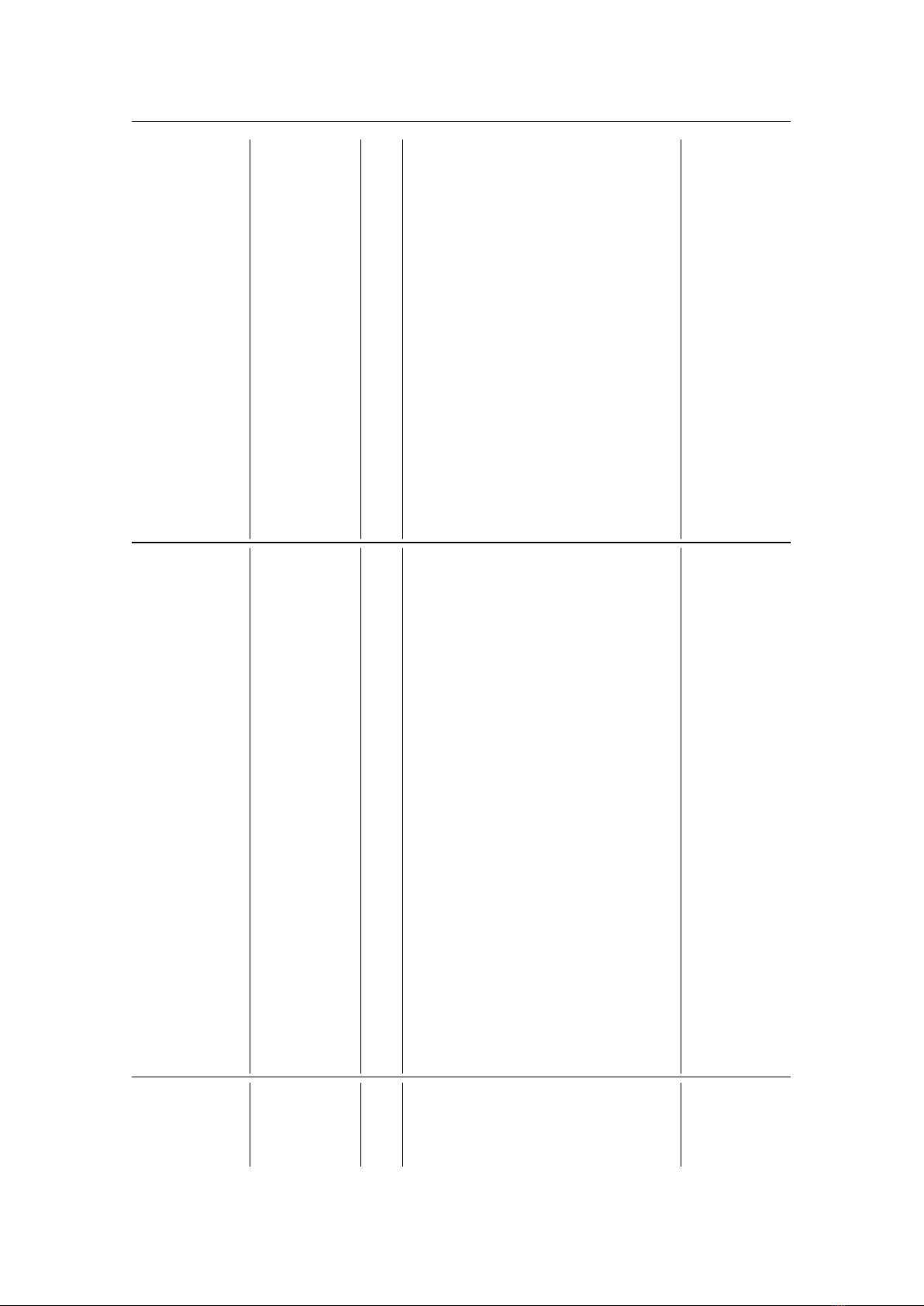
C.4 Double Stars 347
CRI CRI F. Crifo
— CRJ J.P. Crepp 2010—2015
Cru CRU L. Cruls 1884
— CRZ K.L. Cruz 2007
— CSE G. Csepany 2015—2017
— CSI Sz. Csizmadia 2009
— CSN J.C. Carson 2005—2013
— CSR I. Coster 2006—2016
— CSU O. Chesneau 2014
— CTI P.S. Conti 1971—1980
— CTT J.-F. Courtot 1995—
— CTU J.C. Christou 2006—2009
— CUD K.M. Cudworth 1973
— CUS F. Cusano 2012
— CUY J. Cuypers 1997—1999
— CVE Z. Cvetkovic 2005—2020
— CVN G. Chauvin 2002—2015
— CVP R.J. Cava and R.A. Pascal, Jr. 2004
— CVR J. Chivers 2011—2015
D D H. Dembowski 1856—1884
Dawes DA W.R. Dawes 1831—1867
— DAE S. Daemgen 2007—2015
— DAL J.A. Daley 1998—2018
— DAM F. Damm 2009—
— DAN A. Danjon 1937—1956
δ DAW * B.H. Dawson 1918—1933
— DBK M. De Becker 2004—2012
— DCH G. Duchene 1999—2018
— DEA N.R. Deacon 2005—2020
— DEL X. Delfosse 1999—2000
— DIC J. Dick 1921—1963
— DJU P. Djurkovic 1953—1973
Dob DOB W.A. Doberck 1875—1934
— DOM J. Dommanget 1949—1979
— DON H.F. Donner 1937—1964
— DOO E. Doolittle 1901—1923
— DOR Dorpat Observatory
— DRD P. Durand 1983—2011
— DRS R.J. De Rosa 2011—2019
— DSG DSSI-Gemini 2012
∆ DUN * J. Dunlop 1825—1846
— DUQ A. Duquennoy 1987—1996
— DVG M.J. del Valle Gonzalez 2015—
DYR DYR E.R. Dyer, Jr.
— EBE J. Ebersberger 1979—1986
EDG EDG D.W. Edgecomb
Egb EGB H.V. Egbert 1879—1906
— EGG O.J. Eggen 1945—1982

348 Appendix C. Star Catalogues
— EGN P. Eggenberger 2007—2008
— EHR D. Ehrenreich 2010
— EIS T. Eisenbeiss 2007
— ELP P. Elliott 2015—2016
Eng ENG R. Engelmann 1865—1887
Enh ENH B. von Engelhardt 1887—1895
— ENO European Network Observations
— ES T.E. Espin 1901—1933
— ESG S. Els 2001
— EVS N.R. Evans 1993—2020
— EVT T.M. Evans 2012
— FAB C. Fabricius 2000
— FAL J.L. Falin and F. Mignard 1999
— FAR J. Farihi 2004—2013
— FGL E.D. Feigelson 1996—2006
— FGS HST Fine Guide Sensor 2015
φ FIN W.S. Finsen 1926—1978
— FLE J. Fleckenstein 1956—1958
— FMR F.M. Rica Romero 1996—
— FOR L. Forgeron 1911
— FOX P. Fox 1909—1946
— FRH R. Furuhjelm 1932
— FRK W.S. Franks 1914—1919
— FRT W.J. Forrest 1988—1990
— FYM M. Fay 2013—2017
— GAA A. Gallenne 2014—2019
— GAL J. Gallo 1912—1914
GAn GAN G. Anderson 1888—1897
— GAT G.D. Gatewood 1973—2019
— GAU P.L. Gauchet 1923—1928
— GDM B. Goldman 2010
— GHE A.M. Ghez 1991—2016
— GIC H. Giclas 1961—1978
— GII R. Gili 1991—2020
— GIR P.M. Girard 1992—1994
— GIZ J.E. Gizis 2000—2006
— GJ W. Gliese and H. Jahreiss 1988
— GKI D.A. Golimowski 1993—2004
Gale GLE W.F. Gale 1897
Gli GLI J.M. Gilliss 1850—1868
Glp GLP S. Glasenapp 1888—1899
— GMC G. Micello 2011—2019
— GNS C. Ginski 2012—2016
GNT GNT Grant
— GOE K.-D. Goecking 1994
GOL GOL H. Goldschmidt
— GRB S. Groombridge 1913
— GRE J. Gregorio-Hetem 1992

C.4 Double Stars 349
— GRF R.F. Griffin 1975—2019
— GRV J. Greaves 2004—
— GRY C.A. Grady 2004
— GSH J. Glaisher 1906—1908
— GTB K. Gottlieb 1948
— GUE E.W. Guenther 2001—2005
— GUI J. Guillaume 1912—1931
— GUL K. Gullikson 2016
— GVT GRAVITY collaboration 2018—
— GWP Garraf Wide Pairs 2012—2016
— GYL A.N. Goyal 1958—1970
— GZA B. Gauza 2012—2015
H I to VI, H N H 1 to 6, H N W. Herschel 1777—1821
— HAT P. Hartigan 1994—2003
— HAU H. Haupt 1964—1966
Hd, HdO HDO Harvard Observatory 1866—1911
— HDS Hipparcos Double Star Catalog c. 1991
— HEG E.K. Hege 1983—1991
— HEI W.D. Heintz 1954—2001
— HEL K. Helminiak 2009—2016
— HER G.H. Herbig 1950—1998
h HJ J.F.W. Herschel 1826—1870
— HJL J.L. Halbwachs 1981—2020
Hl HL A. Hall 1866—1894
— HLA L.A. Hirsch 2019
Hld HLD E.S. Holden 1874—1884
— HLG G. Hill 1970—1988
— HLM E. Holmes 1906
— HLN F. Holden 1963—1979
— HMM C.A. Hummel 2001—2017
— HNK S. Hinkley 2010—2015
Ho HO G.W. Hough 1883—1907
— HOM F. Hormuth 2007
Hrg HRG L. Hargrave 1871—1892
— HRS D.L. Harris 1947
— HSL J.N. Heasley 2002
— HSW R. Harshaw 1990—1993
HTG HTG C.S. Hastings
Hu HU W.J. Hussey 1896—1914
— HUB S. Hubrig 2001
— HUE N. Huelamo 2009—2015
— HWD A.W. Howard 2010
Howe HWE H.A. Howe 1876—1882
— HZE A. Heinze 2009—2010
— HZG E. Hertzsprung 1907—1958
— I R.T.A. Innes 1895—1948
— INN P.A. Ianna 1974—1988
— IOT IOTA Array 1995—2011

350 Appendix C. Star Catalogues
— ISO S. Isobe 1990—1992
— ITF I.T. Falcon 2011—2020
— ITO Y. Itoh 1999—2011
— ISM R.M. Ismailov 1998—2020
— J R. Jonckheere 1908—1958
— JAY R. Jayawardhana 2001—2006
Jc JC W.S. Jacob 1847—1860
JCT JCT J.-C. Thorel
— JEF H.M. Jeffers 1945—1978
— JKA K.A. Janes 2017
JKS JKS M.P. Jenniskens
— JNN M. Janson 2006—2020
— JOD E. Jodar 2013
— JOH E.L. Johnson 1916—1948
— JOY A.H. Joy 1941—1949
— JRN A. Jorissen 1988
— JSP M.K. Jessup 1937—1964
— KAL P. Kalas 2008
— KAM P. van de Kamp 1929—1969
— KAR M. Karovska 1986—1997
— KEL A. Kellerer 2007
— KIR J.D. Kirkpatrick 1995—2014
— KNG B. Koenig 2002—2005
— KNP G.F.G. Knipe 1959—1969
Knott KNT G. Knott 1865—1881
Ko KO Koenigstuhl (Max Planck Institute)
— KOE L. Koechlin 1979—1983
— KOH R. Koehler 1998—2016
— KOI Kepler Object of Interest 2011—2018
— KON Q.M. Konopacky 2007—2010
— KOU M.B.N. Kouwenhoven 2005
— KPP W. Knapp 2015—
— KPR K.W. Kamper 1976—1992
— KR A. Kruger
KRO KRO G. Kron
— KRS C.D. Koresko 1991—2002
— KRU E.C. Kruger 1936—1937
— KRV P. Kervella 2009—2019
— KRW Carlos A. Krawczenko 2009—2020
— KSS S. Kraus 2007—2012
— KST J.H. Kastner 2012
Ku KU F. Kustner 1884—1902
— KUI G.P. Kuiper 1929—1961
Kza KZA S.M. Kazeza 1984
L L T. Lewis 1891—1921
— LAB A. Labeyrie 1974
— LAD T. Ladanyi 2003—2007
— LAF D. Lafreniere 2007—2014

C.4 Double Stars 351
Lal LAL J.-J. de Lalande 1825—1877
Lam LAM J. Lamont 1849
— LAU H.E. Lau 1905—1917
— LAW N.M. Law 2006—2010
— LBZ P. Labitzke 1925—1929
Lcl LCL N.L. Lacaille 1750
— LCS P.W. Lucas 2005
— LDS, LPM Luyten p.m. catalog
— LEC J. Lecacheux 2000—2007
LEE LEE O.J. Lee
— LEI Ch. Leinert 1986—2001
— LEO F.C. Leonard 1918—1943
— LEP S. Lepine 2001—2011
— LFR L. Ferrero 2009
— LGR A.-M. Lagrange 2006—2009
— LI W. Li 1994
— LIC G. Li Causi 2013
— LIM M.C. Liu 1996—2012
— LIN J.F. Ling 1983—2020
— LLO J.P. Lloyd 2002—2007
— LMP P. Lampens 2001—2016
— LNA A. Luna 2020
— LOC G. Locatelli 2013—2019
— LOS F. Losse 2005—2010
— LOU N.P. Loutrel 2011
— LPL N. La Palombara 2012
LpO LPO La Plata Observatory
— LSC
Lowell-Southern Connecticut Collabo-
ration
— LUH K.L. Luhman 2002—2013
— LUY W.J. Luyten 1933—1969
Lv LV F.P. Leavenworth 1887—1930
— LWR P.J. Lowrance 1999—2005
— LYS L. Louys 1987
Mad MAD J.H. Maedler 1835—1859
— MAJ J. Manfroid 1987
— MAM E.E. Mamajek 2010—2017
— MAR C. Marois 2008—2010
— MBA B.A. Macintosh 2001—2003
— MCA H.A. McAlister 1976—1996
— MCD M. Michaud 2012
— MCN L. Maccarini 2015—2019
— MCT C. McCarthy 2001
— MCY D.W. McCarthy 1982—1993
— MEL E.L. Martin 1998—2006
— MET S.A. Metchev 2003—2009
— MFL F.L. Martinez 2018—2019
— MGN G.N. Mace 2013
— MIL J.A. Miller 1903—1907
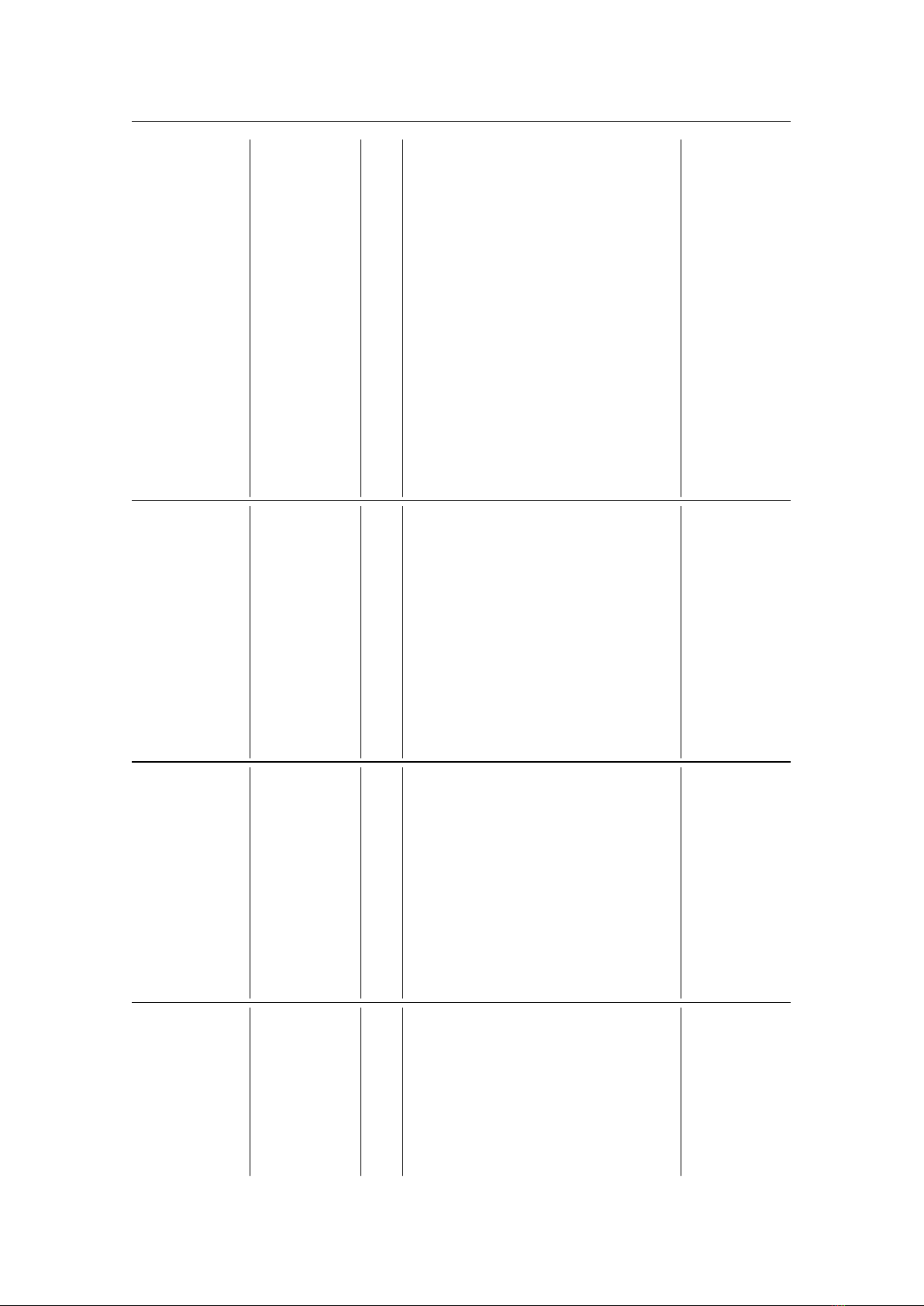
352 Appendix C. Star Catalogues
— MIU N. Miura 1992—1995
— MKR V.V. Makarov 2005—2010
— MKT Mark III Interferometer 1988—2006
— MLB W. Milburn 1918—1939
— MLD A. Meilland 2008—2011
MlF MLF F. Muller 1889
MlbO MLO Melbourne Observatory 1873—1898
— MLR P. Muller 1938—1997
— MOC C. Moutou 2017
— MRI E.R. Masa Martin 2005—2015
— MRN L. Marion 2014
— MRZ W. Markowitz 1956—1969
— MSH T. Meshkat 2015
— MUA A. Muller 2011
— MUG M. Mugrauer 2004—2020
— MWT D. Mawet 2011—2015
— MZA J. Maiz-Apellaniz 2007—2020
— NAJ T. Nakajima 1989—1995
— NHR R. Neuhauser 2000—2011
— NLS E.L. Nielsen 2010—2016
— NOI
Navy Prototype/Precision Optical In-
terferometer
1997—2019
— NOR J.R. North 2007
— NOV B. Novakovic 2005—2008
— NSE P. Nisenson 1985
— NSN J. Nanson 2013—2018
— NVL I. Novalbos 2009—2016
— NYS O. Nys 1963—1983
NZO NZO New Zealand Observatory 1911
— OCC Occult. Doubles Cat. 1971—
— ODE M. Odenkirchen 1995—1997
— OL C.P. Olivier 1907—1957
— OLE D. Olevic 1970—2006
— ONL Occult. News Letters
— OPI E. Opik 1927—1932
— ORL V.G. Orlov 2007—
— OSO M.R. Zapatero Osorio 2004—2010
— OSV V. Osvalds 1957—1964
— OSW T.D. Oswalt 1988—2012
— OUD R.D. Oudmaijer 2010
— PAR J.A. Parkhurst 1932
— PAT J. Patience 1998—2008
— PBL T. Pribulla 2006—2018
— PBS T. Preibisch 1999—2014
Pck PCK E. Pickering 1879—1912
— PEA F.G. Pease 1925—1927
Per PER J. Perrotin 1883—1887
— PES S. Peretti 2019

C.4 Double Stars 353
— PET D. Peter 2012
— PIC W.H. Pickering 1900—1937
— PIN D.J. Pinfield 2006—2012
— PKO Pulkova Observatory 1965—
— PLQ E. Paloque 1923—1939
— PLT L. Plaut 1934—1940
— PNT L.R. de Pont 2012—
Pol POL J.A. Pollock 1887
— POP G.M. Popovic 1967—2007
— POT D. Potter 2002
— POU M.A. Pourteau 1933
— PRB R.G. Probst 2006
Prn PRN C.D. Perrine 1899—1900
PrO PRO Perth Observatory 1913
— PRU J.-L. Prieur 2001—2017
Pry PRY J.J.M. Perry 1880—1886
— PRZ E. Przbyllok 1908—1926
— PSF Project Sixteen Forty
— PTI Palomar Testbed Interferometer 2001—2004
— PTR M.G. Petr 1998
Pwl PWL E.B. Powell 1854—1892
— PWS T. Pauwels and P. Lampens 1993
Pz PZ G. Piazzi 1814
R R H.C. Russell 1871—1892
— RAG D. Raghavan 2004—2010
— RAO Robo AO project 2014—2020
— RAS D.A. Rastegaev 2007—2014
— RBR L.C. Roberts, Jr. 2002—2018
— RBT J.G. Robertson 1991—1999
— RCH A. Richichi 1994—2020
— RDR D.R. Rodriguez 2011—2015
— RED I.N. Reid 1982—2008
REI REI K. Reinmuth
— REP B. Reipurth 1986—2015
— REU D. Reuyl 1931—1945
— RGS T.J. Rodigas 2014—2016
Rhd RHD Father Richaud 1729
— RIZ A.C. Rizzuto 2013—2020
— RJJ J. Rajagopal 2010
Rmk RMK C. Rumker 1825—1837
— RMU J. Rameau 2013
— ROE E.D. Roe 1908—1919
— ROL T. Roell 2012
— RSS J.M. Rousseau 1996
— RST R.A. Rossiter 1933—1964
— RUC S.M. Rucinski 2007—2010
S S J. South 1826—1825
— SAN R.F. Sanford 1921—1940

354 Appendix C. Star Catalogues
— SAO Special Astrophysical Observatory 2017
— SBK G.M. Seabroke 1881—1910
— SBN E. Serabyn 2006—2010
— SCA M. Scardia 1979—2020
— SCE A. Schneider 2011
— SCJ H. Schjellerup 1906
— SCO M. Scholler 1996—2020
— SCP C. Schnupp 2010
— SCZ A.B. Schultz 1998
— SDK N. Sanduleak 1990
— SDR W.L. Sanders 1966
— SDT T.O.B. Schmidt 2008—2013
Se SE A. Secchi 1855—1865
λ SEE * T.J.J. See 1892—1900
— SEI J. Scheiner 1908
Shb SHB J.M. Schaeberle 1893—1897
Sh SHJ J. South and J. Herschel 1821—1840
— SHN G. Schneider 1993—2004
— SHT N.I. Shatsky 1998—2014
— SHY E.J. Shaya 2011
— SIN D. Sinachopoulos 1988—2007
— SKF B.A. Skiff 2000—
Ski SKI A.N. Skinner 1872—1911
— SLE G. Soulie 1966—2007
Slr SLR R.P. Sellors 1892—1910
— SMA W.M. Smart 1931—1932
— SMK P.C. Schmidtke 1984—2011
— SML L.C. Smith 2015
— SMR J. Schlimmer 2007—
— SMW G.V. Simonov 1937—1951
Smyth SMY W.H. Smyth 1833—1860
— SNA H. Sana 2006—2014
— SOZ R.-D. Scholz 2003—2017
Sp SP J.V. Schiaparelli 1876—1909
— SPM Springbook Middle School 2021
— SRT R. Shuart 2005
— SRW R.W. Sinnott 1999
— SS S. Sharpless 1954
— ST C.L. Stearns 1936—1939
— STA G.A. Starikova 1962—1985
— STE C.B. Stephenson 1965—1988
Σ STF * F. Wilhelm von Struve 1814—1843
Σ I, Σ II STFA, STFB * (Supplemental catalogs) 1814—1843
— STG G. Struve 1932—1963
— STH H. Struve 1901—1913
— STI J. Stein 1926
— STJ J. Serot 2009—2019
Stone STN O. Stone 1867—1882
OΣ STT * O. von Struve 1832—1878
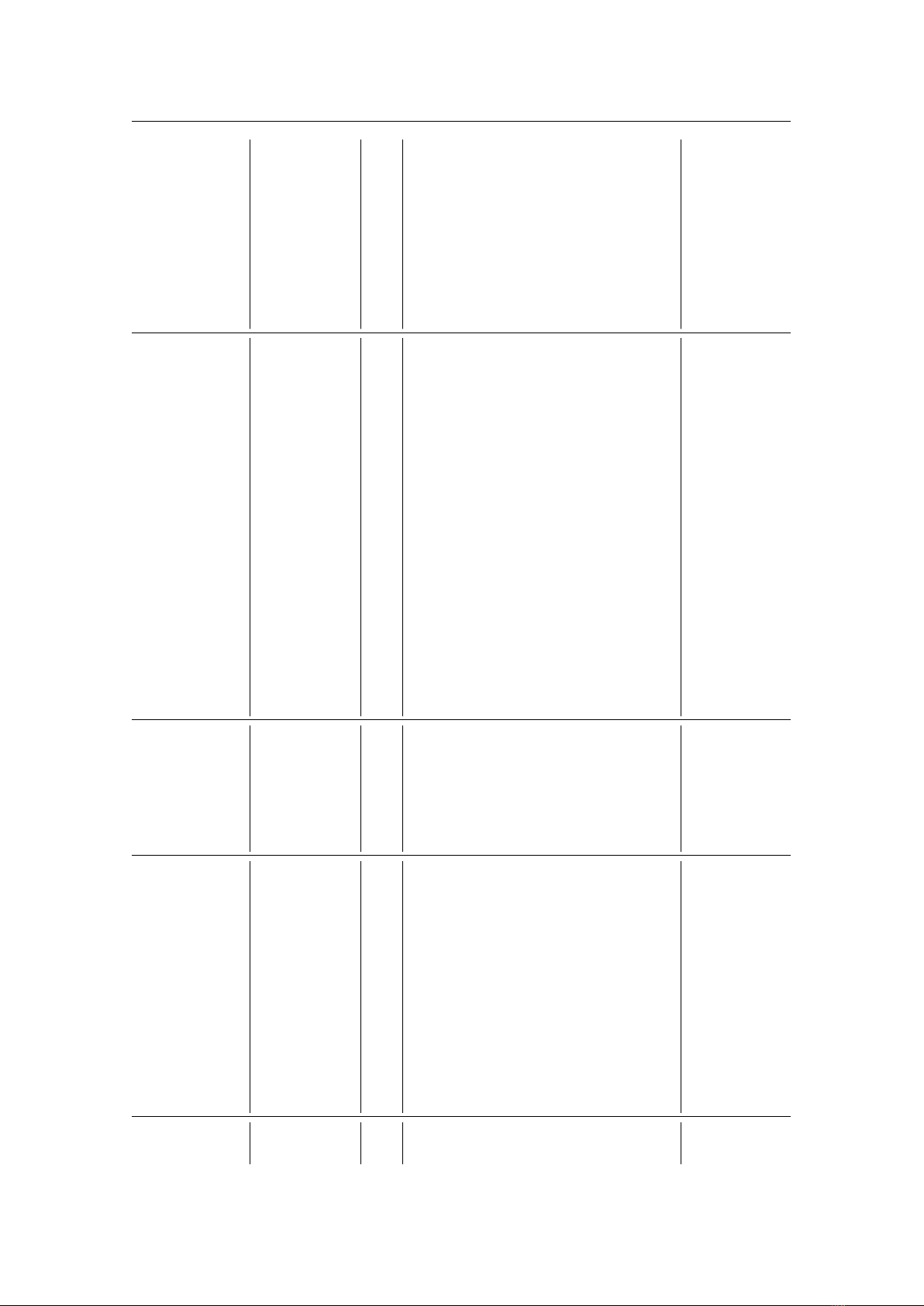
C.4 Double Stars 355
OΣΣ STTA * (Supplemental catalogs) 1832—1878
— STU K. Sturdy 1984—1994
— STZ M.F. Sterzik 1997—2005
— SUB J.P. Subasavage 2005—2017
— SUN G. Sun 2020
SWI SWI L. Swift
— SWR J. Stock 1972—1997
SyO SYO Sydney Observatory 1927—1986
— SZA T.B. Souza 2020
— TAM V.S. Tamazian 1999—2008
Tar TAR K.J. Tarrant 1886—1893
— TDS, TDT Tycho Double Star
— THA C. Thalmann 2009
— THB F. Thiebaut 1995
— THP B. Thompson 2006—2014
— TKA V.V. Tel’nyuk-Adamchuk 1966
— TNG W.J. Tango 1979—2009
— TNN A.M. Tanner 2010
— TOB T. Tobal 2000—2016
— TOI TOI Numbers from Stassun et al. 2010
— TOK A.A. Tokovinin 1979—
— TOR Torino Observatory 1978—1992
— TRA V. Trajkovska 1999
— TRN N.H. Turner 1999—2010
— TRR G. Torres 1985—2020
Tuc TUC R.H. Tucker 1893
— TVB T.V. Bryant 2014—2019
— UC
USNO CCD Astrographic Catalog
(UCAC1, UCAC2, UCAC3, UCAC4)
2013—2015
Upt UPT W. Upton 1877—1878
— UR
USNO Robotic Astrometric Telescope
(URAT)
2015—2016
— USD US Numbers from Esplin et al. 2005—2018
— VAS G. Vaskuti 2011—2012
— VBS G. Van Biesbroeck 1904—1965
— VDK J. Vanderdonck 1909—1944
— VGT N. Vogt 2012—2015
— VIG A. Vigan 2012—2016
— VKI E. Vilkki 1984—1989
— VLM W. Vollmann 2006—2016
— VOU J.G. Voute 1908—1956
— VSP VLT + SPHERE 2019—
VVO VVO Van Vleck Observatory 1962—1993
— VVV Vista Variables in Via Lactea
— VYS A.N. Vyssotsky 1927—1956
— WAK R.L. Walker 1966—1985
— WAL A. Wallenquist 1934—1958

356 Appendix C. Star Catalogues
— WCK W.C. Wickes 1973—1975
— WDK K. Patience Ward-Duong 2015
Webb WEB T.W. Webb
— WEI M. Weisse 1906
— WFC
Washington Fundamental Cat. - astro-
graphs
1939—1999
— WG R.W. Wrigley 1911
— WGA G.A.H. Walker 1994
— WGK K. Wagner 2016—2018
— WGT G.P. Weigelt 1978—2002
WHC WHC H.C. Wilson 1890
— WHI G.L. White 1991—2019
— WIL J.C. Wilson 2001
— WIR C.A. Wirtanen 1941—1981
— WIS Wide-field Infrared Survey Explorer 2010—2016
— WLF Wolf 1913
Wnc WNC F.A. Winnecke 1855—1909
WNO WNO Washington Naval Observatory 1866—1896
— WOR C.E. Worley 1956—2001
Wrd WRD I.W. Ward 1876—1878
— WRH R.H. Wilson 1933—1982
— WRS K. Wierzchos 2017—2019
WS WS J.M. Wilson 1875—1877
— WSI Washington Speckle Interferometer 1997—
— WTT J.M. Wittrock 2016—2017
— WZ C. Wirtz 1912—1923
— XMI X. Miret 2007—2016
Yng YNG C.A. Young 1881—1887
— YR Yale-Rochester Collaboration
— YSC
Yale-Southern Connecticut Collabora-
tion
— YSJ Yale-San Juan Collaboration
— ZHN Z.H. Zhang 2010—2013
— ZUC B. Zuckerman 1992—2001
— ZUL D.J. Zulevic 1967—2000
Table C.9: Additional designations for double stars
C.5 Cross-Identification Data
Since version 0.14.0 Stellarium supports cross-identification between stars from Hipparcos (HIP) (An-
derson and Francis, 2012), Smithsonian Astrophysical Observatory (SAO) Star Catalog J2000.0 (SAO
Staff, 1995), Henry Draper Catalogue and Extension (HD) (Cannon and Pickering, 1993) and
Catalogue of bright stars (Hoffleit, 1964) (BSC5 or HR) catalogues.
C.5.1 Cross-Identification Catalog File Format
Stellarium’s Cross-Identification catalog data is kept in the
stars/default
sub-directory of the
Installation Directory and/or User Directory (see section 5.1).

C.5 Cross-Identification Data 357
File Format
The file
cross-id.dat
contains cross reference data for catalogues HIP, SAO, HD and HR, which
stored in the plain text format with tab delimiter.
Name Type Description
HIP int
HIP identificator for the star. Used for reference to the main star cata-
logue.
SAO int SAO identificator for the star.
HD int HD identificator for the star.
HR int HR identificator for the star.
Table C.10: Format of cross-id.dat

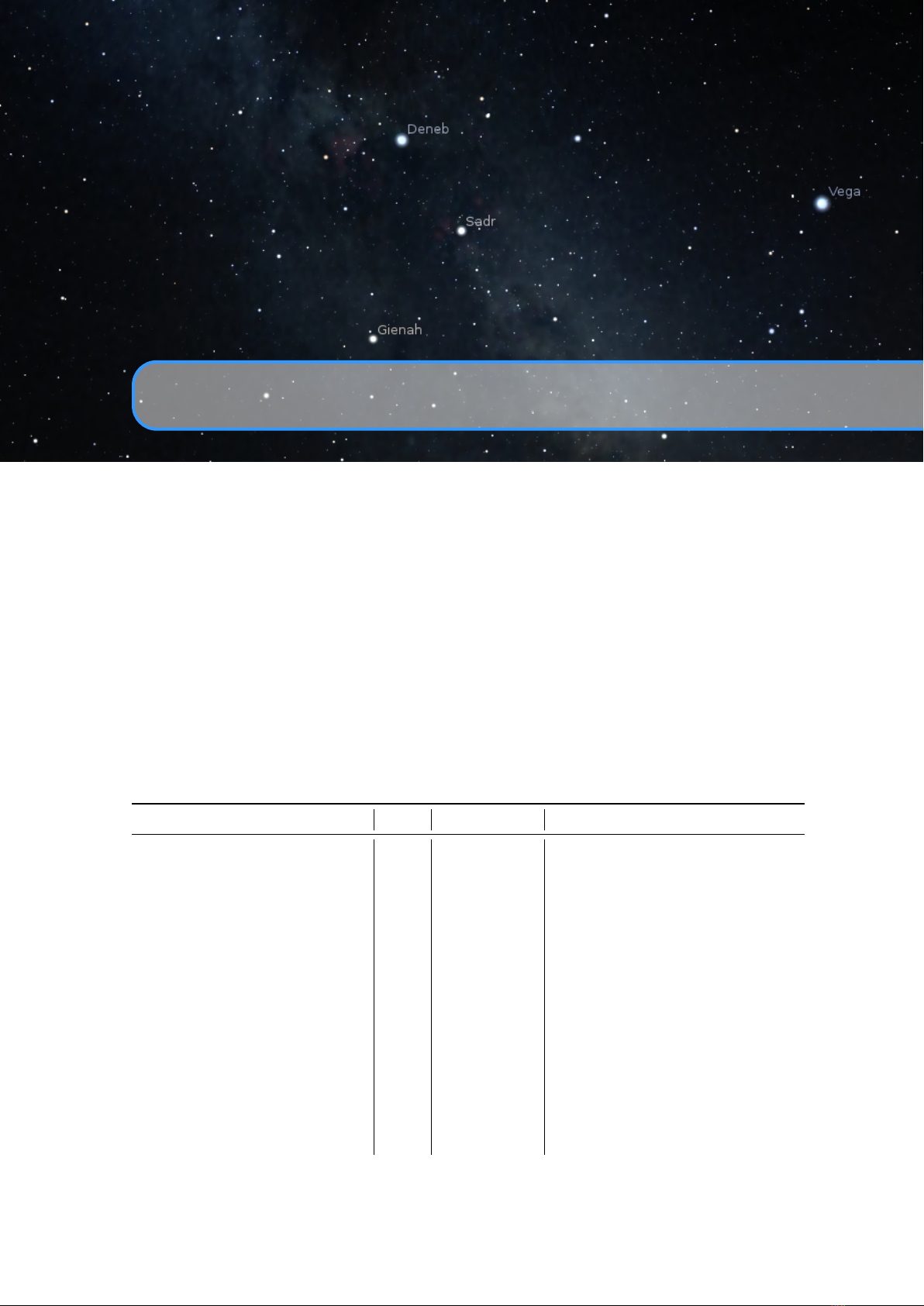
D. Configuration Files
D.1 Program Configuration
First, see 5.4 (The Main Configuration File) for information about the file
config.ini
, including
its default installed location, and command line options that can affect how it is processed.
The file
config.ini
(or a file which you can load instead with the
--config <file>
option)
is structured into the following parts. In addition, plugins can add a section named like the plugin
(Exception: The Text User Interface plugin’s section is named [tui] for historical reasons).
D.1.1
astro
This section includes settings for the commonly displayed objects.
ID Type Default Description
apparent_magnitude_algorithm string Mallama2018
Set algorithm for computation of
apparent magnitude of the planets.
Possible values: Mallama2018,
ExpSup2013, ExpSup1992, As-
trAlm1984, Mueller1893 and
Generic.
nebula_magnitude_limit float 8.5
Value of limiting magnitude for the
deep-sky objects.
star_magnitude_limit float 6.5
Value of limiting magnitude for the
stars. Sometimes you don’t want to
display more stars when zooming in.
planet_magnitude_limit float 6.5
Value of limiting magnitude for the
planets. Sometimes you don’t want
to display more planets when zoom-
ing in.
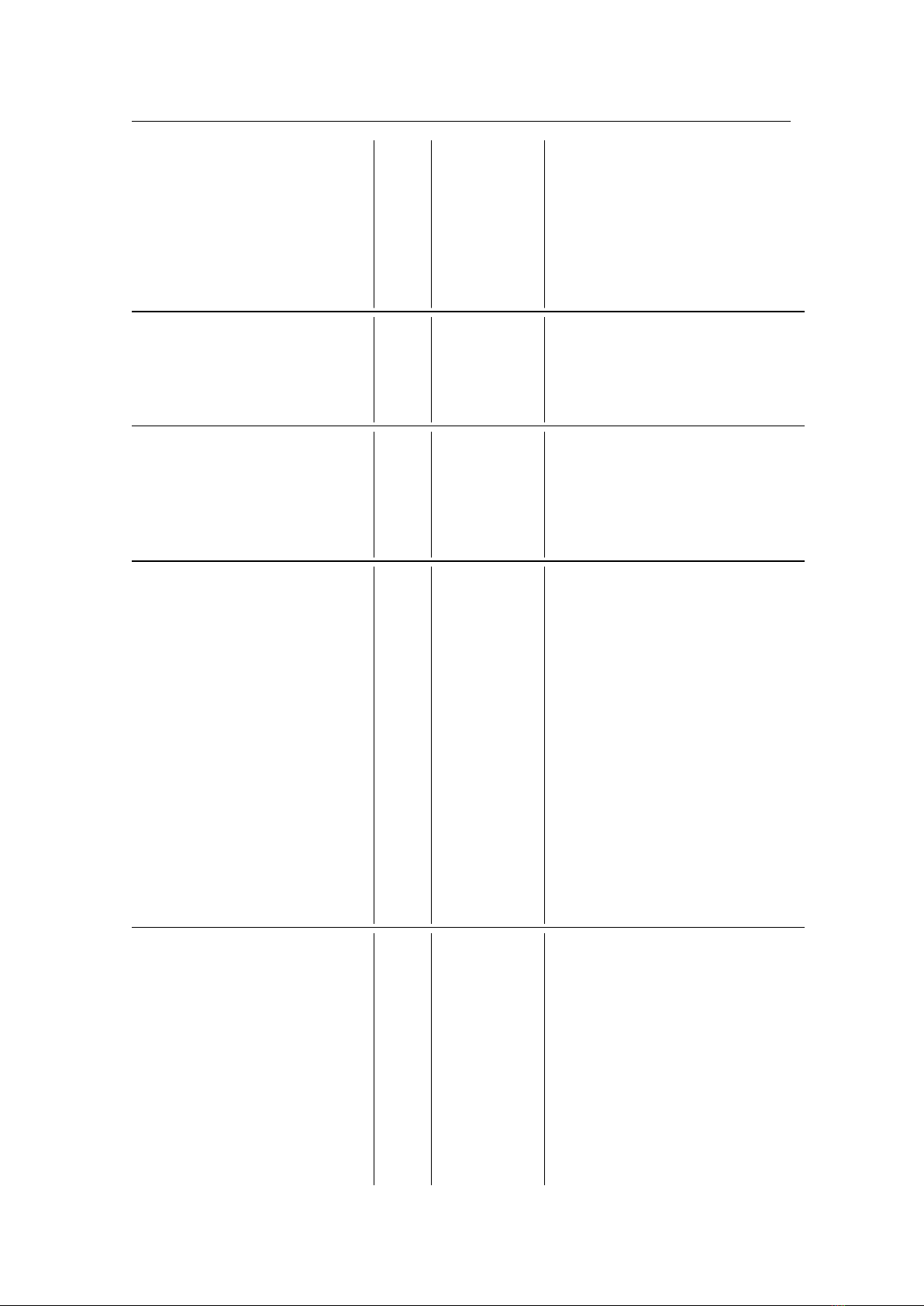
360 Appendix D. Configuration Files
planets_orbits_color_style string one_color
Set the style of orbits color. Possible
values: one_color, groups and max.
flag_nebula_magnitude_limit bool false
Set to true to activate limit for show-
ing deep-sky objects.
flag_star_magnitude_limit bool false
Set to true to activate limit for show-
ing stars
flag_planet_magnitude_limit bool false
Set to true to activate limit for show-
ing planets.
extinction_mode_below_horizon string zero
Set extinction mode for atmosphere
below horizon. Possible values:
zero, mirror and max.
twilight_altitude float -6.0
Solar altitude for going to previ-
ous/next twilight.
flag_stars bool true
Set to false to hide the stars on start-
up
flag_star_name bool true
Set to false to hide the star labels on
start-up
flag_star_additional_names bool true
Set true to use all available proper
names for stars.
flag_star_designation_usage bool false
If true, use designations of stars on
the sky (on-screen labels) instead of
their common names.
flag_star_designation_dbl bool false
If true, and star doesn’t have com-
mon name and Bayer or Flamsteed
designations then use first of tradi-
tional designations of double stars to
the on-screen labels.
flag_star_designation_var bool false
If true, and star doesn’t have com-
mon name or Bayer, Flamsteed or
double star designation then use des-
ignation of variable stars as the on-
screen label.
flag_star_designation_hip bool false
If true, use HIP designations of stars
for the on-screen labels if common
name or traditional designations do
not exist for star.
flag_planets bool true
Set to false to hide the planet labels
on start-up
flag_planets_hints bool true
Set to false to hide the planet hints
on startup (names and circular high-
lights)
flag_planets_orbits bool false
Set to true to show the planet orbits
on startup
flag_permanent_orbits bool false
Set to true to show the orbit of
planet, when planet is out of the
viewport also.
flag_planets_pointers bool false
Set to true to show the planet pointer
markers on startup

D.1 Program Configuration 361
flag_planets_nomenclature bool false
Set to true to show the planetary
nomenclature markers and labels
flag_planets_nomenclature_. . . bool false Set to true to show only items
terminator_only along the terminator
planet_nomenclature_. . .
solar_altitude_min int -5
minimum solar altitude for the ter-
minator setting above
solar_altitude_max int 40
maximum solar altitude for the ter-
minator setting above
flag_hide_local_nomenclature bool true
Set to true to hide the plane-
tary nomenclature items on the ob-
server’s celestial body
flag_light_travel_time bool true
Should be true to improve accuracy
in the movement of the planets by
compensating for the time it takes
for light to travel. This has a slight
impact on performance, but is essen-
tial e.g. for Jupiter’s moons.
flag_object_trails bool false
Turns on and off drawing of object
trails (which show the movement of
the planets over time).
flag_nebula bool true
Set to false to hide the nebulae on
start-up.
flag_nebula_name bool false
Set to true to show the nebula labels
on start-up.
flag_nebula_display_no_texture bool false
Set to true to suppress displaying of
nebula textures.
nebula_texture_decimation int 1
Reduce nebula texture size by this
factor [1.. . 8]. May help on very
limited systems.
nebula_hints_amount float 3.0 Sets the amount of hints [0. . . 10].
nebula_labels_amount float 3.0 Sets the amount of labels [0. . . 10].
flag_milky_way bool true Set to false to hide the Milky Way.
milky_way_intensity float 1.0
Sets the relative brightness with
which the milky way is drawn. Typi-
cal [1. . . 3].
flag_zodiacal_light bool true
Set to false to hide the zodiacal light
zodiacal_light_intensity float 1.0
Sets the relative brightness with
which the zodiacal light is drawn.
max_mag_nebula_name float 8.0
Sets the magnitude of the nebulae
whose name is shown.
flag_nebula_hints_proportional bool false
Enables/disables proportional mark-
ers for deep-sky objects.
flag_surface_brightness_usage bool false
Enables/disables usage surface
brightness for markers for deep-sky
objects.
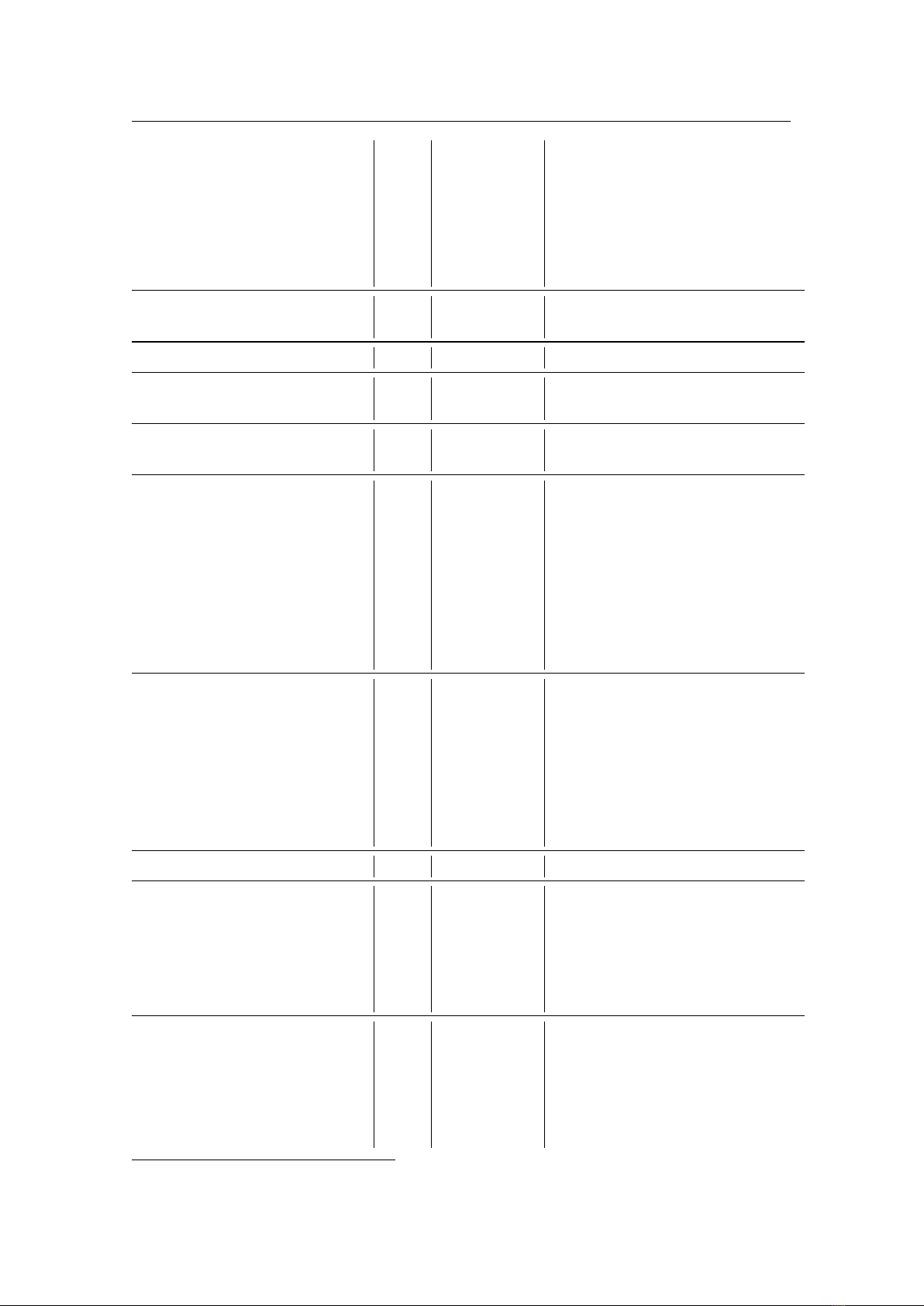
362 Appendix D. Configuration Files
flag_size_limits_usage bool false
Enables/disables usage angular size
filter for markers for deep-sky ob-
jects.
size_limit_min int 1
Minimal angular size of visible deep-
sky objects in arcminutes.
size_limit_max int 600
Maximum angular size of visible
deep-sky objects in arcminutes.
flag_use_type_filter bool false
Enables/disables usage of the type
filters for deep-sky objects.
flag_nutation bool true Enables/disables usage nutation.
flag_topocentric_coordinates bool true
Enables/disables usage topocentric
coordinates.
shadow_enlargement_danjon bool false
Earth shadow enlargement (see
19.11.2).
flag_dso_designation_usage bool false
If true, use designations of deep-sky
objects on the sky instead of their
common names.
flag_dso_outlines_usage bool false
If true, use outlines for big deep-sky
objects on the sky instead of their
hints.
flag_dso_additional_names bool true
Set true to use additional names
(also known as) for deep-sky ob-
jects.
grs_longitude int 216
Longitude (System II) of Great Red
Spot on Jupiter in degrees.
grs_drift float 15.0
Annual drift of Great Red Spot on
Jupiter in degrees.
grs_jd float 2456901.5
Initial JD for calculation of position
of Great Red Spot on Jupiter.
grs_measurements_url string
URL of recent measurements of
GRS’ position
1
.
meteor_zhr int 10 ZHR for sporadic meteors.
de430_path string
Path to JPL DE430 ephemerides file.
flag_use_de430 bool false
Enables/disables usage JPL DE430
ephemerides (if available).
de431_path string
Path to JPL DE431 ephemerides file.
flag_use_de431 bool false
Enables/disables usage JPL DE431
ephemerides (if available).
flag_toast_survey bool false
Enables/disables Digitized Sky Sur-
vey in TOAST format.
toast_survey_host string
Host of Digitized Sky Survey stor-
age data.
toast_survey_directory string results
Directory name of Digitized Sky
Survey storage data.
1
Default value is http://jupos.privat.t-online.de/rGrs.htm

D.1 Program Configuration 363
toast_survey_levels int 11
Count of levels for Digitized Sky
Survey storage data.
D.1.2
astrocalc
This section includes settings for the Astronomical Calculations feature.
ID Type Default Description
flag_ephemeris_markers bool true
Set to true to show the calculated
ephemeris markers for Solar system bodies.
flag_ephemeris_line bool false
Set to true to show the connecting line be-
tween the ephemeris markers.
flag_ephemeris_dates bool false
Set to true to show the dates of calculated
ephemeris for Solar system bodies.
flag_ephemeris_magnitudes bool false
Set to true to show the magnitude of Solar
system body for the calculated ephemeride.
flag_ephemeris_horizontal bool false
Set to true to use horizontal coordinates for
ephemerides.
flag_ephemeris_skip_data bool false
Set to true to skip the showing data near
ephemeris markers.
flag_ephemeris_smart_dates bool true
Set to true to use smart format for dates,
who showing near ephemeris markers.
flag_ephemeris_scale_markers bool false
Set to true to use small ephemeris markers,
when line is enabled.
ephemeris_celestial_body string Moon
Default celestial body for computation of
ephemerides.
ephemeris_time_step int 6 Identificator for time step category.
ephemeris_data_step int 0
Value of skipping step when skipping op-
tion is enabled (label each N steps, where
N is step).
celestial_magnitude_limit float 6.0
Value of limiting magnitude for the celes-
tial objects in computation of their posi-
tions.
celestial_category int 200
Identificator for default category of celes-
tial bodies.
flag_horizontal_coordinates bool false
Set to true to use horizontal coordinates
for compute of positions for the celestial
objects.
flag_phenomena_opposition bool false
Set to true to compute of opposition phe-
nomenon between the Solar system bodies.
flag_phenomena_perihelion bool false
Set to true to compute perihelion and
aphelion for Solar system bodies (except
moons).
phenomena_angular_separation float 1.0
Allowed angular separation between celes-
tial bodies for computation of phenomena.
phenomena_celestial_body string Venus
Default celestial body for computation of
phenomena.
phenomena_celestial_group int 0
Identificator for group of celestial bodies
for computation of phenomena.
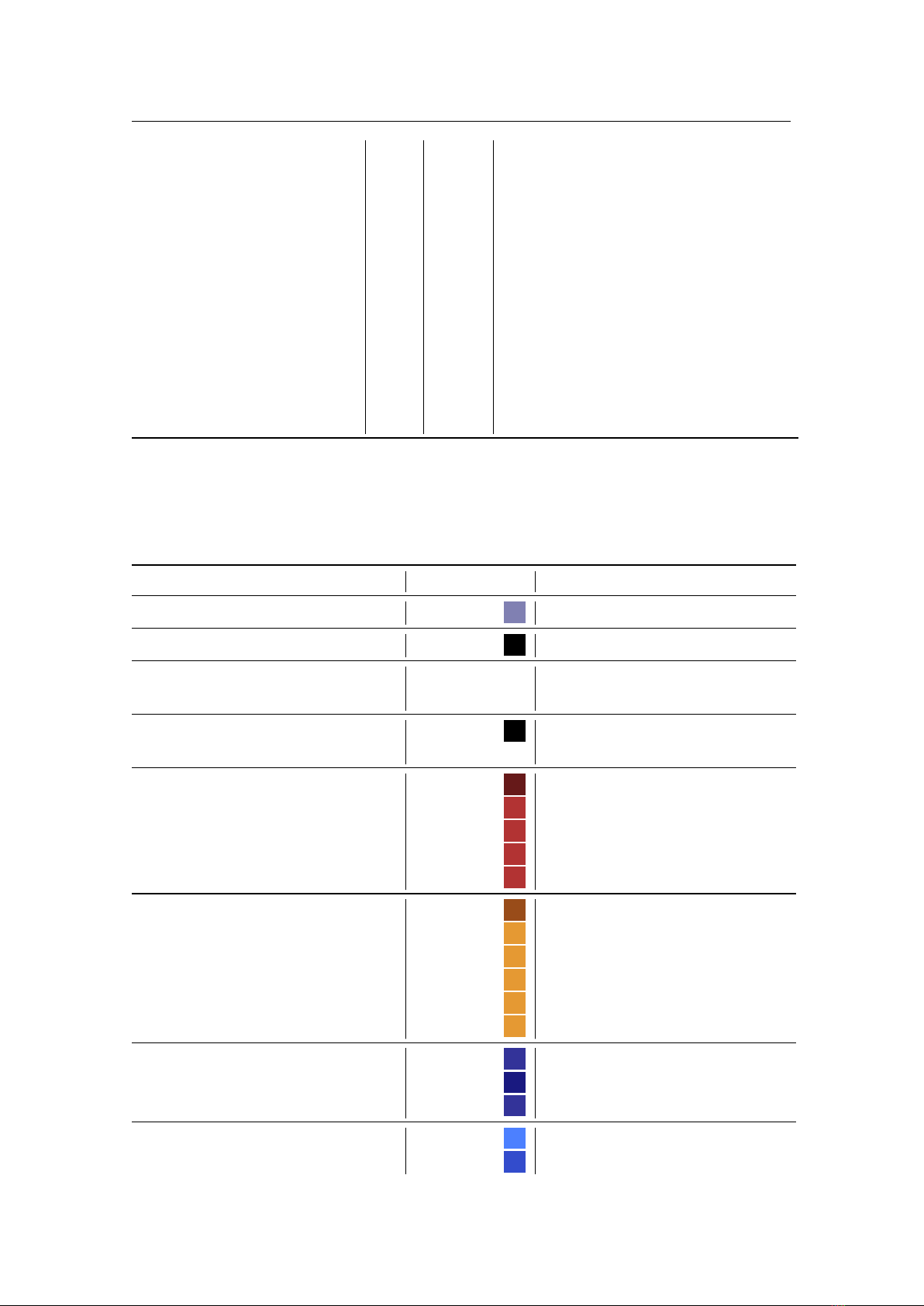
364 Appendix D. Configuration Files
wut_magnitude_limit float 10.0
Value of limiting magnitude for calcula-
tions within What’s Up Tonight feature.
wut_time_interval int 0
Identificator for time interval within What’s
Up Tonight feature computations.
wut_angular_limit_flag bool false Set to true to use the angular size filter.
wut_angular_limit_min float 1.0
Minimal allowed angular size, arcminutes.
wut_angular_limit_max float 600.0
Maximal allowed angular size, arcminutes.
wut_altitude_min float 0.0 Minimal allowed altitude for compute rise
and set times, degrees.
graphs_celestial_body string Moon Default celestial body for draw of graphs.
graphs_duration int 1
How much years account into calculation
of graphs.
graphs_first_id int 1 Identificator for left graph (blue line).
graphs_second_id int 2 Identificator for right graph (yellow line).
D.1.3
color
This section defines the RGB colors for the various objects, lines, grids, labels etc. Values are given
in float from 0 to 1. e.g. 1.0,1.0,1.0 for white, or 1,0,0 for red. Leave no whitespace between the
numbers!
ID Default Colour of the. . .
default_color 0.5,0.5,0.7 default colour.
daylight_text_color 0.0,0.0,0.0 info text at daylight.
info_text_color 1.0,1.0,1.0
info text color when overwrite mode
for text color is enabled.
sky_background_color 0.0,0.0,0.0
sky background (non-black is useful
for artists only).
ecliptical_J2000_color 0.4,0.1,0.1 ecliptical grid (J2000.0 frame).
ecliptic_J2000_color 0.7,0.2,0.2 ecliptic line (J2000.0 frame).
equinox_J2000_points_color 0.7,0.2,0.2 equinox points (J2000.0 frame).
solstice_J2000_points_color 0.7,0.2,0.2 solstice points (J2000.0 frame).
ecliptic_J2000_poles_color 0.7,0.2,0.2 ecliptic poles (J2000.0 frame).
ecliptical_color 0.6,0.3,0.1 ecliptical grid (of date).
ecliptic_color 0.9,0.6,0.2 ecliptic line (of date).
equinox_points_color 0.9,0.6,0.2 equinox points (of date).
solstice_points_color 0.9,0.6,0.2 solstice points (of date).
ecliptic_poles_color 0.9,0.6,0.2 ecliptic poles (of date).
precession_circles_color 0.9,0.6,0.2 precession circles.
equator_J2000_color 0.2,0.2,0.6 equator line (J2000.0 frame).
equatorial_J2000_color 0.1,0.1,0.5 equatorial grid (J2000.0 frame).
celestial_J2000_poles_color 0.2,0.2,0.6 celestial poles (J2000.0 frame).
equator_color 0.3,0.5,1.0 equator line (of date).
equatorial_color 0.2,0.3,0.8 equatorial grid (of date).
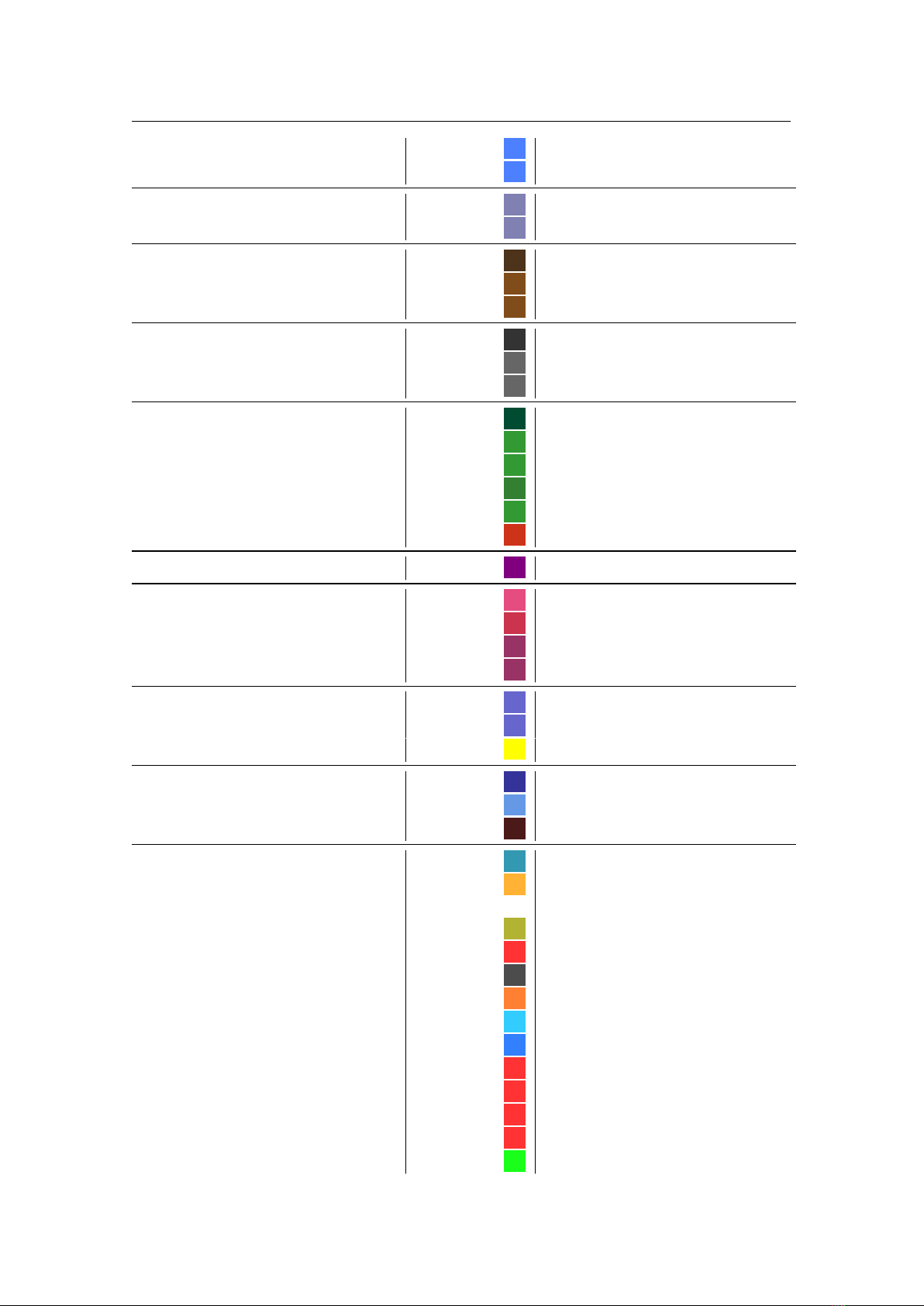
D.1 Program Configuration 365
celestial_poles_color 0.3,0.5,1.0 celestial poles (of date).
circumpolar_circles_color 0.3,0.5,1.0 circumpolar circles.
fixed_equator_color 0.5,0.5,0.7 fixed equator (hour angle) line.
fixed_equatorial_color 0.5,0.5,0.7 fixed equatorial grid.
galactic_color 0.3,0.2,0.1 galactic grid.
galactic_equator_color 0.5,0.3,0.1 galactic equator line.
galactic_poles_color 0.5,0.3,0.1 galactic poles.
supergalactic_color 0.2,0.2,0.2 supergalactic grid.
supergalactic_equator_color 0.4,0.4,0.4 supergalactic equator line.
supergalactic_poles_color 0.4,0.4,0.4 supergalactic poles.
azimuthal_color 0.0,0.3,0.2 azimuthal grid.
horizon_color 0.2,0.6,0.2 horizon line.
meridian_color 0.2,0.6,0.2 meridian line.
prime_vertical_color 0.2,0.5,0.2 prime vertical.
zenith_nadir_color 0.2,0.6,0.2 zenith and nadir.
cardinal_color 0.8,0.2,0.1 cardinal points.
colures_color 0.5,0.0,0.5 colures.
antisolar_point_color 0.9,0.3,0.5 antisolar point.
apex_points_color 0.8,0.2,0.3 apex points.
oc_longitude_color 0.6,0.2,0.4 opposition/conjunction longitude.
quadrature_color 0.6,0.2,0.4 quadrature circle.
asterism_lines_color 0.4,0.4,0.8 asterism lines.
asterism_names_color 0.4,0.4,0.8 asterism names.
rayhelper_lines_color 1.0,1.0,0.0 the ray helper lines.
const_lines_color 0.2,0.2,0.6 constellation lines.
const_names_color 0.4,0.6,0.9 constellation names.
const_boundary_color 0.3,0.1,0.1 constellation boundaries.
dso_label_color 0.2,0.6,0.7 deep-sky objects labels.
dso_circle_color 1.0,0.7,0.2
deep-sky objects symbols, if not of
the types below.
dso_region_color 0.7,0.7,0.2 regions symbols.
dso_galaxy_color 1.0,0.2,0.2 galaxies symbols.
dso_radio_galaxy_color 0.3,0.3,0.3 radio galaxies symbols.
dso_active_galaxy_color 1.0,0.5,0.2 active galaxies symbols.
dso_interacting_galaxy_color 0.2,0.8,1.0 clusters of galaxies symbols.
dso_galaxy_cluster_color 0.2,0.5,1.0 interacting galaxies symbols.
dso_quasar_color 1.0,0.2,0.2 quasars symbols.
dso_possible_quasar_color 1.0,0.2,0.2 possible quasars symbols.
dso_bl_lac_color 1.0,0.2,0.2 BL Lac objects symbols.
dso_blazar_color 1.0,0.2,0.2 blazars symbols.
dso_nebula_color 0.1,1.0,0.1 nebulae symbols.
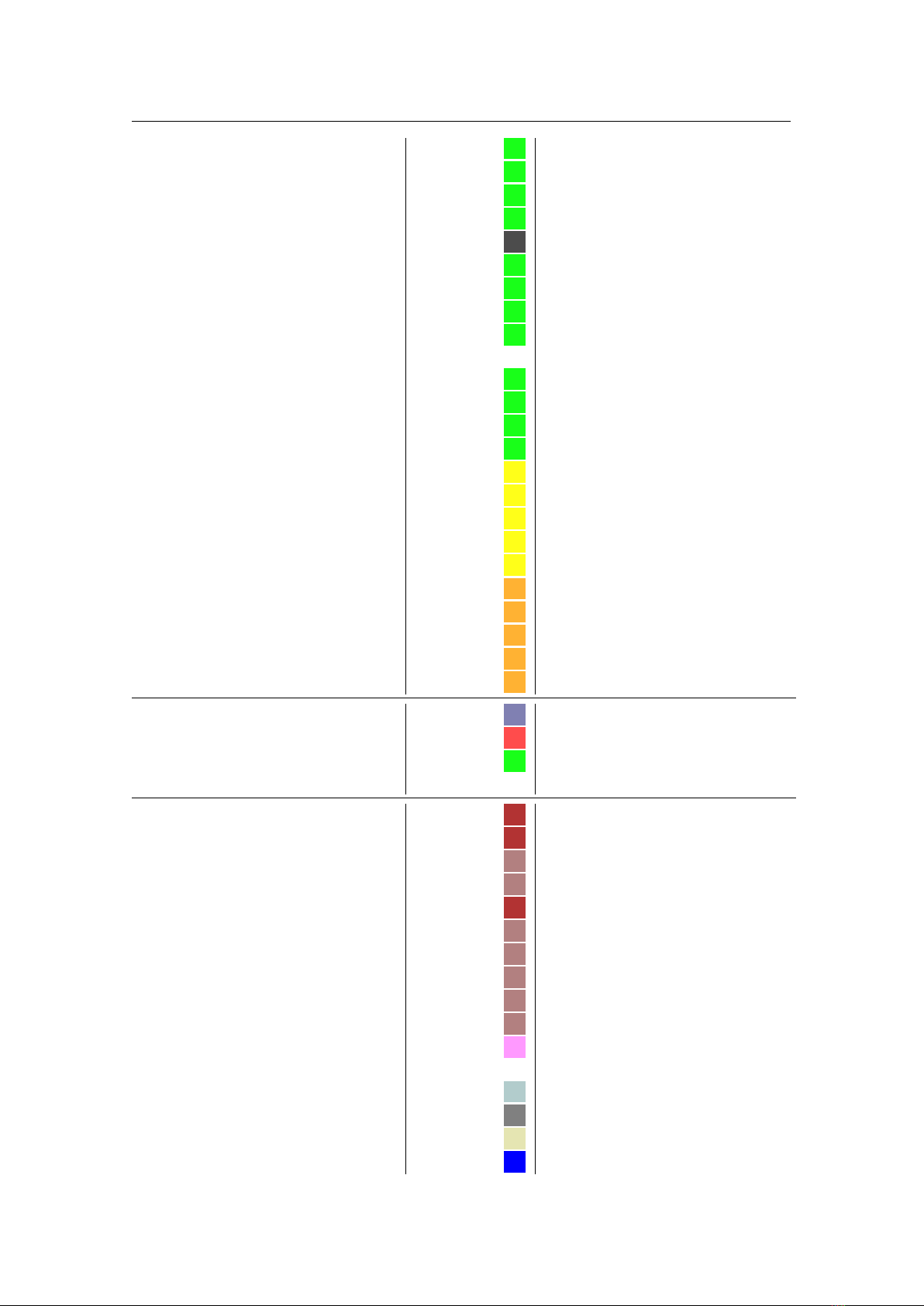
366 Appendix D. Configuration Files
dso_planetary_nebula_color 0.1,1.0,0.1 planetary nebulae symbols.
dso_reflection_nebula_color 0.1,1.0,0.1 reflection nebulae symbols.
dso_bipolar_nebula_color 0.1,1.0,0.1 bipolar nebulae symbols.
dso_emission_nebula_color 0.1,1.0,0.1 emission nebulae symbols.
dso_dark_nebula_color 0.3,0.3,0.3 dark nebulae symbols.
dso_hydrogen_region_color 0.1,1.0,0.1 hydrogen regions symbols.
dso_supernova_remnant_color 0.1,1.0,0.1 supernovae remnants symbols.
dso_supernova_candidate_color 0.1,1.0,0.1 supernova candidates symbols.
dso_supernova_remnant_cand_color 0.1,1.0,0.1
supernova remnant candidates sym-
bols.
dso_interstellar_matter_color 0.1,1.0,0.1 interstellar matter symbols.
dso_molecular_cloud_color 0.1,1.0,0.1 molecular clouds symbols.
dso_possible_planetary_nebula_color 0.1,1.0,0.1
possible planetary nebulae symbols.
dso_protoplanetary_nebula_color 0.1,1.0,0.1 protoplanetary nebulae symbols.
dso_cluster_color 1.0,1.0,0.1 star clusters symbols.
dso_open_cluster_color 1.0,1.0,0.1 open star clusters symbols.
dso_globular_cluster_color 1.0,1.0,0.1 globular star clusters symbols.
dso_stellar_association_color 1.0,1.0,0.1 stellar associations symbols.
dso_star_cloud_color 1.0,1.0,0.1 star clouds symbols.
dso_star_color 1.0,0.7,0.2 star symbols.
dso_symbiotic_star_color 1.0,0.7,0.2 symbiotic star symbols.
dso_emission_star_color 1.0,0.7,0.2 emission-line star symbols.
dso_emission_object_color 1.0,0.7,0.2 emission objects symbols.
dso_young_stellar_object_color 1.0,0.7,0.2 young stellar objects symbols.
planet_names_color 0.5,0.5,0.7 planet names.
planet_pointers_color 1.0,0.3,0.3 planet pointers.
planet_nomenclature_color 0.1,1.0,0.1
planetary nomenclature hints and la-
bels.
sso_orbits_color 0.7,0.2,0.2 default orbits.
major_planet_orbits_color 0.7,0.2,0.2 major planet orbits.
minor_planet_orbits_color 0.7,0.5,0.5 minor planet orbits.
dwarf_planet_orbits_color 0.7,0.5,0.5 dwarf planet orbits.
moon_orbits_color 0.7,0.2,0.2 moon of planet orbits.
cubewano_orbits_color 0.7,0.5,0.5 cubewano orbits.
plutino_orbits_color 0.7,0.5,0.5 plutino orbits.
sdo_orbits_color 0.7,0.5,0.5 scattered disk object orbits.
oco_orbits_color 0.7,0.5,0.5 Oort cloud object orbits.
sednoid_orbits_color 0.7,0.5,0.5 Sednoid object orbits.
interstellar_orbits_color 1.0,0.6,1.0
Interstellar object “orbits” (trajecto-
ries).
comet_orbits_color 0.7,0.8,0.8 comet orbits.
mercury_orbit_color 0.5,0.5,0.5 orbit of Mercury.
venus_orbit_color 0.9,0.9,0.7 orbit of Venus.
earth_orbit_color 0.0,0.0,1.0 orbit of Earth.
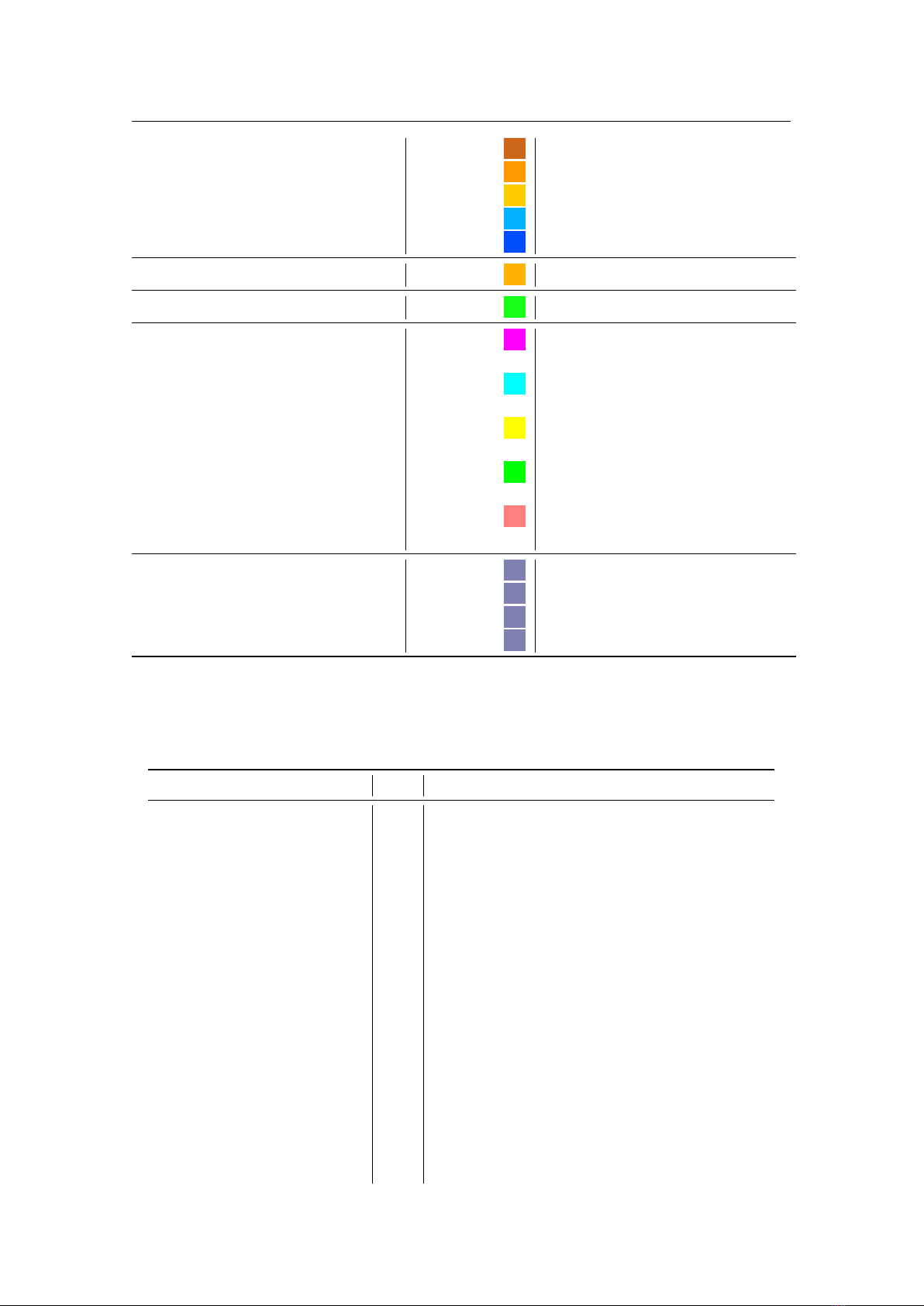
D.1 Program Configuration 367
mars_orbit_color 0.8,0.4,0.1 orbit of Mars.
jupiter_orbit_color 1.0,0.6,0.0 orbit of Jupiter.
saturn_orbit_color 1.0,0.8,0.0 orbit of Saturn.
uranus_orbit_color 0.0,0.7,1.0 orbit of Uranus.
neptune_orbit_color 0.0,0.3,1.0 orbit of Neptune.
object_trails_color 1.0,0.7,0.0 planet trails.
custom_marker_color 0.1,1.0,0.1 custom marker.
script_console_keyword_color 1.0,0.0,1.0
syntax highlight for keywords in the
script console.
script_console_module_color 0.0,1.0,1.0
syntax highlight for modules in the
script console.
script_console_comment_color 1.0,1.0,0.0
syntax highlight for comments in the
script console.
script_console_function_color 0.0,1.0,0.0
syntax highlight for functions in the
script console.
script_console_constant_color 1.0,0.5,0.5
syntax highlight for constants in the
script console.
fov_center_marker_color 0.5,0.5,0.7 FOV Center marker.
fov_circular_marker_color 0.5,0.5,0.7 circular marker of FOV.
fov_rectangular_marker_color 0.5,0.5,0.7 rectangular marker of FOV.
compass_marks_color 0.5,0.5,0.7 compass marks.
D.1.4
custom_selected_info
You can fine-tune the bits of information to display for the selected object in this section. Set the
entry to true to display it.
ID Type Description
flag_show_name bool common name for object.
flag_show_catalognumber bool catalog designations for objects.
flag_show_type bool type of object.
flag_show_magnitude bool magnitude for object.
flag_show_absolutemagnitude bool absolute magnitude for objects.
flag_show_radecj2000 bool equatorial coordinates (J2000.0 frame) of object.
flag_show_radecofdate bool equatorial coordinates (of date) of object.
flag_show_hourangle bool hour angle for object.
flag_show_altaz bool horizontal coordinates for objects.
flag_show_eclcoordj2000 bool ecliptic coordinates (J2000.0 frame) of object.
flag_show_eclcoordofdate bool ecliptic coordinates (of date) of object.
flag_show_galcoord bool galactic coordinates (System II) of object.
flag_show_supergalcoord bool supergalactic coordinates of object.
flag_show_othercoord bool other coordinates of object (from plugins).
flag_show_constellation bool show 3-letter IAU constellation label.
flag_show_sidereal_time bool sidereal time.
flag_show_elongation bool elongation from the Sun for solar system objects.
flag_show_distance bool distance to object.

368 Appendix D. Configuration Files
flag_show_velocity bool velocity of object.
flag_show_propermotion bool proper motion of object.
flag_show_size bool size of object.
flag_show_rts_time bool rise, transit and set times.
flag_show_solar_lunar bool horizontal coordinates for Sun and Moon.
flag_show_extra bool extra info for object.
D.1.5
custom_time_correction
Stellarium allows experiments with ∆T . See 18.4.3 for details.
ID Type Description
coefficients [float,float,float] Coefficients a,b, c for custom equation of ∆T
ndot float n-dot value for custom equation of ∆T
year int Year for custom equation of ∆T
D.1.6
devel
This section is for developers only.
ID Type Description
check_loading_constellation_data bool
Set to true to check loading constellation data. This
option is needed to debug new sky cultures. Default
value: false.
convert_locations_list bool
Set to true to convert file
base_locations.txt
into file
base_locations.bin
2
. Default value:
false.
convert_dso_catalog bool
Set to true to convert file
catalog.txt
into file
catalog.dat. Default value: false.
convert_dso_decimal_coord bool
Set to true to use decimal values for coordinates in
source catalog. Default value: true.
D.1.7
dso_catalog_filters
In this section you can fine-tune which of the deep-sky catalogs should be selected on startup.
ID Type Default Description
flag_show_ngc bool true New General Catalogue (NGC).
flag_show_ic bool true Index Catalogue (IC).
flag_show_m bool true Messier Catalog (M).
flag_show_c bool false Caldwell Catalogue (C).
flag_show_b bool false Barnard Catalogue (B).
flag_show_sh2 bool false Sharpless Catalogue (SH2).
flag_show_vdb bool false Van den Bergh Catalogue of reflection nebulae (vdB).
flag_show_rcw bool false
The RCW catalogue of H
α
-emission regions in the southern
Milky Way (RCW).
flag_show_lbn bool false Lynds’ Catalogue of Bright Nebulae (LBN).
flag_show_ldn bool false Lynds’ Catalogue of Dark Nebulae (LDN).
2
To get the standard packed
base_locations.bin.gz
file please run the command
gzip -nc base_locations.bin > base_locations.bin.gz.
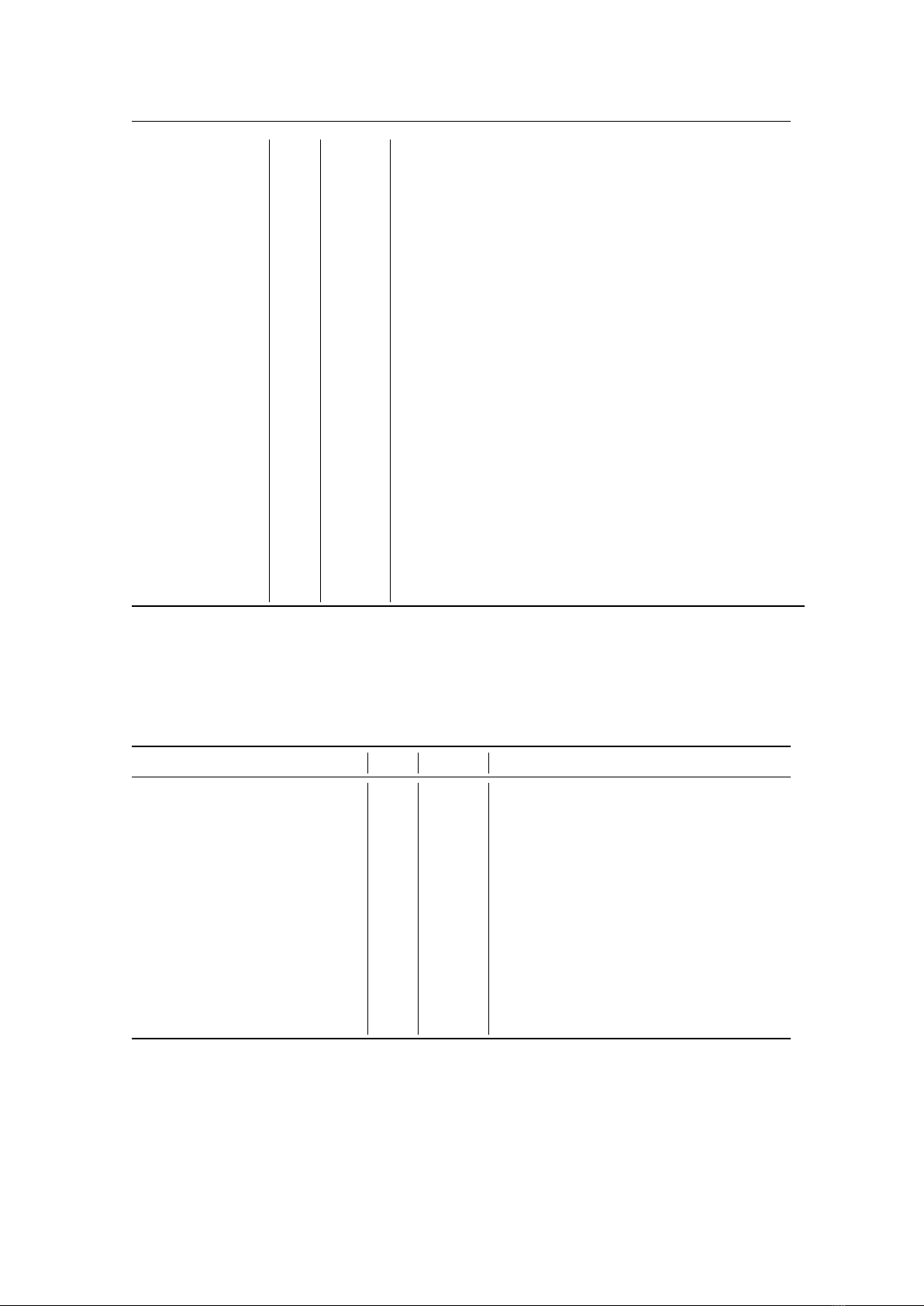
D.1 Program Configuration 369
flag_show_cr bool false Collinder Catalogue (Cr or Collinder).
flag_show_mel bool false Melotte Catalogue of Deep Sky Objects (Mel or Melotte).
flag_show_pgc bool false HYPERLEDA. I. Catalog of galaxies (PGC).
flag_show_ced bool false
Cederblad Catalog of bright diffuse Galactic nebulae (Ced).
flag_show_ugc bool false The Uppsala General Catalogue of Galaxies (UGC).
flag_show_arp bool false Atlas of Peculiar Galaxies (Arp).
flag_show_vv bool false The Catalogue of Interacting Galaxies (VV).
flag_show_pk bool false The Catalogue of Galactic Planetary Nebulae (PK).
flag_show_png bool false
The Strasbourg-ESO Catalogue of Galactic Planetary Neb-
ulae (PN G).
flag_show_snrg bool false A catalogue of Galactic supernova remnants (SNR G).
flag_show_aco bool false A Catalog of Rich Clusters of Galaxies (Abell or ACO).
flag_show_hcg bool false A Hickson Compact Group (HCG).
flag_show_eso bool false ESO/Uppsala Survey of the ESO(B) Atlas (ESO).
flag_show_vdbh bool false
Catalogue of southern stars embedded in nebulosity (vdBH).
flag_show_dwb bool false
Catalogue and distances of optically visible H II regions
(DWB).
flag_show_tr bool false Trumpler Catalogue (Tr or Trumpler).
flag_show_st bool false Stock Catalogue (St or Stock).
flag_show_ru bool false Ruprecht Catalogue (Ru or Ruprecht).
flag_show_vdbha bool false van den Bergh-Hagen Catalogue (vdB-Ha).
flag_show_other bool true All objects without identifiers.
D.1.8
dso_type_filters
In this section you can fine-tune which types of the deep-sky objects should be selected on startup.
ID Type Default Description
flag_show_galaxies bool true display galaxies.
flag_show_active_galaxies bool true display active galaxies.
flag_show_interacting_galaxies bool true display interacting galaxies.
flag_show_open_clusters bool true display open star clusters.
flag_show_globular_clusters bool true display globular star clusters.
flag_show_bright_nebulae bool true display bright nebulae.
flag_show_dark_nebulae bool true display dark nebulae.
flag_show_planetary_nebulae bool true display planetary nebulae.
flag_show_hydrogen_regions bool true display hydrogen regions.
flag_show_supernova_remnants bool true display supernovae remnants.
flag_show_galaxy_clusters bool true display clusters of galaxies.
flag_show_other bool true display other deep-sky objects.
D.1.9
fov
In this section you can fine-tune 10 predefined values of field of view in degrees (all FOV may be
set through keyboard hotkeys, see section 3.2).

370 Appendix D. Configuration Files
ID Type Default Description
quick_fov_1 float 180 predefined value for FOV 1.
quick_fov_2 float 90 predefined value for FOV 2.
quick_fov_3 float 60 predefined value for FOV 3.
quick_fov_4 float 45 predefined value for FOV 4.
quick_fov_5 float 20 predefined value for FOV 5.
quick_fov_6 float 10 predefined value for FOV 6.
quick_fov_7 float 5 predefined value for FOV 7.
quick_fov_8 float 2 predefined value for FOV 8.
quick_fov_9 float 1 predefined value for FOV 9.
quick_fov_0 float 0.5 predefined value for FOV 0.
D.1.10
gui
This section includes settings for the graphical user interface. See sections 4.3.3–4.3.5 for most of
these keys.
ID Type Default Description
flag_show_gui bool true If true, display GUI.
screen_font_size int 13
Sets the font size for screen texts.
Typical value: 13..15
gui_font_size int 13
Sets the dialog font size. Typical
value: 10..20
base_font_name string Verdana Selects the name
(Windows) for base font
DejaVu Sans
(others)
base_font_file string
Selects the name for font file, e.g.
DejaVuSans.ttf
flag_font_selection bool false
Show GUI elements for font selec-
tion.
immediate_save_details bool false
Set to true to store some detail set-
tings in the configuration dialog im-
mediately, instead of having to press
“Save settings” explicitly.
flag_mouse_cursor_timeout bool true
Set to false if you want to have cur-
sor visible at all times.
mouse_cursor_timeout float 10
Set to 0 if you want to keep the
mouse cursor visible at all times.
non-0 values mean the cursor will
be hidden after that many seconds of
inactivity
flag_show_boundaries_button bool false
Show a button to toggle constella-
tion boundaries
flag_show_asterism_lines_button
bool false
Show a button to toggle asterism
lines
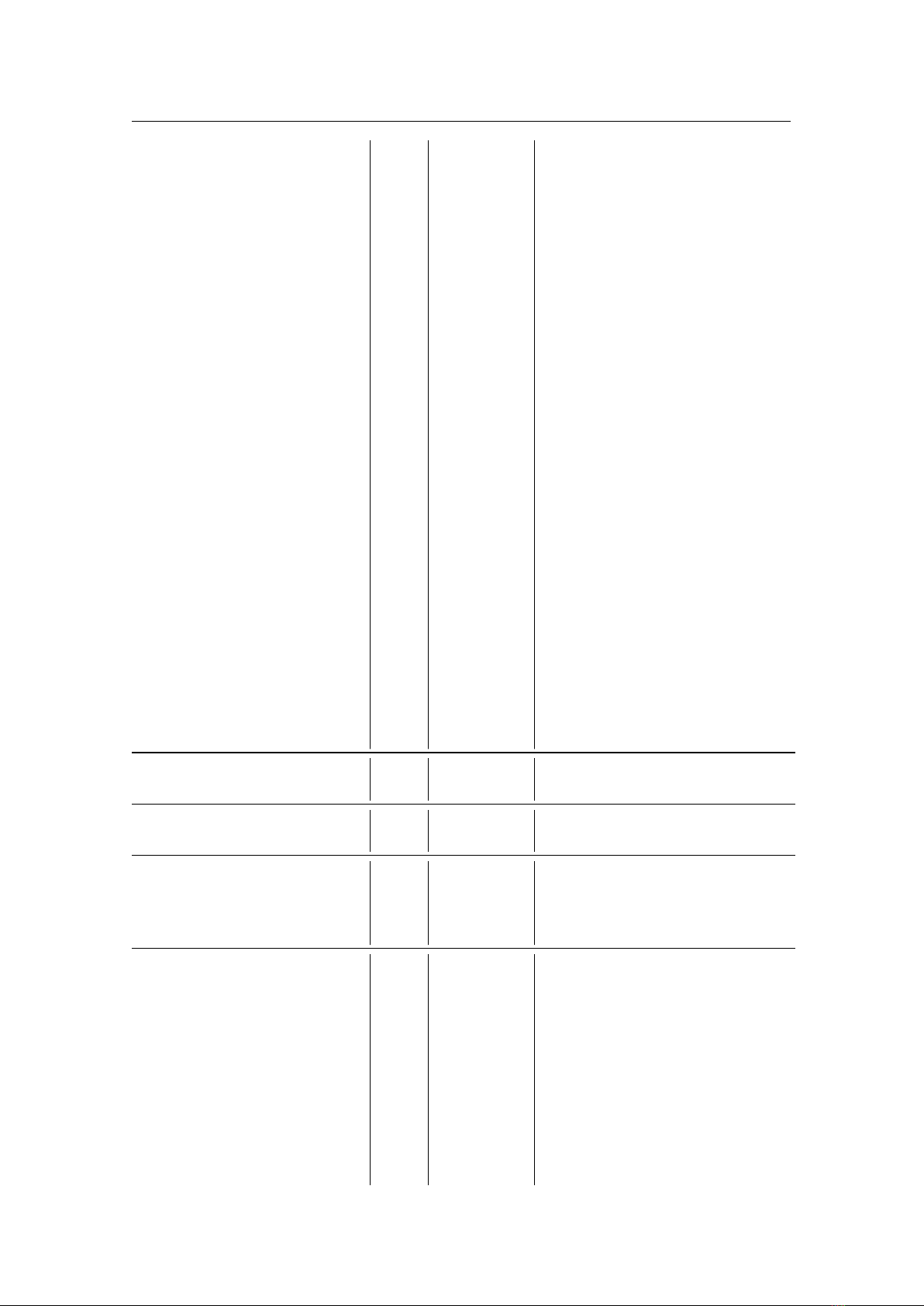
D.1 Program Configuration 371
flag_show_asterism_labels_button
bool false
Show a button to toggle asterism la-
bels
flag_show_ecliptic_grid_button bool false
Show a button to toggle ecliptic grid
flag_show_icrs_grid_button bool false
Show a button to toggle ICRS (equa-
torial J2000.0) grid
flag_show_galactic_grid_button bool false
Show a button to toggle galactic grid
flag_show_goto_selected_button
bool true
Show a button to center to selected
object
flag_show_nightmode_button bool true Show a button to toggle night mode
flag_show_nebulae_
background_button
bool false
Show a button to toggle images for
deep-sky objects
flag_show_flip_buttons bool false
Show the image flipping buttons in
the main toolbar
flag_show_dss_button bool false
Show a button to toggle Digitized
Sky Survey (DSS)
flag_show_hips_button bool false
Show a button to toggle HiPS survey
display
flag_show_bookmark_button bool false
Show a button to show and edit book-
marks
flag_show_fullscreen_button bool true
Show a button to toggle fullscreen
view
flag_show_quit_button bool true
Show a button to quit via button
press
flag_show_cardinal_button bool true
Show a button to toggle cardinals via
button press
flag_show_compass_button bool false
Show a button to toggle compass
marks via button press
flag_show_buttons_background bool true
If true, use background under but-
tons on bottom bar.
flag_overwrite_info_color bool false
Set true to use one color for test in
info panel for all objects.
selected_object_info string all
Values: default, all, short, none, and
custom (see 4.3.2).
custom_marker_size float 5.0 Size of custom marker.
custom_marker_radius_limit int 15
Limit the click radius for mouse cur-
sor position in any direction for re-
moving of closest custom marker.
auto_hide_horizontal_toolbar bool true
Set to true if you want auto hide the
horizontal toolbar.
auto_hide_vertical_toolbar bool true
Set to true if you want auto hide the
vertical toolbar.
flag_use_window_transparency bool false If false, show menu bars opaque
flag_show_datetime bool true
display date and time in the bottom
bar
flag_time_jd bool false
use JD format for time in the bottom
bar
flag_show_tz bool false
show time zone info in the bottom
bar

372 Appendix D. Configuration Files
flag_show_location bool true display location in the bottom bar
flag_show_fps bool true
show at how many frames per sec-
ond Stellarium is rendering
flag_show_fov bool true
show how many degrees your verti-
cal field of view is
flag_fov_dms bool false
use DMS format for FOV in the bot-
tom bar
flag_show_decimal_degrees bool false
If true, use decimal degrees for co-
ordinates
flag_use_azimuth_from_south bool false
If true, calculate azimuth from south
towards west (as in some astronomi-
cal literature)
flag_surface_brightness_arcsec bool false
Toggle usage the measure unit
mag
/
0
(
mag
/arcmin
2
) or
mag
/
00
(
mag
/arcsec
2
) for the surface bright-
ness of deep-sky objects.
flag_surface_brightness_short bool false
Toggle usage the short notation for
the surface brightness of deep-sky
objects.
flag_enable_kinetic_scrolling bool true
If true, use kinetic scrolling in the
GUI
3
.
pointer_animation_speed float 1.0 Animation speed of pointers.
gpsd_hostname string localhost
hostname of server running gpsd
(non-Windows only)
gpsd_port int 2947
port number of gpsd (non-Windows
only)
gps_interface string COM3
Port number of serial/USB GPS de-
vice. (May look like
ttyUSB0
on
Linux, if you really don’t run gpsd.)
gps_baudrate int 4800
baudrate of serial/USB GPS device
(for direct serial connection only)
D.1.11
init_location
ID Type Description
landscape_name string
Sets the landscape you see. Built-in options are garching, geneva,
grossmugl, guereins, hurricane, jupiter, mars, moon, neptune, ocean,
saturn, trees, uranus, zero.
location string Name of location on which to start stellarium.
last_location string Coordinates of last used location in stellarium.
D.1.12
landscape
3
Scroll by dragging in the window directly, not a slider handle. Scrolling stops after a short time.

D.1 Program Configuration 373
ID Type Description
atmosphere_fade_duration float
Sets the time (seconds) it takes for the atmo-
sphere to fade when de-selected
flag_landscape bool
Set false if you don’t want to see the land-
scape at start-up
flag_fog bool
Set false if you don’t want to see fog on start-
up
flag_atmosphere bool
Set false if you don’t want to see atmosphere
on start-up
flag_landscape_sets_location bool
Set true if you want Stellarium to modify the
observer location when a new landscape is
selected (changes planet and longitude/lati-
tude/altitude if location data is available in
the landscape.ini file)
minimal_brightness float
Set minimal brightness for landscapes.
[0. . . 1] Typical value: 0.01
atmosphereybin int
Atmosphere tessellation coefficient for Y
axis. Default=44.
flag_minimal_brightness bool
Set true to use minimal brightness for land-
scape.
flag_landscape_sets_minimal_brightness bool
Set true to use value for minimal brightness
for landscape from landscape settings.
flag_enable_illumination_layer bool
Set true to use illumination layer for land-
scape.
flag_enable_labels bool
Set true to use landscape labels from
gazetteer layer.
flag_transparency bool Set true to show landscape semitransparent.
transparency float
Use this transparency for landscapes. [0. . . 1]
Typical value: 0.5
atmospheric_extinction_coefficient float
Set atmospheric extinction coefficient
k
[mag/airmass]
temperature_C float Set atmospheric temperature [Celsius]
pressure_mbar float Set atmospheric pressure [mbar]
cache_size_mb int
Set the cache size for landscapes [megabytes].
Default: 100

374 Appendix D. Configuration Files
D.1.13
localization
ID Type Description
sky_culture string
Sets the sky culture to use. E.g. western, polynesian, egyptian,
chinese, lakota, navajo, inuit, korean, norse, tupi, maori, aztec,
sami.
sky_locale string
Sets language used for names of objects in the sky (e.g. planets).
The value is a short locale code, e.g. en, de, en_GB
app_locale string
Sets language used for Stellarium’s user interface. The value is
a short locale code, e.g. en, de, en_GB.
time_zone string
Sets the time zone. Valid values: system_default, or some
region/location combination, e.g. Pacific/Marquesas
flag_dst bool
Set true to apply daylight saving time as required by time zone.
time_display_format string time display format: can be system_default, 24h or 12h.
date_display_format string
date display format: can be system_default, mmddyyyy, ddm-
myyyy, yyyymmdd (ISO8601), wwmmddyyyy, wwddmmyyyy,
wwyyyymmdd.
D.1.14
main
ID Type Description
invert_screenshots_colors bool
If true, Stellarium will save the screenshots with
inverted colors.
screenshot_dir string Path for saving screenshots
screenshot_format string
File format. One of
png|jpg|jpeg|tif|tiff|
webp|pbm|pgm|ppm|xbm|xpm|ico
screenshot_custom_size bool
true if you want to specify particular dimensions
next:
screenshot_custom_width int
custom width of screenshots. Max. available size
is hardware dependent!
screenshot_custom_height int
custom height of screenshots. Max. available size
is hardware dependent!
screenshot_dpi int DPI setting for screenshots.
observinglists_dir string
Default path for saving and loading observing lists.
Defaults to the user’s home dir.
version string
Version of Stellarium. This parameter may be used
to detect necessary changes in config.ini file, do
not edit.
use_separate_output_file bool
Set to true if you want to create a new file for script
output for each start of Stellarium
restore_defaults bool
If true, Stellarium will restore default settings at
startup. This is equivalent to calling Stellarium
with the –restore-defaults option.
ignore_opengl_warning bool Set to true if you don’t want to see OpenGL warn-
ings for each start of Stellarium.

D.1 Program Configuration 375
check_requirements bool
Set to false if you want to disable and perma-
nently ignore checking hardware requirements at
startup. Expect problems if hardware is below re-
quirements!
geoip_api_url string URL for JSON interface of GeoIP service.
D.1.15
navigation
This section controls much of the look&feel of Stellarium. Be careful if you change something
here.
ID Type Description
preset_sky_time float
Preset sky time used by the dome version. Unit is
Julian Day. Typical value: 2451514.250011573
startup_time_mode string
Set the start-up time mode, can be actual (start
with current real world time), or Preset (start at
time defined by preset_sky_time)
flag_enable_zoom_keys bool Set to false if you want to disable the zoom
flag_manual_zoom bool
Set to false for normal zoom behaviour as described
in this guide. When set to true, the auto zoom
feature only moves in a small amount and must be
pressed many times
flag_enable_move_keys bool Set to false if you want to disable the arrow keys
flag_enable_mouse_navigation bool
Set to false if you want to disable the mouse pan
(drag).
flag_enable_mouse_zooming bool
Set to false if you want to disable the mouse zoom-
ing (mousewheel).
init_fov float
Initial field of view, in degrees. Typical value:
”60”.
min_fov float
Minimal field of view, in degrees. Typical value:
”0.001389” (5").
max_fov float
Maximal field of view, in degrees. Typical value:
”360.0”.
init_view_pos floats
Initial viewing direction. This is a vector with x,y,z-
coordinates. x being N-S (S +ve), y being E-W (E
+ve), z being up-down (up +ve). Thus to look South
at the horizon use 1,0,0. To look Northwest and up
at 45
◦
, use -1,-1,1 and so on.
auto_move_duration
float
Duration (seconds) for the program to move to
point at an object when the space bar is pressed.
Typical value: 1.4
mouse_zoom float Sets the mouse zoom amount (mouse-wheel)
move_speed float Sets the speed of movement
zoom_speed float Sets the zoom speed
viewing_mode string
If set to horizon, the viewing mode simulate an
alt/azi mount, if set to equator, the viewing mode
simulates an equatorial mount
auto_zoom_out_resets_direction bool
Set to true if you want to auto-zoom restoring di-
rection.
time_correction_algorithm string Algorithm of DeltaT correction.

376 Appendix D. Configuration Files
D.1.16
plugins_load_at_startup
This section lists which plugins are loaded at startup (those with true values). Each plugin can
add another section into this file with its own content, which is described in the respective plugin
documentation, see 12. You activate loading of plugins in the
F2
settings dialog, tab “Plugins”.
After selection of which plugins to load, you must restart Stellarium.
ID Type Description
AngleMeasure bool 13.1 Angle Measure plugin
ArchaeoLines bool 14.10 ArchaeoLines plugin
Calendars bool 13.9 Calendars plugin
EquationOfTime bool 13.2 Equation of Time plugin
Exoplanets bool 14.3 Exoplanets plugin
MeteorShowers bool 14.6 Meteor Showers plugin
Novae bool 14.1 Bright Novae plugin
Observability bool 16.3 Observability Analysis
Oculars bool 16.1 Oculars plugin
Pulsars bool 14.4 Pulsars plugin
Quasars bool 14.5 Quasars plugin
RemoteControl bool 13.5 Remote Control plugin
RemoteSync bool 13.6 Remote Sync plugin
Satellites bool 14.8 Satellites plugin
Scenery3d bool 15 Scenery 3D plugin
SolarSystemEditor bool 13.8 Solar System Editor plugin
Supernovae bool 14.2 Historical Supernovae plugin
TelescopeControl bool 16.2 Telescope Control plugin
TextUserInterface bool 13.4 Text User Interface plugin
D.1.17
projection
This section contains the projection of your choice and several advanced settings important if you
run Stellarium on a single screen, multi-projection, dome projection, or other setups.
ID Type Description
type string
Sets projection mode. Values: ProjectionPerspective,
ProjectionEqualArea, ProjectionStereographic, Pro-
jectionFisheye, ProjectionHammer, ProjectionCylin-
der, ProjectionCylinderFill, ProjectionMercator, Pro-
jectionOrthographic, ProjectionMiller, or Projection-
Sinusoidal.
flip_horz bool
flip_vert bool
viewport string
How the view-port looks. Values: none (regular rect-
angular screen), disk (circular screen, useful for plan-
etarium setup).
viewportMask string How the view-port looks. Values: none.
viewport_fov_diameter float
viewport_x float Usually 0.
viewport_y float Usually 0.
viewport_width float

D.1 Program Configuration 377
viewport_height float
viewport_center_x float Usually half of viewport_width.
viewport_center_y float Usually half of viewport_height.
viewport_center_offset_x float [-0.5. . . +0.5] Usually 0.
viewport_center_offset_y float
[-0.5. . . +0.5] Use negative values to move the hori-
zon lower.
D.1.18
proxy
This section has setting for connection to network through proxy server (proxy will be using when
host of proxy is filled).
ID Type Description
host_name string Name of host for proxy. E.g. proxy.org
type string Type of proxy. E.g. socks
port int Port of proxy. E.g. 8080
user string Username for proxy. E.g. michael_knight
password string Password for proxy. E.g. xxxxx
D.1.19
scripts
ID Type Default Description
startup_script string startup.ssc
name of script executed on program
start
flag_allow_screenshots_dir bool false Allow scripts to set a target directory.
flag_allow_write_absolute_path bool false
set true to let scripts store output files
to absolute pathnames. This may pose
a security risk if you run scripts from
other authors without checking what
they are doing.
D.1.20
search
ID Type Description
flag_search_online bool If true, Stellarium will be use SIMBAD for search.
simbad_server_url string URL for SIMBAD mirror
flag_start_words bool
If false, Stellarium will be search phrase only from start of words
coordinate_system string
Specifies the coordinate system. Possible values: equatorialJ2000,
equatorial, horizontal, galactic. Default value: equatorialJ2000.
D.1.21
spheric_mirror
Stellarium can be used in planetarium domes. You can use a projector with a hemispheric mirror
with geometric properties given in this section. Note: These functions are only rarely used or tested,
some may not work as expected.
ID Type Default Description
flip_horz bool true Flip the projection horizontally
flip_vert bool false Flip the projection vertically

378 Appendix D. Configuration Files
projector_alpha float 0
This parameter controls the properties of the
spheric mirror projection mode.
projector_gamma float
This parameter controls the properties of the
spheric mirror projection mode.
projector_delta float -1e100
This parameter controls the properties of the
spheric mirror projection mode.
projector_phi float 0
This parameter controls the properties of the
spheric mirror projection mode.
projector_position_x float 0
projector_position_y float 1
projector_position_z float -0.2
mirror_position_x float 0
mirror_position_y float 2
mirror_position_z float 0
image_distance_div_height float -1e100
mirror_radius float 0.25
dome_radius float 2.5
custom_distortion_file string
texture_triangle_base_length float
zenith_y float 0.125 deprecated
scaling_factor float 0.8 deprecated
distorter_max_fov float 175.0
Set the maximum field of view for the spheric
mirror distorter in degrees. Typical value:
180
viewportCenterWidth float projected image width, pixels
viewportCenterHeight float projected image height, pixels
viewportCenterX float projected image center X, pixels
viewportCenterY float projected image center Y, pixels
D.1.22
stars
This section controls how stars are rendered.
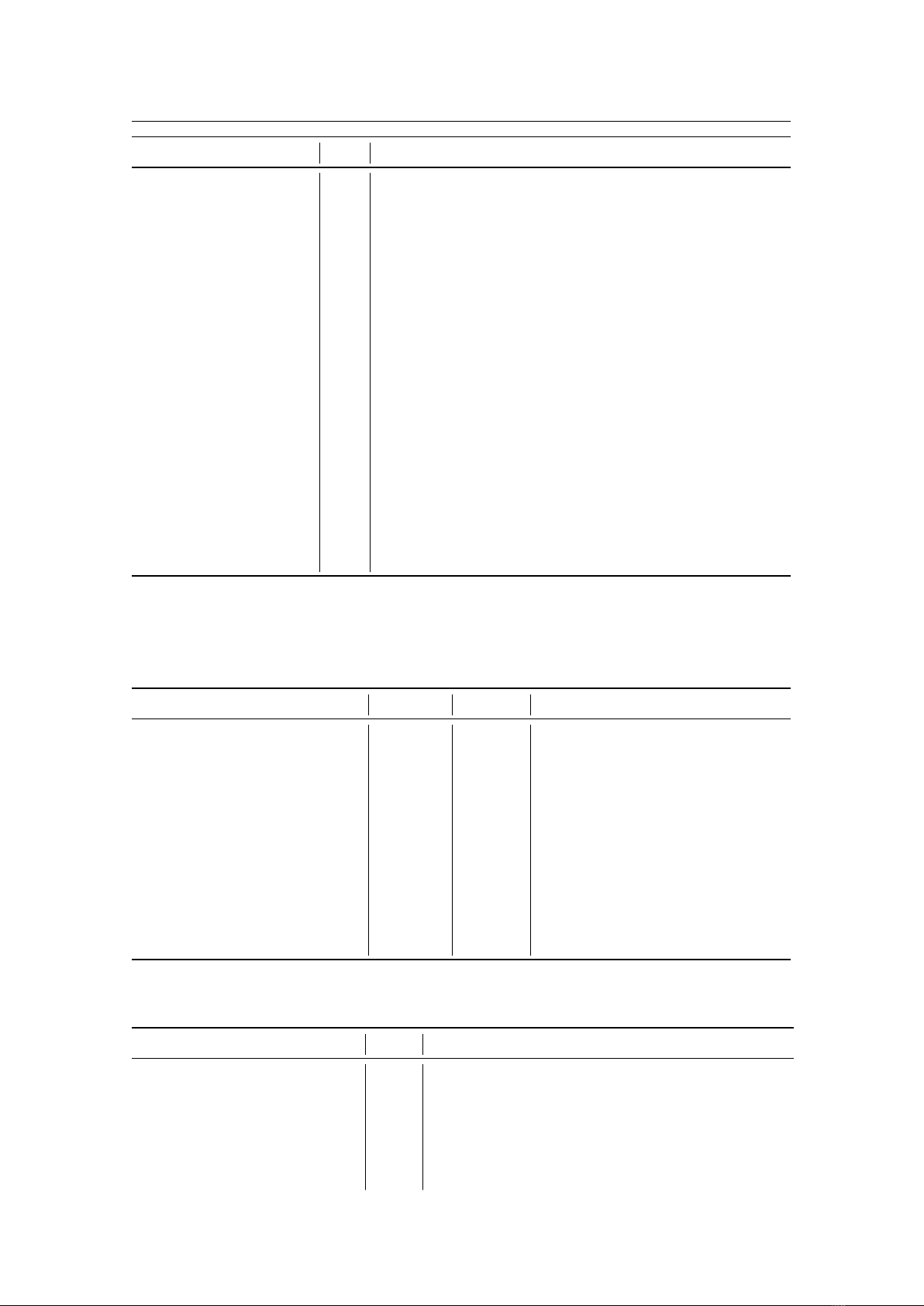
D.1 Program Configuration 379
ID Type Description
relative_scale float
relative size of bright and faint stars. Higher values mean that
bright stars are comparatively larger when rendered. Typical
value: 1.0
absolute_scale float
Changes how large stars are rendered. larger value lead to
larger depiction. Typical value: 1.0
star_twinkle_amount float amount of twinkling. Typical value: 0.3
flag_star_twinkle bool
true to allow twinkling (but only when atmosphere is active!).
flag_forced_twinkle bool
true to allow twinkling stars even without atmosphere. This
is obvious nonsense and contrary to nature, but some users
seem to like it.
flag_star_halo bool
false to not draw a halo around the brightest stars. This looks
poor, but some users seem to prefer it.
mag_converter_max_fov float
maximum field of view for which the magnitude conversion
routine is used. Typical value: 90.0.
mag_converter_min_fov float
minimum field of view for which the magnitude conversion
routine is used. Typical value: 0.001.
labels_amount float amount of labels. Typical value: 3.0
init_bortle_scale int
initial value of light pollution on the Bortle scale. Typical
value: 3.
D.1.23
tui
The built-in text user interface (TUI) plugin (see chapter 13.4) is most useful for planetariums. You
can even configure a system shutdown command. For historical reasons, the section is not called
[TextUserInterface] but simply [tui].
ID Type Default Description
tui_font_size float 15 Font size for TUI.
tui_font_color floatRGB 0.3,1,0.3 Font color for TUI.
flag_show_gravity_ui bool false
Set to true to enable gravity mode
for UI (for dome projection)
flag_show_tui_datetime bool false
Set to true if you want to see a date
and time label suited for dome pro-
jections
flag_show_tui_short_obj_info bool false
Set to true if you want to see object
info suited for dome projections
tui_admin_shutdown_command string
e.g. for Linux:
shutdown
–poweroff +2
D.1.24
video
ID Type Description
fullscreen bool
If true, Stellarium will start up in full-screen mode,
else windowed mode
screen_w int
Display width when in windowed mode. Value in
pixels, e.g. 1024
screen_h int
Display height when in windowed mode. Value in
pixels, e.g. 768
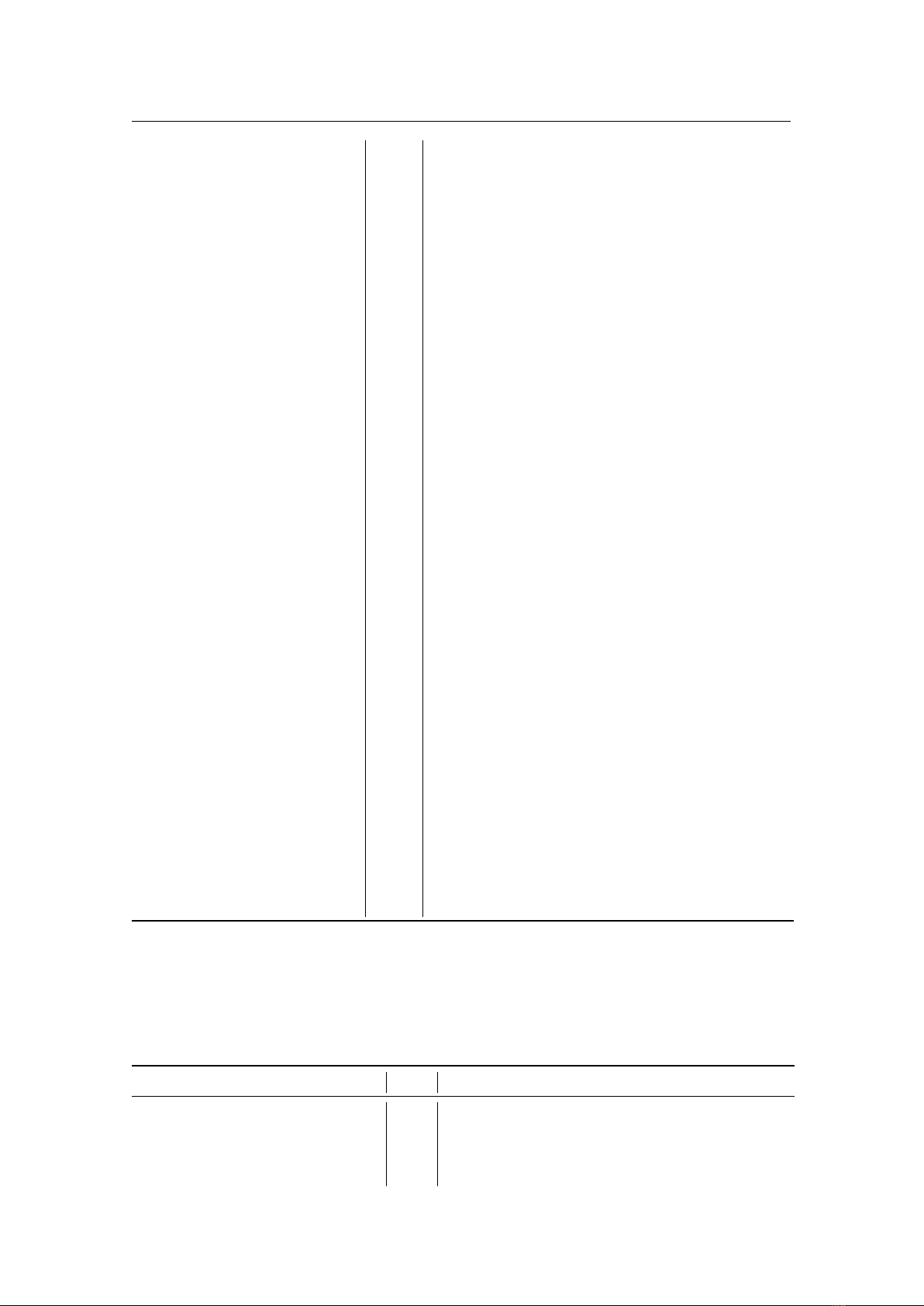
380 Appendix D. Configuration Files
screen_x int
Horizontal position of the top-left corner in win-
dowed mode. Value in pixels, e.g. 0
screen_y int
Vertical position of the top-left corner in windowed
mode. Value in pixels, e.g. 0
viewport_effect string
This is used when the spheric mirror display mode is
activated. Values include none and sphericMirrorDis-
torter.
minimum_fps int
Sets the minimum number of frames per second to
display at (hardware performance permitting)
maximum_fps int
Sets the maximum number of frames per second to
display at. This is useful to reduce power consump-
tion in laptops.
min_time_bewteen_frames int
Sets the minimum time (in milliseconds) between
the end of rendering and the start of the next frame.
Only takes effect on Macs. Used to work around
https://github.com/Stellarium/stellarium
/issues/2778.
multisampling int
Sets the number of samples to use for multisampling
antialiasing. 0 disables antialiasing, 1 is no-op (single
sample per pixel), higher values increase smoothness
and degrade performance. Too high a value may
result in excessive blurriness of the GUI. A good
starting value to try is 4.
planet_shadows_supersampling bool
Improves quality of shadows on the Moon by evalu-
ating the color for each multisampling sample, rather
than once per pixel. Level of improvement (and per-
formance cost) depends on multisampling setting.
Default is false, i.e. disabled.
anisotropic_filtering int
Improves quality of rendering of inclined textured
surfaces like e.g. planetary surface near the limb.
Modern (and even quite old, like from 2010) GPUs
can handle high anisotropy with no noticeable per-
formance drop, so it should be fine to set this value
as high as 16. If this setting value is higher than the
GPU is capable of, the maximum value supported
is used. The default is 16. To disable anisotropic
filtering, set this value to 0.
D.1.25
viewing
This section defines which objects, labels, lines, grids etc. you want to see on startup. Set those to
true. Most items can be toggled with hotkeys or switched in the GUI. Entries ending with
_line
or
..._lines
usually also have entries
..._parts
and
..._labels
which govern partitions and
labels, respectively.
ID Type Description
flag_asterism_drawing bool Display asterism line drawing
flag_asterism_name bool Display asterism names
flag_rayhelper_drawing bool Display the ray helper line drawing
flag_constellation_drawing bool Display constellation line drawing
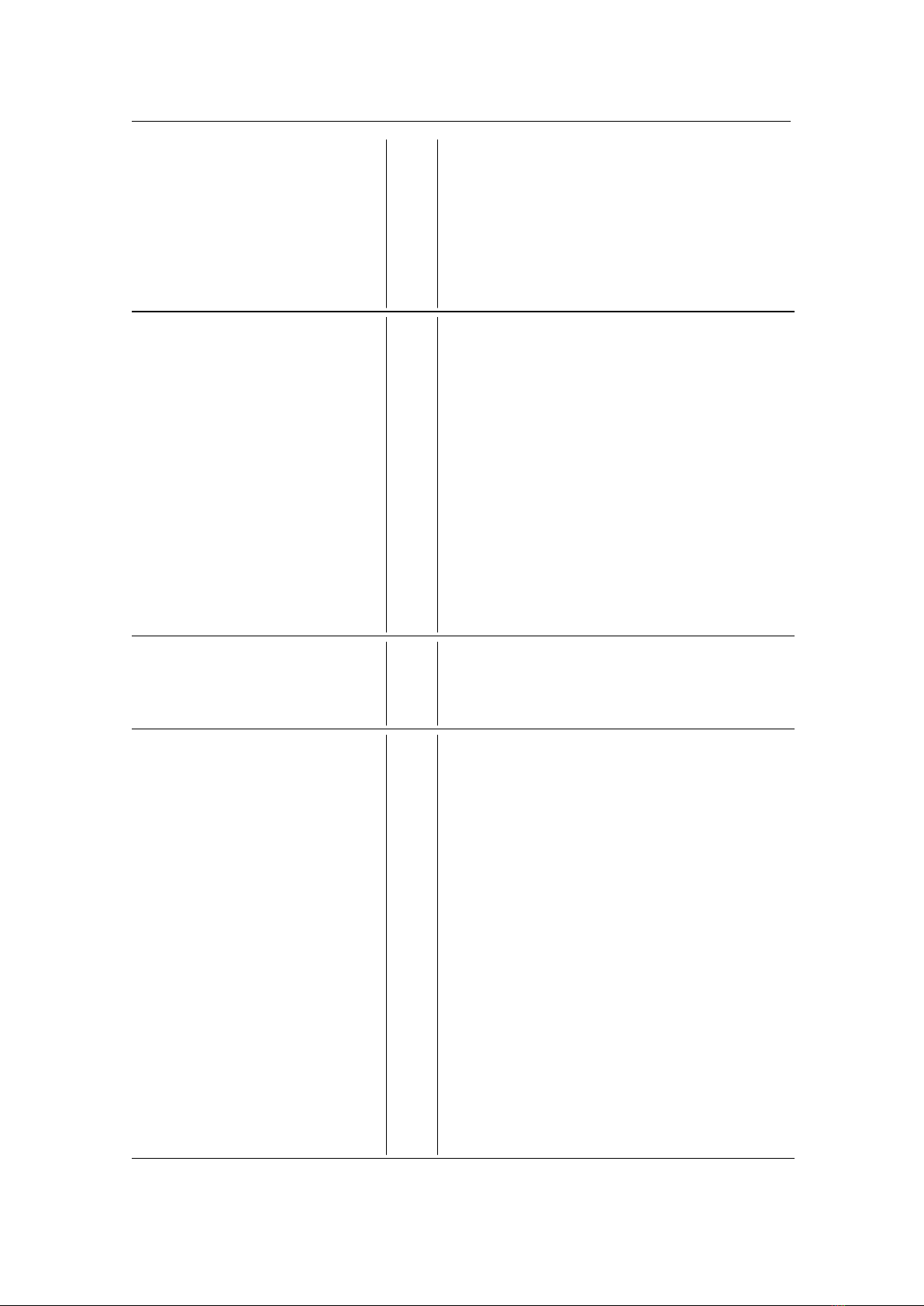
D.1 Program Configuration 381
flag_constellation_name bool Display constellation names
flag_constellation_art bool Display constellation art
flag_constellation_boundaries bool Display constellation boundaries
flag_constellation_isolate_selected bool
If true, constellation lines, boundaries and art will
be limited to the constellation of the selected star,
if that star is “on” one of the constellation lines.
flag_constellation_pick bool
Set to true if you only want to see the line drawing,
art and name of the selected constellation star
flag_isolated_trails bool
Set to true if you only want to see the trail line
drawn for the selected planet (asteroid, comet,
moon)
number_isolated_trails int
Number of isolated trails for latest selected Solar
system bodies [1..5].
max_trail_points int
Limit maximum length of trails. Trails are drawn
for 1 year or this number of computing steps. De-
fault 5000, reduce if drawing trails slows down the
program too much.
flag_planets_orbits_only bool
Set to true if you want to suppress orbits of minor
bodies and moons.
flag_isolated_orbits bool
Set to true if you want to see orbits only for selected
planet.
flag_orbits_with_moons bool
Set to true if you want to see also orbits of the
selected planet.
line_thickness int
Set the line thickness for grids and lines. Typical
value: 1
part_thickness int
Set the line thickness for line partitions. Typical
value: 1
flag_azimutal_grid bool Display azimuthal grid
flag_equatorial_grid bool Display equatorial grid (of date)
flag_equatorial_J2000_grid bool Display equatorial grid (J2000)
flag_ecliptic_grid bool Display ecliptic grid (of date)
flag_ecliptic_J2000_grid bool Display ecliptic grid (J2000)
flag_galactic_grid bool Display galactic grid (System II)
flag_galactic_equator_line bool Display galactic equator line
flag_supergalactic_grid bool Display supergalactic grid
flag_supergalactic_equator_line bool Display supergalactic equator line
flag_equator_line bool Display celestial equator line (of date)
flag_fixed_equatorial_grid bool Display fixed equatorial (hour angle) grid
flag_fixed_equator_line bool Display fixed equator (hour angle) line
flag_equator_J2000_line bool Display celestial equator line (J2000)
flag_ecliptic_line bool Display ecliptic line (of date)
flag_ecliptic_J2000_line bool Display ecliptic line (J2000)
flag_longitude_line bool Display opposition/conjunction circle
flag_quadrature_line bool Display quadrature circle
flag_meridian_line bool Display meridian line
flag_prime_vertical_line bool Display Prime Vertical line (East-Zenith-West)
flag_colure_lines bool Display colure lines (Celestial Pole-à/ã/æ/é)
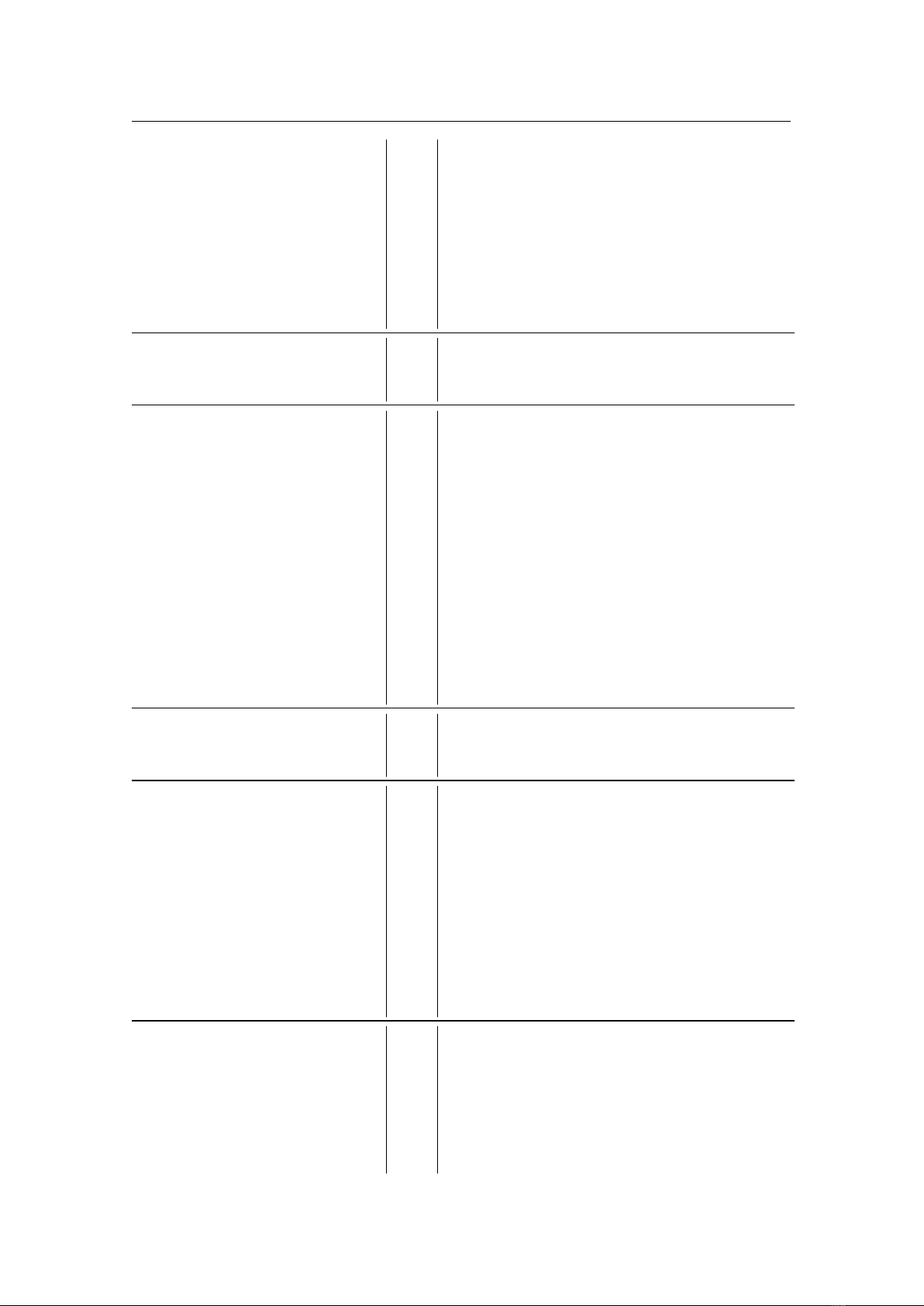
382 Appendix D. Configuration Files
flag_cardinal_points bool Display cardinal points
flag_ordinal_points bool Display intercardinal (or ordinal) points
flag_16wcr_points bool Display secondary intercardinal points
flag_32wcr_points bool Display tertiary intercardinal points
cardinal_font_size int Font size for cardinal points. Typical value: 24
ordinal_font_size int
Font size for intercardinal (or ordinal) points. Typi-
cal value: 18
16wcr_font_size int
Font size for secondary intercardinal points. Typi-
cal value: 16
flag_gravity_labels bool
Set to true if you want labels to undergo gravity
(top side of text points toward zenith). Useful with
dome projection.
flag_moon_scaled bool Keep it false if you want to see the real moon size
moon_scale float
Sets the moon scale factor, sometimes useful to cor-
relate to our perception of the moon’s size. Typical
value: 4
flag_planets_scaled bool
Keep it false if you want to see the real planet size
planets_scale float
Sets the planet scale factor, sometimes useful to
show planets symbolically. Typical value: 150
flag_sun_scaled bool Keep it false if you want to see the real sun size
sun_scale float
Sets the sun scale factor, sometimes useful to cor-
relate to our perception of the sun’s size. Typical
value: 4
flag_minorbodies_scaled bool
Set to true if you want to see minor bodies enlarged
minorbodies_scale float
Set scale factor for minor bodies, to see them in
unnatural detail. Typical value: 10
flag_draw_moon_halo bool Display halo around the Moon
flag_draw_sun_halo bool Display Sun’s glare
flag_draw_sun_corona bool
Display Sun’s corona when atmosphere is disabled
flag_fov_center_marker bool
Set to true to enable drawing a field of view center
marker
flag_fov_circular_marker bool
Set to true to enable drawing a circular FOV marker
size_fov_circular_marker float size of the circular FOV marker, degrees
flag_fov_rectangular_marker bool
Set to true to enable drawing a rectangular FOV
marker
width_fov_rectangular_marker float width of the rectangular FOV marker, degrees
height_fov_rectangular_marker float height of the rectangular FOV marker, degrees
rot_fov_rectangular_marker float
rotation angle of the rectangular FOV marker, de-
grees
flag_compass_marks bool Set to true to enable drawing compass marks
constellation_art_intensity float
brightness [0. . . 1] of the constellation art images.
Typical value: 0.5
constellation_art_fade_duration float
time the constellation art takes to fade in or out, in
seconds. Typical value: 1.5
constellation_font_size int font size for constellation labels
constellation_line_thickness int
thickness of constellation lines [1. . . 5]. Typical
value: 1

D.1 Program Configuration 383
asterism_font_size int font size for asterism labels
asterism_line_thickness int
thickness of the asterism lines [1. . . 5]. Typical
value: 1
rayhelper_line_thickness int
thickness of the ray helper lines [1. .. 5]. Typical
value: 1
flag_night bool Enable night mode (red-only mode) on startup
light_pollution_luminance float Sets the level of the light pollution simulation
use_luminance_adaptation bool Enable dynamic eye adaptation
sky_brightness_label_threshold float Sky brightness [cd/m
2
] to show infotext in black
flag_landscape_autoselection bool
load fitting landscape after changing planet (use
zero landscape when no fitting found).
flag_environment_auto_enable bool
Enable/disable atmosphere, fog and cardinals for
observer location when switching planet.
flag_show_selection_marker bool
Enable/disable visibility of pointers for selected
objects.
D.1.26
DialogPositions
By default, GUI panels appear centered in the screen. You can move them to your favorite location,
and on next start they will appear on that location instead. The entries in this section define the
upper left pixel coordinate where panels are stored.
Examples:
ID Type Example Description
Help int,int 58,39 Position of Help panel
DateTime int,int 1338,944 Position of time panel
D.1.27
DialogSizes
GUI panels can be resized by dragging on their lower corners or borders. Enlarged sizes are stored
here, and on next start they will appear in this size. The entries in this section define the size.
Examples:
ID Type Example Description
Help int,int 895,497 Size of Help panel
AstroCalc int,int 913,493 Size of AstroCalc panel
D.1.28
hips
This section defines the source list of the HiPS surveys, as well as other HiPS related options.
ID Type Description
show bool show HiPS at startup?
sources/size int Number of HiPS survey sources
sources/n/url string uri of the nth source hipslist file (n ∈ [1...sources/size])
visible/url bool
HiPS configured to be displayed. (Stores current setting on program
exit)
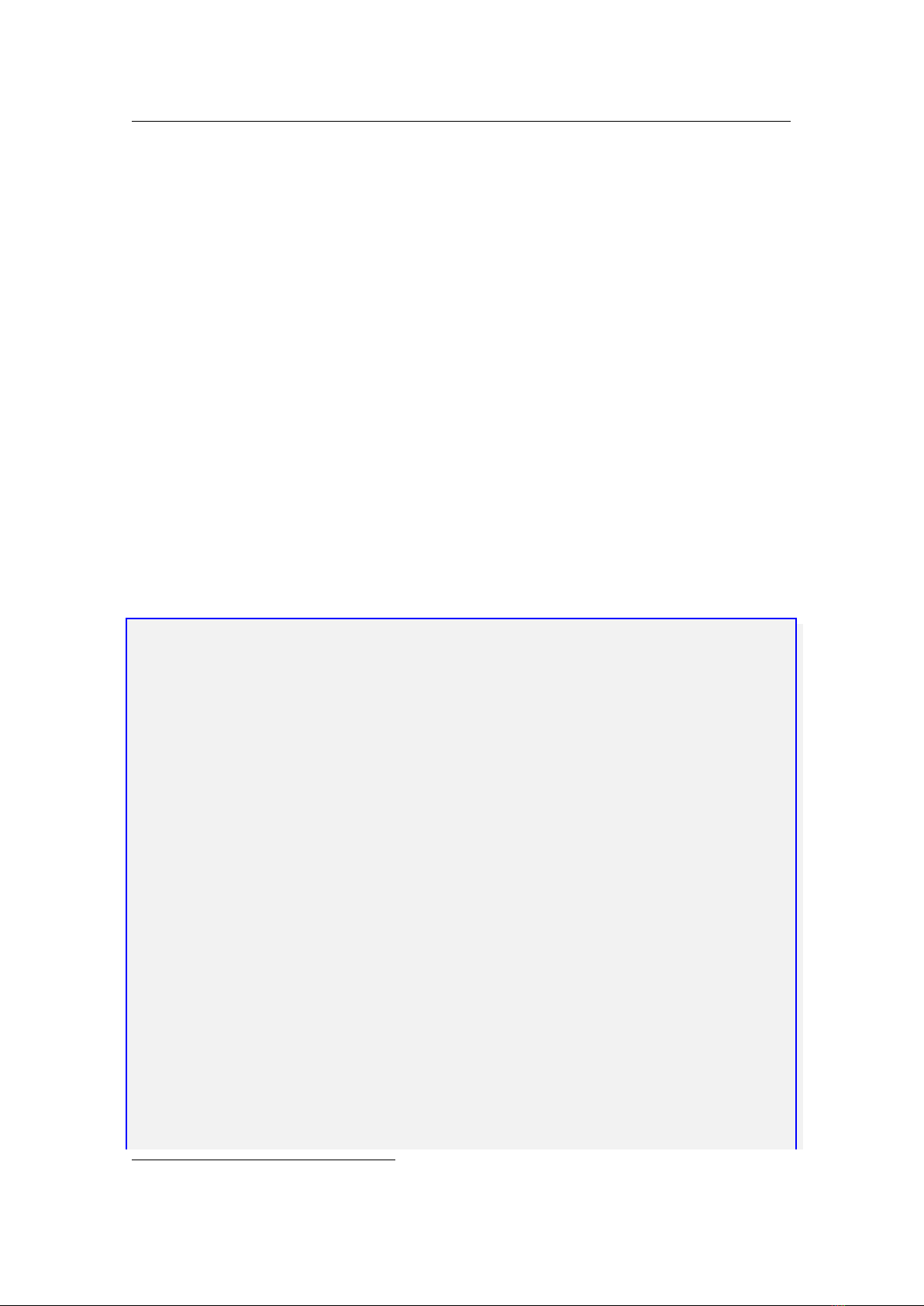
384 Appendix D. Configuration Files
D.2 Solar System Configuration Files
The files
4
ssystem_major.ini
and
ssystem_minor.ini
(in the
data/
subdirectory of the pro-
gram directory, contain orbital and rotational data from which Stellarium configures the Solar
System objects.
The minor bodies can be modified by placing a privately modified copy of
ssystem_minor.ini
into your own
data/
directory (see Chapter 5). You can edit the file either manually or with the
Solar System Editor plugin (see Section 13.8). The private user file is automatically created by the
Solar System Editor plugin.
Each object’s data are described in its own section which is typically named after the object
name. Some section names (e.g. those using diacriticals, spaces or other problematic characters)
appear a bit mangled.
We list here examples for the major planets, larger moons with special coordinate functions,
minor moons with generic orbital elements, minor planets and comets with elliptical and parabolic
orbit elements.
All elements are stored in alphabetic order in the files, however it makes more sense to present
the elements in another sequence which better reflects the meaning. The actual order of the objects
in the files, and order of entries inside an object section, is irrelevant, but in case of duplicate entries
the later entry is used.
D.2.1 File ssystem_major.ini
Planet section
Example:
[ jupiter ]
name = Jupiter
type = planet
coord_func = j upi ter _special
orbit_Peri od =4331.87
atmosphere =1
albedo =0.51
color =1. , 0.983 , 0.934
absolute_ mag nit ude = -9.40
radius =71492
oblateness =0.064874
tex_map = jupiter . png # texture courtesy of Bj \ xf6rn J\ xf3nsson
# deprecated rot ational elements
rot _equato r_ascen ding_no de = -22.203
rot_o bliquity =2.222461
rot_periode =9.92491
rot_rotat ion _offset = -1 # use JupiterGRS patch
# WGCCRE rotational elements
rot_pole_ra =268.056595
rot_pole_r a1 = -0.006499
rot_pole_de =64.495303
4
Before v0.16, there was a single file, ssystem.ini, with slightly different rules.

D.2 Solar System Configuration Files 385
rot_pole_d e1 =0.002413
rot_pole_w0 =284.95
rot_pole_w1 =870.5 360000
where
name English name of the planet. May appear translated.
type Mandatory for planets:
parent =Sun. The body which this object is running around. Default: Sun
coord_func
The planet positions are all computed with a dedicated function (VSOP87 or DE43x).
orbit_Period
number of (earth) days for how long the orbit should be made visible. Typically
Stellarium shows one orbit line. The orbit slowly drifts, however.
atmosphere
(0 or 1) flag to indicate whether observer locations should enable atmosphere drawing.
radius Equator radius, km.
oblateness Flattening of the polar diameter. (1 − r
pole
/r
eq
)
albedo
total albedo (reflectivity) of the planet. Used for “generic” magnitude computation, but
the major planets usually have dedicated magnitude formulas, so the value is not evaluated
unless you are observing from a location outside Earth.
color Used to colorize halo. At least one of the components should be 1.
tex_map File name of texture map in textures folder.
halo
Should be true to draw a halo (simple light disk) when object too small to draw a sphere.
Default: true
Elements for the Physical Ephemeris
Where known, Stellarium can properly model axis rotation with the
rot_...
entries in the
element sets. Versions prior to 0.21 had rotational elements defined with respect to the equator
of the parent object. While writing this documentation the origin and accuracy of this model is
unfortunately untraceable. However, the IAU Working Group on Cartographic Coordinates and
Rotational Elements (WGCCRE) and modern sources like Urban and Seidelmann (2013) use
rotational elements with respect to the ICRF (see section 18.2.2). Therefore, starting with version
0.21, Stellarium uses these more modern data and can now also show axes with precessional or
other motions. Data for some planet moons are unfortunately still not available in this WGCCRE
format, and therefore the old format can still be used, but should not be used for new entries.
rot_equator_ascending_node deprecated
rot_obliquity deprecated
rot_rotation_offset
deprecated longitude of prime meridian. For Planets, this used to be counted
from the ascending node of the equator over the ecliptical plane at J2000.0. For moons, it is
the longitude of the prime meridian counted from the ascending node of the moon’s equator
over the planet equator. A special value here indicates special treatment for the Great Red
Spot.
rot_periode deprecated Duration of one sidereal rotation, in earth hours.
rot_pole_ra constant of axis right ascension in ICRF, degrees
rot_pole_ra1 change per century of axis right ascension in ICRF, degrees
rot_pole_de constant of axis declination in ICRF, degrees
rot_pole_de1 change per century of axis declination in ICRF, degrees
rot_pole_w0
longitude of the prime meridian counted from the ascending node of the objects’s
equator through the ICRF equator, degrees
rot_pole_w1 change per day of axis rotation, degrees
In many cases, the attitude/rotation formulae for the North (or “positive”) pole
(α
0
,δ
0
)
are given
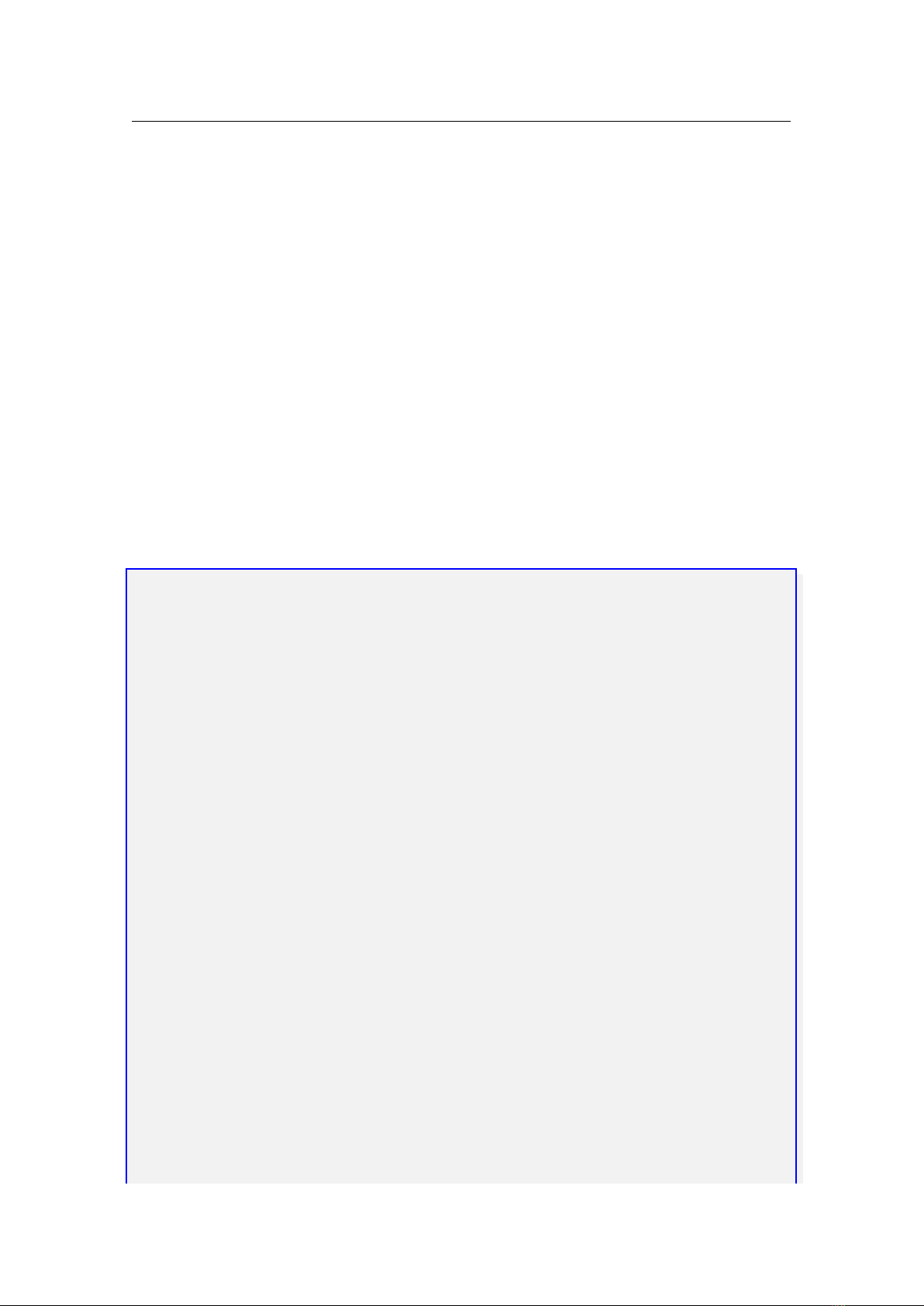
386 Appendix D. Configuration Files
like
α
0
= rot_pole_ra + T ∗ rot_pole_ra1 (D.1)
δ
0
= rot_pole_de + T ∗ rot_pole_de1 (D.2)
W = rot_pole_w0 + d ∗ rot_pole_w1 (D.3)
These cases are fully covered by the data in
ssystem_major.ini
. Corrections for solar system
objects given by Archinal, A’Hearn, Bowell, et al. (2010), Archinal, A’Hearn, Conrad, et al. (2011),
Archinal, Acton, A’Hearn, et al. (2018), Archinal, Acton, Conrad, et al. (2019), and Urban and
Seidelmann (2013) have been implemented in the program.
Moon section
All planet moons are defined only in ssystem_major.ini.
Moons are special in that they orbit another planet. Therefore, the rotational elements used
to be specified relative to the equatorial plane of the parent planet, and
orbit_SemiMajorAxis
are specified in kilometers. However, as for the planets (see section D.2.1 above), current IAU
reference material gives axis orientation with right ascension and declination values for the pole
in ICRF coordinates, with some of them in motion. So again, if one of the
rot_pole_...
values
exist, we assume the current standard, but keep the old elements available until we find new data.
For more complicated motion, again some special functions are applied.
[ amalthea ]
name = Amalthea
type = moon
parent = Jupiter
iau_moon_nu mbe r = JV
orbit_Asc end ingNode =141.55215207946 74
orbit_Ecc ent ric ity = 0.0 0617574 440 2949701
orbit_Epoch = 2454619.500 00
orbit_Inclination =0.3864 576 103 404582
orb it_ LongOfP eri center =245 .42 2235515 012 0000
orbit_Mea nLo ngitude =224.79 248 9355255 000 0
orbit_Peri od =0.5016370 462 116355
orbit_Sem iMa jorAxis =181994.86583587 99
absolute_ mag nit ude =7.4
albedo =0.09
color =1. , 0.627 , 0.492
radius =83.5
tex_map = amalthea . png
model = j5amalthea_ MLf ix . obj
rot _equato r_ascen ding_no de =213.7
rot_o bliquity =15.5
# ro t_per iode = 12. 0392891090792 52
rot_rotat ion _offset =235.50
rot_pole_ra =268.05
rot_pole_r a1 = -0.009

D.2 Solar System Configuration Files 387
rot_pole_de =64.49
rot_pole_d e1 =0.003
rot_pole_w0 =231.67
rot_pole_w1 =722.6 314560
where
name English name of planet moon. No number, just the name. May be translated.
type moon
parent English name of planet or parent body.
iau_moon_number
a short label (string) consisting of the planet’s initial and the moon’s Roman
number in order of discovery.
coord_func
Must be
kepler_orbit
(default, can be left away) for moons with orbital elements
given, or <name>_special for
orbit_AscendingNode Ω
orbit_Eccentricity e
orbit_Epoch
orbit_Inclination i [degrees]
orbit_LongOfPericenter
orbit_MeanLongitude
orbit_Period [days]
orbit_SemiMajorAxis a [km]
radius Equator radius, km.
oblateness
Flattening of the polar diameter. (
1− r
pole
/r
eq
) Bodies with non-ellipsoid shape, e.g.
tri-axial geometry, cannot be modelled with this simple approach, but a 3D solid model can
be shown, see below.
albedo total reflectivity [0..1]
color for drawing halo (default: 1,1,1)
halo [=true|false] to draw a simple diffuse dot when zoomed out. Default: true
tex_map
name of spherical texture map. Many moons have been mapped by visiting spacecraft!
For many other moons, Stellarium applies an inverted Lunar texture image.
model
(optional) name of a 3D model for a non-spherical body in the
model
subdirectory of the
program directory.
rot_equator_ascending_node deprecated
rot_obliquity deprecated
rot_rotation_offset deprecated longitude of prime meridian at J2000.0.
rot_periode
deprecated Duration of one sidereal rotation, in earth hours. For moons in bound
rotation (which always show one face towards their parent planet), it is best to omit this
value: it defaults to orbit_Period * 24.
rot_pole_ra constant of axis right ascension in ICRF, degrees
rot_pole_ra1 change per century of axis right ascension in ICRF, degrees
rot_pole_de constant of axis declination in ICRF, degrees
rot_pole_de1 change per century of axis declination in ICRF, degrees
rot_pole_w0
longitude of the prime meridian counted from the ascending node of the objects’s
equator through the ICRF equator, degrees
rot_pole_w1 change per day of axis rotation, degrees
Observers
Stellarium is great for excursions to the surface of any object with known orbital elements. Config-
uring a viewpoint away from a planet requires a special kind of location.

388 Appendix D. Configuration Files
Solar System Observer
The Solar System Observer has been provided in earlier versions as a neutral view location high
above the North pole of the Solar System. Meanwhile the location can be changed by keyboard
interaction. See section 4.2.3.
[ solar_s yst em_observe r ]
name = Solar System Observer
parent = Sun
halo = false
hidden = true
orbit_Sem iMa jorAxis =30
type = observer
Note that it is
hidden
and has no
halo
. The observer is attached to the Sun, therefore distance
orbit_semiMajorAxis is given in AU.
Planet Observers
There are other “observer” locations for all planets which have moons: Earth, Mars, Jupiter, Saturn,
Uranus, and Neptune. For example:
[ ear th_observer ]
name = Earth Observer
parent = Earth
halo = false
hidden = true
orbit_Sem iMa jorAxis =149600000
type = observer
The distance
orbit_semiMajorAxis
has been preconfigured with a distance that gives a good
v 23.1
view of the planet with its moons. Like for moons, the units are km from the planet.
D.2.2 File ssystem_minor.ini
Orbital elements for minor bodies are always given for a particular equinox like J2000.0 (which
indicates the coordinate reference system) and epoch (date). The other planets pull on the objects
and change their orbits, most usually leading to the objects appearing too early or too late in their
orbits, but also changing the other orbital elements. In addition, outgassing events of comets can act
like jet propulsion and change orbits in unpredictable ways. It is heavily recommended to update
the orbital elements on a regular basis (
2×
/year?), or at least before you go out and are actually
observing minor bodies. Use the Solar System Editor plugin for this task (section 13.8).
You may find element sets for different equinoxes, like B1950.0. These have to be converted to
equinox J2000.0 data before being useful in Stellarium.
coord_func
is
kepler_orbit
by default. For compatibility and interoperability with older ver-
sions we will keep the old default of comet_orbit for some longer time.
5
parent defaults to Sun and can be omitted.
orbit_Epoch
JDE when these elements are valid. Defaults to 2451545.0 = the J2000.0 standard
epoch.
orbit_good
can be given in days to limit computation of the object to the time range
epoch ±
orbit_good
. If specified as
0
there is no check for out-of-range dates. If specified as
-1
, half
5
Previous editions used the name
comet_orbit
. Now the
coord_func
line can be left away, defaulting
to kepler_orbit.
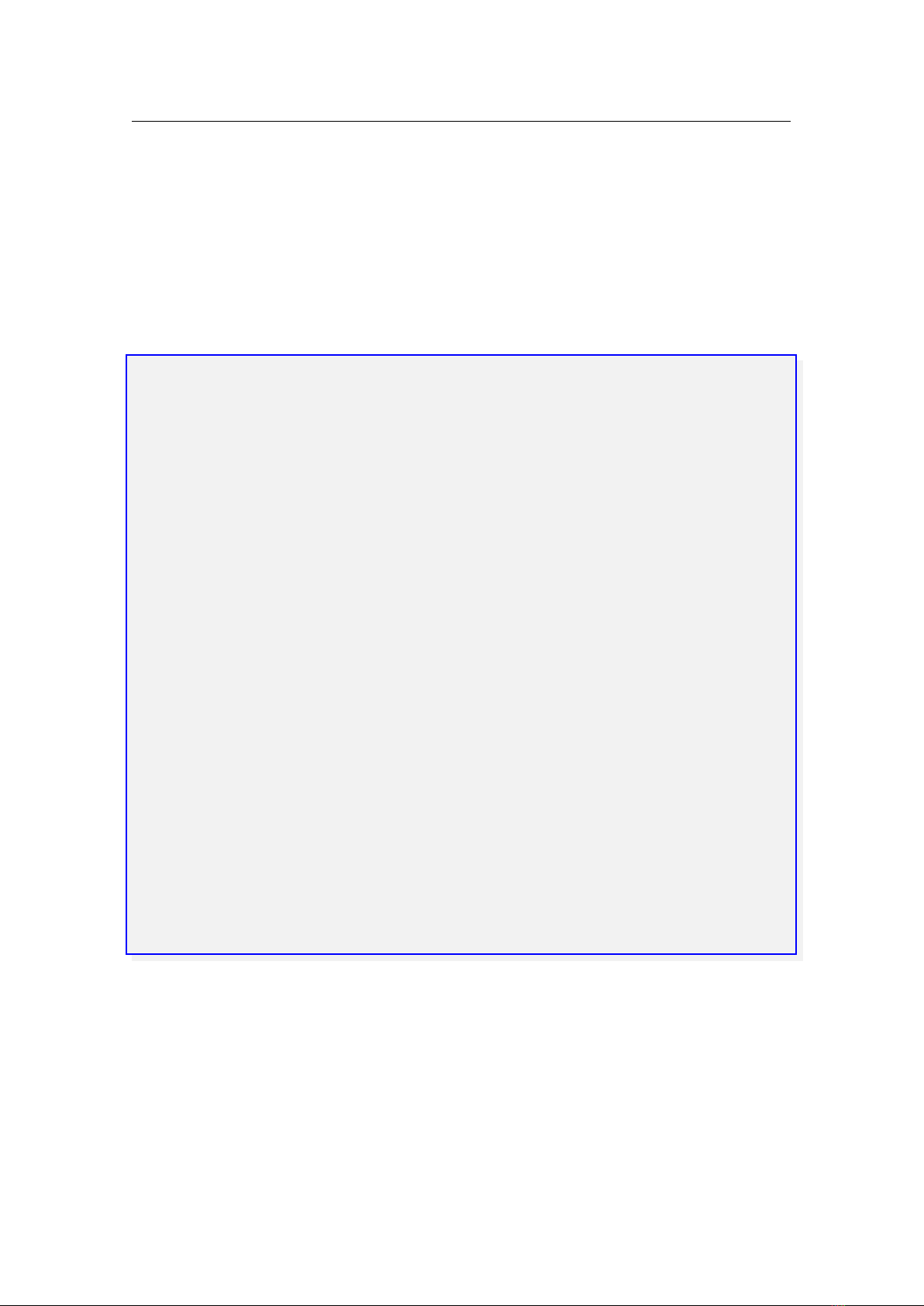
D.2 Solar System Configuration Files 389
the orbital period is used. The main purpose of this parameter is to avoid an element clash or
the inadvertent use of outdated comet orbit elements when a periodic comet reappears.
orbit_ArgOfPericenter ω [degrees]
orbit_AscendingNode Ω [degrees]
orbit_Eccentricity e = 0 circular, 0 < e < 1 elliptic, e = 1 parabolic, e > 1 hyperbolic
orbit_Inclination i [degrees] inclination against J2000 ecliptic
orbit_SemiMajorAxis a [AU]
The other parameters are like those for the major planets.
Minor Planet section
[4 vesta ]
type = asteroid
minor_pla net _number =4
name = Vesta
coord_func = comet_ orbit
parent = Sun
orbit_Epoch =2457000.5
orbit_MeanAnomaly =20.863 89
orbit_MeanMotion =0.27154465
orbit_ ArgOfPeric ent er =151.19843
orbit_Asc end ingNode =103.85141
orbit_Ecc ent ric ity =0.0887401
orbit_Inclination =7.14043
orbit_Sem iMa jorAxis =2.3617933
orbit_good =1325.46
color =1. , 1. , 1.
halo = true
oblateness =0.0
albedo =0.423
radius =280
absolute_ mag nit ude =3.2
slope_param ete r =0.32
tex_map = vesta . png
model =4 vesta _21_MLfix . obj
type
can be
asteroid, dwarf planet, cubewano, plutino, scattered disc object, Oort
cloud object
. With the exception of Pluto (which is included in
ssystem_major.ini
and cannot be changed), all positions for minor bodies are computed with the orbiting
elements given in this way.
Minor planets further specify
orbit_Epoch , JDE when these elements are valid. Defaults to J2000.0, i.e., 2451545.0.
orbit_MeanAnomaly M mean anomaly, degrees.
orbit_MeanMotion n mean motion [degrees/day].
Visual magnitude is modelled from
absolute_magnitude H

390 Appendix D. Configuration Files
slope_parameter G.
Elements for rotational axis may be given just like for planets when they are known. It is
recommended to use the modern specification (elements rot_pole_...).
model
A few asteroids have been visited by spacecraft, and for many other asteroids visual
observations of stellar occultations by asteroids and light curve measurements have enabled
researchers to derive 3D shape models of asteroids. If a model is available in the
models
subdirectory of the program directory, this can be configured with a model entry.
Comet section
Comets are tiny, and their outgassing and close approaches to the major planets cause fast changes
in their orbital elements, so that each apparition should be specified with a dedicated section in
ssystem_minor.ini.
Naming schemes
Over just the past decades, the naming of comets has changed considerably. Starting in the 19th
century, comets are usually named after their discoverer(s). In addition, they are given a catalog
number. Traditionally, comets observations published by scientific organisations were sorted and
labelled with Roman numerals after date of perihelion. When scientific communication became
faster, comet discoveries were circulated by telegraphs, and a preliminary immediate labelling by
sequence of discovery was used. After the year was over, the comet received again the Roman
number indicating the position in the sequence of perihelon dates in that year.
In 1994, a new scheme has been introduced
6
: When a comets is discovered, the discovery date
governs a unique label: The 12 months of the year are split into half-months, for which 24 of the 26
letters of the alphabet are used (I and Z are omitted). After the letter, discoveries are enumerated in
sequence. A letter before this number indicates what kind of comet the element set describes: C
indicates a regular comet, P a periodic (recurring) comet, D is defunct (lost). X is one for which no
reliable orbital elements can be given. I labels an interstellar object (an object on an orbit which
seems not to be permanently attached to the sun). After a return, periodic comets receive a serial
number before the P.
This new scheme is also applied for old comets. However, for the sake of compatibility with
older literature, Stellarium can use several optional entries in addition to the name, for example:v 23.2
name
1P/Halley (First periodic comet, named after EDMUND HALLEY, the astronomer who
identified its recurrent nature)
iau_designation 1982 U1 (First comet discovered in 2nd half of October 1982)
discovery_code 1982i (9th comet discovered in 1982)
perihelion_code 1986 III (Third comet to go through perihelion in 1986)
There is unfortunately divergent information about use of the new IAU discovery code for
periodical comets like 1P/Halley. Some lists provide such codes for previous observations, while
others use the modern code for Halley’s own observation (P/1682 Q1) for every apparition, in
which case identification of the proper apparition from just the name becomes impossible. IAU
simply uses a periodic number with P and optional name (for comet Halley, “1P/Halley”. Almost
all periodic comets have names) to identify such a recurring object. While this can be used for
predicted future passages through the inner Solar system, there cannot be a modern “discovery
code” based label when the comet was at least in theory followed through aphelion. But also this
format, using only periodic number, prevents disambiguation between apparitions. To make life
simpler for us, we prefer to use a name entry like “1P/Halley (1986)” with year of perihel passage
in brackets. A numbered comet may come without a discoverer name. In this case it is just shown
with perihel year like “396P (2019)”. The ini file should include a periodic number in front of the P
6
https://minorplanetcenter.net/iau/lists/CometResolution.html

D.2 Solar System Configuration Files 391
in the name, however some data files are incomplete. Unnumbered comets follow the new IAU
code, e.g., “C/1996 B2 (Hyakutake)”. You can also provided separate
name
and
iau_designation
entries, in which case they will be combined.
Most other elements are similar to minor planets. But note the specification of
orbit_PericenterDistance q [AU]
orbit_TimeAtPericenter T JDE of closest approach to the Sun
orbit_Epoch JDE when these elements are valid (optional).
which is more typical for comets which may have no orbital period when they are on parabolic or
hyperbolic orbits. Frequently orbital elements are given for a date very close to perihelion so that
the perihel date
T
is used wherever
orbit_Epoch
is not given. However, this assumption does not
always hold, so we recommend to state orbit_Epoch explicitly.
ref Reference, e.g. some MPC Circular (optional). May be used in future versions.
Comet brightness is evaluated from
mag = absolute_magnitude+5·logdistance+2.5·slope_parameter·log(CometSunDistance)
(D.4)
The term
slope_parameter
may be a misnomer in case of comets. From the literature (Meeus,
1998) (equation 33.13) we find
mag = g + 5log∆ + κ logr (D.5)
from which
κ = 2 · slope_parameter
. In any case,
κ
is typically [5.. . 15] and specific for each
comet.
You can finetune the appearance of the comet, both when zooming in all the way to the core, or
how the tails are represented.
albedo
(default: 0.075) is used to set the brightness for rendering the body, if you are close enough.
model
Some comets have been visited by spacecraft so that shape models of their cores may be
available and can be configured with this entry.
outgas_intensity
(default:0.1) Intensity of a pseudo-outgas effect on the core, based on an inverse
exponential Lambert shading, with the light at the viewing position.
outgas_falloff (default:0.1) Exponent for falloff of outgas effect, should probably stay < 1.
dust_brightnessfactor (default: 1.5) brightness of dust tail relative to the gas tail.
dust_lengthfactor (default: 0.4) length of dust tail relative to the gas tail.
dust_widthfactor (default: 1.5) width of dust tail relative to the gas tail.
Some historical depictions show huge comets. If painted correctly, you can try to recreate such
paintings.
A large number of elements for historical comets is provided in the file
ssystem_1000comets.ini
in the installation directory. You can copy&paste what you need into your
ssystem_minor.ini
or
add all with the Solar System Editor plugin (section 13.8).
With a clever combination of elements and
orbit_good
entries, it is possible to specify several
sets of orbital elements for different epochs of one apparition.
Periodic Comet
[1 phalley ]
type = comet
name =1 P/ Halley
iau_designa tio n =1982 U1
discover y_code =1982 i
perihelion_ cod e =1986 III

392 Appendix D. Configuration Files
orbit_ ArgOfPeric ent er =111.7154
orbit_Asc end ingNode =58.8583
orbit_Ecc ent ric ity =0.968004
orbit_Inclination =162.24 53
orb it_ Peri cen terDist ance =0.57136
orb it_ TimeAtP eri center =2446463.12979167
orbit_good =780
color =1.0 , 1.0 , 1.0
dust_b rightnessf act or =1.5
dust_lengthfactor =0.4
dust_widthfactor =1.5
albedo =0.1
radius =5
absolute_ mag nit ude =5.5
slope_param ete r =3.2
model =1682 q1halley_ MLfix . obj [ optional ]
Note a rather short duration of
orbit_good
, which means the comet is only displayed 780
days before and after perihelion. (Actually, before and after
orbit_Epoch
, but this is not given
explicitly, so it defaults to orbit_TimeAtPericenter.)
Parabolic/Hyperbolic Comet
[ c2013us10 %28 catalina %29]
type = comet
name = Catalina
iau_designa tio n = C /2013 US10
orbit_ ArgOfPeric ent er =340.3533
orbit_Asc end ingNode =186.141
orbit_Ecc ent ric ity =1.000372
orbit_Inclination =148.87 66
orb it_ Peri cen terDist ance =0.822958
orb it_ TimeAtP eri center =2457342.20748843
orbit_good =1000
...
absolute_ mag nit ude =4.4
slope_param ete r =4
This has basically the same format. Note that eccentricity is larger than 1, this means the comet
is following a slightly hyperbolic orbit. Stellarium shows data for this comet for almost 3 years
(orbit_good=1000 days) from the epoch (defaults to pericenter time).

D.2 Solar System Configuration Files 393
D.2.3 JPL Horizons
The JPL Horizons
7
on-line solar system data and ephemeris computation service provides access
to key solar system data and flexible production of highly accurate ephemerides for solar system
objects (Late 2023: 1,334,683 asteroids, 3,904 comets, 290 planetary satellites includes satellites of
Earth and dwarf planet Pluto, 8 planets, the Sun, L1, L2, select spacecraft, and system barycenters).
Horizons is provided by the Solar System Dynamics Group of the Jet Propulsion Laboratory.
How to manually look up a body
A comet discovered in early 2023, C/2023 A3 (Tsuchinshan-ATLAS), may become bright in
October 2024. Let’s find out its orbital elements for the most interesting time!
We use the Horizons web interface to look up the body we are interested in and find its orbital
elements. The Horizons web interface will display something like this:
1 Ephemeris Type:
Osculating Orbital Elements
2
Edit
Target Body: C/2023 A3 (Tsuchinshan-ATLAS)
3
Edit
Coordinate Center: Sun (body center) [500@10]
4
Edit
Time Specification: Start=2024-07-03 TDB, Stop=2024-12-02, Step=5 (days)
5
Edit
Table Settings: custom
Generate Ephemeris
1. Ephemeris Type must be set to
Osculating Orbital Elements
.
2. Target Body is the body you want to add to Stellarium. Click
Edit
to look it up.
3. Center should be set to Sun for all heliocentric trajectories.
4.
Time Specification: Use a short interval or discrete dates near the time you are most interested.
The returned JDE date (Julian Day number) will be used as epoch in Stellarium.
5.
Table Settings: We must
Edit
and select Output units:
au and days
to create data compati-
ble with the appropriate fields in ssystem_minor.ini
The result begins with listing osculating elements for a certain epoch in the past and its own initial
conditions and settings. Horizons then applies numerical integration and simulates the movement
and gravitational interaction between all its solar system objects, including our comet. Then, for
each requested time, orbital elements are listed. Here you could see the slight changes these
elements undergo over weeks. However, in Stellarium, we can only use one particular element set
and show the comet’s movement under the assumption that these elements do not change. When
we have read it will be brightest in October, let’s take this section. The first number is the date
(JDE) where these elements are valid, i. e., the element epoch.
24605 8 4 . 500 0 0 0 00 0 = A.D . 2024 - Oct -01 0 0 : 0 0 :00. 0 0 0 0 TDB
EC = 1. 0 0 0 0 86 7 7 9 01 3 4 3 6 E+00 QR = 3. 9 1 4 01 1 8 0 9 34 8 2 4 7E -01 IN = 1. 3 9 1 08 9 3 1 2 57 0 2 8 7 E+02
OM = 2. 1 5 6 0 49 2 8 7 75 9 3 6 4 E+01 W = 3.0849 5 5 9 43 4 2 9 219 E +02 Tp = 24 60 5 8 1. 2 4 8 53 2 1 49 9 4 1
N = 3 . 2 5 3 81 5 6 1 56 0 7 0 83 E -06 MA = 1 . 0 5 796 7 6 8 64 5 7 0 91 E -05 TA = 1 . 8 1 97 2 2 0 5 51 6 0 8 37 E +01
A = - 4 . 5 1 0 3 2 0 7 0 3 5 3 2 9 9 6 E +03 AD = 9.9 9 9 9 9 99 9 9 9 99 9 9 8 E +99 PR = 9.9 9 9 9 999 9 9 9 99 9 9 8 E +99
Below you also find the keys:
Symbol meaning :
JDTDB Julian Day Number , Barycentric Dynamical Time
EC Eccentricity , e
QR Periapsis distance , q ( km )
IN Inclination w .r.t X - Y plane , i ( degrees )
7
https://ssd.jpl.nasa.gov/horizons/

394 Appendix D. Configuration Files
OM Longitude of Ascending Node , OMEGA , ( degrees )
W Argument of Perifocus , w ( degrees )
Tp Time of periapsis ( Julian Day Number )
N Mean motion , n ( degrees / sec )
MA Mean anomaly , M ( degrees )
TA True anomaly , nu ( degrees )
A Semi - major axis , a ( km )
AD Apoapsis distance ( km )
PR Sidereal orbit period ( sec )
Now we can add an entry into our
ssystems_minor.ini
. We can leave the exponential writing
style (trailing “E+02” etc.) or convert to the more human-readable as shown here. Symbols
M1
and
k1
are given only in the top list of initial elements. The symbols in brackets refer to the above table,
do not enter those!
[ c2 023A3 ( tsuch i n s han a t l as )]
iau_de s i g n ati o n = C /202 3 A3
name = C /2023 A3 ( Tsuc hinsh an - AT LAS )
type = comet
orbit_Epoch = 2 4 6 0 5 8 4 . 5
orbi t _ A rg O f Pe r i ce n t er = (W) 308. 4 9 5 59 4 3 4 292 1 9
orbit _ A sc e n d in g N o de = ( OM ) 2 1 .56 0 4 9 28 7 7 5 936 4
orbit _ E c ce n t r ic i t y = ( EC ) 1. 0 000 8 6 7 79 0 1 3 436
orbit _ I n cli n a t io n = (IN ) 139. 1 0 8 931 2 5 7 02 8 7
orbi t _ Pe r i ce n t er D i st a nc e = ( QR ) 0.3 9 1 4 01 1 8 093 4 8 2 47
orbi t _ Ti m e A tP e r ic e n te r = ( Tp ) 2 4 6 0 58 1 . 24 8 5 3 21 4 9 94 1
absol u t e _m a g n it u d e = ( M1 ) 6.1
slope_ p a r a met e r = ( k1 /2) 4.25
orbit_good = 1000
discov e r y = 2023 -01 -09 [ Not given by JPL Ho r i z o ns ]
ref = JPL Horizons : JPL #25
JPL Horizons can also deliver osculating elements for a number of interplanetary spacecraft. To
visualize them, you should assign
type=interstellar object
(to make the orbit line stand out
a bit more than with
asteroid
) and invent your own magnitude, e.g.,
absolute_magnitude=0
or
even brighter, to make them visible. Obviously, the shown trajectory is valid only around the given
epoch and changes significantly whenever a spacecraft encounters a larger solar system object or
when operators fire its engines. An Example for the Voyager 2 spacecraft may look like:
[ vo y a g er2 ]
name = V o y ager 2 ( after Ne ptune )
iau_de s i g n ati o n = Vo yager 2
type = in t e rstel l a r obj e ct
orbi t _ A rg O f Pe r i ce n t er = 1.30087 2 3 8 88 6 3 2 44 E +02
orbit _ A sc e n d in g N o de = 1.017 8 4 0 51 1 9 7 11 7 4 E +02
orbit _ E c ce n t r ic i t y = 6.29 4 3 3 88 9 1 6 86 2 6 1 E +00
orbit_Epoch = 2 4 6 0 5 5 4 . 5 [ Sept 1 , 2024]
orbit _ I n cli n a t io n = 7 .8 9 5 3 4 20 3 8 4 00 2 1 4 E +01
orbi t _ Pe r i ce n t er D i st a nc e = 2.1308 1 8 1 959 6 8 9 74 E +01
orbi t _ Ti m e A tP e r ic e n te r = 2 44 5 4 4 6. 8 6 86 6 5 6 16 9 5 9
orbit_good = 1279 7
ref = JPL Horizons
absol u t e _m a g n it u d e = 0
slope_ p a r a met e r = 4
The displayed trajectory should start at Voyager 2’s encounter with Neptune on August 18, 1989
(JD 2447757.5). The value of orbit_good= (2460554.5 − 2447757.5 =) 12797 fulfills this idea.
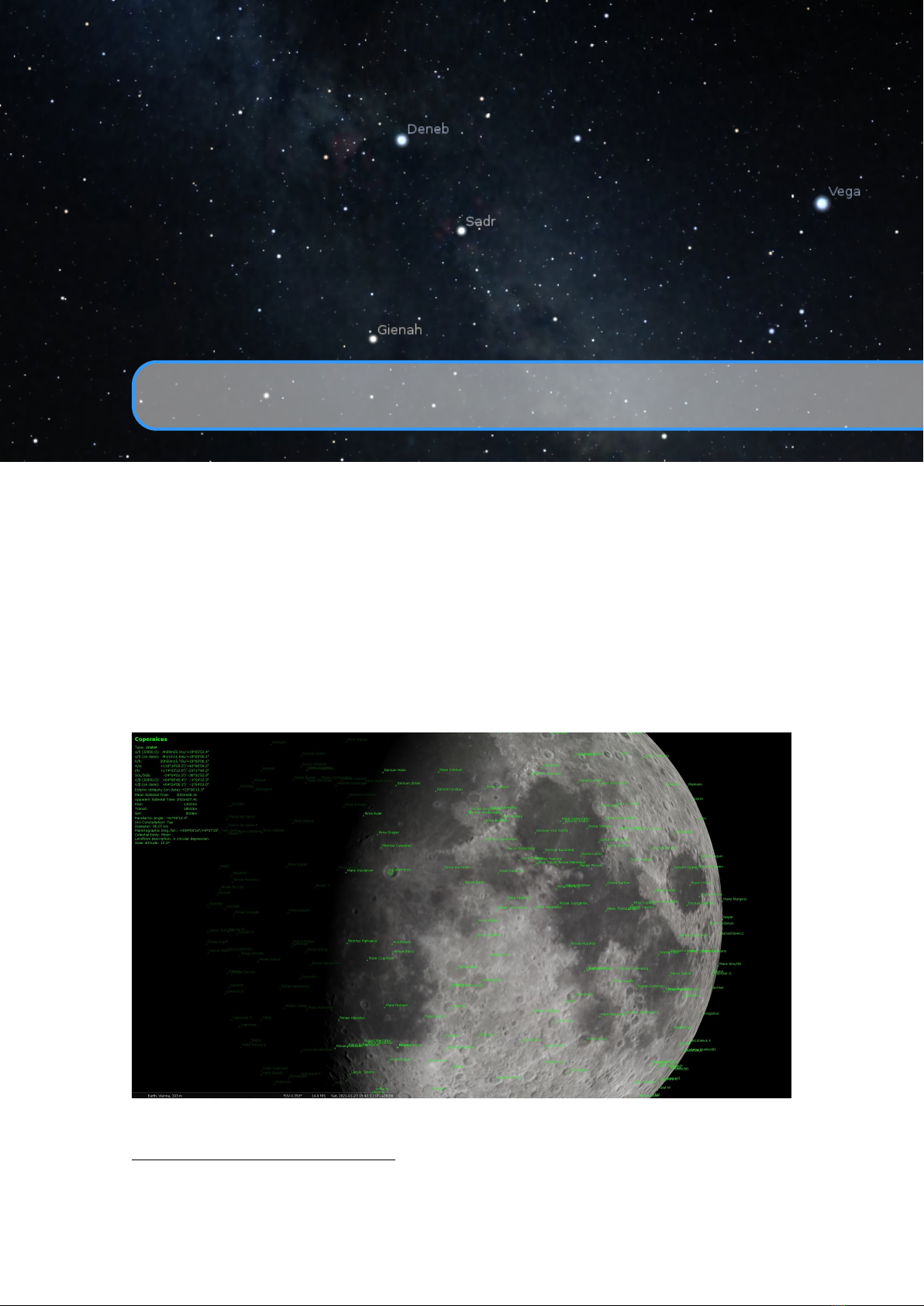
E. Planetary nomenclature
Planetary nomenclature, like terrestrial nomenclature, is a system of uniquely identifying features
on the surface of a planet or natural satellite so that the features can be easily located, described, and
discussed. Since the invention of the telescope, astronomers have given names to the surface features
they have discerned, especially on the Moon and Mars. To standardize planetary nomenclature, the
International Astronomical Union (IAU) was assigned in 1919 the task of selecting official names
for features on solar system bodies
1
.
Figure E.1: Feature nomenclature of the Moon.
1
History of Planetary Nomenclature – https://planetarynames.wr.usgs.gov/Page/History

396 Appendix E. Planetary nomenclature
Since version 0.17.0 Stellarium supports planetary nomenclature, which allows using the
planetarium for educational and informative purposes on the one hand, and as tool for recognition
and targeting of the planetary features for advanced amateurs on the other hand, avoiding the need
for additional cartographic software in the field.
All planetary nomenclature items are stored in a dedicated internal format, and all names are
translatable to provide better understanding of those names by average users and newbies – for
example in schools or universities. Of course all nomenclature items are available for finding in
the Search Tool after enabling the display of nomenclature (this feature is rather costly in terms of
computing power and therefore is by default disabled in the GUI).
The information in sections E.3–E.6, included here for reference, has been taken from the
“Gazetteer of Planetary Nomenclature” website by the International Astronomical Union (IAU)
Working Group for Planetary System Nomenclature (WGPSN)
2
.
E.1 Format of nomenclature data file
File
data/nomenclature.fab
is a plain text file in UTF-8 encoding and has a very simple data
format:
• One item per line;
•
Each item contains seven elements with white space (“space” or “tab” character) as delimiter.
File
data/nomenclature.dat
is a zipped
data/nomenclature.fab
file and used to minimize
time of loading the data and reduce size of the installation package.
Item Type Comment
planet name string
English name of the planet, moon or minor
body carrying the named feature
ID of planetary feature integer
unique integer, equal to Feature ID obtained
from Gazetteer of Planetary Nomenclature
translatable name of planetary feature string
English name, containing context data for
translators
type of planetary feature string
2-char code (see designation column in table
in section E.6)
center latitude of planetary feature float decimal degrees
center longitude of planetary feature float decimal degrees
size of planetary feature float kilometers
Example:
Vesta 15201 _ (" Caesonia " ," crater " ) AA 31.20117 249.93457 104.23
E.2 Planetary Coordinate Systems
When we observe the Moon or another planet from Earth (or actually from anywhere), we can see
only about half of the surface of the spheroid body at any time. Foreshortening further prevents us
from observing surface features along the planet’s visible limb. Therefore it is important to know
the coordinates of the center of the apparent disk, given by the central meridian and latitude. In
addition, we can also compute the subsolar point, where the sun is visible in the zenith, and which
2
https://planetarynames.wr.usgs.gov, visited on 2022-04-04

E.3 How names are approved by the IAU 397
provides the center of the illuminated hemisphere. This is not the center of the visible disk! A part
of the illuminated hemisphere is generally on the far side of the planet.
The north pole of the planets is the pole of rotation directed towards the north of the invariable
plane (near the ecliptic) of the Solar system. Most planets are rotating in the same sense as they are
moving around the sun. This is called prograde. Seen from the north side of the ecliptic, they rotate
counterclockwise. Only a few objects, most notable Venus, are rotating clockwise, i.e., retrograde.
For historical reasons, there are several ways to count longitudes. Just like the terrestrial zero
meridian has been defined as that one running through Greenwich observatory
3
, the zero meridian
on rocky bodies like the Moon or Mars is usually defined by some surface feature like a small
crater. For the gas planets, the rotation of the magnetic field is usually given to define the central
meridian. Starting from this central meridian, we can count longitudes in both directions. For the
Moon, which shows always (almost, see 18.2.6) the same side towards Earth, we count western
and eastern longitudes from the central meridian towards the trailing or leading edge of its daily
motion, respectively. (Seeing the Moon through an unguided telescope, we first see the eastern
longitudes from
≈ 90
◦
to
0
◦
, then the western longitudes from
0
◦
to
≈ 90
◦
.) Alternatively we can
count the western longitudes as negative. The counting continues to the (invisible) far side of the
Moon where one meridian has an Eastern longitude of +180
◦
= −180
◦
.
For other objects, historically, Mars was the first planet to be mapped with cartographic
coordinates. Its rotational period of just over 24.5 hours allows to follow its rotation and observe
only a slight change in appearance every day. It appeared natural to count the central meridian so that
central longitude increased as time passed. Just like on Earth, as time passes, increasingly western
longitudes receive sunlight and also become visible. Therefore these planetographic longitudes are
counted towards the west on planets with prograde rotation. On planets with retrograde rotation
like Venus, these longitudes are counted eastward.
In contrast, current convention on Earth is to count geographic longitudes eastward.
The information about coordinates for center and subsolar points in the information displayed
for a planet is counted in this planetographic sense.
Another convention are planetocentric coordinates where longitudes are always counted
positively towards the east. East is defined as going counterclockwise as seen from the north
pole, which is itself defined as the one pole more closely aligned with Earth’s north pole. The latest
maps and data for Mars are using planetocentric data, i.e., eastern longitudes.
For clarity, therefore coordinates are often explicitly written with “E” and “W” instead of
signed numbers.
Another difference between planetographic and planetocentric coordinates is that the latter
model the planet as simple sphere, ignoring the (usually small) flattening of the planet bodies.
The surface coordinate systems defined by the WGPSN
4
and used in Stellarium follows are
shown in table E.1
5
. However, given that the WGPSN publishes their data only with planetocentric
latitudes, Stellarium provides planetocentric latitudes in the information panel for surface features.
E.3 How names are approved by the IAU
When images are first obtained of the surface of a planet or satellite, a theme for naming features
is chosen and a few important features are named, usually by members of the appropriate IAU
task group (a commonly accepted planet-naming group). Later, as higher resolution images and
3
In earlier times, at least each seafaring nation had its own zero meridian, usually running through an
official observatory.
4
IAU Working Group for Planetary System Nomenclature –
https://planetarynames.wr.usgs.g
ov/
5
https://planetarynames.wr.usgs.gov/TargetCoordinates, visited Jan.5, 2022

398 Appendix E. Planetary nomenclature
Target Coordinate Systems Control Networks
Amalthea Planetographic +West 0. . . +360
Ariel Planetocentric +East 0. . . +360
Callisto Planetographic +West 0. . . +360
Charon Planetocentric +East 0. . . +360 Charon
Deimos Planetographic +West 0. . . +360
Dione Planetographic +West 0. . . +360
Enceladus Planetographic +West 0. . . +360
Epimetheus Planetographic +West 0. . . +360
Europa Planetographic +West 0. . . +360
Ganymede Planetographic +West 0. . . +360
Hyperion Planetographic +West 0. . . +360
Iapetus Planetographic +West 0. . . +360
Io Planetographic +West 0. . . +360 Voyager/Galileo SSI
Janus Planetographic +West 0. . . +360
Mars Planetocentric +East 0. . . +360 MDIM 2.1
Mercury Planetographic +West 0.. . +360 MESSENGER Team
Mimas Planetographic +West 0. . . +360
Miranda Planetocentric +East 0. . . +360
Moon Planetographic +East −180. . . +180 LOLA 2011, ULCN 2005
Oberon Planetocentric +East 0. . . +360
Phobos Planetographic +West 0. . . +360
Phoebe Planetographic +West 0. . . +360
Pluto Planetocentric +East 0. . . +360 Pluto
Proteus Planetographic +West 0. . . +360
Puck Planetocentric +East 0. . . +360
Rhea Planetographic +West 0. . . +360
Tethys Planetographic +West 0. . . +360
Thebe Planetographic +West 0. . . +360
Titan Planetographic +West 0. . . +360
Titania Planetocentric +East 0. . . +360
Triton Planetographic +East 0. . . +360
Umbriel Planetocentric +East 0. . . +360
Venus Planetocentric +East 0. . . +360
Table E.1: Coordinate systems used by the WGPSN

E.4 IAU rules and conventions 399
maps become available, additional features are named at the request of investigators mapping
or describing specific surfaces, features, or geologic formations. Anyone may suggest that a
specific name be considered by a task group. If the members of the task group agree that the
name is appropriate, it can be retained for use when there is a request from a member of the
scientific community that a specific feature be named. Names successfully reviewed by a task
group are submitted to the IAU Working Group for Planetary System Nomenclature (WGPSN).
Upon successful review by the members of the WGPSN, names are considered provisionally
approved and can be used on maps and in publications as long as the provisional status is clearly
stated. Provisional names are then presented for adoption to the IAU’s General Assembly, which
met triennially in the past, and which now adopts nomenclature for planetary surface features as
required. A name is not considered to be official – that is, “adopted” – until the General Assembly
has given its approval.
E.4 IAU rules and conventions
Names adopted by the IAU must follow various rules and conventions established and amended
through the years by the Union. These include:
1.
Nomenclature is a tool and the first consideration should be to make it simple, clear, and
unambiguous.
2.
In general, official names will not be given to features whose longest dimensions are less
than 100 meters, although exceptions may be made for smaller features having exceptional
scientific interest.
3. The number of names chosen for each body should be kept to a minimum. Features should
be named only when they have special scientific interest, and when the naming of such
features is useful to the scientific and cartographic communities at large.
4.
Duplication of the same surface feature name on two or more bodies, and of the same name
for satellites and minor planets, is discouraged. Duplications may be allowed when names
are especially appropriate and the chances for confusion are very small.
5.
Individual names chosen for each body should be expressed in the language of origin.
Transliteration for various alphabets should be given, but there will be no translation from
one language to another.
6.
Where possible, the themes established in early solar system nomenclature should be used
and expanded on.
7.
Solar system nomenclature should be international in its choice of names. Recommendations
submitted to the IAU national committees will be considered, but final selection of the
names is the responsibility of the International Astronomical Union. Where appropriate, the
WGPSN strongly supports an equitable selection of names from ethnic groups, countries,
and gender on each map; however, a higher percentage of names from the country planning
a landing is allowed on landing site maps.
8.
No names having political, military or religious significance may be used, except for names
of political figures prior to the 19th century.
9.
Commemoration of persons on planetary bodies should not normally be a goal in itself, but
may be employed in special circumstances and is reserved for persons of high and enduring
international standing. Persons being so honored must have been deceased for at least three
years, before a proposal may be submitted.
10.
When more than one spelling of a name is extant, the spelling preferred by the person, or
used in an authoritative reference, should be used. Diacritical marks are a necessary part of a
name and will be used.
11.
Ring and ring-gap nomenclature and names for newly discovered satellites are developed in

400 Appendix E. Planetary nomenclature
joint deliberation between WGPSN and IAU Commission X2. Names will not be assigned
to satellites until their orbital elements are reasonably well known or definite features have
been identified on them.
12.
Accessible and authoritative sources, including Internet sources, are required for adopted
names. Wikipedia is not sufficient as a source, but may be useful for identifying appropriate
sources.
In addition to these general rules, each task group develops additional conventions as it formulates an
interesting and meaningful nomenclature for individual planetary bodies. Most of these conventions
are self evident from study of the appendixes that follow.
E.5 Naming conventions
Names for all planetary features include a descriptor term, with a few exceptions. For craters, the
descriptor term is implicit. Some features named on Io and Triton do not carry a descriptor term
because they are ephemeral.
In general, the naming convention for a feature type remains the same regardless of its size.
Exceptions to this rule are channels (valles) on Mars and Venus, and craters on the Moon, Mars, and
Venus; naming conventions for these features differ according to size. The categories for naming
features on each planet or satellite (and the exceptions) are listed in Categories for Naming Features
on Planets and Satellites
6
. One feature classification, regio, was originally used on early maps of
the Moon and Mercury (drawn from telescopic observations) to describe vague albedo features. It
is now also used to delineate a broad geographic region.
Named features on bodies so small that coordinates have not yet been determined are identified
on drawings or images of the body that are included in the IAU Transactions volume of the year
when the names were adopted. Satellite rings and gaps in the rings are named for scientists who
have studied these features; drawings that show these names are also included in the pertinent
Transactions volume. Names for atmospheric features are informal at present; a formal system will
be chosen in the future.
The boundaries of many large features (such as terrae, regiones, planitiae, and plana) are not
topographically or geomorphically distinct; the coordinates of these features are identified from
an arbitrarily chosen center point. Boundaries (and thus coordinates) may be determined more
accurately from geochemical and geophysical data obtained by future missions.
During active missions, small surface features are often given informal names. These may
include landing sites, spacecraft impact sites, and small topographic features, such as craters, hills,
and rocks. Such names will not be given official status by the IAU, except as provided for by Rule 2
above. As for the larger objects, official names for any such small features would have to conform
to established IAU rules and categories.
When a satellite has been discovered through the efforts of a large scientific team, the list of
individual team members may be too long to include all contributors. In such cases, credit for the
discovery will go to the science team.
6
Surface Feature Categories – https://planetarynames.wr.usgs.gov/Page/Categories

E.6 Descriptor terms (feature types) 401
E.6 Descriptor terms (feature types)
Descriptor terms are intended to represent morphological characteristics, not geological origin. The
WGPSN does not endorse any specific scientific hypotheses when assigning descriptors.
Feature Designation Description
Albedo Feature AL
Geographic area distinguished by amount of
reflected light
Arcus, arc
¯
us AR Arc-shaped feature
Astrum, astra AS Radial-patterned features on Venus
Catena, catenae CA Chain of craters
Cavus, cavi CB
Hollows, irregular steep-sided depressions usu-
ally in arrays or clusters
Chaos, chaoses CH Distinctive area of broken terrain
Chasma, chasmata CM A deep, elongated, steep-sided depression
Collis, colles CO Small hills or knobs
Corona, coronae CR Ovoid-shaped feature
Crater, craters AA A circular depression
Dorsum, dorsa DO Ridge
Eruptive center ER Active volcanic centers on Io
Facula, faculae FA Bright spot
Farrum, farra FR
Pancake-like structure, or a row of such struc-
tures
Flexus, flex
¯
us FE
A very low curvilinear ridge with a scalloped
pattern
Fluctus, fluct
¯
us FL Flow terrain
Flumen, flumina FM Channel on Titan that might carry liquid
Fossa, fossae FO Long, narrow depression
Fretum, freta FT
Strait, a narrow passage of liquid connecting
two larger areas of liquid
Insula, insulae IN
Island (islands), an isolated land area (or group
of such areas) surrounded by, or nearly sur-
rounded by, a liquid area (sea or lake)
Labes, lab
¯
es LA Landslide
Labyrinthus, labyrinthi LB Complex of intersecting valleys or ridges
Lacuna, lacunae LU
Irregularly shaped depression on Titan having
the appearance of a dry lake bed
Lacus, lac
¯
us LC
“Lake” or small plain; on Titan, a “lake” or
small, dark plain with discrete, sharp boundaries
Landing site name LF Lunar features at or near Apollo landing sites
Large ringed feature LG Cryptic ringed features
Lenticula, lenticulae LE Small dark spots on Europa
Linea, lineae LI
A dark or bright elongate marking, may be
curved or straight
Lingula, lingulae LN
Extension of plateau having rounded lobate or
tongue-like boundaries
Macula, maculae MA Dark spot, may be irregular

402 Appendix E. Planetary nomenclature
Mare, maria ME
“Sea”; on the Moon, low albedo, relatively
smooth plain, generally of large extent; on Mars,
dark albedo areas of no known geological sig-
nificance; on Titan, large expanses of dark ma-
terials thought to be liquid hydrocarbons
Mensa, mensae MN A flat-topped prominence with cliff-like edges
Mons, montes MO Mountain
Oceanus, oceani OC A very large dark area on the moon
Palus, paludes PA “Swamp”; small plain
Patera, paterae PE
An irregular crater, or a complex one with scal-
loped edges
Planitia, planitiae PL Low plain
Planum, plana PM Plateau or high plain
Plume, plumes PU Cryo-volcanic features on Triton
Promontorium, promontoria PR “Cape”; headland promontoria
Regio, regiones RE
A large area marked by reflectivity or color dis-
tinctions from adjacent areas, or a broad geo-
graphic region
Reticulum, reticula RT Reticular (netlike) pattern on Venus
Rima, rimae RI Fissure
Rupes, rup
¯
es RU Scarp
Satellite Feature SF
A feature that shares the name of an associated
feature. For example, on the Moon the craters
referred to as “Lettered Craters” are classified
in the gazetteer as “Satellite Features”
Saxum, saxa SA Boulder or rock
Scopulus, scopuli SC Lobate or irregular scarp
Serpens, serpentes SE
Sinuous feature with segments of positive and
negative relief along its length
Sinus, sin
¯
us SI
“Bay”; small plain; on Titan, bays within seas
or lakes of liquid hydrocarbons
Sulcus, sulci SU Subparallel furrows and ridges
Terra, terrae TA Extensive land mass
Tessera, tesserae TE Tile-like, polygonal terrain
Tholus, tholi TH Small domical mountain or hill
Unda, undae UN Dunes
Vallis, valles VA Valley
Vastitas, vastitates VS Extensive plain
Virga, virgae VI A streak or stripe of color
E.6.1 Chart of landform types
The graphical examples of some landform types were taken from a chart of landform types created
in 1979 by Anne Gifford, then at the Air and Space Museum, Smithsonian Institution, Washington,
D.C.
7
7
https://planetarynames.wr.usgs.gov/images/Farouk_drawings_composite.pdf
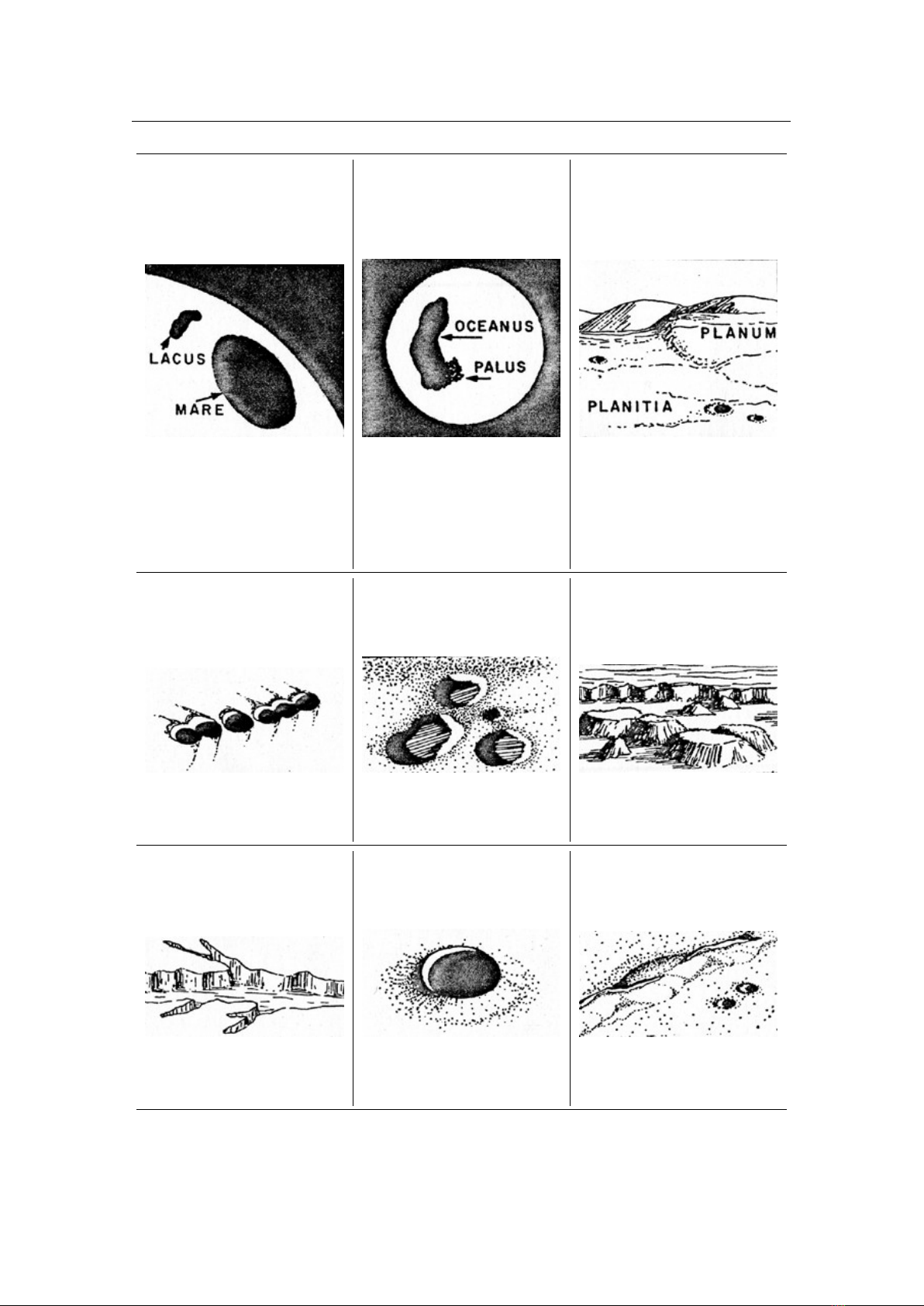
E.6 Descriptor terms (feature types) 403
Lacus [LC] and Mare [ME] Oceanus [OC] and Palus
[PA]
Planitia [PL] and Planum
[PM]
“lake” (small irregular patch
of dark, smooth material of
the Moon) and “sea” (large,
often circular, region of dark
smooth material of the Moon)
“ocean” (vast, irregular, dark,
smooth region – Oceanus Pro-
cellarum only) and “swamp”
(small irregular area, on the
Moon a mixture of mare and
highland material)
low plain or large level ex-
panse of lowlands and high
plain or a plateau
Catena [CA] Cavus [CB] Chaos [CH]
chain; a string of closely
spaced depressions
cavities; irregular steep-sided
depressions usually in clus-
ters
chaos; area of distinctive bro-
ken or jumped terrain
Chasma [CM] Crater [AA] Dorsum [DO]
chasm; steep-walled trough;
large canyon
crater; any roughly circular
depression resulting from im-
pact or volcanic activity
ridge; elongate raised struc-
ture; wrinkle ridge
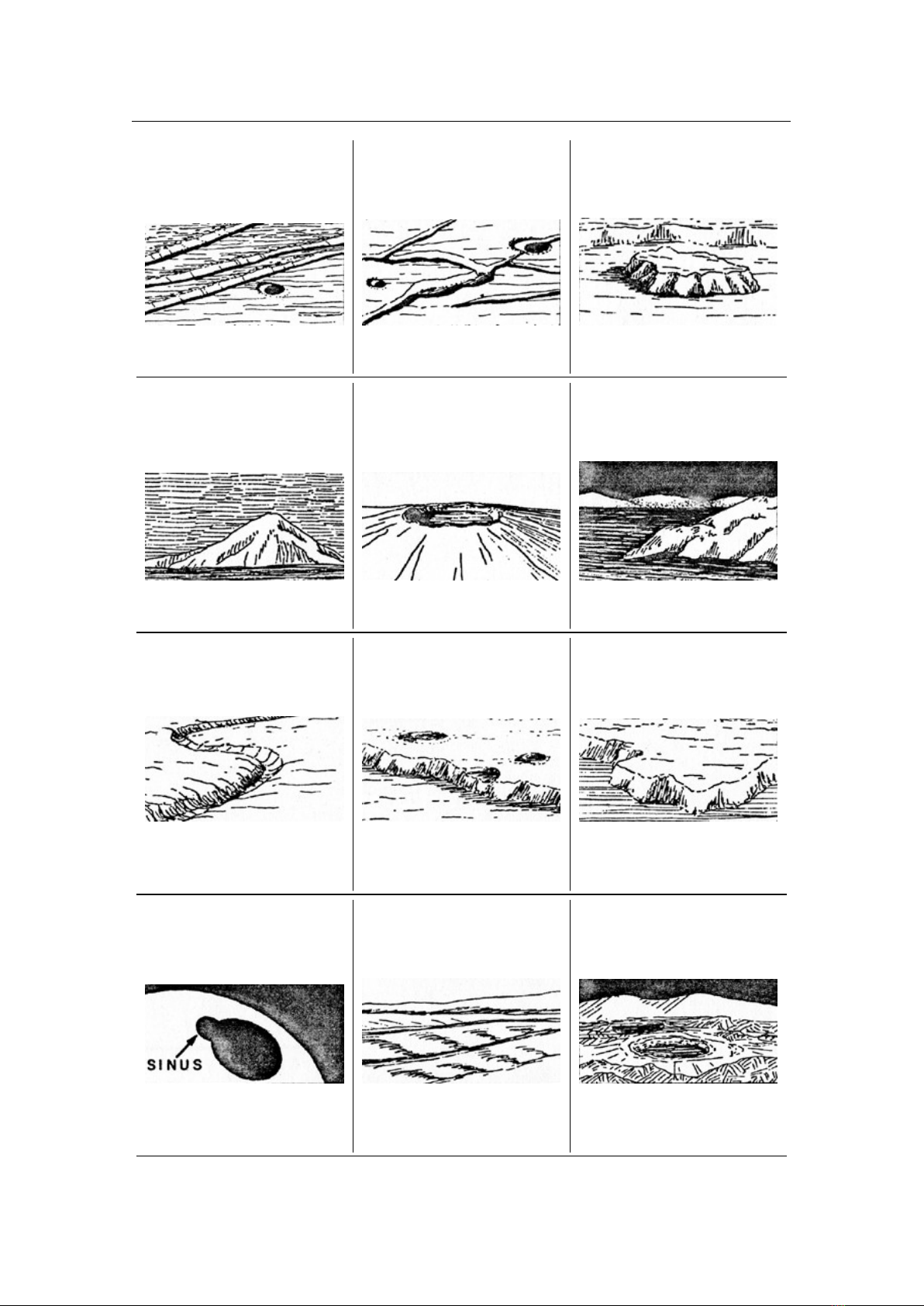
404 Appendix E. Planetary nomenclature
Fossa [FO] Labyrinthus [LB] Mensa [MN]
ditch; narrow linear trench
(on the Moon called Rima)
labyrinth; an expanse of inter-
secting canyon-like troughs
mesa; flat-topped elevation
with steep walls
Mons [MO] Patera [PE] Promontorium [PR]
mountain
“saucer”; shallow, complex
crater with scalloped walls
promontory; extension of lu-
nar mountains into mare
Rima [RI] Rupes [RU] Scopulus [SC]
channel; long narrow val-
ley, fissure or channel on the
Moon
linear scarp of cliff face
cliff; lobate or highly irregu-
lar scarp
Sinus [SI] Sulcus [SU] Terra [TA]
“bay”; semi-enclosed dark
area opening into a mare on
the Moon
complex area of sub-parallel
furrows and ridges
uplands or highlands
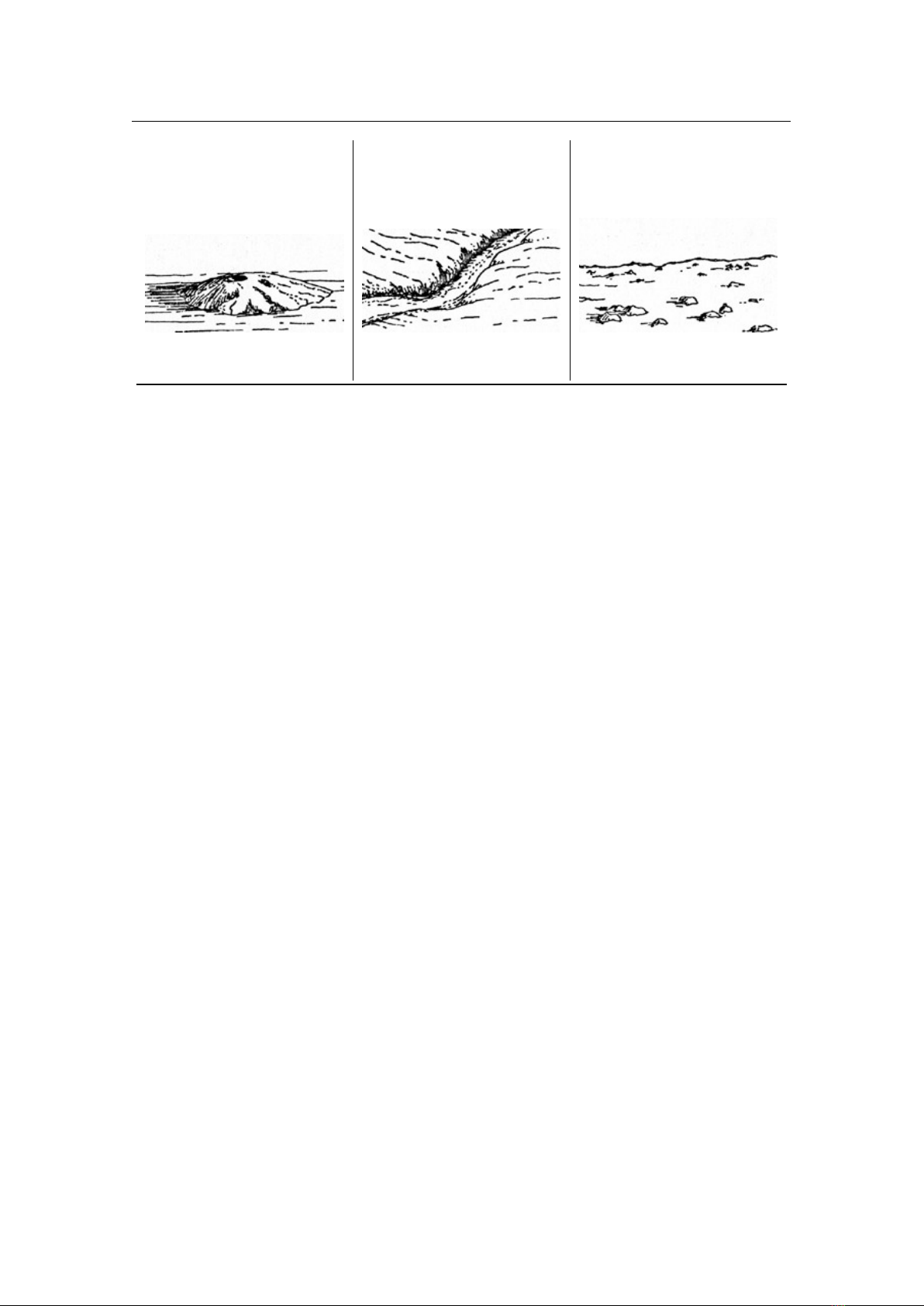
E.6 Descriptor terms (feature types) 405
Tholus [TH] Vallis [VA] Vastitas [VS]
dome; isolated domical moun-
tain or hill
valley; canyon-like, often sin-
uous trough
“wasteland”; extensive plains
of lowlands, only on Mars
Author and Acknowledgement
The nomenclature feature has been implemented by Teresa Huertas Roldán supported by the “ESA
Summer of Code in Space 2017” programme.

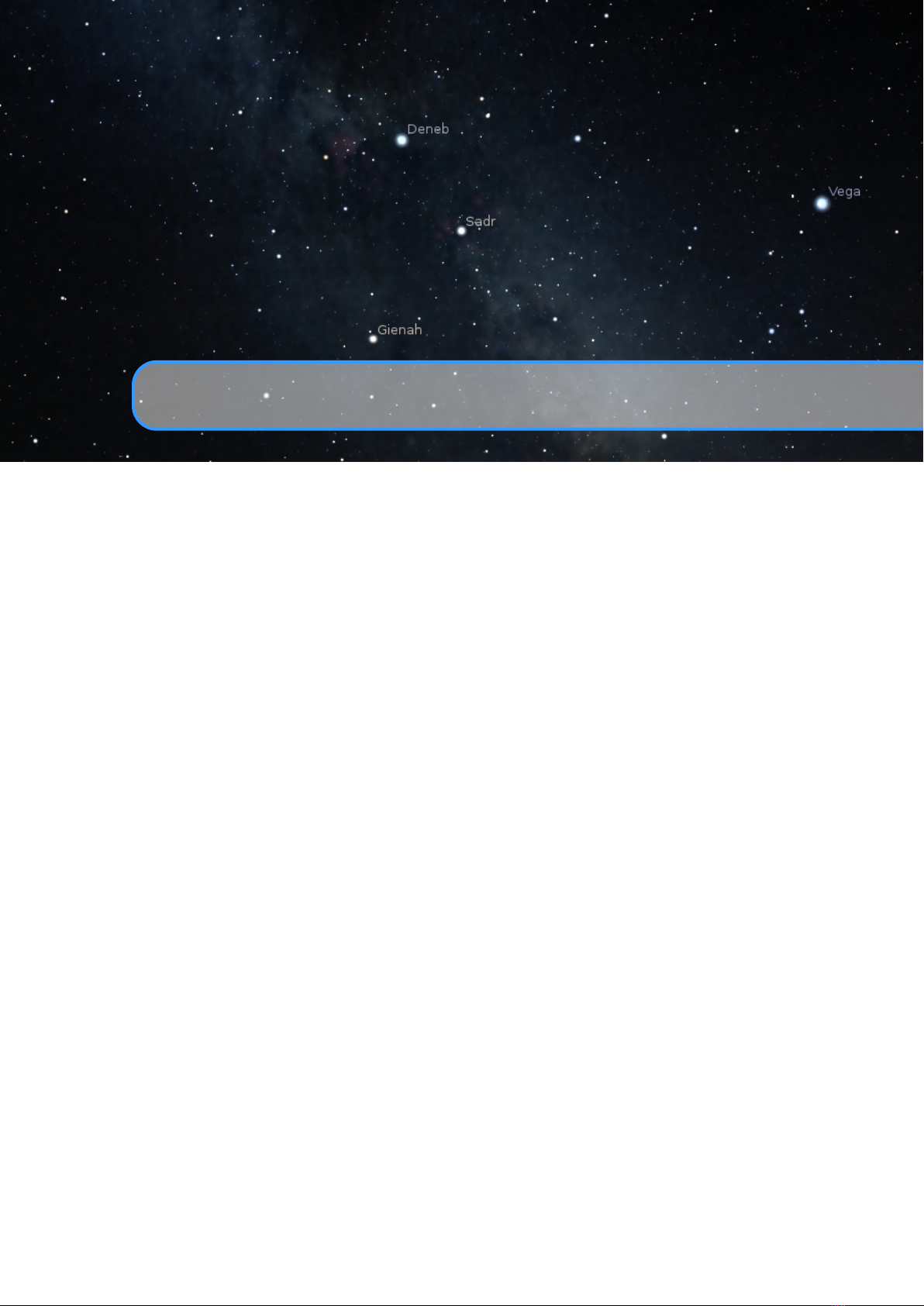
F. Accuracy
Stellarium originally was developed to present a beautiful simulation of the night sky, mostly to
understand what is visible in the sky when you leave your house, i.e., for present times. To save
computation time, some concessions were made in astronomical accuracy by using simplified
models which seemed acceptable at that time which was also close to the standard epoch of J2000.0.
However, time is progressing, precession becomes noticeable when pointing telescopes to J2000.0
coordinates, and some users also started to overstress Stellarium’s capabilities to simulate the
historical sky of many centuries in the past, and found — or even worse: did not find, but simply
published — the resulting inconsistencies and errors. Unfortunately, celestial motions are indeed
more complicated than a simple clockwork, and the process of retrofitting detailed and accurate
models which started around v0.11.0 (in 2011) has only recently (2021) come to a state where we as
developers are beginning to be satisfied. Now, after implementation of annual aberration, Stellarium
appears to deviate from reference solutions in the present time only by fractions of arcseconds,
and by a few arcseconds in the remote past. Greater accuracy, including relativistic effects or the
deflection of light by the Solar gravity field, may still be required for critical observations of stellar
occultations by asteroids, grazing occultations of stars by the Moon or similar things. Stellarium
does not compute these effects, and is definitely not capable for detailed planning of your spacecraft
missions to the planets. There are more specialized programs for these topics, please use them.
Therefore, when using Stellarium for scientific work like eclipse simulation to illustrate records
found in Cuneiform tablets, always also use some other reference to compare, and of course specify
the program version you used for your work. (Use at least version 0.21.2 of Stellarium!) You can
of course contact us if you bring a solid background in fundamental astronomy and are willing and
able to help improving Stellarium’s accuracy even further!
F.1 Date Range
The calendar dates are limited to a very wide interval of years, -100.000. . . 100.000. This is mostly
useful to visualize the effect of stellar proper motions or the wobbling motion of Earth’s axis known
as precession. If you observe the other planets, this is way beyond what current models are able to

408 Appendix F. Accuracy
show! Observe for example the Moon: you will find that it seems to run on a polar orbit around
+78.000 and even retrograde on a highly elongated orbit a few millennia after that. This is obvious
nonsense, caused by extrapolating mathematical models in inappropriate ways.
F.2 Stellar Proper Motion
Even though you can follow stellar proper motion for tens of thousands of years, please note that
the computation only takes the linear components
∆α
,
∆δ
into account. For times far from today,
a true 3D computation would be required, so that also changes in distance (and thus, brightness)
could be simulated. Still, the simulation here should give a good impression which close and/or
fast stars will move over time, and thus how constellations become deformed.
Note that due to the way the stars are stored in catalogs, zooming in on fast stars like Arcturus
may even cease to display such stars when their original area in the sky is no longer in view.
Also, binary stars seem to break apart because Stellarium does not store them as systems
revolving about their combined center of gravity.
These known deficits were also identified in a recent study (De Lorenzis and Orofino, 2018),
which emphasized errors with Arcturus, Dubhe, Sirius, Toliman and Vega which already deviate
noticeably from their correct locations around 2500BC. If you need accurate stellar positions for
earlier prehistory from a free and open-source program, it seems only Cartes du Ciel currently can
be recommended as on a par with the best available solutions.
F.3 Planetary Positions
Stellarium uses by default the widespread VSOP87 theory (P. Bretagnon and Francou, 1988)
to calculate the positions of the planets over time. This is an analytical ephemeris modeled to
match the numerical integration run DE200 from NASA JPL, which by itself gives positions for
1850. . . 2050. Its use is recommended for the years
−4000... + 8000
. You can observe the sun
leaving the “ecliptic of date” and running on the “ecliptic J2000” outside this date range. This is
obviously a mathematical trick to keep continuity. Still, positions may be somewhat useful outside
this range, but don’t expect anything reliable 50,000 years in the past!
The optionally usable JPL DE431 and DE441 (see 5.5.3) deliver planet positions strictly for
-13000. . . +17000 only, and nothing outside, but likely with higher accuracy. Outside of this range,
positions from VSOP87 will be shown again.
As far as Stellarium is concerned, the user should bear in mind the limits of the VSOP87 and
other models (Table F.1). Accuracy values for VSOP87 are heliocentric as given by P. Bretagnon
and Francou (1988).
F.4 Minor Bodies
Positions for the Minor Bodies (Dwarf Planets, Asteroids, Comets) are computed with standard
algorithms found in astronomical text books. The generally used method of orbital elements allows
to compute the positions of the respective object on an undisturbed Kepler orbit around the sun.
However, gravitational, and in the case of comets, non-gravitational (outgassing) disturbances slowly
change these orbital elements. Therefore an epoch is given for such elements, and computation of
positions for times far from this epoch will lead to positional errors. Therefore, when searching for
asteroids or comets, always update your orbital elements (See section 13.8), and use elements with
an epoch as close to your time of observation as possible! Stellarium does not simulate gravitational
perturbances and orbital changes of minor bodies passing major planets.

F.5 Precession and Nutation 409
Object(s) Method Notes
Mercury, Venus, Earth-Moon
barycenter, Mars
VSOP87
Accuracy is 1 arc-second from
2000 B.C. – 6000 A.D.
Jupiter, Saturn VSOP87
Accuracy is 1 arc-second from 0
A.D. – 4000 A.D.
Uranus, Neptune VSOP87
Accuracy is 1 arc-second from
4000 B.C. – 8000 A.D.
Pluto ?
Pluto’s position is valid only from
1885 A.D. – 2099 A.D.
Earth’s Moon ELP2000-82B
Fit against JPL DE200, which pro-
vides date range 1850–2050. Po-
sitions should be usable for some
(unspecified) longer interval.
Galilean satellites L2
Valid from 500 A.D. – 3500 A.D.
Table F.1: Orbit-centric accuracy of used algorithms
F.5 Precession and Nutation
Since v0.14.0, Stellarium computes the orientation of earth’s axis according to the IAU2006
Precession in a long-time variant developed by Vondrák, Capitaine, and Wallace (2011) and Vondrák,
Capitaine, and Wallace (2012), and IAU2000B Nutation (McCarthy and Luzum, 2003). This also
now allows proper depiction of the changes in ecliptic obliquity and display of “instantaneous
precession circles” around the ecliptic poles. These circles are indeed varying according to ecliptical
obliquity. Nutation is only computed for about 6000 years around J2000.0. Nobody could have
observed it before 1609, and it is unclear for how long this model is applicable.
F.6 Planet Axes
Where available, Stellarium uses axis orientation and rotation data from the IAU Working Group
on Cartographic Coordinates and Rotational Elements (WGCCRE). Orientation for some small
moons is still simplified and based on the model originally available. (See section D.2.1)
F.7 Eclipses
The moon’s motion is very complicated, and eclipse computations can be tricky. One aspect which
every student of history, prehistory and archaeology should know but as it seems not every does,
is at least a basic understanding of the irregular slow-down of earth’s rotation known as
∆T
(see
section 18.4.3).
Eclipse records on cuneiform tablets go back to the 8th century BC, some Chinese records go
back a bit further. Experts on Earth rotation have provided models for
∆T
based on such observa-
tions. These are usually given as parabolic fit, with some recommended time span. Extrapolating
parabolic fits to erratic curves too far into the past is dangerous, pointless and inevitably leads to
errors or invalid results. Models differ by many hours (exceeding a whole day!) when applied too
far in the past. This means, there was certainly an eclipse, and latitude will be OK, but you cannot
say which longitude the eclipse was covering. The probability to have seen a total eclipse at a
certain interesting location will be very small and should by itself not be used as positive argument
for any reasonable statement. This is not a problem of Stellarium, but of current knowledge. To

410 Appendix F. Accuracy
repeat, you may find a solar eclipse in the 6th millennium BC, but you cannot even be sure which
side of Earth could have observed it!
WANTED: A model for ∆T that works in the Mesolithic!
F.8 The Calendar
Stellarium follows the widely accepted convention that dates before the Gregorian calendar reform
are given in the Julian calendar, introduced by JULIUS CAESAR in 46 BC. This calendar introduces
a leap day every fourth year, which is a bit too much. If you want to show summer solstice in
the year
−2500
, you will notice it is not on June 21st. This is not an error of Stellarium – the
Gregorian reform had a reason! In prehistoric times, it may be more useful to work with solar
ecliptic longitudes. For example, summer solstice is when the Sun is at λ = 90
◦
.
JULIUS CAESAR introduced a Solar calendar to the Roman empire in 46 BC but was assas-
sinated in March 44 BC=
−43
(see below). His simple 4-year leap rule was then misapplied by
the high priests of Rome by adding a leap day every third year. AUGUSTUS fixed the calendar by
omitting a few leap days, and only 8 AD was the first correctly applied leap year as we know them
(Ginzel, 1908, §186, §189). Be careful if you are working in Augustean and earlier times in the
Roman world, maybe even related to named dates in the pre-Julian Roman calendar: Stellarium,
also its Calendars plugin (see section 13.9) does not model these issues!
Some authors (esp. for Mesoamerican dates) give dates in the proleptic Gregorian calendar
(which means, they apply the Gregorian leap year rules before 1582). This is a convention, they
may of course do that, but you must do the conversion to the Julian calendar to visualize the sky
with Stellarium. If they also give Julian Day numbers (JD), you can use them with Stellarium as JD
numbers are independent from calendar systems. Else, you can utilize the Calendars plugin (see
section 13.9).
Some users have noted and expressed confusion about a difference of one between dates given
as BC (or BCE) versus Stellarium’s negative years. Note that historical chronology does not know
a year Zero! (Try to write this date in Roman numbers!) Year AD 1 (1 CE) was preceded by year
1 BC (1 BCE). Astronomers want to simplify computations and therefore use a year 0 (equivalent
to 1 BC). It is simple: 1 BC=
0
, 2 BC=
−1
, . . . 100 BC=
−99
(Fig. F.1). Stellarium is an astronomy
program and uses astronomical counting. Other programs may behave differently in this respect,
e.g. may even use negative signs to indicate years BC. However, the Calendars plugin (see section
13.9) even allows displaying both counting systems.
⇐= negative 0 positive =⇒
Astronomical . . . -3 -2 -1 0 1 2 3 . . .
Historical . . . 4 BC 3 BC 2 BC 1 BC AD 1 AD 2 AD 3 . . .
⇐= Before Christ After Christ =⇒
Figure F.1: Counting years around the beginning of the Common Era.
F.9 Comparison to Reference Data
Tables F.2 and F.3 provide comparison data between JPL Horizons
1
and Stellarium. The JPL data
were fetched in July 2021 by our attentive user Atque. These are apparent geocentric coordinates
provided by JPL’s solutions DE440/DE441 in J2000.0 equatorial coordinates, including JPL’s
corrections for nutation, light time, aberration, light deflection in the Solar gravity field, and other
1
https://ssd.jpl.nasa.gov/horizons.cgi
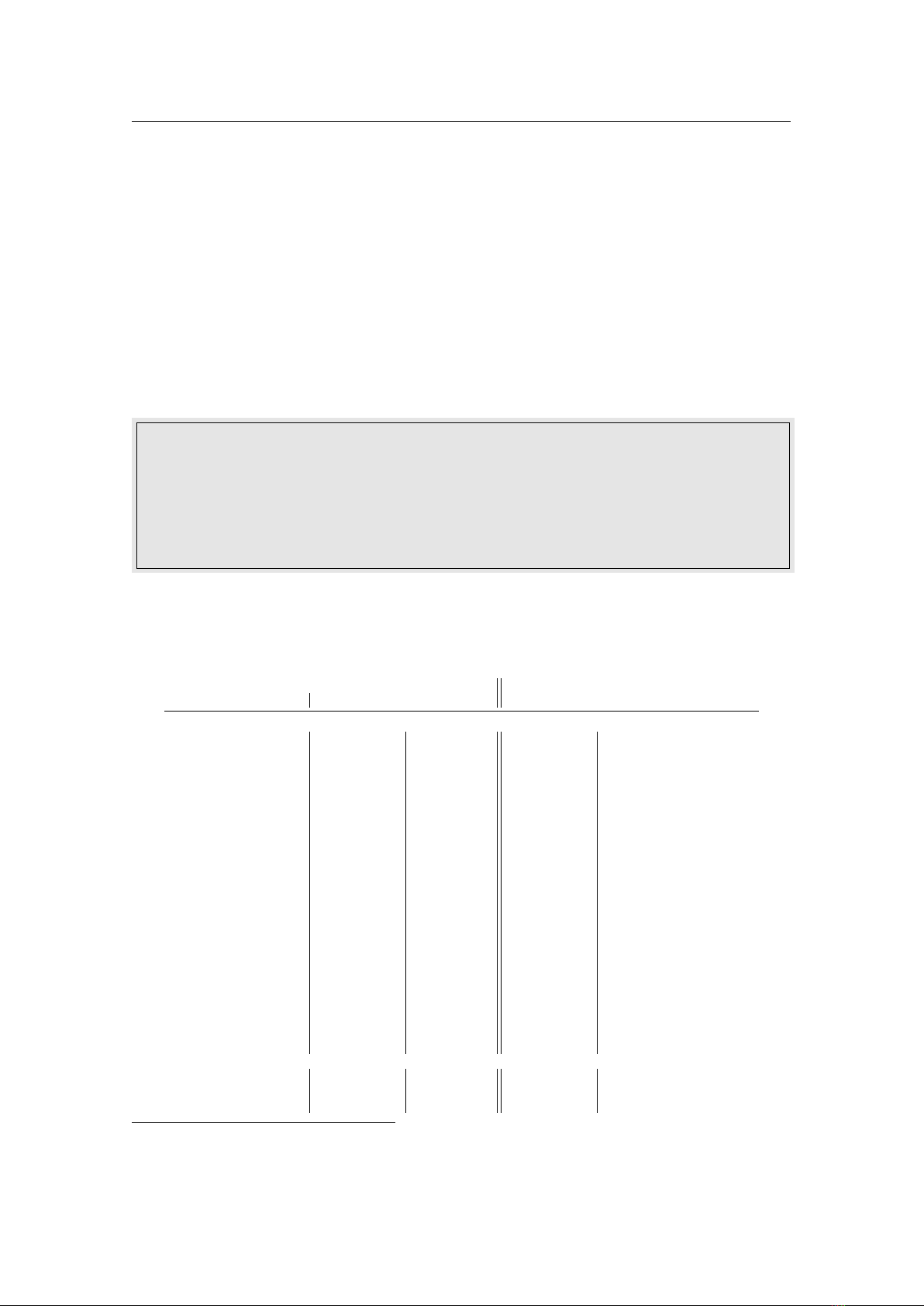
F.9 Comparison to Reference Data 411
relativistic effects. The right part provides the according values computed by Stellarium from
DE440/DE441 files, with the current state of corrections for nutation, light time and aberration.
The
∆T
model was set to “JPL Horizons”, but when using DE* files a slightly different model
specialized to the DE ephemeris is used
2
, resulting in differences in the effective value of
∆T
.
Among the causes for differences we must take into account:
•
Stellarium does not provide corrections for diurnal aberration (should not matter for geocen-
tric positions)
• Stellarium does not provide corrections for light deflection in the Sun’s gravitational field
• JPL Horizons uses slightly different models than Stellarium for precession and nutation
3
The first item should not make a difference. The next two may cause differences in the range of a
few arcseconds. The apparent drift that we can observe in the remote past may stem from different
assumptions regarding ∆T (see 18.4.3) or from other reasons yet to be identified. Competent help
welcome!
WANTED
If you can trace down hitherto unknown reasons for remaining inaccuracies and either provide a
fix or a decisive hint to us, we can offer a reward in the EUR200–500 range from our donation
fund. We, the developers, will judge and evaluate relevance, legal recourse is excluded.
Table F.2: An ephemeris comparison between Stellarium and JPL Horizons. Both are
showing geocentric apparent coordinates from the JPL DE440/441 ephemerides (with
slightly different models for precession, nutation and aberration; JPL results are also
corrected for light deflection). While results for present times agree very well, results
for the past seem to diverge a bit, presumably caused by differences in ∆T handling.
JPL Horizons (DE440/441) Stellarium 0.21.2β
UT Date Time RA J2000.0 DE J2000.0 α
J2000.0
δ
J2000.0
∆T
SUN
b2500-Jan-01 00:00 17h 24m 24.70s -23
◦
43’ 11.8” 17h 24m 23.52s -23
◦
43’ 13.2” 57938.45s
b2500-Jun-02 00:00 03h 06m 17.57s +17
◦
54’ 00.7” 03h 06m 16.61s +17
◦
53’ 58.6” 57927.29s
b2500-Nov-01 00:00 13h 11m 48.12s -07
◦
48’ 17.2” 13h 11m 47.07s -07
◦
48’ 11.5” 57916.12s
b2499-Apr-02 00:00 23h 26m 28.14s -03
◦
42’ 34.9” 23h 26m 27.30s -03
◦
42’ 40.9” 57904.96s
b0500-Jan-01 00:00 18h 25m 28.83s -23
◦
37’ 22.2” 18h 25m 28.82s -23
◦
37’ 23.4” 16704.77s
b0500-Jun-02 00:00 04h 09m 13.48s +21
◦
17’ 20.8” 04h 09m 13.50s +21
◦
17’ 21.9” 16698.78s
b0500-Nov-01 00:00 14h 04m 26.18s -12
◦
48’ 35.8” 14h 04m 26.15s -12
◦
48’ 36.3” 16692.79s
b0499-Apr-02 00:00 00h 21m 10.51s +02
◦
19’ 31.0” 00h 21m 10.52s +02
◦
19’ 31.1” 16686.79s
0500-Jan-01 00:00 18h 53m 06.08s -23
◦
04’ 11.0” 18h 53m 06.04s -23
◦
04’ 11.8” 5413.20s
0500-Jun-01 00:00 04h 39m 16.40s +22
◦
19’ 46.7” 04h 39m 16.39s +22
◦
19’ 47.4” 5409.79s
0500-Oct-31 00:00 14h 29m 26.81s -14
◦
52’ 19.2” 14h 29m 26.77s -14
◦
52’ 19.5” 5406.38s
0501-Apr-01 00:00 00h 46m 23.08s +05
◦
01’ 37.5” 00h 46m 23.07s +05
◦
01’ 37.6” 5402.97s
0501-Aug-31 00:00 10h 41m 17.14s +08
◦
22’ 56.8” 10h 41m 17.14s +08
◦
22’ 57.2” 5399.56s
1600-Jan-01 00:00 18h 43m 28.07s -23
◦
06’ 56.6” 18h 43m 28.33s -23
◦
06’ 56.5” 141.31s
1600-Jun-01 00:00 04h 35m 37.18s +22
◦
04’ 25.0” 04h 35m 37.43s +22
◦
04’ 25.6” 140.84s
1600-Oct-31 00:00 14h 21m 56.45s -14
◦
09’ 38.9” 14h 21m 56.68s -14
◦
09’ 40.1” 140.37s
1601-Apr-01 00:00 00h 41m 18.48s +04
◦
27’ 19.4” 00h 41m 18.70s +04
◦
27’ 20.8” 139.90s
1601-Aug-31 00:00 10h 36m 30.29s +08
◦
48’ 10.8” 10h 36m 30.52s +08
◦
48’ 09.6” 139.44s
2021-Jan-01 00:00 18h 46m 53.59s -22
◦
59’ 57.2” 18h 46m 53.59s -22
◦
59’ 57.2” 65.79s
2021-Jun-02 00:00 04h 40m 40.91s +22
◦
11’ 09.1” 04h 40m 40.90s +22
◦
11’ 09.1” 66.11s
2021-Nov-01 00:00 14h 25m 34.78s -14
◦
25’ 31.0” 14h 25m 34.78s -14
◦
25’ 30.9” 66.43s
2022-Apr-02 00:00 00h 45m 00.07s +04
◦
50’ 03.8” 00h 45m 00.07s +04
◦
50’ 03.7” 66.76s
MERCURY
b2500-Jan-01 00:00 17h 07m 28.00s -25
◦
22’ 36.2” 17h 07m 24.54s -25
◦
22’ 33.7” 57938.45s
b2500-Jun-02 00:00 04h 57m 29.05s +22
◦
59’ 25.2” 04h 57m 28.40s +22
◦
59’ 34.3” 57927.29s
b2500-Nov-01 00:00 11h 56m 15.20s +03
◦
10’ 47.5” 11h 56m 14.50s +03
◦
10’ 55.1” 57916.12s
2
For experts: The value for secular acceleration of the Moon in ELP2000-82B,
˙n = −23.8946
, is replaced
by ˙n = −25.8.
3
https://ssd.jpl.nasa.gov/?horizons_doc#specific_quantities

412 Appendix F. Accuracy
JPL Horizons (DE440/441) Stellarium 0.21.2β
UT Date Time RA J2000.0 DE J2000.0 α
J2000.0
δ
J2000.0
∆T
b2499-Apr-02 00:00 23h 03m 07.53s -07
◦
14’ 26.7” 23h 03m 04.03s -07
◦
14’ 56.6” 57904.96s
b0500-Jan-01 00:00 18h 40m 28.21s -25
◦
26’ 38.0” 18h 40m 27.54s -25
◦
26’ 40.0” 16704.77s
b0500-Jun-02 00:00 05h 38m 48.42s +22
◦
19’ 54.2” 05h 38m 49.11s +22
◦
19’ 58.7” 16698.78s
b0500-Nov-01 00:00 12h 56m 45.19s -03
◦
57’ 14.5” 12h 56m 44.96s -03
◦
57’ 12.2” 16692.79s
b0499-Apr-02 00:00 00h 21m 09.78s +01
◦
53’ 27.6” 00h 21m 08.99s +01
◦
53’ 20.6” 16686.79s
0500-Jan-01 00:00 18h 23m 39.86s -25
◦
14’ 04.0” 18h 23m 39.46s -25
◦
14’ 04.4” 5413.20s
0500-Jun-01 00:00 06h 29m 34.30s +24
◦
32’ 58.8” 06h 29m 34.21s +24
◦
33’ 00.8” 5409.79s
0500-Oct-31 00:00 13h 28m 10.47s -06
◦
51’ 07.8” 13h 28m 10.93s -06
◦
51’ 11.8” 5406.38s
0501-Apr-01 00:00 23h 55m 15.72s -02
◦
45’ 50.1” 23h 55m 15.30s -02
◦
45’ 53.7” 5402.97s
0501-Aug-31 00:00 12h 03m 40.27s -01
◦
48’ 53.7” 12h 03m 40.10s -01
◦
48’ 51.4” 5399.56s
1600-Jan-01 00:00 19h 16m 55.37s -24
◦
27’ 04.8” 19h 16m 55.69s -24
◦
27’ 04.5” 141.31s
1600-Jun-01 00:00 05h 27m 00.75s +22
◦
06’ 49.9” 05h 27m 00.88s +22
◦
06’ 49.8” 140.84s
1600-Oct-31 00:00 13h 24m 30.87s -06
◦
45’ 17.1” 13h 24m 31.13s -06
◦
45’ 18.8” 140.37s
1601-Apr-01 00:00 00h 45m 30.34s +03
◦
58’ 05.0” 00h 45m 30.64s +03
◦
58’ 07.2” 139.90s
1601-Aug-31 00:00 12h 08m 26.65s -04
◦
19’ 14.8” 12h 08m 26.83s -04
◦
19’ 16.2” 139.44s
2021-Jan-01 00:00 19h 17m 59.43s -24
◦
20’ 58.1” 19h 17m 59.41s -24
◦
20’ 58.2” 65.79s
2021-Jun-02 00:00 05h 35m 35.59s +22
◦
40’ 50.7” 05h 35m 35.59s +22
◦
40’ 50.7” 66.11s
2021-Nov-01 00:00 13h 25m 55.55s -06
◦
47’ 18.8” 13h 25m 55.54s -06
◦
47’ 18.7” 66.43s
2022-Apr-02 00:00 00h 43m 05.35s +03
◦
21’ 44.7” 00h 43m 05.34s +03
◦
21’ 44.7” 66.76s
VENUS
b2500-Jan-01 00:00 14h 38m 40.01s -10
◦
33’ 46.3” 14h 38m 40.01s -10
◦
33’ 46.8” 57938.45s
b2500-Jun-02 00:00 01h 31m 36.91s +08
◦
30’ 50.3” 01h 31m 35.42s +08
◦
30’ 41.0” 57927.29s
b2500-Nov-01 00:00 14h 04m 33.57s -13
◦
23’ 07.7” 14h 04m 31.93s -13
◦
22’ 58.4” 57916.12s
b2499-Apr-02 00:00 02h 07m 22.90s +16
◦
14’ 49.7” 02h 07m 21.78s +16
◦
14’ 43.3” 57904.96s
b0500-Jan-01 00:00 15h 15m 48.26s -13
◦
58’ 19.4” 15h 15m 48.35s -13
◦
58’ 20.3” 16704.77s
b0500-Jun-02 00:00 02h 41m 50.72s +14
◦
49’ 02.0” 02h 41m 50.54s +14
◦
49’ 01.5” 16698.78s
b0500-Nov-01 00:00 15h 14m 41.57s -18
◦
52’ 17.3” 15h 14m 41.35s -18
◦
52’ 16.9” 16692.79s
b0499-Apr-02 00:00 03h 10m 27.71s +21
◦
27’ 17.2” 03h 10m 27.72s +21
◦
27’ 17.6” 16686.79s
0500-Jan-01 00:00 20h 18m 43.11s -15
◦
30’ 09.1” 20h 18m 43.83s -15
◦
30’ 09.4” 5413.20s
0500-Jun-01 00:00 02h 11m 10.44s +11
◦
10’ 10.0” 02h 11m 10.33s +11
◦
10’ 09.7” 5409.79s
0500-Oct-31 00:00 14h 33m 32.68s -14
◦
39’ 03.4” 14h 33m 32.50s -14
◦
39’ 02.8” 5406.38s
0501-Apr-01 00:00 03h 03m 13.09s +18
◦
47’ 05.5” 03h 03m 12.97s +18
◦
47’ 05.1” 5402.97s
0501-Aug-31 00:00 09h 10m 52.83s +08
◦
18’ 44.4” 09h 10m 53.44s +08
◦
18’ 40.8” 5399.56s
1600-Jan-01 00:00 17h 09m 26.57s -18
◦
08’ 55.1” 17h 09m 26.71s -18
◦
08’ 55.3” 141.31s
1600-Jun-01 00:00 02h 28m 53.12s +12
◦
50’ 48.1” 02h 28m 53.37s +12
◦
50’ 49.4” 140.84s
1600-Oct-31 00:00 14h 54m 13.53s -16
◦
15’ 03.3” 14h 54m 13.79s -16
◦
15’ 04.6” 140.37s
1601-Apr-01 00:00 03h 18m 37.64s +20
◦
06’ 01.5” 03h 18m 37.90s +20
◦
06’ 02.6” 139.90s
1601-Aug-31 00:00 07h 48m 52.93s +16
◦
06’ 13.5” 07h 48m 53.14s +16
◦
06’ 13.3” 139.44s
2021-Jan-01 00:00 17h 18m 28.43s -22
◦
26’ 01.6” 17h 18m 28.42s -22
◦
26’ 01.5” 65.79s
2021-Jun-02 00:00 05h 57m 01.46s +24
◦
21’ 39.2” 05h 57m 01.45s +24
◦
21’ 39.2” 66.11s
2021-Nov-01 00:00 17h 40m 41.73s -27
◦
05’ 05.3” 17h 40m 41.73s -27
◦
05’ 05.3” 66.43s
2022-Apr-02 00:00 21h 52m 25.36s -12
◦
04’ 41.5” 21h 52m 25.35s -12
◦
04’ 41.5” 66.76s
MOON
b2500-Jan-01 00:00 00h 13m 40.60s -00
◦
43’ 59.3” 00h 13m 13.41s -00
◦
47’ 44.2” 57938.45s
b2500-Jun-02 00:00 12h 48m 51.83s -04
◦
50’ 11.6” 12h 48m 20.00s -04
◦
45’ 50.3” 57927.29s
b2500-Nov-01 00:00 02h 49m 20.95s +19
◦
57’ 17.4” 02h 48m 49.83s +19
◦
54’ 22.0” 57916.12s
b2499-Apr-02 00:00 15h 45m 48.47s -25
◦
00’ 31.4” 15h 45m 11.61s -24
◦
58’ 11.1” 57904.96s
b0500-Jan-01 00:00 02h 14m 28.99s +14
◦
10’ 37.4” 02h 14m 20.11s +14
◦
10’ 05.8” 16704.77s
b0500-Jun-02 00:00 15h 02m 34.83s -16
◦
05’ 08.5” 15h 02m 24.07s -16
◦
04’ 39.3” 16698.78s
b0500-Nov-01 00:00 05h 18m 41.70s +19
◦
00’ 42.7” 05h 18m 32.17s +19
◦
00’ 41.6” 16692.79s
b0499-Apr-02 00:00 18h 10m 41.75s -18
◦
33’ 49.1” 18h 10m 31.22s -18
◦
33’ 56.3” 16686.79s
0500-Jan-01 00:00 05h 33m 09.71s +28
◦
18’ 25.7” 05h 33m 02.93s +28
◦
18’ 25.0” 5413.20s
0500-Jun-01 00:00 19h 39m 46.24s -24
◦
36’ 20.7” 19h 39m 38.25s -24
◦
36’ 48.8” 5409.79s
0500-Oct-31 00:00 08h 41m 09.22s +19
◦
42’ 14.7” 08h 41m 03.32s +19
◦
42’ 46.3” 5406.38s
0501-Apr-01 00:00 22h 26m 23.71s -07
◦
51’ 05.2” 22h 26m 17.20s -07
◦
51’ 54.1” 5402.97s
0501-Aug-31 00:00 11h 28m 24.37s -00
◦
41’ 25.5” 11h 28m 19.05s -00
◦
40’ 44.2” 5399.56s
1600-Jan-01 00:00 07h 04m 55.02s +24
◦
04’ 37.3” 07h 04m 56.39s +24
◦
04’ 33.9” 141.31s
1600-Jun-01 00:00 19h 54m 15.59s -20
◦
26’ 36.3” 19h 54m 16.89s -20
◦
26’ 31.4” 140.84s
1600-Oct-31 00:00 10h 11m 24.53s +07
◦
13’ 09.4” 10h 11m 25.66s +07
◦
13’ 02.2” 140.37s
1601-Apr-01 00:00
22h 46m 21.63s -02
◦
54’ 30.7” 22h 46m 22.87s -02
◦
54’ 22.4” 139.90s
1601-Aug-31 00:00 12h 52m 10.20s -10
◦
52’ 36.0” 12h 52m 11.39s -10
◦
52’ 43.0” 139.44s
2021-Jan-01 00:00 08h 23m 36.67s +23
◦
01’ 21.2” 08h 23m 36.54s +23
◦
01’ 21.5” 65.79s
2021-Jun-02 00:00 22h 46m 54.03s -13
◦
27’ 21.8” 22h 46m 53.93s -13
◦
27’ 22.4” 66.11s
2021-Nov-01 00:00 11h 18m 43.58s +09
◦
57’ 42.8” 11h 18m 43.49s +09
◦
57’ 43.4” 66.43s
2022-Apr-02 00:00 01h 21m 51.21s +05
◦
40’ 00.7” 01h 21m 51.14s +05
◦
40’ 00.1” 66.76s
MARS
1601-Jan-01 00:00 19h 26m 56.21s -23
◦
01’ 42.7” 19h 26m 56.45s -23
◦
01’ 42.4” 140.18s
1601-Jun-02 00:00 02h 59m 06.93s +16
◦
41’ 21.5” 02h 59m 07.15s +16
◦
41’ 22.6” 139.71s

F.9 Comparison to Reference Data 413
JPL Horizons (DE440/441) Stellarium 0.21.2β
UT Date Time RA J2000.0 DE J2000.0 α
J2000.0
δ
J2000.0
∆T
1601-Nov-01 00:00 09h 48m 48.55s +15
◦
01’ 38.0” 09h 48m 48.75s +15
◦
01’ 37.2” 139.25s
1602-Apr-02 00:00 10h 25m 38.57s +13
◦
17’ 29.7” 10h 25m 38.70s +13
◦
17’ 29.0” 138.78s
2021-Jan-01 00:00 01h 40m 18.14s +11
◦
20’ 41.2” 01h 40m 18.14s +11
◦
20’ 41.1” 65.79s
2021-Jun-02 00:00 07h 45m 03.73s +22
◦
37’ 21.0” 07h 45m 03.72s +22
◦
37’ 21.0” 66.11s
2021-Nov-01 00:00 13h 55m 54.00s -11
◦
22’ 08.1” 13h 55m 54.00s -11
◦
22’ 08.1” 66.43s
2022-Apr-02 00:00 21h 31m 33.53s -15
◦
56’ 58.5” 21h 31m 33.53s -15
◦
56’ 58.5” 66.76s
JUPITER
1601-Jan-01 00:00 11h 33m 23.43s +04
◦
18’ 09.3” 11h 33m 23.58s +04
◦
18’ 08.4” 140.18s
1601-Jun-02 00:00 10h 59m 49.52s +07
◦
52’ 18.0” 10h 59m 49.67s +07
◦
52’ 17.1” 139.71s
1601-Nov-01 00:00 12h 39m 41.32s -03
◦
02’ 14.3” 12h 39m 41.47s -03
◦
02’ 15.3” 139.25s
1602-Apr-02 00:00 13h 08m 44.17s -05
◦
35’ 33.6” 13h 08m 44.30s -05
◦
35’ 34.4” 138.78s
2021-Jan-01 00:00 20h 20m 44.62s -20
◦
00’ 44.3” 20h 20m 44.62s -20
◦
00’ 44.4” 65.79s
2021-Jun-02 00:00 22h 15m 51.65s -11
◦
42’ 45.3” 22h 15m 51.65s -11
◦
42’ 45.3” 66.11s
2021-Nov-01 00:00 21h 41m 29.27s -15
◦
01’ 08.9” 21h 41m 29.27s -15
◦
01’ 08.9” 66.43s
2022-Apr-02 00:00 23h 30m 29.23s -04
◦
17’ 08.2” 23h 30m 29.24s -04
◦
17’ 08.2” 66.76s
SATURN
1750-Jan-01 00:00 15h 46m 12.27s -17
◦
54’ 37.7” 15h 46m 12.37s -17
◦
54’ 38.1” 22.71s
1750-Jun-02 00:00 15h 44m 23.78s -17
◦
34’ 00.9” 15h 44m 23.87s -17
◦
34’ 01.3” 22.52s
1750-Nov-01 00:00 15h 59m 19.00s -18
◦
50’ 41.0” 15h 59m 19.10s -18
◦
50’ 41.4” 22.34s
1751-Apr-02 00:00 16h 49m 11.72s -20
◦
39’ 30.2” 16h 49m 11.82s -20
◦
39’ 30.5” 22.15s
2021-Jan-01 00:00 20h 15m 50.41s -20
◦
10’ 28.7” 20h 15m 50.41s -20
◦
10’ 28.7” 65.79s
2021-Jun-02 00:00 21h 04m 25.24s -17
◦
24’ 46.6” 21h 04m 25.24s -17
◦
24’ 46.6” 66.11s
2021-Nov-01 00:00 20h 39m 27.72s -19
◦
14’ 59.7” 20h 39m 27.72s -19
◦
14’ 59.7” 66.43s
2022-Apr-02 00:00 21h 39m 14.50s -15
◦
01’ 42.2” 21h 39m 14.50s -15
◦
01’ 42.2” 66.76s
URANUS
1600-Jan-01 00:00 01h 41m 51.34s +10
◦
01’ 26.1” 01h 41m 51.49s +10
◦
01’ 26.9” 141.31s
1600-Jun-01 00:00 02h 05m 21.58s +12
◦
13’ 45.6” 02h 05m 21.73s +12
◦
13’ 46.4” 140.84s
1600-Oct-31 00:00 02h 04m 09.95s +12
◦
05’ 39.9” 02h 04m 10.09s +12
◦
05’ 40.7” 140.37s
1601-Apr-01 00:00 02h 07m 08.63s +12
◦
25’ 31.5” 02h 07m 08.78s +12
◦
25’ 32.4” 139.90s
1601-Aug-31 00:00 02h 28m 09.10s +14
◦
11’ 23.3” 02h 28m 09.24s +14
◦
11’ 24.1” 139.44s
2021-Jan-01 00:00 02h 18m 27.82s +13
◦
21’ 27.5” 02h 18m 27.83s +13
◦
21’ 27.5” 65.79s
2021-Jun-02 00:00 02h 40m 37.83s +15
◦
11’ 44.7” 02h 40m 37.84s +15
◦
11’ 44.7” 66.11s
2021-Nov-01 00:00 02h 42m 31.60s +15
◦
19’ 13.5” 02h 42m 31.60s +15
◦
19’ 13.5” 66.43s
2022-Apr-02 00:00 02h 42m 25.31s +15
◦
22’ 19.7” 02h 42m 25.31s +15
◦
22’ 19.7” 66.76s
NEPTUNE
1801-Jan-01 00:00 15h 07m 04.41s -15
◦
44’ 47.2” 15h 07m 04.49s -15
◦
44’ 47.6” 5.51s
1801-Jun-02 00:00 15h 01m 57.08s -15
◦
18’ 05.9” 15h 01m 57.15s -15
◦
18’ 06.2” 5.42s
1801-Nov-01 00:00 15h 07m 02.36s -15
◦
46’ 26.5” 15h 07m 02.43s -15
◦
46’ 26.9” 5.33s
1802-Apr-02 00:00 15h 17m 01.46s -16
◦
20’ 15.8” 15h 17m 01.54s -16
◦
20’ 16.2” 5.24s
2021-Jan-01 00:00 23h 19m 18.38s -05
◦
33’ 12.4” 23h 19m 18.39s -05
◦
33’ 12.4” 65.79s
2021-Jun-02 00:00 23h 36m 13.26s -03
◦
46’ 42.9” 23h 36m 13.26s -03
◦
46’ 42.9” 66.11s
2021-Nov-01 00:00 23h 27m 30.35s -04
◦
46’ 19.7” 23h 27m 30.35s -04
◦
46’ 19.7” 66.43s
2022-Apr-02 00:00 23h 38m 17.59s -03
◦
34’ 19.0” 23h 38m 17.59s -03
◦
34’ 19.0” 66.76s
IO(JI)
1601-Jan-01 00:00 11h 33m 30.36s +04
◦
17’ 19.7” 11h 33m 30.51s +04
◦
17’ 18.9” 140.18s
1601-Jun-02 00:00 10h 59m 55.45s +07
◦
51’ 35.7” 10h 59m 55.61s +07
◦
51’ 34.8” 139.71s
1601-Nov-01 00:00 12h 39m 41.63s -03
◦
02’ 20.8” 12h 39m 41.81s -03
◦
02’ 22.0” 139.25s
1602-Apr-02 00:00 13h 08m 39.94s -05
◦
35’ 12.3” 13h 08m 40.11s -05
◦
35’ 13.4” 138.78s
2021-Jan-01 00:00 20h 20m 41.43s -20
◦
00’ 57.7” 20h 20m 41.43s -20
◦
00’ 57.7” 65.79s
2021-Jun-02 00:00 22h 15m 44.01s -11
◦
43’ 33.2” 22h 15m 44.01s -11
◦
43’ 33.2” 66.11s
2021-Nov-01 00:00 21h 41m 21.65s -15
◦
01’ 52.3” 21h 41m 21.65s -15
◦
01’ 52.3” 66.43s
2022-Apr-02 00:00 23h 30m 27.92s -04
◦
17’ 20.4” 23h 30m 27.93s -04
◦
17’ 20.4” 66.76s
EUROPA(JII)
1601-Jan-01 00:00 11h 33m 16.17s +04
◦
19’ 07.1” 11h 33m 16.29s +04
◦
19’ 06.3” 140.18s
1601-Jun-02 00:00 10h 59m 53.24s +07
◦
51’ 59.3” 10h 59m 53.37s +07
◦
51’ 58.7” 139.71s
1601-Nov-01 00:00 12h 39m 49.09s -03
◦
03’ 11.4” 12h 39m 49.26s -03
◦
03’ 12.3” 139.25s
1602-Apr-02 00:00 13h 08m 40.13s -05
◦
35’ 20.4” 13h 08m 40.28s -05
◦
35’ 21.3” 138.78s
2021-Jan-01 00:00 20h 20m 34.16s -20
◦
01’ 24.9” 20h 20m 34.16s -20
◦
01’ 24.9” 65.79s
2021-Jun-02 00:00 22h 15m 55.57s -11
◦
42’ 23.5” 22h 15m 55.57s -11
◦
42’ 23.5” 66.11s
2021-Nov-01 00:00
21h 41m 41.68s -14
◦
59’ 58.2” 21h 41m 41.68s -14
◦
59’ 58.2” 66.43s
2022-Apr-02 00:00 23h 30m 29.10s -04
◦
17’ 03.2” 23h 30m 29.11s -04
◦
17’ 03.3” 66.76s
GANYMEDE(JIII)
1601-Jan-01 00:00 11h 33m 29.35s +04
◦
17’ 17.1” 11h 33m 29.49s +04
◦
17’ 16.2” 140.18s
1601-Jun-02 00:00 11h 00m 04.63s +07
◦
50’ 38.0” 11h 00m 04.78s +07
◦
50’ 37.2” 139.71s
1601-Nov-01 00:00 12h 39m 41.91s -03
◦
02’ 07.8” 12h 39m 42.07s -03
◦
02’ 08.7” 139.25s
1602-Apr-02 00:00 13h 08m 24.28s -05
◦
33’ 17.7” 13h 08m 24.40s -05
◦
33’ 18.6” 138.78s
2021-Jan-01 00:00 20h 20m 33.16s -20
◦
01’ 30.9” 20h 20m 33.15s -20
◦
01’ 30.9” 65.79s
2021-Jun-02 00:00 22h 15m 57.19s -11
◦
42’ 07.4” 22h 15m 57.19s -11
◦
42’ 07.5” 66.11s
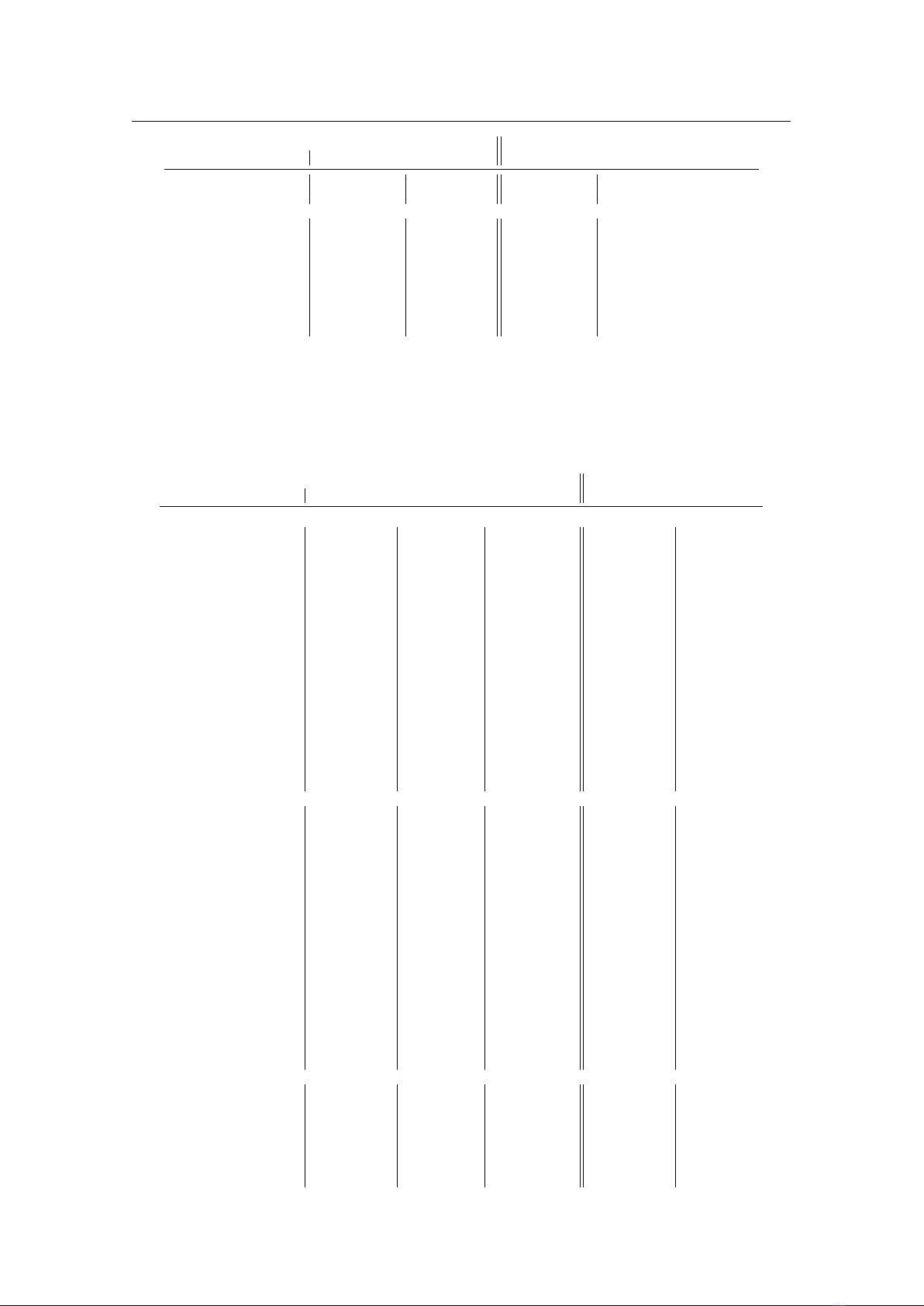
414 Appendix F. Accuracy
JPL Horizons (DE440/441) Stellarium 0.21.2β
UT Date Time RA J2000.0 DE J2000.0 α
J2000.0
δ
J2000.0
∆T
2021-Nov-01 00:00 21h 41m 47.81s -14
◦
59’ 25.0” 21h 41m 47.82s -14
◦
59’ 25.0” 66.43s
2022-Apr-02 00:00 23h 30m 31.22s -04
◦
17’ 01.0” 23h 30m 31.23s -04
◦
17’ 01.0” 66.76s
CALLISTO(JIV)
1601-Jan-01 00:00 11h 33m 15.59s +04
◦
19’ 21.5” 11h 33m 15.73s +04
◦
19’ 20.6” 140.18s
1601-Jun-02 00:00 10h 59m 22.98s +07
◦
55’ 21.8” 10h 59m 23.12s +07
◦
55’ 20.9” 139.71s
1601-Nov-01 00:00 12h 39m 17.32s -02
◦
59’ 27.6” 12h 39m 17.47s -02
◦
59’ 28.8” 139.25s
1602-Apr-02 00:00 13h 08m 09.98s -05
◦
32’ 01.2” 13h 08m 10.10s -05
◦
32’ 02.1” 138.78s
2021-Jan-01 00:00 20h 20m 42.72s -20
◦
00’ 56.3” 20h 20m 42.73s -20
◦
00’ 56.3” 65.79s
2021-Jun-02 00:00 22h 15m 55.40s -11
◦
42’ 15.1” 22h 15m 55.41s -11
◦
42’ 15.1” 66.11s
2021-Nov-01 00:00 21h 41m 58.24s -14
◦
58’ 23.9” 21h 41m 58.25s -14
◦
58’ 23.9” 66.43s
2022-Apr-02 00:00 23h 30m 53.15s -04
◦
14’ 15.0” 23h 30m 53.15s -04
◦
14’ 15.0” 66.76s
Table F.3: An ephemeris comparison between Stellarium and JPL Horizons, based on JPL
DE440/441. Both are showing geocentric apparent coordinates (with slightly different
models for precession, nutation and aberration; JPL results are also corrected for light
deflection). This table shows ephemeris comparison in Dynamical time (TT), to avoid
showing divergences which are only caused by differences in
∆T
handling. (JPL’s values
for ∆T are listed for reference, but not used.)
JPL Horizons Stellarium 0.21.2β
TT Date Time RA J2000.0 DE J2000.0 ∆T α
J2000.0
δ
J2000.0
SUN
b2500-Jan-01 00:00 17h21m25.18s -23
◦
40’30.1” 58893.015756s 17h21m26.91s -23
◦
40’34.2”
b2500-Jun-02 00:00 03h03m40.51s +17
◦
43’04.0” 58881.693980s 03h03m42.09s +17
◦
43’12.5”
b2500-Nov-01 00:00 13h09m12.65s -07
◦
32’06.5” 58870.373294s 13h09m14.12s -07
◦
32’16.5”
b2499-Apr-02 00:00 23h24m04.53s -03
◦
58’17.6” 58859.053698s 23h24m06.02s -03
◦
58’08.4”
b0500-Jan-01 00:00 18h24m36.63s -23
◦
37’53.7” 16988.259557s 18h24m37.49s -23
◦
37’54.4”
b0500-Jun-02 00:00 04h08m26.19s +21
◦
15’14.4” 16982.002779s 04h08m26.99s +21
◦
15’17.6”
b0500-Nov-01 00:00 14h03m40.03s -12
◦
44’27.5” 16975.747099s 14h03m40.76s -12
◦
44’32.1”
b0499-Apr-02 00:00 00h20m28.76s +02
◦
14’57.0” 16969.492518s 00h20m29.48s +02
◦
15’01.7”
0500-Jan-01 00:00 18h52m48.93s -23
◦
04’32.9” 5608.981515s 18h52m49.49s -23
◦
04’32.9”
0500-Jun-01 00:00 04h39m00.52s +22
◦
19’15.9” 5605.028887s 04h39m01.07s +22
◦
19’17.7”
0500-Oct-31 00:00 14h29m11.35s -14
◦
51’03.8” 5601.076499s 14h29m11.84s -14
◦
51’06.7”
0501-Apr-01 00:00 00h46m09.14s +05
◦
00’08.5” 5597.124355s 00h46m09.61s +05
◦
00’11.6”
0501-Aug-31 00:00 10h41m02.87s +08
◦
24’23.2” 5593.172456s 10h41m03.36s +08
◦
24’20.5”
1600-Jan-01 00:00 18h43m27.73s -23
◦
06’56.9” 110.462079s 18h43m27.90s -23
◦
06’57.0”
1600-Jun-01 00:00 04h35m36.87s +22
◦
04’24.3” 109.804702s 04h35m37.03s +22
◦
04’24.8”
1600-Oct-31 00:00 14h21m56.15s -14
◦
09’37.4” 109.148794s 14h21m56.30s -14
◦
09’38.2”
1601-Apr-01 00:00 00h41m18.21s +04
◦
27’17.7” 108.494367s 00h41m18.35s +04
◦
27’18.6”
1601-Aug-31 00:00 10h36m30.02s +08
◦
48’12.4” 107.841429s 10h36m30.16s +08
◦
48’11.7”
MERCURY
b2500-Jan-01 00:00 17h02m08.10s -25
◦
14’54.4” 58893.015756s 17h02m09.83s -25
◦
14’59.3”
b2500-Jun-02 00:00 04h55m00.41s +23
◦
03’30.5” 58881.693980s 04h55m02.12s +23
◦
03’35.5”
b2500-Nov-01 00:00 11h54m04.49s +03
◦
27’59.5” 58870.373294s 11h54m05.97s +03
◦
27’49.8”
b2499-Apr-02 00:00 22h57m59.14s -07
◦
54’02.4” 58859.053698s 22h58m00.66s -07
◦
53’53.6”
b0500-Jan-01 00:00 18h38m56.17s -25
◦
28’13.0” 16988.259557s 18h38m57.04s -25
◦
28’13.3”
b0500-Jun-02 00:00 05h38m38.91s +22
◦
22’48.0” 16982.002779s 05h38m39.75s +22
◦
22’49.6”
b0500-Nov-01 00:00 12h55m48.65s -03
◦
50’09.1” 16975.747099s 12h55m49.37s -03
◦
50’13.9”
b0499-Apr-02 00:00 00h19m39.97s +01
◦
41’26.3” 16969.492518s 00h19m40.68s +01
◦
41’31.2”
0500-Jan-01 00:00 18h23m11.76s -25
◦
14’05.2” 5608.981515s 18h23m12.34s -25
◦
14’05.6”
0500-Jun-01 00:00 06h29m15.56s +24
◦
33’46.9” 5605.028887s 06h29m16.13s +24
◦
33’47.2”
0500-Oct-31 00:00 13h28m09.82s -06
◦
51’31.3” 5601.076499s 13h28m10.29s -06
◦
51’34.4”
0501-Apr-01 00:00 23h54m49.90s -02
◦
49’01.2” 5597.124355s 23h54m50.38s -02
◦
48’58.1”
0501-Aug-31 00:00 12h03m21.92s -01
◦
46’20.3” 5593.172456s 12h03m22.39s -01
◦
46’23.4”
1600-Jan-01 00:00 19h16m54.82s -24
◦
27’05.8” 110.462079s 19h16m54.99s -24
◦
27’05.7”
1600-Jun-01 00:00 05h27m00.83s +22
◦
06’51.2” 109.804702s 05h27m01.00s +22
◦
06’51.5”
1600-Oct-31 00:00 13h24m30.45s -06
◦
45’14.3” 109.148794s 13h24m30.59s -06
◦
45’15.2”
1601-Apr-01 00:00 00h45m29.79s +03
◦
58’00.7” 108.494367s 00h45m29.92s +03
◦
58’01.7”
1601-Aug-31 00:00 12h08m26.49s -04
◦
19’13.1” 107.841429s 12h08m26.63s -04
◦
19’14.0”
VENUS
b2500-Jan-01 00:00 14h37m07.30s -10
◦
25’08.5” 58893.015756s 14h37m08.81s -10
◦
25’17.6”
b2500-Jun-02 00:00 01h28m34.06s +08
◦
11’02.7” 58881.693980s 01h28m35.54s +08
◦
11’12.6”
b2500-Nov-01 00:00 14h01m18.60s -13
◦
03’41.8” 58870.373294s 14h01m20.11s -13
◦
03’51.3”
b2499-Apr-02 00:00 02h04m39.28s +15
◦
58’24.8” 58859.053698s 02h04m40.81s +15
◦
58’34.2”
b0500-Jan-01 00:00 15h15m08.22s -13
◦
55’20.5” 16988.259557s 15h15m08.98s -13
◦
55’24.4”
b0500-Jun-02 00:00 02h40m55.02s +14
◦
44’15.5” 16982.002779s 02h40m55.77s +14
◦
44’19.8”
b0500-Nov-01 00:00 15h13m42.04s -18
◦
47’53.8” 16975.747099s 15h13m42.82s -18
◦
47’57.7”

F.9 Comparison to Reference Data 415
JPL Horizons Stellarium 0.21.2β
TT Date Time RA J2000.0 DE J2000.0 ∆T α
J2000.0
δ
J2000.0
b0499-Apr-02 00:00 03h09m40.90s +21
◦
23’39.0” 16969.492518s 03h09m41.68s +21
◦
23’43.0”
0500-Jan-01 00:00 20h18m48.52s -15
◦
30’50.9” 5608.981515s 20h18m49.05s -15
◦
30’49.8”
0500-Jun-01 00:00 02h10m53.15s +11
◦
08’35.0” 5605.028887s 02h10m53.64s +11
◦
08’38.0”
0500-Oct-31 00:00 14h33m13.65s -14
◦
37’22.9” 5601.076499s 14h33m14.14s -14
◦
37’25.8”
0501-Apr-01 00:00 03h02m54.73s +18
◦
45’37.5” 5597.124355s 03h02m55.25s +18
◦
45’40.1”
0501-Aug-31 00:00 09h10m56.37s +08
◦
17’52.4” 5593.172456s 09h10m56.87s +08
◦
17’50.6”
1600-Jan-01 00:00 17h09m26.64s -18
◦
08’55.7” 110.462079s 17h09m26.80s -18
◦
08’56.1”
1600-Jun-01 00:00 02h28m52.77s +12
◦
50’46.3” 109.804702s 02h28m52.92s +12
◦
50’47.1”
1600-Oct-31 00:00 14h54m13.16s -16
◦
15’01.5” 109.148794s 14h54m13.31s -16
◦
15’02.3”
1601-Apr-01 00:00 03h18m37.29s +20
◦
05’59.9” 108.494367s 03h18m37.45s +20
◦
06’00.6”
1601-Aug-31 00:00 07h48m52.75s +16
◦
06’13.4” 107.841429s 07h48m52.90s +16
◦
06’13.2”
MOON
b2500-Jan-01 00:00 23h43m54.13s -04
◦
46’15.6” 58893.015756s 23h43m55.61s -04
◦
46’06.1”
b2500-Jun-02 00:00 12h15m08.68s -00
◦
12’02.6” 58881.693980s 12h15m10.14s -00
◦
12’12.5”
b2500-Nov-01 00:00 02h16m07.77s +16
◦
35’31.3” 58870.373294s 02h16m09.31s +16
◦
35’40.6”
b2499-Apr-02 00:00 15h07m11.31s -22
◦
11’27.1” 58859.053698s 15h07m12.93s -22
◦
11’35.4”
b0500-Jan-01 00:00 02h04m52.71s +13
◦
33’43.2” 16988.259557s 02h04m53.45s +13
◦
33’47.8”
b0500-Jun-02 00:00 14h51m07.34s -15
◦
30’50.9” 16982.002779s 14h51m08.09s -15
◦
30’55.1”
b0500-Nov-01 00:00 05h08m19.28s +18
◦
56’30.3” 16975.747099s 05h08m20.10s +18
◦
56’32.5”
b0499-Apr-02 00:00 17h59m21.65s -18
◦
38’44.9” 16969.492518s 17h59m22.47s -18
◦
38’46.1”
0500-Jan-01 00:00 05h29m38.64s +28
◦
17’23.7” 5608.981515s 05h29m39.22s +28
◦
17’24.9”
0500-Jun-01 00:00 19h35m39.76s -24
◦
49’55.2” 5605.028887s 19h35m40.33s -24
◦
49’54.6”
0500-Oct-31 00:00 08h38m03.41s +19
◦
57’58.9” 5601.076499s 08h38m03.95s +19
◦
57’57.5”
0501-Apr-01 00:00 22h23m01.61s -08
◦
15’47.6” 5597.124355s 22h23m02.11s -08
◦
15’45.1”
0501-Aug-31 00:00 11h25m37.06s -00
◦
20’06.1” 5593.172456s 11h25m37.53s -00
◦
20’09.0”
1600-Jan-01 00:00 07h04m50.63s +24
◦
04’49.5” 110.462079s 07h04m50.78s +24
◦
04’49.4”
1600-Jun-01 00:00 19h54m11.52s -20
◦
26’52.9” 109.804702s 19h54m11.67s -20
◦
26’52.7”
1600-Oct-31 00:00 10h11m21.07s +07
◦
13’32.6” 109.148794s 10h11m21.20s +07
◦
13’32.0”
1601-Apr-01 00:00 22h46m17.79s -02
◦
54’56.8” 108.494367s 22h46m17.91s -02
◦
54’56.1”
1601-Aug-31 00:00 12h52m06.59s -10
◦
52’15.0” 107.841429s 12h52m06.72s -10
◦
52’15.8”
MARS
1601-Jan-01 00:00 19h26m55.96s -23
◦
01’43.2” 108.881677s 19h26m56.12s -23
◦
01’43.1”
1601-Jun-02 00:00 02h59m06.71s +16
◦
41’20.6” 108.227856s 02h59m06.87s +16
◦
41’21.3”
1601-Nov-01 00:00 09h48m48.40s +15
◦
01’38.7” 107.575530s 09h48m48.55s +15
◦
01’38.1”
1602-Apr-02 00:00 10h25m38.61s +13
◦
17’29.7” 106.924708s 10h25m38.76s +13
◦
17’28.9”
JUPITER
1601-Jan-01 00:00 11h33m23.43s +04
◦
18’09.3” 108.881677s 11h33m23.57s +04
◦
18’08.4”
1601-Jun-02 00:00 10h59m49.50s +07
◦
52’18.1” 108.227856s 10h59m49.64s +07
◦
52’17.3”
1601-Nov-01 00:00 12h39m41.26s -03
◦
02’14.0” 107.575530s 12h39m41.40s -03
◦
02’14.9”
1602-Apr-02 00:00 13h08m44.21s -05
◦
35’33.8” 106.924708s 13h08m44.34s -05
◦
35’34.7”
SATURN
1750-Jan-01 00:00 15h46m12.26s -17
◦
54’37.7” 17.322273s 15h46m12.36s -17
◦
54’38.1”
1750-Jun-02 00:00 15h44m23.78s -17
◦
34’00.9” 17.413029s 15h44m23.88s -17
◦
34’01.3”
1750-Nov-01 00:00 15h59m18.99s -18
◦
50’41.0” 17.503706s 15h59m19.09s -18
◦
50’41.4”
1751-Apr-02 00:00 16h49m11.73s -20
◦
39’30.2” 17.594270s 16h49m11.82s -20
◦
39’30.5”
URANUS
1600-Jan-01 00:00 01h41m51.35s +10
◦
01’26.1” 110.462079s 01h41m51.49s +10
◦
01’26.9”
1600-Jun-01 00:00 02h05m21.56s +12
◦
13’45.5” 109.804702s 02h05m21.71s +12
◦
13’46.3”
1600-Oct-31 00:00 02h04m09.96s +12
◦
05’40.0” 109.148794s 02h04m10.11s +12
◦
05’40.8”
1601-Apr-01 00:00 02h07m08.61s +12
◦
25’31.4” 108.494367s 02h07m08.76s +12
◦
25’32.3”
1601-Aug-31 00:00 02h28m09.10s +14
◦
11’23.3” 107.841429s 02h28m09.25s +14
◦
11’24.1”
NEPTUNE
1801-Jan-01 00:00 15h07m04.41s -15
◦
44’47.2” 18.261920s 15h07m04.49s -15
◦
44’47.6”
1801-Jun-02 00:00 15h01m57.08s -15
◦
18’05.9” 18.107889s 15h01m57.15s -15
◦
18’06.3”
1801-Nov-01 00:00 15h07m02.35s -15
◦
46’26.5” 17.952783s 15h07m02.43s -15
◦
46’26.9”
1802-Apr-02 00:00 15h17m01.46s -16
◦
20’15.8” 17.797431s 15h17m01.54s -16
◦
20’16.2”
IO(JI)
1601-Jan-01 00:00 11h33m30.35s +04
◦
17’19.8” 108.881677s 11h33m30.50s +04
◦
17’18.9”
1601-Jun-02 00:00 10h59m55.42s +07
◦
51’35.9” 108.227856s 10h59m55.57s +07
◦
51’35.0”
1601-Nov-01 00:00
12h39m41.55s -03
◦
02’20.3” 107.575530s 12h39m41.71s -03
◦
02’21.4”
1602-Apr-02 00:00 13h08m39.95s -05
◦
35’12.3” 106.924708s 13h08m40.11s -05
◦
35’13.4”
EUROPA(JII)
1601-Jan-01 00:00 11h33m16.18s +04
◦
19’07.0” 108.881677s 11h33m16.31s +04
◦
19’06.2”
1601-Jun-02 00:00 10h59m53.24s +07
◦
51’59.3” 108.227856s 10h59m53.38s +07
◦
51’58.6”
1601-Nov-01 00:00 12h39m49.02s -03
◦
03’11.0” 107.575530s 12h39m49.17s -03
◦
03’11.8”
1602-Apr-02 00:00 13h08m40.14s -05
◦
35’20.5” 106.924708s 13h08m40.29s -05
◦
35’21.4”
GANYMEDE(JIII)
1601-Jan-01 00:00 11h33m29.32s +04
◦
17’17.3” 108.881677s 11h33m29.46s +04
◦
17’16.4”

416 Appendix F. Accuracy
JPL Horizons Stellarium 0.21.2β
TT Date Time RA J2000.0 DE J2000.0 ∆T α
J2000.0
δ
J2000.0
1601-Jun-02 00:00 11h00m04.62s +07
◦
50’38.1” 108.227856s 11h00m04.77s +07
◦
50’37.3”
1601-Nov-01 00:00 12h39m41.87s -03
◦
02’07.5” 107.575530s 12h39m42.01s -03
◦
02’08.4”
1602-Apr-02 00:00 13h08m24.32s -05
◦
33’17.9” 106.924708s 13h08m24.46s -05
◦
33’18.9”
CALLISTO(JIV)
1601-Jan-01 00:00 11h33m15.60s +04
◦
19’21.4” 108.881677s 11h33m15.74s +04
◦
19’20.5”
1601-Jun-02 00:00 10h59m22.96s +07
◦
55’21.9” 108.227856s 10h59m23.10s +07
◦
55’21.0”
1601-Nov-01 00:00 12h39m17.27s -02
◦
59’27.3” 107.575530s 12h39m17.41s -02
◦
59’28.3”
1602-Apr-02 00:00 13h08m10.01s -05
◦
32’01.4” 106.924708s 13h08m10.14s -05
◦
32’02.4”
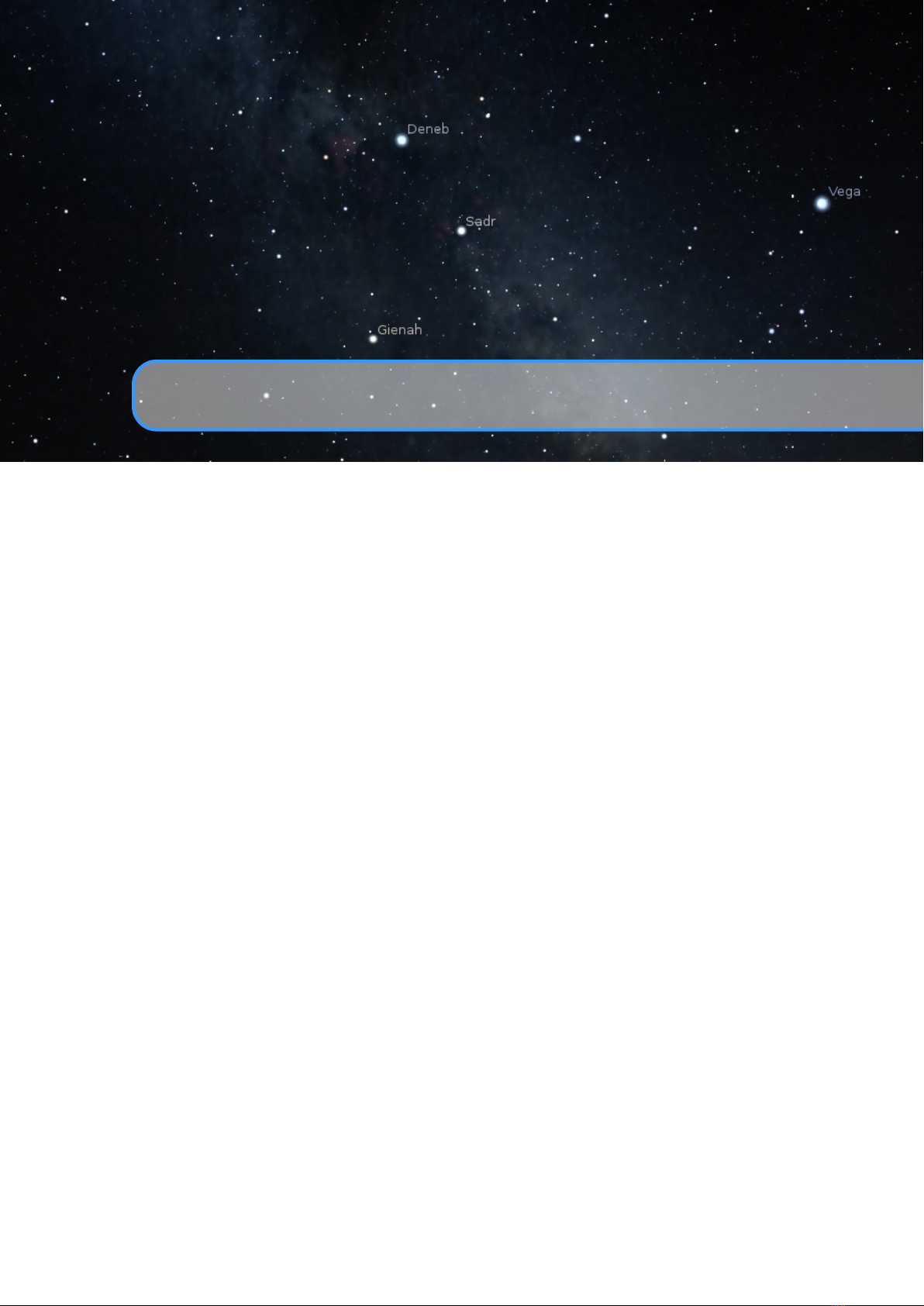
G. GNU Free Documentation License
Version 1.3, 3 November 2008
Copyright © 2000, 2001, 2002, 2007, 2008 Free Software Foundation, Inc.
http://fsf.
org/
Everyone is permitted to copy and distribute verbatim copies of this license document, but
changing it is not allowed.
G.1 PREAMBLE
The purpose of this License is to make a manual, textbook, or other functional and useful
document “free” in the sense of freedom: to assure everyone the effective freedom to copy
and redistribute it, with or without modifying it, either commercially or noncommercially.
Secondarily, this License preserves for the author and publisher a way to get credit for
their work, while not being considered responsible for modifications made by others.
This License is a kind of “copyleft”, which means that derivative works of the document
must themselves be free in the same sense. It complements the GNU General Public
License, which is a copyleft license designed for free software.
We have designed this License in order to use it for manuals for free software, because
free software needs free documentation: a free program should come with manuals
providing the same freedoms that the software does. But this License is not limited to
software manuals; it can be used for any textual work, regardless of subject matter or
whether it is published as a printed book. We recommend this License principally for
works whose purpose is instruction or reference.
G.2 APPLICABILITY AND DEFINITIONS
This License applies to any manual or other work, in any medium, that contains a notice
placed by the copyright holder saying it can be distributed under the terms of this License.

418 Appendix G. GNU Free Documentation License
Such a notice grants a world-wide, royalty-free license, unlimited in duration, to use that
work under the conditions stated herein. The “Document”, below, refers to any such
manual or work. Any member of the public is a licensee, and is addressed as “you”. You
accept the license if you copy, modify or distribute the work in a way requiring permission
under copyright law.
A “Modified Version” of the Document means any work containing the Document or a
portion of it, either copied verbatim, or with modifications and/or translated into another
language.
A “Secondary Section” is a named appendix or a front-matter section of the Document
that deals exclusively with the relationship of the publishers or authors of the Document
to the Document’s overall subject (or to related matters) and contains nothing that could
fall directly within that overall subject. (Thus, if the Document is in part a textbook of
mathematics, a Secondary Section may not explain any mathematics.) The relationship
could be a matter of historical connection with the subject or with related matters, or of
legal, commercial, philosophical, ethical or political position regarding them.
The “Invariant Sections” are certain Secondary Sections whose titles are designated,
as being those of Invariant Sections, in the notice that says that the Document is released
under this License. If a section does not fit the above definition of Secondary then it is not
allowed to be designated as Invariant. The Document may contain zero Invariant Sections.
If the Document does not identify any Invariant Sections then there are none.
The “Cover Texts” are certain short passages of text that are listed, as Front-Cover
Texts or Back-Cover Texts, in the notice that says that the Document is released under this
License. A Front-Cover Text may be at most 5 words, and a Back-Cover Text may be at
most 25 words.
A “Transparent” copy of the Document means a machine-readable copy, represented in
a format whose specification is available to the general public, that is suitable for revising
the document straightforwardly with generic text editors or (for images composed of
pixels) generic paint programs or (for drawings) some widely available drawing editor,
and that is suitable for input to text formatters or for automatic translation to a variety of
formats suitable for input to text formatters. A copy made in an otherwise Transparent file
format whose markup, or absence of markup, has been arranged to thwart or discourage
subsequent modification by readers is not Transparent. An image format is not Transparent
if used for any substantial amount of text. A copy that is not “Transparent” is called
“Opaque”.
Examples of suitable formats for Transparent copies include plain ASCII without
markup, Texinfo input format, LaTeX input format, SGML or XML using a publicly
available DTD, and standard-conforming simple HTML, PostScript or PDF designed for
human modification. Examples of transparent image formats include PNG, XCF and JPG.
Opaque formats include proprietary formats that can be read and edited only by proprietary
word processors, SGML or XML for which the DTD and/or processing tools are not
generally available, and the machine-generated HTML, PostScript or PDF produced by
some word processors for output purposes only.
The “Title Page” means, for a printed book, the title page itself, plus such following
pages as are needed to hold, legibly, the material this License requires to appear in the title
page. For works in formats which do not have any title page as such, “Title Page” means
the text near the most prominent appearance of the work’s title, preceding the beginning of

G.3 VERBATIM COPYING 419
the body of the text.
The “publisher” means any person or entity that distributes copies of the Document to
the public.
A section “Entitled XYZ” means a named subunit of the Document whose title either
is precisely XYZ or contains XYZ in parentheses following text that translates XYZ in
another language. (Here XYZ stands for a specific section name mentioned below, such as
“Acknowledgements”, “Dedications”, “Endorsements”, or “History”.) To “Preserve the
Title” of such a section when you modify the Document means that it remains a section
“Entitled XYZ” according to this definition.
The Document may include Warranty Disclaimers next to the notice which states that
this License applies to the Document. These Warranty Disclaimers are considered to be
included by reference in this License, but only as regards disclaiming warranties: any other
implication that these Warranty Disclaimers may have is void and has no effect on the
meaning of this License.
G.3 VERBATIM COPYING
You may copy and distribute the Document in any medium, either commercially or
noncommercially, provided that this License, the copyright notices, and the license notice
saying this License applies to the Document are reproduced in all copies, and that you
add no other conditions whatsoever to those of this License. You may not use technical
measures to obstruct or control the reading or further copying of the copies you make
or distribute. However, you may accept compensation in exchange for copies. If you
distribute a large enough number of copies you must also follow the conditions in section
3.
You may also lend copies, under the same conditions stated above, and you may
publicly display copies.
G.4 COPYING IN QUANTITY
If you publish printed copies (or copies in media that commonly have printed covers) of the
Document, numbering more than 100, and the Document’s license notice requires Cover
Texts, you must enclose the copies in covers that carry, clearly and legibly, all these Cover
Texts: Front-Cover Texts on the front cover, and Back-Cover Texts on the back cover. Both
covers must also clearly and legibly identify you as the publisher of these copies. The front
cover must present the full title with all words of the title equally prominent and visible.
You may add other material on the covers in addition. Copying with changes limited to the
covers, as long as they preserve the title of the Document and satisfy these conditions, can
be treated as verbatim copying in other respects.
If the required texts for either cover are too voluminous to fit legibly, you should put
the first ones listed (as many as fit reasonably) on the actual cover, and continue the rest
onto adjacent pages.
If you publish or distribute Opaque copies of the Document numbering more than 100,
you must either include a machine-readable Transparent copy along with each Opaque
copy, or state in or with each Opaque copy a computer-network location from which
the general network-using public has access to download using public-standard network

420 Appendix G. GNU Free Documentation License
protocols a complete Transparent copy of the Document, free of added material. If you use
the latter option, you must take reasonably prudent steps, when you begin distribution of
Opaque copies in quantity, to ensure that this Transparent copy will remain thus accessible
at the stated location until at least one year after the last time you distribute an Opaque
copy (directly or through your agents or retailers) of that edition to the public.
It is requested, but not required, that you contact the authors of the Document well
before redistributing any large number of copies, to give them a chance to provide you
with an updated version of the Document.
G.5 MODIFICATIONS
You may copy and distribute a Modified Version of the Document under the conditions of
sections 2 and 3 above, provided that you release the Modified Version under precisely
this License, with the Modified Version filling the role of the Document, thus licensing
distribution and modification of the Modified Version to whoever possesses a copy of it. In
addition, you must do these things in the Modified Version:
•
A. Use in the Title Page (and on the covers, if any) a title distinct from that of the
Document, and from those of previous versions (which should, if there were any,
be listed in the History section of the Document). You may use the same title as a
previous version if the original publisher of that version gives permission.
•
B. List on the Title Page, as authors, one or more persons or entities responsible for
authorship of the modifications in the Modified Version, together with at least five
of the principal authors of the Document (all of its principal authors, if it has fewer
than five), unless they release you from this requirement.
• C. State on the Title page the name of the publisher of the Modified Version, as the
publisher.
• D. Preserve all the copyright notices of the Document.
•
E. Add an appropriate copyright notice for your modifications adjacent to the other
copyright notices.
•
F. Include, immediately after the copyright notices, a license notice giving the public
permission to use the Modified Version under the terms of this License, in the form
shown in the Addendum below.
•
G. Preserve in that license notice the full lists of Invariant Sections and required
Cover Texts given in the Document’s license notice.
• H. Include an unaltered copy of this License.
•
I. Preserve the section Entitled “History”, Preserve its Title, and add to it an item
stating at least the title, year, new authors, and publisher of the Modified Version as
given on the Title Page. If there is no section Entitled “History” in the Document,
create one stating the title, year, authors, and publisher of the Document as given
on its Title Page, then add an item describing the Modified Version as stated in the
previous sentence.
•
J. Preserve the network location, if any, given in the Document for public access to
a Transparent copy of the Document, and likewise the network locations given in
the Document for previous versions it was based on. These may be placed in the
“History” section. You may omit a network location for a work that was published at
least four years before the Document itself, or if the original publisher of the version

G.6 COMBINING DOCUMENTS 421
it refers to gives permission.
•
K. For any section Entitled “Acknowledgements” or “Dedications”, Preserve the
Title of the section, and preserve in the section all the substance and tone of each of
the contributor acknowledgements and/or dedications given therein.
•
L. Preserve all the Invariant Sections of the Document, unaltered in their text and in
their titles. Section numbers or the equivalent are not considered part of the section
titles.
•
M. Delete any section Entitled “Endorsements”. Such a section may not be included
in the Modified Version.
•
N. Do not retitle any existing section to be Entitled “Endorsements” or to conflict in
title with any Invariant Section.
• O. Preserve any Warranty Disclaimers.
If the Modified Version includes new front-matter sections or appendices that qualify
as Secondary Sections and contain no material copied from the Document, you may at
your option designate some or all of these sections as invariant. To do this, add their titles
to the list of Invariant Sections in the Modified Version’s license notice. These titles must
be distinct from any other section titles.
You may add a section Entitled “Endorsements”, provided it contains nothing but
endorsements of your Modified Version by various parties — for example, statements
of peer review or that the text has been approved by an organization as the authoritative
definition of a standard.
You may add a passage of up to five words as a Front-Cover Text, and a passage of up
to 25 words as a Back-Cover Text, to the end of the list of Cover Texts in the Modified
Version. Only one passage of Front-Cover Text and one of Back-Cover Text may be added
by (or through arrangements made by) any one entity. If the Document already includes a
cover text for the same cover, previously added by you or by arrangement made by the
same entity you are acting on behalf of, you may not add another; but you may replace the
old one, on explicit permission from the previous publisher that added the old one.
The author(s) and publisher(s) of the Document do not by this License give permission
to use their names for publicity for or to assert or imply endorsement of any Modified
Version.
G.6 COMBINING DOCUMENTS
You may combine the Document with other documents released under this License, under
the terms defined in section 4 above for modified versions, provided that you include in
the combination all of the Invariant Sections of all of the original documents, unmodified,
and list them all as Invariant Sections of your combined work in its license notice, and that
you preserve all their Warranty Disclaimers.
The combined work need only contain one copy of this License, and multiple identical
Invariant Sections may be replaced with a single copy. If there are multiple Invariant
Sections with the same name but different contents, make the title of each such section
unique by adding at the end of it, in parentheses, the name of the original author or
publisher of that section if known, or else a unique number. Make the same adjustment to
the section titles in the list of Invariant Sections in the license notice of the combined work.
In the combination, you must combine any sections Entitled “History” in the various

422 Appendix G. GNU Free Documentation License
original documents, forming one section Entitled “History”; likewise combine any sections
Entitled “Acknowledgements”, and any sections Entitled “Dedications”. You must delete
all sections Entitled “Endorsements”.
G.7 COLLECTIONS OF DOCUMENTS
You may make a collection consisting of the Document and other documents released under
this License, and replace the individual copies of this License in the various documents
with a single copy that is included in the collection, provided that you follow the rules of
this License for verbatim copying of each of the documents in all other respects.
You may extract a single document from such a collection, and distribute it individually
under this License, provided you insert a copy of this License into the extracted document,
and follow this License in all other respects regarding verbatim copying of that document.
G.8 AGGREGATION WITH INDEPENDENT WORKS
A compilation of the Document or its derivatives with other separate and independent
documents or works, in or on a volume of a storage or distribution medium, is called an
“aggregate” if the copyright resulting from the compilation is not used to limit the legal
rights of the compilation’s users beyond what the individual works permit. When the
Document is included in an aggregate, this License does not apply to the other works in
the aggregate which are not themselves derivative works of the Document.
If the Cover Text requirement of section 3 is applicable to these copies of the Document,
then if the Document is less than one half of the entire aggregate, the Document’s Cover
Texts may be placed on covers that bracket the Document within the aggregate, or the
electronic equivalent of covers if the Document is in electronic form. Otherwise they must
appear on printed covers that bracket the whole aggregate.
G.9 TRANSLATION
Translation is considered a kind of modification, so you may distribute translations of the
Document under the terms of section 4. Replacing Invariant Sections with translations
requires special permission from their copyright holders, but you may include translations
of some or all Invariant Sections in addition to the original versions of these Invariant
Sections. You may include a translation of this License, and all the license notices in the
Document, and any Warranty Disclaimers, provided that you also include the original
English version of this License and the original versions of those notices and disclaimers.
In case of a disagreement between the translation and the original version of this License
or a notice or disclaimer, the original version will prevail.
If a section in the Document is Entitled “Acknowledgements”, “Dedications”, or
“History”, the requirement (section 4) to Preserve its Title (section 1) will typically require
changing the actual title.

G.10 TERMINATION 423
G.10 TERMINATION
You may not copy, modify, sublicense, or distribute the Document except as expressly
provided under this License. Any attempt otherwise to copy, modify, sublicense, or
distribute it is void, and will automatically terminate your rights under this License.
However, if you cease all violation of this License, then your license from a particular
copyright holder is reinstated (a) provisionally, unless and until the copyright holder
explicitly and finally terminates your license, and (b) permanently, if the copyright holder
fails to notify you of the violation by some reasonable means prior to 60 days after the
cessation.
Moreover, your license from a particular copyright holder is reinstated permanently
if the copyright holder notifies you of the violation by some reasonable means, this is
the first time you have received notice of violation of this License (for any work) from
that copyright holder, and you cure the violation prior to 30 days after your receipt of the
notice.
Termination of your rights under this section does not terminate the licenses of parties
who have received copies or rights from you under this License. If your rights have been
terminated and not permanently reinstated, receipt of a copy of some or all of the same
material does not give you any rights to use it.
G.11 FUTURE REVISIONS OF THIS LICENSE
The Free Software Foundation may publish new, revised versions of the GNU Free Doc-
umentation License from time to time. Such new versions will be similar in spirit to
the present version, but may differ in detail to address new problems or concerns. See
http://www.gnu.org/copyleft/.
Each version of the License is given a distinguishing version number. If the Document
specifies that a particular numbered version of this License “or any later version” applies
to it, you have the option of following the terms and conditions either of that specified
version or of any later version that has been published (not as a draft) by the Free Software
Foundation. If the Document does not specify a version number of this License, you may
choose any version ever published (not as a draft) by the Free Software Foundation. If the
Document specifies that a proxy can decide which future versions of this License can be
used, that proxy’s public statement of acceptance of a version permanently authorizes you
to choose that version for the Document.
G.12 RELICENSING
“Massive Multiauthor Collaboration Site” (or “MMC Site”) means any World Wide Web
server that publishes copyrightable works and also provides prominent facilities for any-
body to edit those works. A public wiki that anybody can edit is an example of such a
server. A “Massive Multiauthor Collaboration” (or “MMC”) contained in the site means
any set of copyrightable works thus published on the MMC site.
“CC-BY-SA” means the Creative Commons Attribution-Share Alike 3.0 license pub-
lished by Creative Commons Corporation, a not-for-profit corporation with a principal
place of business in San Francisco, California, as well as future copyleft versions of that
license published by that same organization.

424 Appendix G. GNU Free Documentation License
“Incorporate” means to publish or republish a Document, in whole or in part, as part of
another Document.
An MMC is “eligible for relicensing” if it is licensed under this License, and if all
works that were first published under this License somewhere other than this MMC, and
subsequently incorporated in whole or in part into the MMC, (1) had no cover texts or
invariant sections, and (2) were thus incorporated prior to November 1, 2008.
The operator of an MMC Site may republish an MMC contained in the site under
CC-BY-SA on the same site at any time before August 1, 2009, provided the MMC is
eligible for relicensing.
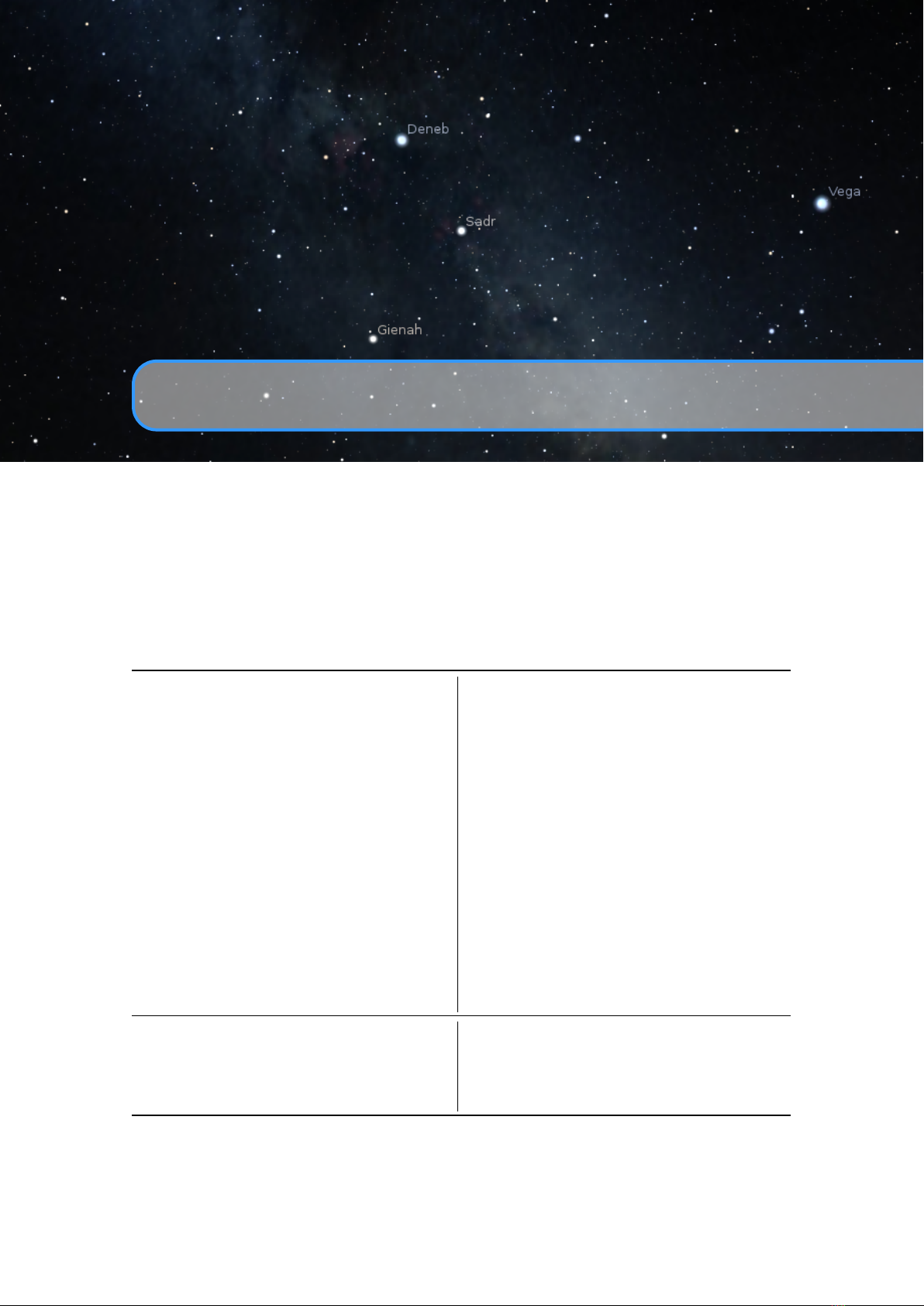
H. Acknowledgements
H.1 Contributors to this User Guide
When not listed as chapter authors, the following were the main contributors to the User
Guide, mostly for versions before V0.15:
Matthew Gates
Primary author of the first User Guide (ver-
sions 0.9 to 0.12)
Paul Robinson Sky guide; exercise ideas
Andras Mohari
Celestial sphere diagrams; numerous cor-
rections
Rudy Gobits, Dirk Schwarzhans Mac platform specifics
Barry Gerdes (†2014) Windows platform specifics
Customisation of .fab files
Documentation Maintainer up to V0.12
Sigma Japanese translation; many corrections
Richard Powell
Figure 19.3 (colour/magnitude diagram) is
a modification of his diagram; he kindly
granted permission for it to be distributed
under the FDL
John Twin Many spelling corrections
Georg Zotti Lead author of the 0.15+ editions
Alexander Wolf
New layout, many contributions for the
0.15+ editions
The rest of the Stellarium developer team You know who you are. . . :-)
Additional material has been incorporated into the guide from sources that are published
under the GNU FDL, including material from Wikipedia and the Astronomy book at
Wikibooks.

426 Appendix H. Acknowledgements
H.2 Developers
Stellarium is not a company. It is a project created by a community of amateur and
professional astronomers, software engineers, 3D graphics experts, cultural astronomers
and experts in other related fields. Together we created something unique.
H.2.1 Developers
Project coordinator & lead developer Fabien Chéreau
Graphic/other designer Martín Bernardi
Developer Guillaume Chéreau
Developer Georg Zotti
Developer Alexander V. Wolf
Developer Ruslan Kabatsayev
Developer Worachate Boonplod
Sky cultures researcher Susanne M. Hoffmann
Continuous Integration Hans Lambermont
Tester Khalid AlAjaji
H.2.2 Former Developers
Several people have made significant contributions, but are no longer active. Their work
has made a big difference to the project:
Graphic/other designer Johan Meuris
Doc author/developer Matthew Gates
Developer Johannes Gajdosik
Developer Rob Spearman
Developer Bogdan Marinov
Developer Timothy Reaves
Developer Florian Schaukowitsch
Developer András Mohari
Developer Mike Storm
Developer Ferdinand Majerech
Developer Jörg Müller
Developer Marcos Cardinot
OSX Developer Nigel Kerr
OSX Developer Diego Marcos
H.2.3 Contributors
Many individuals have made contributions to the project and their work has made Stellar-
ium better. Alphabetically sorted list of all contributors:
Adam Majer, Adriano Steffler, Alessandro Siniscalchi, Alex Gamper, Alexander Be-
lopolsky, Alexander Duytschaever, Alexander Miller, Alexander V. Wolf, Alexandros
Kosiaris, Alexey Dokuchaev, Alexey Sokolov, Allan Johnson, Andras Mohari, Andrei
Borza, Andrew Jeddeloh, Andy Kirkham, Angelo Fraietta, Annette S. Lee, Antoine Ja-
coutot, Anton Samoylov, Arjen de Korte, Aspere, Atque, Barry Gerdes, Bernd K, Björn
Höfling, Bogdan Marinov, Brian Kloppenborg, Cassy, Chi Huynh, ChrUnger, Chris Xiao,
Clement Sommelet, Clepalitto, Colin Gaudion, Cosimo Cecchi, Dan Joplin, Dan Smale,

H.3 How you can help 427
Daniel Adastra, Daniel De Mickey, Daniel Michalik, Danny Milosavljevic, David Baucum,
Dempsey-p, Dhia, Diego Marcos, Dominik Maximilián Ramík, Edgar Scholz, Elaina,
Eleni Maria Stea, Emmanuel, EuklidAlexandria, Fabien Chereau, Felix Z, Ferdinand Ma-
jerech, Florian Schaukowitsch, François Scholder, Freeman Li, FreewareTips, Froenchenko
Leonid, Fòram na Gàidhlig, Georg Zotti, Gion Kunz, GitHaarek, Giuseppe Putzolu, Greg
Alexander, Guillaume Chereau, Gábor Péterffy, Hans Lambermont, Hleb Valoshka, Hol-
ger, Holger Nießner, Iceflower, Ivan Marti-Vidal, J. L. Canales, JMejuto, Jack Schmidt,
Jean-Philippe Lambert, Jocelyn Girod, Johan Meuris, Johannes Gajdosik, Jörg Müller,
Katrin Leinweber, Kenan Derviševi
´
c, Khalid AlAjaji, Kirill Snezhko, Konrad Rybka, Ku-
taibaa Akraa, Louis Strous, M.S. Adityan, Maciej Serylak, Marc Espie, Marcos Cardinot,
Martin Bernardi, Matt Hughes, Matthew Gates, Matthias Drochner, Matwey V. Kornilov,
Max Digruber, Michael Dickens, Michael Storm, Michael Taylor, Michal Sojka, Minmin
Gong, Mircea Lite, Miroslav Broz, Mykyta Sytyi, Nick Fedoseev, Nick Kanel, Nicolas
Martignoni, Nidroide, Nir Lichtman, Oleg Ginzburg, Oscar Roig Felius, Paolo Cancedda
(Pac), ParkSangJun, Patrick, Paul Krizak, Pavel Klimenko, Pawel Stolowski, Peter, Peter
Hickey, Peter Mousley, Peter Neubauer, Peter Vasey, Peter Walser, Petr Kubánek, Pino
Toscano, Pluton Helleformer, Qam1, RVS, Ralph Schäfermeier, Ray, Rob Spearman,
Robert S. Fuller, Roland Bosa, Ross Mitchell, Rumen Bogdanovski, Ruslan Kabatsayev,
Sam Lanning, Sebastian Jennen, Sergej Krivonos, Sergey, Shantanu Agarwal, Sibi Antony,
SilverAstro, Simon Parzer, Song Li, Sripath Roy Koganti, Steven Bellavia, Susanne M.
Hoffmann, Sveinn í Felli, Tanmoy Saha, Teemu Nätkinniemi, Teresa Huertas, Thomas1664,
Tig la Pomme, Timothy Reaves, Tomasz Buchert, Tony Furr, TotalCaesar659, Tuomas
Teipainen, T
¯
evita O. Ka
´
ili, Vancho Stojkoski, Vicente Reyes, Victor Reijs, Vishvas Vasuki,
Vladislav Bataron, Volker Hören, William Formyduval, Wolfgang Laun, Wonkyo Choe,
Worachate Boonplod, Yuri Chornoivan, Yury Solomonov, adalava, bv6679, chithihuynh,
colossatr0n, henrysky, leonardcj, misibacsi, rikardfalkeborn, riodoro1, sebagr, sunshuwei,
ultrapre, uwes-ufo, ysjbserver, zhu1995zpb, Łukasz ’sil2100’ Zemczak.
H.3 How you can help
We especially welcome contributions in shape of working program code for interesting
features, but also bug reports, feature requests and other feedback through the usual
channels (trackers, forums and so on):
Stellarium on Github https://github.com/Stellarium/
Questions for Stellarium (FAQ) https://github.c om/Stellarium/ stellarium/w
iki/FAQ
Current issues (FAQ) https:// github.com/Stellarium/stellarium/wiki/Comm
on-Problems-for-the-current-version
Google Group https://groups.google.com/group/stellarium
Another form of support, donations, can be given via
https://opencollective.c
om/stellarium/donate.
H.4 Technical Articles
Stellarium would not look the same and work without these works from computer graphics
and astronomy.

428 Appendix H. Acknowledgements
The tone reproductor class
The class mainly performs a fast implementation of the
algorithm from Tumblin and Rushmeier (1993), with more accurate values from
Devlin et al. (2002). The blue shift formula is taken from Jensen et al. (2000) and
combined with the Scotopic vision formula from Larson, Rushmeier, and Piatko
(1997).
The skylight class
The class governs sky colors and is a fast implementation of the
algorithm by Preetham, Shirley, and Smits (1999).
The skybright class
The class governs physical sky brightness values based on Bradley
Schaefer’s VISLIMIT.BAS basic source code (B. Schaefer, 1998). The basic sources
are available on the Sky and Telescope web site (code “offered as-is and without
support”).
The ∆T calculations
For implementation of calculation routines for
∆T
we used the
following sources:
1. ∆T
webpage by Rob van Gent:
https://webspace.science.u u. n l /~g e n
t0113/deltat/deltat.htm
2.
Five Millennium Canon of Solar Eclipses: -1900 to +3000 (Espenak and
Meeus, 2006) (
https://eclipse . gsfc.nasa.gov/SEhelp/deltatpoly2
004.html)
3.
Thousand Year Canon of Solar Eclipses 1501 to 2500 (Espenak, 2014) (
https:
//eclipsewise.com/help/deltatpoly2014.html)
4. “On the system of astronomical constants” (Clemence, 1948)
5.
“The rotation of the earth, and the secular accelerations of the sun, moon and
planets” (Spencer Jones, 1939)
6.
“Polynomial approximations for the correction delta T E.T.-U.T. in the period
1800-1975” (Schmadel and Zech, 1979)
7.
“ELP 2000-85 and the dynamic time-universal time relation” (Borkowski,
1988)
8.
“Empirical Transformations from U.T. to E.T. for the Period 1800-1988”
(Schmadel and Zech, 1988)
9.
“Historical values of the Earth’s clock error
∆
T and the calculation of eclipses”
(Morrison and F. R. Stephenson, 2004) with Addendum (Morrison and F. R.
Stephenson, 2005)
10.
“Polynomial approximations to Delta T, 1620-2000 AD” (Meeus and Simons,
2000)
11. Canon of Solar Eclipses -2003 to +2526 (Mucke and Meeus, 1983)
12.
“The accelerations of the earth and moon from early astronomical observations”
(Muller and F. R. Stephenson, 1975)
13. “Pre-Telescopic Astronomical Observations” (F. R. Stephenson, 1978)
14.
“Long-term changes in the rotation of the earth - 700 B.C. to A.D. 1980” (F. R.
Stephenson and Morrison, 1984)
15.
“Long-Term Fluctuations in the Earth’s Rotation: 700 BC to AD 1990” (F. R.
Stephenson and Morrison, 1995)
16. Historical Eclipses and Earth’s Rotation (F. Richard Stephenson, 1997)
17. Astronomical Algorithms (Meeus, 1998)
18. Astronomy on the Personal Computer (Montenbruck and Pfleger, 2000)
19.
Calendrical Calculations (The Millennium Edition) (Reingold and Dershowitz,

H.5 Included Source Code 429
2001)
20. ∆T
webpage by V. Reijs:
http://www.iol.ie/~geniet/eng/DeltaTeval
.htm
Precession:
“New precession expressions, valid for long time intervals” (Vondrák, Capi-
taine, and Wallace, 2011) with correction (Vondrák, Capitaine, and Wallace, 2012)
Nutation:
“An abridged model of the precession-nutation of the celestial pole” (McCarthy
and Luzum, 2003) This model provides accuracy better than 1 milli-arcsecond in the
time 1995-2050. It is applied for years -4000..+8000 only.
Martian polar caps: Based on data from Smith et al. (2009) and Piqueux et al. (2015).
Solar limb darkening: Livingston (2002). v 23.1
H.5 Included Source Code
•
Some computation of the sidereal time (
sidereal_time.h/c
) and Pluto orbit con-
tains code from the libnova library (LGPL) by Liam Girdwood.
•
The
orbit.cpp/h
and
solve.h
files were directly borrowed from Celestia (Chris
Laurel; GPL license). They have now evolved a bit.
•
Several implementations of IMCCE theories for planet and satellite movement by
Johannes Gajdosik (MIT-style license, see the corresponding files for the license
text)
•
The tesselation algorithms were originally extracted from the glues library version
1.4 by Mike Gorchak <mike@malva.ua> (SGI FREE SOFTWARE LICENSE B).
• OBJ loader in the Scenery3D plugin based on glObjViewer (c) 2007 dhpoware
•
Parts of the code to work with DE430/DE431 and DE440/DE441 data files have
been taken from Project Pluto (GPL license).
•
The
SpoutLibrary.dll
and header from the SpoutSDK version 2.005 available at
http://spout.zeal.co (BSD license).
H.6 Data
1.
The Hipparcos star catalog From ESA (European Space Agency) and the Hipparcos
mission. ref. ESA, 1997, The Hipparcos and Tycho Catalogues, ESA SP-1200
http://cdsweb.u-strasbg.fr/ftp/cats/I/239
2. The solar system data mainly comes from IMCCE and partly from Celestia.
3.
Polynesian constellations are based on diagrams from the Polynesian Voyaging
Society
4. Chinese constellations are based on diagrams from the Hong Kong Space Museum
5.
Egyptian constellations are based on the work of Juan Antonio Belmonte, Instituto
de Astrofisica de Canarias
6.
The Tycho-2 Catalogue of the 2.5 Million Brightest Stars Hog E., Fabricius C.,
Makarov V.V., Urban S., Corbin T., Wycoff G., Bastian U., Schwekendiek P.,
Wicenec A. Astron. Astrophys. 355, L27 (2000)
http://cdsweb.u-stras
bg.fr/ftp/cats/I/259
7.
Naval Observatory Merged Astrometric Dataset (NOMAD) version 1 (
http://www.
nofs.navy.mil/nomad) Norbert Zacharias writes:

430 Appendix H. Acknowledgements
“There are no fees, both UCAC and NOMAD are freely available with
the only requirement that the source of the data (U.S. Naval Observatory)
and original product name need to be provided with any distribution, as
well as a description about any changes made to the data, if at all.”
The changes made to the data are:
• try to compute visual magnitude and color from the b,v,r values
• compute nr_of_measurements = the number of valid b,v, r values
•
throw away or keep stars (depending on magnitude, nr_of_measurements,
combination of flags, tycho2 number)
•
add all stars from Hipparcos (incl. component solutions), and tycho2+1st
supplement
•
reorganize the stars in several brightness levels and triangular zones according
to position and magnitude
The programs that are used to generate the star files are called MakeCombined-
Catalogue, ParseHip, ParseNomad, and can be found in the util subdirectory in
source code. The position, magnitudes, and proper motions of the stars coming
from NOMAD are unchanged, except for a possible loss of precision, especially in
magnitude. When there is no V magnitude, it is estimated from R or B magnitude.
When there is no B or V magnitude, the color B-V is estimated from the other
magnitudes. Also proper motions of faint stars are neglected at all.
8.
Stellarium’s Catalog of Variable Stars based on General Catalog of Variable Stars
(GCVS) version 2013Apr.
http://www.sai.msu.su/gcvs/gcvs/
Samus N.N.,
Durlevich O.V., Kazarovets E V., Kireeva N.N., Pastukhova E.N., Zharova A.V., et
al., General Catalogue of Variable Stars (Samus+ 2007-2012)
http://cdsarc.u-s
trasbg.fr/viz-bin/Cat?cat=B%2Fgcvs&
9. Consolidated DSO catalog was created from various data:
(a)
NGC/IC data taken from SIMBAD Astronomical Database
http://simbad
.u-strasbg.fr
(b)
Distance to NGC/IC data taken from NED (NASA/IPAC EXTRAGALACTIC
DATABASE) http://ned.ipac.caltech.edu
(c)
Catalogue of HII Regions (Sharpless, 1959) (
http://vizier.u-strasbg.f
r/viz-bin/VizieR?-source=VII/20)
(d)
H-
α
emission regions in the Southern Milky Way (Rodgers+, 1960) (
http:
//vizier.u-strasbg.fr/viz-bin/VizieR?-source=VII/216)
(e)
Catalogue of Reflection Nebulae (Van den Bergh, 1966) (
http://vizier.u
-strasbg.fr/viz-bin/VizieR?-source=VII/21)
(f)
Lynds’ Catalogue of Dark Nebulae (LDN) (Lynds, 1962) (
http://vizier.u
-strasbg.fr/viz-bin/VizieR?-source=VII/7A)
(g)
Lynds’ Catalogue of Bright Nebulae (Lynds, 1965) (
http://vizier.u-str
asbg.fr/viz-bin/VizieR?-source=VII/9)
(h)
Catalog of bright diffuse Galactic nebulae (Cederblad, 1946) (
http://vizi
er.u-strasbg.fr/viz-bin/VizieR?-source=VII/231)
(i)
Barnard’s Catalogue of 349 Dark Objects in the Sky (Barnard, 1927) (
http:
//vizier.u-strasbg.fr/viz-bin/VizieR?-source=VII/220A)
(j)
A Catalogue of Star Clusters shown on Franklin-Adams Chart Plates (Melotte,
1915) from NASA ADS (
http://adsabs.harvard.edu/abs/1915MmRAS..

H.7 Image Credits 431
60..175M)
(k)
On Structural Properties of Open Galactic Clusters and their Spatial Distribu-
tion. Catalog of Open Galactic Clusters (Collinder, 1931) from NASA ADS
(http://adsabs.harvard.edu/abs/1931AnLun...2....1C)
(l)
The Collinder Catalog of Open Star Clusters. An Observer’s Checklist. Edited
by Thomas Watson from CloudyNights (
http://www.cloudynights.com/p
age/articles/cat/articles/the-coll inder-catalog-upda ted-r24
67)
10. Cross-identification of objects in consolidated DSO catalog was made with:
(a) SIMBAD Astronomical Database http://simbad.u-strasbg.fr
(b)
Merged catalogue of reflection nebulae (Magakian, 2003)
http://vizier.u
-strasbg.fr/viz-bin/VizieR-3?-source=J/A+A/399/141
(c)
Messier Catalogue from Wikipedia (includes morphological classification and
distances)
https://en.wikipedia.org/wiki/List_of_Messier_object
s
(d)
Caldwell Catalogue from Wikipedia (includes morphological classification and
distances) https://en.wikipedia.org/wiki/Caldwell_catalogue
11.
Morphological classification and magnitudes (partially) for Melotte catalogue from
DeepSkyPedia http://deepskypedia.com/wiki/List:Melotte
H.7 Image Credits
All graphics are copyrighted by the Stellarium’s Team (GPL) except the ones mentioned
below:
•
The “earthmap” texture was created by NASA (Reto Stockli, NASA Earth Obser-
vatory) using data from the MODIS instrument aboard the Terra satellite (Public
Domain). See section H.7.1 for details.
•
Moon texture map
moon.png
and normal map was combined from maps by USGS
Astrogeology Research Program, (
http://astrogeology.usgs.gov
; Public Do-
main, DFSG-free) and by Lunar surface textures from Celestia, based on Clementine
data (Public Domain). The new 4k texture is from NASA’s Scientific Visualization
Studio (https://svs.gsfc.nasa.gov/4720).
•
Saturn map and ring textures created by Björn Jónsson: “All the planetary maps
available on these pages are publicly available. You do not need a special permission
to use them but if you do then please mention their origin in your work [..]”
•
Jupiter map created by James Hastings-Trew from Cassini data. “The maps are free
to download and use as source material or resource in artwork or rendering (CGI or
real time).”
•
The Venus, Amalthea, Proteus, Iapetus and Phoebe maps and rings of Uranus and
Neptune are from Celestia (
http://shatters.net/celestia/
) under the GNU
General Purpose License, version 2 or any later version:
– Venus is from Björn Jónsson and modified by RVS.
–
Amalthea is a shaded relief map by Phil Stooke, colored by Wm. Robert
Johnston (
http://www.johnstonsarchive.net/spaceart/cylmaps.ht
ml), and further modified by Jens Meyer and Grant Hutchison.
– The Proteus map is from Phil Stooke.

432 Appendix H. Acknowledgements
–
Triton is probably from David Seal’s site (see below), modified by Chris Laurel
and Grant Hutchison.
– Iapetus and Phoebe maps are from Dr. Fridger Schrempp (t00fri).
•
Mercury map is produced by NASA from Messenger data (
https://astrogeolo
gy.usgs .gov/search/map/Mercury/Messenger/Global/Mercury_MESSENGE
R_MDIS_Basemap_BDR_Mosaic_Global_166m
) and modified and colored by RVS.
License: public domain.
•
Europa, Io and Callisto maps are created by John van Vliet from PDS data and
modified by RVS. License: cc-by-sa.
• Ganymede map is from USGS and modified by RVS. Public domain.
•
Tethys, Dione, Rhea, Enceladus and Mimas maps are created by NASA (CICLOPS
team) from Cassini data, colored by RVS. Public domain.
•
Hyperion map created by John van Vliet from PDS data, modified by RVS. License:
cc-by-sa.
•
Triton: Image selection, radiometric calibration, geographic registration and photo-
metric correction, and final mosaic assembly were performed by Dr. Paul Schenk
at the Lunar and Planetary Institute, Houston, Texas. Image data from Voyager
2 (NASA, JPL). Original texture has “white spots”, which was filled by Dizel777
(http://spaceengine.org/forum/19-563-25069-16-1409101585).
•
Pluto map is produced by NASA from New Horizons data and colored by RVS.
(Courtesy NASA/Johns Hopkins University Applied Physics Laboratory/Southwest
Research Institute,
http://photojournal.jpl.nas a. gov/catalog/PIA198
58).
•
Charon map is produced by NASA from New Horizons data and colored by RVS.
(Courtesy NASA/Johns Hopkins University Applied Physics Laboratory/Southwest
Research Institute (
http://photojournal.jpl.nasa.gov/ca talog/PIA198
66).
•
All other planet maps from David Seal’s site:
http://maps.jpl.nasa.gov/
; see
license in section H.7.2.
•
The fullsky milky way panorama has been created by Axel Mellinger, University
of Potsdam, Germany. Further information and more pictures available from
http:
//home.arcor-online.d e/axel.mellinger/
. License: permission given to
“Modify and redistribute this image if proper credit to the original image is given.”
•
All messiers nebula pictures except those mentioned below from the Grasslands
Observatory: “Images courtesy of Tim Hunter and James McGaha, Grasslands
Observatory at
http://www.3towers.com
.” License: permission given to “use the
image freely” (including right to modify and redistribute) “as long as it is credited.”
•
M31, and the Pleiades pictures come from Herm Perez:
http://home.att.net
/~hermperez/default.htm
License: “Feel free to use these images, if you use
them in a commercial setting please attribute the source.”
• Images of M8, M33, NGC253, NGC1499, NGC2244 from Jean-Pierre Bousquet
•
Images of M1, M15, M16, M27, M42, M57, M97, NGC6946 from Stephane Dumont
• Images of M17, M44, NGC856, NGC884 from Maxime Spano
•
Constellation art, GUI buttons, logo created by Johan Meuris (Jomejome) (
jome
jome(at)user s.sourceforge.net
)
http://www.j ohanmeuris.eu/
. License:
released under the Free Art License (
http://artlibre.org/licence.php/lal

H.7 Image Credits 433
gb.html).
Icon created by Johan Meuris, License: Creative Commons Attribution-ShareAlike
3.0 Unported.
•
The “earth-clouds” texture includes imagery owned by NASA. See NASA’s Visible
Earth project at http://visibleearth.nasa.gov/.
License:
1. The imagery is free of licensing fees
2. NASA requires that they be provided a credit as the owners of the imagery.
The cloud texturing was taken from Celestia (GPL;
http://www.shatters.net/c
elestia/).
•
The folder icon derived from the Tango Desktop Project, used under the terms of the
Creative Commons Attribution Share-Alike license.
•
Images of NGC281, NGC5139, NGC6543, NGC6960, NGC7023, NGC7317,
NGC7319, NGC7320 from Andrey Kuznetsov, Kepler Observatory (
http://kepl
er-observatorium.ru). License: Creative Commons Attribution 3.0 Unported.
•
Images of NGC891, NGC1333, NGC2903, NGC3185, NGC3187, NGC3189,
NGC3190, NGC3193, NGC3718, NGC3729, NGC4490, NGC5981, NGC5982,
NGC5985, NGC7129 from Oleg Bryzgalov (
http:// olegbr.astro club.kiev.
ua/). License: Creative Commons Attribution 3.0 Unported.
•
Image of solar corona from eclipse 2008-08-01 and previous image of
η
Carinae by
Georg Zotti. License: Creative Commons Attribution 3.0 Unported.
•
Images of IC1805, IC1848, NGC6888 from Steve Tuttle (
http://www.stuttle1
.com/).
•
Images of IC4628, M20, M21, M47, NGC2467, IC2948, NGC3324, NGC3293,
NGC7590, RCW158 from Trevor Gerdes (http://www.sarcasmogerdes.com/).
•
Images of IC2118, NGC1532 from users of Ice In Space (
http://www.iceinspa
ce.com.au/).
• Image of IC5146 from James A Weier.
•
Images of SMC, LMC (Magellanic Clouds) and
ρ
Oph from Albert Van Donkelaar.
•
Images of NGC55, NGC300, NGC1365, NGC3628, NGC4945, NGC5128, NGC6726,
NGC6744, NGC6752, NGC6822, NGC7293, NGC2070 from Philip Montgomery
(http://www.kenthurst.bigpondhosting.com/).
•
The Vesta and Ceres map was taken from USGS website
https://astrogeology
.usgs.gov/ and colored by RVS. License: public domain.
•
Images of NGC7318, NGC7331, M3, M13, M51, M63, M64, M74, M78, M81,
M82, M96, M101, M105, Barnard 22, Barnard 142, Barnard 173, IC405, IC443,
NGC1514, NGC1961, NGC2371, NGC2403, NGC246, NGC2841, NGC3310,
NGC3938, NGC4559, NGC7008, NGC7380, NGC7479, NGC7635, Sh2-101 from
Peter Vasey, Plover Hill Observatory (http://www.madpc.co.uk/~peterv/).
• Image of IC434 from Marc Aragnou.
•
Images of IC59, IC63, IC410, NGC2359, Sadr region from Carole Pope (
https:
//sites.google.com/site/caroleastroimaging/).
•
Images of NGC3690, NGC5257, NGC6050, IC883, UGC8335 and UGC9618
from NASA, ESA, the Hubble Heritage (STScI/AURA)-ESA/Hubble Collaboration.
License: public domain; (http://hubblesite.org/copyright/)
•
Images of NGC40, NGC4631, NGC4627, NGC4656, NGC4657 from Steven

434 Appendix H. Acknowledgements
Bellavia.
• Images of Barnard Loop, IC342 from Sun Shuwei. License: public domain.
• Images of M77, Sh2-264, Sh2-308 from Wang Lingyi. License: public domain.
•
Images of IC10 from Lowell Observatory (
http://www2.lowell.edu/
). License:
public domain.
•
Images of IC2177, NGC6334, NGC6357, Fornax Cluster from ESO/Digitized Sky
Survey 2 (
http://eso.org/public/
). License: Creative Commons Attribution
4.0 International.
•
Images of NGC3603 from ESO/La Silla Observatory (
http://eso.org/public/
).
License: Creative Commons Attribution 4.0 International.
•
Images of NGC4244 from Ole Nielsen. License: Creative Commons Attribution-
Share Alike 2.5 Generic.
• Images of NGC7000 from NASA. License: public domain.
•
Images of IC1396 from Giuseppe Donatiello. License: Creative Commons CC0 1.0
Universal Public Domain Dedication.
•
Images of Sh2-155 from Hewholooks (
https://commons.wikimedia.org/wiki
/). License: Creative Commons Attribution-Share Alike 3.0 Unported.
•
Images of NGC4565 from Ken Crawford (
http://www.imagingdeepsky.com/
).
License: “This work is free and may be used by anyone for any purpose. If you wish
to use this content, you do not need to request permission as long as you follow any
licensing requirements mentioned on this page.”
•
Images of Coma Cluster from Caelum Observatory (
http://www.caelumobserv
atory.com/). License: Creative Commons Attribution-Share Alike 3.0 Unported.
•
Images of NGC1316 from ESO (
http://eso.org/public/
). License: Creative
Commons Attribution 4.0 International.
H.7.1 Full credits for “earthmap” texture
Author:
Reto Stockli, NASA Earth Observatory,
rstockli(at)climate.gsfc.nasa
.gov
Address of correspondence: Reto Stockli
ETH/IAC (NFS Klima) & NASA/GSFC Code 913 (SSAI)
University Irchel
Building 25 Room J53
Winterthurerstrasse 190
8057 Zurich, Switzerland
Phone: +41 (0)1 635 5209
Fax: +41 (0)1 362 5197
Email: rstockli(at)climate.gsfc.nasa.gov
URL: http://earthobserva tory.n asa.go v
,
http://www.iac.ethz.ch/staff/
stockli
Supervisors: Fritz Hasler and David Herring, NASA/Goddard Space Flight Center
Funding:
This project was realized under the SSAI subcontract 2101-01-027 (NAS5-
01070)
License:
“Any and all materials published on the Earth Observatory are freely available
for re-publication or re-use, except where copyright is indicated.”

H.7 Image Credits 435
H.7.2 License for the JPL planets images
From http://www.jpl.nasa.gov/images/policy/index.cfm:
Unless otherwise noted, images and video on JPL public web sites (public sites
ending with a
jpl.nasa.gov
address) may be used for any purpose without
prior permission, subject to the special cases noted below. Publishers who
wish to have authorization may print this page and retain it for their records;
JPL does not issue image permissions on an image by image basis. By electing
to download the material from this web site the user agrees:
1.
that Caltech makes no representations or warranties with respect to
ownership of copyrights in the images, and does not represent others
who may claim to be authors or owners of copyright of any of the images,
and makes no warranties as to the quality of the images. Caltech shall
not be responsible for any loss or expenses resulting from the use of
the images, and you release and hold Caltech harmless from all liability
arising from such use.
2.
to use a credit line in connection with images. Unless otherwise noted in
the caption information for an image, the credit line should be “Courtesy
NASA/JPL-Caltech.”
3.
that the endorsement of any product or service by Caltech, JPL or NASA
must not be claimed or implied.
Special Cases:
•
Prior written approval must be obtained to use the NASA insignia logo
(the blue “meatball” insignia), the NASA logotype (the red “worm” logo)
and the NASA seal. These images may not be used by persons who are
not NASA employees or on products (including Web pages) that are not
NASA sponsored. In addition, no image may be used to explicitly or
implicitly suggest endorsement by NASA, JPL or Caltech of commercial
goods or services. Requests to use NASA logos may be directed to
Bert Ulrich, Public Services Division, NASA Headquarters, Code POS,
Washington, DC 20546, telephone (202) 358-1713, fax (202) 358-4331,
email bert.ulrich(at)hq.nasa.gov.
•
Prior written approval must be obtained to use the JPL logo (stylized
JPL letters in red or other colors). Requests to use the JPL logo may
be directed to the Television/Imaging Team Leader, Media Relations
Office, Mail Stop 186-120, Jet Propulsion Laboratory, Pasadena CA
91109, telephone (818) 354-5011, fax (818) 354-4537.
•
If an image includes an identifiable person, using the image for com-
mercial purposes may infringe that person’s right of privacy or publicity,
and permission should be obtained from the person. NASA and JPL
generally do not permit likenesses of current employees to appear on
commercial products. For more information, consult the NASA and JPL
points of contact listed above.
•
JPL/Caltech contractors and vendors who wish to use JPL images in
advertising or public relation materials should direct requests to the
Television/Imaging Team Leader, Media Relations Office, Mail Stop

436 Appendix H. Acknowledgements
186-120, Jet Propulsion Laboratory, Pasadena CA 91109, telephone
(818) 354-5011, fax (818) 354-4537.
•
Some image and video materials on JPL public web sites are owned by
organizations other than JPL or NASA. These owners have agreed to
make their images and video available for journalistic, educational and
personal uses, but restrictions are placed on commercial uses. To obtain
permission for commercial use, contact the copyright owner listed in
each image caption. Ownership of images and video by parties other
than JPL and NASA is noted in the caption material with each image.
H.7.3 DSS
From http://archive.stsci.edu/dss/acknowledging.html:
The Digitized Sky Surveys were produced at the Space Telescope Science
Institute under U.S. Government grant NAG W-2166. The images of these
surveys are based on photographic data obtained using the Oschin Schmidt
Telescope on Palomar Mountain and the UK Schmidt Telescope. The plates
were processed into the present compressed digital form with the permission
of these institutions.
The National Geographic Society - Palomar Observatory Sky Atlas (POSS-
I) was made by the California Institute of Technology with grants from the
National Geographic Society.
The Second Palomar Observatory Sky Survey (POSS-II) was made by the
California Institute of Technology with funds from the National Science
Foundation, the National Geographic Society, the Sloan Foundation, the
Samuel Oschin Foundation, and the Eastman Kodak Corporation.
The Oschin Schmidt Telescope is operated by the California Institute of
Technology and Palomar Observatory.
The UK Schmidt Telescope was operated by the Royal Observatory Edin-
burgh, with funding from the UK Science and Engineering Research Council
(later the UK Particle Physics and Astronomy Research Council), until 1988
June, and thereafter by the Anglo-Australian Observatory. The blue plates of
the southern Sky Atlas and its Equatorial Extension (together known as the
SERC-J), as well as the Equatorial Red (ER), and the Second Epoch [red]
Survey (SES) were all taken with the UK Schmidt.
All data are subject to the copyright given in the copyright summary
1
.
Copyright information specific to individual plates is provided in the down-
loaded FITS headers.
Supplemental funding for sky-survey work at the ST ScI is provided by
the European Southern Observatory.
1
http://archive.stsci.edu/dss/copyright.html
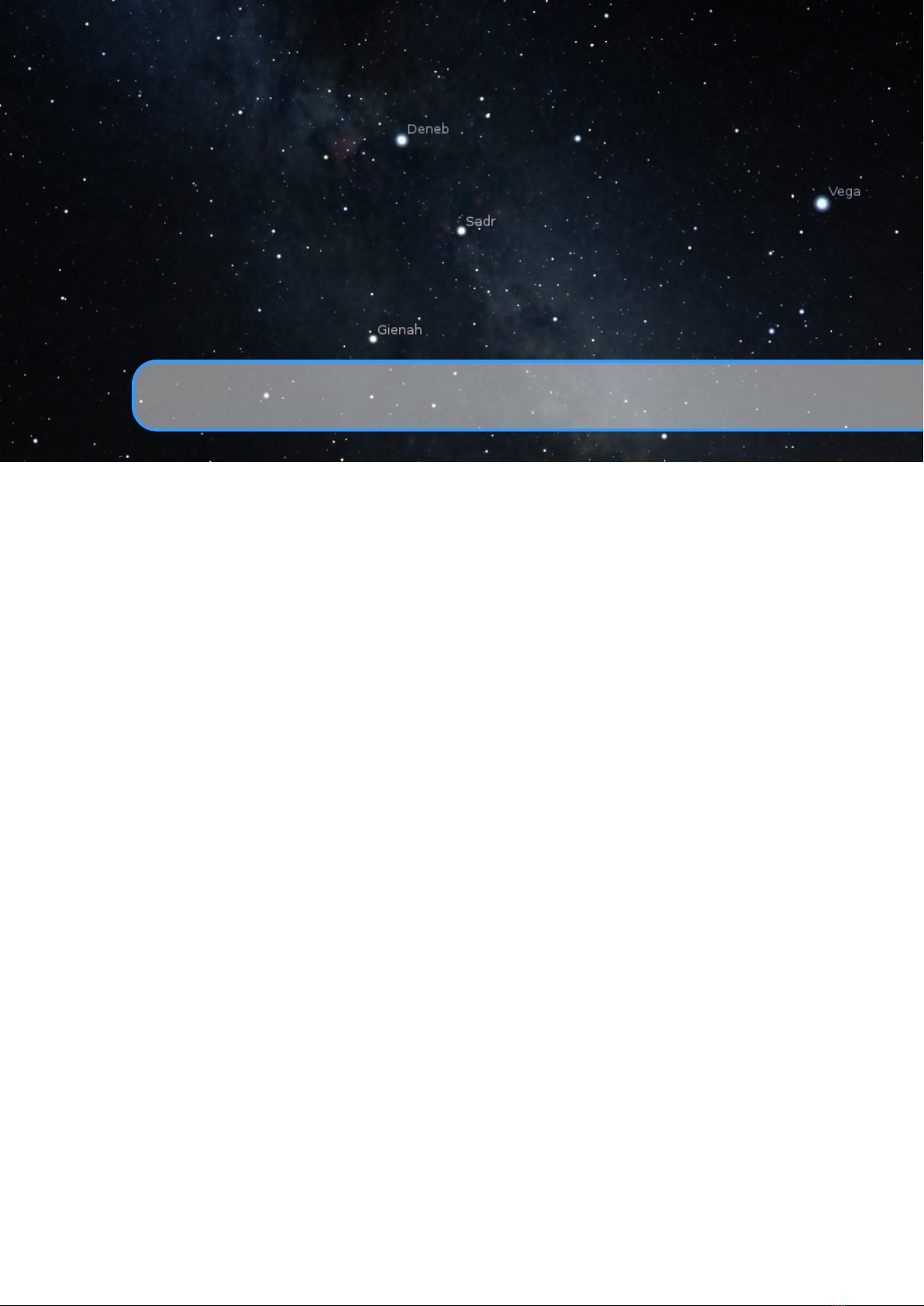
Bibliography
Abdali, S. Kamal (Sept. 1997). The Correct Quibla (cited on page 202).
Abell, G. O., H. G. Corwin Jr., and R. P. Olowin (May 1989). “A catalog of rich clusters of
galaxies”. In: Astrophysical Journal Supplement 70, pages 1–138. DOI:
10.1086/191
333 (cited on page 100).
Acker, A. et al. (1992). The Strasbourg-ESO Catalogue of Galactic Planetary Nebulae.
Parts I, II. (Cited on page 100).
Adams, Douglas (1981). The Hitchhiker’s Guide to the Galaxy. Pocket Books (cited on
page 259).
Agrawal, Dulli Chandra (2016). “Apparent magnitude of earthshine: a simple calculation”.
In: European Journal of Physics 035601, page 10. DOI:
10.1088/0143-0807/37/3
/035601 (cited on page 281).
Aller, L. H. et al. (1989). Landolt-Börnstein: Numerical Data and Functional Relationships
in Science and Technology - New Series (cited on page 266).
Anderson, E. and C. Francis (May 2012). “XHIP: An extended hipparcos compilation”. In:
Astronomy Letters 38, pages 331–346. DOI:
10.1134/S1063773712050015
. arXiv:
1108.4971 (cited on pages 326, 344, 356).
Archinal, B. A., M. F. A’Hearn, E. Bowell, et al. (Dec. 2010). “Report of the IAU Working
Group on Cartographic Coordinates and Rotational Elements: 2009”. In: Celest Mech
Dyn Astr. DOI:
10.1007/s10569-010-9320-4
. URL:
https://astrogeology.usg
s.gov/search/map/Docs/WGCCRE/WGCCRE2009reprint (cited on page 386).
Archinal, B. A., M. F. A’Hearn, A. Conrad, et al. (2011). “Erratum to: Reports of the IAU
Working Group on Cartographic Coordinates and Rotational Elements: 2006&2009”.
In: Celest Mech Dyn Astr. DOI: 10.1007/s10569-011-9362-2 (cited on page 386).
Archinal, B. A., C. H. Acton, M. F. A’Hearn, et al. (2018). “Report of the IAU Working
Group on Cartographic Coordinates and Rotational Elements: 2015”. In: Celest Mech
Dyn Astr 131.22. DOI: 10.1007/s10569-017-9805-5 (cited on page 386).

438 BIBLIOGRAPHY
Archinal, B. A., C. H. Acton, A. Conrad, et al. (2019). “Report of the IAU Working Group
on Cartographic Coordinates and Rotational Elements: 2015”. In: Celest Mech Dyn
Astr 131.61. DOI: 10.1007/s10569-019-9925-1 (cited on page 386).
Arp, H. (Nov. 1966). “Atlas of Peculiar Galaxies”. In: Astrophysical Journal Supplement
14, page 1. DOI: 10.1086/190147 (cited on page 100).
Ashdown, Ian (Feb. 2019). Solar Illumination. online,
https://www.allthingslighti
ng.org/index.php/2019/02/15/solar-illumination/ (cited on page 282).
Banjevic, B. (May 2006). “Ancient eclipses and dating the fall of Babylon”. In: Pub-
lications de l’Observatoire Astronomique de Beograd 80, pages 251–257 (cited on
page 265).
Barnard, Edward Emerson (1927). Catalogue of 349 dark objects in the sky (cited on
page 100).
Borkowski, K. M. (Oct. 1988). “ELP 2000-85 and the dynamic time-universal time re-
lation”. In: Astronomy and Astrophysics 205, pages L8–L10 (cited on pages 263,
428).
Bortle, John E. (Feb. 2001). “Introducing the Bortle Dark-Sky Scale”. In: Sky & Telescope,
pages 126–129. URL:
http://www.skyandtelescope.com/astronomy-resource
s/light-pollution-and-astronomy-the-bortle-dark-sky-scale/
(cited on
page 321).
Bosch, G., E. Terlevich, and R. Terlevich (Feb. 2009). “Gemini/GMOS Search for Mas-
sive Binaries in the Ionizing Cluster of 30 Dor”. In: The Astronomical Journal 137,
pages 3437–3441. DOI:
10.1088/0004-6256/137/2/3437
. arXiv:
0811.4748
(cited
on page 303).
Bretagnon, P. and G. Francou (Aug. 1988). “Planetary theories in rectangular and spherical
variables - VSOP 87 solutions”. In: Astronomy and Astrophysics 202, pages 309–315.
URL:
http://vizier.cfa . harvard . edu/viz- bin /ftp- index ? /ftp /cats
/VI/81 (cited on pages 64, 408).
Bretagnon, Pierre and Jean-Louis Simon (1986). Planetary Programs and Tables from
–4000 to +2800. Richmond: Willmann-Bell (cited on page 263).
Brouwer, D. (Sept. 1952). “A study of the changes in the rate of rotation of the earth”. In:
Astronomical Journal 57, page 125. DOI: 10.1086/106723 (cited on page 263).
Brown, Daniel (2015). “Exploring Skyscape in Stellarium”. In: Journal of Skyscape
Archaeology 1.1, pages 93–111 (cited on page 75).
Brown, P. (Apr. 1999). “The Leonid Meteor Shower: Historical Visual Observations”. In:
Icarus 138, pages 287–308. DOI: 10.1006/icar.1998.6074 (cited on page 189).
Bruneton, Eric and Fabrice Neyret (2008). “Precomputed Atmospheric Scattering”. In:
Proceedings of the 19th Eurographics Symposium on Rendering 2008. Volume 27.
Computer Graphics Forum 4. Eurographics. Wiley, pages 1079–1086. DOI:
10.1111
/j.1467-8659.2008.01245.x (cited on page 130).
Cannon, Annie Jump and Edward C. Pickering (1993). “VizieR Online Data Catalog: Henry
Draper Catalogue and Extension, published in Ann. Harvard Obs. 91-100 (1918-1925)”.
In: VizieR Online Data Catalog 3135 (cited on page 356).
Cederblad, S. (1946). “Studies of bright diffuse galactic nebulae with special regard to
their spatial distribution.” In: Meddelanden fran Lunds Astronomiska Observatorium
Serie II 119, pages 1–166 (cited on page 100).

BIBLIOGRAPHY 439
Chapront-Touze, M. (Jan. 1982). “The ELP solution for the main problem of the moon and
some applications”. In: Celestial Mechanics 26, pages 63–69. DOI:
10.1007/BF0123
3183 (cited on page 64).
Chapront-Touzé, Michelle and Jean Chapront (July 1983). “The lunar ephemeris ELP
2000”. In: Astronomy and Astrophysics 124, pages 50–62 (cited on page 64).
—
(Jan. 1988a). “ELP 2000-85: a semi-analytical lunar ephemeris adequate for historical
times”. In: Astronomy and Astrophysics 190, pages 342–352 (cited on page 264).
—
(1988b). Lunar Solution ELP 2000-82B. Paris: Bureau des Longitudes - URA707.
URL:
http://vizier.cfa.harvard.edu/viz-bin/ftp-index?VI/79
(cited on
page 64).
—
(1991). Lunar Tables and Programs from 4000 B.C. to A.D. 8000. Richmond: Willmann-
Bell (cited on page 263).
Clemence, G. M. (May 1948). “On the system of astronomical constants”. In: Astronomical
Journal 53, page 169. DOI: 10.1086/106088 (cited on pages 263, 428).
Collinder, P. (1931). “On Structural Properties of Open Galactic Clusters and their Spatial
Distribution. Catalog of Open Galactic Clusters.” In: Annals of the Observatory of
Lund 2, B1–B46 (cited on page 100).
Crumey, A. (Aug. 2014). “Human contrast threshold and astronomical visibility”. In:
Monthly Notices of the Royal Astronomical Society 442, pages 2600–2619. DOI:
10.1
093/mnras/stu992. arXiv: 1405.4209 [astro-ph.IM] (cited on page 321).
De Lorenzis, A. and V. Orofino (2018). “Comparison of astronomical software programs
for archaeoastronomical applications”. In: Astronomy and Computing 25, pages 118–
132. DOI: 10.1016/j.ascom.2018.09.006 (cited on page 408).
Delporte, Eugène (1930). Délimitation Scientifique des Constellations. Cambridge: Cam-
bridge University Press (cited on page 275).
Devlin et al. (2002). “Tone Reproduction and Physically Based Spectral Rendering”. In:
EUROGRAPHICS 2002 (cited on pages 132, 428).
Dickel, H. R., H. Wendker, and J. H. Bieritz (Jan. 1969). “The Cygnus X region. V. cata-
logue and distances of optically visible H II regions.” In: Astronomy and Astrophysics
1, pages 270–280 (cited on page 100).
ESA, editor (1997). The HIPPARCOS and TYCHO catalogues. Astrometric and photo-
metric star catalogues derived from the ESA HIPPARCOS Space Astrometry Mission.
Volume 1200. ESA Special Publication (cited on page 326).
Espenak, Fred (1987). Fifty Year Canon of Solar Eclipses: 1986 – 2035. Washington:
NASA (cited on page 263).
—
(1989). Fifty Year Canon of Lunar Eclipses: 1986 – 2035. Washington: NASA (cited
on page 263).
—
(2014). Thousand Year Canon of Solar Eclipses 1501 to 2500. Astropixels Publishing.
URL: https://eclipsewise.com/pubs/ap001.html (cited on pages 264, 428).
Espenak, Fred and Jean Meeus (2006). Five Millennium Canon of Solar Eclipses: -1900 to
+3000. NASA/TP-2006-214141. NASA. URL:
https://eclipse.gsfc.nasa.gov
/SEpubs/5MCSE.html (cited on pages 264, 428).
—
(2009). Five Millennium Canon of Lunar Eclipses: -1999 to +3000 (2000 BCE to 3000
CE). NASA/TP-2009-214172. NASA. URL:
https://eclipse.gsfc.nasa.gov
/SEpubs/5MKLE.html (cited on page 288).

440 BIBLIOGRAPHY
Folkner, William M. et al. (Feb. 2014). The Planetary and Lunar Ephemerides DE430 and
DE431. IPN Progress Report 42-196. JPL/NASA. URL:
https://ipnpr.jpl.nasa
.gov/progress_report/42-196/196C.pdf (cited on page 64).
Ginzel, F. K. (1906). Handbuch der Mathematischen und Technischen Chronologie. Vol-
ume 1. Leipzig: J. C. Hinrichs’sche Buchhandlung (cited on pages 154, 155).
—
(1908). Handbuch der Mathematischen und Technischen Chronologie. Volume 2.
Leipzig: J. C. Hinrichs’sche Buchhandlung (cited on pages 154, 410).
—
(1911). Handbuch der Mathematischen und Technischen Chronologie. Volume 3.
Leipzig: J. C. Hinrichs’sche Buchhandlung (cited on page 154).
Goldstine, Herman Heine (1973). New and Full Moons 1001 B.C. to A.D. 1651. Volume 94.
American Philosophical Society: Memoirs of the American Philosophical Society.
American Philosophical Society. ISBN: 9780871690944. URL:
https://books.goog
le.com/books?id=lgsNAAAAIAAJ (cited on page 263).
Green, D. A. (Sept. 2014). “VizieR Online Data Catalog: A catalogue of Galactic supernova
remnants (Green, 2014)”. In: VizieR Online Data Catalog 7272 (cited on page 100).
Harris, William E. (Oct. 1996). “A Catalog of Parameters for Globular Clusters in the
Milky Way”. In: Astronomical Journal 112, page 1487. DOI:
10.1086/118116
(cited
on page 101).
Henriksson, Göran (Aug. 2009). “A New Test of Einstein’s Theory of Relativity by Ancient
Solar Eclipses”. In: Cosmology Across Cultures. Volume 409. Astronomical Society of
the Pacific Conference Series, page 166 (cited on page 262).
—
(Aug. 2017). “The Acceleration of the Moon and the Universe – the Mass of the
Graviton”. In: Advances in Astrophysics 2.3, pages 184–196. DOI:
10.22606/adap.2
017.23004 (cited on page 265).
Hessels, J. W. T. et al. (Nov. 2007). “A 1.4 GHz Arecibo Survey for Pulsars in Globular
Clusters”. In: The Astrophysical Journal 670.1, pages 363–378. DOI:
10.1086/521780
.
arXiv: 0707.1602 [astro-ph] (cited on page 101).
Hickson, Paul (Jan. 1993). “Atlas of Compact Groups of Galaxies (Special Issue)”. In:
Astrophysical Letters and Communications 29, page 1 (cited on page 100).
Hilton, J. and J. F. Lahulla (Oct. 1995). “Distance measurements of LYNDS galactic
dark nebulae.” In: Astronomy and Astrophysics Supplement 113, page 325 (cited on
page 101).
Hoffleit, D. (1964). Catalogue of bright stars (cited on page 356).
Høg, E. et al. (Mar. 2000). “The Tycho-2 catalogue of the 2.5 million brightest stars”. In:
Astronomy and Astrophysics 355, pages L27–L30 (cited on page 326).
Houlden, M.A. and F.R. Stephenson (1986). A Supplement to the Tuckerman Tables.
Volume 170. American Philosophical Society. ISBN: 9780871691705. URL:
https :
//books.google.ru/books?id=JwsNAAAAIAAJ (cited on page 263).
Islam, Sana, Muhammad Sadiq, and Muhammad Shahid Qureshi (2008). “Error Mini-
mization of Polynomial Approximation of Delta T”. In: Journal of Astrophysics and
Astronomy 29 (3-4), pages 363–366. URL:
http://www.ias.ac.in/describe/art
icle/joaa/029/03-04/0363-0366 (cited on page 265).
Jenniskens, P. (July 1994). “Meteor stream activity I. The annual streams.” In: Astronomy
and Astrophysics 287, pages 990–1013 (cited on page 189).
—
(2006). Meteor Showers and their Parent Comets. Cambridge University Press (cited
on page 189).

BIBLIOGRAPHY 441
Jenniskens, Peter et al. (Jan. 1998). “Lorentz Shaped Comet Dust Trail Cross Section from
New Hybrid Visual and Video Meteor Counting Technique - Implications for Future
Leonid Storm Encounters”. In: Earth, Moon, and Planets 82, pages 191–208. DOI:
10.1023/A:1017076829926 (cited on page 189).
Jensen, Henrik Wann et al. (2000). Night Rendering. Technical report UUCS-00-016.
University of Utah (cited on pages 132, 428).
Khalid, M., Mariam Sultana, and Faheem Zaidi (2014). “Delta T: Polynomial Approxima-
tion of Time Period 1620–2013”. In: Journal of Astrophysics 2014. DOI:
10.1155/20
14/480964 (cited on page 265).
Kohoutek, L. (Nov. 2001). “Version 2000 of the Catalogue of Galactic Planetary Nebulae”.
In: Astronomy and Astrophysics 378, pages 843–846. DOI:
10.1051/0004-6361:200
11162 (cited on page 100).
Krisciunas, Kevin and Bradley Schaefer (1991). “A Model of the Brightness of Moonlight”.
In: Publications of the Astronomical Society of the Pacific 103, pages 1033–1039 (cited
on page 281).
Kwon, S. M., S. S. Hong, and J. L. Weinberg (2004). “An observational model of the
zodiacal light brightness distribution”. In: New Astronomy 10, pages 91–107. DOI:
doi:10.1016/j.newast.2004.05.004 (cited on page 285).
Larson, Gregory Ward, Holly Rushmeier, and Christine Piatko (Jan. 1997). A Visibility
Matching Tone Reproduction Operator for High Dynamic Range Scenes. Technical
report LBNL-39882, UC-400. Lawrence Berkeley National Laboratory. URL:
http:
//radsite.lbl.gov/radiance/papers (cited on pages 132, 428).
Lauberts, A. (1982). ESO/Uppsala survey of the ESO(B) atlas (cited on page 100).
Livingston, William C. (2002). “Limb Darkening”. In: Allen’s Astrophysical Quantities.
Edited by A. N. Cox. 4th. New York: Springer. Chapter 14.7. DOI:
10.1007/978-1-4
612-1186-0 (cited on page 429).
Lynds, B. T. (May 1962). “Catalogue of Dark Nebulae.” In: Astrophysical Journal Supple-
ment 7, page 1. DOI: 10.1086/190072 (cited on page 100).
—
(Aug. 1965). “Catalogue of Bright Nebulae.” In: Astrophysical Journal Supplement 12,
page 163. DOI: 10.1086/190123 (cited on page 100).
MacEvoy, Bruce and Wil Tirion (2015). The Cambridge Double Star Atlas (cited on
page 344).
Magakian, T. Y. (Feb. 2003). “Merged catalogue of reflection nebulae”. In: Astronomy and
Astrophysics 399, pages 141–145. DOI:
10.1051/0004-6361:20021743
(cited on
page 100).
Mallama, Anthony and James L. Hilton (2018). “Computing apparent planetary magnitudes
for The Astronomical Almanac”. In: Astronomy and Computing 25, pages 10–24. DOI:
10.1016/j.ascom.2018.08.002 (cited on page 283).
Manchester, R. N. et al. (Apr. 2005). “The Australia Telescope National Facility Pulsar
Catalogue”. In: The Astronomical Journal 129, pages 1993–2006. DOI:
10.1086/428
488. eprint: astro-ph/0412641 (cited on page 182).
Mason, Brian D. et al. (Dec. 2001). “The 2001 US Naval Observatory Double Star CD-
ROM. I. The Washington Double Star Catalog”. In: The Astronomical Journal 122.6,
pages 3466–3471. DOI: 10.1086/323920 (cited on pages 343, 344).

442 BIBLIOGRAPHY
McCarthy, Dennis D. and Brian J. Luzum (2003). “An abridged model of the precession-
nutation of the celestial pole”. In: Celestial Mechanics and Dynamical Astronomy 85,
pages 37–49 (cited on pages 409, 429).
Meeus, Jean (1988). Astronomical Formulae for Calculators. 4th. Richmond: Willmann-
Bell (cited on page 263).
— (1991). Astronomical Algorithms. Richmond: Willmann-Bell (cited on page 264).
—
(1997). Mathematical astronomy morsels. Richmond: Willmann-Bell. ISBN: 0-943396-
51-4 (cited on page 309).
—
(1998). Astronomical Algorithms. 2nd. Richmond: Willmann-Bell (cited on pages 259,
264, 283, 391, 428).
—
(2002). More mathematical astronomy morsels. Richmond: Willmann-Bell (cited on
page 309).
—
(2004). Mathematical astronomy morsels III. Richmond: Willmann-Bell. ISBN: 0-
943396-81-6 (cited on page 309).
Meeus, Jean and L. Simons (Dec. 2000). “Polynomial approximations to Delta T, 1620-
2000 AD”. In: Journal of the British Astronomical Association 110 (cited on pages 264,
265, 428).
Melotte, P. J. (1915). “A Catalogue of Star Clusters shown on Franklin-Adams Chart
Plates”. In: Memoirs of the Royal Astronomical Society 60, page 175 (cited on page 100).
Montenbruck, O. and T. Pfleger (2000). Astronomy on the Personal Computer. fourth
edition. Berlin: Springer. ISBN: 3-540-67221-4 (cited on pages 264, 428).
Moore, Patrick (Dec. 1995). “Beyond Messier: The Caldwell Catalogue”. In: Sky &
Telescope (cited on page 286).
Morrison, L. V. and F. R. Stephenson (1982). “Secular and decade fluctuations in the earth’s
rotation - 700 BC - AD 1978”. In: Sun and Planetary System. Edited by W. Fricke and
G. Teleki. Volume 96. Astrophysics and Space Science Library, pages 173–178 (cited
on page 263).
—
(Aug. 2004). “Historical values of the Earth’s clock error
∆
T and the calculation
of eclipses”. In: Journal for the History of Astronomy 35, pages 327–336 (cited on
pages 264, 265, 428).
—
(Aug. 2005). “Addendum: Historical values of the Earth’s clock error”. In: Journal for
the History of Astronomy 36, page 339 (cited on pages 264, 428).
Morrison, L. V., F. R. Stephenson, et al. (2021). “Addendum 2020 to ‘Measurement of
the Earth’s rotation: 720 BC to AD 2015’”. In: Proceedings of the Royal Society A:
Mathematical, Physical and Engineering Sciences 477.2246, page 20200776. DOI:
10.1098/rspa.2020.0776
. eprint:
https://royalsocietypublishing.org/do
i/pdf/10.1098/rspa.2020.0776
. URL:
https://royalsocietypublishing.or
g/doi/abs/10.1098/rspa.2020.0776 (cited on page 264).
Mucke, Hermann and Jean Meeus (1983). Canon of Solar Eclipses -2003 to +2526. Vienna:
Astronomisches Büro (cited on pages 263, 428).
Mullaney, James and Wil Tirion (2009). The Cambridge Double Star Atlas (cited on
page 344).
Muller, P. M. and F. R. Stephenson (1975). “The accelerations of the earth and moon from
early astronomical observations”. In: Growth Rhythms and the History of the Earth’s
Rotation. Edited by G. D. Rosenberg and S. K. Runcorn, pages 459–533 (cited on
pages 263, 428).

BIBLIOGRAPHY 443
Noyola, E., K. Gebhardt, and M. Bergmann (Apr. 2008). “Gemini and Hubble Space
Telescope Evidence for an Intermediate-Mass Black Hole in
ω
Centauri”. In: The
Astrophysical Journal 676, 1008-1015, pages 1008–1015. DOI:
10.1086/529002
.
arXiv: 0801.2782 (cited on page 303).
O’Meara, Stephen James (2003). Deep-Sky Companions: The Caldwell Objects. Cambridge
University Press. ISBN: 0521827965 (cited on page 286).
Park, Ryan S. et al. (Mar. 2021). “The JPL Planetary and Lunar Ephemerides DE440 and
DE441”. In: The Astronomical Journal 161, pages 105–120. URL:
https://doi.org
/10.3847/1538-3881/abd414 (cited on page 64).
Perez, R., R. Seals, and J. Michalsky (1993). “All-weather Model for Sky Luminance Distri-
bution – Preliminary Configuration and Validation”. In: Solar Energy 50.3, pages 235–
45 (cited on page 129).
Peters, Anton R. (2010). “Ancient Records Silent on Theory of Relativity. A Refutation
of Henriksson’s Article.” In: Journal of Cosmology 9, pages 2245–2258 (cited on
page 262).
Piqueux, Sylvain et al. (2015). “Enumeration of Mars years and seasons since the beginning
of telescopic exploration”. In: Icarus 251, pages 332–338. DOI:
10.1016/j.icarus
.2014.12.014 (cited on page 429).
Pollard, Joshua (2017). “The Uffington White Horse geoglyph as sun-horse”. In: Antiquity
91.356, pages 406–420. DOI: 10.15184/aqy.2016.269 (cited on page 215).
Preetham, Arcot J., Peter Shirley, and Brian Smits (1999). “A Practical Analytic Model for
Daylight”. In: SIGGRAPH ’99: Proceedings of the 26th Annual Conference on Com-
puter Graphics and Interactive Techniques. New York, NY, USA: ACM Press/Addison-
Wesley Publishing Co., pages 91–100. ISBN: ISBN 0-201-48560-5. DOI:
http://doi
.acm.org/10.1145/311535.311545 (cited on pages 129, 428).
Reingold, Edward M. and Nachum Dershowitz (2001). Calendrical Calculations (The
Millennium Edition). 2nd. Cambridge: Cambridge University Press (cited on page 428).
—
(2002). Calendrical Tabulations 1900-2200. Cambridge: Cambridge University Press
(cited on page 264).
—
(2007). Calendrical Calculations. 3rd. Cambridge: Cambridge University Press (cited
on page 264).
—
(2018). Calendrical Calculations: The Ultimate Edition. 4th. Cambridge: Cambridge
University Press. DOI:
10.1017/9781107415058
(cited on pages 154, 155, 159, 160,
264).
Rodgers, A. W., C. T. Campbell, and J. B. Whiteoak (1960). “A catalogue of H
α
-emission
regions in the southern Milky Way”. In: Monthly Notices of the Royal Astronomical
Society 121, page 103. DOI: 10.1093/mnras/121.1.103 (cited on page 100).
Roman, Nancy (July 1987). “Identification of a Constellation from a Position”. In: Publica-
tions of the Astronomical Society of the Pacific 99, pages 695–699 (cited on pages 140,
275).
Ruprecht, J. (Jan. 1966). “Classification of open star clusters”. In: Bulletin of the Astro-
nomical Institutes of Czechoslovakia 17, page 33 (cited on page 101).
Russell, Henry Norris (1916). “Stellar Magnitudes of Sun, Moon and Planets”. In: Astro-
physical Journal 43, page 103 (cited on page 281).

444 BIBLIOGRAPHY
Samus’, N. N. et al. (Jan. 2017). “General catalogue of variable stars: Version GCVS 5.1”.
In: Astronomy Reports 61.1, pages 80–88. DOI:
10.1134/S1063772917010085
(cited
on page 331).
SAO Staff (Oct. 1995). “VizieR Online Data Catalog: SAO Star Catalog J2000 (SAO Staff
1966; USNO, ADC 1990)”. In: VizieR Online Data Catalog, I/131A, I/131A (cited on
page 356).
Schaefer, Bradley (May 1998). “To the Visual Limits”. In: Sky&Telescope, pages 57–60
(cited on page 428).
Schaefer, Bradley E. (1990). “Telescopic Limiting Magnitudes”. In: Publications of the
Astronomical Society of the Pacific 102, pages 212–229 (cited on page 131).
—
(1993). “Astronomy and the Limits of Vision”. In: Vistas in Astronomy 36, pages 311–
361 (cited on page 130).
—
(1989-93). “Astronomy and the Limits of Vision”. In: Archaeoastronomy XI, pages 78–
90 (cited on page 130).
Schmadel, L. D. and G. Zech (1979). “Polynomial approximations for the correction delta
T E.T.-U.T. in the period 1800-1975”. In: Acta Astronomica 29, pages 101–104 (cited
on pages 263, 428).
—
(1988). “Empirical Transformations from U.T. to E.T. for the Period 1800-1988”.
In: Astronomische Nachrichten 309. DOI:
10. 1002 /asna . 2113090316
(cited on
pages 263, 428).
Schoch, Carl (1931). “Die säkulare Acceleration des Mondes und der Sonne”. In: Astro-
nomische Abhandlungen. Ergänzungshefte zu den Astronomischen Nachrichten 8 (cited
on page 262).
Seidelmann, P. Kenneth, editor (1992). Explanatory Supplement to the Astronomical
Almanac. 2nd. Sausalito, CA: University Science Books. ISBN: 0-935702-68-7 (cited
on page 283).
Sharpless, S. (Dec. 1959). “A Catalogue of H II Regions.” In: Astrophysical Journal
Supplement 4, page 257. DOI: 10.1086/190049 (cited on page 100).
Smith, David E. et al. (2009). “Time variations of Mars’ gravitational field and seasonal
changes in the masses of the polar ice caps”. In: Journal of Geophysical Research
114.E05002. DOI: 10.1029/2008je003267 (cited on page 429).
Snyder, John P. (1987). Map Projections – A Working Manual. USGS Professional Papers
1395. Washington: U.S. Geological Survey (cited on page 30).
Spencer Jones, H. (May 1939). “The rotation of the earth, and the secular accelerations of
the sun, moon and planets”. In: Monthly Notices of the Royal Astronomical Society 99,
page 541. DOI: 10.1093/mnras/99.7.541 (cited on pages 263, 428).
Stanghellini, Letizia, Richard A. Shaw, and Eva Villaver (Dec. 2008). “The Magellanic
Cloud Calibration of the Galactic Planetary Nebula Distance Scale”. In: The Astrophys-
ical Journal 689, pages 194–202. DOI:
10.1086/592395
. arXiv:
0807.1129
(cited on
page 101).
Stephenson, F. R. (1978). “Pre-Telescopic Astronomical Observations”. In: Tidal Friction
and the Earth’s Rotation. Edited by P. Brosche and J. Suendermann, page 5 (cited on
pages 263, 428).
Stephenson, F. R. and L. V. Morrison (Nov. 1984). “Long-term changes in the rotation
of the earth - 700 B.C. to A.D. 1980”. In: Philosophical Transactions of the Royal

BIBLIOGRAPHY 445
Society of London Series A 313, pages 47–70. DOI:
10.1098/rsta.1984.0082
(cited
on pages 263–265, 428).
—
(Apr. 1995). “Long-Term Fluctuations in the Earth’s Rotation: 700 BC to AD 1990”.
In: Philosophical Transactions of the Royal Society of London Series A 351, pages 165–
202. DOI: 10.1098/rsta.1995.0028 (cited on pages 264, 428).
Stephenson, F. R., L. V. Morrison, and C. Y. Hohenkerk (Dec. 2016). “Measurement of the
Earth’s rotation: 720 BC to AD 2015”. In: Proc. R. Soc. A 472, page 20160404. DOI:
10.1098/rspa.2016.0404 (cited on page 264).
Stephenson, F. Richard (1997). Historical Eclipses and Earth’s Rotation. Cambridge Books
Online. Cambridge University Press. ISBN: 9780511525186. DOI:
10.1017/CBO9780
511525186
. URL:
http://ebooks.cambridge.org/ebook.jsf?bid=CBO9780511
525186 (cited on pages 264, 428).
Tuckerman, Bryant (1962). Planetary, Lunar, and Solar Positions, 601 B.C. to A.D. 1, at
Five-day and Ten-day Intervals. Volume 56. American Philosophical Society: Memoirs
of the American Philosophical Society. American Philosophical Society. URL:
https:
//books.google.com/books?id=ZyUWAAAAIAAJ (cited on page 263).
—
(1964). Planetary, Lunar and Solar Positions A.D. 2 to A.D. 1649 at Five Day and Ten
Day Intervals. Volume 59. American Philosophical Society: Memoirs of the American
Philosophical Society. American Philosophical Society. ISBN: 9780871690593. URL:
https://books.google.com/books?id=cDQLAAAAIAAJ (cited on page 263).
Tumblin, Greg and Holly Rushmeier (Nov. 1993). “Tone Reproduction for Realistic
Images”. In: IEEE Computer Graphics & Application (cited on pages 132, 428).
Urban, Sean E. and P. Kenneth Seidelmann, editors (2013). Explanatory Supplement to
the Astronomical Almanac. 3rd. Mill Valley, CA: University Science Books. ISBN:
978-1-891389-85-6 (cited on pages 257, 283, 385, 386).
van den Bergh, S. (Dec. 1966). “A study of reflection nebulae.” In: Astronomical Journal
71, pages 990–998. DOI: 10.1086/109995 (cited on page 100).
van den Bergh, S. and G. L. Hagen (Jan. 1975). “Uniform survey of clusters in the southern
Milky Way.” In: Astronomical Journal 80, pages 11–16. DOI:
10.1086/111707
(cited
on page 100).
van den Bergh, S. and W. Herbst (Mar. 1975). “Catalogue of southern stars embedded
in nebulosity.” In: Astronomical Journal 80, pages 208–211. DOI:
10.1086/111733
(cited on page 100).
Véron-Cetty, M.-P. and P. Véron (July 2010). “A catalogue of quasars and active nuclei:
13th edition”. In: Astronomy and Astrophysics 518, A10, A10. DOI:
10.1051/0004-6
361/201014188 (cited on page 184).
Vondrák, J., N. Capitaine, and P. Wallace (2011). “New precession expressions, valid
for long time intervals”. In: Astronomy and Astrophysics 534.A22, pages 1–19. DOI:
10.1051/0004-6361/201117274 (cited on pages 258, 409, 429).
—
(2012). “New precession expressions, valid for long time intervals (Corrigendum)”. In:
Astronomy and Astrophysics 541.C1. DOI:
10.1051/0004-6361/201117274e
(cited
on pages 258, 409, 429).
Vorontsov-Velyaminov, B. A., R. I. Noskova, and V. P. Arkhipova (2001). “The catalogue
of interacting galaxies by Vorontsov-Velyaminov”. In: Astronomical and Astrophysical
Transactions 20 (5), pages 717–959. DOI:
10.1080/10556790108208213
(cited on
page 100).

446 BIBLIOGRAPHY
Wenger, M. et al. (Apr. 2000). “The SIMBAD astronomical database. The CDS reference
database for astronomical objects”. In: Astronomy and Astrophysics Supplement 143,
pages 9–22. DOI:
10.1051/aas:2000332
. eprint:
astro- ph/0002110
(cited on
pages 40, 100, 344).
Wilkins, G. A., editor (1961). Explanatory Supplement to the Astronomical Ephemeris.
London. ISBN: 0-11-880578-9 (cited on pages 263, 283).
Zacharias, N. et al. (Dec. 2004). “The Naval Observatory Merged Astrometric Dataset (NO-
MAD)”. In: American Astronomical Society Meeting Abstracts. Volume 36. Bulletin of
the American Astronomical Society, 48.15, page 1418 (cited on page 326).
Zotti, Georg (2015). “Visualization Tools and Techniques”. In: Handbook for Archaeoas-
tronomy and Ethnoastronomy. Edited by Clive L.N. Ruggles. Volume 1. New York:
Springer Reference. Chapter 29, pages 445–457 (cited on page 216).
—
(2016a). “Archaeoastronomical Simulations in a Desktop Planetarium”. In: Proc.
CHNT2015. Edited by Wolfgang Börner. ISBN: 978-3-200-04698-6. URL:
http://w
ww.chnt.at/wp-content/uploads/eBook_CHNT20_Zotti_2015.pdf
(cited on
pages 216, 218).
—
(2016b). “Open-Source Virtual Archaeoastronomy”. In: Mediterranean Archaeology
and Archaeometry 16.4, pages 17–24. DOI:
10.5281/zenodo. 207260
. URL:
http:
//maajournal.com/Issues/2016/Vol16-4/Full3. pdf
(cited on pages 200, 203,
216, 218).
—
(2019). “Visualising skyscapes: GIS-based 3-D modelling and astronomical simula-
tion”. In: Visualising Skyscapes: Material Forms of Cultural Engagement with the
Heavens. Edited by Liz Henty and Daniel Brown. Routledge Studies in Archaeology.
Routledge, pages 35–54. ISBN: 978-1-13-830361-4 (cited on page 218).
Zotti, Georg, Bernard Frischer, et al. (2019). “Virtual Archaeoastronomy: Stellarium for
Research and Outreach”. In: Archaeoastronomy in the Roman World. Edited by Giulio
Magli et al. Historical & Cultural Astronomy. Springer International Publishing AG.
Chapter 12, pages 187–205. ISBN: 978-3-319-97006-6. DOI:
10.1007/978-3-319-9
7007-3_12 (cited on page 218).
Zotti, Georg, Susanne Hoffmann, et al. (Mar. 2021). “The Simulated Sky: Stellarium for
Cultural Astronomy Research”. In: Journal for Skyscape Archaeology 6.2, pages 221–
258. DOI:
10.1558/jsa.17822
. URL:
https://journal.equinoxpub.com/JSA/a
rticle/view/17822 (cited on pages 6, 160, 218).
Zotti, Georg, Susanne M. Hoffmann, et al. (2023). “Revisiting Star Names: Stellarium
and the Ancient Skies Database”. In: Cultural Astronomy & Ancient Skywatching:
Proceeding of the 28th Annual Meeting of the European Society for Astronomy in
Culture (SEAC), 6-10 September 2021, Stara Zagora, Bulgaria. Edited by Penka
Maglova and Alexey Stoev. Plovdiv: TOTEM Studio, pages 131–138. ISBN: 978-619-
91961-2-0 (cited on page 150).
Zotti, Georg and Wolfgang Neubauer (Sept. 2012a). “A Virtual Reconstruction Approach
for Archaeoastronomical Research”. In: Proc. VSMM2012 (Virtual Systems in the
Information Society). Edited by Gabriele Guidi and Alonzo C. Addison. IEEE. Milano:
IEEE, pages 33–40. ISBN: 978-1-4673-2563-9 (cited on page 216).
—
(Nov. 2012b). “Virtual Reconstructions in a Desktop Planetarium for Demonstrations
in Cultural Astronomy”. In: Progress in Cultural Heritage Preservation (Proc. 4th
International Conference EuroMed 2012, Limassol, Cyprus, Oct. 29–Nov. 3, 2012).

BIBLIOGRAPHY 447
Edited by M. Ioannides et al. Volume 7616. Lecture Notes in Computer Science.
Heidelberg: Springer, pages 170–180. ISBN: 978-3-642-34233-2 (cited on page 216).
—
(2015). “Astronomical and Topographical Orientation of Kreisgrabenanlagen in Lower
Austria”. In: SEAC2011 Stars and Stones: Voyages in Archaeoastronomy and Cultural
Astronomy. Edited by Fernando Pimenta et al. BAR International Series 2720. Oxford:
Archaeopress, pages 188–193. ISBN: 978 1 4073 1373 3 (cited on page 75).
Zotti, Georg, Florian Schaukowitsch, and Michael Wimmer (2017). “The Skyscape Plane-
tarium”. In: The Marriage of Astronomy and Culture: Theory and Method in the Study
of Cultural Astronomy (Papers from the 2016 SEAC Conference). Edited by Liz Henty
et al. Volume 21. Culture and Cosmos 1&2. Lampeter, Ceredigion, Wales: Culture and
Cosmos & Sophia Centre Press, pages 269–281. URL:
http://www.cultureandcos
mos.org/pdfs/21/CCv21_17Zotti.pdf (cited on pages 144, 146).
—
(2018). “Beyond 3D Models: Simulation of Phased Models in Stellarium”. In: Mediter-
ranean Archaeology and Archaeometry 18.4, pages 17–24. DOI:
10.5281/zenodo.14
77972
. URL:
http://maajournal.com/Issues/2018/Vol18-4/63_Zotti%20et
%20al%2018(4).pdf (cited on pages 214, 216, 218).
Zotti, Georg and Günther Wuchterl (2016). “Raising Awareness of Light Pollution by
Simulation of Nocturnal Light of Astronomical Cultural Heritage Sites”. In: The
Materiality of the Sky. Proceedings of the 22nd Annual SEAC Conference, 2014. Edited
by Fabio Silva et al. Ceredigion, Wales, pages 197–203 (cited on page 97).

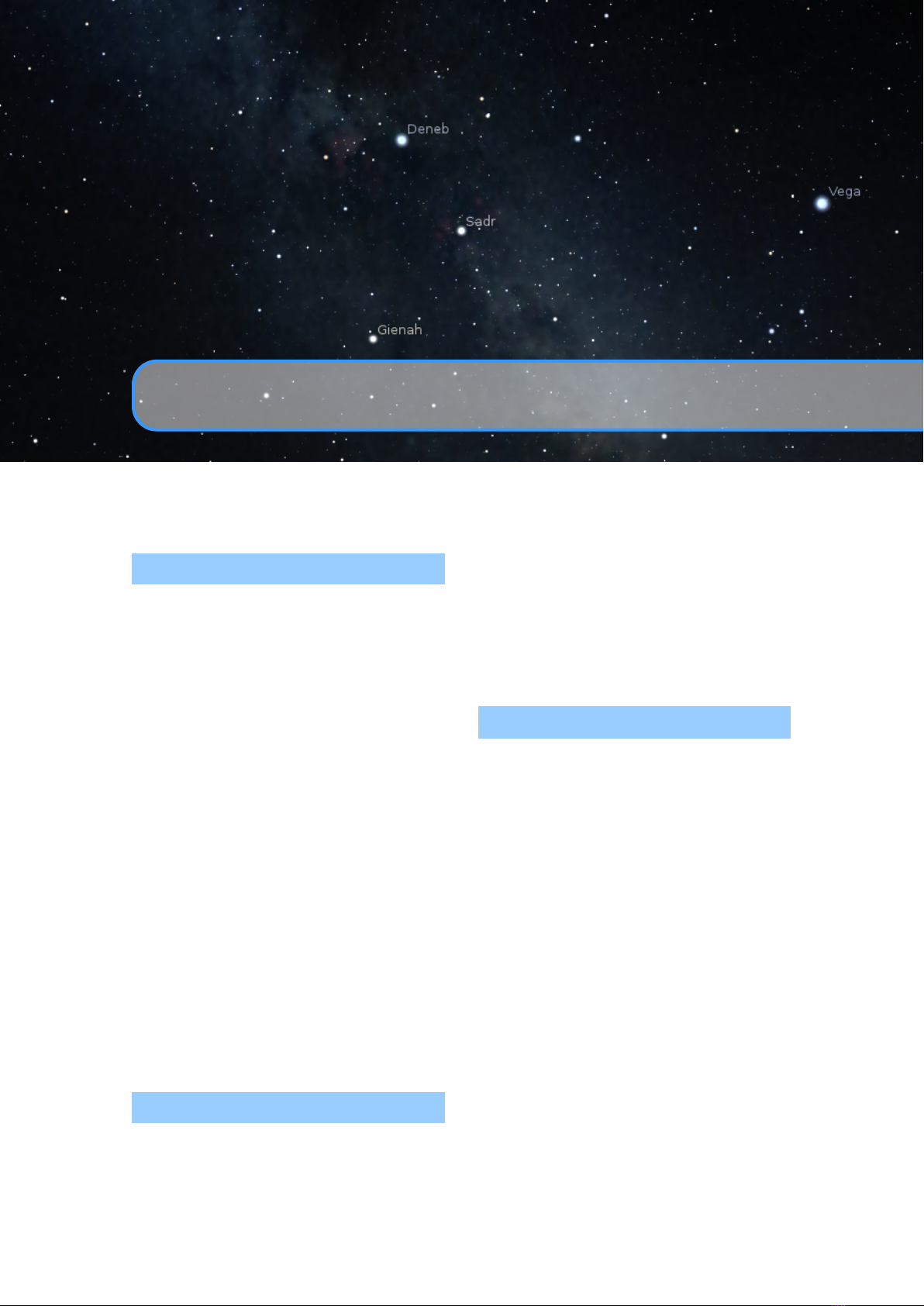
Index
A
aberration of light. . . . . . . . . . . . . . . 26, 270
absolute magnitude . . . . . . . . . . . . . . . . . 266
Adams, Douglas . . . . . . . . . . . . . . . . . . . 259
air mass . . . . . . . . . . . . . . . . . . . . . . . . . . . 290
Almagest . . . . . . . . . . . . . . . . . . . . . . . . . . 258
altitude. . . . . . . . . . . . . . . . . . . . . . . . . . . . 254
American Association of Variable Star Ob-
servers. . . . . . . . . . . . . . . . . . . . .150
Andromeda Galaxy . . . . . . . . . . . . . . . . . 307
annual parallax. . . . . . . . . . . . . . . . . . . . .269
antisolar point . . . . . . . . . . . . . . . . . . . . . 258
apogee . . . . . . . . . . . . . . . . . . . . . . . . . . . . 194
apparent magnitude . . . . . . . . . . . . . . . . 266
apparent radiant . . . . . . . . . . . . . . . . . . . . 186
ASCOM . . . . . . . . . . . . . . . . . . . . . . 238, 239
ashen glow . . . . . . . . . . . . . . . . . . . . . . . . 281
asterisms . . . . . . . . . . . . . . . . . . . . . 113, 123
Atmospheric Extinction . . . . . . . . . . . . . 290
Atmospheric Refraction. . . . . . . . . . . . .290
Augustus . . . . . . . . . . . . . . . . . 154, 155, 410
azimuth . . . . . . . . . . . . . . . . . . . . . . . 254, 257
B
Barnard’s Star . . . . . . . . . . . . . . . . . 271, 310
Bayer, Johann. . . . . . . . . . . . . . . . . . . . . . 277
binoculars . . . . . . . . . . . . . . . . . . . . . . . . . 307
Blazhko effect . . . . . . . . . . . . . . . . . . . . . 336
Bortle, John E. . . . . . . . . . . . . . . . . . . . . .321
Bradley, James . . . . . . . . . . . . . . . . . . . . . 270
Brahe, Tycho . . . . . . . . . . . . . . . . . . . . . . 258
brown dwarfs . . . . . . . . . . . . . . . . . . . . . . 279
C
Caesar, Julius . . . . . . . . . . . . . 154, 155, 410
cardinal points . . . . . . . . . . . . . . . . . . . . . 255
Celestial Equator . . . . . . . . . . . . . . . . . . . 254
Celestial Poles . . . . . . . . . . . . . . . . . . . . . 254
Celestial Sphere. . . . . . . . . . . . . . . . . . . .253
central meridian. . . . . . . . . . . . . . . . . . . .396
Chauvenet, William . . . . . . . . . . . . . . . . 288
circumpolar . . . . . . . . . . . . . . . . . . . 201, 257
Colure
Equinoctial . . . . . . . . . . . . . . . . . . . . 257
Solstitial . . . . . . . . . . . . . . . . . . . . . . . 257
configuration file . . . . . . . . . . . . . . . . . . . . 63
conjunction . . . . . . . . . . . . . . . . . . . . . . . . 258
conjunction, inferior . . . . . . . . . . . . . . . . 258
conjunction, superior . . . . . . . . . . . . . . . 258
contact times . . . . . . . . . . . . . . . . . . . . . . 288
Coordinate System
Ecliptical . . . . . . . . . . . . . . . . . . . . . . 257
Equatorial . . . . . . . . . . . . . . . . . . . . . 255

450 INDEX
Fixed Equatorial. . . . . . . . . . . . . . . .257
Galactic . . . . . . . . . . . . . . . . . . . . . . . 258
Horizontal . . . . . . . . . . . . . . . . . . . . . 254
coordinates,planetocentric. . . . . . . . . . . 397
coordinates,planetographic . . . . . . . . . . 397
Cortés, Hernán . . . . . . . . . . . . . . . . . . . . . 158
COSPAR ID (satellite ID) . . . . . . . . . . . 193
crossbow . . . . . . . . . . . . . . . . . . . . . . . . . . 266
culmination, lower . . . . . . . . . . . . . . . . . 257
culmination, upper . . . . . . . . . . . . . . . . . 257
D
Danjon . . . . . . . . . . . . . . . . . . . . . . . . . . . . . 32
Danjon scale. . . . . . . . . . . . . . . . . . . . . . . 288
Danjon, André . . . . . . . . . . . . . . . . . . . . . 288
DE430 . . . . . . . . . . . . . . . . . . . . . . . . . . . . . 64
DE431 . . . . . . . . . . . . . . . . . . . . . . . . . . . . . 64
DE440 . . . . . . . . . . . . . . . . . . . . . . . . . . . . . 64
DE441 . . . . . . . . . . . . . . . . . . . . . . . . . . . . . 64
declination . . . . . . . . . . . . . . . . . . . . . . . . 255
Deep-sky objects . . . . . . . . . . . . . . . . . . . . 32
digression, greatest . . . . . . . . . . . . . . . . . 257
double stars. . . . . . . . . . . . . . . . . . . . . . . .344
Doyle, Brian . . . . . . . . . . . . . . . . . . . . . . . . 78
dwarf stars . . . . . . . . . . . . . . . . . . . . . . . . 279
E
earthshine . . . . . . . . . . . . . . . . . . . . . . . . . 281
ecliptic . . . . . . . . . . . . . . . . . . . . . . . 256–258
ecliptical latitude . . . . . . . . . . . . . . . . . . . 257
ecliptical longitude . . . . . . . . . . . . . . . . . 257
ECMAScript . . . . . . . . . . . . . . . . . . . . . . 243
elongation . . . . . . . . . . . . . . . . . . . . . . . . . 258
elongation, eastern . . . . . . . . . . . . . . . . . 258
elongation, western. . . . . . . . . . . . . . . . . 258
epoch . . . . . . . . . . . . . . . . . . . . 151, 284, 388
equator. . . . . . . . . . . . . . . . . . . . . . . . . . . . 254
equinox. . . . . . . . . . . . . . . . . . . . . . .256, 388
exoplanets . . . . . . . . . . . . . . . . . . . . . . . . . 167
F
FAQ . . . . . . . . . . . . . . . . . . . . . . . . . . . 10, 427
First Point of Aries . . . . . . . . . . . . . . . . . 256
First Point of Cancer. . . . . . . . . . . . . . . .257
First Point of Capricorn . . . . . . . . . . . . . 257
FITS . . . . . . . . . . . . . . . . . . . . . . . . . . . . . . 105
Flamsteed, John . . . . . . . . . . . . . . . . . . . . 277
G
galactic latitude . . . . . . . . . . . . . . . . . . . . 258
galactic longitude . . . . . . . . . . . . . . . . . . 258
General Catalogue of Variable Stars . . 150
giants . . . . . . . . . . . . . . . . . . . . . . . . . . . . . 279
GPS . . . . . . . . . . . . . . . . . . . . . . . . . . . . . . . 65
Great Red Spot . . . . . . . . . . . . . . . . . . . . 259
H
Halley, Edmund . . . . . . . . . . . . . . . 284, 390
Hammer, Ernst von . . . . . . . . . . . . . . . . . . 30
Handy Angles . . . . . . . . . . . . . . . . . 266, 307
help rays . . . . . . . . . . . . . . . . . . . . . . . . . . 124
Herschel, John . . . . . . . . . . . . . . . . . . . . . 261
Hertzsprung, Ejnar . . . . . . . . . . . . . . . . . 279
Hierarchical Progressive Surveys . . . . 125
Hipparchus . . . . . . . . . . . . . . . 258, 266, 277
Hour Angle . . . . . . . . . . . . . . . . . . . 257, 261
I
IAU . . . 140, 168, 263, 275, 282, 367, 386,
395–397, 399, 400, 409
ICRF. . . . . . . . . . . . . . . . . . . . . . . . . . . . . .257
INDI . . . . . . . . . . . . . . . . . . . . . . . . . . . . . . 237
inferior planets. . . . . . . . . . . . . . . . . . . . . 288
Installation. . . . . . . . . . . . . . . . . . . . . . . . . . .8
installation directory . . . . . . . . . . . . . . . . . 61
International Variable Star Index . . . . . 150
International Virtual Observatory Alliance
125
J
JavaScript . . . . . . . . . . . . . . . . . . . . . . . . . 243
JPL Horizons . . . . . . . . . . . . . . . . . . . . . . 393
Julian Day. . . . . . . . . . . . . . . . . . . . . .20, 261
Modified . . . . . . . . . . . . . . . . . . . 20, 261
K
Kepler orbits . . . . . . . . . . . . . . . . . . 151, 283

INDEX 451
Kepler, exoplanets . . . . . . . . . . . . . . . . . . 167
Kepler, Johannes . . . . . . . . . . . . . . 151, 283
L
Libration . . . . . . . . . . . . . . . . . . . . . . . . . . 259
logfile . . . . . . . . . . . . . . . . . . . . . . . . . . . . . . 63
luminosity class . . . . . . . . . . . . . . . . . . . . 279
M
M31 . . . . . . . . . . . . . . . . . . . . . . . . . . 287, 307
Magellanic Cloud
Large . . . . . . . . . . . . . . . . . . . . . 286, 302
Small . . . . . . . . . . . . . . . . . . . . . 286, 303
magnitudes, instrumental. . . . . . . . . . . .283
magnitudes, visual . . . . . . . . . . . . . . . . . 283
main sequence . . . . . . . . . . . . . . . . . . . . . 279
mathematical horizon . . . . . . . . . . . . . . . 254
Mayer, Johann Tobias . . . . . . . . . . . . . . 299
Mercator, Gerardus . . . . . . . . . . . . . . . . . . 30
meridian convergence. . . . . . . . . . . . . . .212
Messier, Charles . . . . . . . . . . . . . . . . . . . 286
meteor shower . . . . . . . . . . . . . . . . . . . . . 186
meteoroids . . . . . . . . . . . . . . . . . . . . . . . . 186
Milankovi
´
c, Milutin . . . . . . . . . . . . . . . . 155
Milky Way . . . . . . . . . . . . . . . . . . . . . . . . 285
Miller, Osborn Maitland . . . . . . . . . . . . . 30
Moore, Patrick . . . . . . . . . . . . . . . . . . . . . 286
N
nadir . . . . . . . . . . . . . . . . . . . . . . . . . . . . . . 254
NMEA . . . . . . . . . . . . . . . . . . . . . . . . . . . . . 66
Northern Ecliptical Pole. . . . . . . . . . . . .257
O
obliquity, ecliptic. . . . . . . . . .202, 258, 267
opposition . . . . . . . . . . . . . . . . . . . . . . . . . 258
opposition surge. . . . . . . . . . . . . . . . . . . .281
Opposition/Conjunction Line . . . . . . . . 258
orbital elements . . . . . . . . . . . . . . . 151, 283
osculating orbital elements . . . . . . . . . . 283
P
parallax . . . . . . . . . . . . . . . . . . . . . . . . . . . 256
penumbra . . . . . . . . . . . . . . . . . . . . . . . . . 288
perigee . . . . . . . . . . . . . . . . . . . . . . . . . . . . 194
planetary nebulae . . . . . . . . . . . . . . . . . . 258
plate solving . . . . . . . . . . . . . . . . . . 105, 106
Pogson, Norman . . . . . . . . . . . . . . . . . . . 266
pole, celestial . . . . . . . . . . . . . . . . . . . . . . 257
population index . . . . . . . . . . . . . . . . . . . 187
Pound, James . . . . . . . . . . . . . . . . . . . . . . 299
precession . . . . . . . . . . . . . . . . 256, 258, 267
precession circles . . . . . . . . . . . . . . . . . . 258
proper motion . . . . . . . . . . . . . . . . . . . . . . 271
Ptolemy . . . . . . . . . . . . . . . . . . 155, 258, 275
pulsars . . . . . . . . . . . . . . . . . . . . . . . . . . . . 258
Q
quadrature . . . . . . . . . . . . . . . . . . . . . . . . . 258
R
radiant . . . . . . . . . . . . . . . . . . . . . . . . . . . . 186
RCS, Radar Cross Section . . . . . . 194, 197
Right ascension . . . . . . . . . . . . . . . . . . . . 255
Right Ascension/Declination . . . . . . . . 255
rotation,prograde . . . . . . . . . . . . . . . . . . . 397
rotation,retrograde. . . . . . . . . . . . . . . . . .397
RTS2 . . . . . . . . . . . . . . . . . . . . . . . . . . . . . 236
Russell, Henry Norris. . . . . . . . . . . . . . .279
S
scintillation . . . . . . . . . . . . . . . . . . . . 30, 293
screenshot save directory . . . . . . . . . . . . . 61
script save directory . . . . . . . . . . . . . . . . . 61
sidereal time . . . . . . . . . . . . . . . . . . . . . . . 261
sky culture . . . . . . . . . . . . . . . . . . . . . . . . 113
sky survey . . . . . . . . . . . . . . . . . . . . . . . . . 125
solar longitude . . . . . . . . . . . . . . . . . . . . . 187
solstice. . . . . . . . . . . . . . . . . . . . . . . . . . . . 202
Sosigenes . . . . . . . . . . . . . . . . . . . . . . . . . 154
spectral types . . . . . . . . . . . . . . . . . . . . . . 278
spectrum . . . . . . . . . . . . . . . . . . . . . . . . . . 278
standard epoch . . . . . . . . . . . . . . . . . . . . . 257
standard magnitude (satellites). . . . . . .193
stellar parallax . . . . . . . . . . . . . . . . . . . . . 269
subsolar point. . . . . . . . . . . . . . . . . . . . . . 396
super-giants . . . . . . . . . . . . . . . . . . . . . . . 279

452 INDEX
T
terminator . . . . . . . . . . . . . . . . . . . . . . . . . . 32
time dragging . . . . . . . . . . . . . . . . . . . . . . . 13
TLE, two-line element . . . . . . . . . . . . . . 193
Tsenpo, Nyatri . . . . . . . . . . . . . . . . . . . . . 157
twilight, astronomical. . . . . . . . . . . . . . .274
twilight, civil . . . . . . . . . . . . . . . . . . . . . . 273
twilight, nautical . . . . . . . . . . . . . . . . . . . 274
U
umbra. . . . . . . . . . . . . . . . . . . . . . . . . . . . .288
undersampling . . . . . . . . . . . . . . . . . . . . . . 48
user data directory . . . . . . . . . . . . . . . . . . . 61
user directory . . . . . . . . . . . . . . . . . . . . . . . 61
V
vernal equinox . . . . . . . . . . . . . . . . . . . . . 256
VSOP87. . . . . . . . . . . . . . . . . . . . . . . . . . . .64
W
WGCCRE . . . . . . . . . . . . . . . . . . . . . . . . . 409
white dwarfs . . . . . . . . . . . . . . . . . . . . . . . 279
Z
zenith . . . . . . . . . . . . . . . . . . . . . . . . 254, 257
Zenithal Hourly Rate . . . . . . . . . . . . . . . 186
Zodiac, Sidereal. . . . . . . . . . . . . . . . . . . .156


